['Species Protection']
['Endangered Species']
04/19/2023
...
(a) Maps and critical habitat unit descriptions for the islands of Kauai and Niihau, HI. The following paragraphs contain the legal descriptions of the critical habitat units designated for the Hawaiian Islands of Kauai and Niihau. Existing manmade features and structures within the boundaries of the mapped areas, such as buildings; roads; aqueducts and other water system features, including but not limited to pumping stations, irrigation ditches, pipelines, siphons, tunnels, water tanks, gaging stations, intakes, reservoirs, diversions, flumes, and wells; existing trails; campgrounds and their immediate surrounding landscaped area; scenic lookouts; remote helicopter landing sites; existing fences; telecommunications equipment towers and associated structures and equipment; electrical power transmission lines and distribution, and communication facilities and regularly maintained associated rights-of-way and access ways; radars, telemetry antennas; missile launch sites; arboreta and gardens; heiau (indigenous places of worship or shrines), and other archaeological sites; airports; other paved areas; and lawns and other rural residential landscaped areas do not contain one or more of the primary constituent elements described for each species in paragraph (b) of this section and therefore are not included in the critical habitat designations.
(1) Kauai. Critical habitat units are described below. Coordinates are in UTM Zone 4 with units in meters using North American Datum of 1983 (NAD83). The following map shows the general locations of the critical habitat units designated on the island of Kauai.
(i) Note: Map 1 - Index map follows:
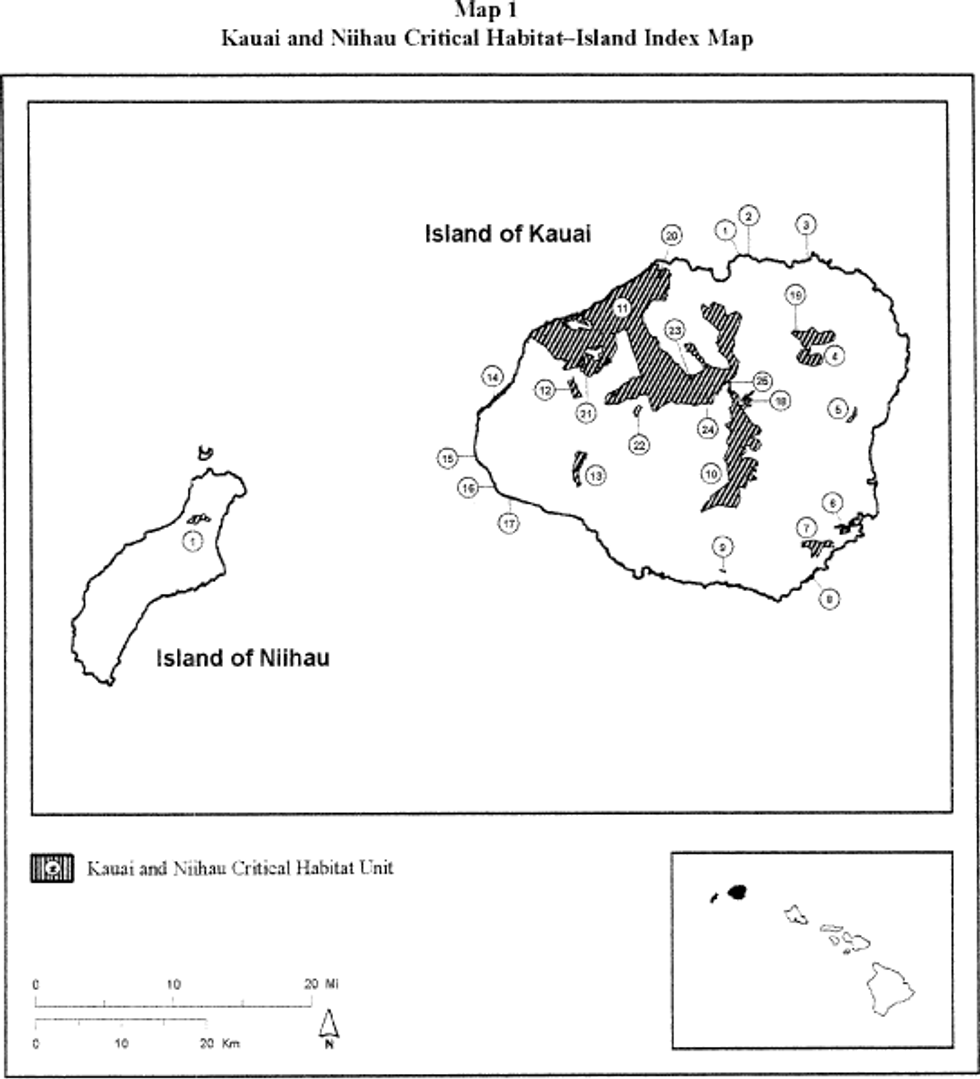
(ii) Kauai 1 - Ischaemum byrone - a (1 ha; .4 ac)
(A) [Reserved]
(B) Map 2 follows:
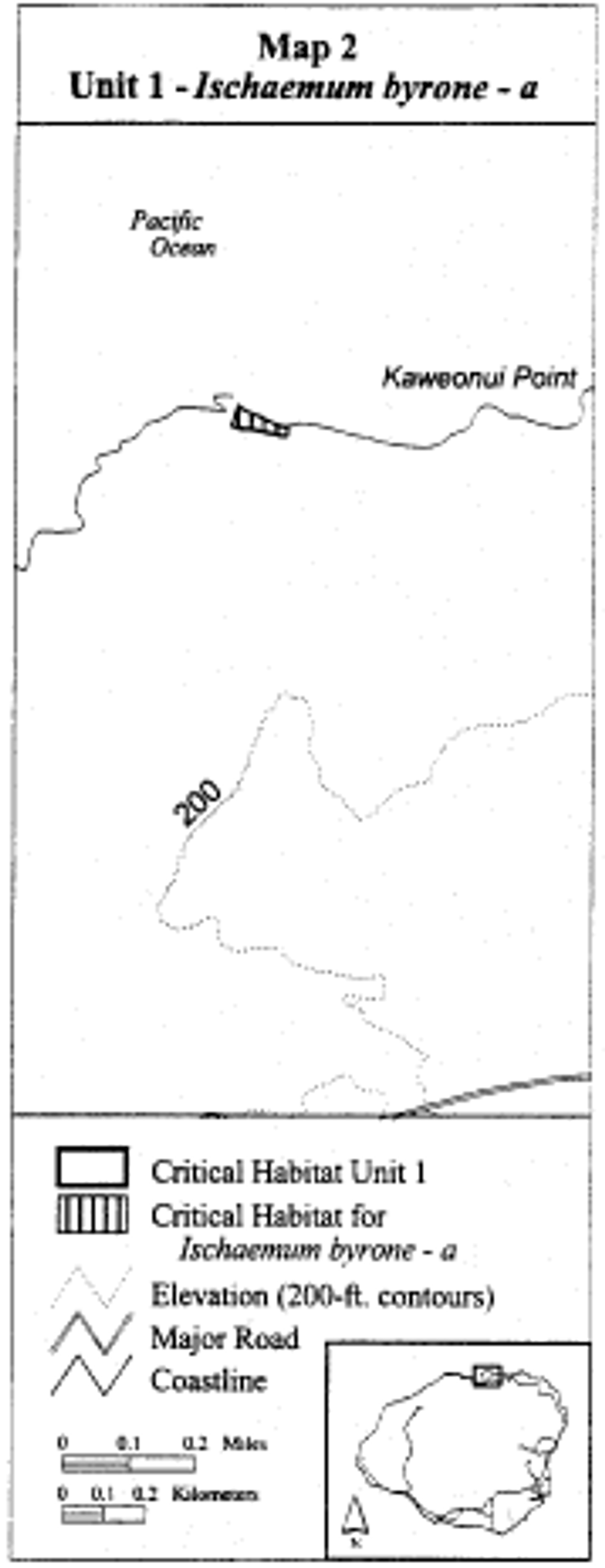
(iii) Kauai 2 - Ischaemum byrone - b (6 ha; 14 ac)
(A) [Reserved]
(B) Map 3 follows:
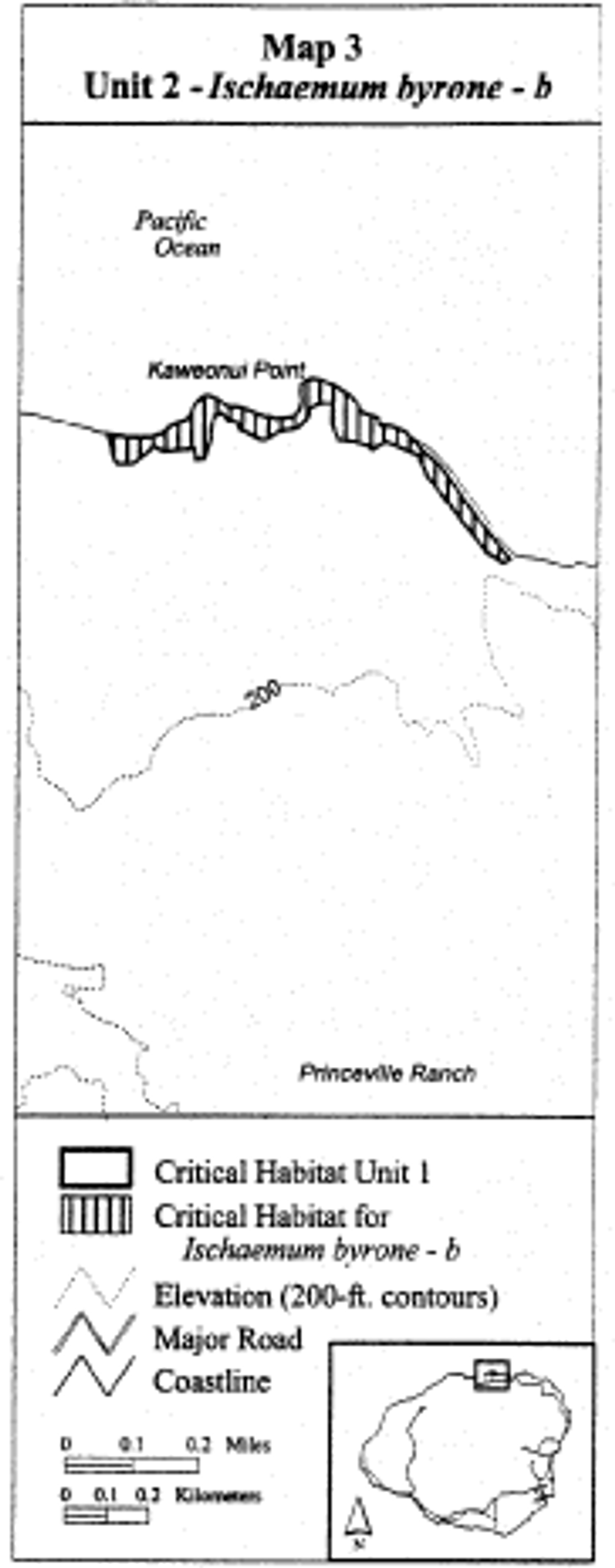
(iv) Kauai 3 - Ischaemum byrone - c (7 ha; 17 ac)
(A) [Reserved]
(B) Map 4 follows:
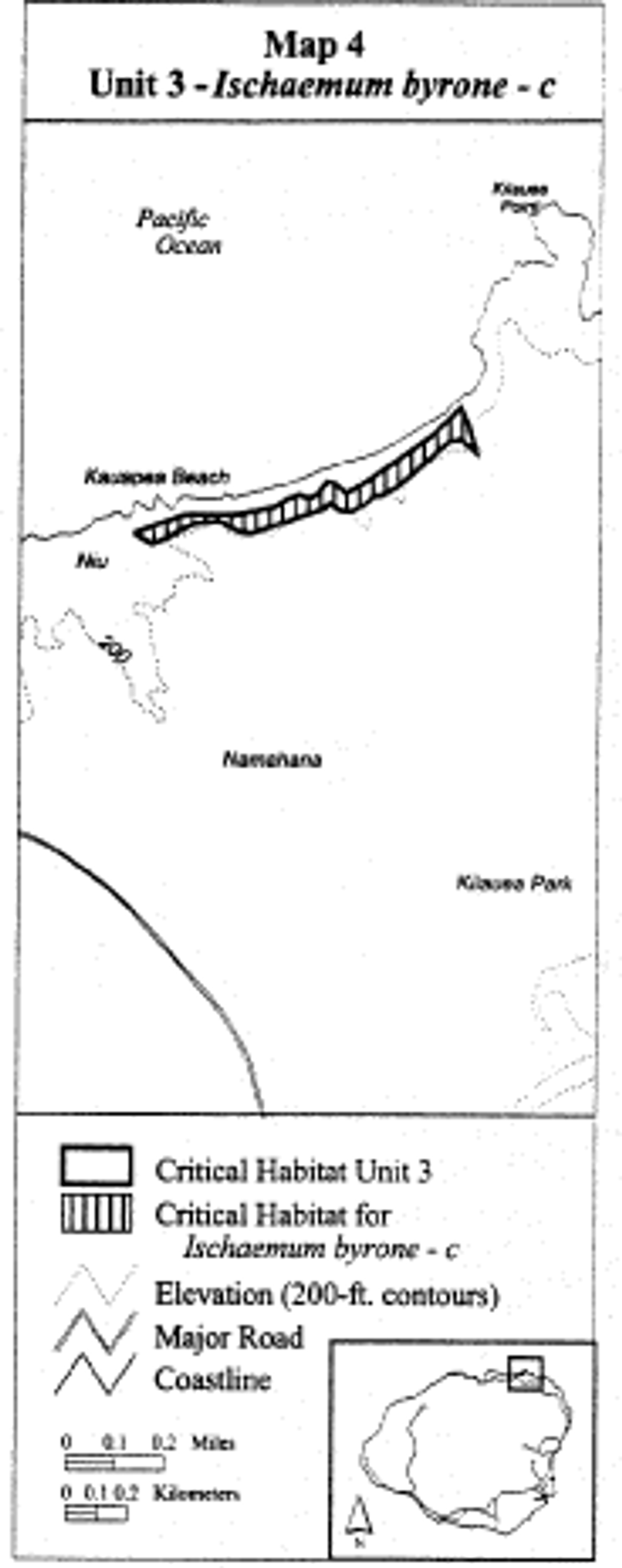
(v) Kauai 4 - Adenophorus periens - a (237 ha; 585 ac)
(A) [Reserved]
(B) Map 5 follows:
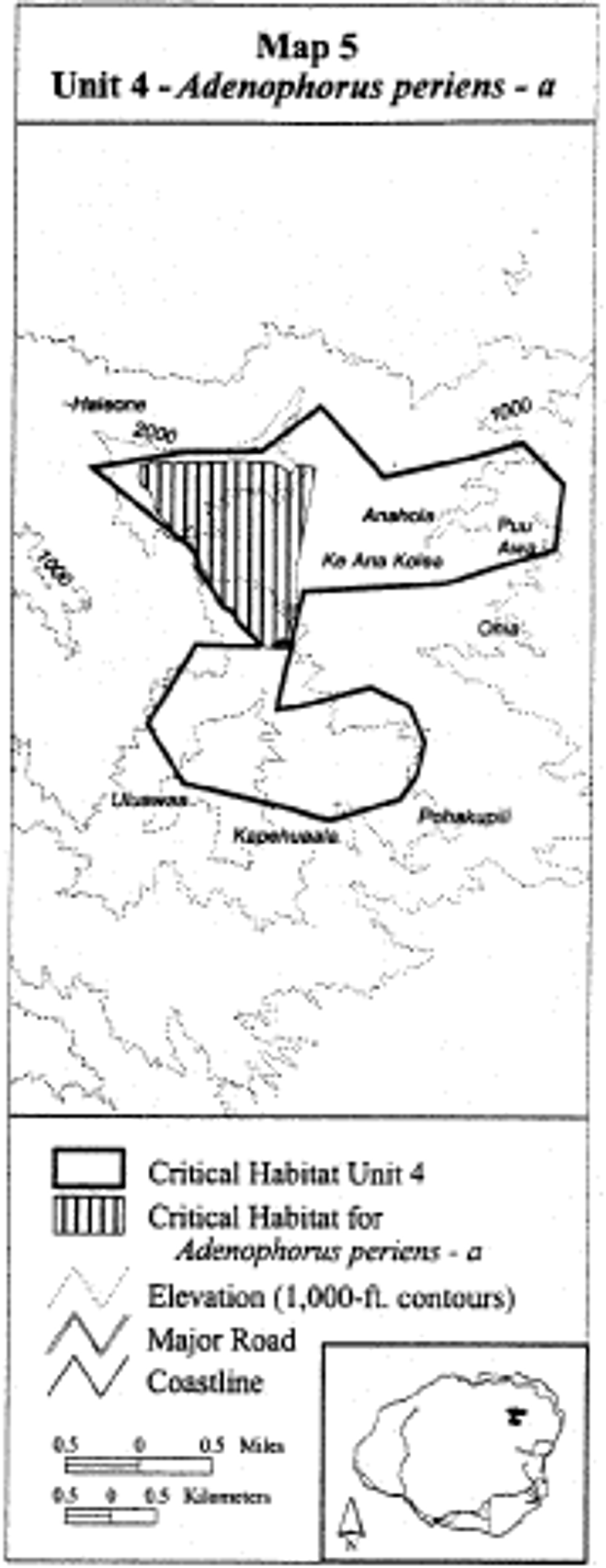
(vi) Kauai 4-Chamaesyce remyi var. kauaiensis-a
(A) This is a unit of the Wet Cliff ecosystem and consists of 38 ac (15.4 ha). This unit is also critical habitat for Kauai 4-Chamaesyce remyi var. remyi-a, Kauai 4-Cyanea dolichopoda-a, Kauai 4-Cyrtandra oenobarba-a, Kauai 4-Cyrtandra paliku-a, Kauai 4-Dubautia plantaginea ssp. magnifolia-a, Kauai 4-Lysimachia iniki-a, Kauai 4-Lysimachia pendens-a, Kauai 4- Lysimachia venosa-a, and Kauai 4� Melicope rostrata�a (see paragraphs (a)(1)(vii), (a)(1)(ix), (a)(1)(xvi), (a)(1)(xvii), (a)(1)(xviii), (a)(1)(xxv), (a)(1)(xxvi), (a)(1)(xxvii), and (a)(1)(xxix), respectively, of this section).
(B) Note: The reference to �Kauai 4� Platydesma rostrata �a� on the map is equivalent to �Kauai 4� Melicope rostrata �a�. Map 5a follows:
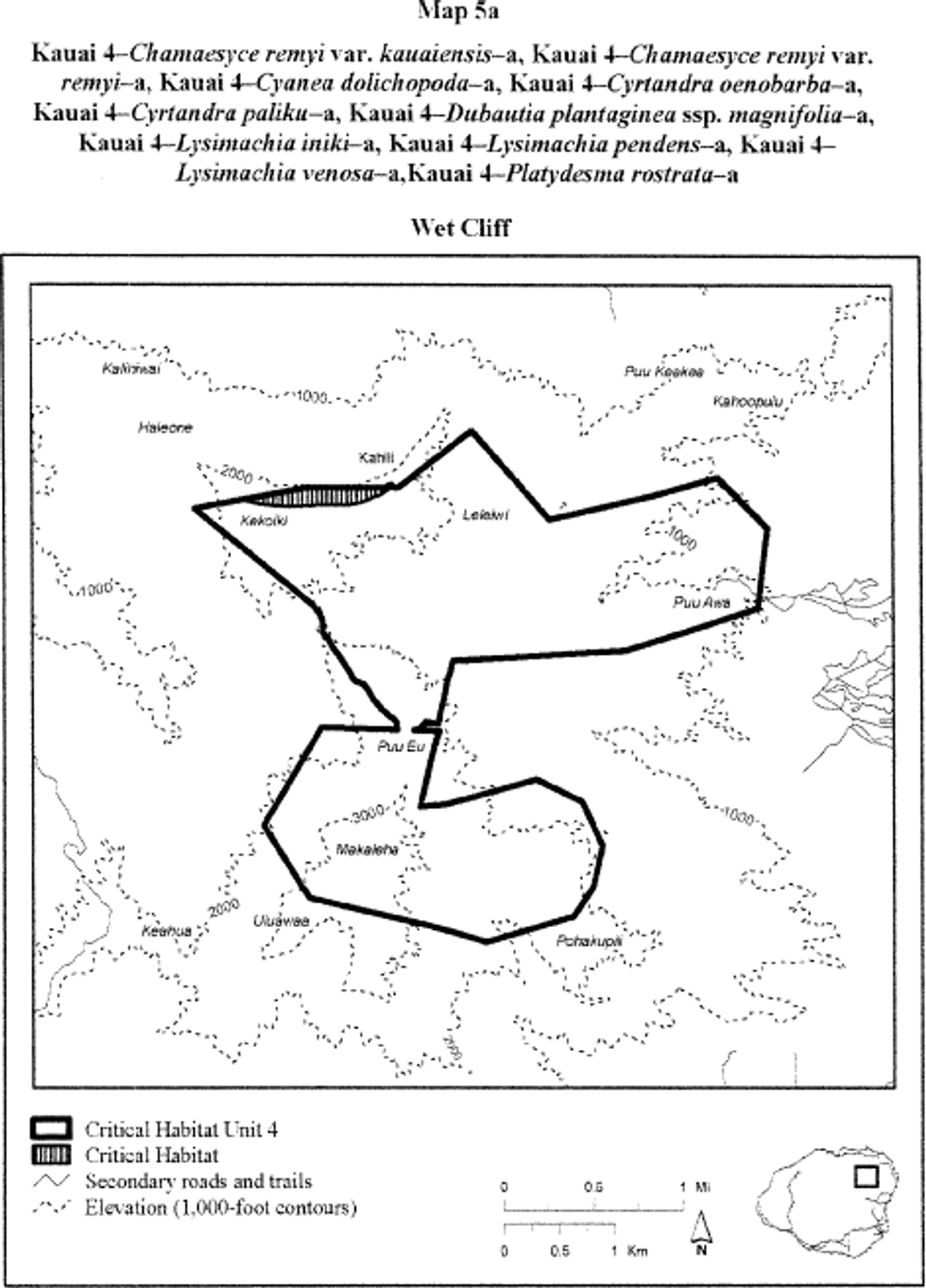
(vii) Kauai 4-Chamaesyce remyi var. remyi-a
(A) [Reserved]
(B) See paragraph (a)(1)(vi)(B) of this section for the map of this unit.
(viii) Kauai 4 - Cyanea asarifolia - a (654 ha; 1,616 ac)
(A) [Reserved]
(B) Map 6 follows:
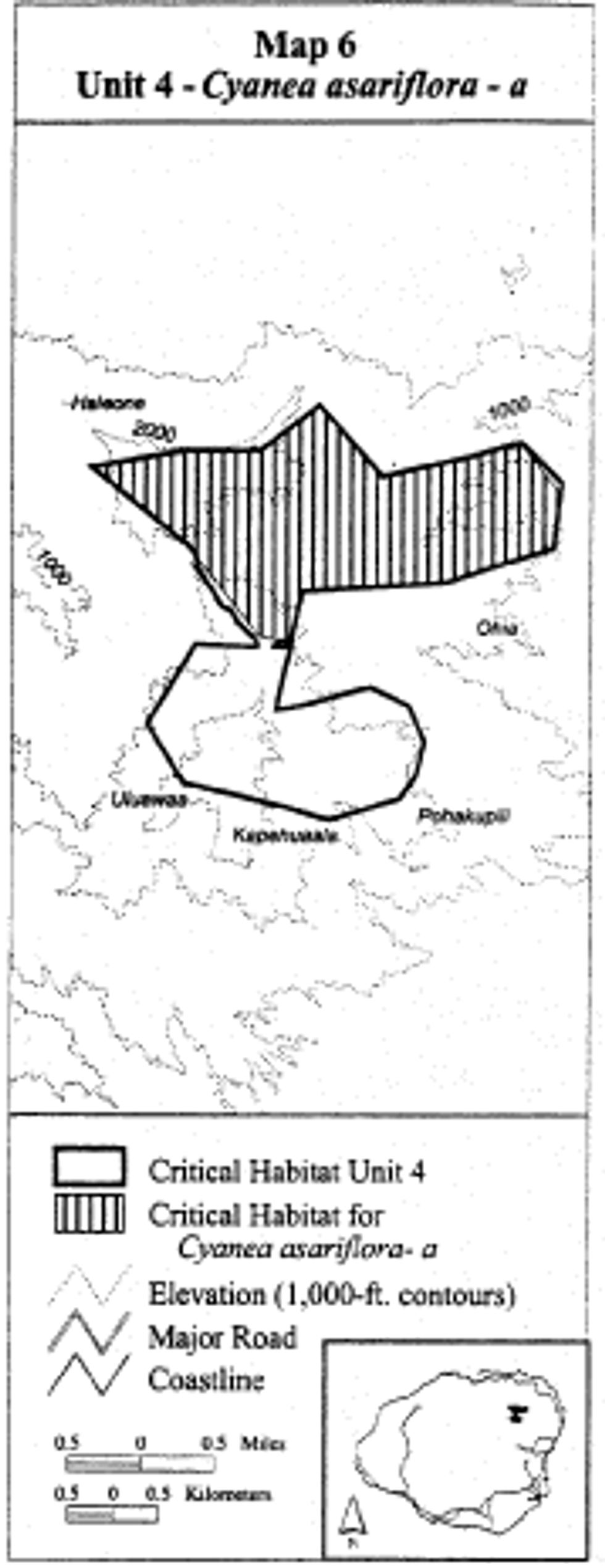
(ix) Kauai 4-Cyanea dolichopoda-a
(A) [Reserved]
(B) See paragraph (a)(1)(vi)(B) of this section for the map of this unit.
(x) Kauai 4 - Cyanea recta - a (252 ha; 622 ac)
(A) [Reserved]
(B) Map 7 follows:
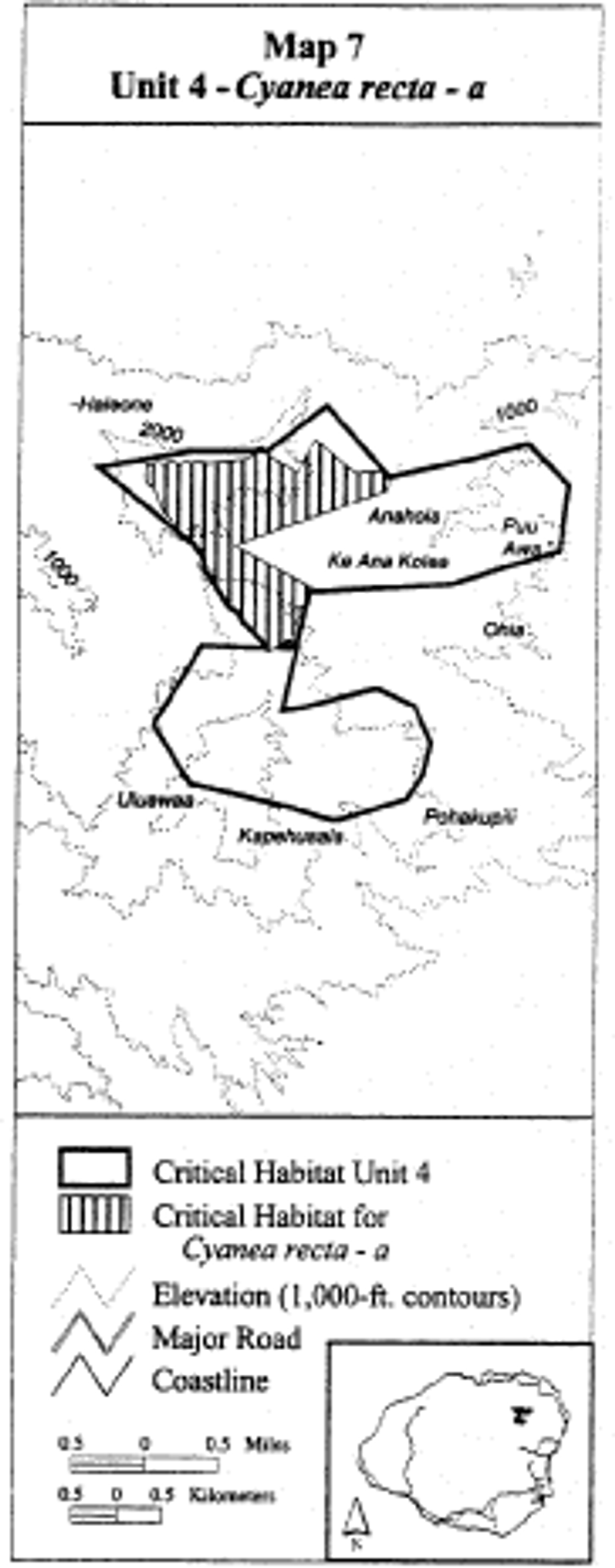
(xi) Kauai 4 - Cyanea recta - b (351 ha; 868 ac)
(A) [Reserved]
(B) Map 8 follows:
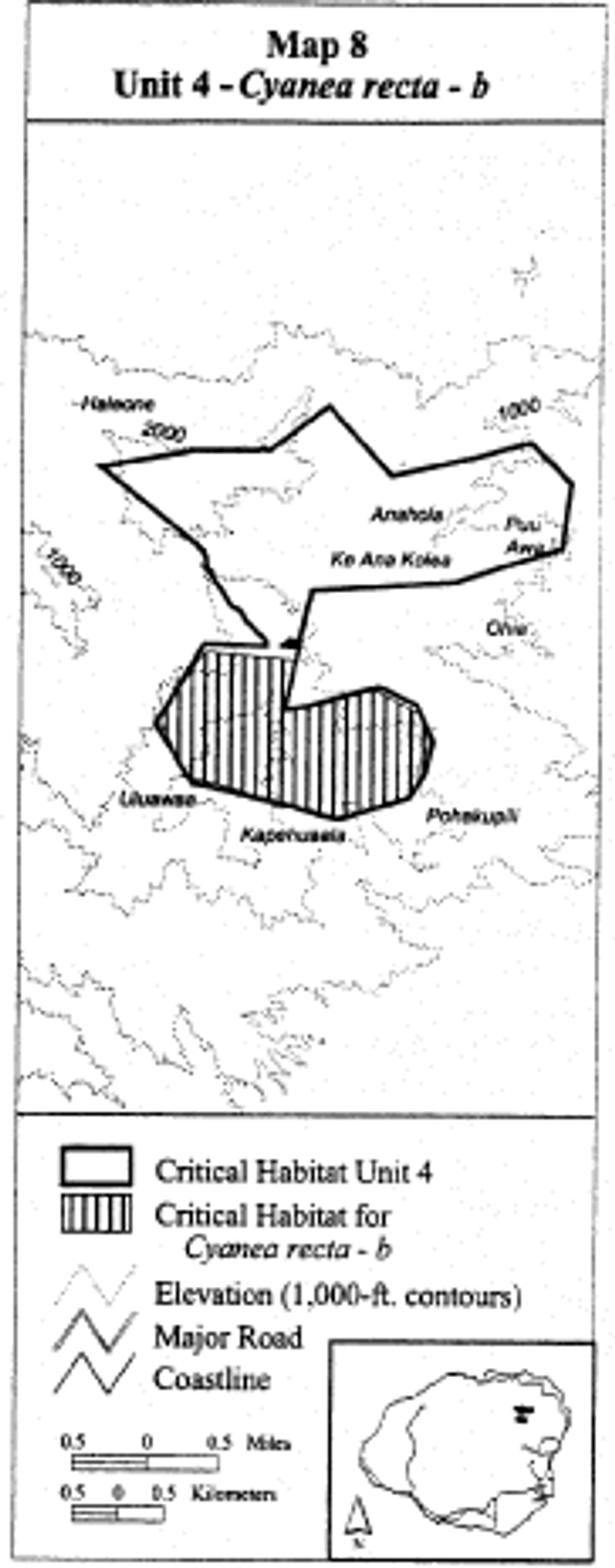
(xii) Kauai 4 - Cyanea remyi - a (353 ha; 873 ac)
(A) [Reserved]
(B) Map 9 follows:
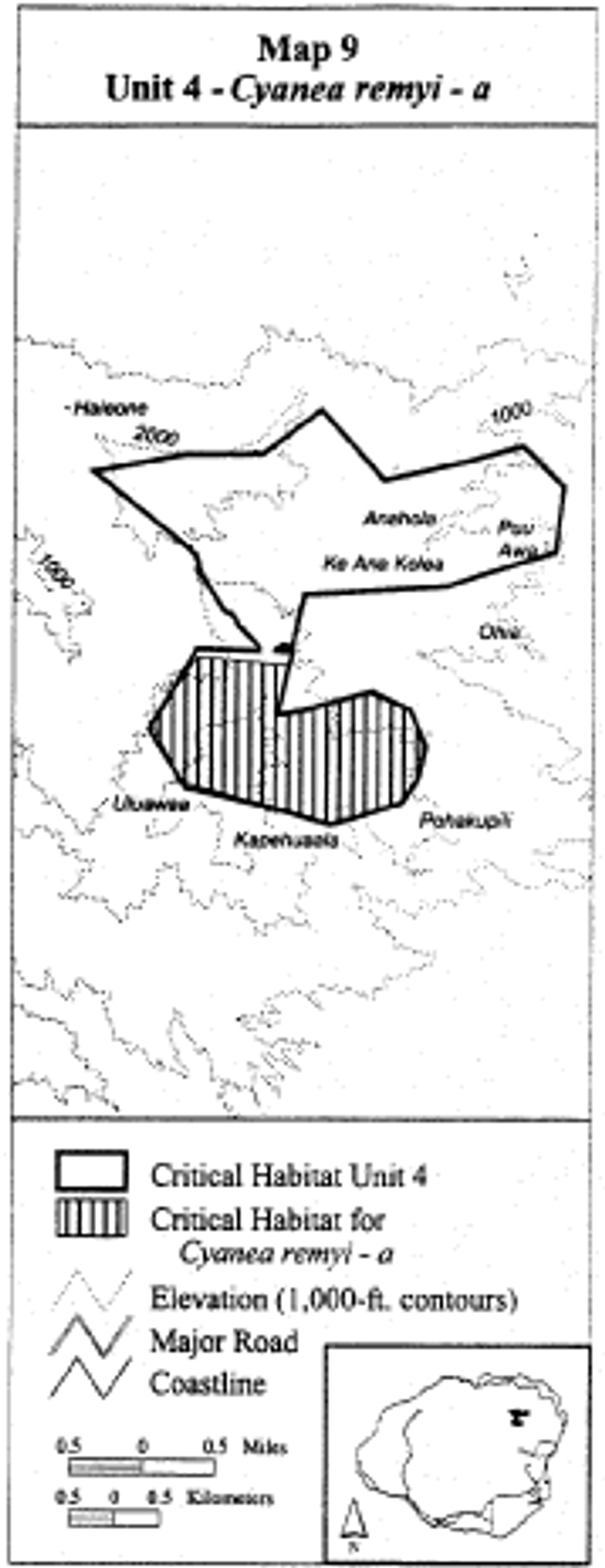
(xiii) Kauai 4 - Cyrtandra cyaneoides - a (376 ha; 928 ac)
(A) [Reserved]
(B) Map 10 follows:
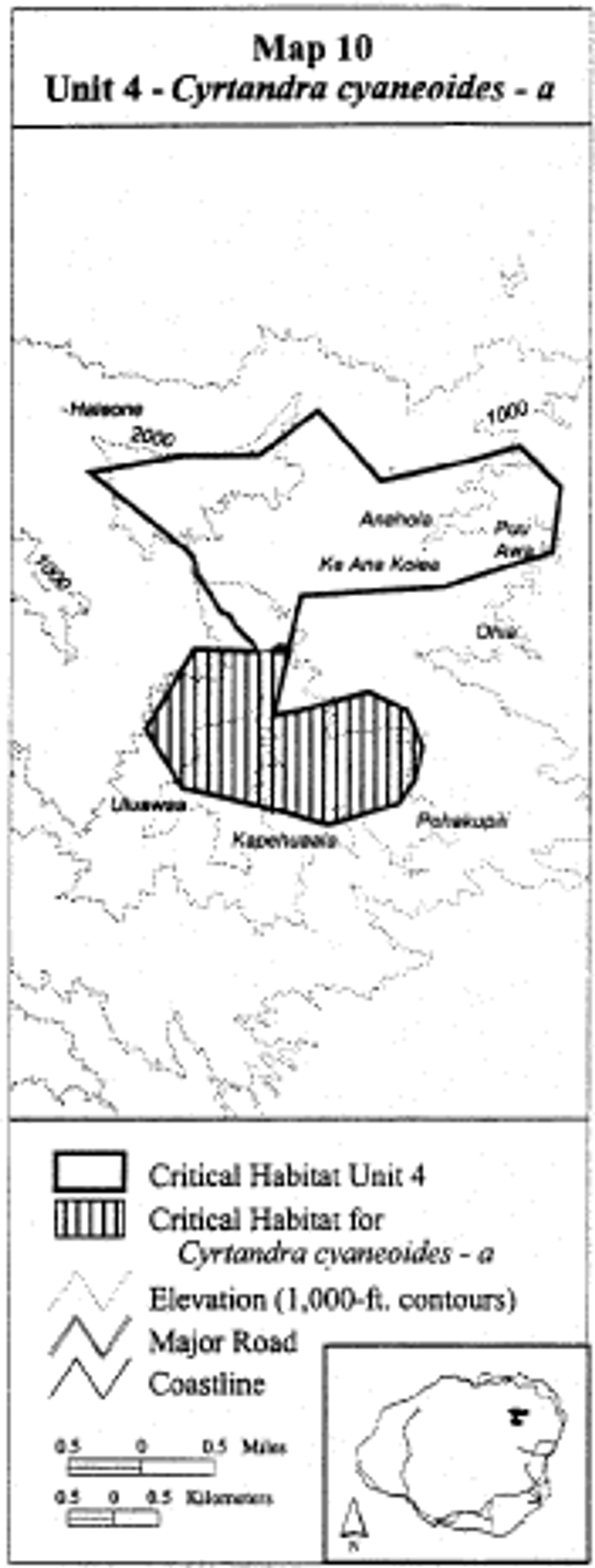
(xiv) Kauai 4- Cyrtandra kealiae ssp. kealiae -a (501 ha; 1,237 ac)
(A) [Reserved]
(B) Note: The reference to �Unit 4- Cyrtandra limahuliensis -a� on the map is equivalent to �Kauai 4- Cyrtandra kealiae ssp. kealiae -a�. Map 11 follows:
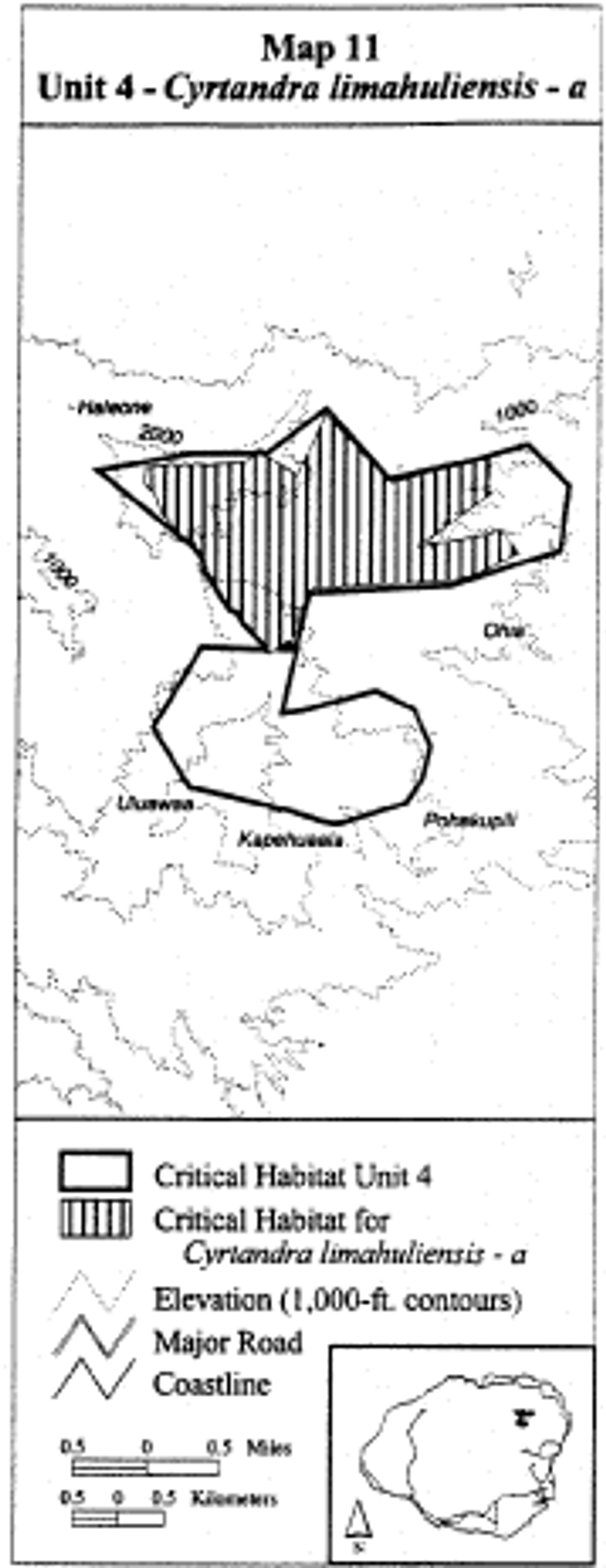
(xv) Kauai 4- Cyrtandra kealiae ssp. kealiae -b (353 ha; 873 ac)
(A) [Reserved]
(B) Note: The reference to �Unit 4- Cyrtandra limahuliensis -b� on the map is equivalent to �Kauai 4- Cyrtandra kealiae ssp. kealiae- b�. Map 12 follows:
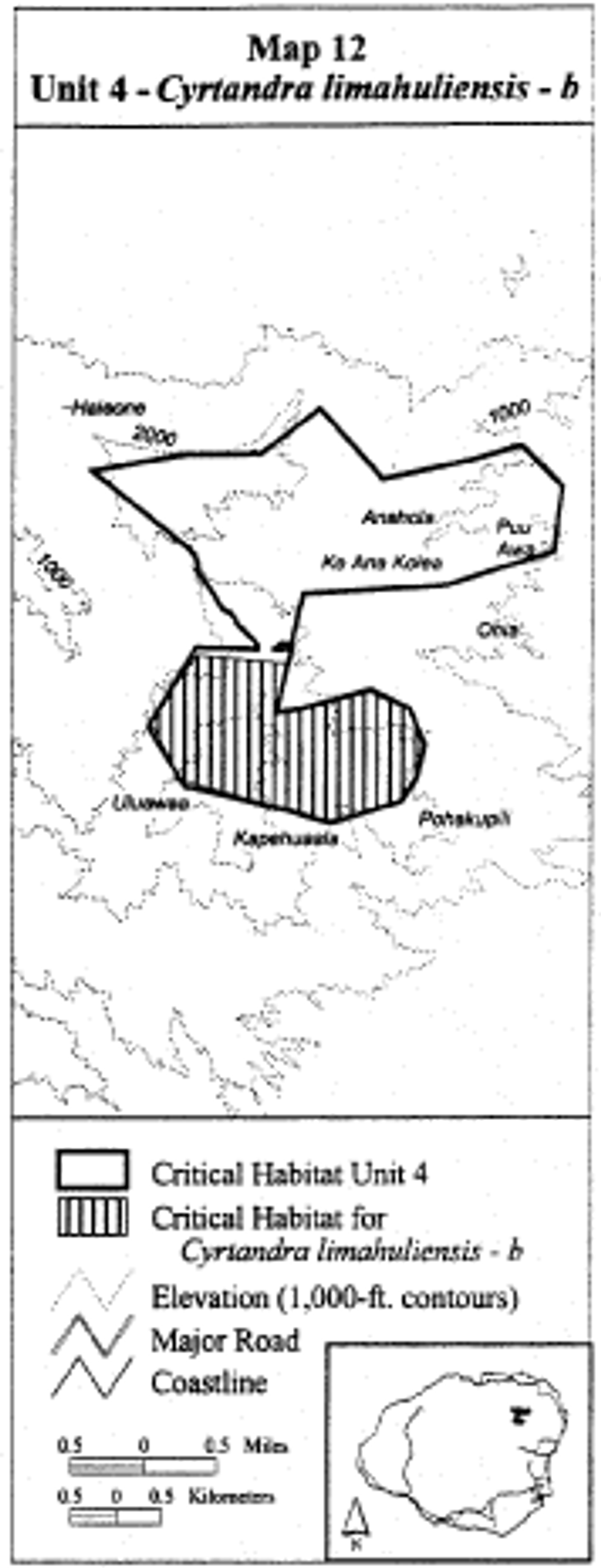
(xvi) Kauai 4-Cyrtandra oenobarba-a
(A) [Reserved]
(B) See paragraph (a)(1)(vi)(B) of this section for the map of this unit.
(xvii) Kauai 4-Cyrtandra paliku-a
(A) [Reserved]
(B) See paragraph (a)(1)(vi)(B) of this section for the map of this unit.
(xviii) Kauai 4-Dubautia plantaginea ssp. magnifolia-a
(A) [Reserved]
(B) See paragraph (a)(1)(vi)(B) of this section for the map of this unit.
(xix) Kauai 4 - Hibiscus clayi - a (4 ha; 9 ac)
(A) [Reserved]
(B) Map 13 follows:
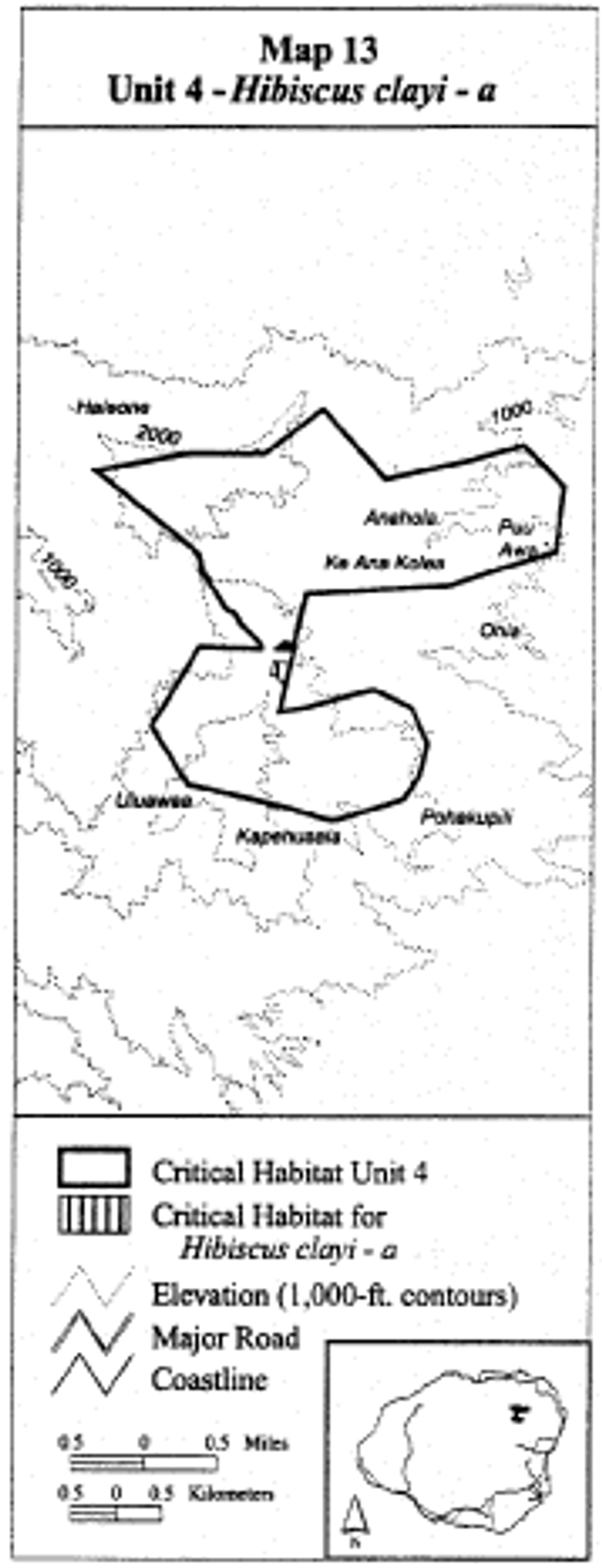
(xx) Kauai 4 - Hibiscus clayi - b (85 ha; 210 ac)
(A) [Reserved]
(B) Map 14 follows:
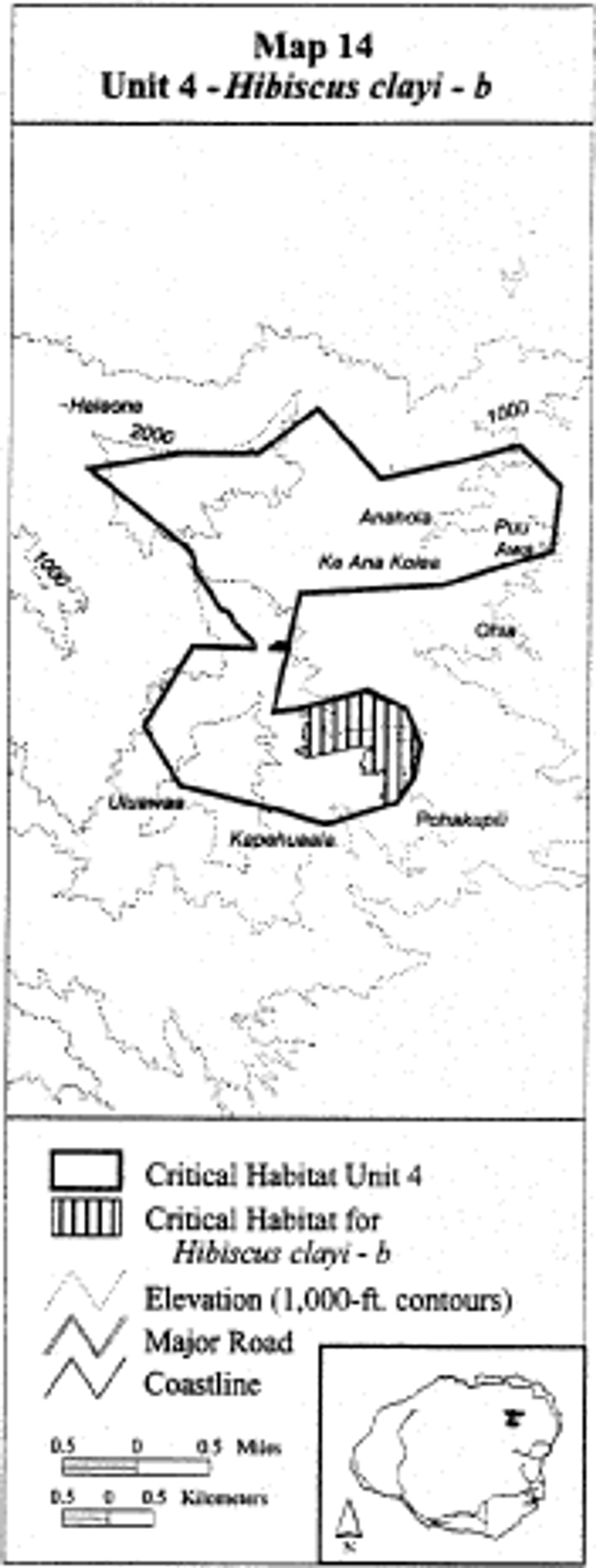
(xxi) Kauai 4 - Hibiscus clayi - c (590 ha; 1,458 ac)
(A) [Reserved]
(B) Map 15 follows:
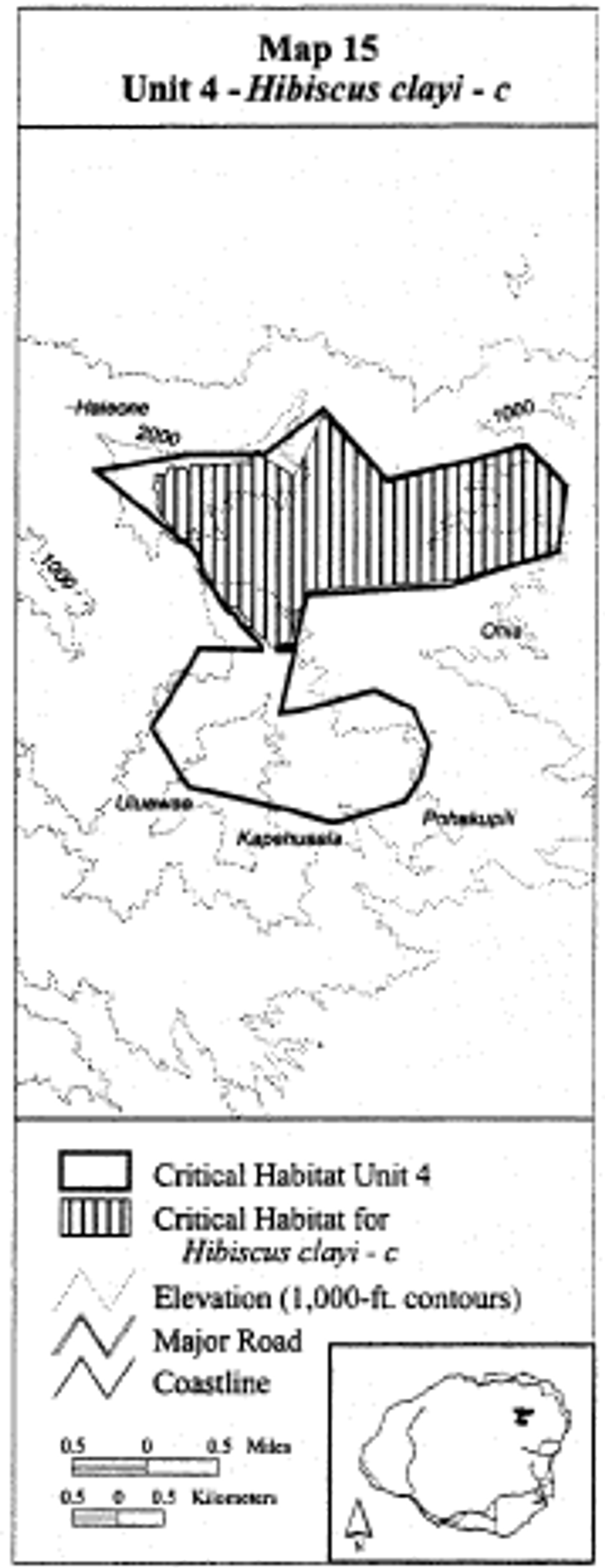
(xxii) Kauai 4 - Hibiscus clayi - d (48 ha; 119 ac)
(A) [Reserved]
(B) Map 16 follows:
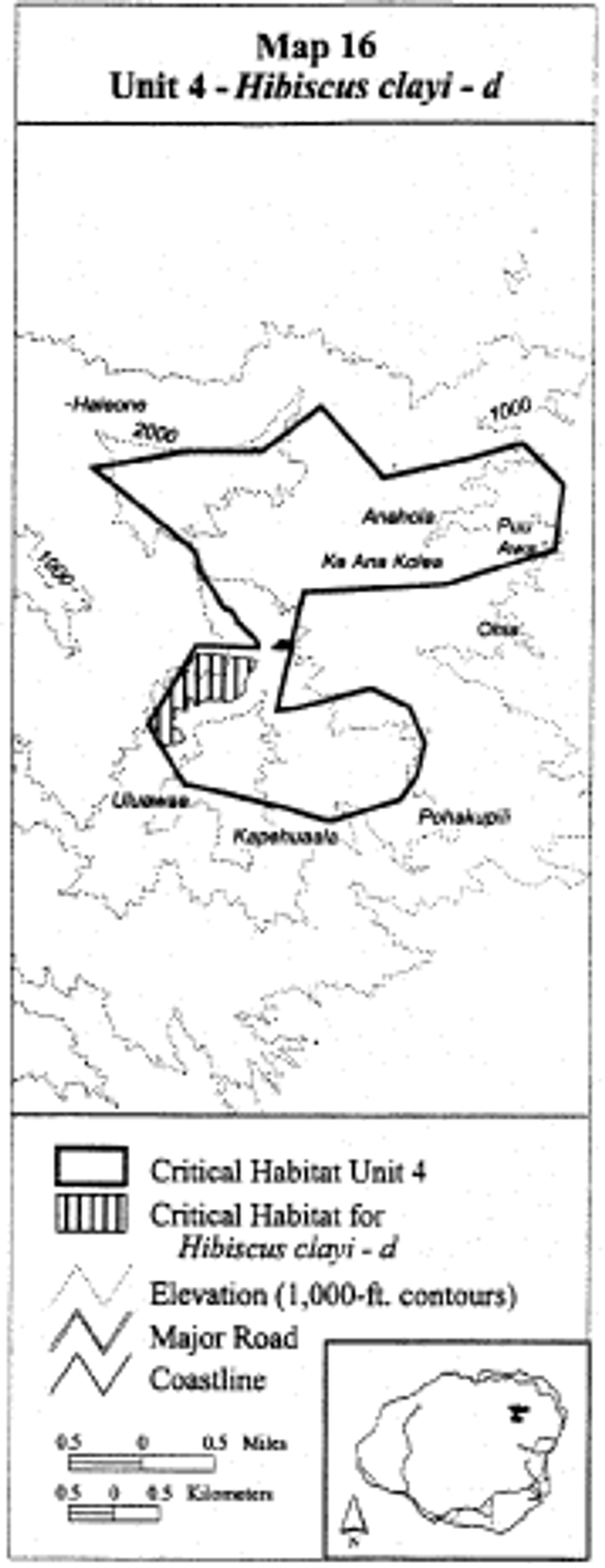
(xxiii) Kauai 4 - Hibiscus clayi - e (19 ha; 47 ac)
(A) [Reserved]
(B) Map 17 follows:
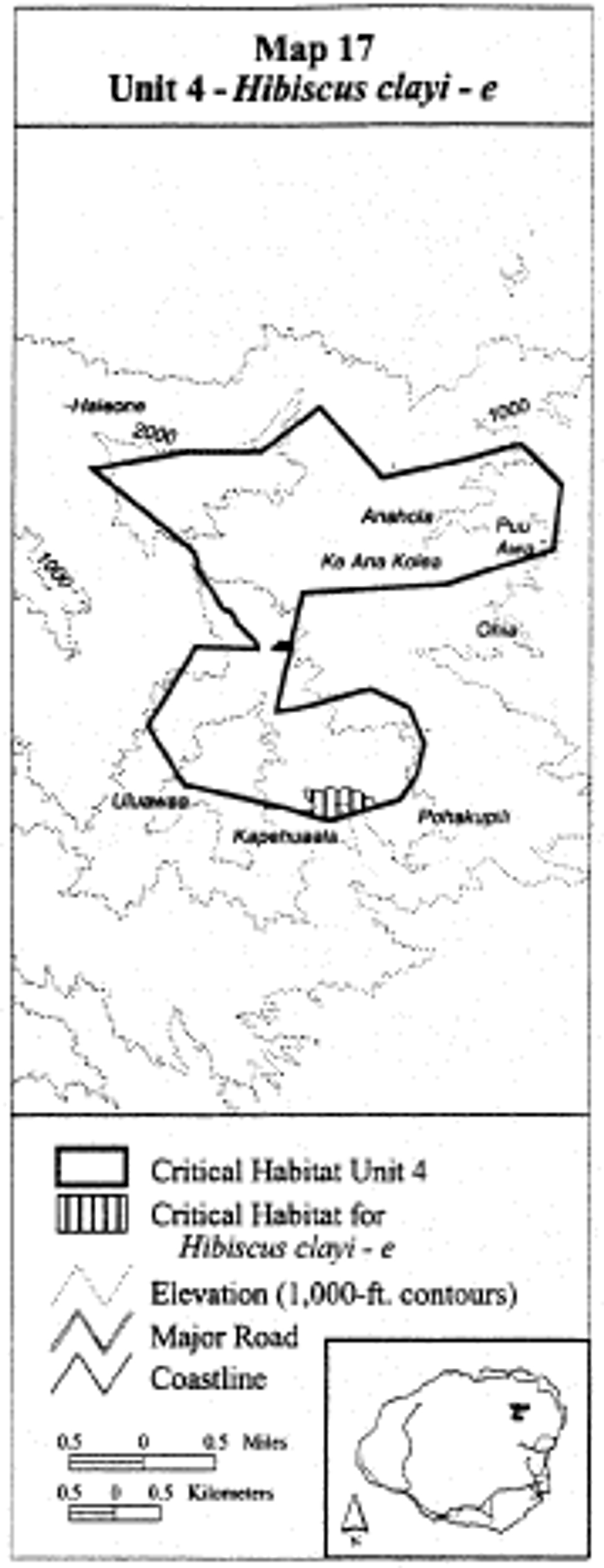
(xxiv) Kauai 4 - Labordia lydgatei - a (588 ha; 1,453 ac)
(A) [Reserved]
(B) Map 18 follows:
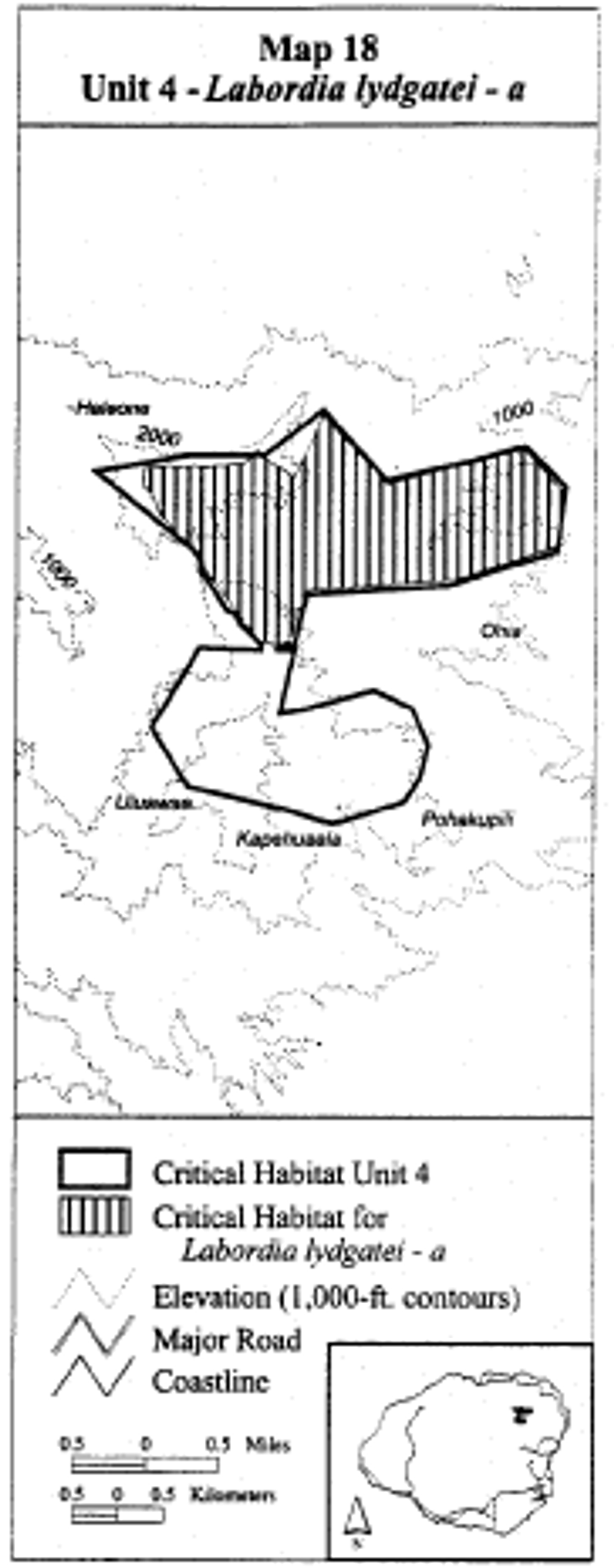
(xxv) Kauai 4-Lysimachia iniki-a
(A) [Reserved]
(B) See paragraph (a)(1)(vi)(B) of this section for the map of this unit.
(xxvi) Kauai 4-Lysimachia pendens-a
(A) [Reserved]
(B) See paragraph (a)(1)(vi)(B) of this section for the map of this unit.
(xxvii) Kauai 4- Lysimachia venosa-a
(A) [Reserved]
(B) See paragraph (a)(1)(vi)(B) of this section for the map of this unit.
(xxviii) Kauai 4 - Phyllostegia wawrana - a (352 ha; 869 ac)
(A) [Reserved]
(B) Map 19 follows:
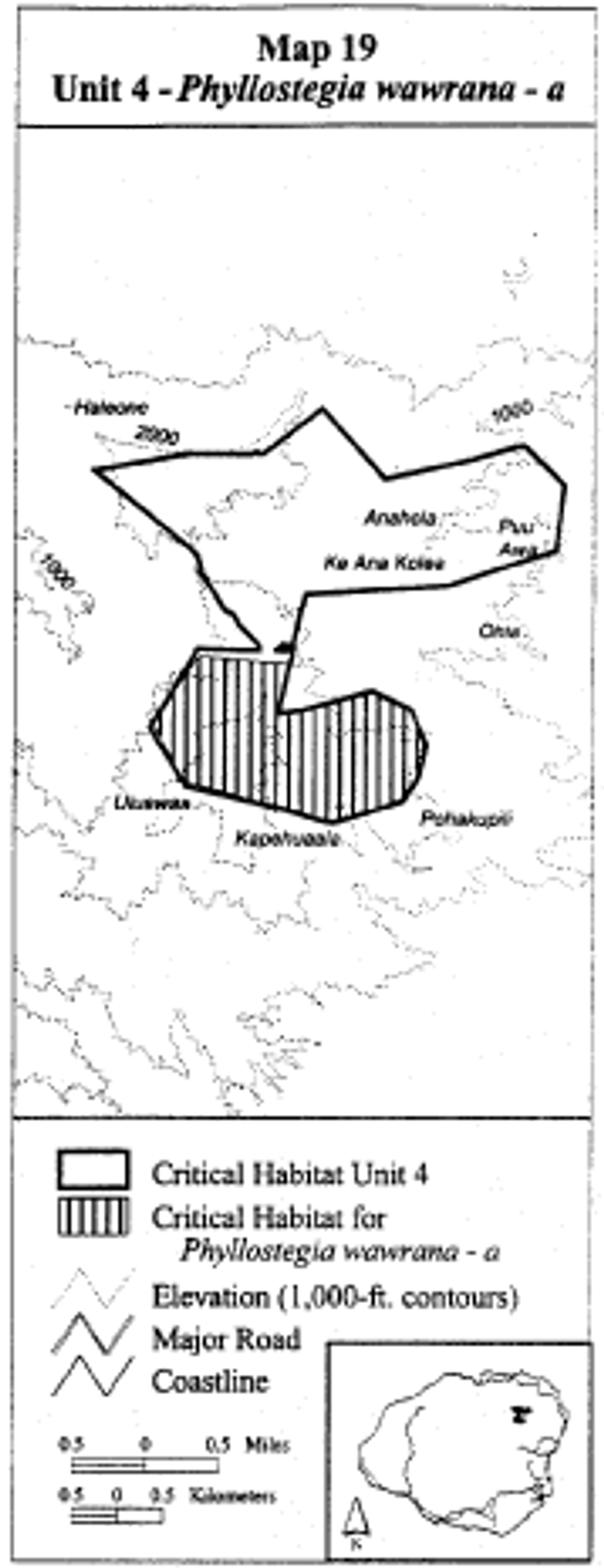
(xxix) Kauai 4- Melicope rostrata -a
(A) [Reserved]
(B) Note: The reference to �Unit 4- Cyrtandra limahuliensis -b� on the map is equivalent to �Kauai 4- Cyrtandra kealiae ssp. kealiae- b�. Map 12 follows:
(xxx) Kauai 5 - Hibiscus clayi - f (60 ha; 148 ac)
(A) [Reserved]
(B) Map 20 follows:
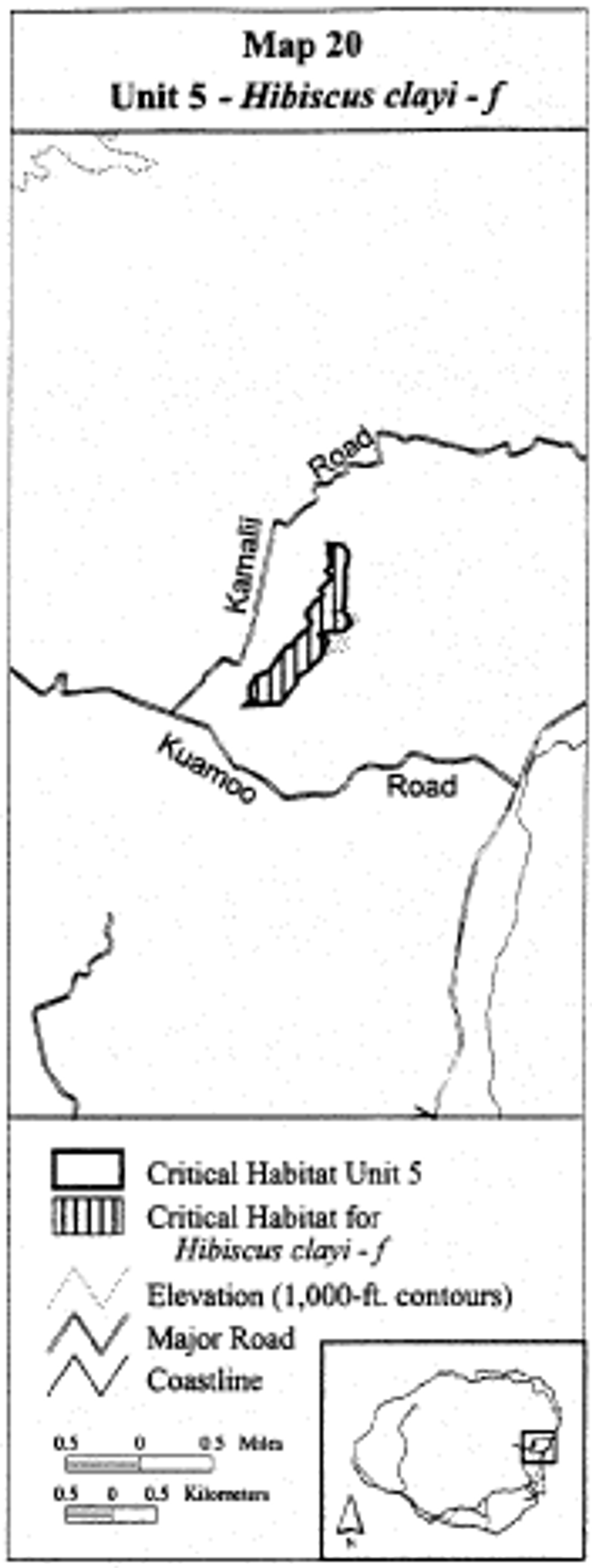
(xxxi) Kauai 5 - Munroidendron racemosum - a (60 ha; 148 ac)
(A) [Reserved]
(B) Map 21 follows:
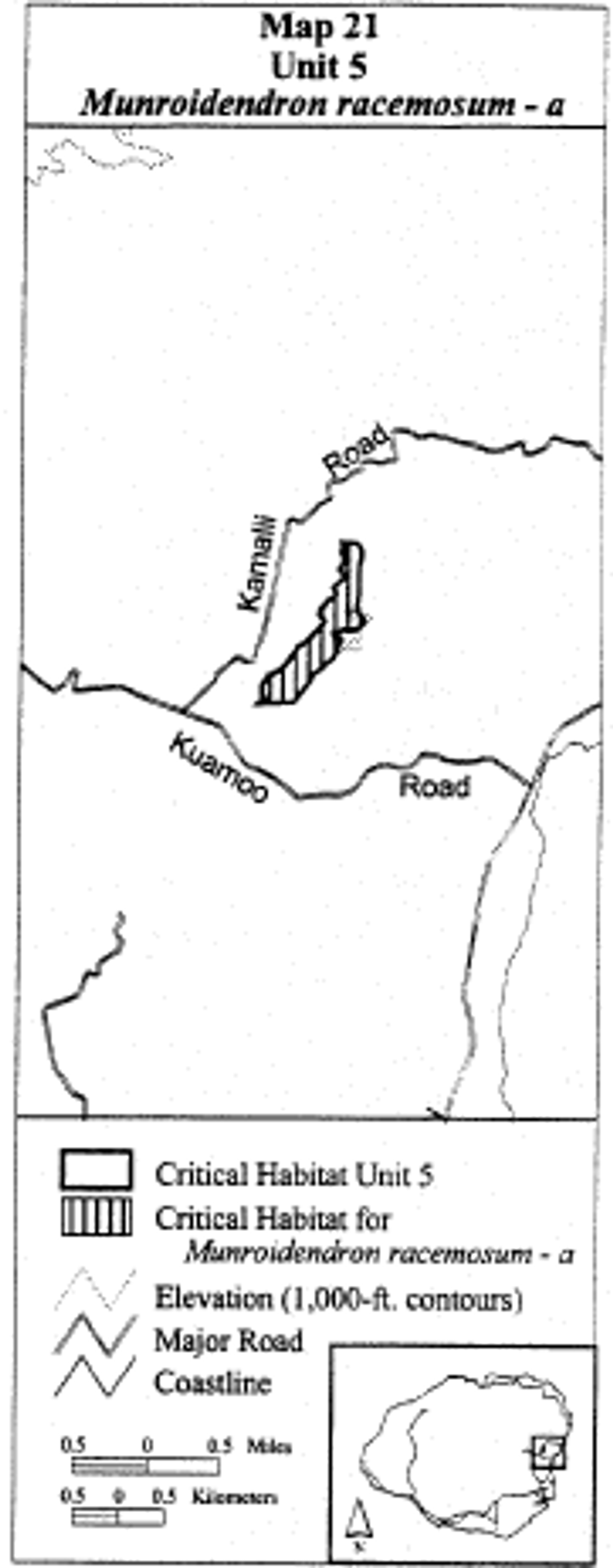
(xxxii) Kauai 6 - Brighamia insignis - a (63 ha; 156 ac)
(A) [Reserved]
(B) Map 22 follows:
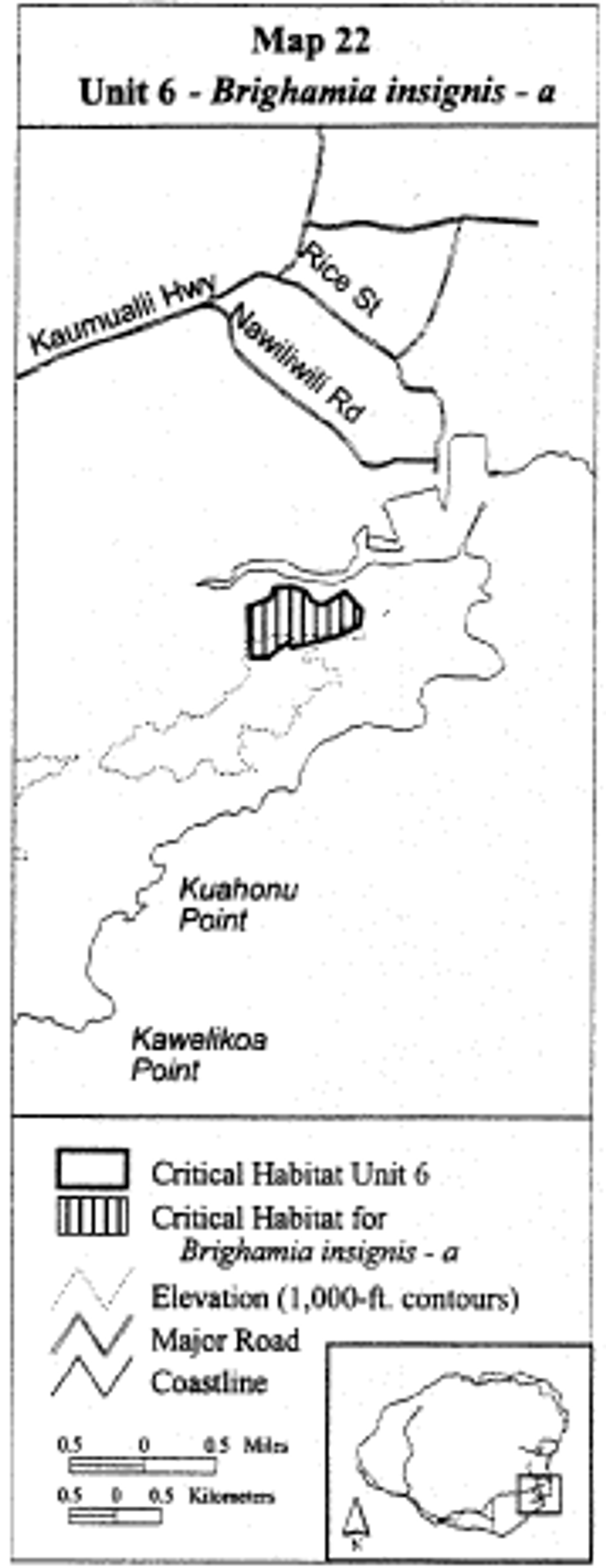
(xxxiii) Kauai 7 - Brighamia insignis - b (341 ha; 842 ac)
(A) [Reserved]
(B) Map 23 follows:
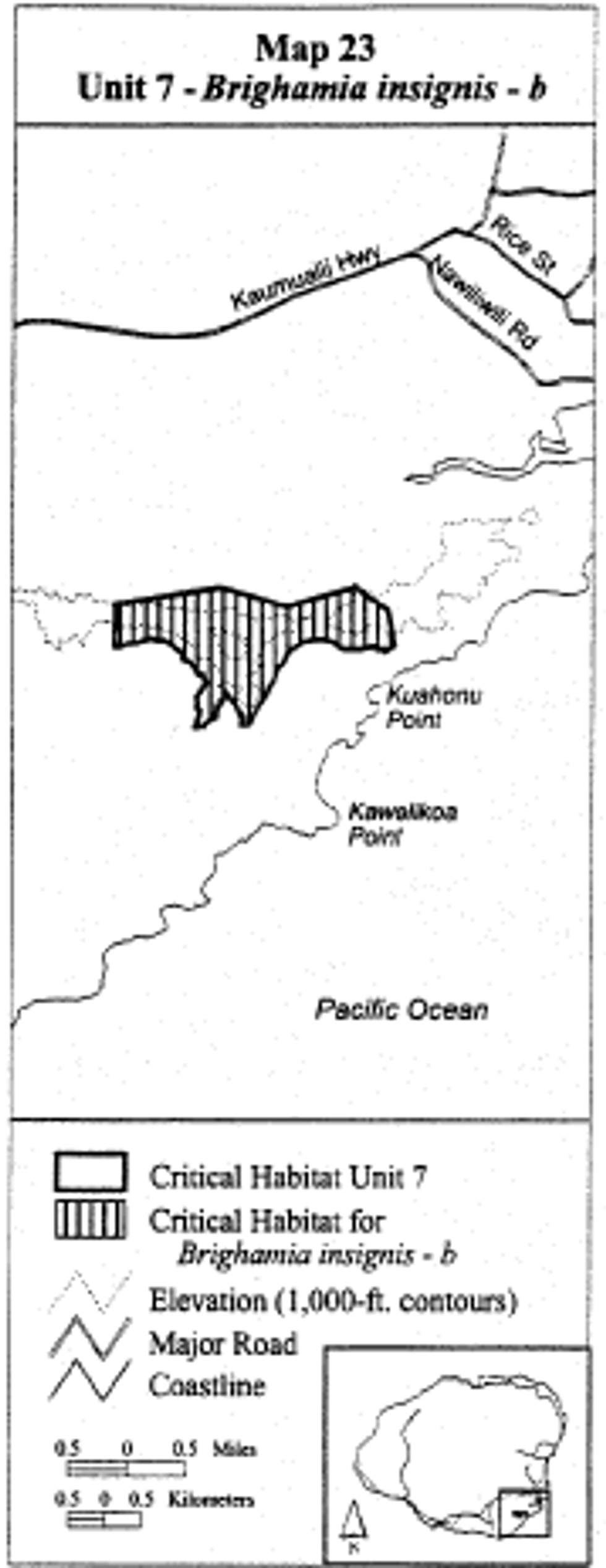
(xxxiv) Kauai 7-Canavalia napaliensis-a (37 ac; 15 ha)
(A) This is a unit of the Lowland Mesic ecosystem and consists of 37 ac (15 ha). This unit is also critical habitat for Kauai 7-Chamaesyce eleanoriae-a, Kauai 7-Chamaesyce remyi var. remyi-b, Kauai 7-Charpentiera densiflora-a, Kauai 7-Doryopteris angelica-a, Kauai 7-Dubautia kenwoodii-a, Kauai 7-Labordia helleri-a, Kauai 7-Pittosporum napaliense-a, Kauai 7- Melicope rostrata -b, Kauai 7-Psychotria hobdyi-a, and Kauai 7-Tetraplasandra bisattenuata-a (see paragraphs (a)(1)(xxxv), (a)(1)(xxxvi), (a)(1)(xxxvii), (a)(1)(xxxix), (a)(1)(xl), (a)(1)(xlii), (a)(1)(xlviii), (a)(1)(xlix), (a)(1)(l), and (a)(1)(liii), respectively, of this section).
(B) Note: The reference to �Kauai 7- Platydesma rostrata -b� on the map is equivalent to �Kauai 7- Melicope rostrata -b�. Map 23a follows
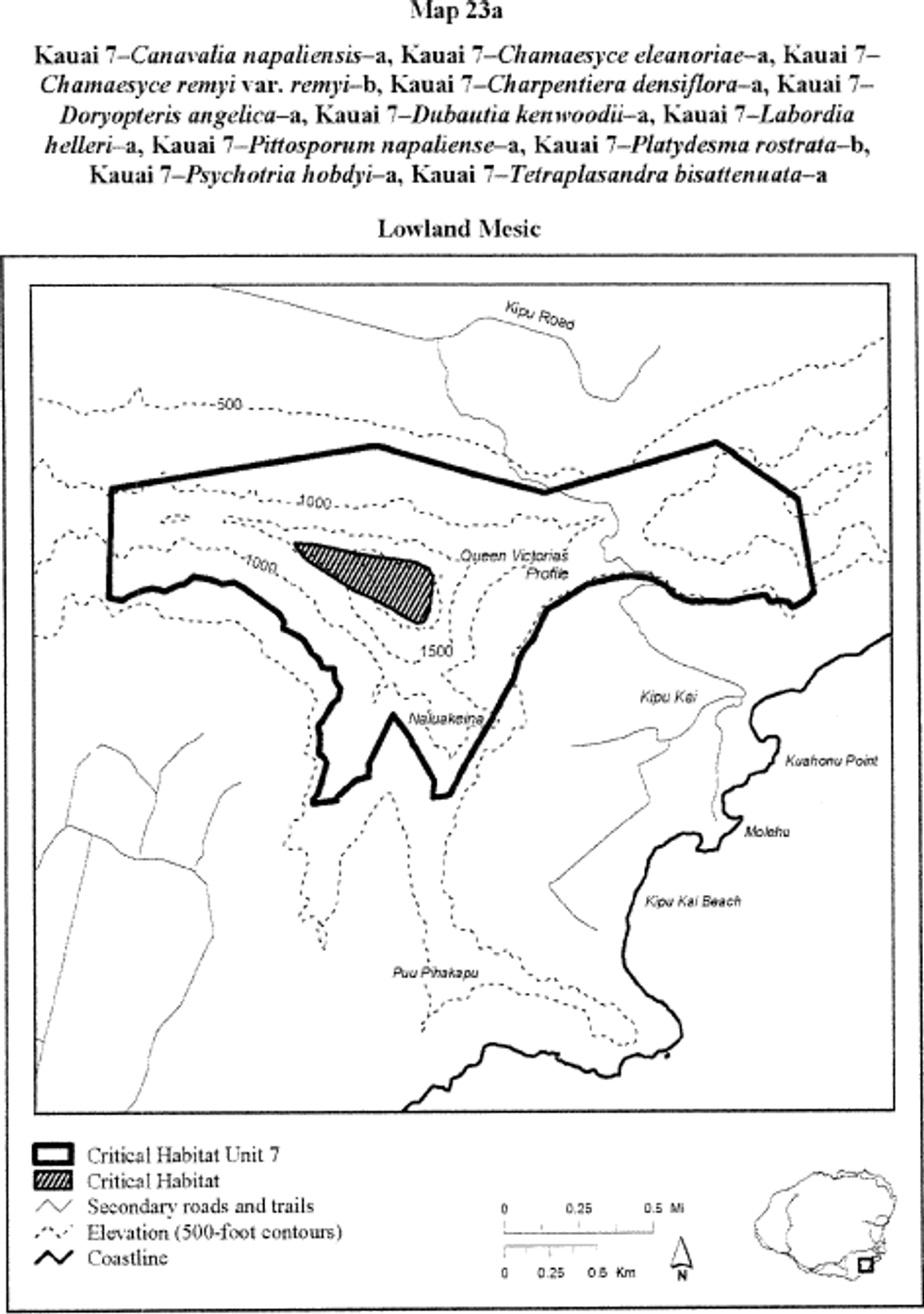
(xxxv) Kauai 7-Chamaesyce eleanoriae-a
(A) [Reserved]
(B) See paragraph (a)(1)(xxxiv)(B) of this section for the map of this unit.
(xxxvi) Kauai 7-Chamaesyce remyi var. remyi-b
(A) [Reserved]
(B) See paragraph (a)(1)(xxxiv)(B) of this section for the map of this unit.
(xxxvii) Kauai 7-Charpentiera densiflora-a
(A) [Reserved]
(B) See paragraph (a)(1)(xxxiv)(B) of this section for the map of this unit.
(xxxviii) Kauai 7 - Delissea rhytidosperma - a (221 ha; 545 ac)
(A) [Reserved]
(B) Map 24 follows:
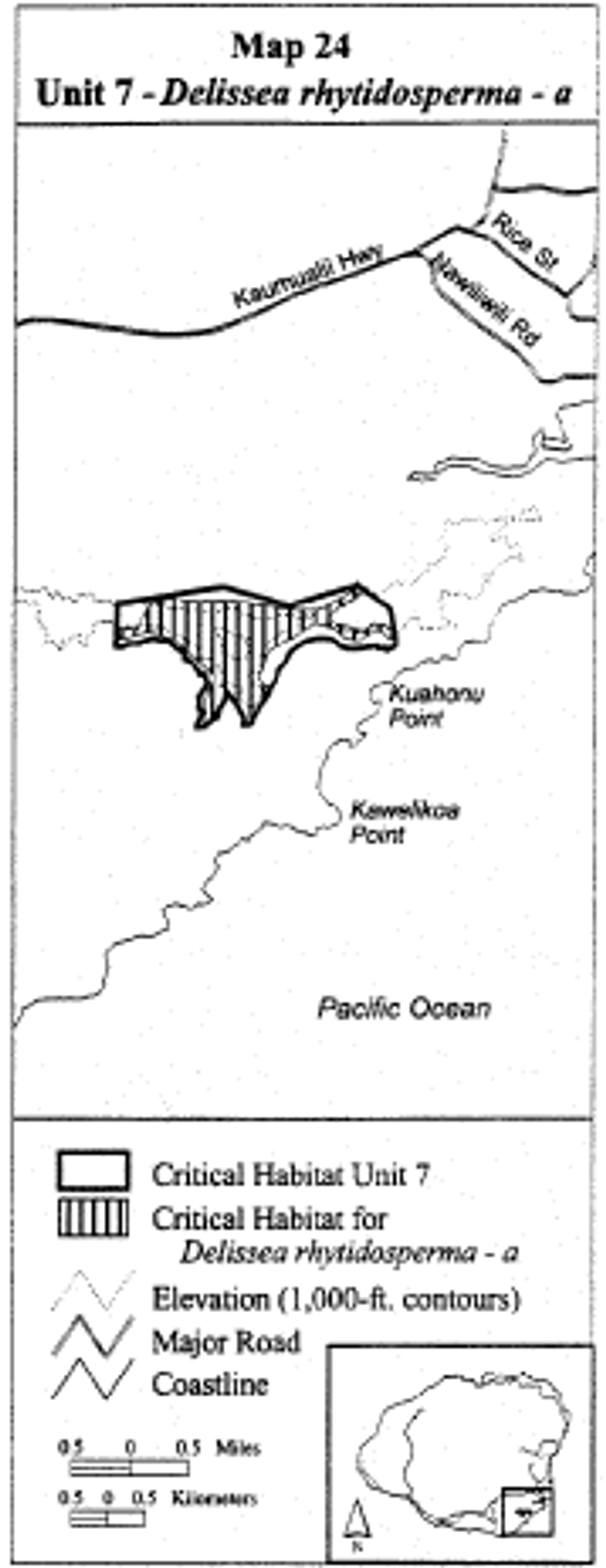
(xxxix) Kauai 7-Doryopteris angelica-a
(A) [Reserved]
(B) See paragraph (a)(1)(xxxiv)(B) of this section for the map of this unit.
(xl) Kauai 7-Dubautia kenwoodii-a
(A) [Reserved]
(B) See paragraph (a)(1)(xxxiv)(B) of this section for the map of this unit.
(xli) Kauai 7 - Isodendrion longifolium - a (337 ha; 833 ac)
(A) [Reserved]
(B) Map 25 follows:
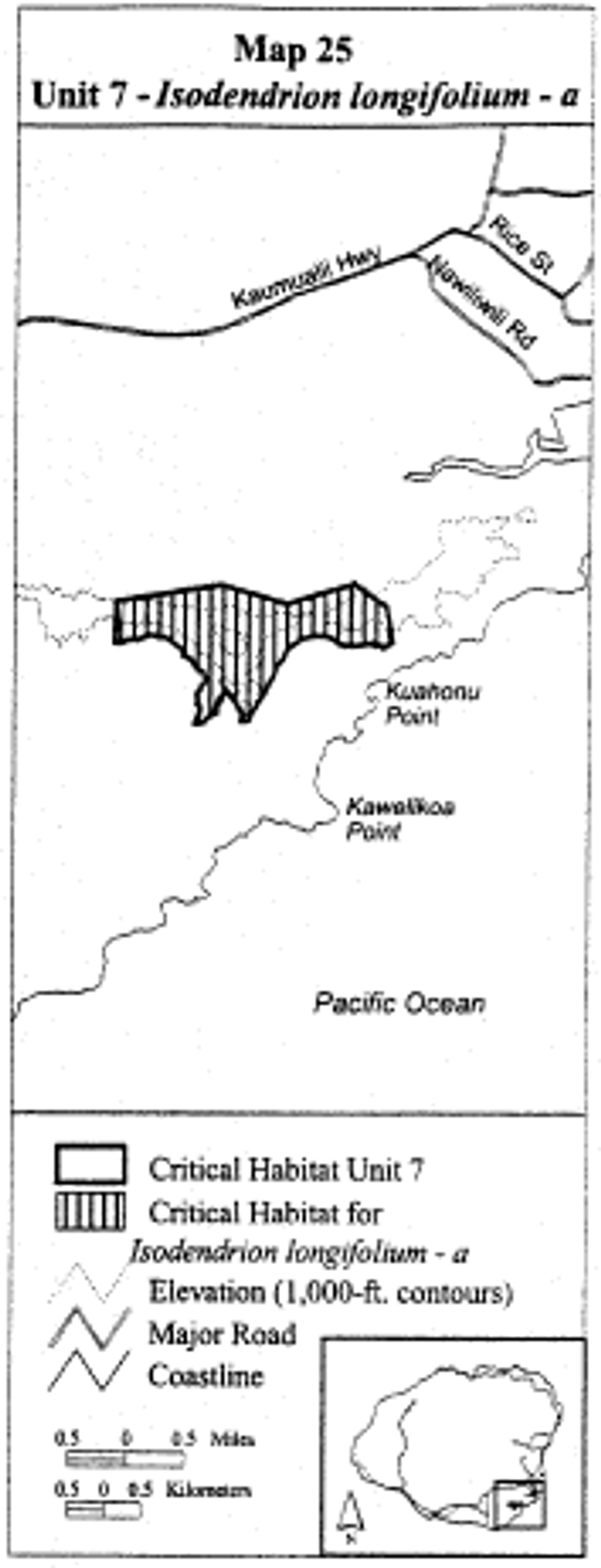
(xlii) Kauai 7-Labordia helleri-a
(A) [Reserved]
(B) See paragraph (a)(1)(xxxiv)(B) of this section for the map of this unit.
(xliii) Kauai 7 - Lipochaeta micrantha - a (341 ha; 842 ac)
(A) [Reserved]
(B) Map 26 follows:
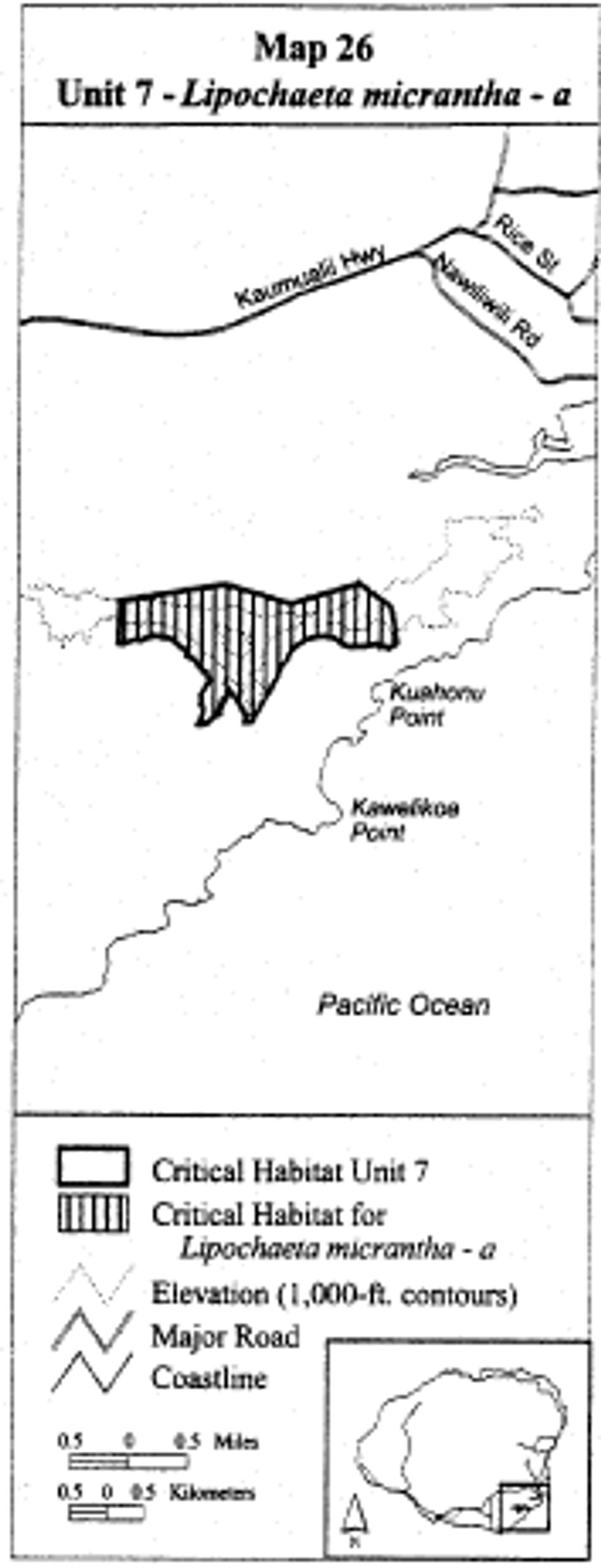
(xliv) Kauai 7 - Melicope haupuensis - a (330 ha; 816 ac)
(A) [Reserved]
(B) Map 27 follows:
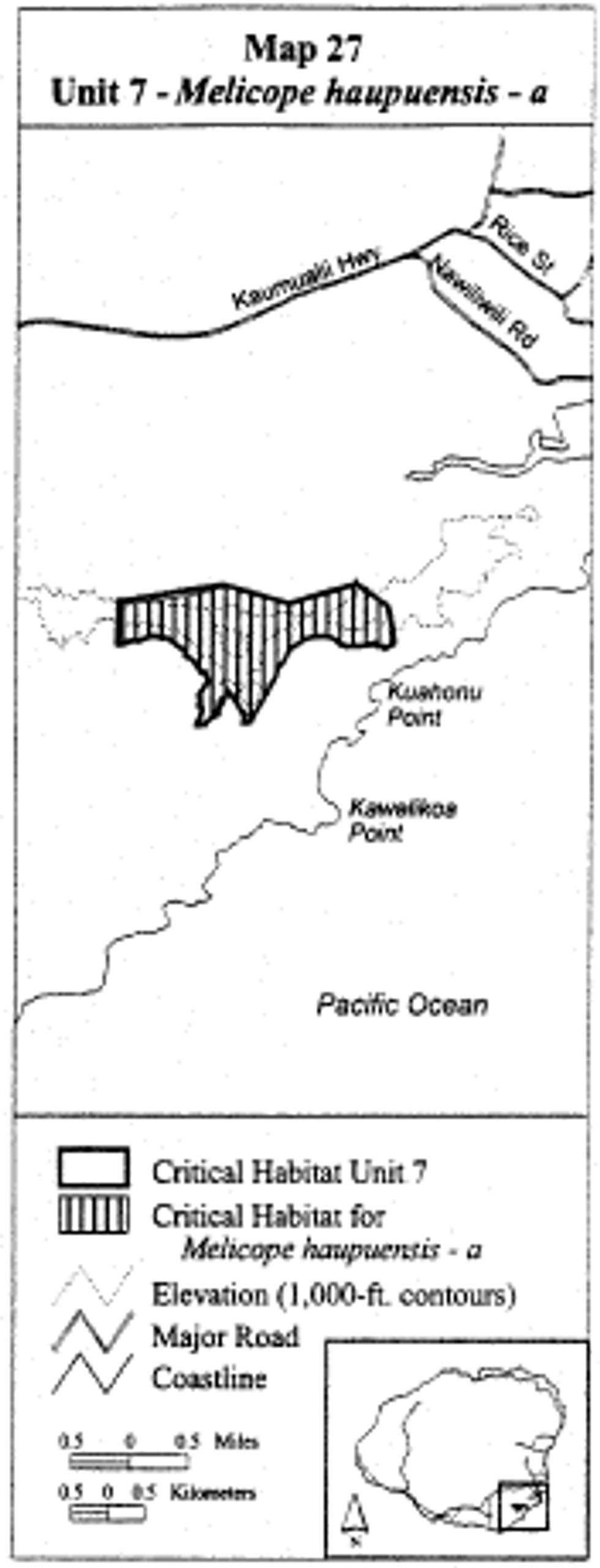
(xlv) Kauai 7 - Munroidendron racemosum - b (50 ha; 123 ac)
(A) [Reserved]
(B) Map 28 follows:
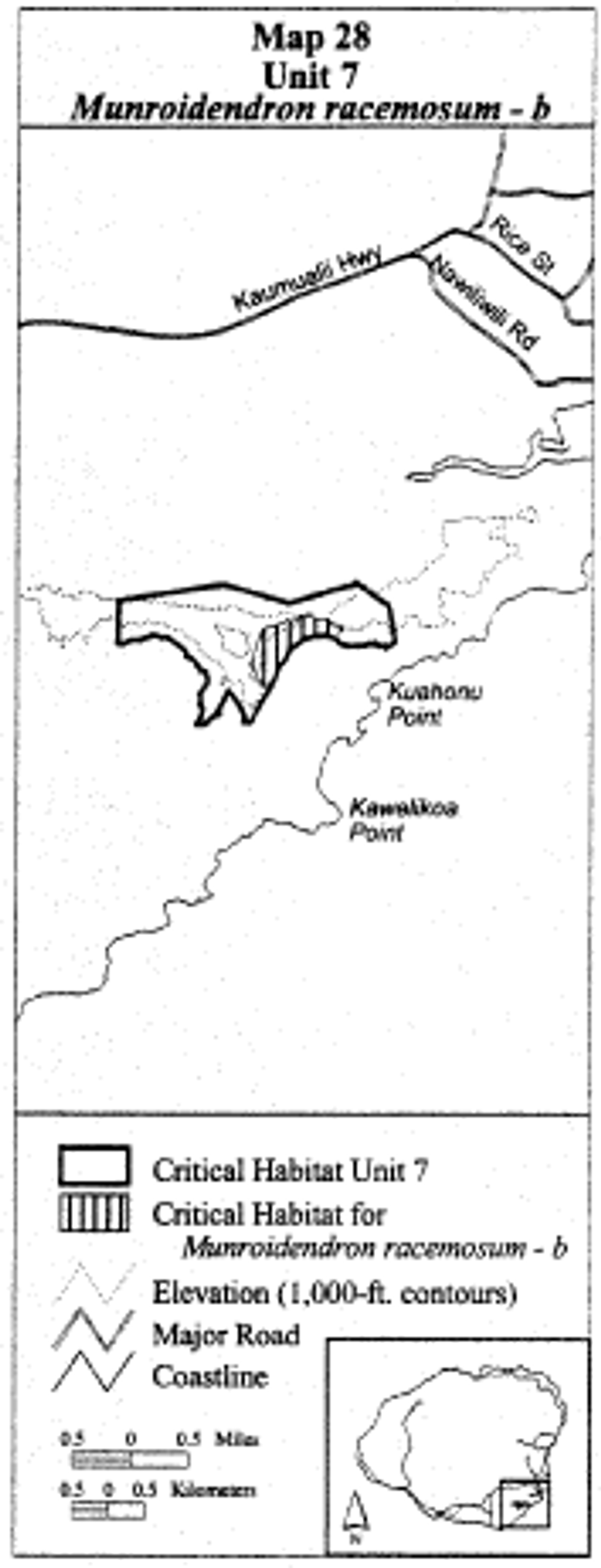
(xlvi) Kauai 7 - Myrsine linearifolia - a (334 ha; 826 ac)
(A) [Reserved]
(B) Map 29 follows:
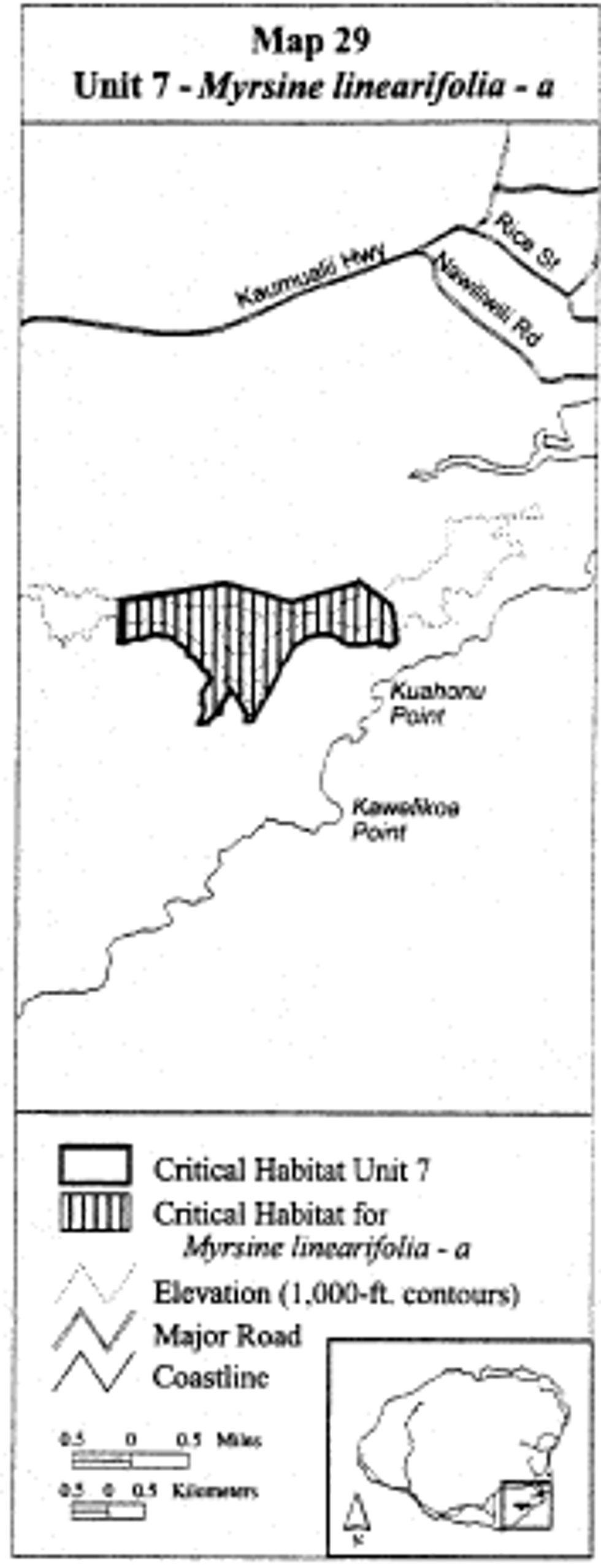
(xlvii) Kauai 7 - Peucedanum sandwicense - a (21 ha; 52 ac)
(A) [Reserved]
(B) Map 30 follows:
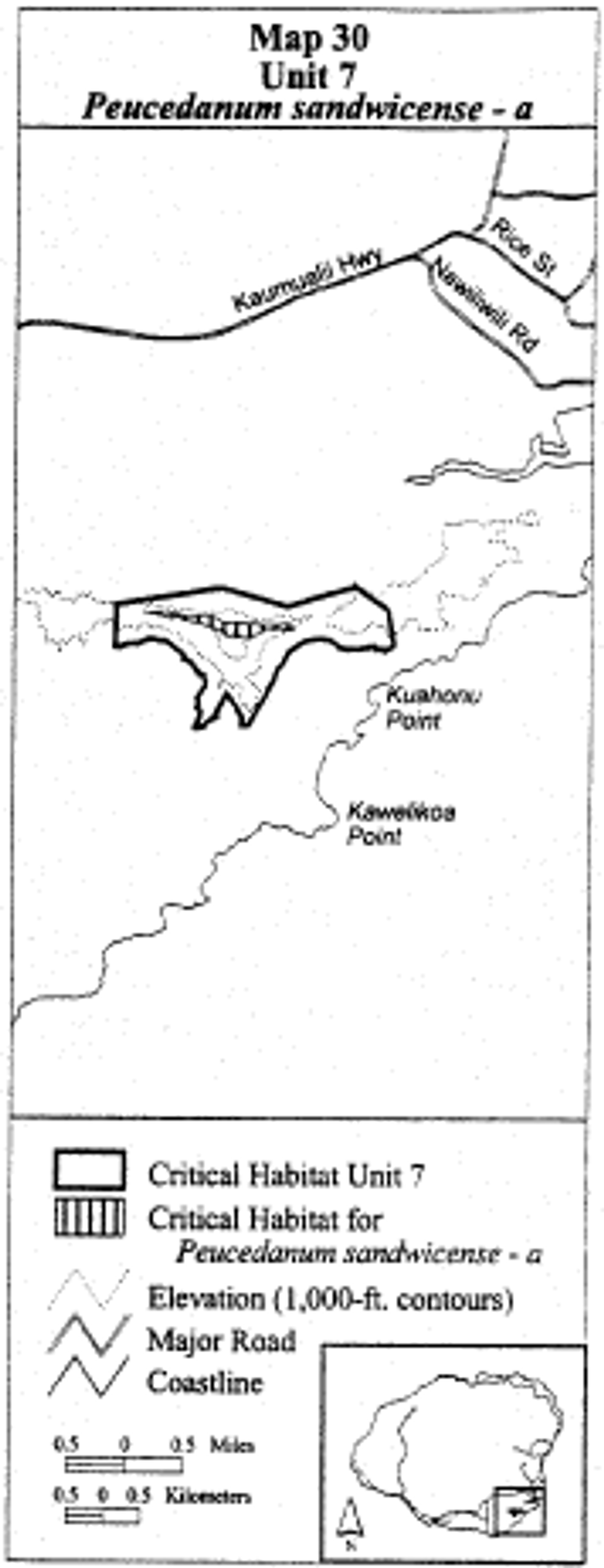
(xlviii) Kauai 7-Pittosporum napaliense-a
(A) [Reserved]
(B) See paragraph (a)(1)(xxxiv)(B) of this section for the map of this unit.
(xlix) Kauai 7- Melicope rostrata -b
(A) [Reserved]
(B) See paragraph (a)(1)(xxxiv)(B) of this section for the map of this unit.
(l) Kauai 7-Psychotria hobdyi-a
(A) [Reserved]
(B) See paragraph (a)(1)(xxxiv)(B) of this section for the map of this unit.
(li) Kauai 7 - Pteralyxia kauaiensis - a (346 ha; 854 ac)
(A) [Reserved]
(B) Map 31 follows:
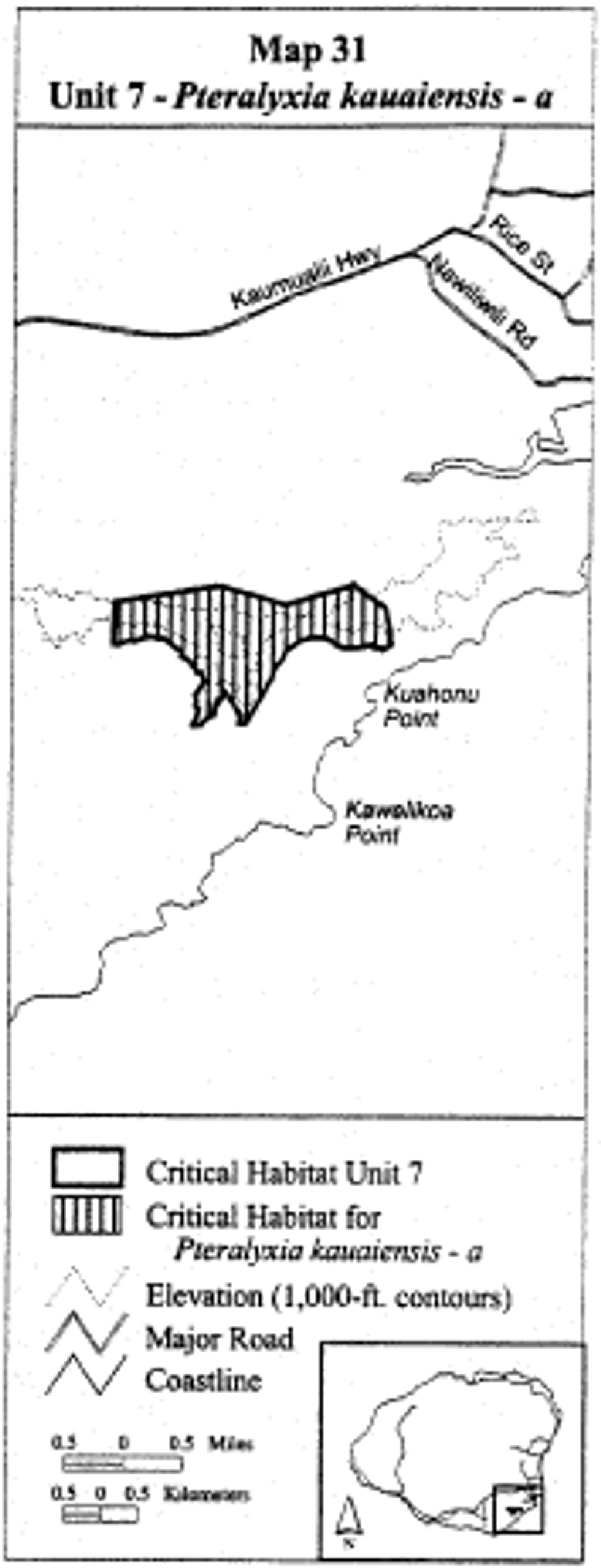
(lii) Kauai 7 - Schiedea nuttallii - a (282 ha; 697 ac)
(A) [Reserved]
(B) Map 32 follows:
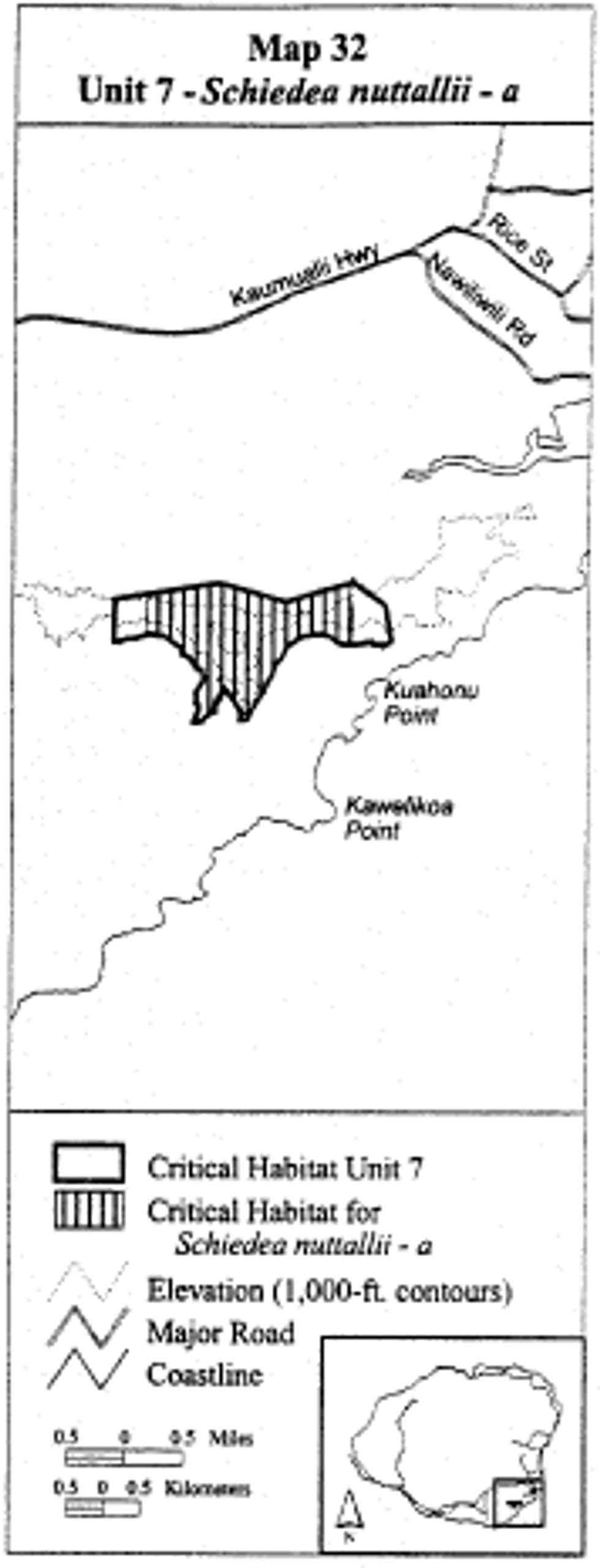
(liii) Kauai 7-Tetraplasandra bisattenuata-a
(A) [Reserved]
(B) See paragraph (a)(1)(xxxiv)(B) of this section for the map of this unit.
(liv) Kauai 8 - Sesbania tomentosa - a (47 ha; 117 ac)
(A) [Reserved]
(B) Map 33 follows:
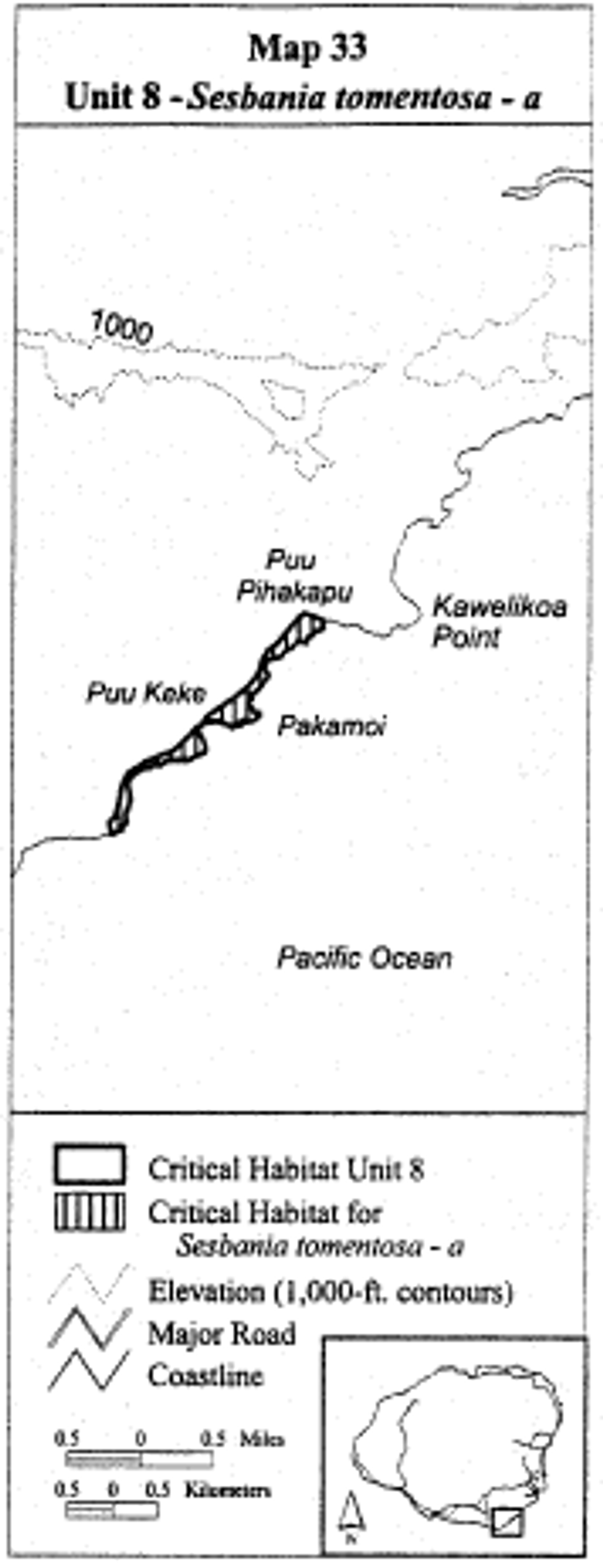
(lv) Kauai 9 - Schiedea spergulina var. leiopoda - a (5 ha; 11 ac)
(A) [Reserved]
(B) Map 34 follows:
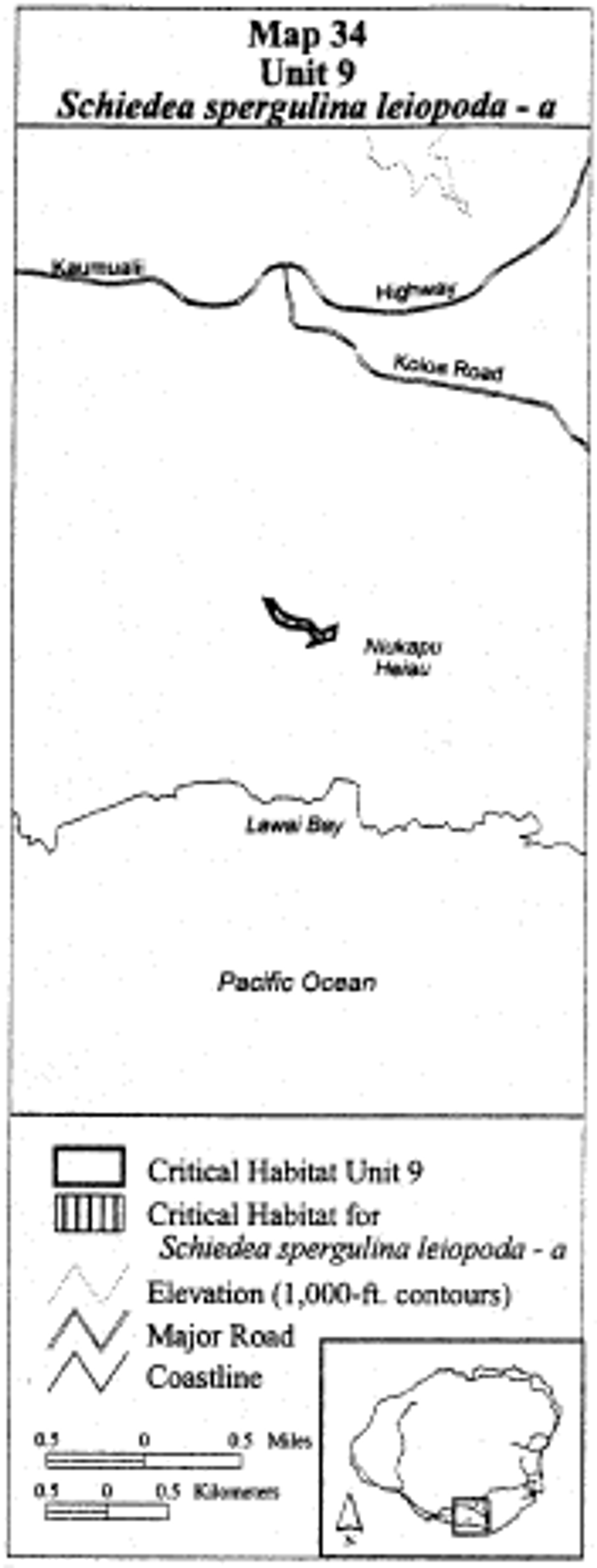
(lvi) Kauai 10 - Adenophorus periens - b (491 ha; 1,215 ac)
(A) [Reserved]
(B) Note: The reference to �Kauai 10- Platydesma rostrata -c� on the map is equivalent to �Kauai 10- Melicope rostrata -c�. Map 35a follows:
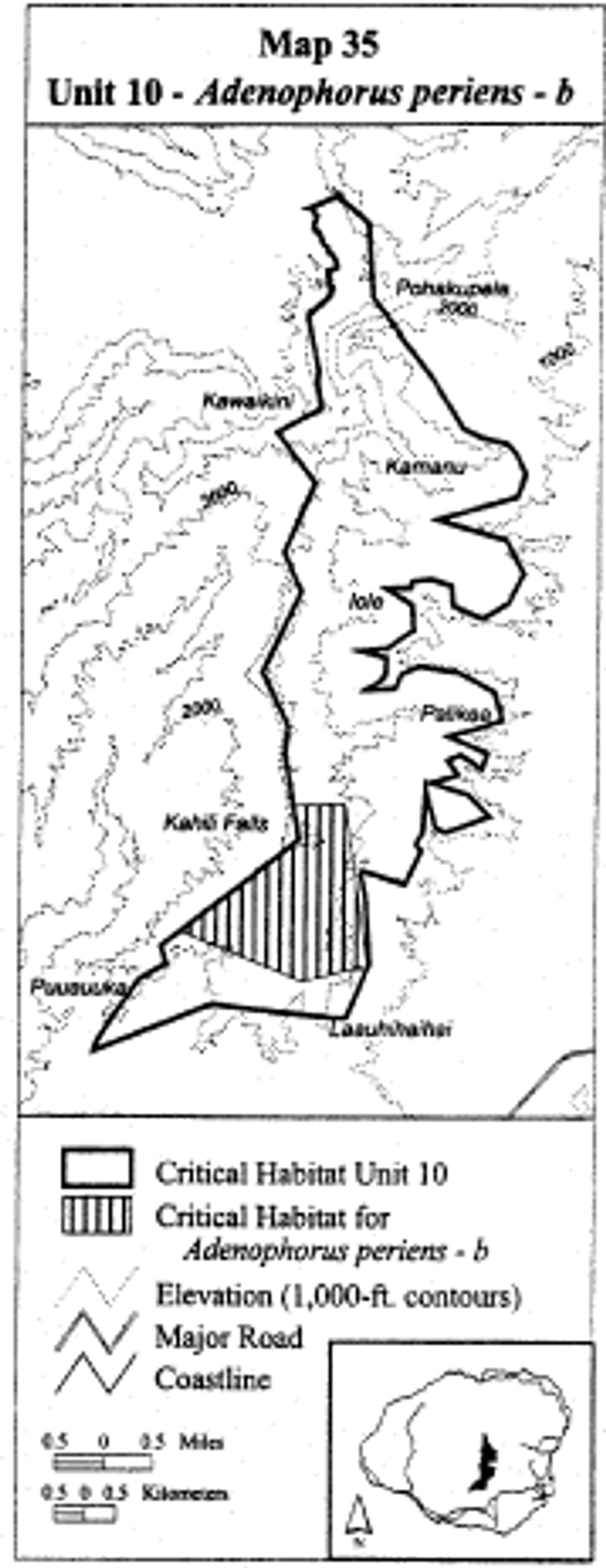
(lvii) Kauai 10 - Astelia waialealae - a
(A) This is a unit of the Montane Wet ecosystem and consists of 99 ac (40 ha). This unit is also critical habitat for Kauai 10-Chamaesyce remyi var. remyi-c, Kauai 10-Dryopteris crinalis var. podosorus-a, Kauai 10-Dubautia kalalauensis-a, Kauai 10-Dubautia waialealae-a, Kauai 10-Geranium kauaiense-a, Kauai 10-Keysseria erici-a, Kauai 10-Keysseria helenae-a, Kauai 10-Labordia helleri-b, Kauai 10-Labordia pumila-a, Kauai 10-Lysimachia daphnoides-a, Kauai 10-Melicope degeneri-a, Kauai 10-Melicope puberula-a, Kauai 10-Myrsine mezii-a, Kauai 10-Phyllostegia renovans-a, Kauai 10- Melicope rostrata -c, Kauai 10-Psychotria grandiflora-a, and Kauai 10-Tetraplasandra flynnii-a (see paragraphs (a)(1)(lxi), (a)(1)(lxxvi), (a)(1)(lxxviii), (a)(1)(lxxxi), (a)(1)(lxxxiii), (a)(1)(lxxxvi), (a)(1)(lxxxvii), (a)(1)(lxxxviii), (a)(1)(xci), (a)(1)(xciii), (a)(1)(xcviii), (a)(1)(c), (a)(1)(ciii), (a)(1)(cv), (a)(1)(cviii), (a)(1)(cxi), and (a)(1)(cxv), respectively, of this section).
(B) Map 35a follows:
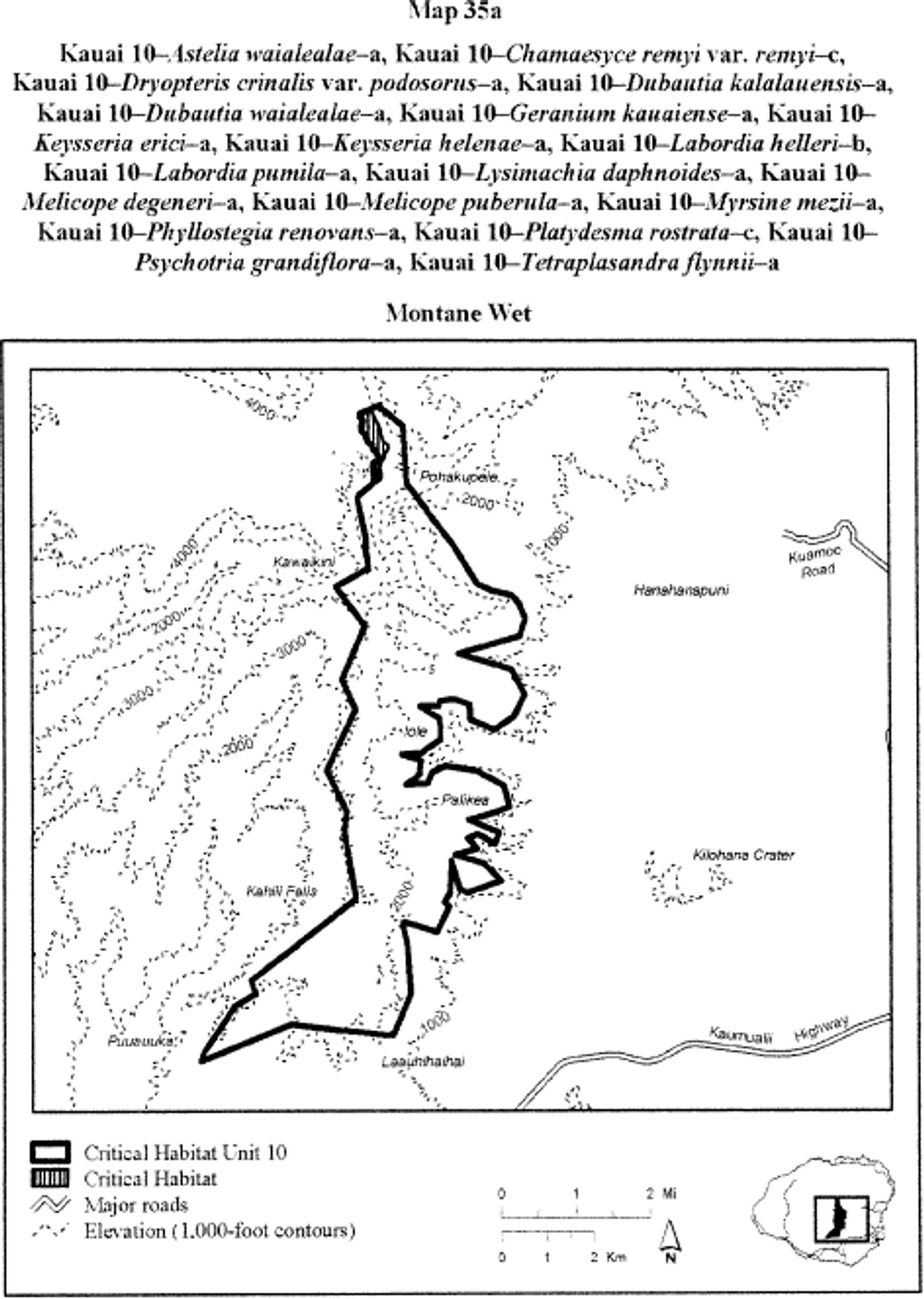
(lviii) Kauai 10 - Bonamia menziesii - a (421 ha; 1,039 ac)
(A) [Reserved]
(B) Map 36 follows:
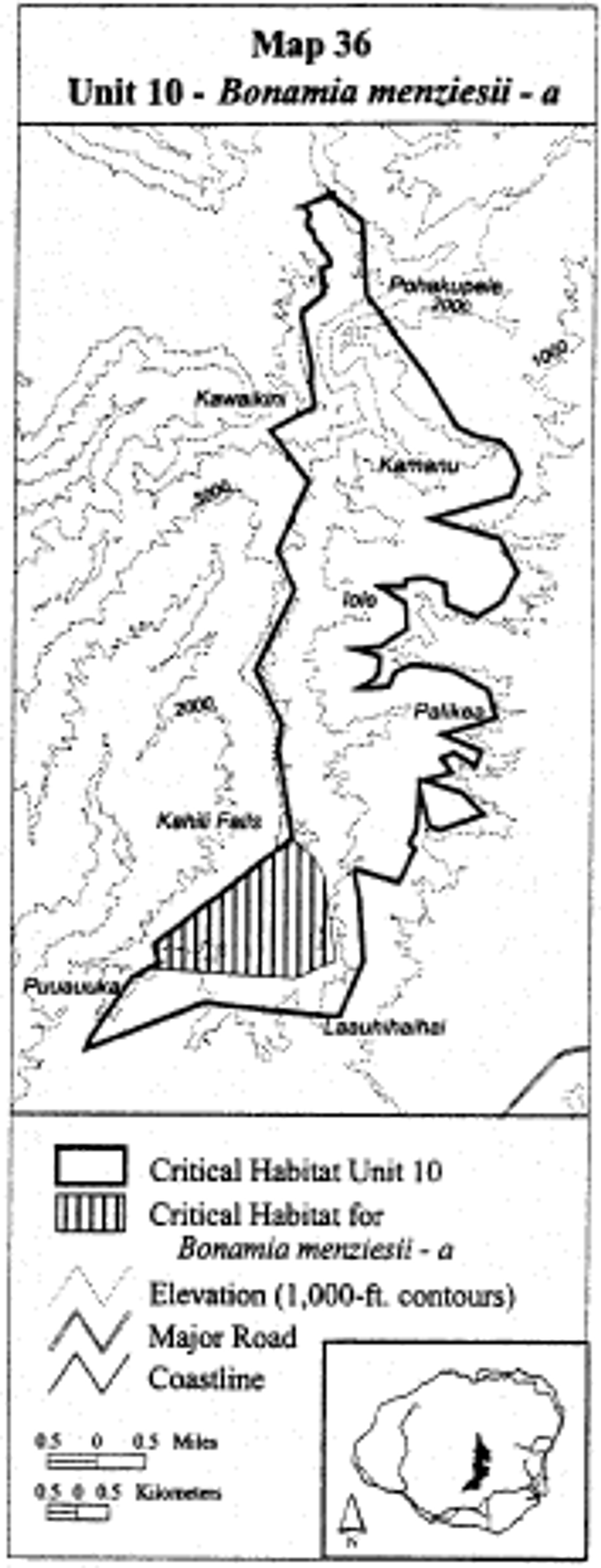
(lix) Kauai 10-Chamaesyce remyi var. kauaiensis-b
(A) This is a unit of the Lowland Wet ecosystem and consists of 2,330 ac (943 ha). This unit is also critical habitat for Kauai 10-Chamaesyce remyi var. remyi-d, Kauai 10-Charpentiera densiflora-b, Kauai 10-Cyanea eleeleensis-a, Kauai 10-Cyanea kolekoleensis-a, Kauai 10-Cyanea kuhihewa-a, Kauai 10-Cyrtandra oenobarba-b, Kauai 10-Dubautia imbricata ssp. imbricata-a, Kauai 10-Labordia helleri-c, Kauai 10-Melicope paniculata-a, Kauai 10-Melicope puberula-b, Kauai 10-Phyllostegia renovans-b, Kauai 10- Melicope rostrata -d, Kauai 10-Stenogyne kealiae-a, Kauai 10-Tetraplasandra bisattenuata-b, and Kauai 10-Tetraplasandra flynii-b, (see paragraphs (a)(1)(lxii), (a)(1)(lxiv), (a)(1)(lxvii), (a)(1)(lxviii), (a)(1)(lxix), (a)(1)(lxxiii), (a)(1)(lxxvii), (a)(1)(lxxxix), (a)(1)(xcix), (a)(1)(ci), (a)(1)(cvi), (a)(1)(cix), (a)(1)(cxiii), (a)(1)(cxiv), and (a)(1)(cxvi), respectively, of this section).
(B) Note: The reference to �Kauai 10- Platydesma rostrata -d� on the map is equivalent to �Kauai 10- Melicope rostrata -d�. Map 36a follows:
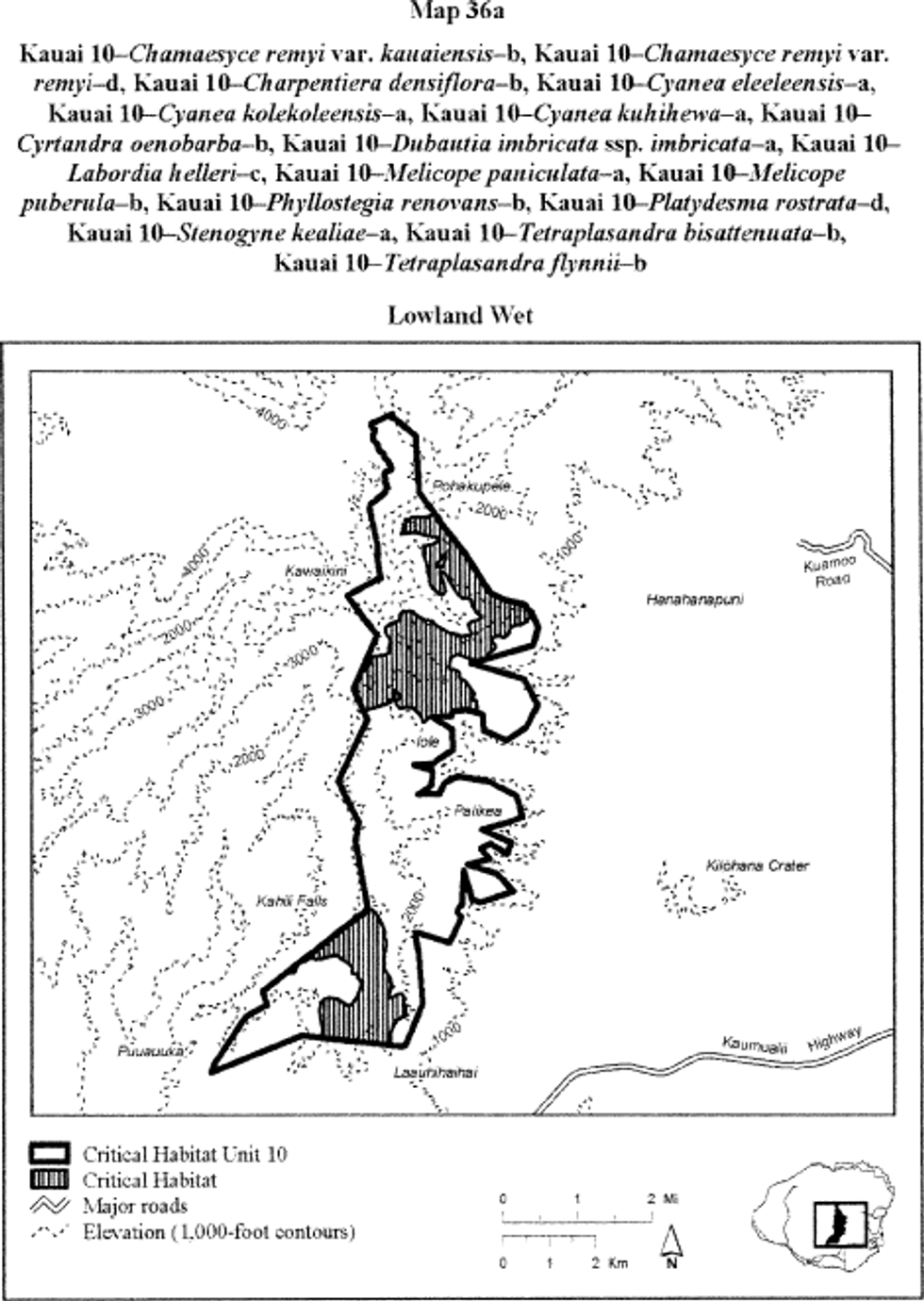
(lx) Kauai 10-Chamaesyce remyi var. kauaiensis-c
(A) This is a unit of the Wet Cliff ecosystem and consists of 489 ac (198 ha). This unit is also critical habitat for Kauai 10-Chamaesyce remyi var. remyi-e, Kauai 10-Cyanea dolichopoda-b, Kauai 10-Cyrtandra oenobarba-c, Kauai 10-Cyrtandra paliku-b, Kauai 10-Dubautia plantaginea ssp. magnifolia-b, Kauai 10-Lysimachia iniki-b, Kauai 10-Lysimachia pendens-b, Kauai 10-Lysimachia venosa-b, and Kauai 10- Melicope rostrata -e (see paragraphs (a)(1)(lxiii), (a)(1)(lxvi), (a)(1)(lxxiv), (a)(1)(lxxv), (a)(1)(lxxx), (a)(1)(xcv), (a)(1)(xcvi), (a)(1)(xcvii), and (a)(1)(cx), respectively, of this section).
(B) Note: The reference to �Kauai 10- Platydesma rostrata -e� on the map is equivalent to �Kauai 10- Melicope rostrata -e�. Map 36b follows:
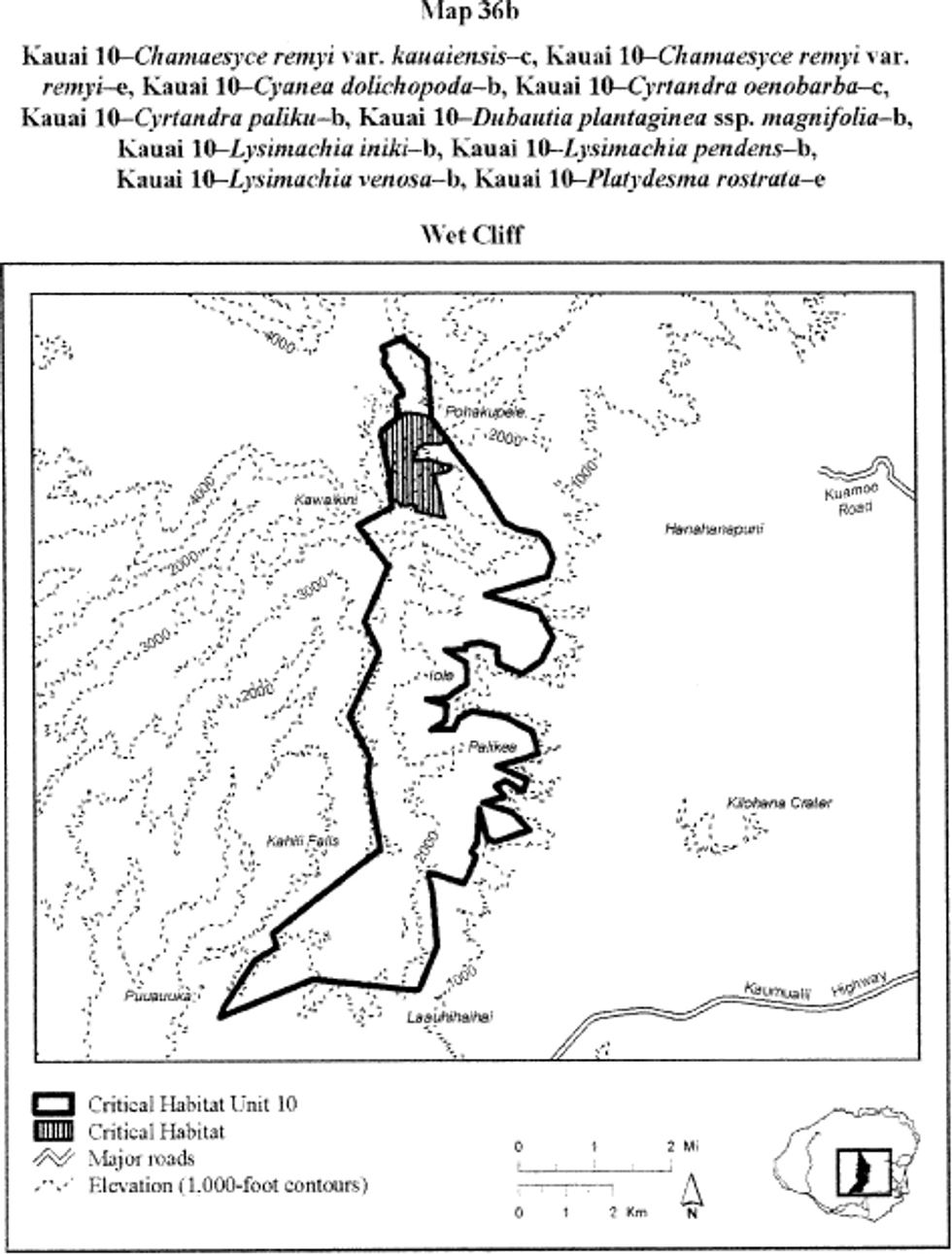
(lxi) Kauai 10-Chamaesyce remyi var. remyi-c
(A) [Reserved]
(B) See paragraph (a)(1)(lvii)(B) of this section for the map of this unit.
(lxii) Kauai 10-Chamaesyce remyi var. remyi-d
(A) [Reserved]
(B) See paragraph (a)(1)(lix)(B) of this section for the map of this unit.
(lxiii) Kauai 10-Chamaesyce remyi var. remyi-e
(A) [Reserved]
(B) See paragraph (a)(1)(lx)(B) of this section for the map of this unit.
(lxiv) Kauai 10-Charpentiera densiflora-b
(A) [Reserved]
(B) See paragraph (a)(1)(lix)(B) of this section for the map of this unit.
(lxv) Kauai 10 - Cyanea asarifolia - b (903 ha; 2,232 ac)
(A) [Reserved]
(B) Map 37 follows:
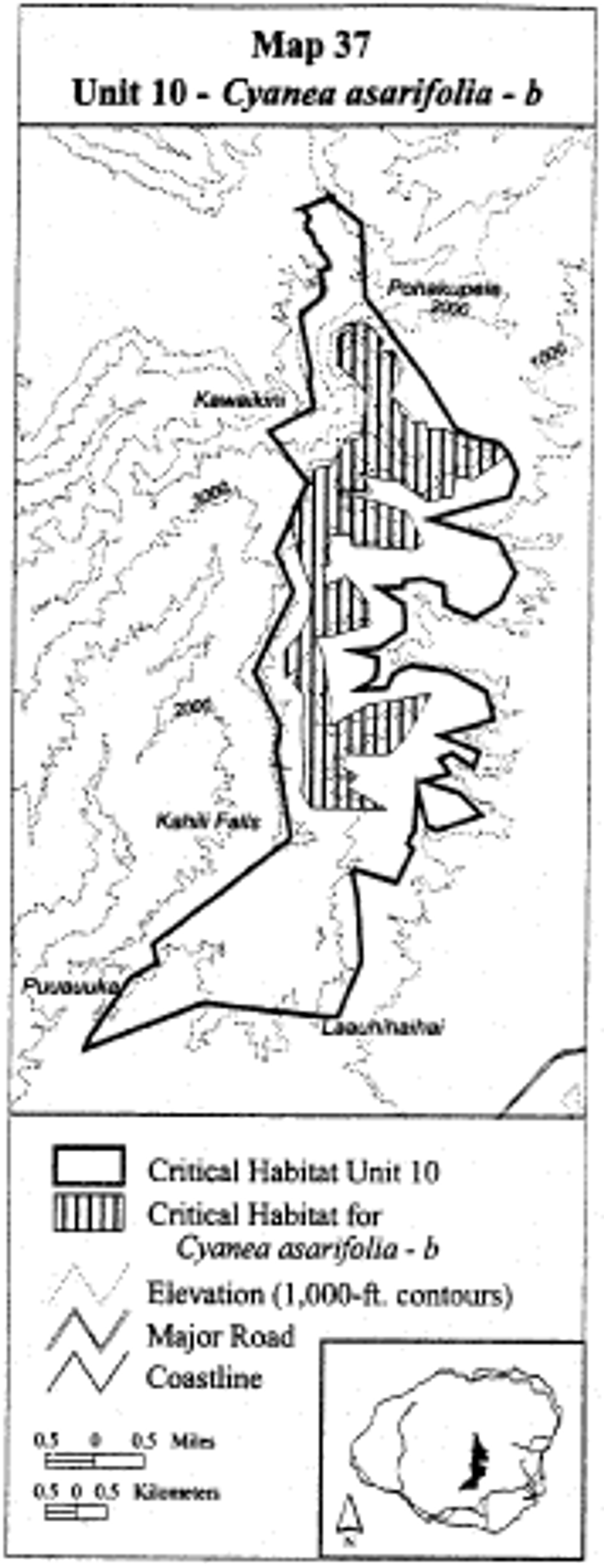
(lxvi) Kauai 10-Cyanea dolichopoda-b
(A) [Reserved]
(B) See paragraph (a)(1)(lx)(B) of this section for the map of this unit.
(lxvii) Kauai 10-Cyanea eleeleensis-a
(A) [Reserved]
(B) See paragraph (a)(1)(lix)(B) of this section for the map of this unit.
(lxviii) Kauai 10-Cyanea kolekoleensis-a
(A) [Reserved]
(B) See paragraph (a)(1)(lix)(B) of this section for the map of this unit.
(lxix) Kauai 10-Cyanea kuhihewa-a
(A) [Reserved]
(B) See paragraph (a)(1)(lix)(B) of this section for the map of this unit.
(lxx) Kauai 10 - Cyanea remyi - b (1,904 ha; 4,705 ac)
(A) [Reserved]
(B) Map 38 follows:
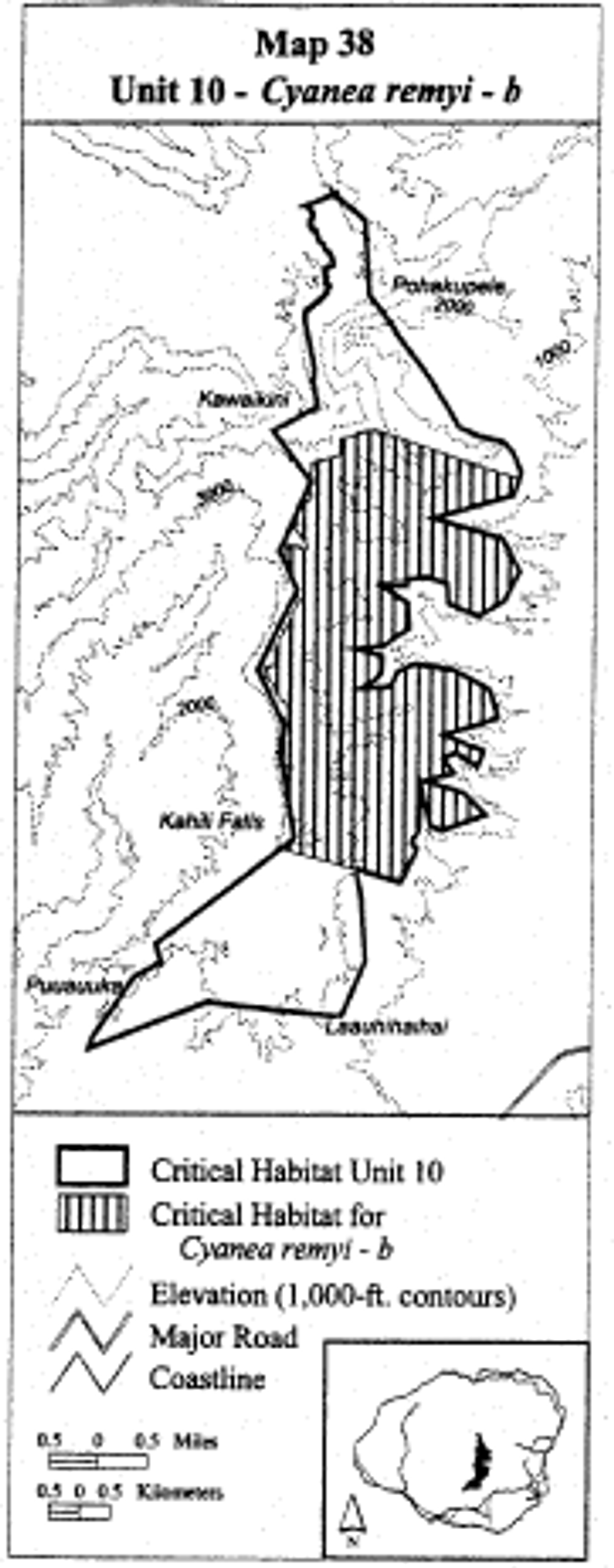
(lxxi) Kauai 10 - Cyanea undulata - a (1,005 ha; 2,484 ac)
(A) [Reserved]
(B) Map 39 follows:
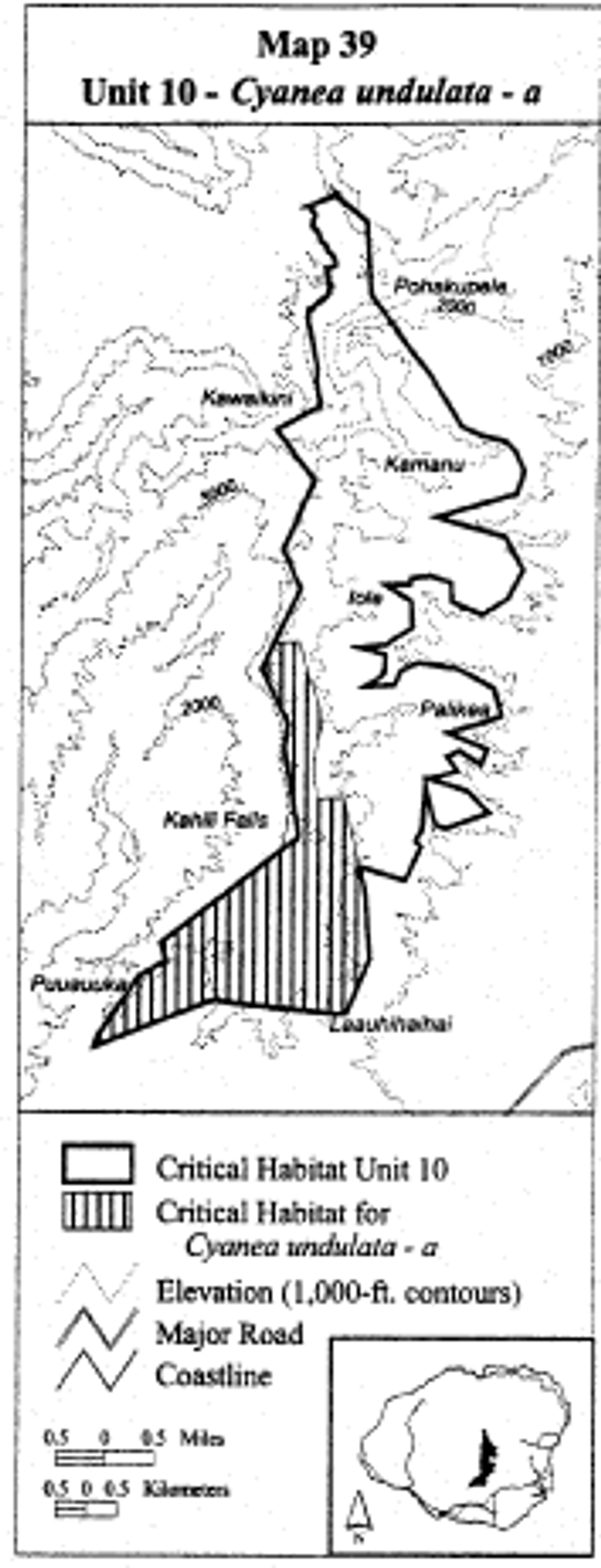
(lxxii) Kauai 10- Cyrtandra kealiae ssp. kealiae -c (2,013 ha; 4,975 ac)
(A) [Reserved]
(B) Note: The reference to �Unit 10- Cyrtandra limahuliensis -c� on the map is equivalent to �Kauai 10- Cyrtandra kealiae ssp. kealiae- c�. Map 40 follows:
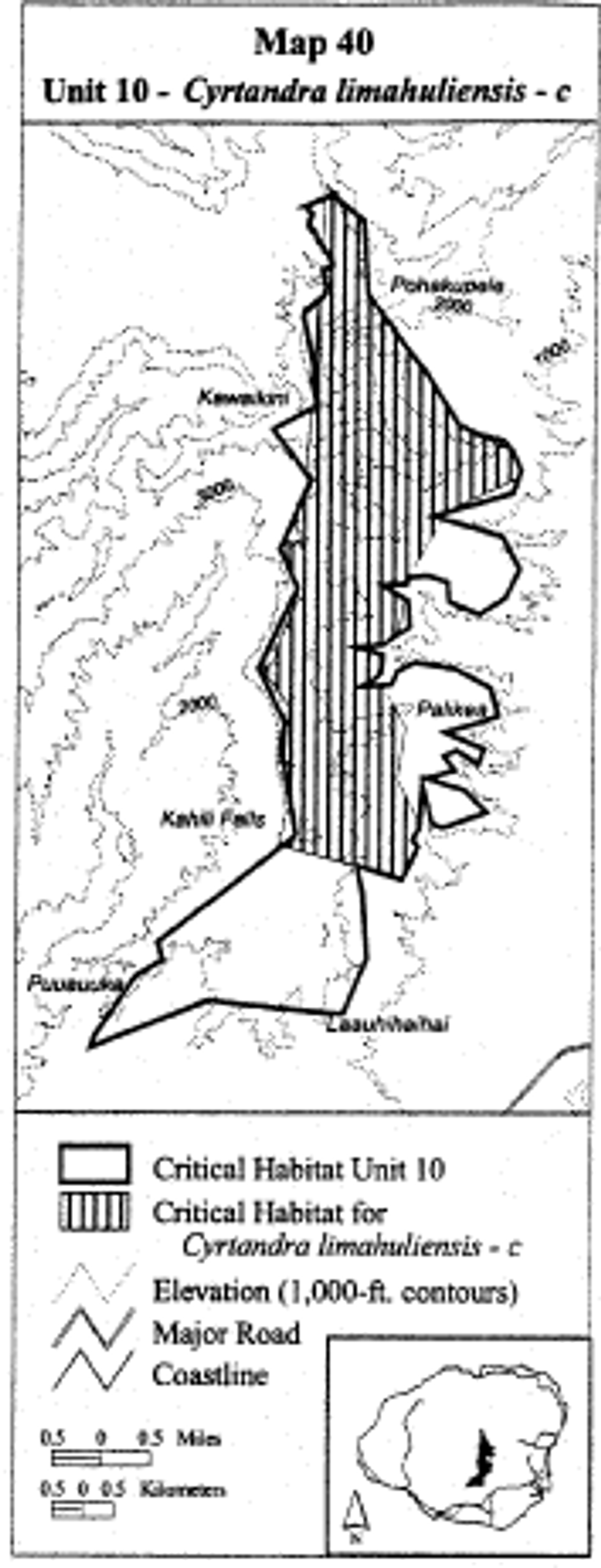
(lxxiii) Kauai 10-Cyrtandra oenobarba-b
(A) [Reserved]
(B) See paragraph (a)(1)(lix)(B) of this section for the map of this unit.
(lxxiv) Kauai 10-Cyrtandra oenobarba-c
(A) [Reserved]
(B) See paragraph (a)(1)(lx)(B) of this section for the map of this unit.
(lxxv) Kauai 10-Cyrtandra paliku-b
(A) [Reserved]
(B) See paragraph (a)(1)(lx)(B) of this section for the map of this unit.
(lxxvi) Kauai 10-Dryopteris crinalis var. podosorus-a
(A) [Reserved]
(B) See paragraph (a)(1)(lvii)(B) of this section for the map of this unit.
(lxxvii) Kauai 10-Dubautia imbricata ssp. imbricata-a
(A) [Reserved]
(B) See paragraph (a)(1)(lix)(B) of this section for the map of this unit.
(lxxviii) Kauai 10-Dubautia kalalauensis-a
(A) [Reserved]
(B) See paragraph (a)(1)(lvii)(B) of this section for the map of this unit.
(lxxix) Kauai 10 - Dubautia pauciflorula - a (814 ha; 2,012 ac)
(A) [Reserved]
(B) Map 41 follows:

(lxxx) Kauai 10-Dubautia plantaginea ssp. magnifolia-b
(A) [Reserved]
(B) See paragraph (a)(1)(lx)(B) of this section for the map of this unit.
(lxxxi) Kauai 10-Dubautia waialealae-a
(A) [Reserved]
(B) See paragraph (a)(1)(lvii)(B) of this section for the map of this unit.
(lxxxii) Kauai 10 - Exocarpos luteolus - a (401 ha; 991 ac)
(A) [Reserved]
(B) Map 42 follows:
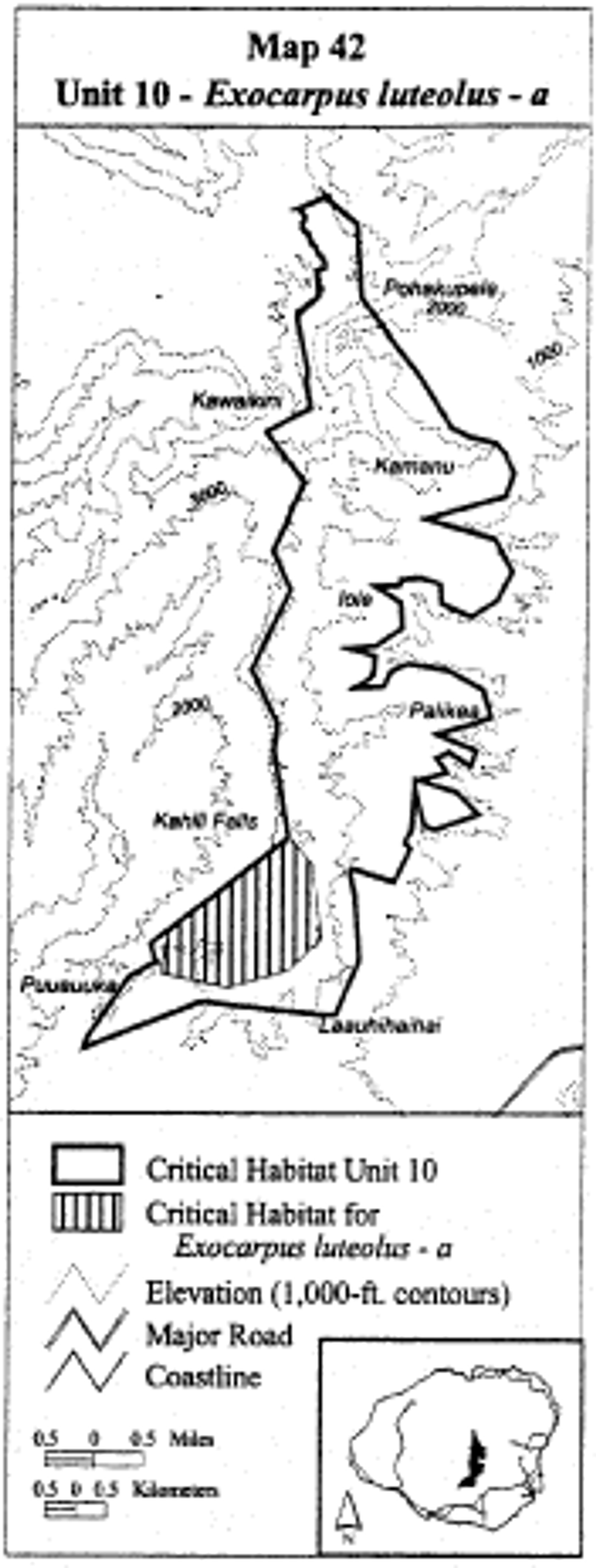
(lxxxiii) Kauai 10-Geranium kauaiense-a
(A) [Reserved]
(B) See paragraph (a)(1)(lvii)(B) of this section for the map of this unit.
(lxxxiv) Kauai 10 - Hesperomannia lydgatei - a (646 ha; 1,596 ac)
(A) [Reserved]
(B) Map 43 follows:
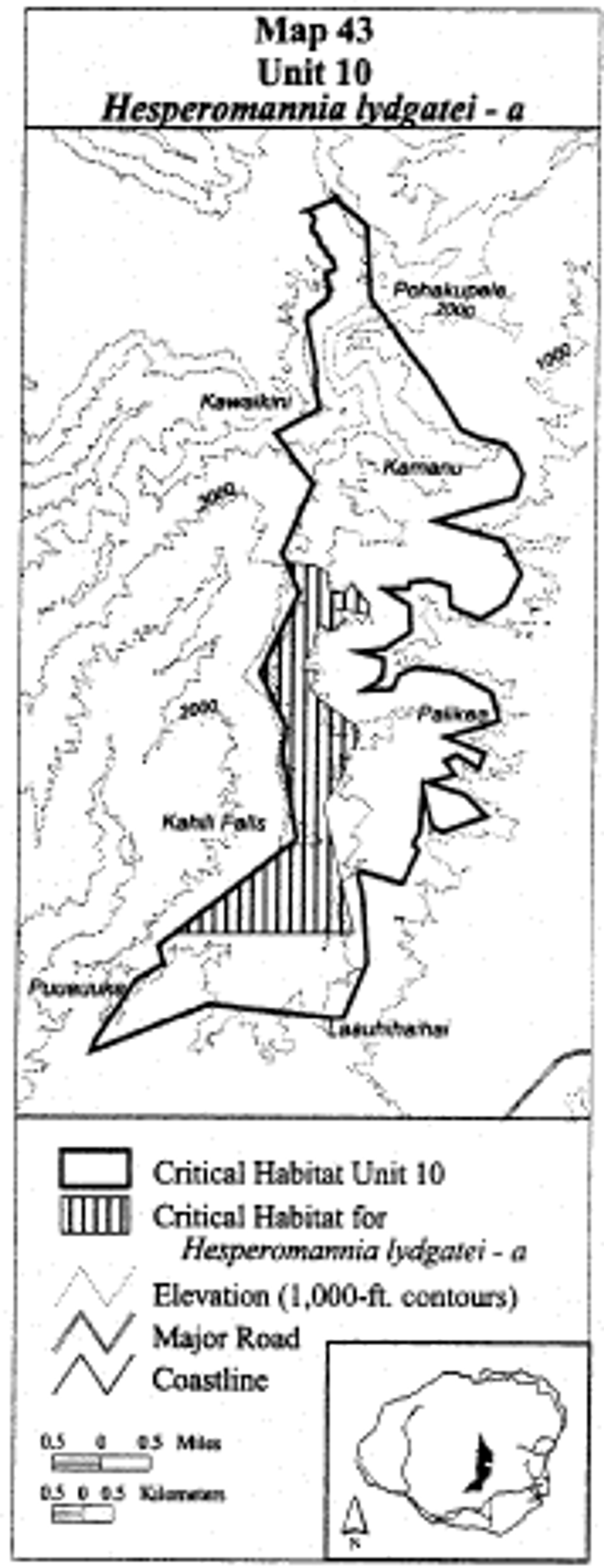
(lxxxv) Kauai 10 - Isodendrion longifolium - b (142 ha; 350 ac)
(A) [Reserved]
(B) Map 44 follows:
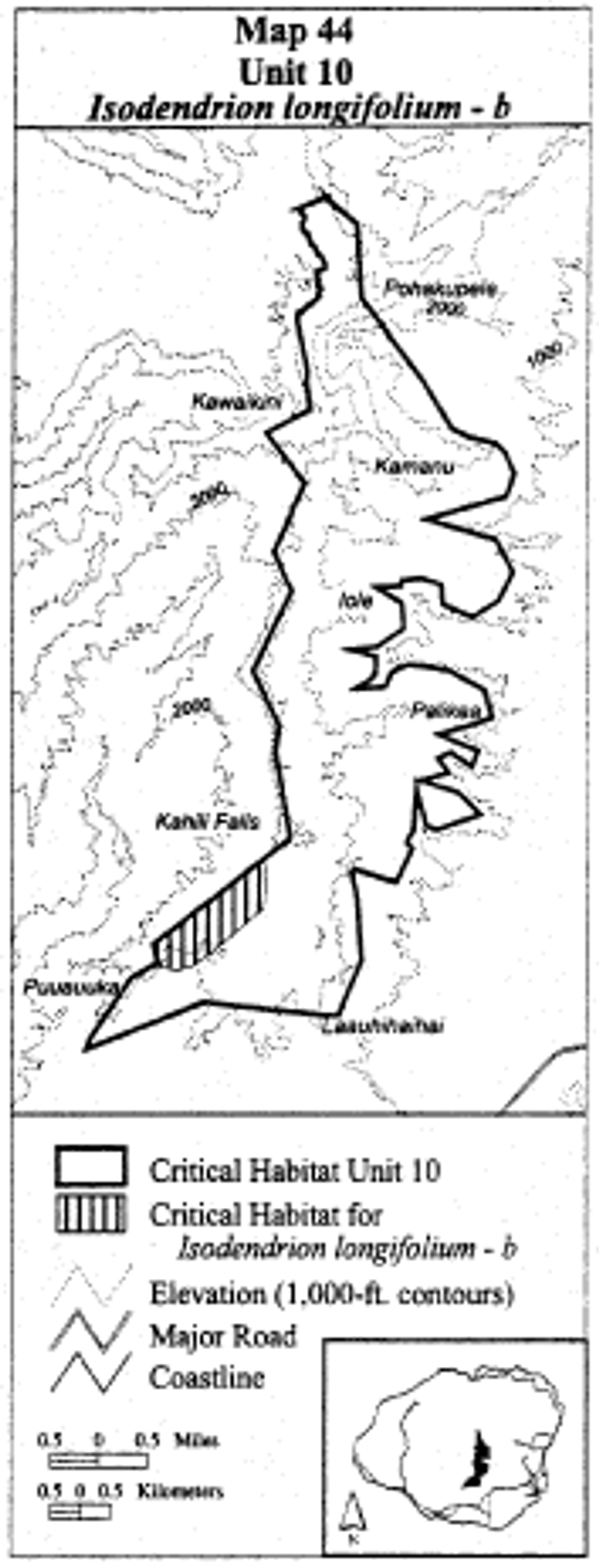
(lxxxvi) Kauai 10-Keysseria erici-a
(A) [Reserved]
(B) See paragraph (a)(1)(lvii)(B) of this section for the map of this unit.
(lxxxvii) Kauai 10-Keysseria helenae-a
(A) [Reserved]
(B) See paragraph (a)(1)(lvii)(B) of this section for the map of this unit.
(lxxxviii) Kauai 10-Labordia helleri-b
(A) [Reserved]
(B) See paragraph (a)(1)(lvii)(B) of this section for the map of this unit.
(lxxxix) Kauai 10-Labordia helleri-c
(A) [Reserved]
(B) See paragraph (a)(1)(lix)(B) of this section for the map of this unit.
(xc) Kauai 10 - Labordia lydgatei - b (1,035 ha; 2,558 ac)
(A) [Reserved]
(B) Map 45 follows:
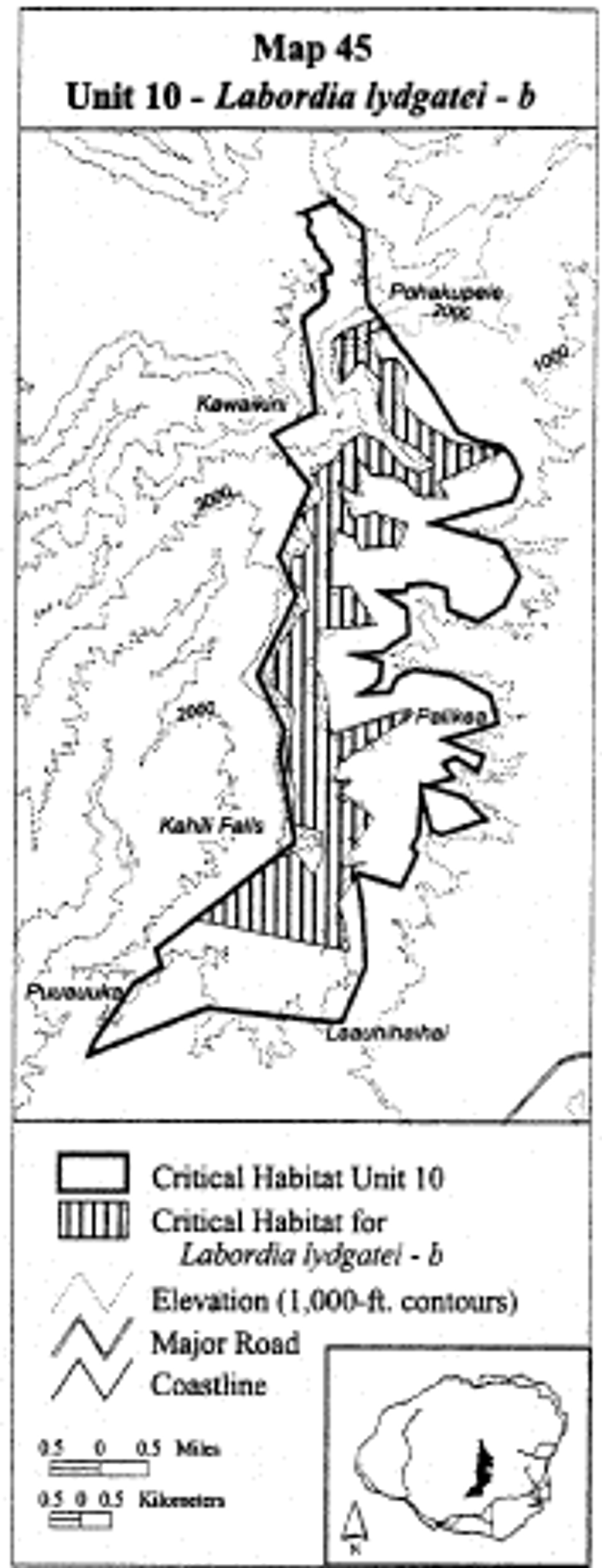
(xci) Kauai 10-Labordia pumila-a
(A) [Reserved]
(B) See paragraph (a)(1)(lvii)(B) of this section for the map of this unit.
(xcii) Kauai 10 - Labordia tinifolia var. wahiawaensis - a (913 ha; 2,255 ac)
(A) [Reserved]
(B) Map 46 follows:
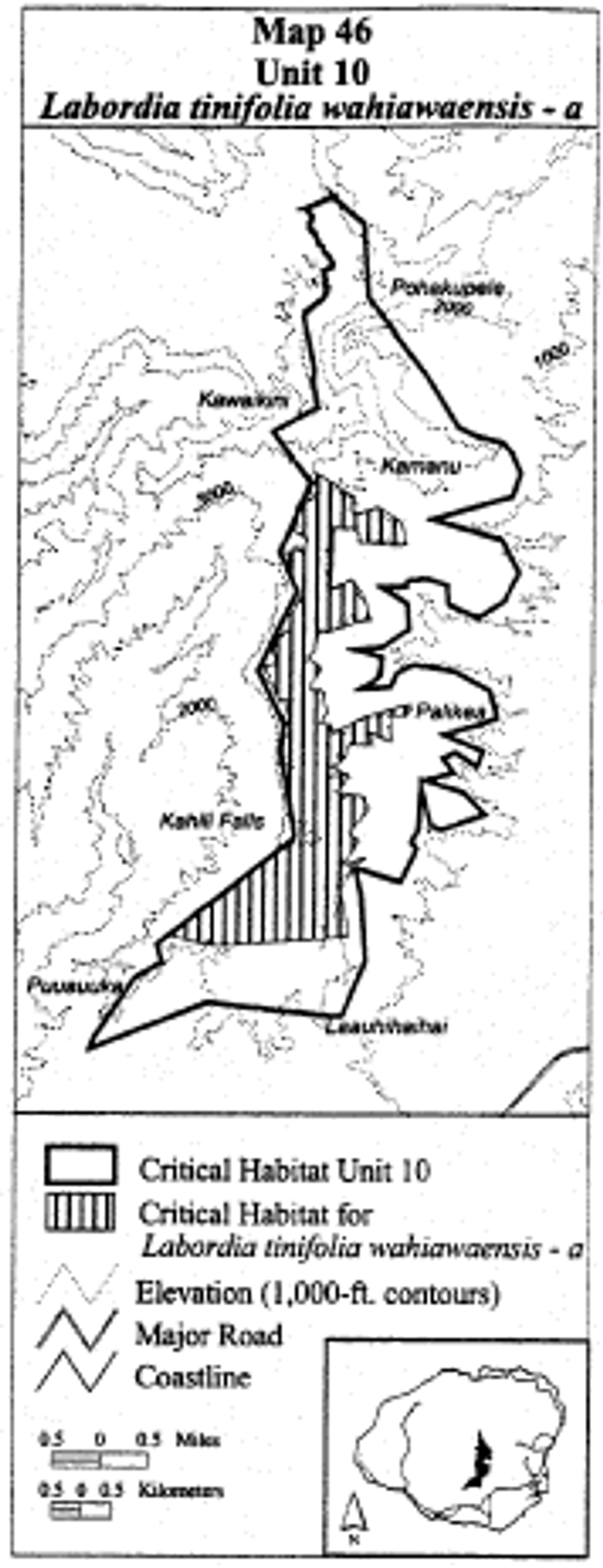
(xciii) Kauai 10-Lysimachia daphnoides-a
(A) [Reserved]
(B) See paragraph (a)(1)(lvii)(B) of this section for the map of this unit.
(xciv) Kauai 10 - Lysimachia filifolia - a (995 ha; 2,458 ac)
(A) [Reserved]
(B) Map 47 follows:
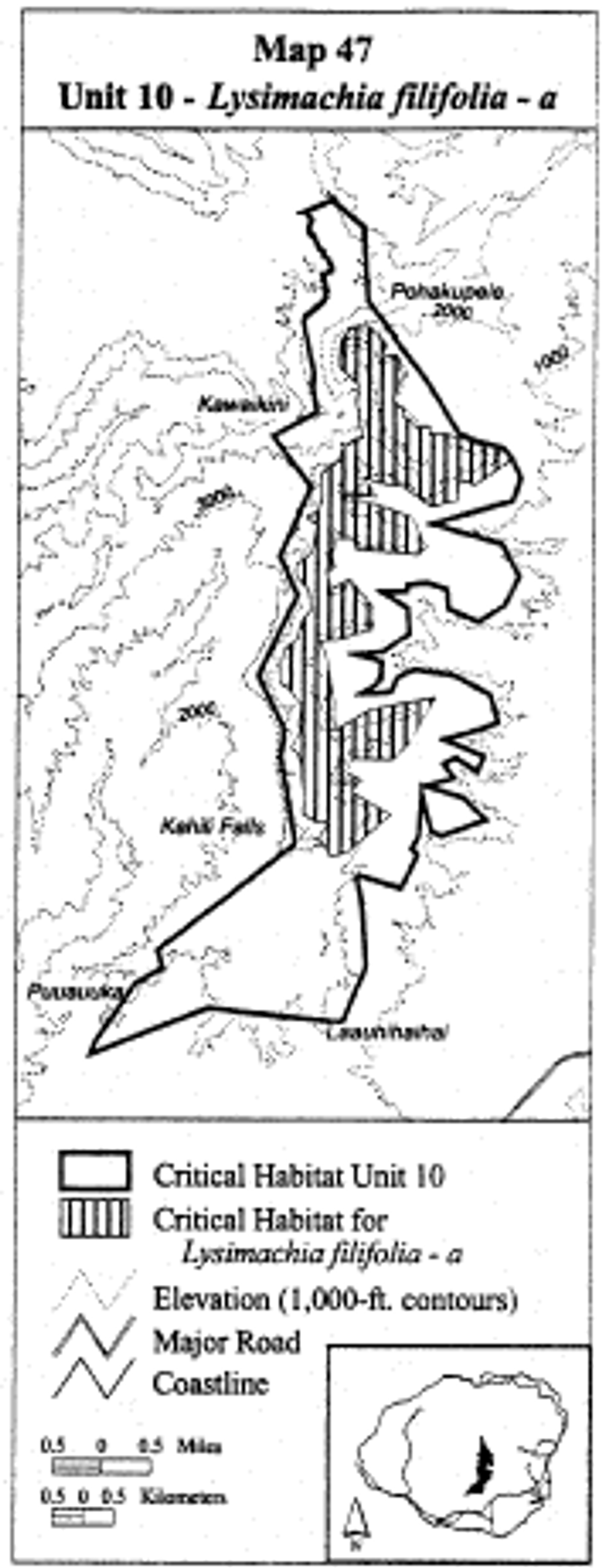
(xcv) Kauai 10-Lysimachia iniki-b
(A) [Reserved]
(B) See paragraph (a)(1)(lx)(B) of this section for the map of this unit.
(xcvi) Kauai 10-Lysimachia pendens-b
(A) [Reserved]
(B) See paragraph (a)(1)(lx)(B) of this section for the map of this unit.
(xcvii) Kauai 10-Lysimachia venosa-b
(A) [Reserved]
(B) See paragraph (a)(1)(lx)(B) of this section for the map of this unit.
(xcviii) Kauai 10-Melicope degeneri-a
(A) [Reserved]
(B) See paragraph (a)(1)(lvii)(B) of this section for the map of this unit.
(xcix) Kauai 10-Melicope paniculata-a
(A) [Reserved]
(B) See paragraph (a)(1)(lix)(B) of this section for the map of this unit.
(c) Kauai 10-Melicope puberula-a
(A) [Reserved]
(B) See paragraph (a)(1)(lvii)(B) of this section for the map of this unit.
(ci) Kauai 10-Melicope puberula-b
(A) [Reserved]
(B) See paragraph (a)(1)(lix)(B) of this section for the map of this unit.
(cii) Kauai 10 - Myrsine linearifolia - b (167 ha; 413 ac)
(A) [Reserved]
(B) Map 48 follows:
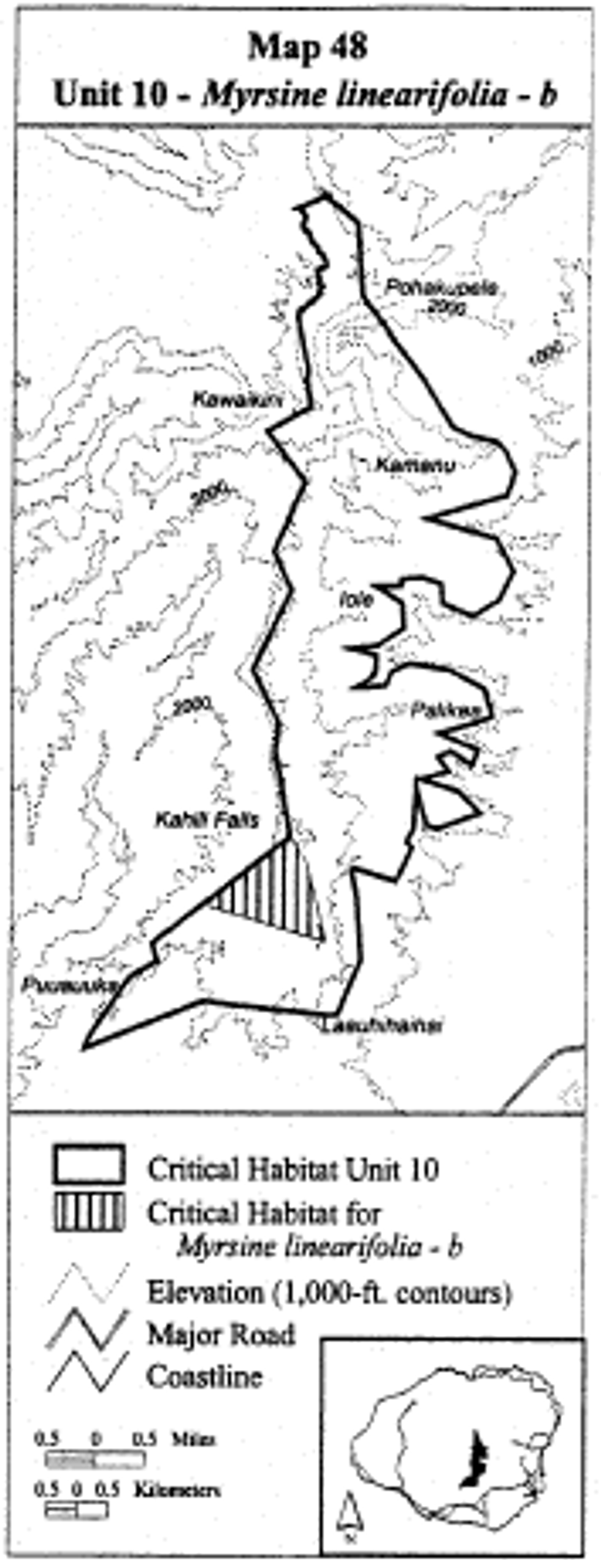
(ciii) Kauai 10-Myrsine mezii-a
(A) [Reserved]
(B) See paragraph (a)(1)(lvii)(B) of this section for the map of this unit.
(civ) Kauai 10- Phlegmariurus nutans -a (620 ha; 1,533 ac)
(A) [Reserved]
(B) Note: The reference to �Unit 10- Huperzia nutans -a� on the map is equivalent to �Kauai 10- Phlegmariurus nutans -a�. Map 49 follows:
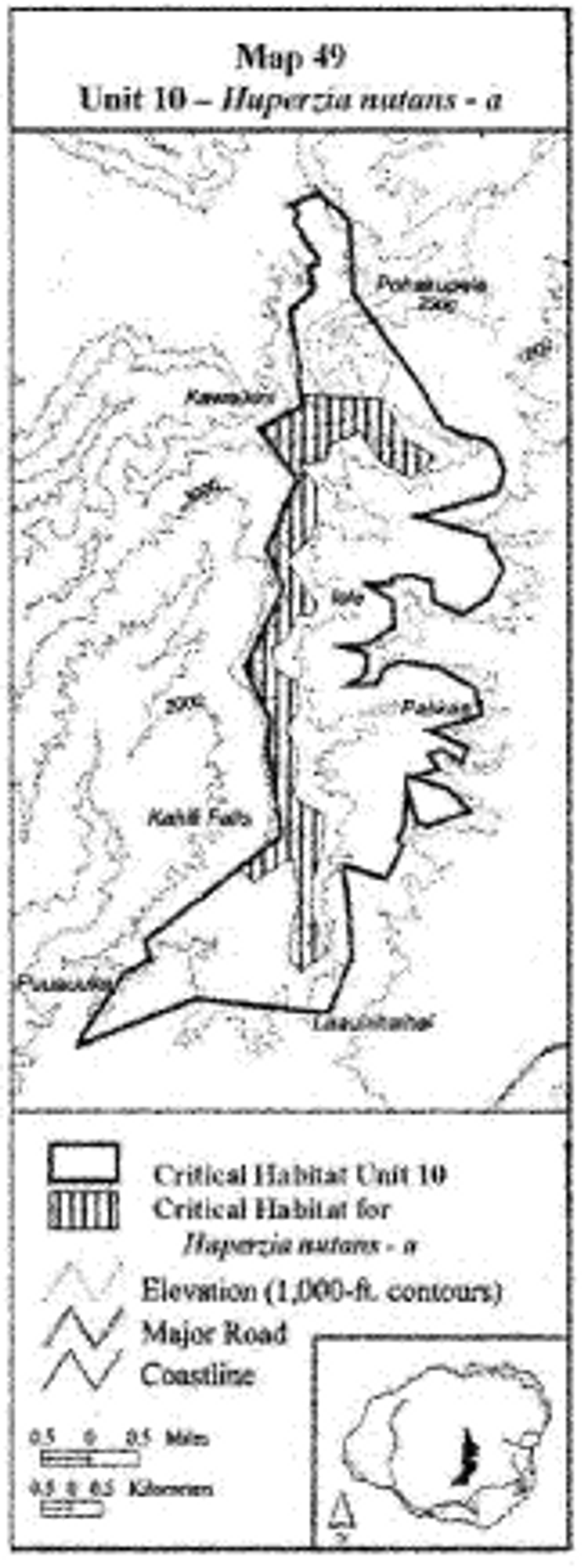
(cv) Kauai 10-Phyllostegia renovans-a
(A) [Reserved]
(B) See paragraph (a)(1)(lvii)(B) of this section for the map of this unit.
(cvi) Kauai 10-Phyllostegia renovans-b
(A) [Reserved]
(B) See paragraph (a)(1)(lix)(B) of this section for the map of this unit.
(cvii) Kauai 10 - Plantago princeps - a (276 ha; 683 ac)
(A) [Reserved]
(B) Map 50 follows:
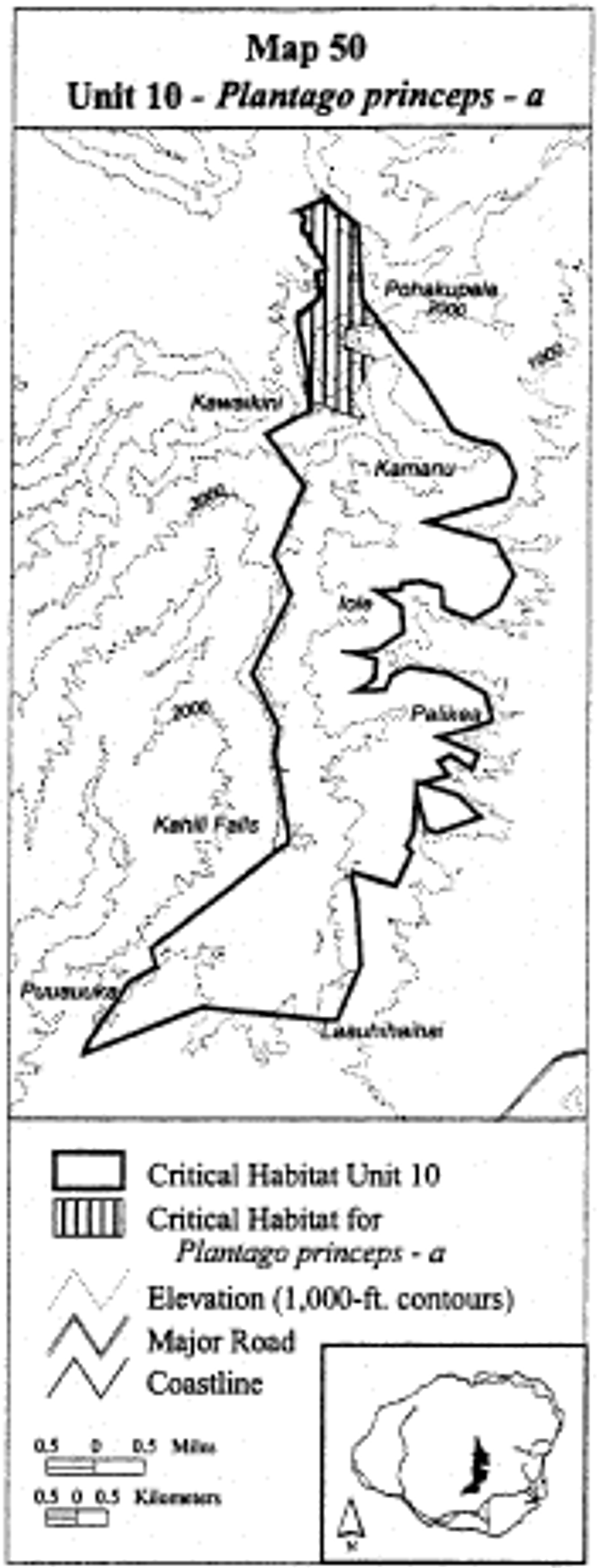
(cviii) Kauai 10- Melicope rostrata -c
(A) [Reserved]
(B) See paragraph (a)(1)(lvii)(B) of this section for the map of this unit.
(cix) Kauai 10- Melicope rostrata -d
(A) [Reserved]
(B) See paragraph (a)(1)(lix)(B) of this section for the map of this unit.
(cx) Kauai 10- Melicope rostrata -e
(A) [Reserved]
(B) See paragraph (a)(1)(lx)(B) of this section for the map of this unit.
(cxi) Kauai 10-Psychotria grandiflora-a
(A) [Reserved]
(B) See paragraph (a)(1)(lvii)(B) of this section for the map of this unit.
(cxii) Kauai 10 - Pteralyxia kauaiensis - b (304 ha; 751 ac)
(A) [Reserved]
(B) Map 51 follows:
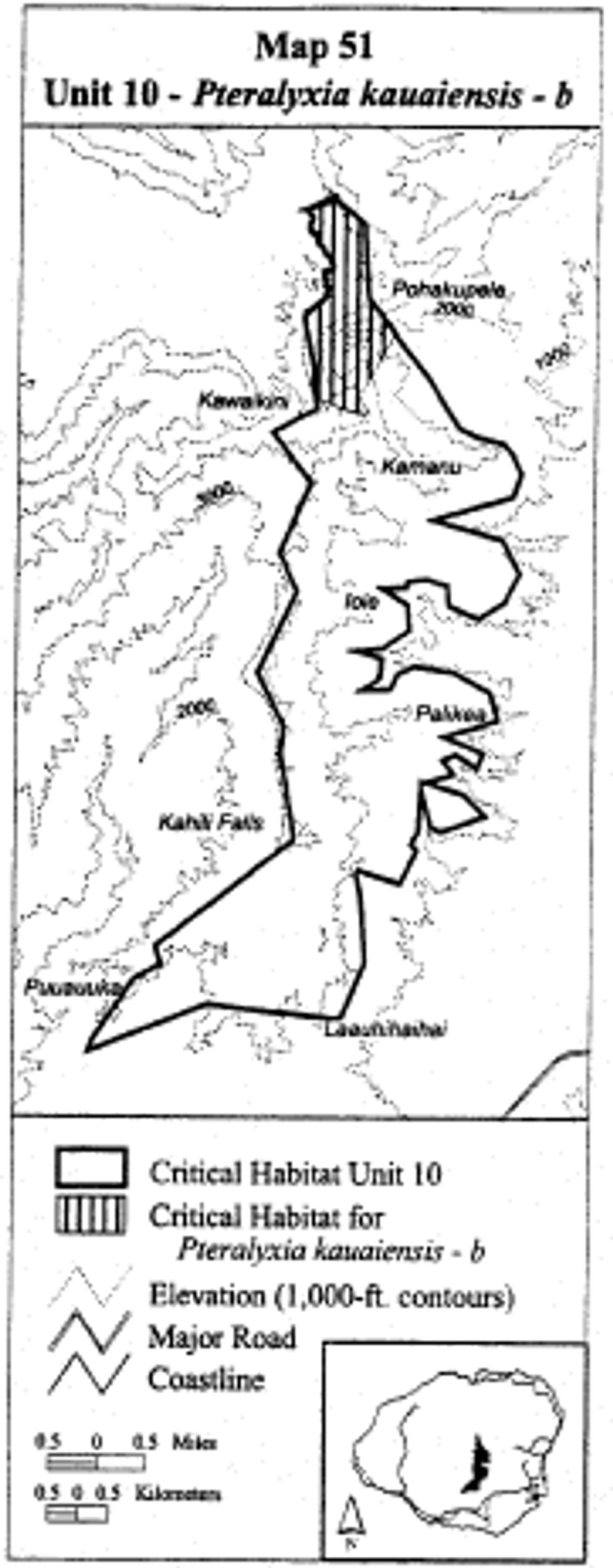
(cxiii) Kauai 10-Stenogyne kealiae-a
(A) [Reserved]
(B) See paragraph (a)(1)(lix)(B) of this section for the map of this unit.
(cxiv) Kauai 10-Tetraplasandra bisattenuata-b
(A) [Reserved]
(B) See paragraph (a)(1)(lix)(B) of this section for the map of this unit.
(cxv) Kauai 10-Tetraplasandra flynnii-a
(A) [Reserved]
(B) See paragraph (a)(1)(lvii)(B) of this section for the map of this unit.
(cxvi) Kauai 10-Tetraplasandra flynnii-b
(A) [Reserved]
(B) See paragraph (a)(1)(lix)(B) of this section for the map of this unit.
(cxvii) Kauai 10 - Viola helenae - a (611 ha; 1,510 ac)
(A) [Reserved]
(B) Map 52 follows:
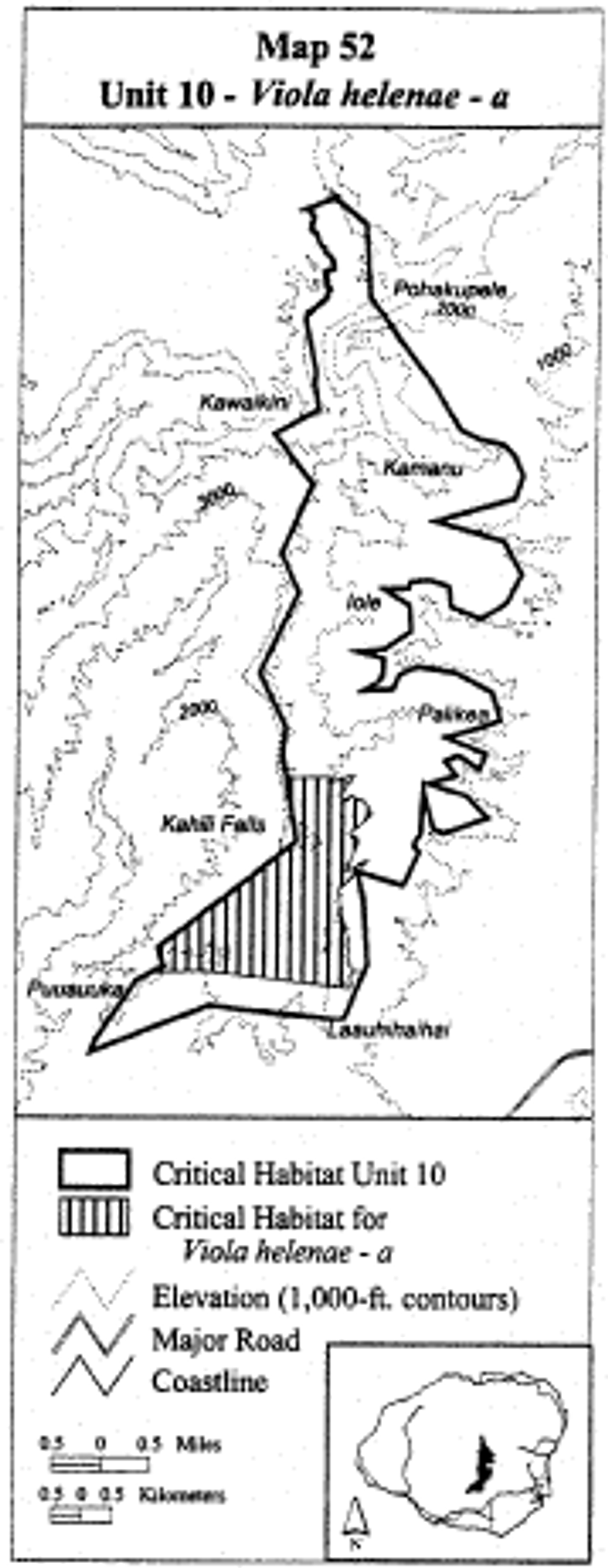
(cxviii) Kauai 10 - Viola kauaiensis var. wahiawaensis - a (657 ha; 1,623 ac)
(A) [Reserved]
(B) Map 53 follows:
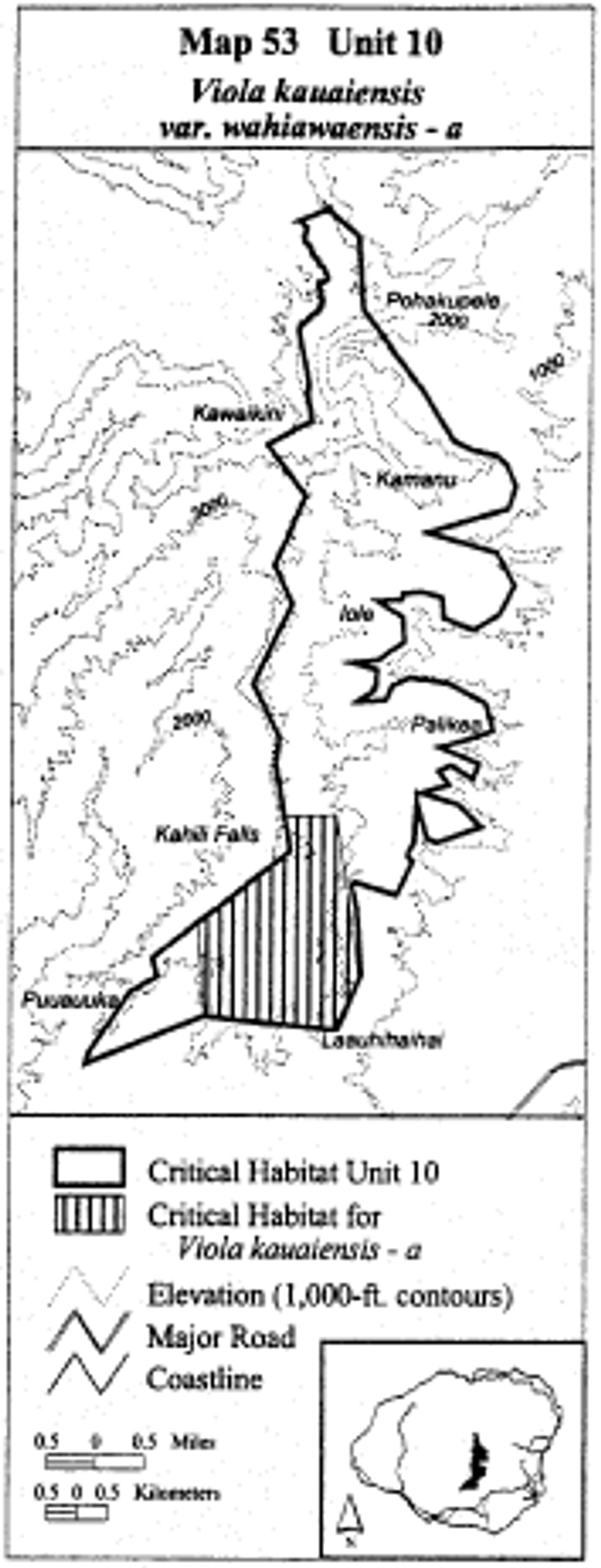
(cxix) Kauai 11 - Adenophorus periens - c (469 ha; 1,158 ac)
(A) [Reserved]
(B) Map 54 follows:
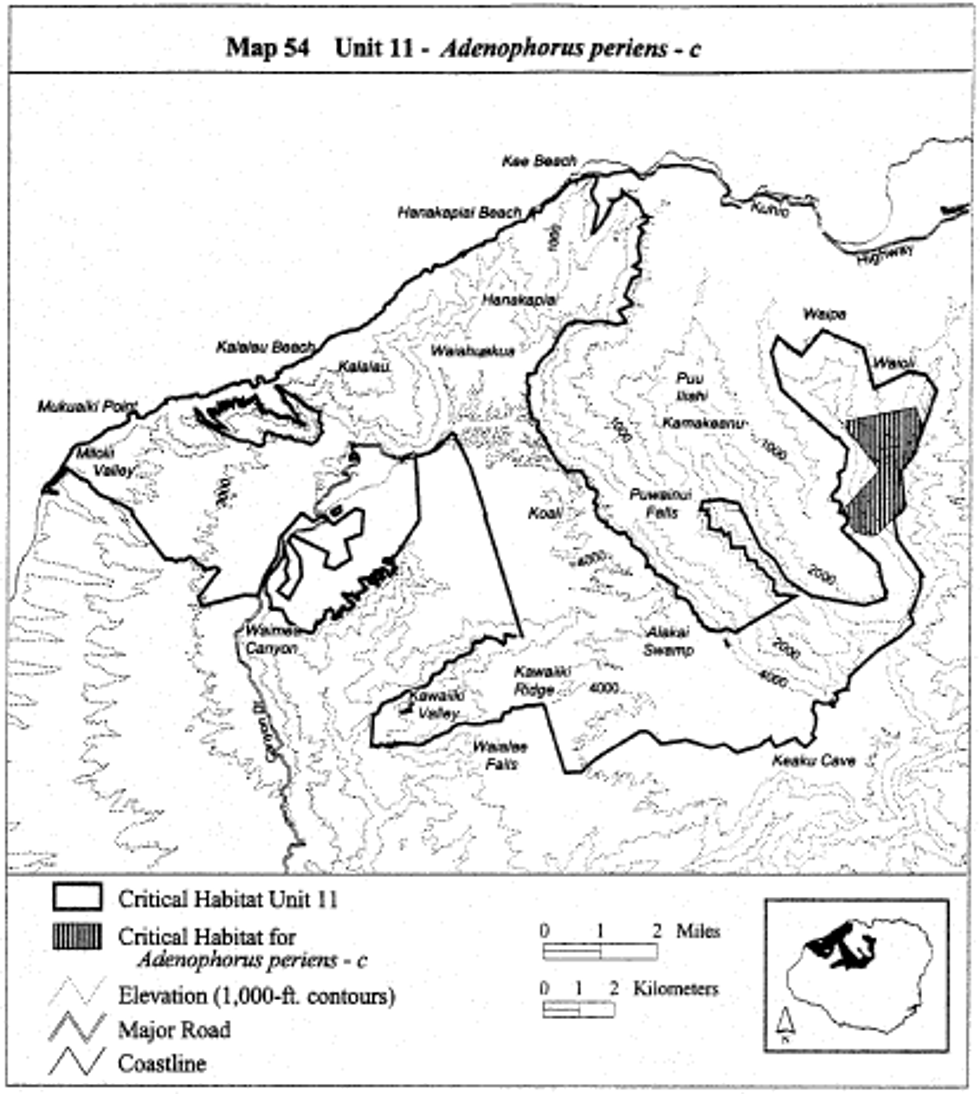
(cxx) Kauai 11 - Adenophorus periens - d (1,006 ha; 2,485 ac)
(A) [Reserved]
(B) Map 55 follows:
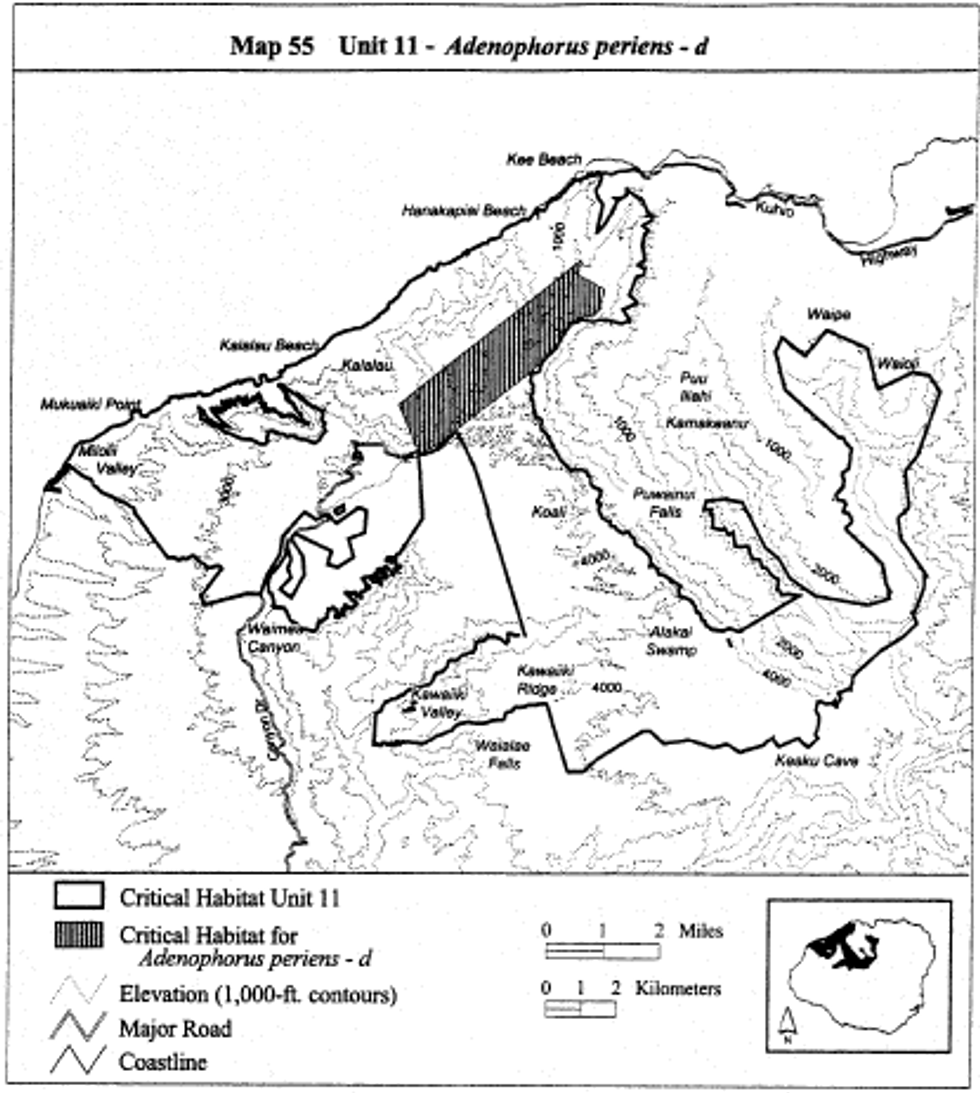
(cxxi) Kauai 11 - Alectryon macrococcus - a (382 ha; 943 ac)
(A) [Reserved]
(B) Excluding 2 areas:
(1) Bounded by the following 3 points (1 ha; 3 ac): Start at 435132, 2442248; 435160, 2442164; 434848, 2442098; return to starting point; and
(2) Bounded by the following 4 points: (0 ha; 1 ac): Start at 435151, 2442425; 435215, 2442393; 435195, 2442353; 435128, 2442379; return to starting point.
(C) Map 56 follows:
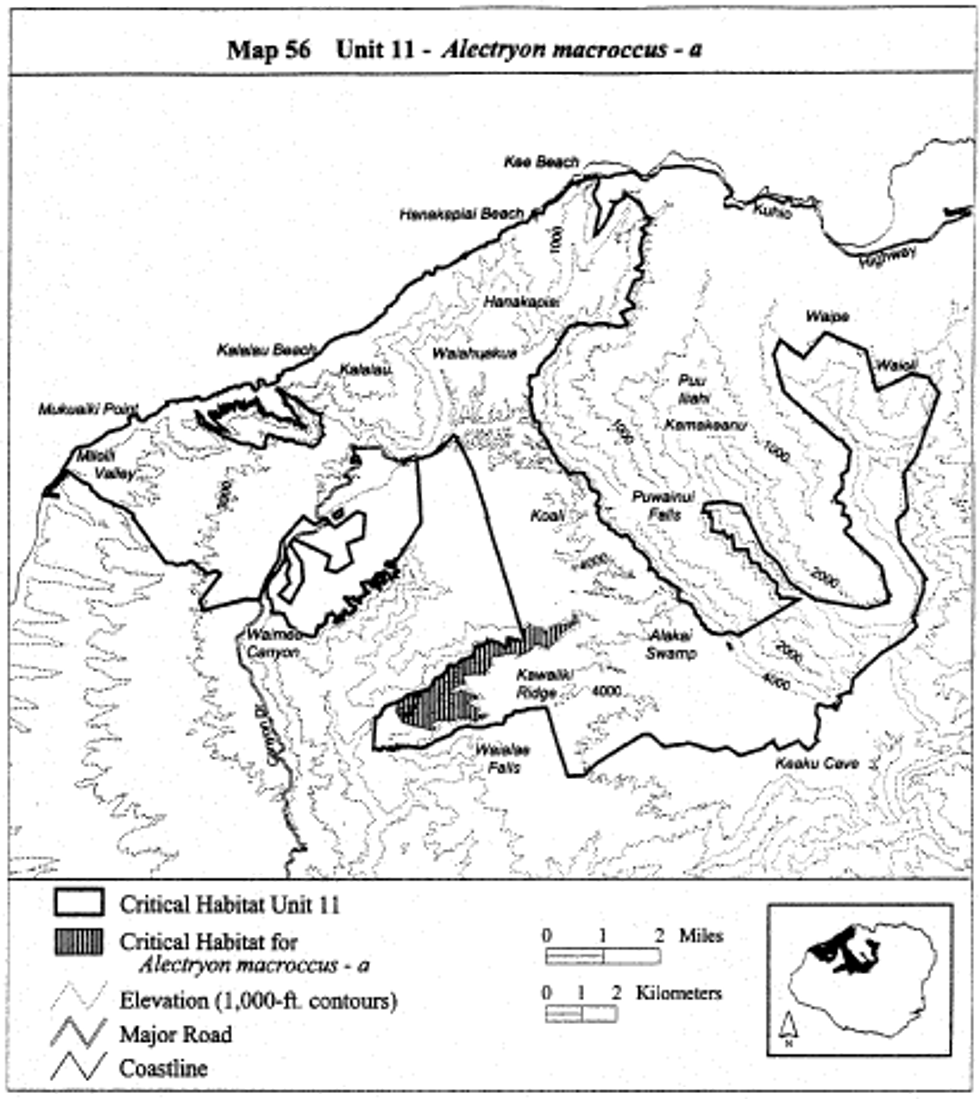
(cxxii) Kauai 11 - Alectryon macrococcus - b (90 ha; 222 ac)
(A) [Reserved]
(B) Map 57 follows:
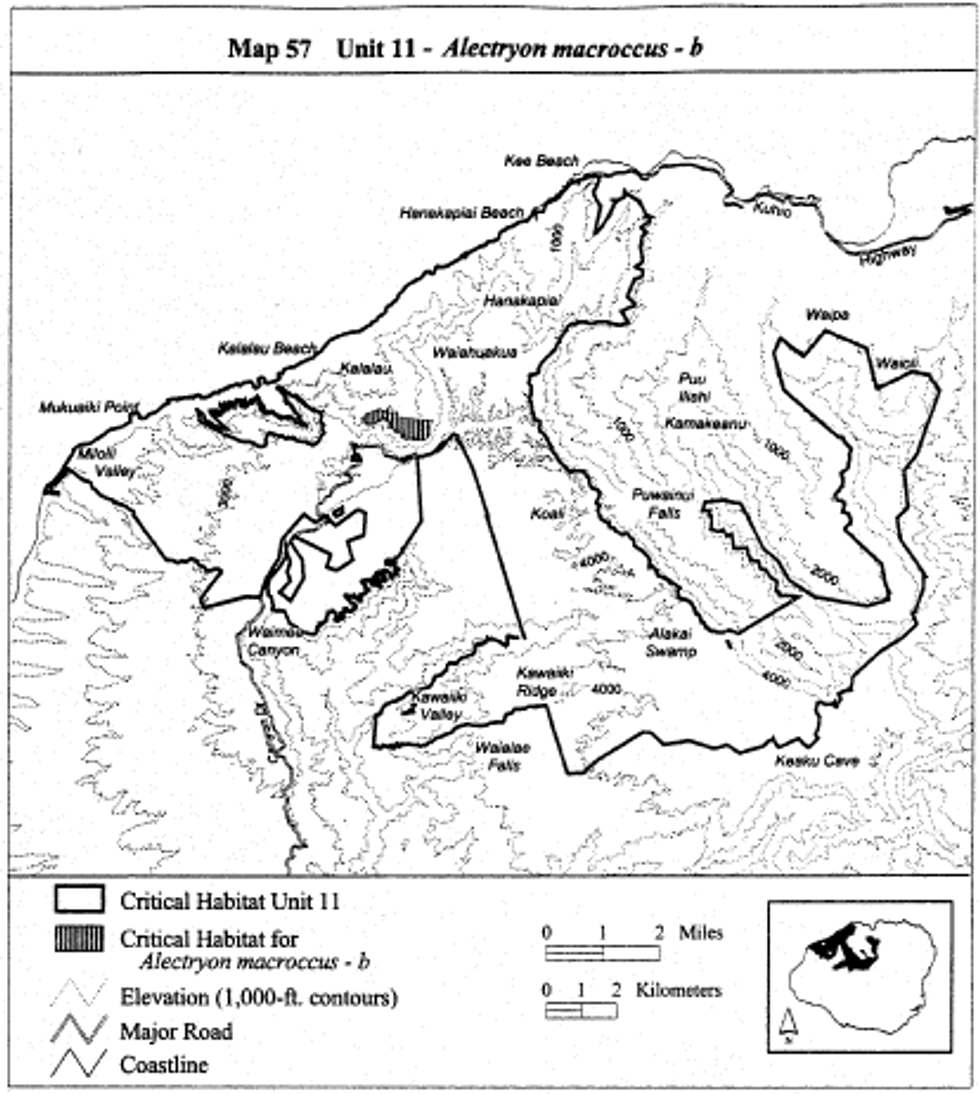
(cxxiii) Kauai 11 - Alsinidendron lychnoides - a (993 ha; 2,455 ac)
(A) [Reserved]
(B) Map 58 follows:
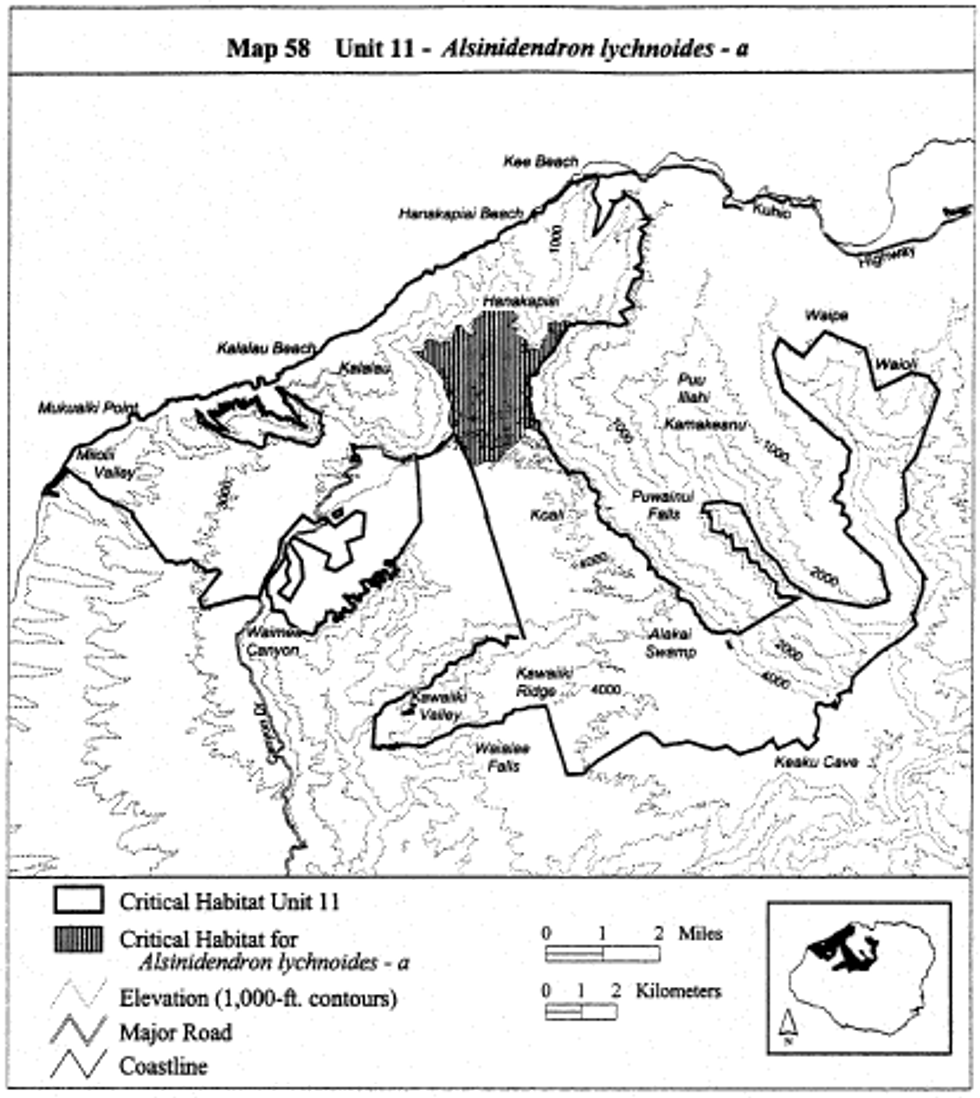
(cxxiv) Kauai 11 - Alsinidendron lychnoides - b (138 ha; 340 ac)
(A) [Reserved]
(B) Map 59 follows:

(cxxv) Kauai 11 - Alsinidendron lychnoides - c (55 ha; 136 ac)
(A) [Reserved]
(B) Map 60 follows:
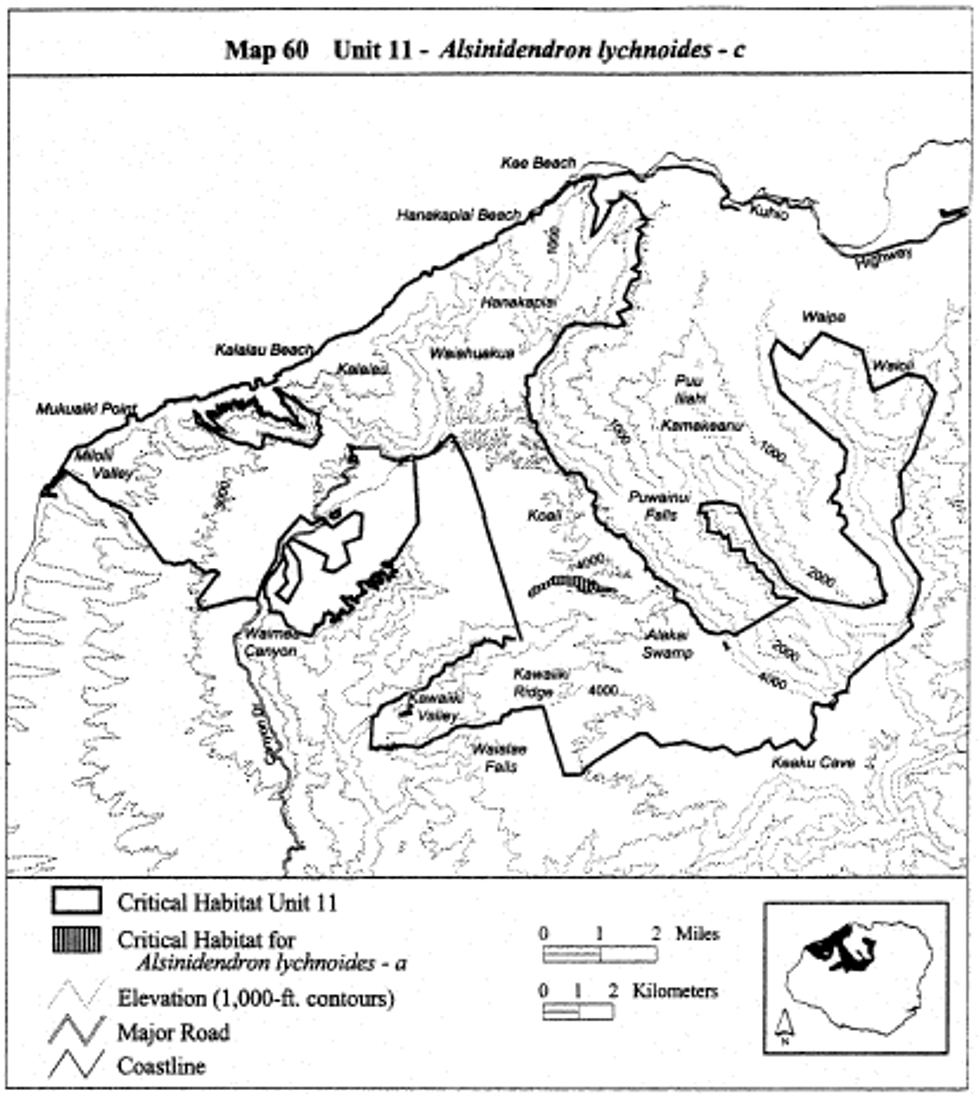
(cxxvi) Kauai 11 - Alsinidendron viscosum - a (736 ha; 1,819 ac)
(A) [Reserved]
(B) Map 61 follows:
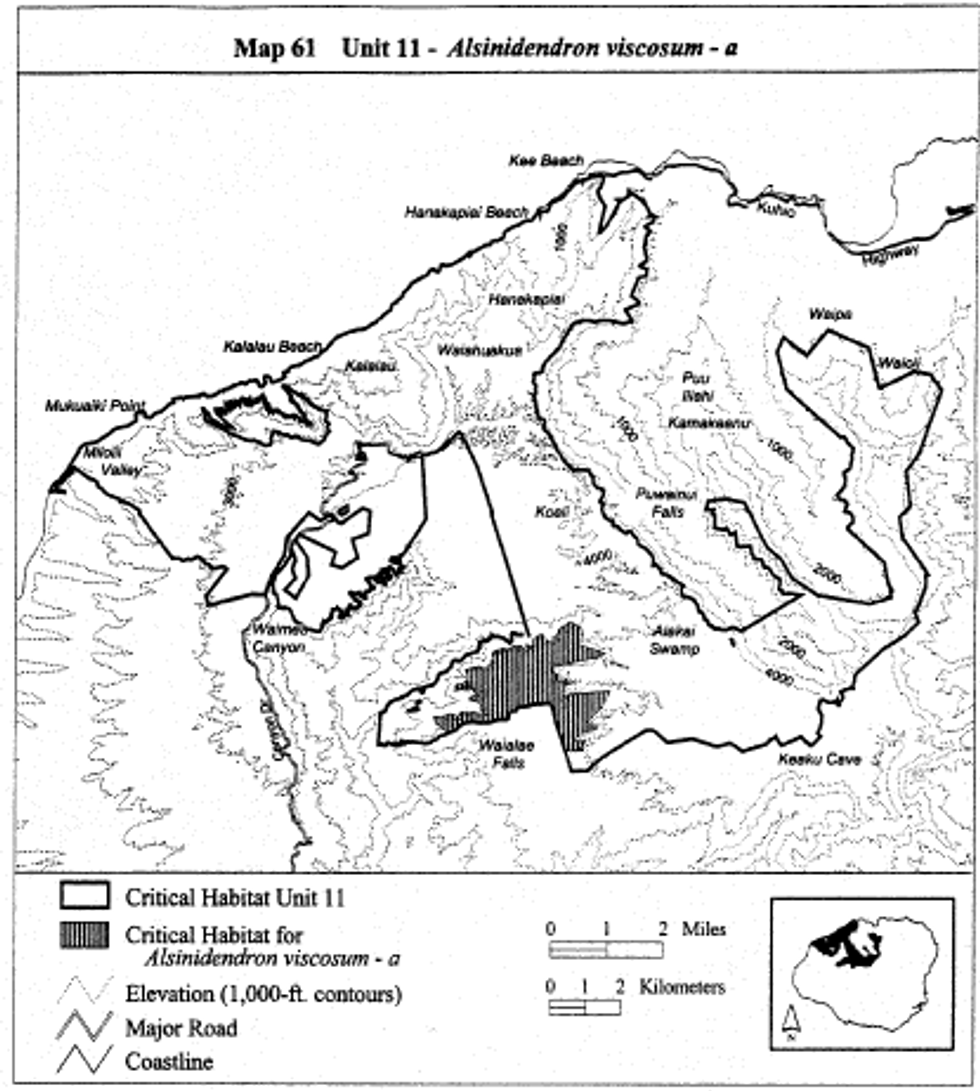
(cxxvii) Kauai 11 - Alsinidendron viscosum - b (17 ha; 42 ac)
(A) [Reserved]
(B) Map 62 follows:
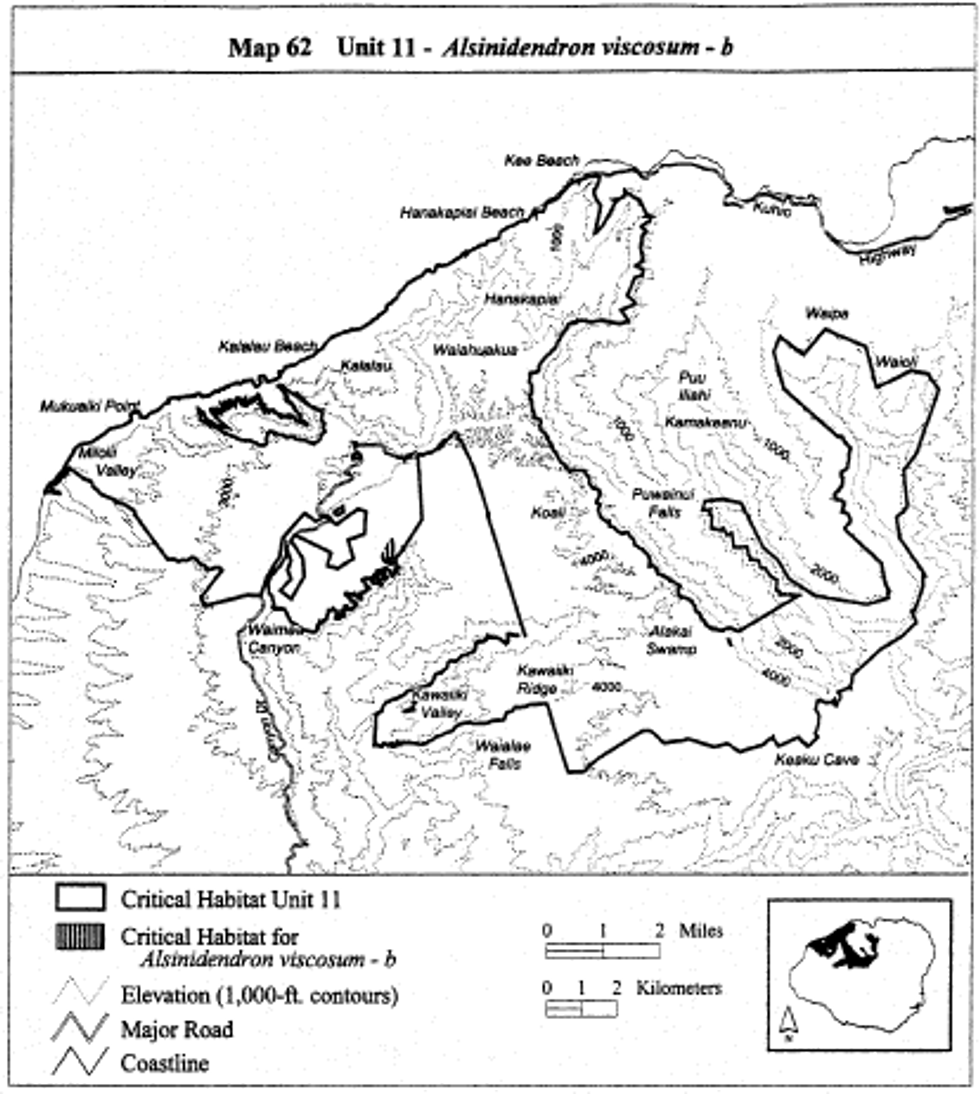
(cxxviii) Kauai 11 - Alsinidendron viscosum - c (22 ha; 55 ac)
(A) [Reserved]
(B) Map 63 follows:
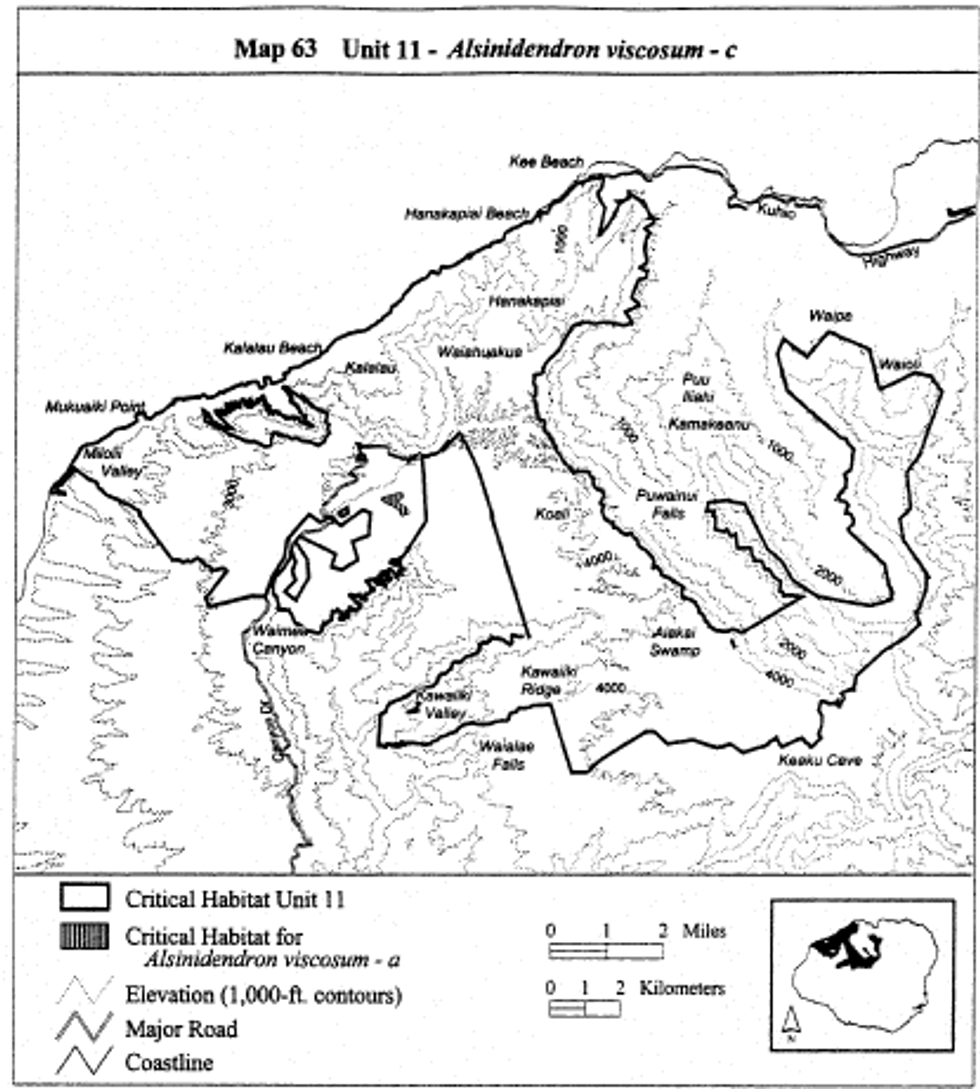
(cxxix) Kauai 11 - Alsinidendron viscosum - d (61 ha; 150 ac)
(A) [Reserved]
(B) Map 64 follows:
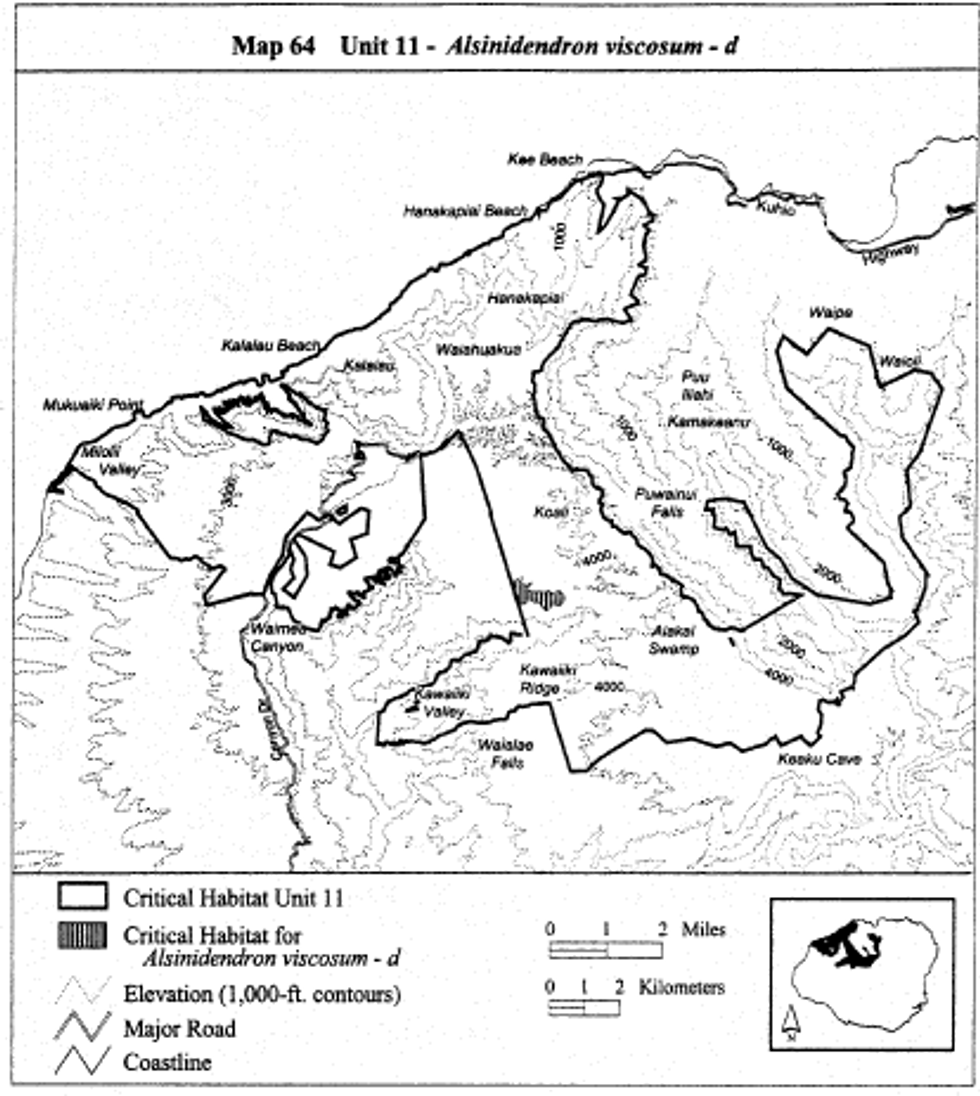
(cxxx) Kauai 11 - Astelia waialealae - b
(A) This is a unit of the Montane Wet ecosystem and consists of 14,096 ac (5,704 ha). This unit is also critical habitat for Kauai 11-Chamaesyce remyi var. remyi-f, Kauai 11-Dryopteris crinalis var. podosorus-b, Kauai 11-Dubautia kalalauensis-b, Kauai 11-Dubautia waialealae-b, Kauai 11-Geranium kauaiense-b, Kauai 11-Keysseria erici-b, Kauai 11-Keysseria helenae-b, Kauai 11-Labordia helleri-d, Kauai 11-Labordia pumila-b, Kauai 11-Lysimachia daphnoides-b, Kauai 11-Melicope degeneri-b, Kauai 11-Melicope puberula-c, Kauai 11-Myrsine mezii-b, Kauai 11-Phyllostegia renovans-c, Kauai 11- Melicope rostrata -f, Kauai 11-Psychotria grandiflora-b, and Kauai 11-Tetraplasandra flynnii-c (see paragraphs (a)(1)(cxlii), (a)(1)(clxxvii), (a)(1)(clxxix), (a)(1)(clxxxv), (a)(1)(cxcix), (a)(1)(ccxvi), (a)(1)(ccxvii), (a)(1)(ccxxii), (a)(1)(ccxxix), (a)(1)(ccxxxv), (a)(1)(ccxli), (a)(1)(ccxlix), (a)(1)(cclviii), (a)(1)(cclxvi), (a)(1)(cclxxvii), (a)(1)(ccxc), and (a)(1)(cccxxxiv), respectively, of this section).
(B) Note: The reference to �Kauai 11- Platydesma rostrata -f� on the map is equivalent to �Kauai 11- Melicope rostrata -f�. Map 64a follows:
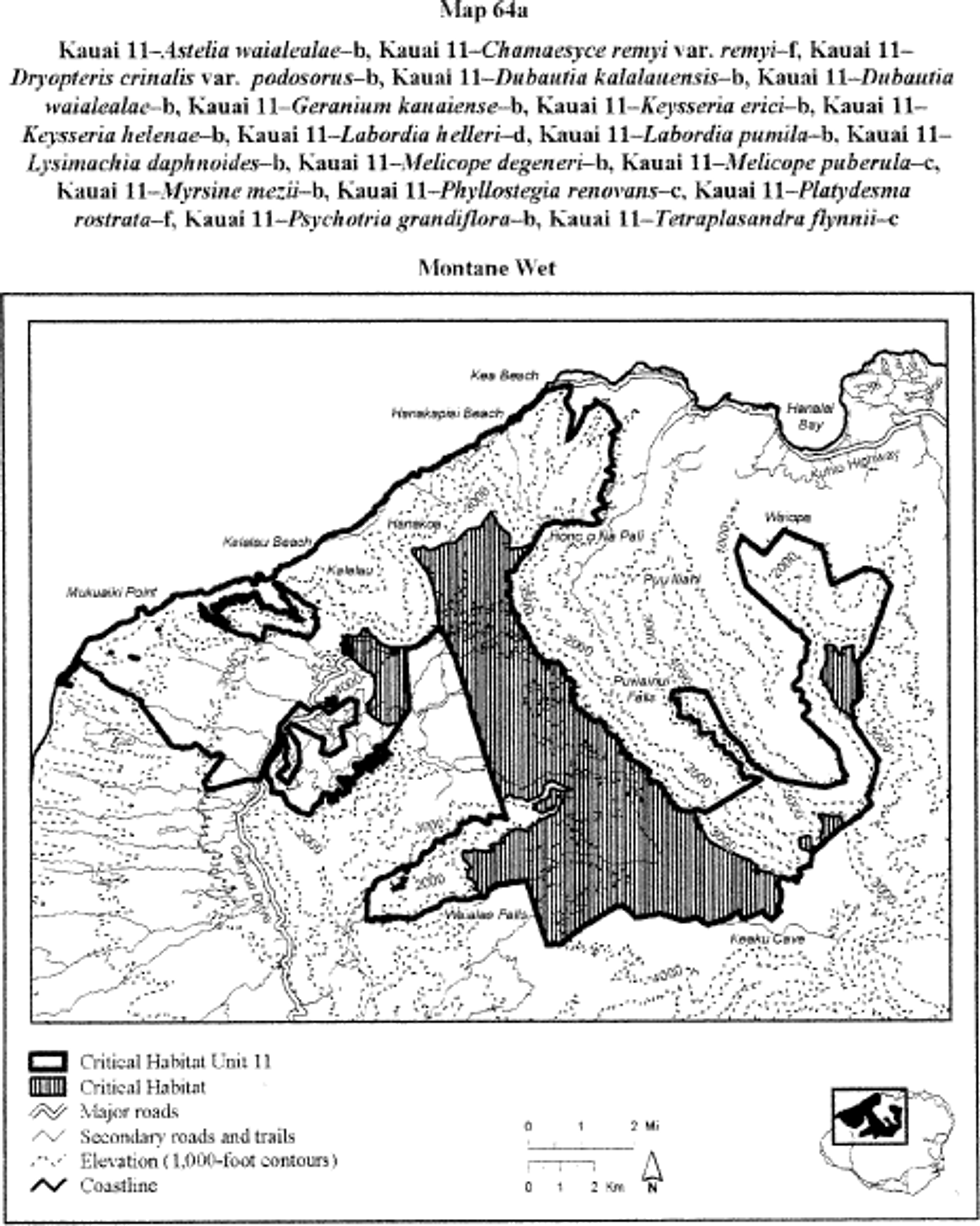
(cxxxi) Kauai 11 - Bonamia menziesii - b (93 ha; 229 ac)
(A) [Reserved]
(B) Map 65 follows:
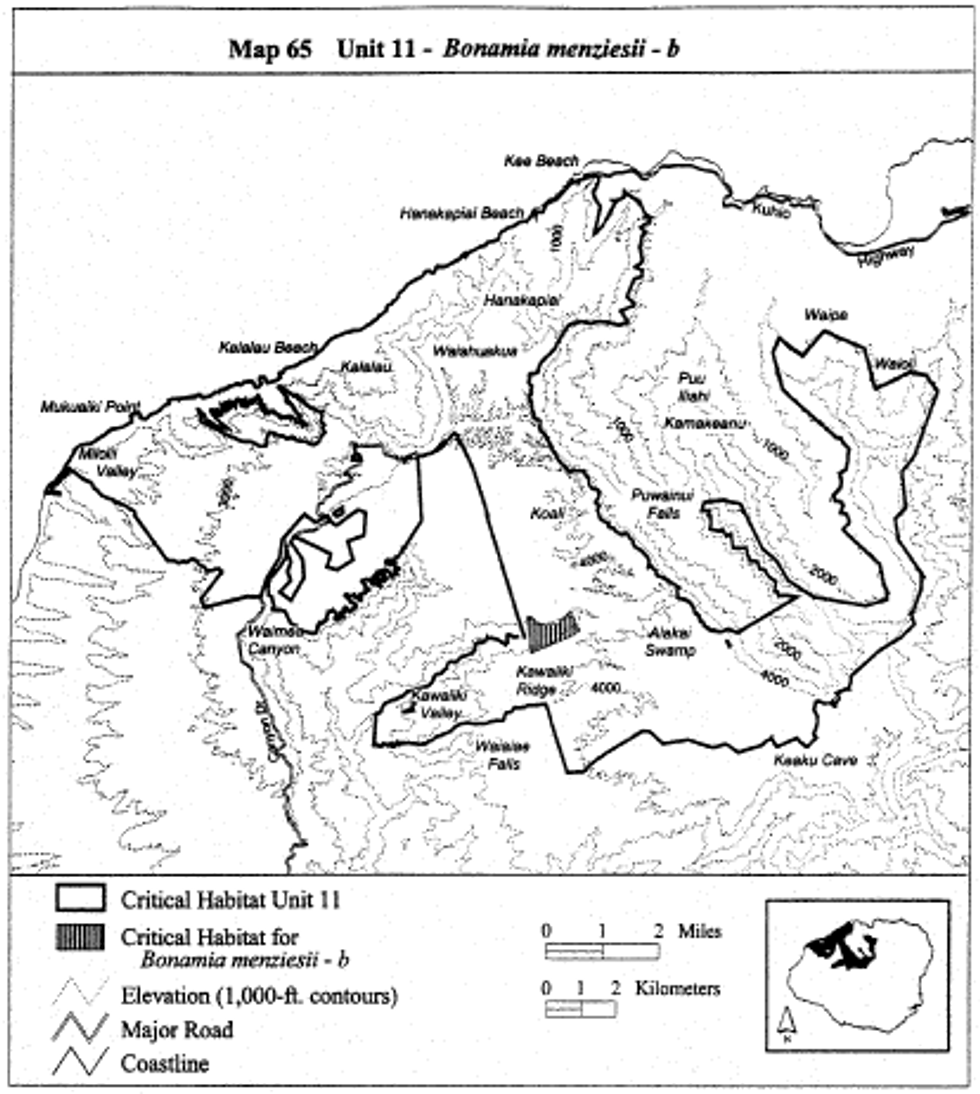
(cxxxii) Kauai 11 - Brighamia insignis - c (1,645 ha; 4,066 ac)
(A) [Reserved]
(B) Map 66 follows:
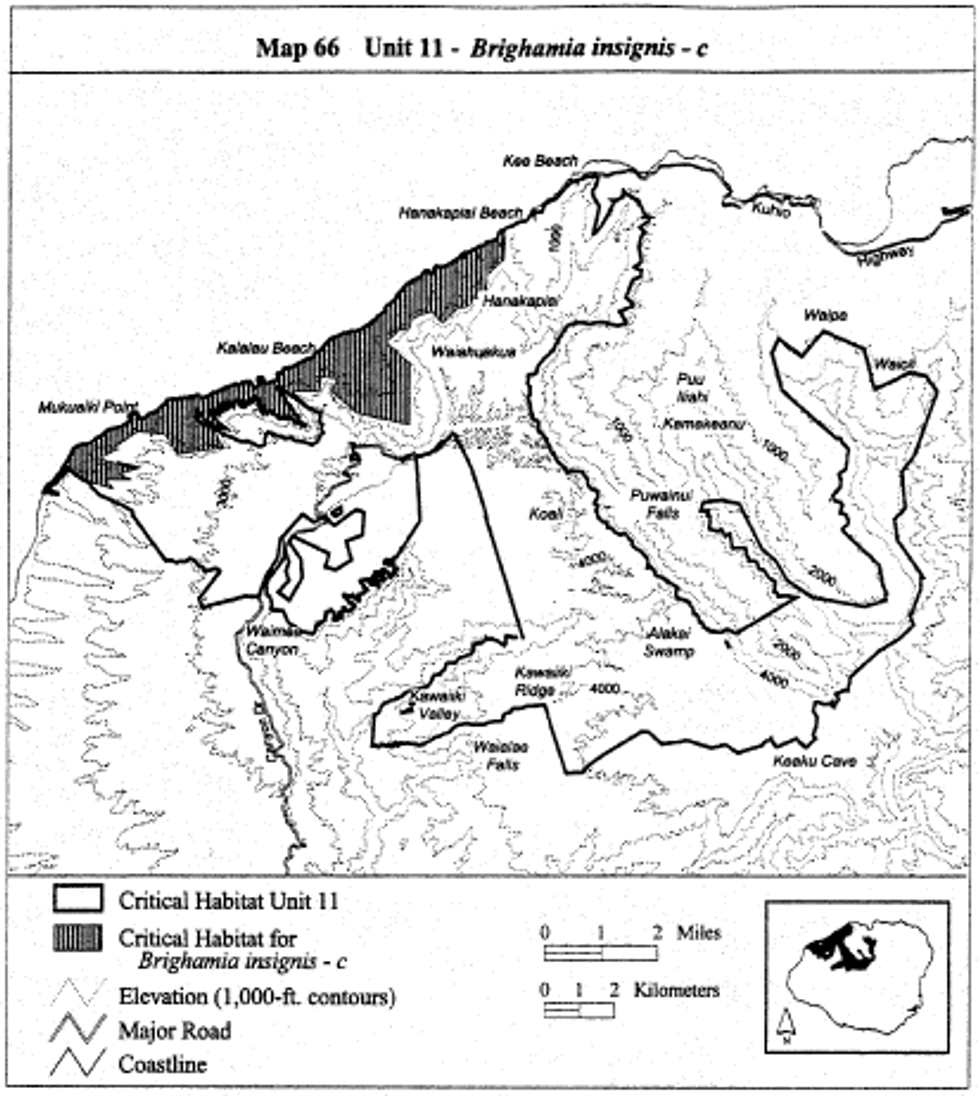
(cxxxiii) Kauai 11-Canavalia napaliensis-b
(A) This is a unit of the Lowland Mesic ecosystem and consists of 2,590 ac (1,048 ha). This unit is also critical habitat for Kauai 11-Chamaesyce eleanoriae-b, Kauai 11-Chamaesyce remyi var. remyi-g, Kauai 11-Charpentiera densiflora-c, Kauai 11-Doryopteris angelica-b, Kauai 11-Dubautia kenwoodii-b, Kauai 11-Labordia helleri-e, Kauai 11-Pittosporum napaliense-b, Kauai 11- Melicope rostrata -g, Kauai 11-Psychotria hobdyi-b, and Kauai 11-Tetraplasandra bisattenuata-c (see paragraphs (a)(1)(cxxxv), (a)(1)(cxliii), (a)(1)(cxlvii), (a)(1)(clxxvi), (a)(1)(clxxx), (a)(1)(ccxxiii), (a)(1)(cclxxii), (a)(1)(cclxxviii), (a)(1)(ccxcii), and (a)(1)(cccxxxii), respectively, of this section).
(B) Note: The reference to �Kauai 11- Platydesma rostrata -g� on the map is equivalent to �Kauai 11- Melicope rostrata -g�. Map 66a follows:
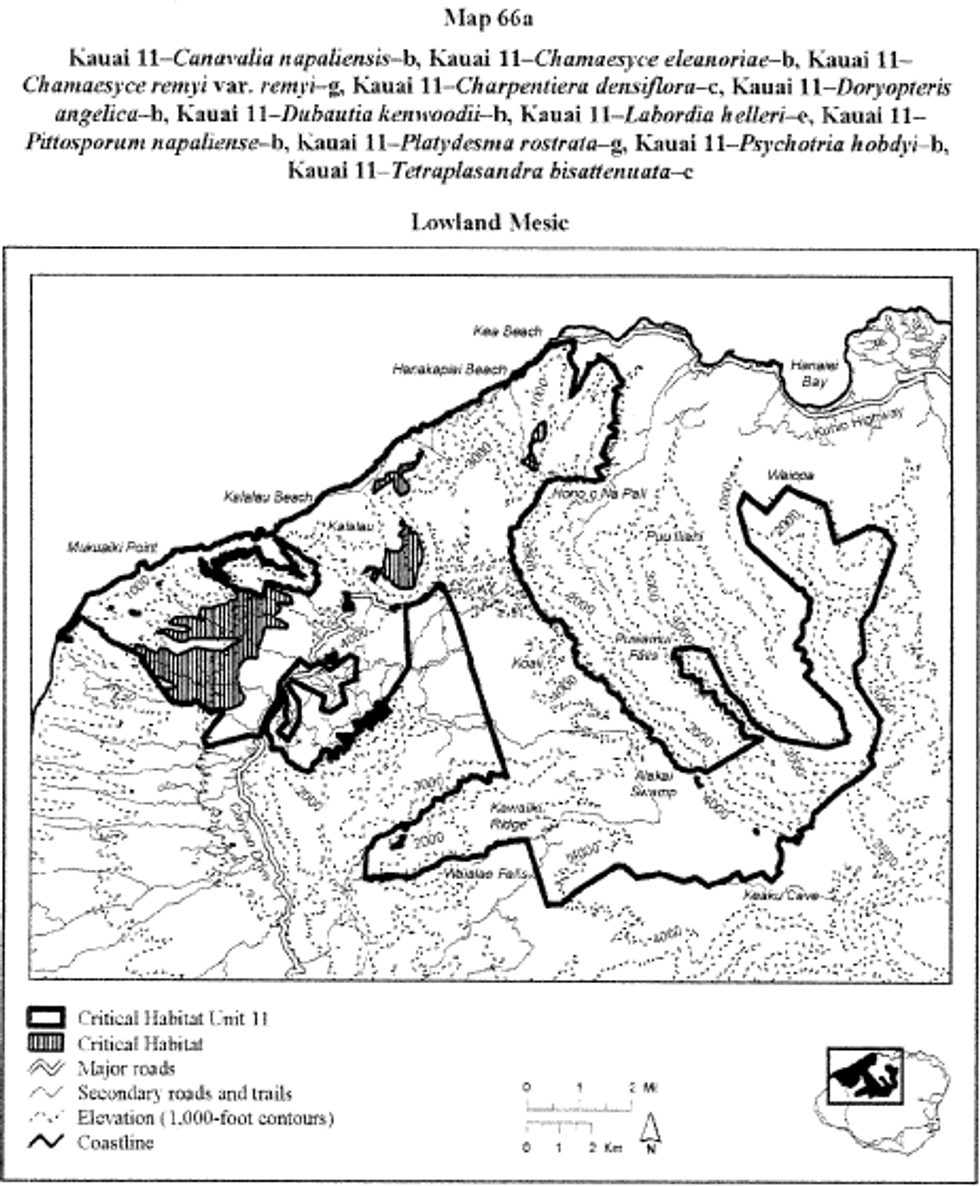
(cxxxiv) Kauai 11 - Schenkia sebaeoides - a (157 ha; 389 ac)
(A) [Reserved]
(B) Map 67 follows:
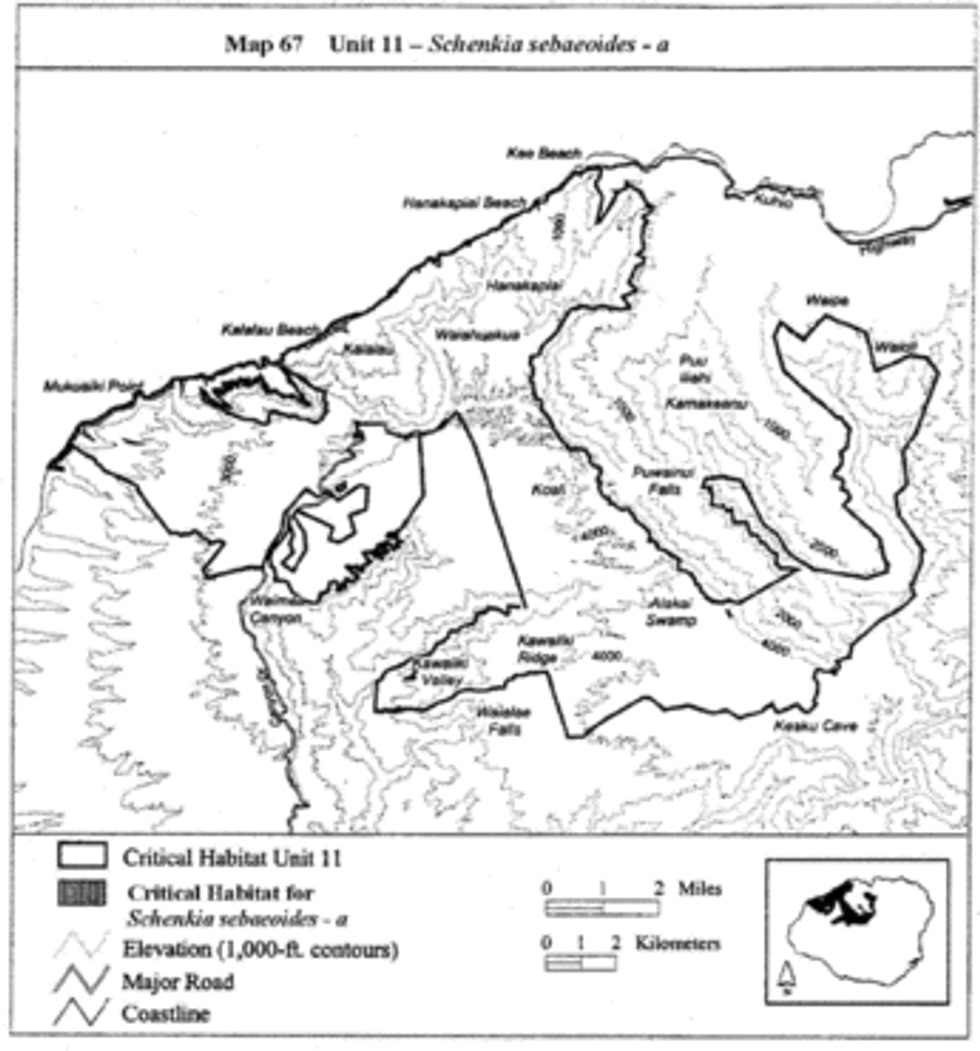
(cxxxv) Kauai 11-Chamaesyce eleanoriae-b
(A) [Reserved]
(B) See paragraph (a)(1)(cxxxiii)(B) of this section for the map of this unit.
(cxxxvi) Kauai 11-Chamaesyce eleanoriae-c
(A) This is a unit of the Dry Cliff ecosystem and consists of 712 ac (288 ha). This unit is also critical habitat for Kauai 11-Lysimachia scopulensis-a, Kauai 11-Schiedea attenuata-a, and Kauai 11-Stenogyne kealiae-b (see paragraphs (a)(1)(ccxxxviii), (a)(1)(cccix), and (a)(1)(cccxxix), respectively, of this section).
(B) Map 67a follows:
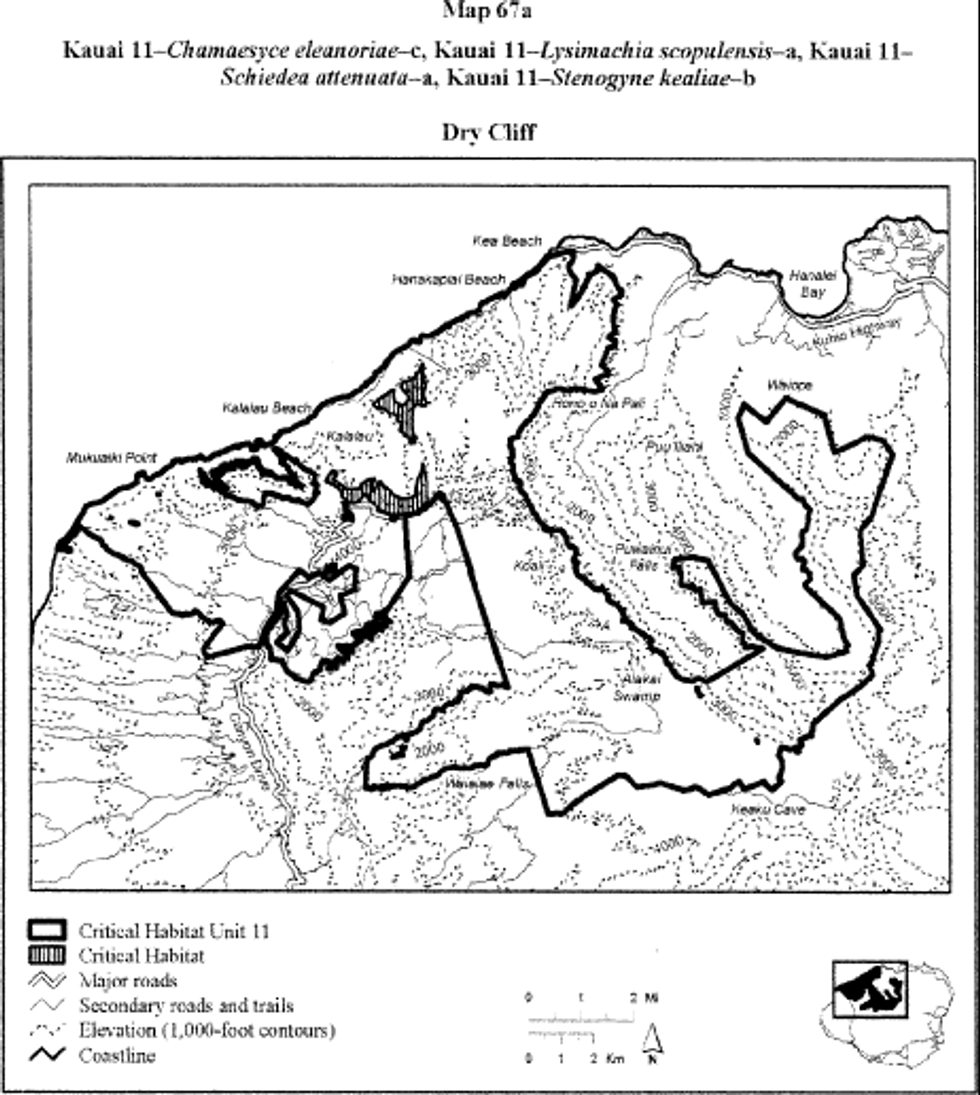
(cxxxvii) Kauai 11 - Chamaesyce halemanui - a (108 ha; 267 ac)
(A) [Reserved]
(B) Map 68 follows:
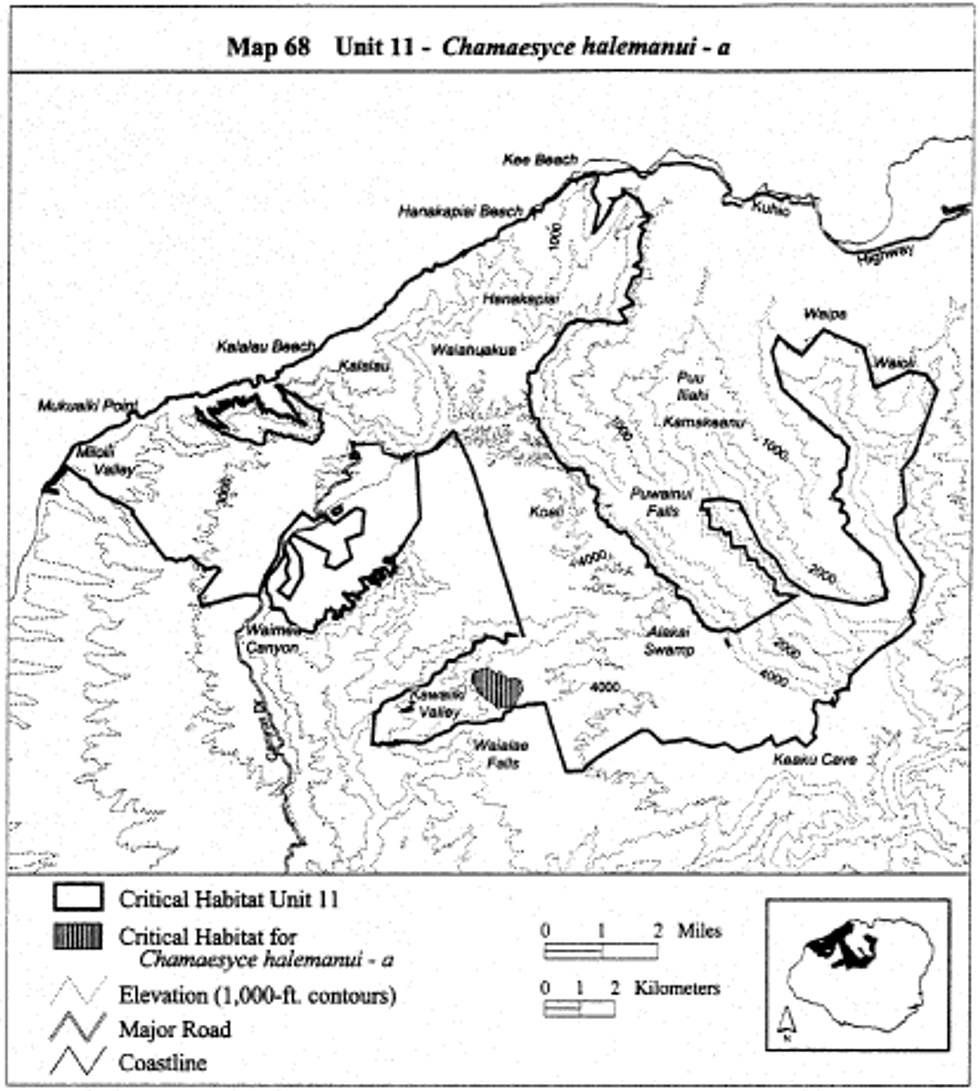
(cxxxviii) Kauai 11 - Chamaesyce halemanui - b (17 ha; 43 ac)
(A) [Reserved]
(B) Map 69 follows:
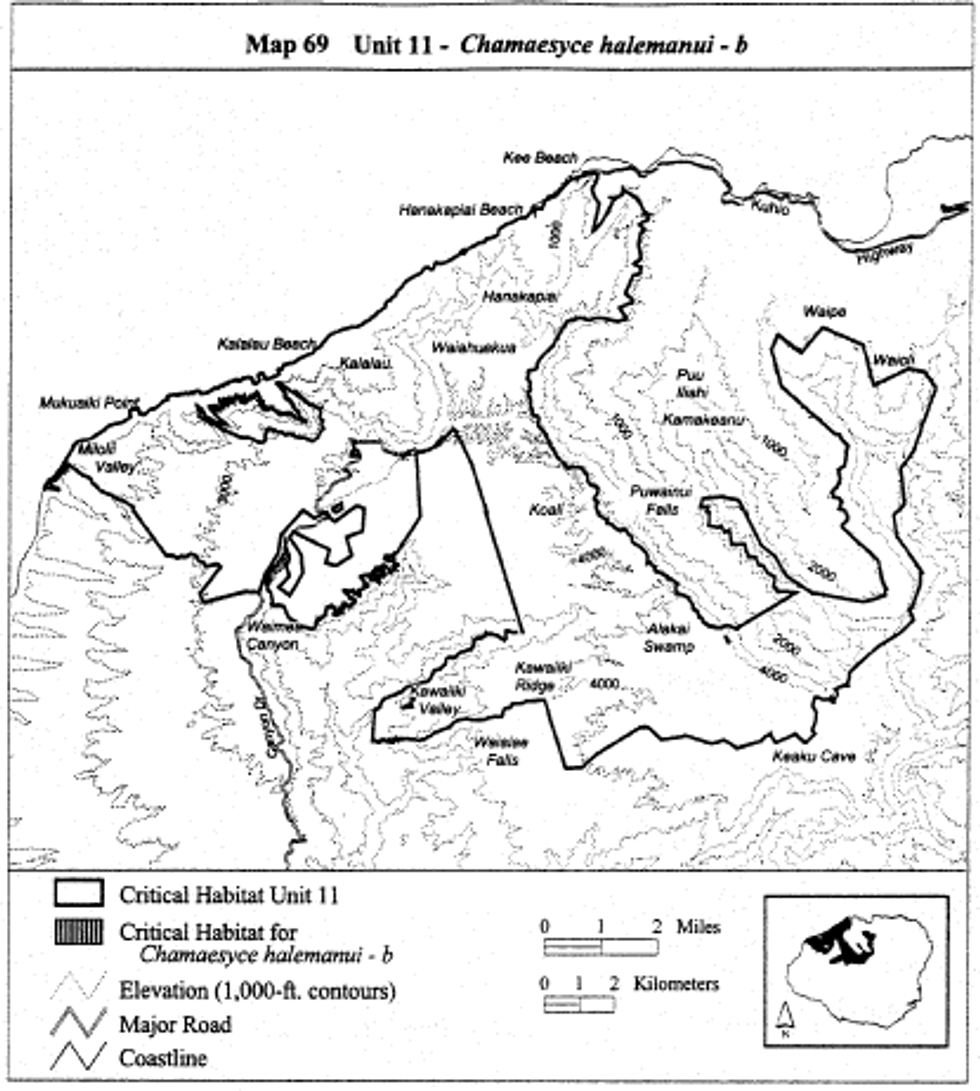
(cxxxix) Kauai 11 - Chamaesyce halemanui - c (1,283 ha; 3,171 ac)
(A) [Reserved]
(B) Map 70 follows:
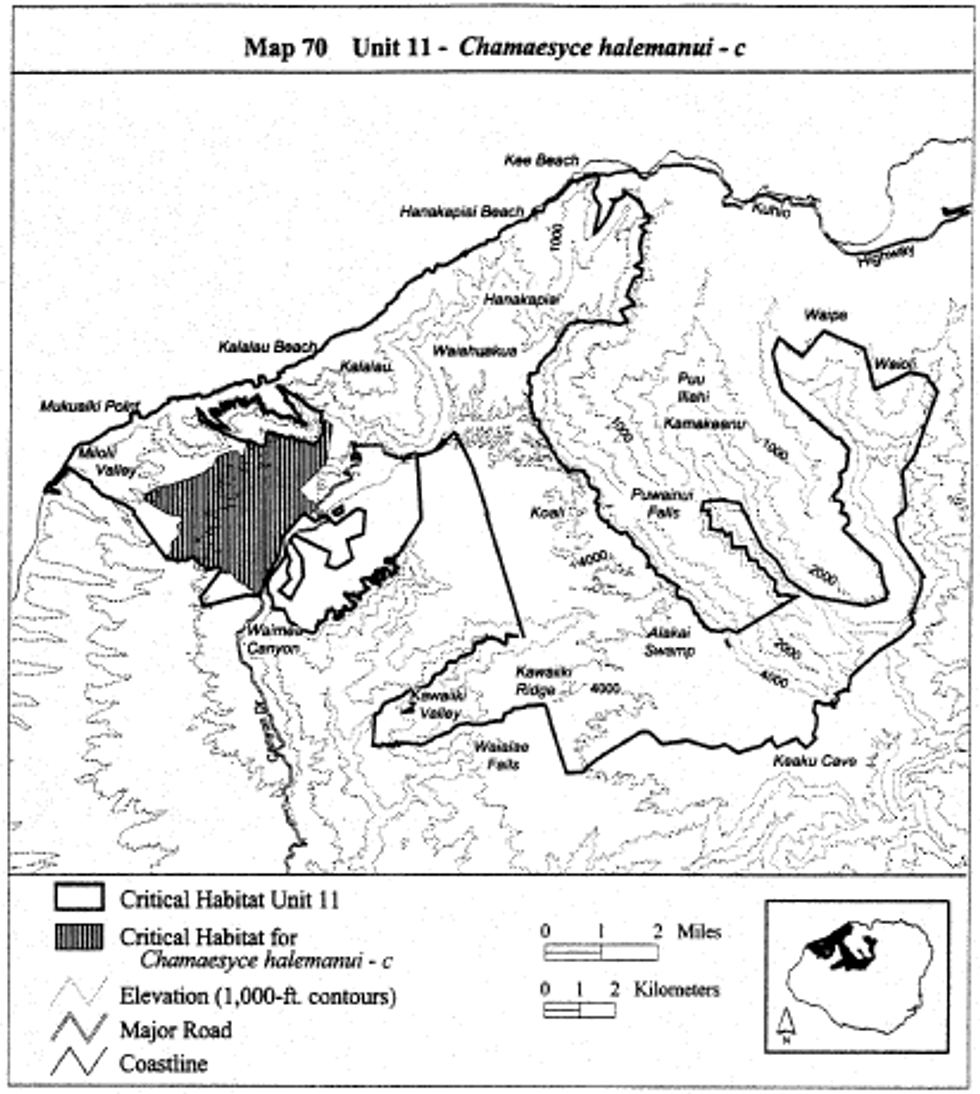
(cxl) Kauai 11-Chamaesyce remyi var. kauaiensis-d
(A) This is a unit of the Lowland Wet ecosystem and consists of 2,618 ac (1,060 ha). This unit is also critical habitat for Kauai 11-Chamaesyce remyi var. remyi-h, Kauai 11-Charpentiera densiflora-d, Kauai 11-Cyanea eleeleensis-b, Kauai 11-Cyanea kolekoleensis-b, Kauai 11-Cyanea kuhihewa-b, Kauai 11-Cyrtandra oenobarba-d, Kauai 11-Dubautia imbricata ssp. imbricata-b, Kauai 11-Labordia helleri-f, Kauai 11-Melicope paniculata-b, Kauai 11-Melicope puberula-d, Kauai 11-Phyllostegia renovans-d, Kauai 11- Melicope rostrata -h, Kauai 11-Stenogyne kealiae-c, Kauai 11-Tetraplasandra bisattenuata-d, and Kauai 11-Tetraplasandra flynii-d (see paragraphs (a)(1)(cxliv), (a)(1)(cxlviii), (a)(1)(cli), (a)(1)(clii), (a)(1)(cliii), (a)(1)(clxiii), (a)(1)(clxxviii), (a)(1)(ccxxiv), (a)(1)(ccxlviii), (a)(1)(ccl), (a)(1)(cclxvii), (a)(1)(cclxxix), (a)(1)(cccxxx), (a)(1)(cccxxxiii), and (a)(1)(cccxxxv) respectively, of this section).
(B) Note: The reference to �Kauai 11- Platydesma rostrata -h� on the map is equivalent to �Kauai 11- Melicope rostrata -h�. Map 70a follows:
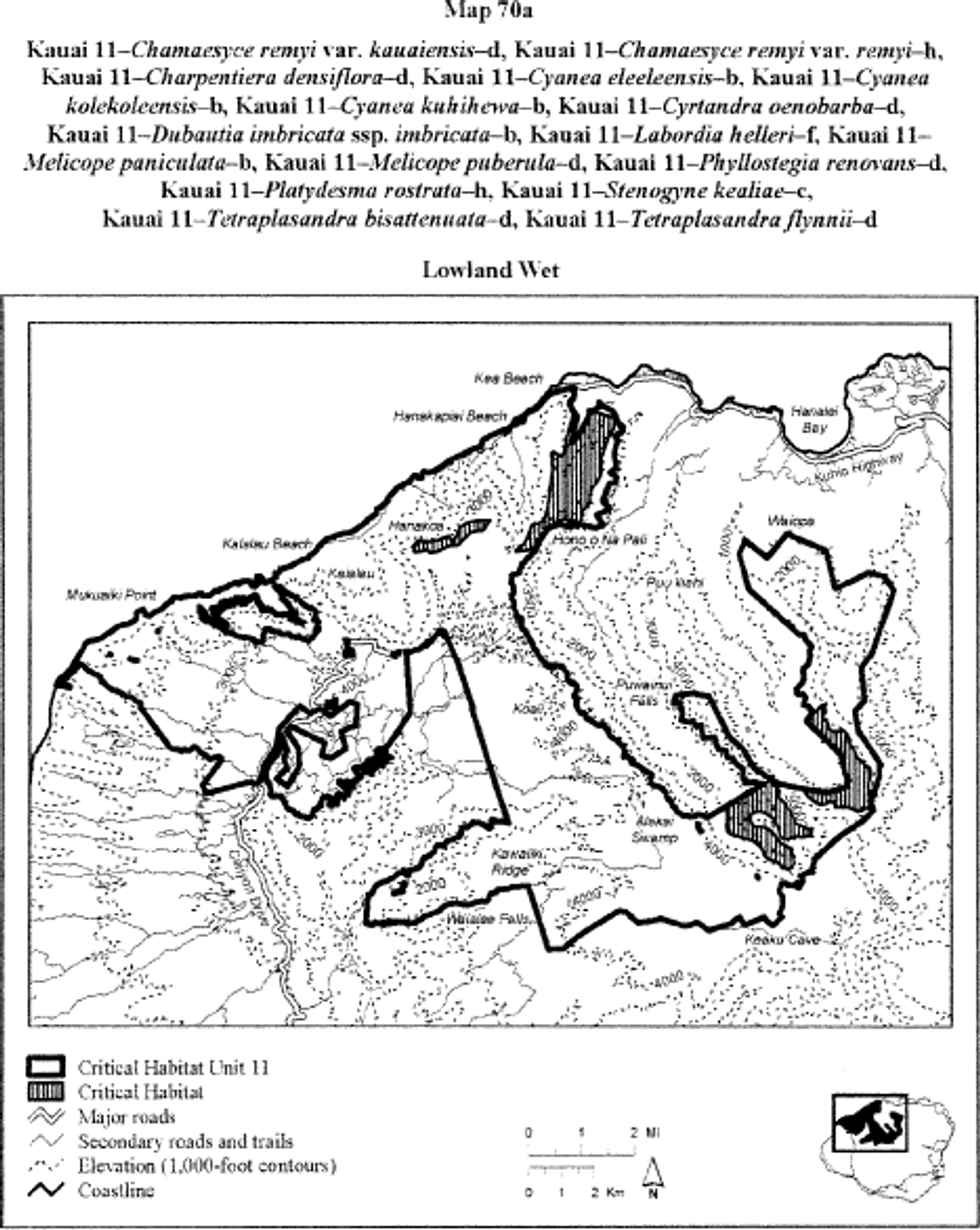
(cxli) Kauai 11-Chamaesyce remyi var. kauaiensis-e
(A) This is a unit of the Wet Cliff ecosystem and consists of 190 ac; 77 ha. This unit is also critical habitat for Kauai 11-Chamaesyce remyi var. remyi-i, Kauai 11-Cyanea dolichopoda-c, Kauai 11-Cyrtandra oenobarba-e, Kauai 11-Cyrtandra paliku-c, Kauai 11-Dubautia plantaginea ssp. magnifolia-c, Kauai 11-Lysimachia iniki-c, Kauai 11-Lysimachia pendens-c, Kauai 11- Lysimachia venosa-c, and Kauai 11- Melicope rostrata -i (see paragraphs (a)(1)(cxlv), (a)(1)(cl), (a)(1)(clxiv), (a)(1)(clxv), (a)(1)(clxxxiv), (a)(1)(ccxxxvi), (a)(1)(ccxxxvii), (a)(1)(ccxxxix), and (a)(1)(cclxxx), respectively, of this section).
(B) Note: The reference to �Kauai 11- Platydesma rostrata -i� on the map is equivalent to �Kauai 11- Melicope rostrata -i�. Map 70b follows:
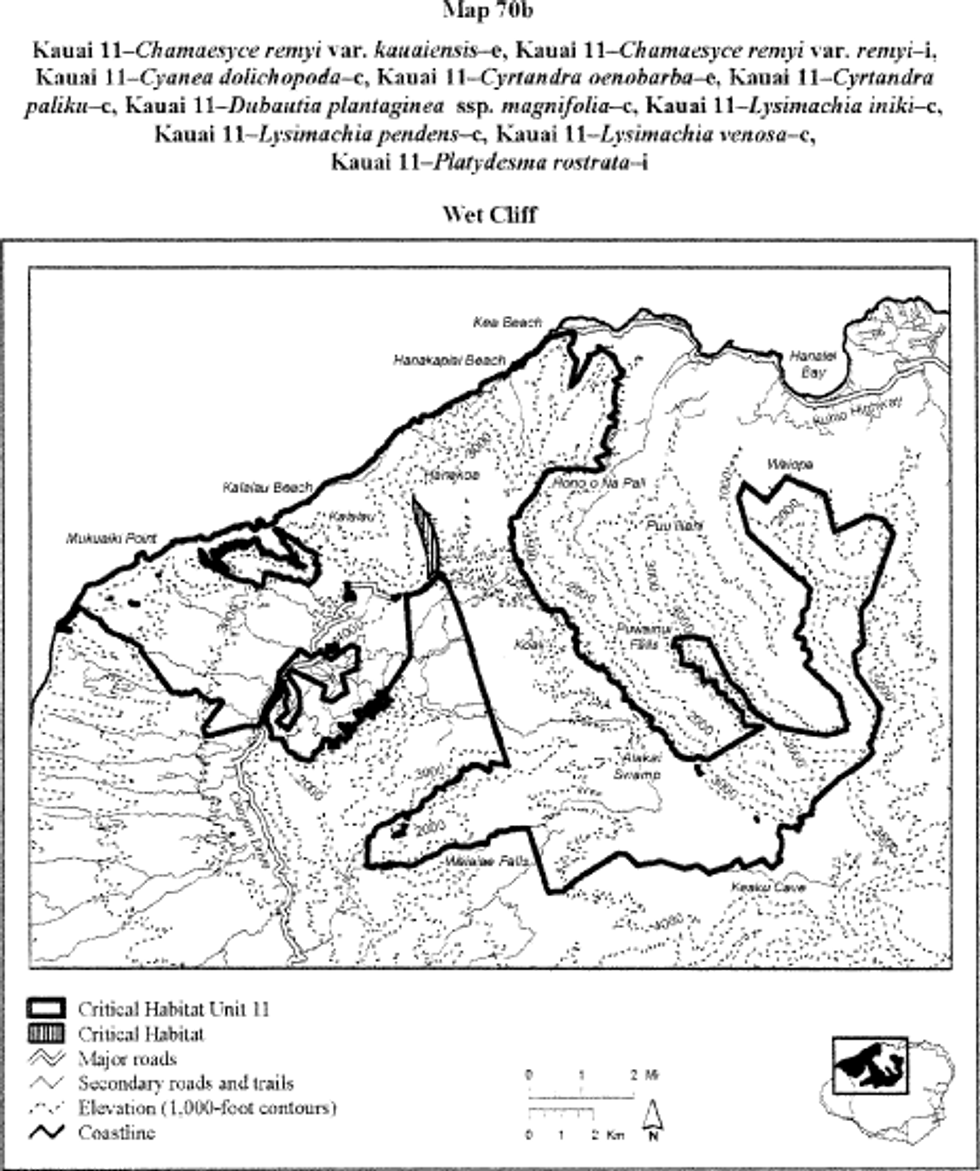
(cxlii) Kauai 11-Chamaesyce remyi var. remyi-f
(A) [Reserved]
(B) See paragraph (a)(1)(cxxx)(B) of this section for the map of this unit.
(cxliii) Kauai 11-Chamaesyce remyi var. remyi-g
(A) [Reserved]
(B) See paragraph (a)(1)(cxxxiii)(B) of this section for the map of this unit.
(cxliv) Kauai 11-Chamaesyce remyi var. remyi-h
(A) [Reserved]
(B) See paragraph (a)(1)(cxl)(B) of this section for the map of this unit.
(cxlv) Kauai 11-Chamaesyce remyi var. remyi-i
(A) [Reserved]
(B) See paragraph (a)(1)(cxli)(B) of this section for the map of this unit.
(cxlvi) Kauai 11-Chamaesyce remyi var. remyi-j
(A) This is a unit of the Montane Mesic ecosystem and consists of 2,790 ac (1,129 ha). This unit is also critical habitat for Kauai 11-Diellia mannii-a, Kauai 11-Labordia helleri-g, Kauai 11-Myrsine knudsenii-a, Kauai 11-Myrsine mezii-c, Kauai 11- Melicope rostrata -j, Kauai 11-Psychotria grandiflora-c, Kauai 11-Stenogyne kealiae-d, and Kauai 11-Tetraplasandra flynnii-e (see paragraphs (a)(1)(clxxii), (a)(1)(ccxxv), (a)(1)(ccliii), (a)(1)(cclix), (a)(1)(cclxxxi), (a)(1)(ccxci), (a)(1)(ccxxxi), and (a)(1)(cccxxxvi), respectively, of this section).
(B) Note: The reference to �Kauai 11- Platydesma rostrata -j� on the map is equivalent to �Kauai 11- Melicope rostrata -j�. Map 70c follows:
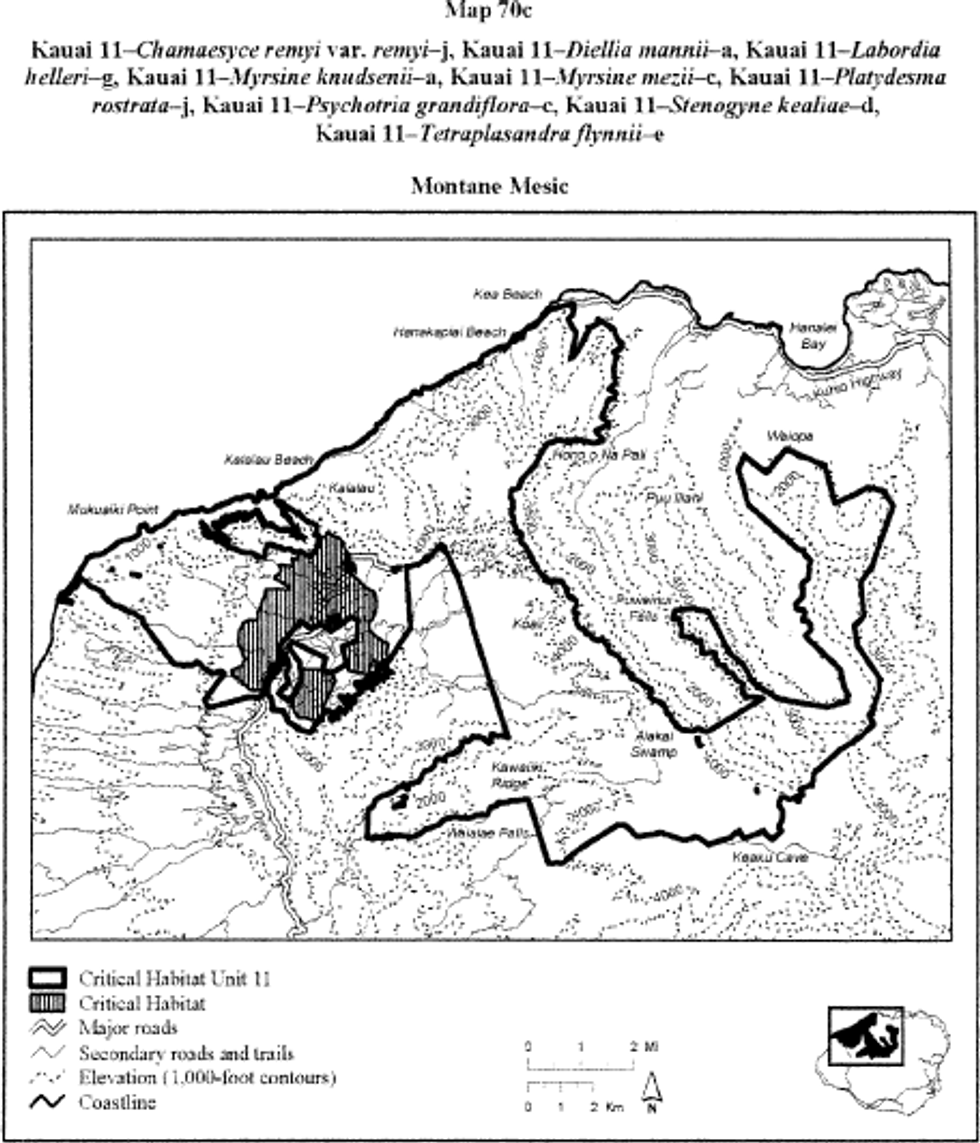
(cxlvii) Kauai 11-Charpentiera densiflora-c
(A) [Reserved]
(B) See paragraph (a)(1)(cxxxiii)(B) of this section for the map of this unit.
(cxlviii) Kauai 11-Charpentiera densiflora-d
(A) [Reserved]
(B) See paragraph (a)(1)(cxl)(B) of this section for the map of this unit.
(cxlix) Kauai 11 - Ctenitis squamigera - a (735 ha; 1,817 ac)
(A) [Reserved]
(B) Map 71 follows:
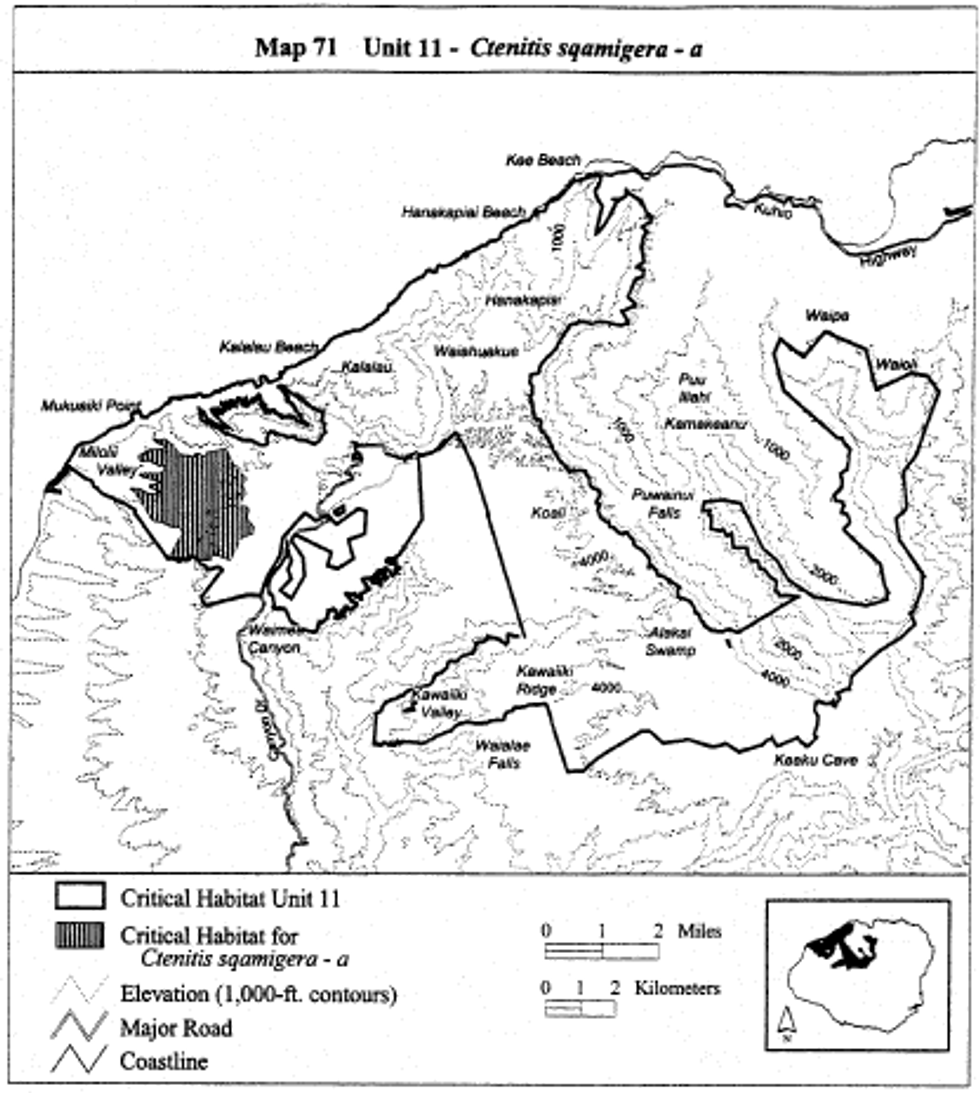
(cl) Kauai 11-Cyanea dolichopoda-c
(A) [Reserved]
(B) See paragraph (a)(1)(cxli)(B) of this section for the map of this unit.
(cli) Kauai 11-Cyanea eleeleensis-b
(A) [Reserved]
(B) See paragraph (a)(1)(cxl)(B) of this section for the map of this unit.
(clii) Kauai 11-Cyanea kolekoleensis-b
(A) [Reserved]
(B) See paragraph (a)(1)(cxl)(B) of this section for the map of this unit.
(cliii) Kauai 11-Cyanea kuhihewa-b
(A) [Reserved]
(B) See paragraph (a)(1)(cxl)(B) of this section for the map of this unit.
(cliv) Kauai 11 - Cyanea recta - c (553 ha; 1,367 ac)
(A) [Reserved]
(B) Map 72 follows:
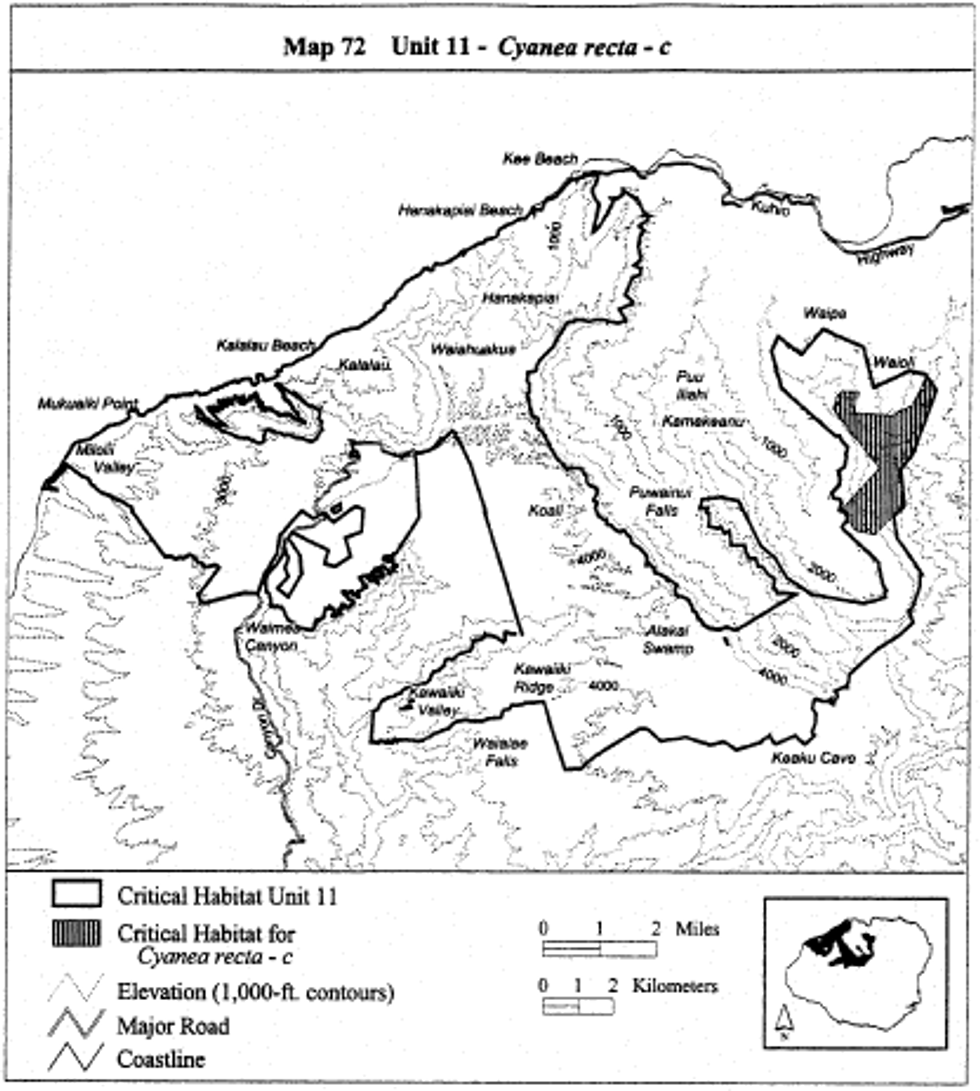
(clv) Kauai 11 - Cyanea recta - d (397 ha; 981 ac)
(A) [Reserved]
(B) Map 73 follows:
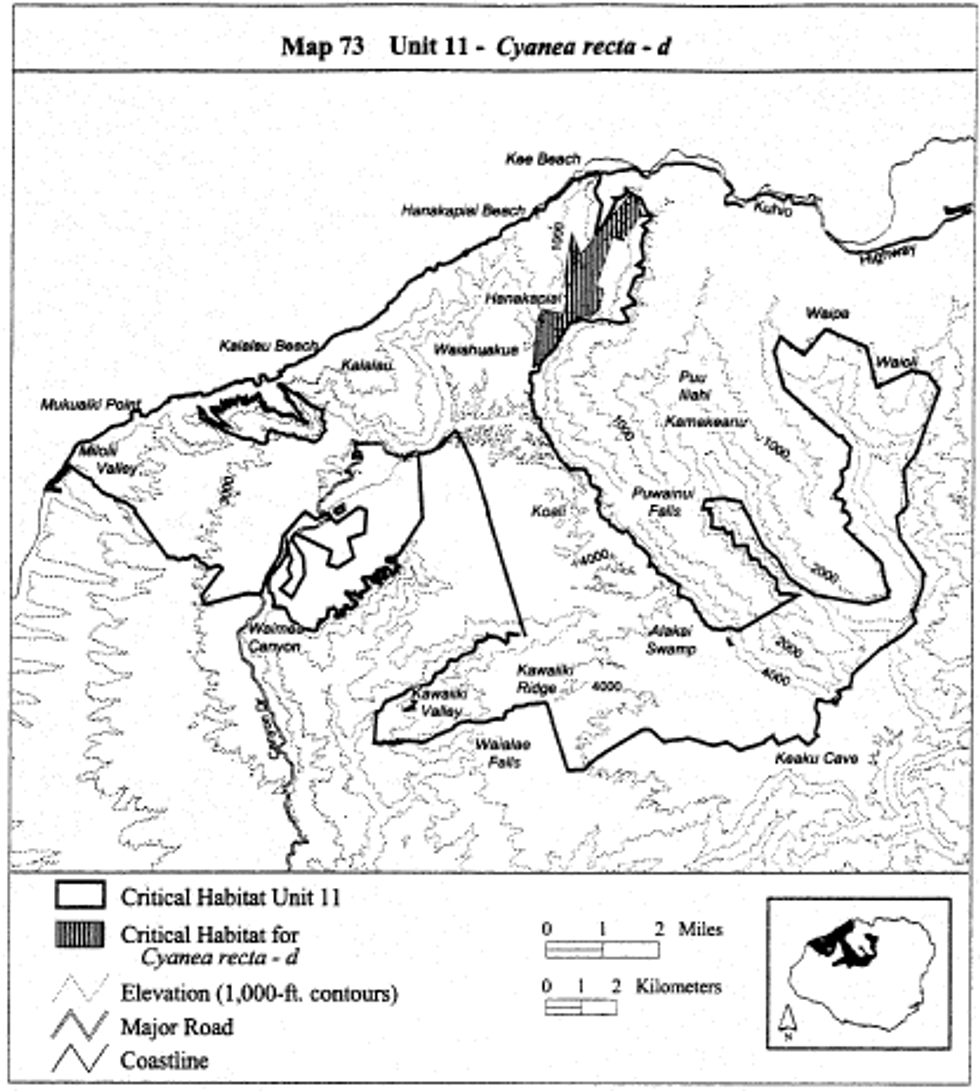
(clvi) Kauai 11 - Cyanea remyi - c (365 ha; 901 ac)
(A) [Reserved]
(B) Map 74 follows:
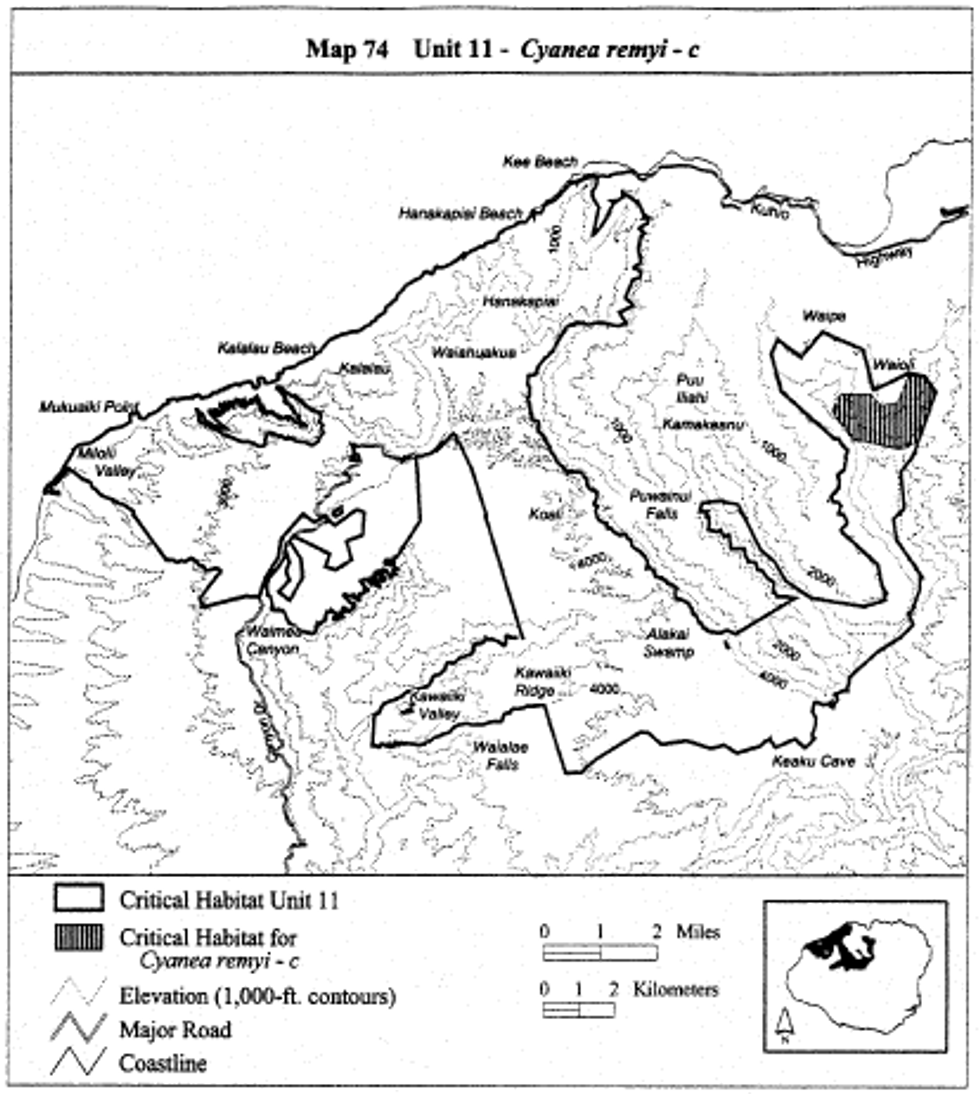
(clvii) Kauai 11 - Cyanea remyi - d (663 ha; 1,638 ac)
(A) [Reserved]
(B) Map 75 follows:
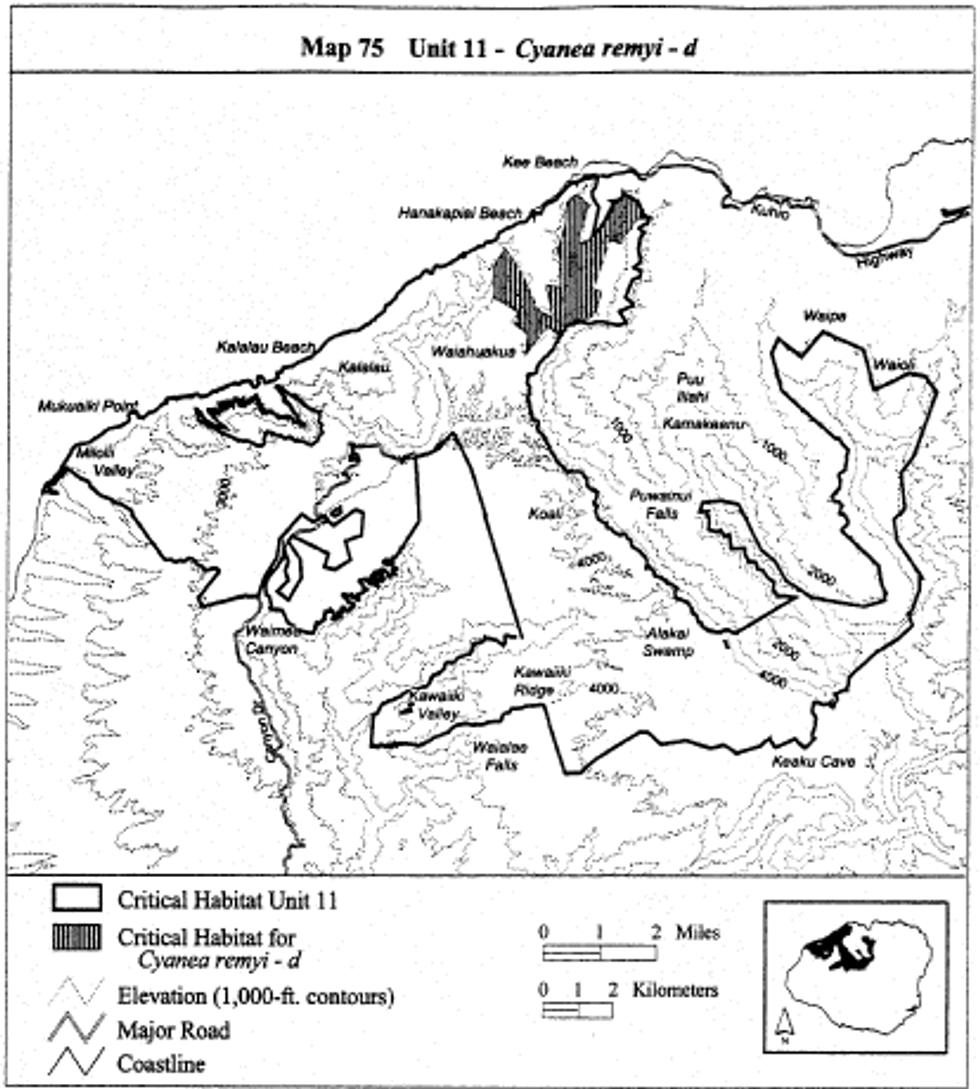
(clviii) Kauai 11 - Cyperus trachysanthos - a (434 ha; 1,071 ac)
(A) [Reserved]
(B) Map 76 follows:
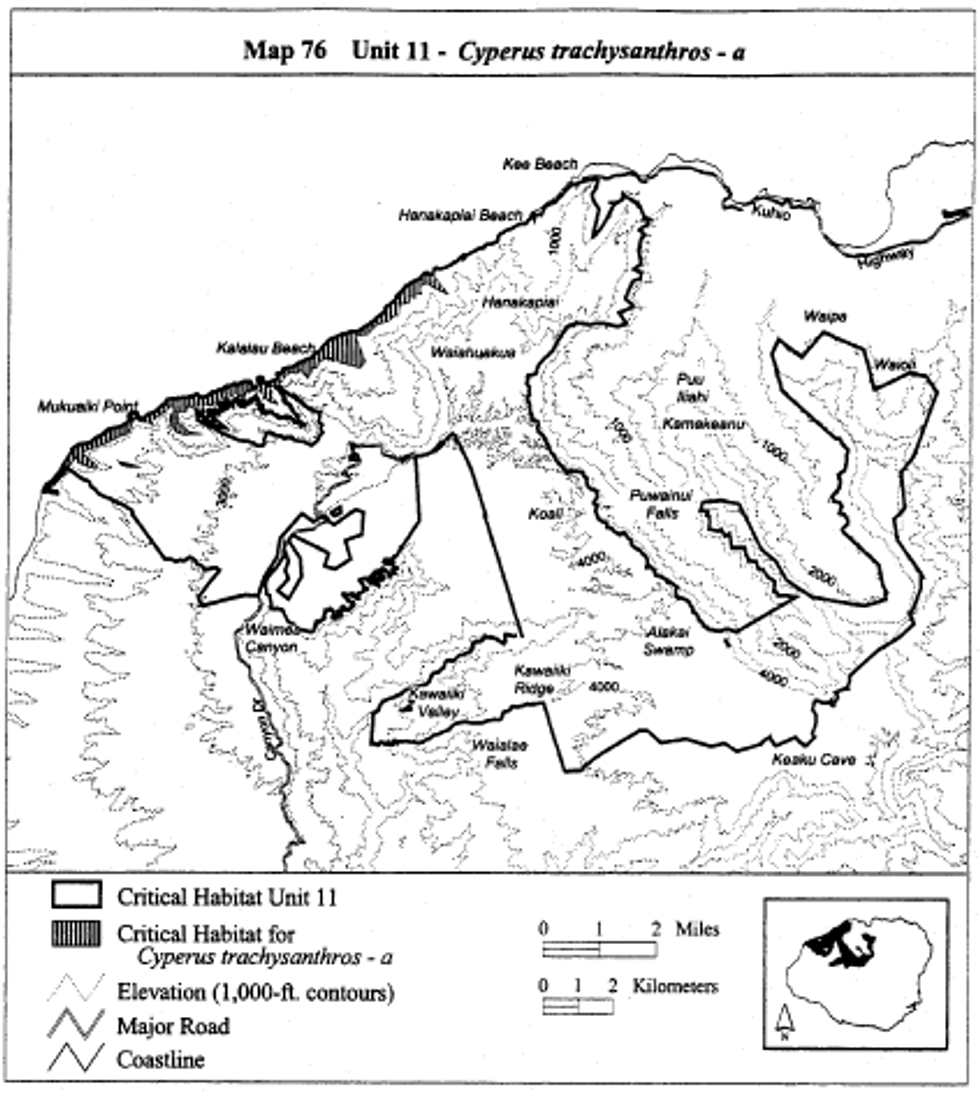
(clix) Kauai 11 - Cyrtandra cyaneoides - b (848 ha; 2,095 ac)
(A) [Reserved]
(B) Map 77 follows:
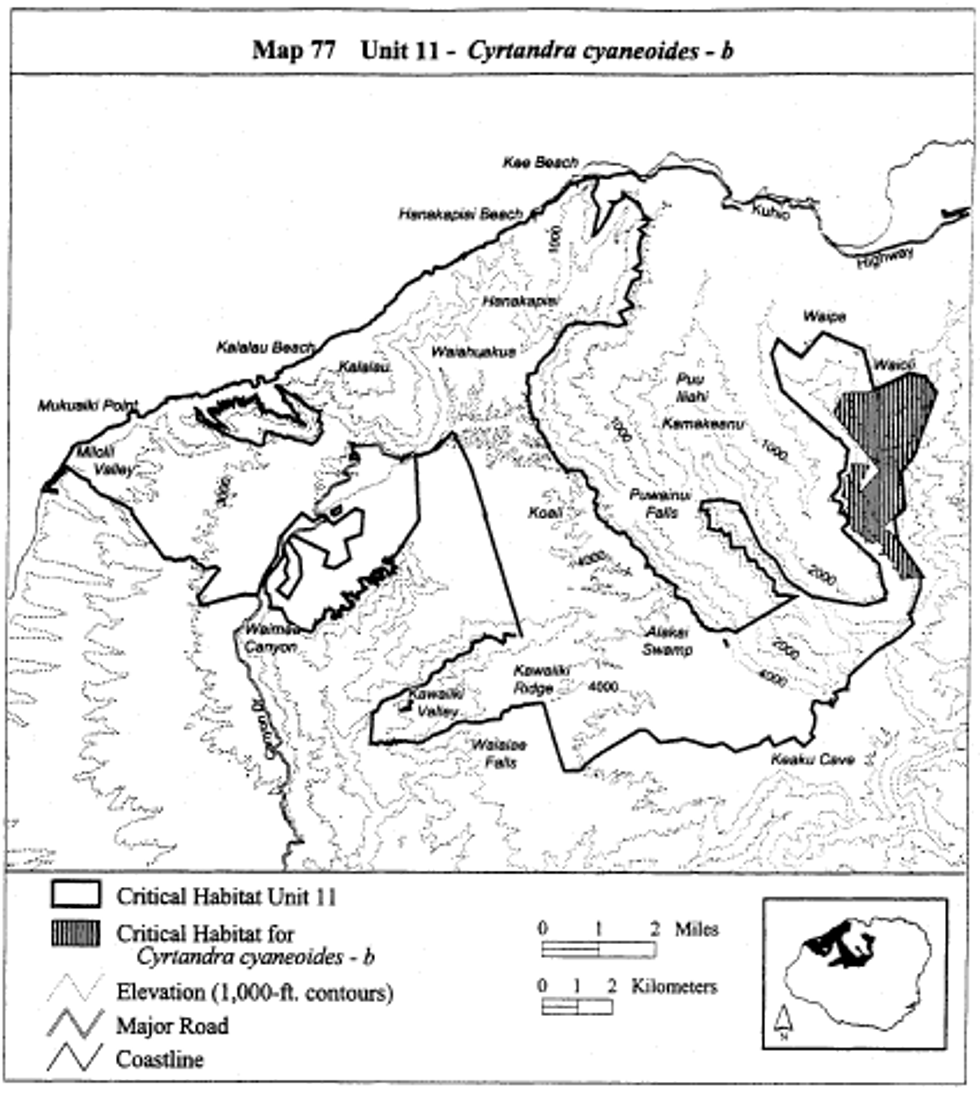
(clx) Kauai 11 - Cyrtandra cyaneoides - c (1,118 ha; 2,763 ac)
(A) [Reserved]
(B) Map 78 follows:
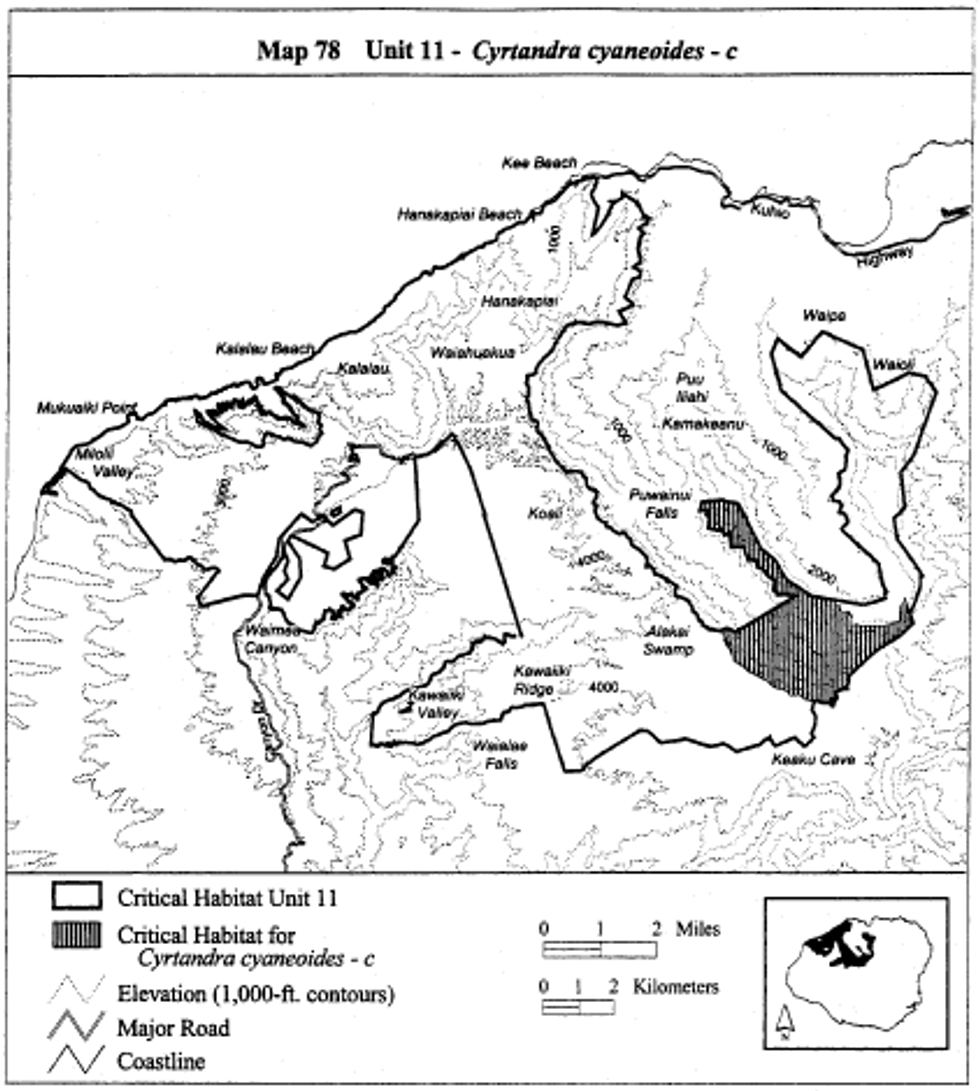
(clxi) Kauai 11- Cyrtandra kealiae ssp. kealiae -d (816 ha; 2,016 ac)
(A) [Reserved]
(B) Note: The reference to �Unit 11- Cyrtandra limahuliensis -d� on the map is equivalent to �Kauai 11- Cyrtandra kealiae ssp. kealiae- d�. Map 79 follows:
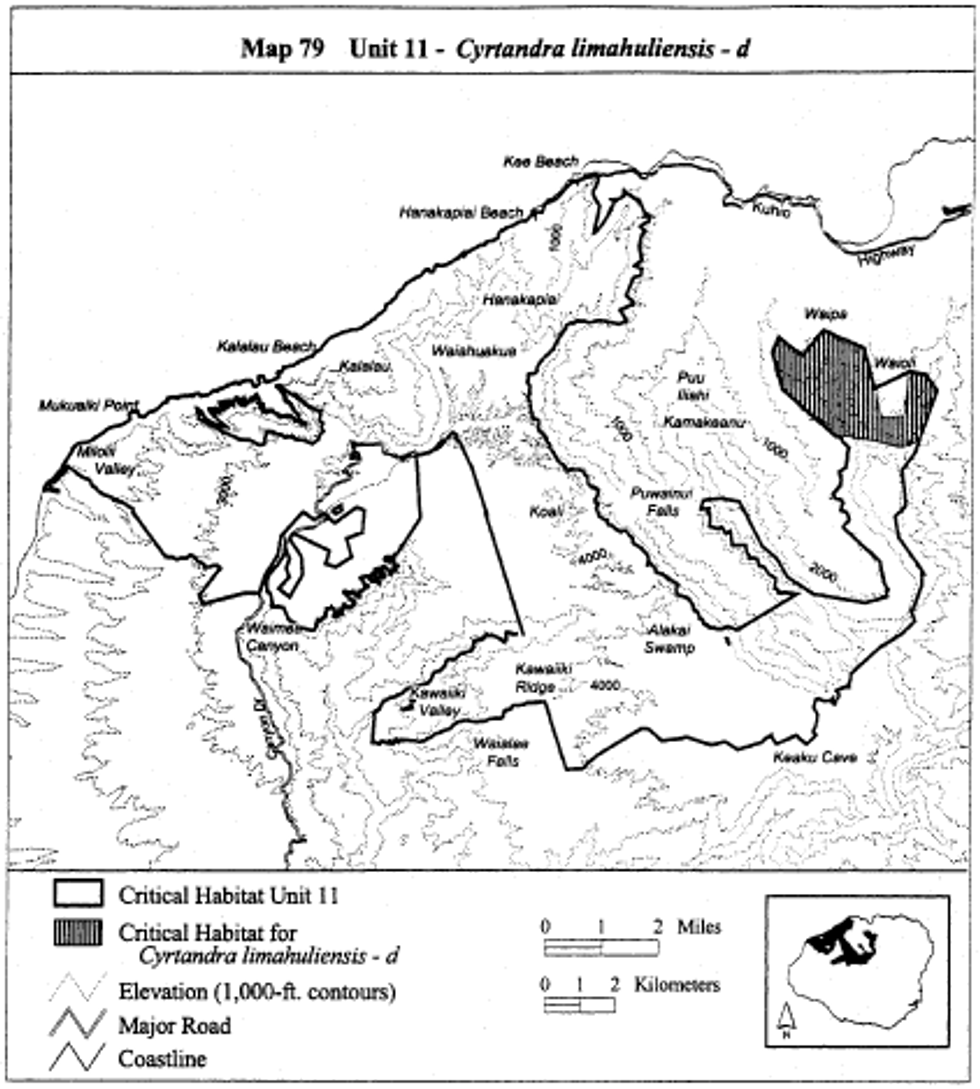
(clxii) Kauai 11- Cyrtandra kealiae ssp. kealiae -e (693 ha; 1,712 ac)
(A) [Reserved]
(B) Note: The reference to �Unit 11- Cyrtandra limahuliensis -e� on the map is equivalent to �Kauai 11- Cyrtandra kealiae ssp. kealiae- e�. Map 80 follows:
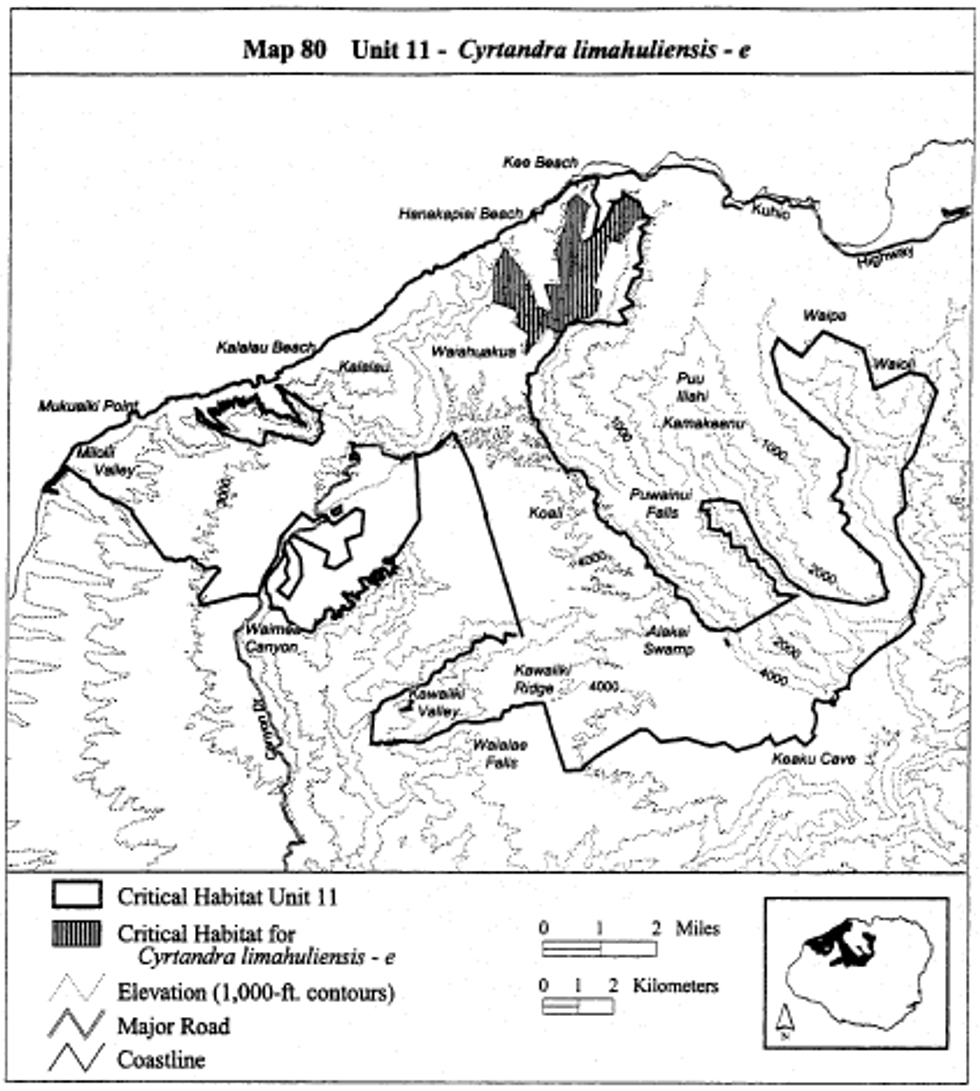
(clxiii) Kauai 11-Cyrtandra oenobarba-d
(A) [Reserved]
(B) See paragraph (a)(1)(cxl)(B) of this section for the map of this unit.
(clxiv) Kauai 11-Cyrtandra oenobarba-e
(A) [Reserved]
(B) See paragraph (a)(1)(cxli)(B) of this section for the map of this unit.
(clxv) Kauai 11-Cyrtandra paliku-c
(A) [Reserved]
(B) See paragraph (a)(1)(cxli)(B) of this section for the map of this unit.
(clxvi) Kauai 11 - Delissea rhytidosperma - b (258 ha; 638 ac)
(A) [Reserved]
(B) Map 81 follows:
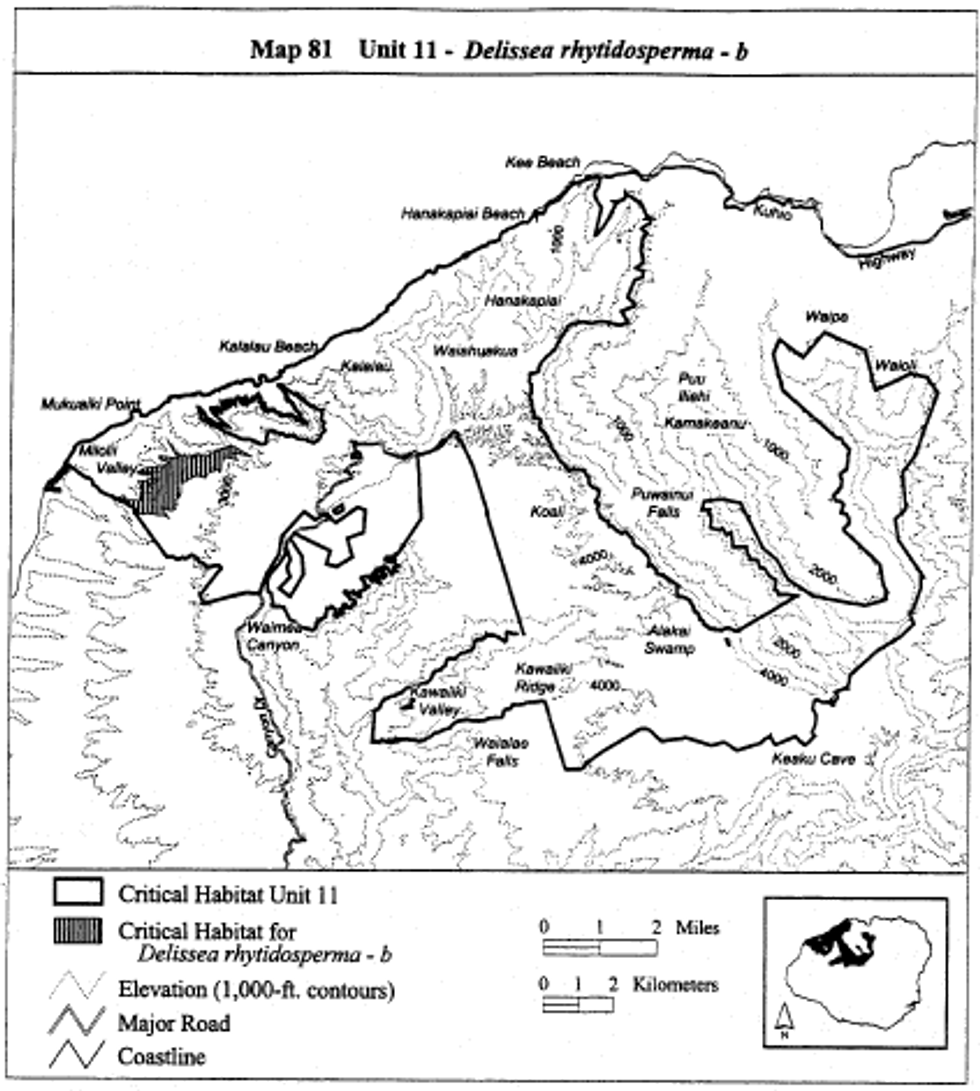
(clxvii) Kauai 11 - Delissea rhytidosperma - c (103 ha; 254 ac)
(A) [Reserved]
(B) Map 82 follows:
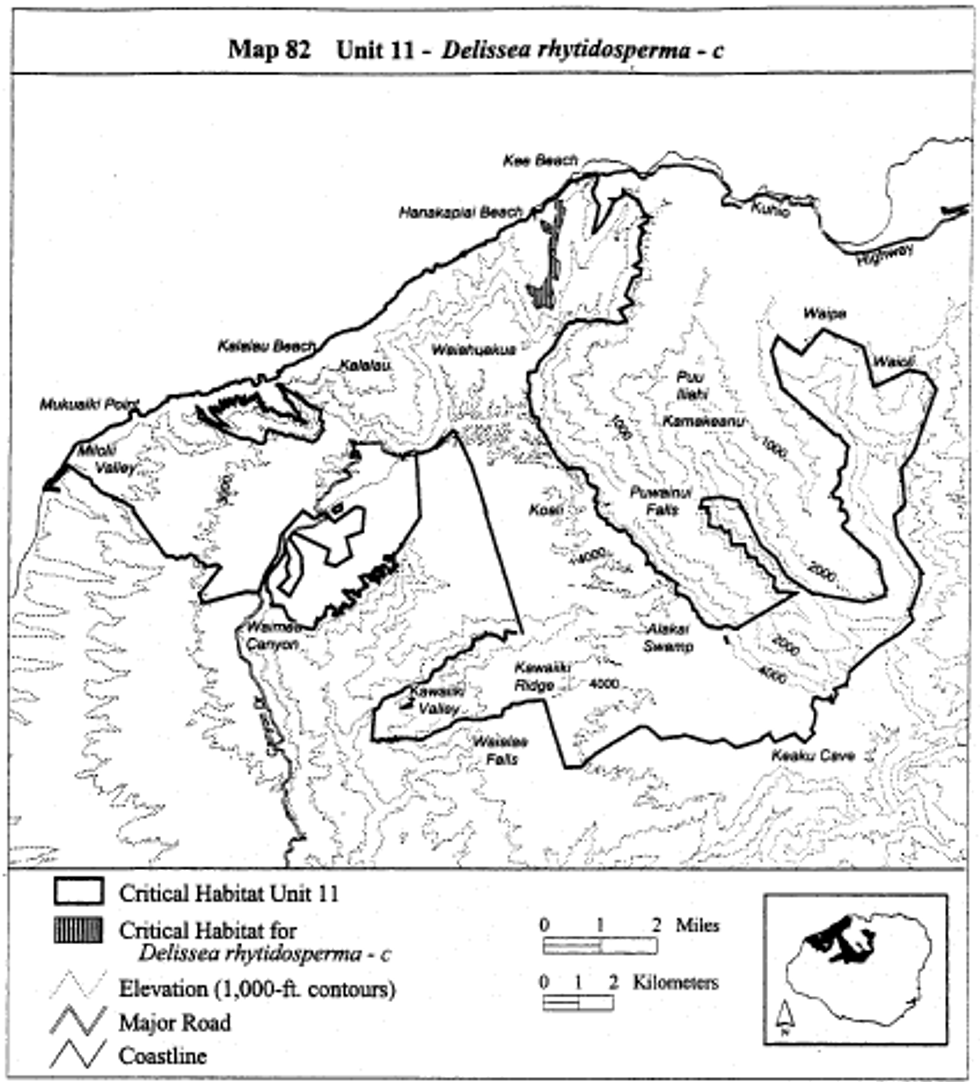
(clxviii) Kauai 11- Cyanea rivularis -a (850 ha; 2,100 ac)
(A) [Reserved]
(B) Note: The reference to �Unit 11- Delissea rivularis -a� on the map is equivalent to �Kauai 11- Cyanea rivularis -a�. Map 83 follows:
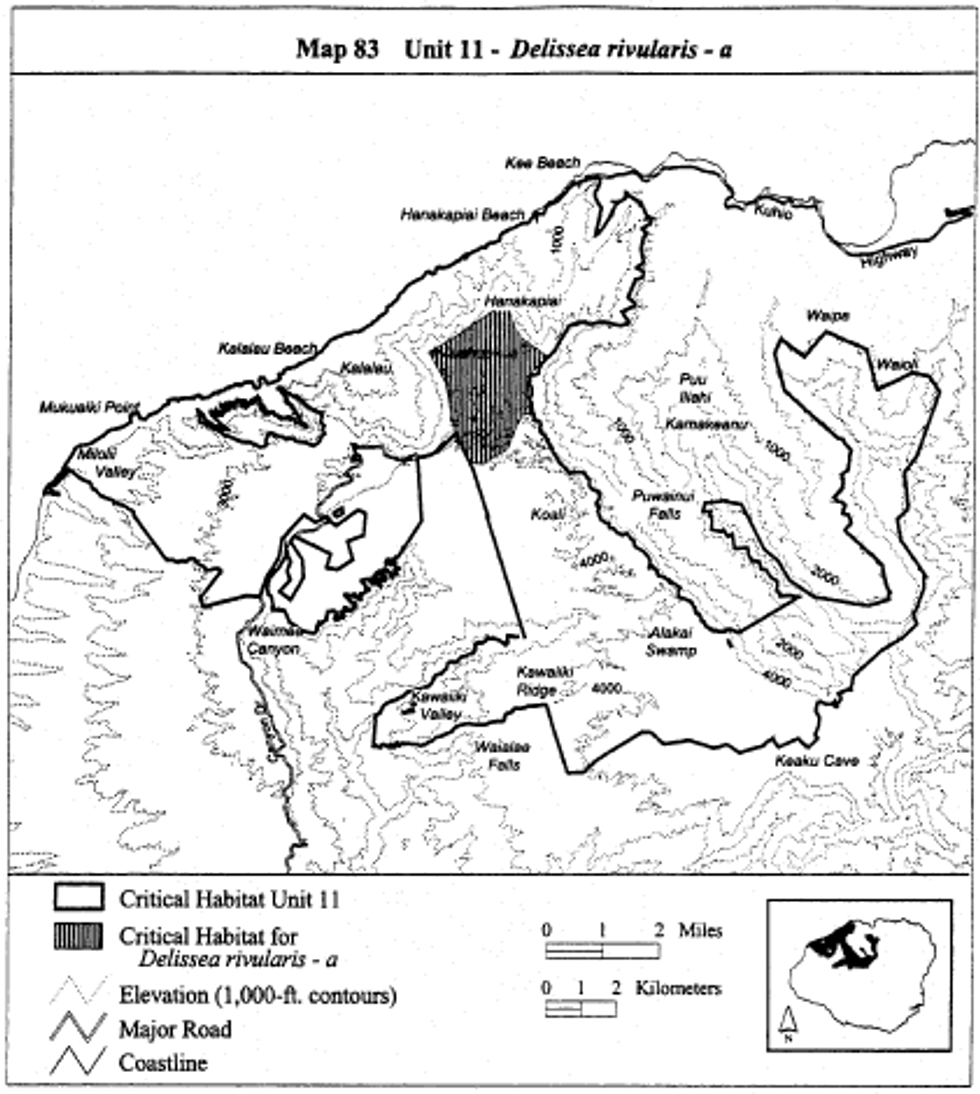
(clxix) Kauai 11 - Delissea undulata - a (257 ha; 635 ac)
(A) [Reserved]
(B) Map 84 follows:
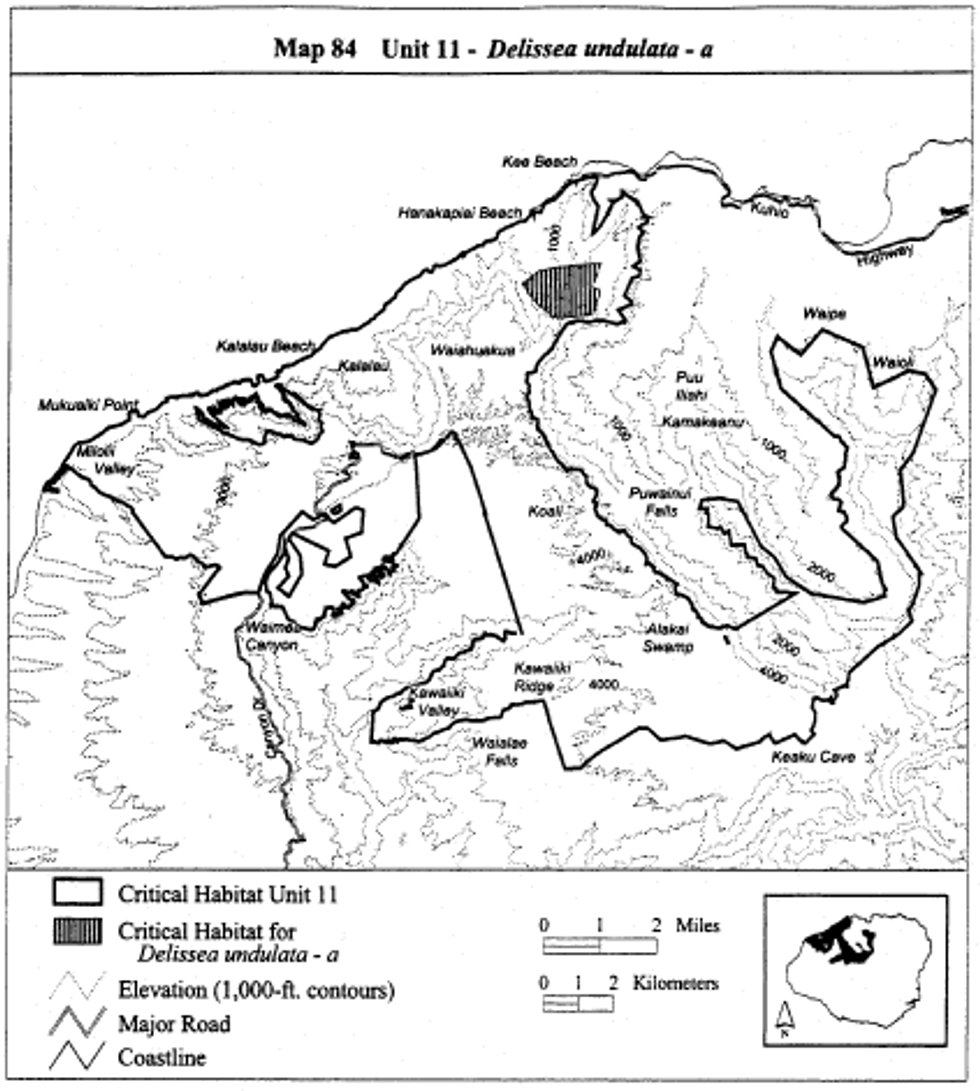
(clxx) Kauai 11 - Delissea undulata - b (532 ha; 1,314 ac)
(A) [Reserved]
(B) Map 85 follows:
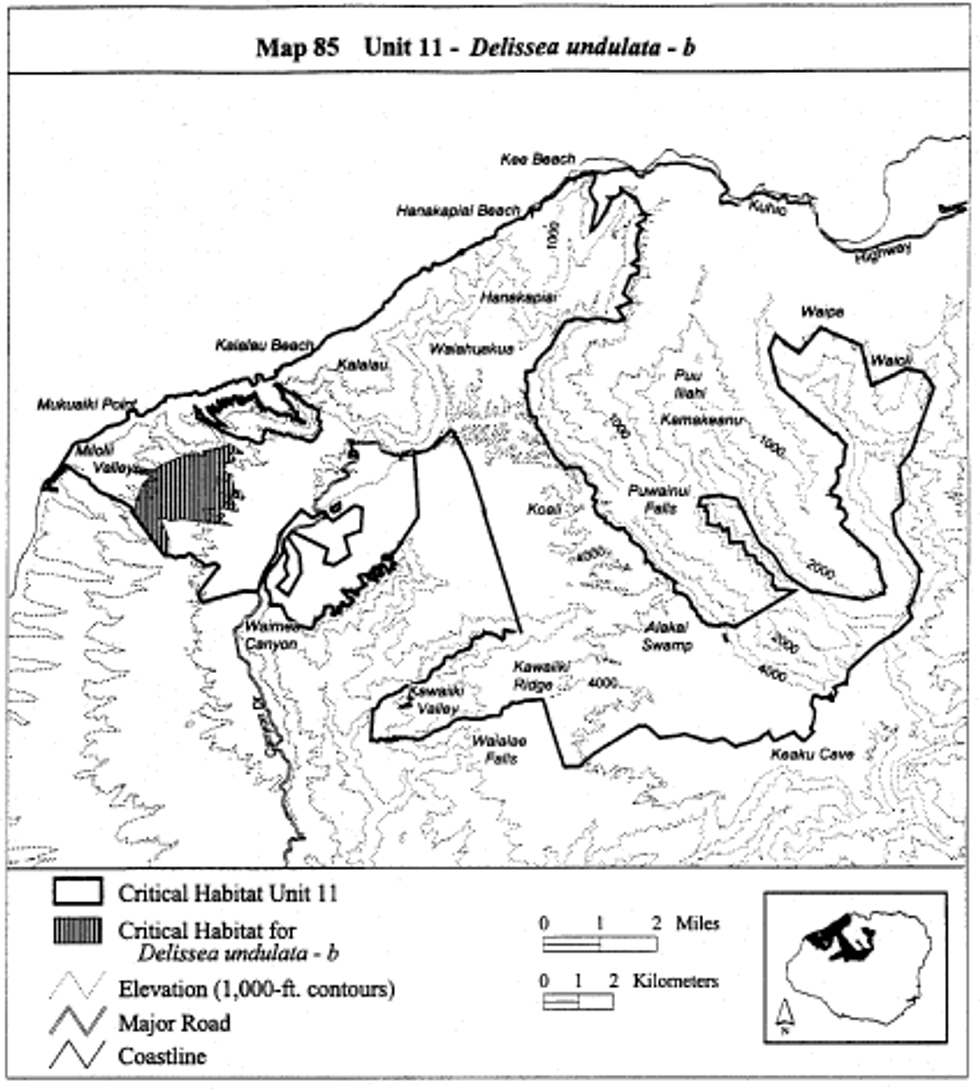
(clxxi) Kauai 11 - Asplenium dielerectum - a (364 ha; 901 ac)
(A) [Reserved]
(B) Map 86 follows:
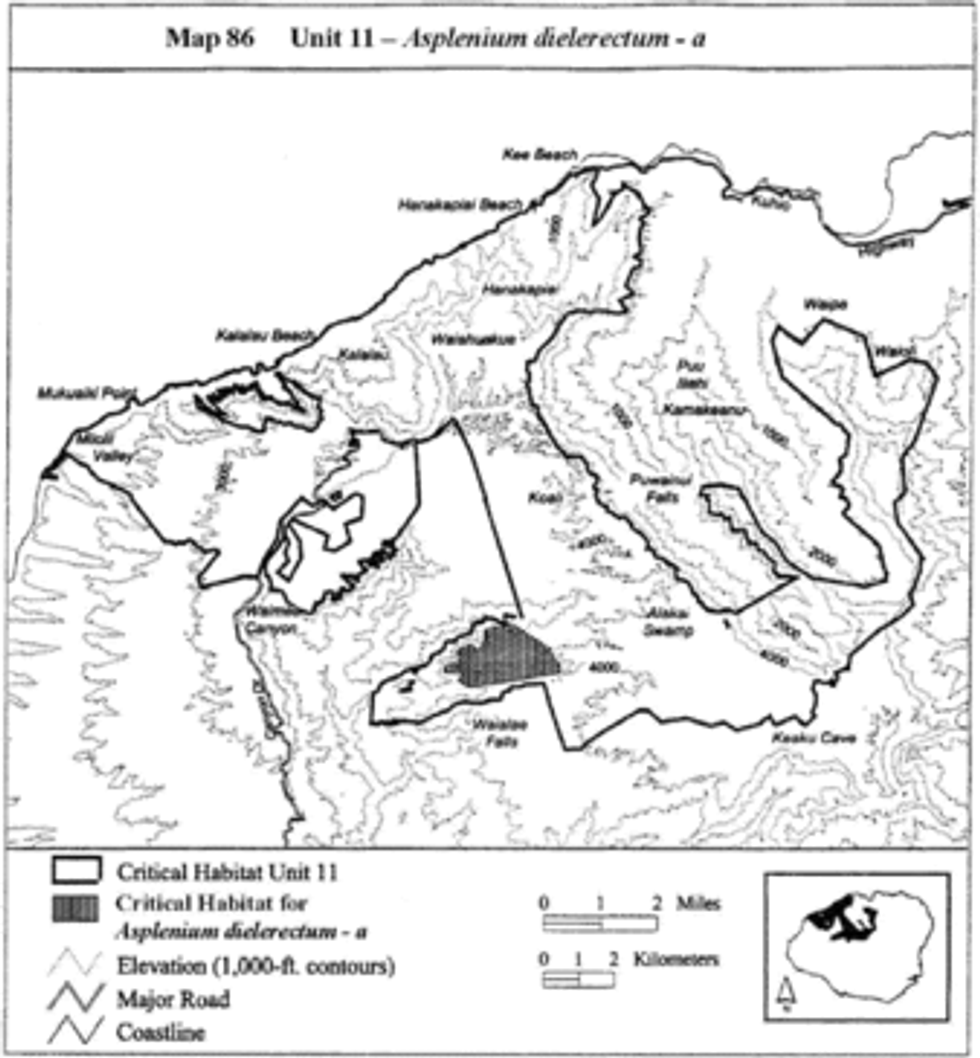
(clxxii) Kauai 11-Diellia mannii-a
(A) [Reserved]
(B) See paragraph (a)(1)(cxlvi)(B) of this section for the map of this unit.
(clxxiii) Kauai 11- Asplenium dielpallidum -a (601 ha; 1,485 ac)
(A) [Reserved]
(B) Note: The reference to �Unit 11- Diellia pallida -a� on the map is equivalent to �Kauai 11- Asplenium dielpallidum -a�. Map 87 follows:
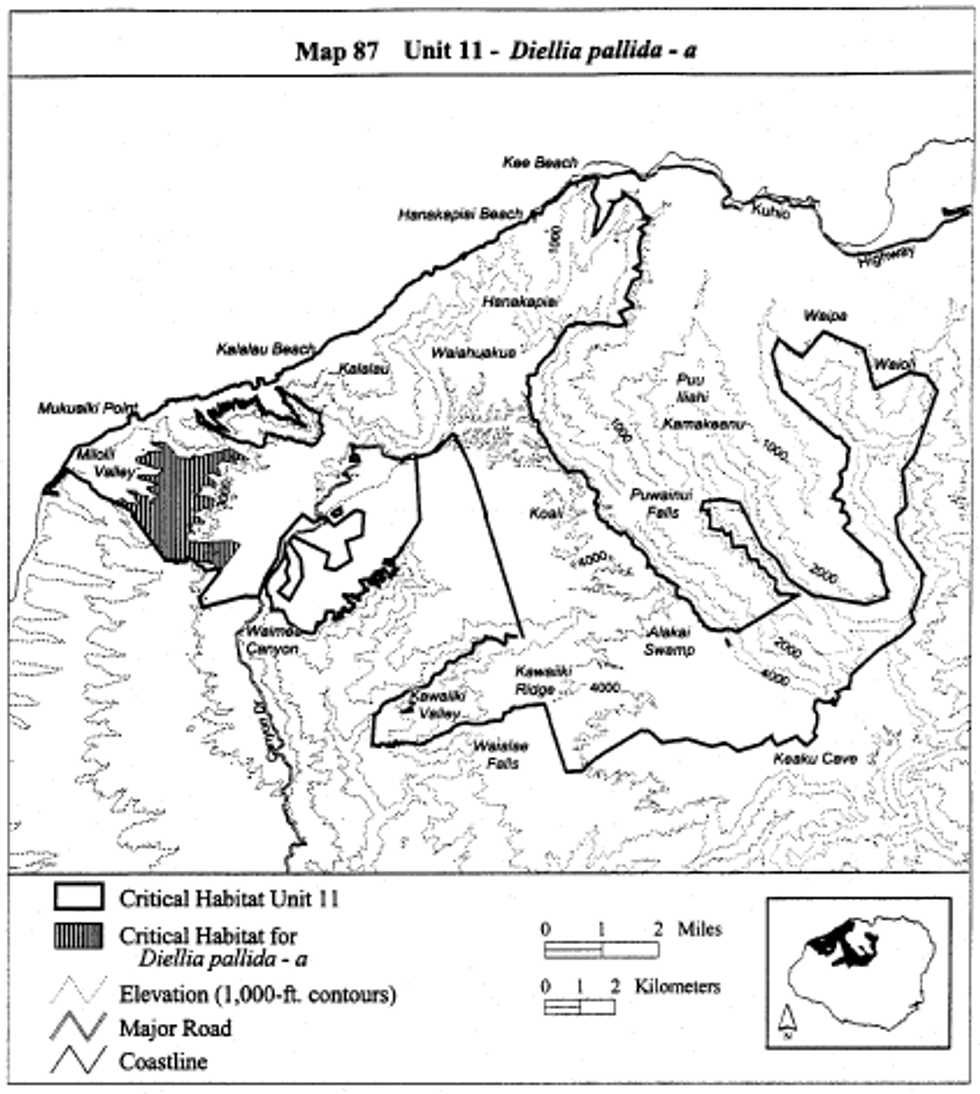
(clxxiv) Kauai 11- Asplenium dielpallidum -b (55 ha; 136 ac)
(A) [Reserved]
(B) Note: The reference to �Unit 11- Diellia pallida -b� on the map is equivalent to �Kauai 11- Asplenium dielpallidum -b�. Map 88 follows:
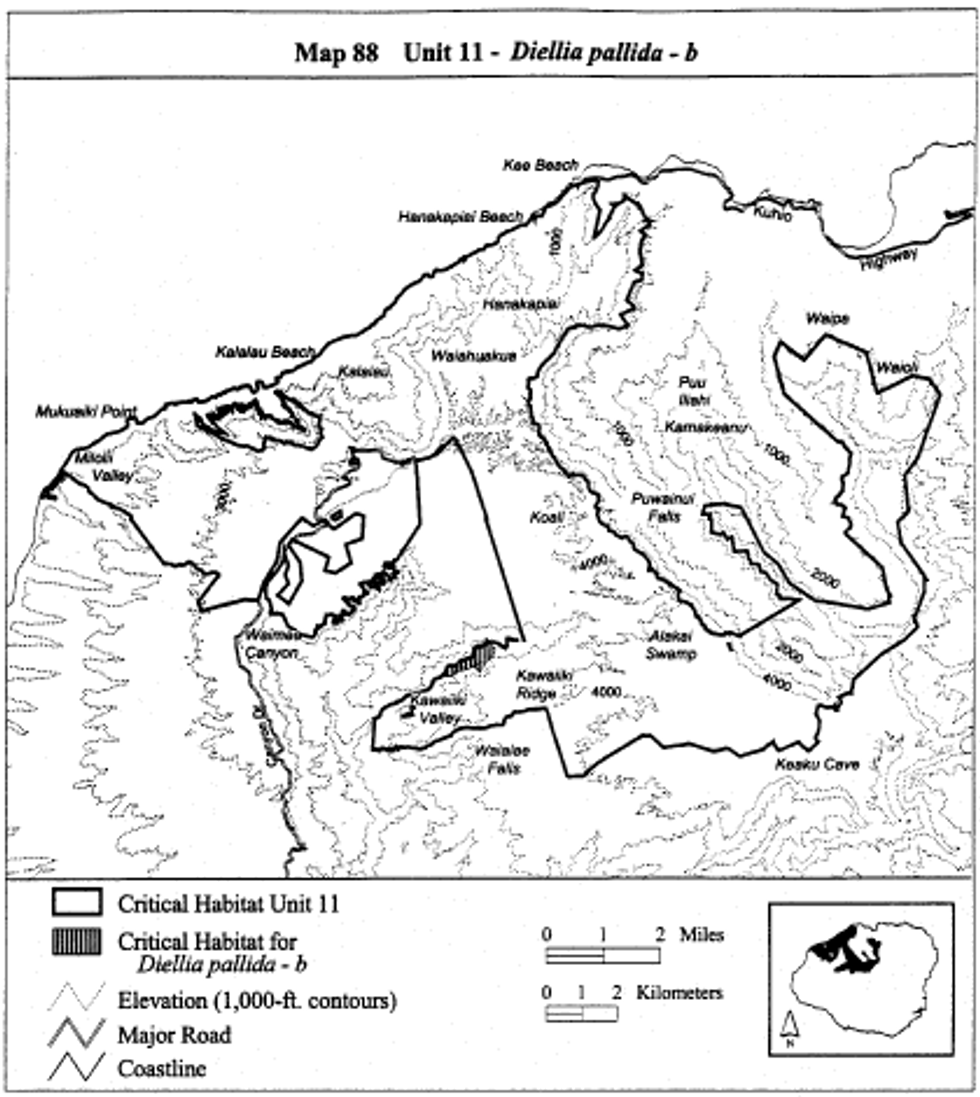
(clxxv) Kauai 11 - Diplazium molokaiense - a (430 ha; 1,062 ac)
(A) [Reserved]
(B) Map 89 follows:
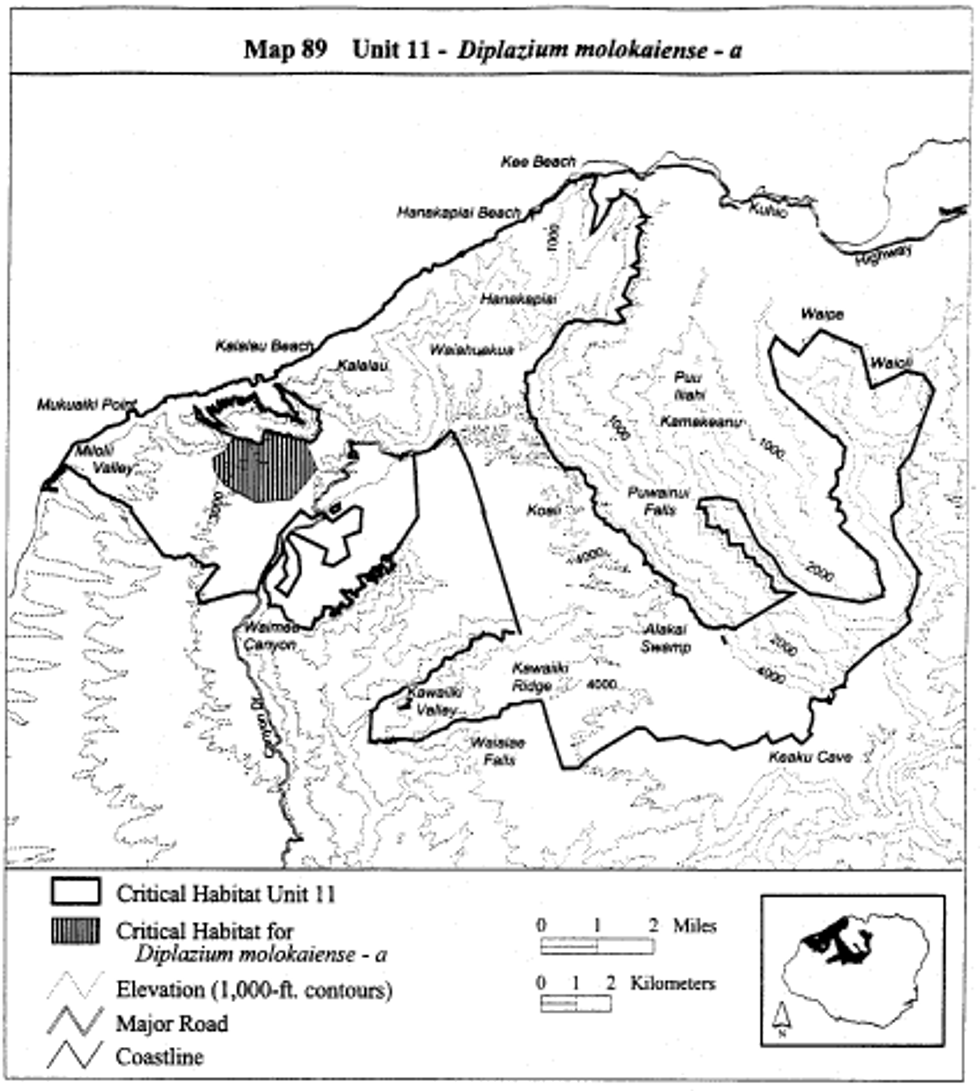
(clxxvi) Kauai 11-Doryopteris angelica-b
(A) [Reserved]
(B) See paragraph (a)(1)(cxxxiii)(B) of this section for the map of this unit.
(clxxvii) Kauai 11-Dryopteris crinalis var. podosorus-b
(A) [Reserved]
(B) See paragraph (a)(1)(cxxx)(B) of this section for the map of this unit.
(clxxviii) Kauai 11-Dubautia imbricata ssp. imbricata-b
(A) [Reserved]
(B) See paragraph (a)(1)(cxl)(B) of this section for the map of this unit.
(clxxix) Kauai 11-Dubautia kalalauensis-b
(A) [Reserved]
(B) See paragraph (a)(1)(cxxx)(B) of this section for the map of this unit.
(clxxx) Kauai 11-Dubautia kenwoodii-b
(A) [Reserved]
(B) See paragraph (a)(1)(cxxxiii)(B) of this section for the map of this unit.
(clxxxi) Kauai 11 - Dubautia latifolia - a (31 ha; 76 ac)
(A) [Reserved]
(B) Map 90 follows:
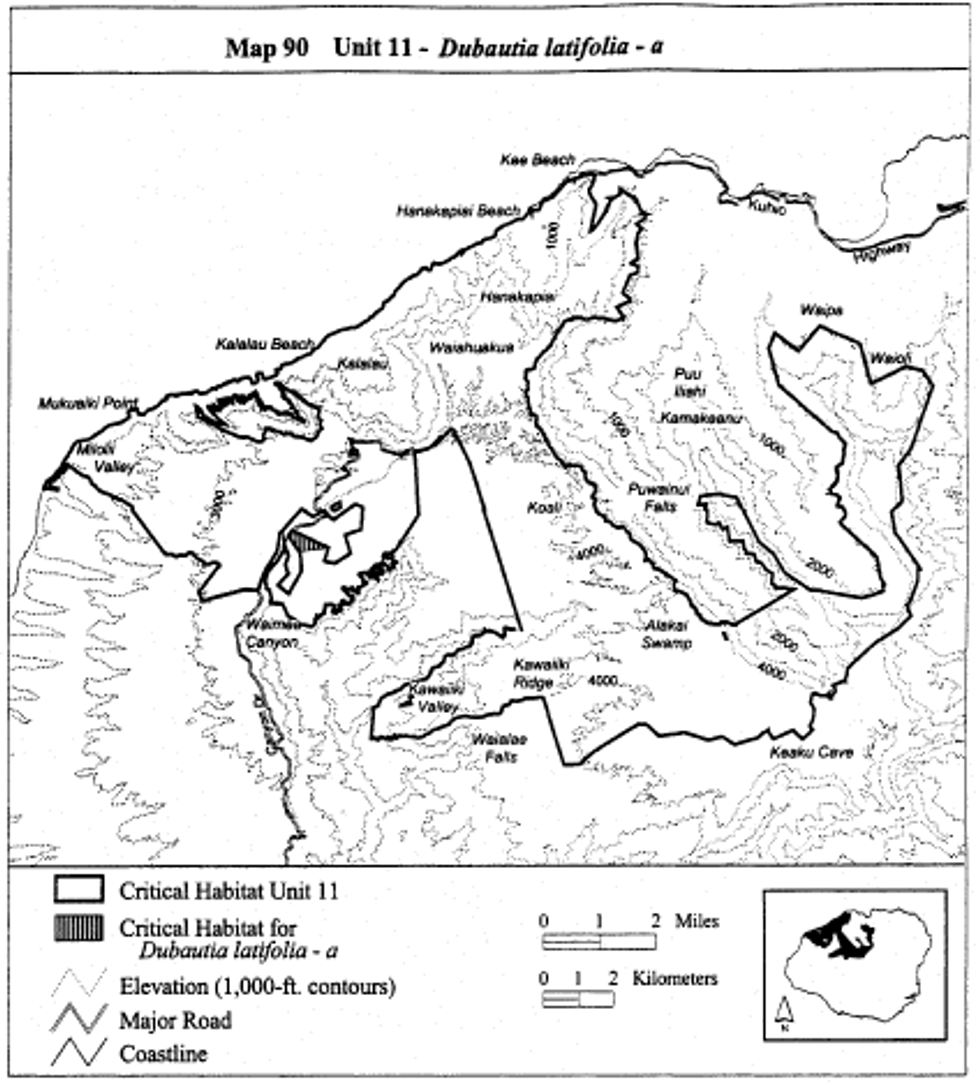
(clxxxii) Kauai 11 - Dubautia latifolia - b (1,522 ha; 3,761 ac)
(A) [Reserved]
(B) Excluding 1 area bounded by the following 4 points (3 ha, 8 ac): Start at 433109, 2447775; 432932, 2447668; 432827, 2447751; 433094, 2447922; return to starting point.
(C) Map 91 follows:
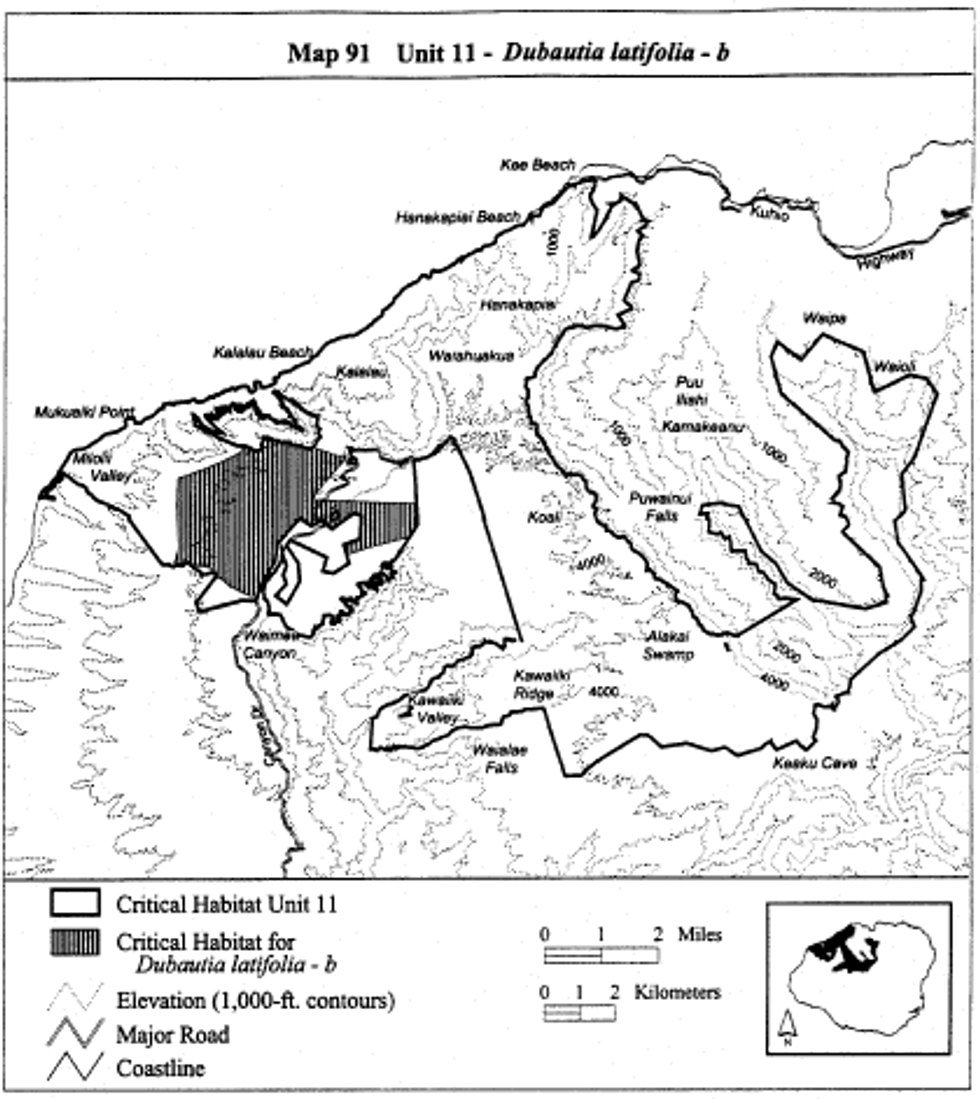
(clxxxiii) Kauai 11 - Dubautia latifolia - c (809 ha; 1,999 ac)
(A) [Reserved]
(B) Map 92 follows:
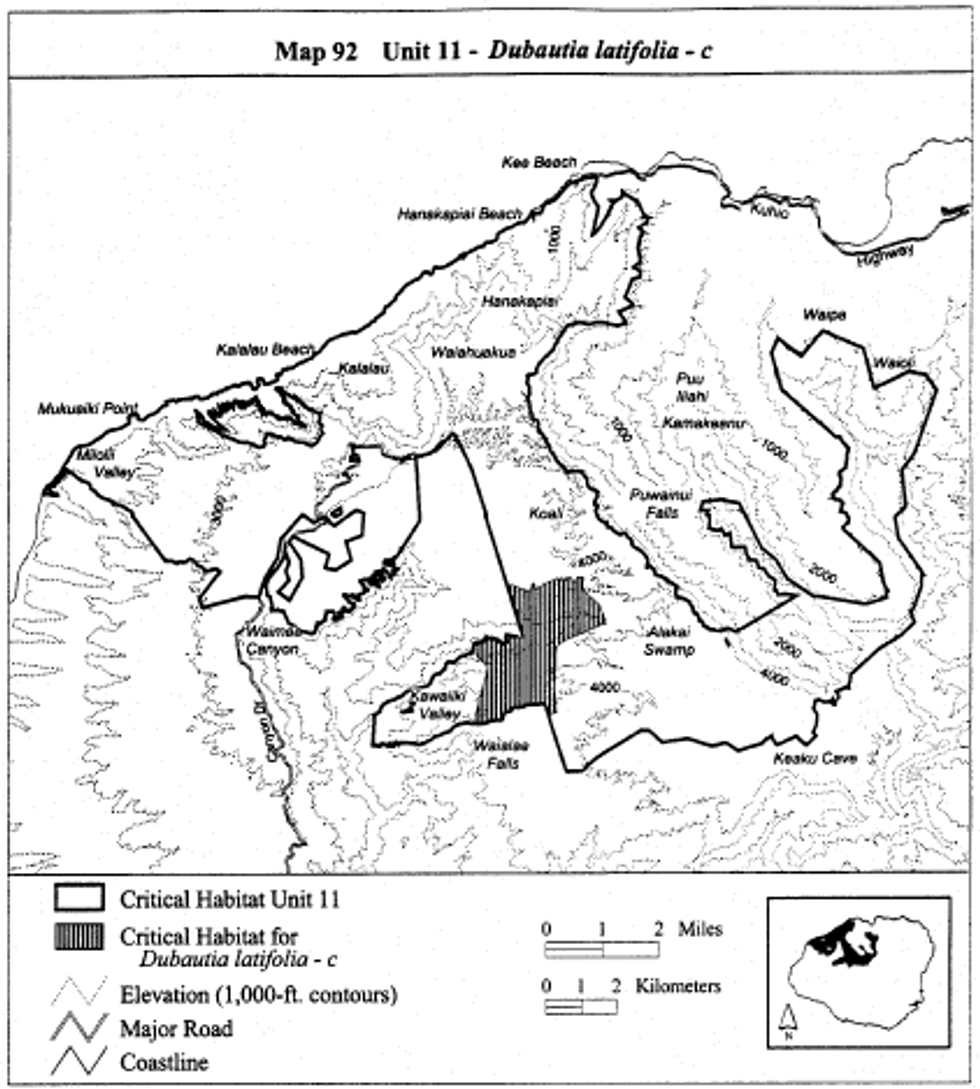
(clxxxiv) Kauai 11-Dubautia plantaginea ssp. magnifolia-c
(A) [Reserved]
(B) See paragraph (a)(1)(cxli)(B) of this section for the map of this unit.
(clxxxv) Kauai 11-Dubautia waialealae-b
(A) [Reserved]
(B) See paragraph (a)(1)(cxxx)(B) of this section for the map of this unit.
(clxxxvi) Kauai 11 - Euphorbia haeleeleana - a (263 ha; 649 ac)
(A) [Reserved]
(B) Map 93 follows:
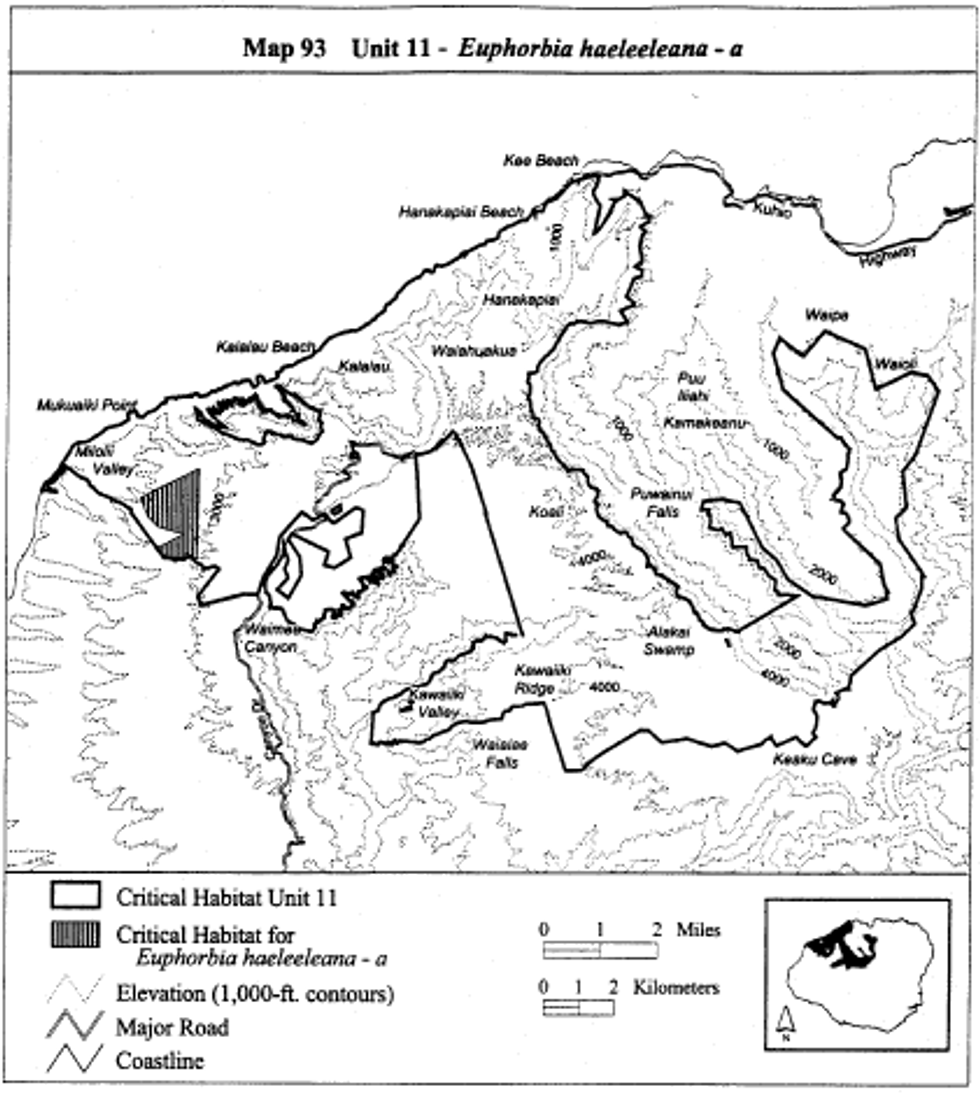
(clxxxvii) Kauai 11 - Euphorbia haeleeleana - b (192 ha; 476 ac)
(A) [Reserved]
(B) Map 94 follows:
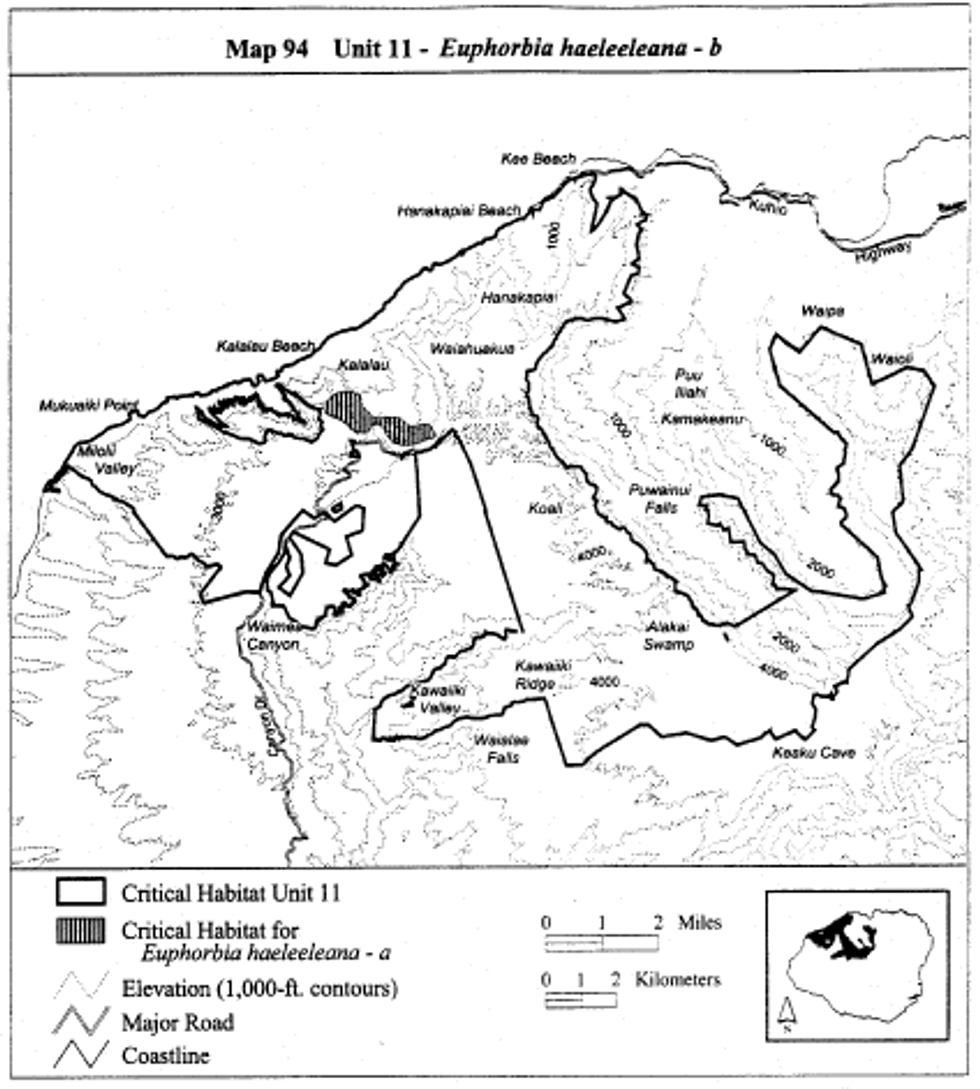
(clxxxviii) Kauai 11 - Euphorbia haeleeleana - c (204 ha; 505 ac)
(A) [Reserved]
(B) Excluding 1 area bounded by the following 4 points (0 ha, 1 ac): Start at 435151, 2442425; 435215, 2442393; 435195, 2442353; 435128, 2442379; return to starting point.
(C) Map 95 follows:
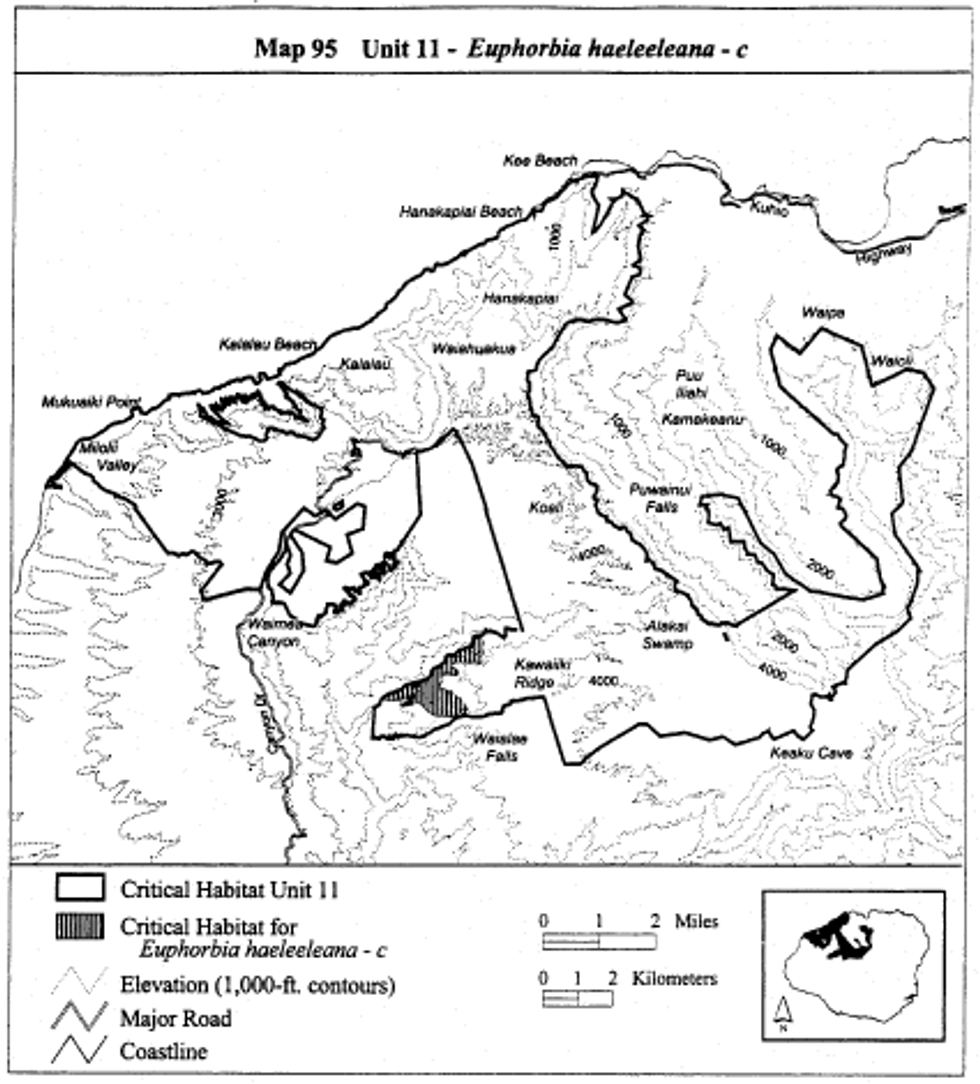
(clxxxix) Kauai 11 - Exocarpos luteolus - b (3,799 ha; 9,387 ac)
(A) [Reserved]
(B) Map 96 follows:
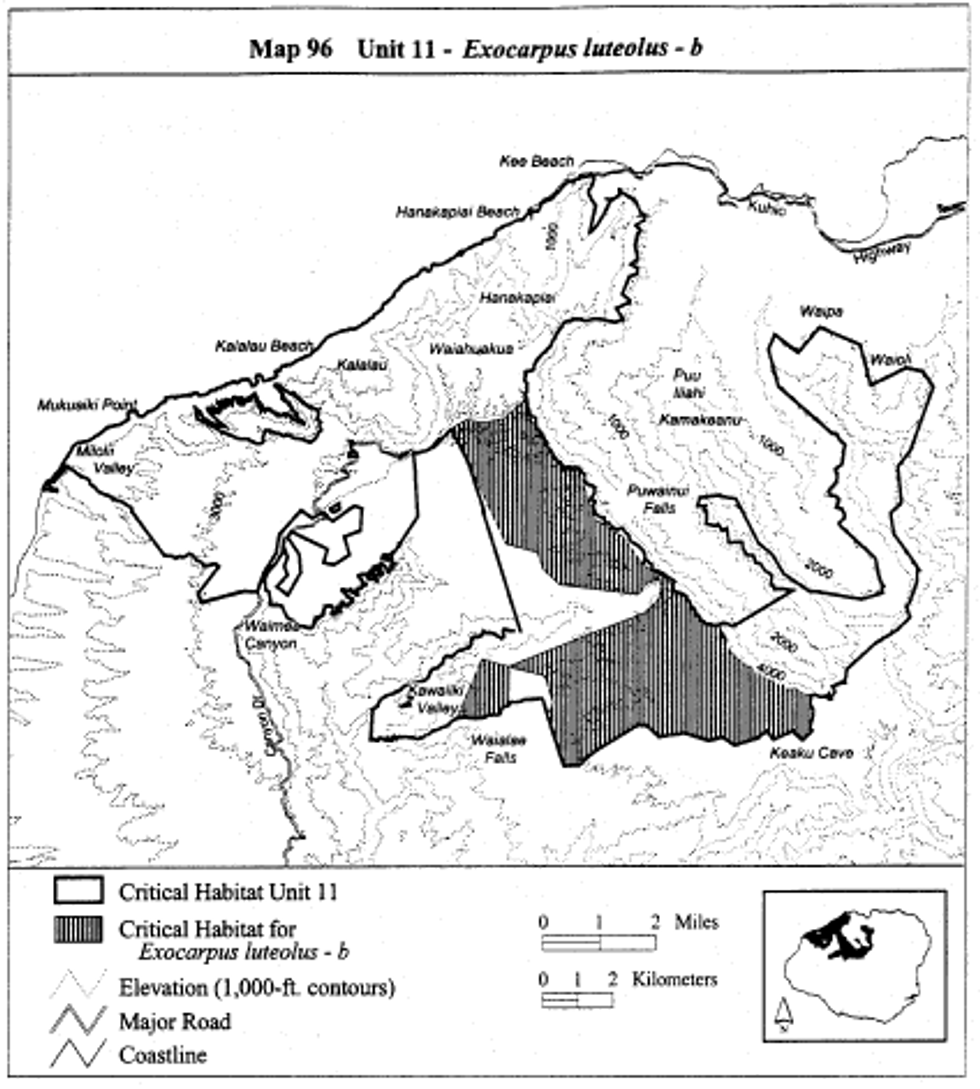
(cxc) Kauai 11 - Exocarpos luteolus - c (177 ha; 438 ac)
(A) [Reserved]
(B) Map 97 follows:
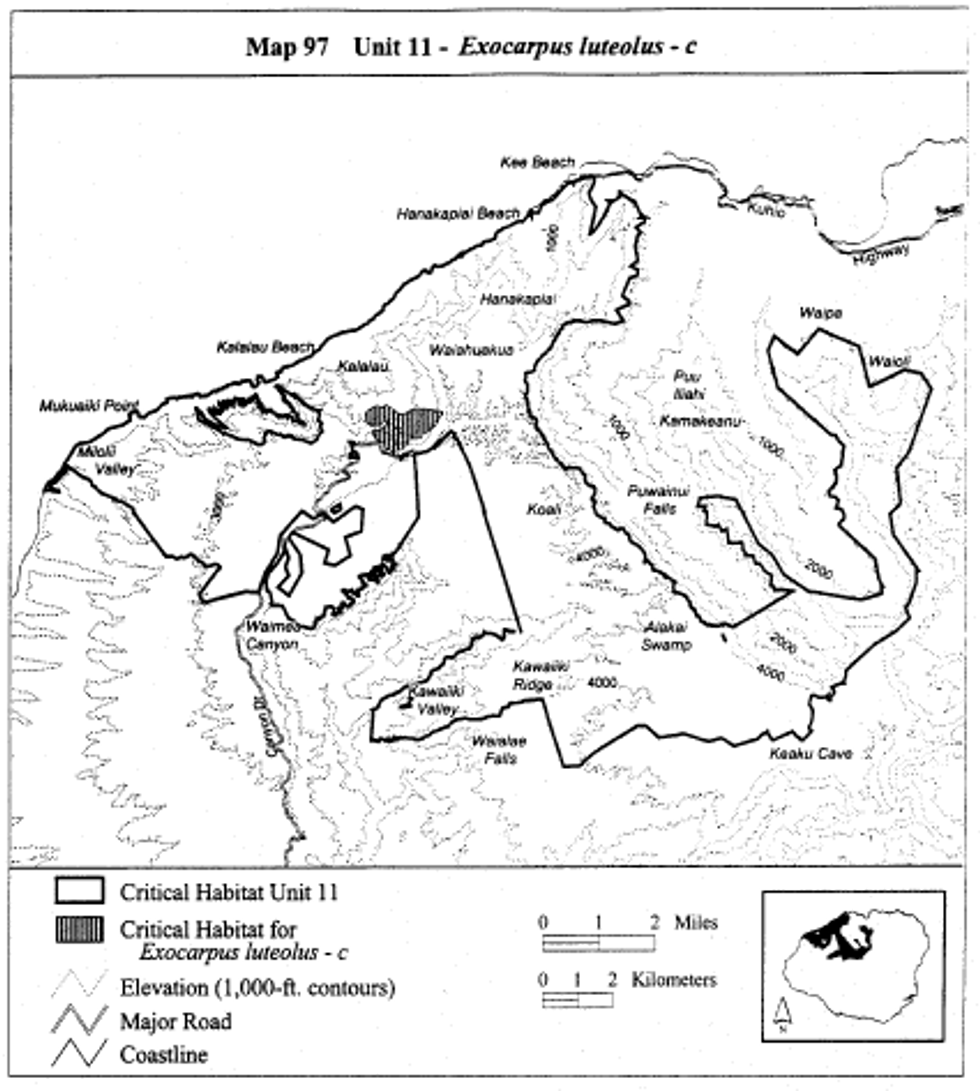
(cxci) Kauai 11 - Exocarpos luteolus - d (83 ha; 206 ac)
(A) [Reserved]
(B) Map 98 follows:
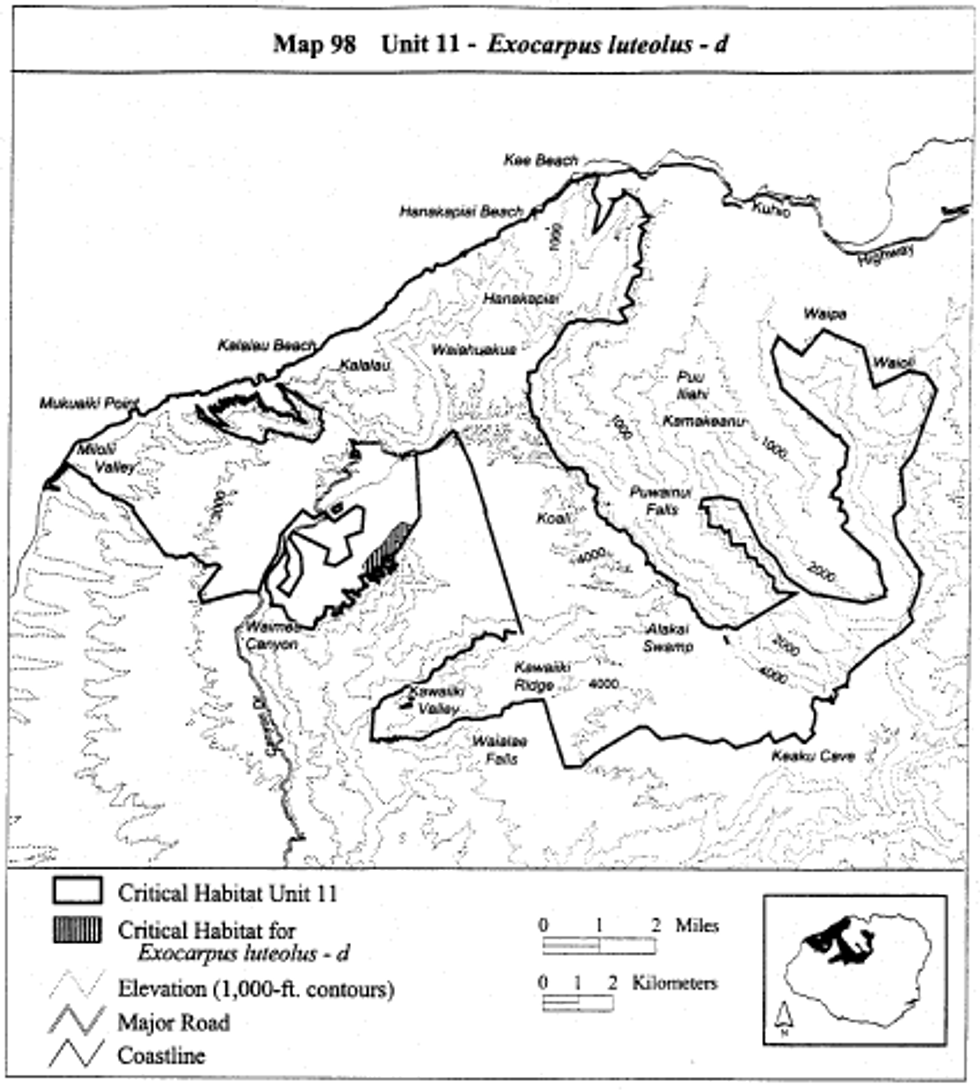
(cxcii) Kauai 11 - Exocarpos luteolus - e (523 ha; 1,290 ac)
(A) [Reserved]
(B) Excluding 1 area bounded by the following 10 points (3 ha, 8 ac): Start at 433368, 2449292; 433367, 2449352; 433448, 2449426; 433546, 2449412; 433567, 2449398; 433589, 2449323; 433612, 2449262; 433588, 2449244; 433567, 2449260; 433369, 2449255; return to starting point.
(C) Map 99 follows:
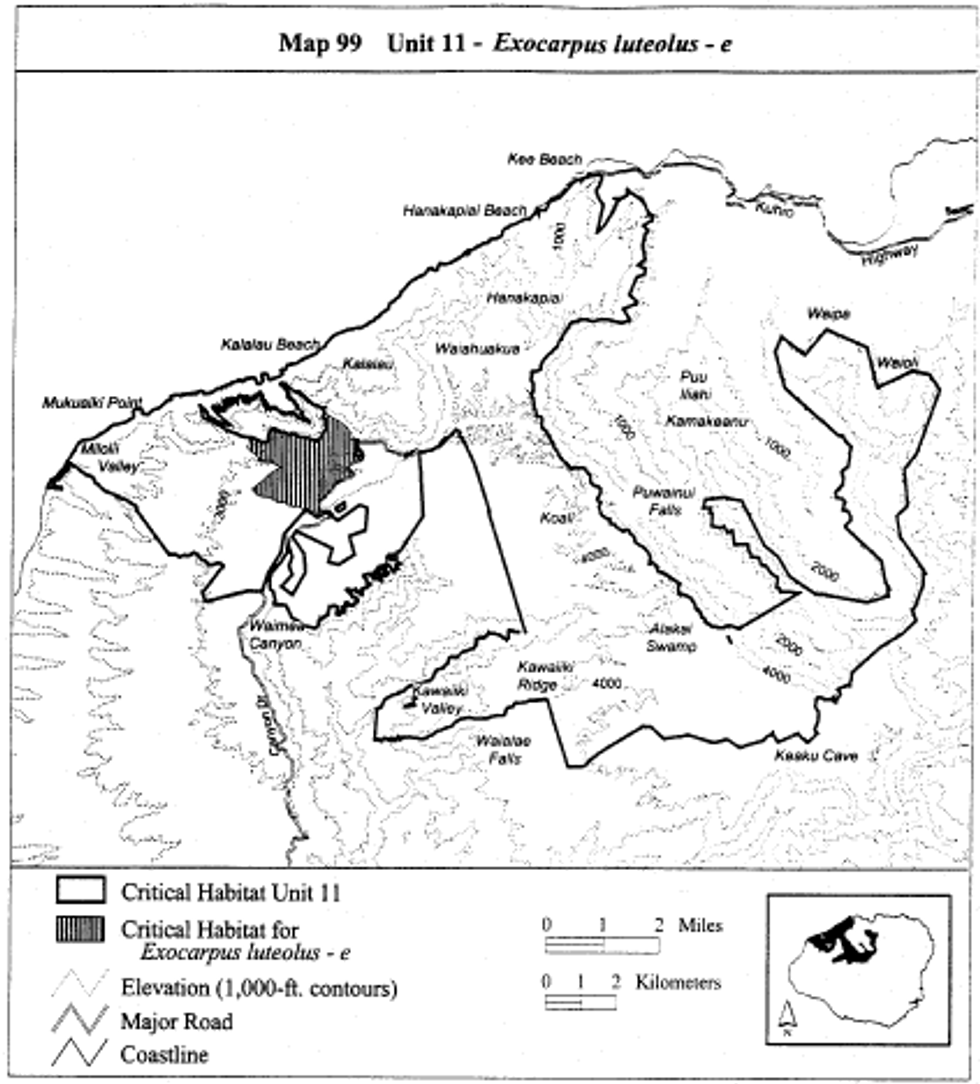
(cxciii) Kauai 11 - Flueggea neowawraea - a (51 ha; 126 ac)
(A) [Reserved]
(B) Map 100 follows:
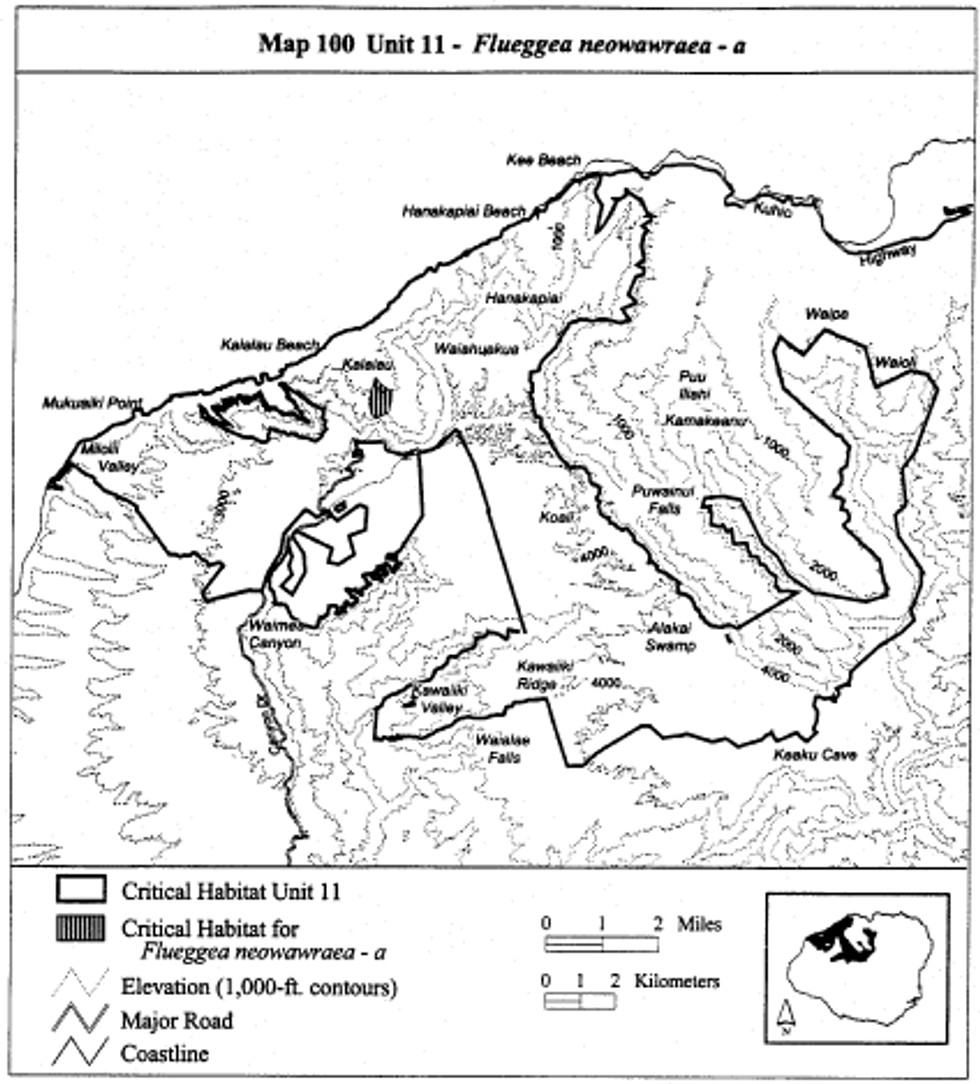
(cxciv) Kauai 11 - Flueggea neowawraea - b (47 ha; 117 ac)
(A) [Reserved]
(B) Map 101 follows:
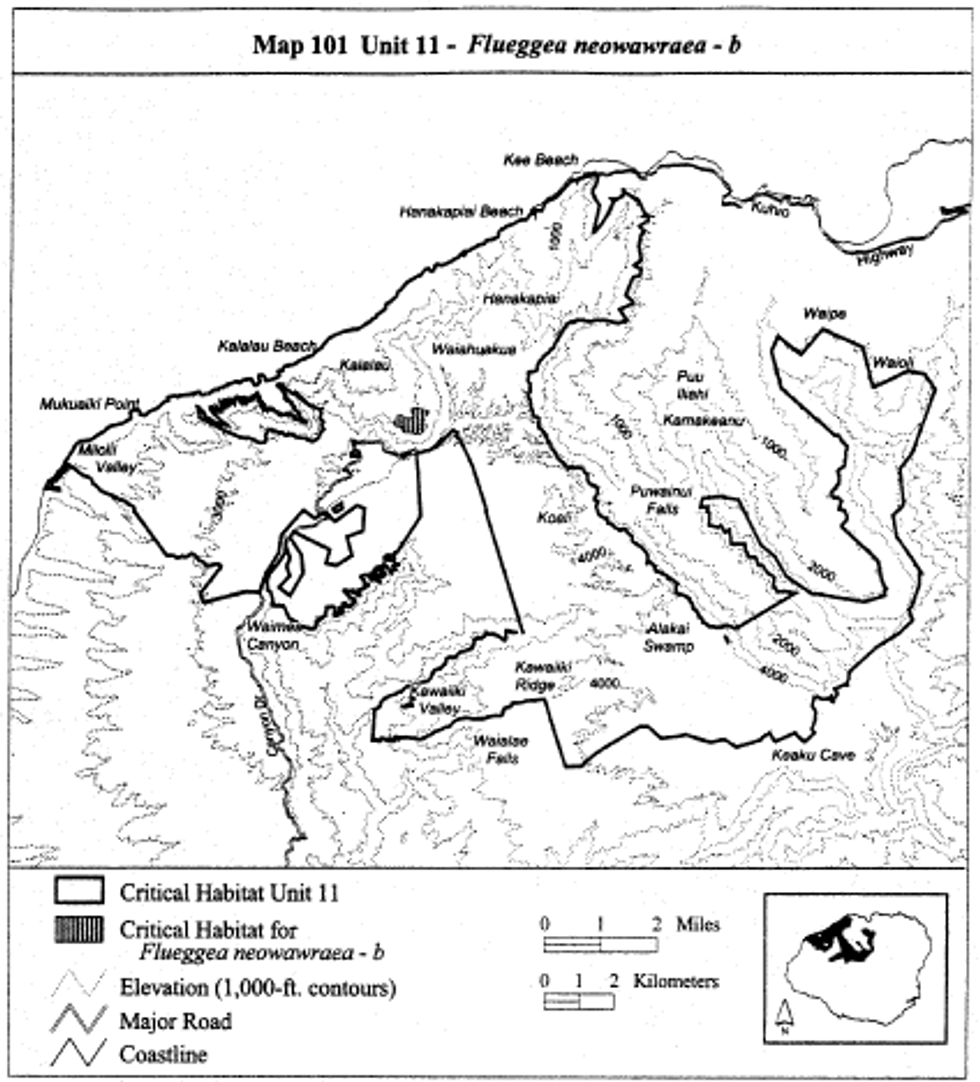
(cxcv) Kauai 11 - Flueggea neowawraea - c (152 ha; 376 ac)
(A) [Reserved]
(B) Map 102 follows:
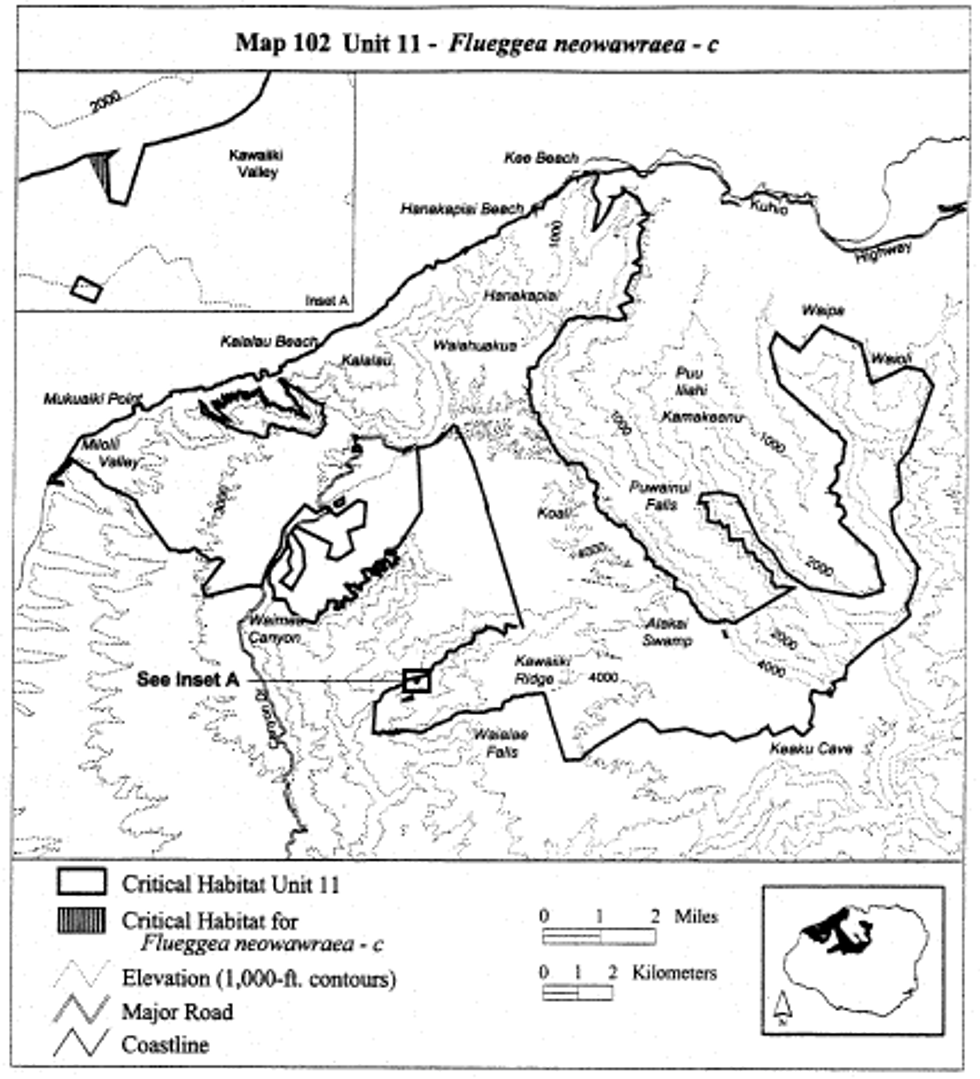
(cxcvi) Kauai 11 - Flueggea neowawraea - d (77 ha; 191 ac)
(A) [Reserved]
(B) Map 103 follows:
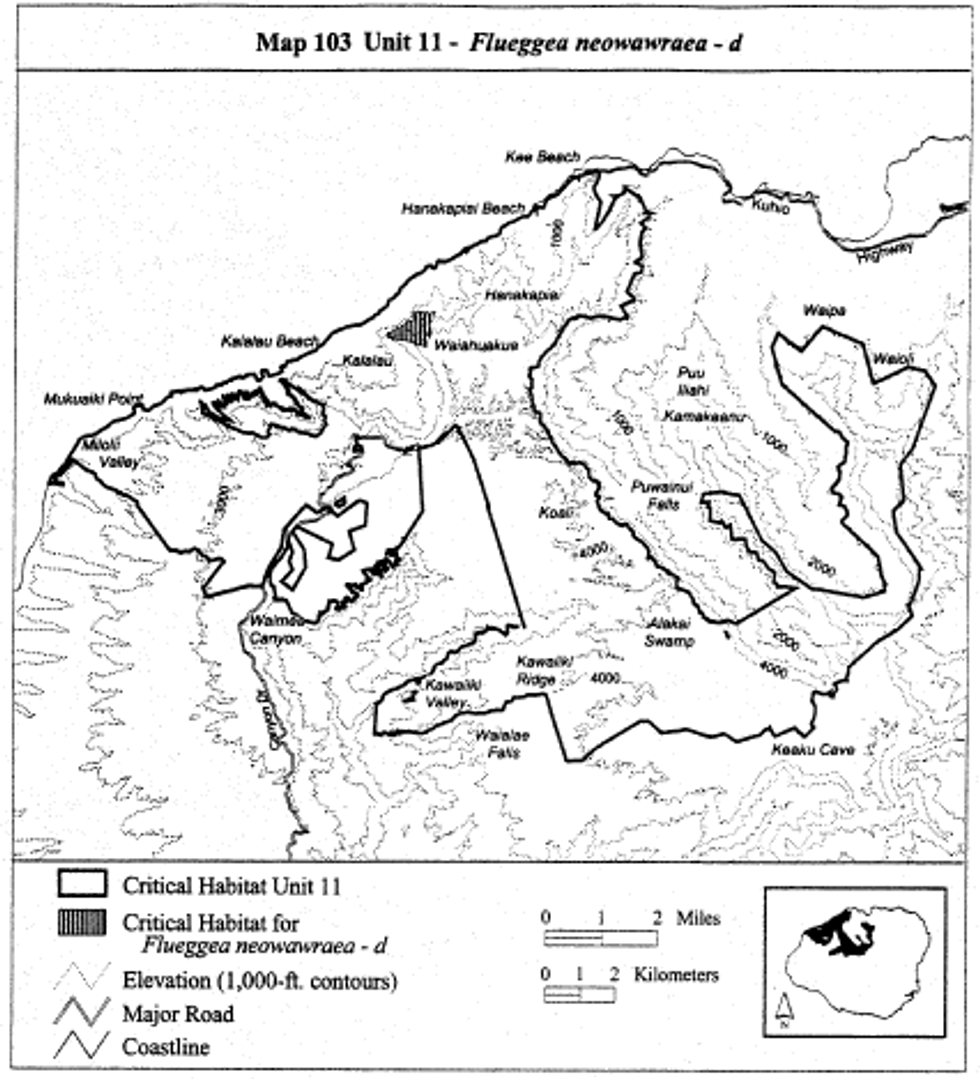
(cxcvii) Kauai 11 - Flueggea neowawraea - e (27 ha; 67 ac)
(A) [Reserved]
(B) Map 104 follows:
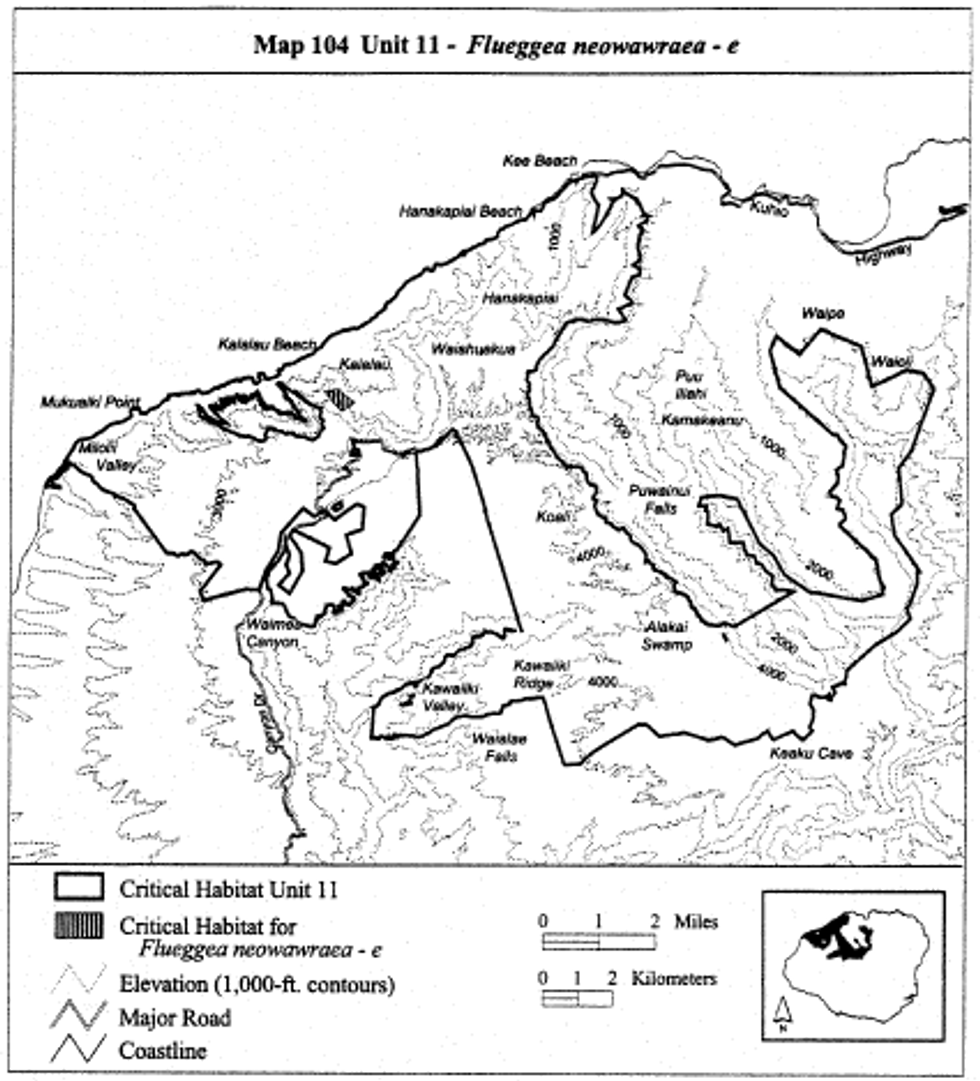
(cxcviii) Kauai 11 - Flueggea neowawraea - f (240 ha; 594 ac)
(A) [Reserved]
(B) Map 105 follows:
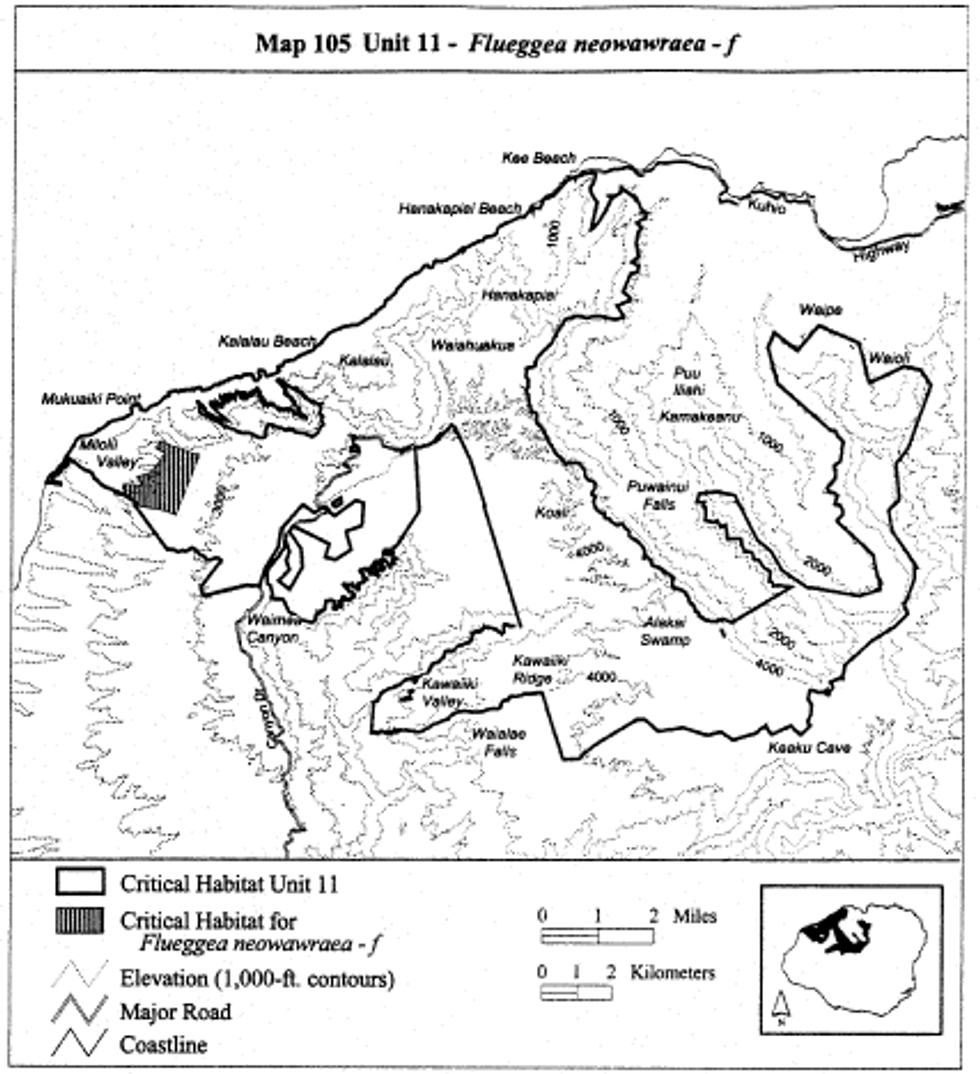
(cxcix) Kauai 11-Geranium kauaiense-b
(A) [Reserved]
(B) See paragraph (a)(1)(cxxx)(B) of this section for the map of this unit.
(cc) Kauai 11 - Gouania meyenii - a (443 ha; 1,094 ac)
(A) [Reserved]
(B) Map 106 follows:
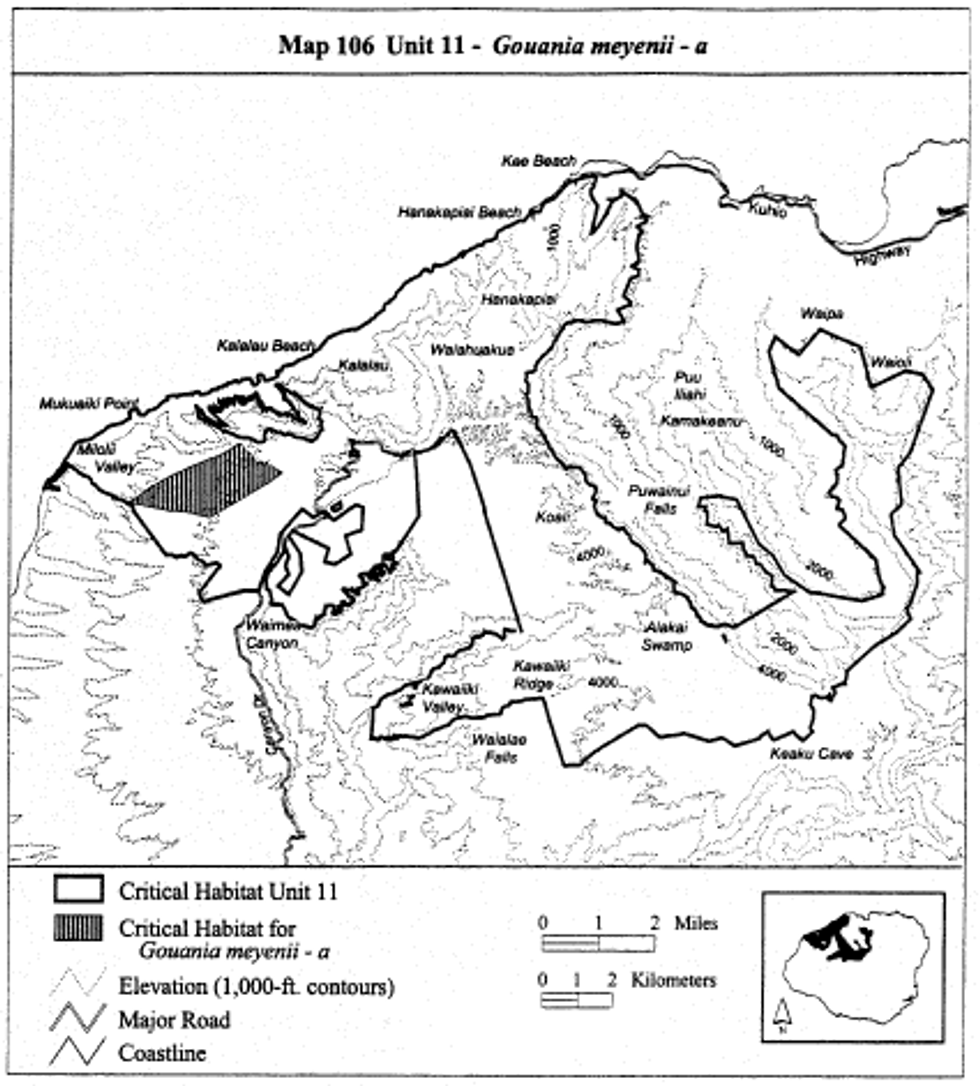
(cci) Kauai 11 - Gouania meyenii - b (128 ha; 316 ac)
(A) [Reserved]
(B) Map 107 follows:
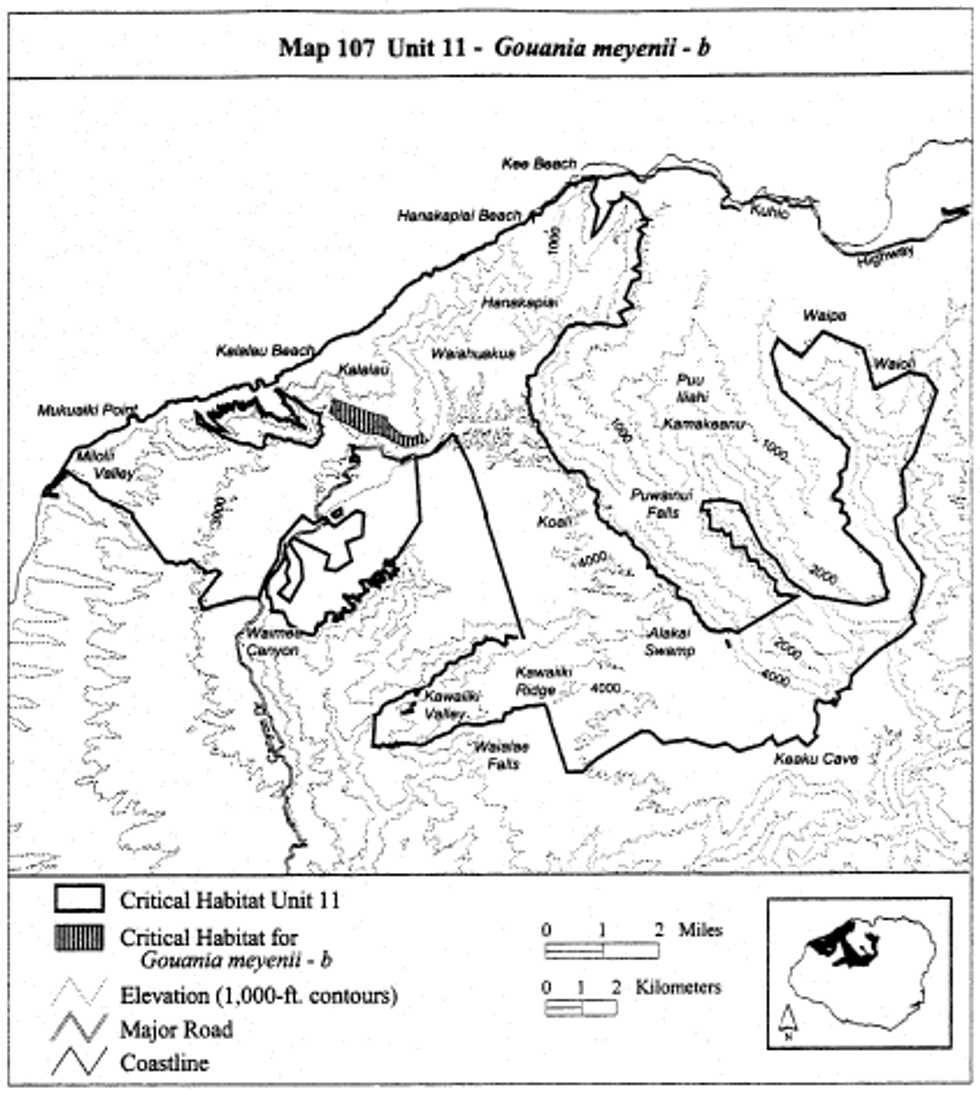
(ccii) Kauai 11 - Gouania meyenii - c (215 ha; 532 ac)
(A) [Reserved]
(B) Map 108 follows:
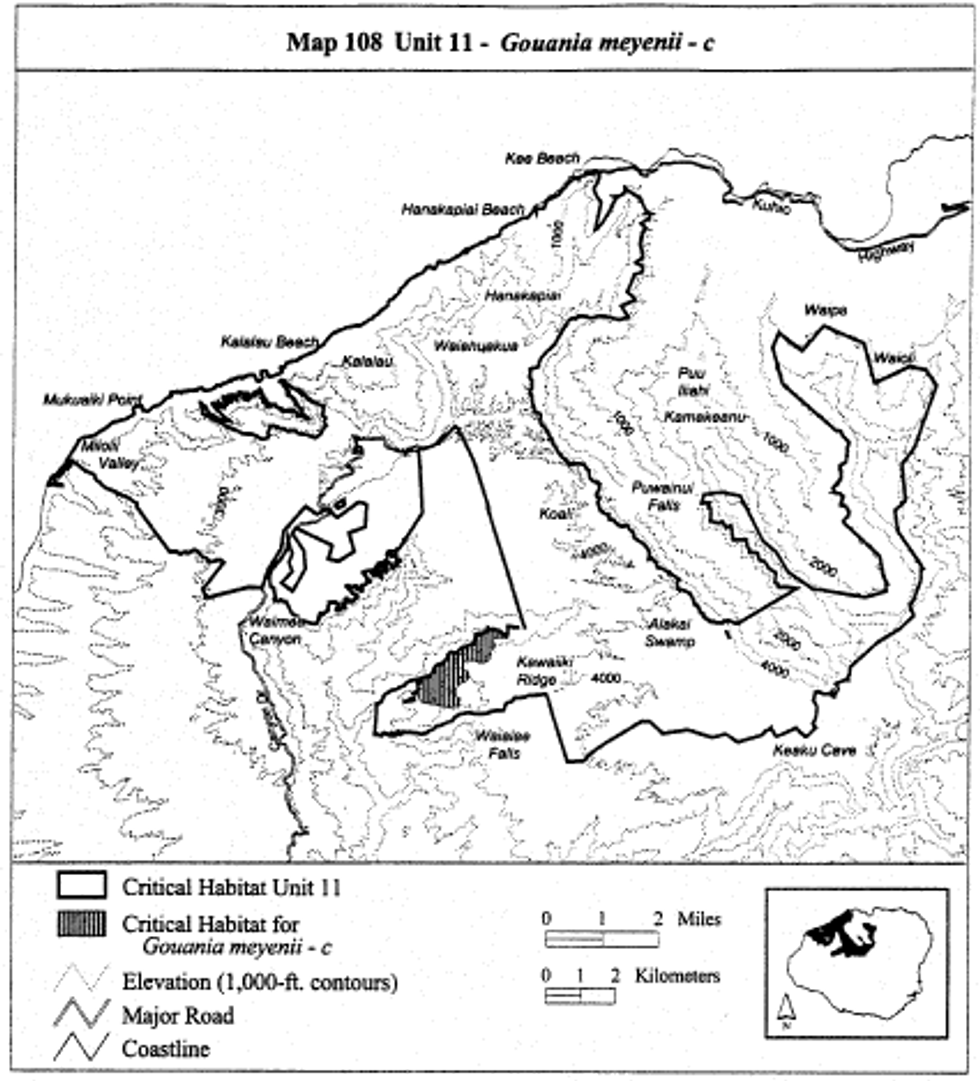
(cciii) Kauai 11- Kadua cookiana -a (771 ha; 1,905 ac)
(A) [Reserved]
(B) Note: The reference to �Unit 11- Hedyotis cookiana -a� on the map is equivalent to �Kauai 11- Kadua cookiana -a�. Map 109 follows:
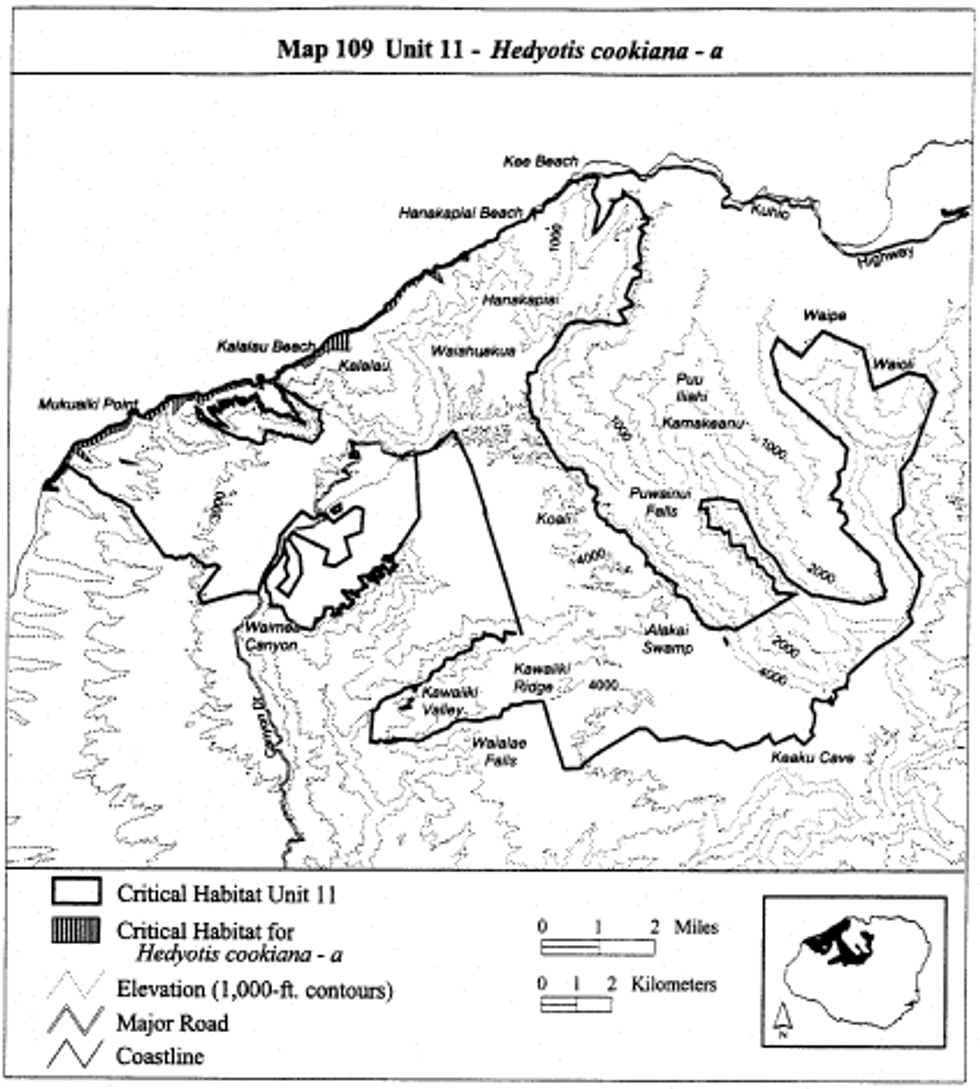
(cciv) Kauai 11 - Hedyotis st. johnii - a (240 ha; 593 ac)
(A) [Reserved]
(B) Map 110 follows:
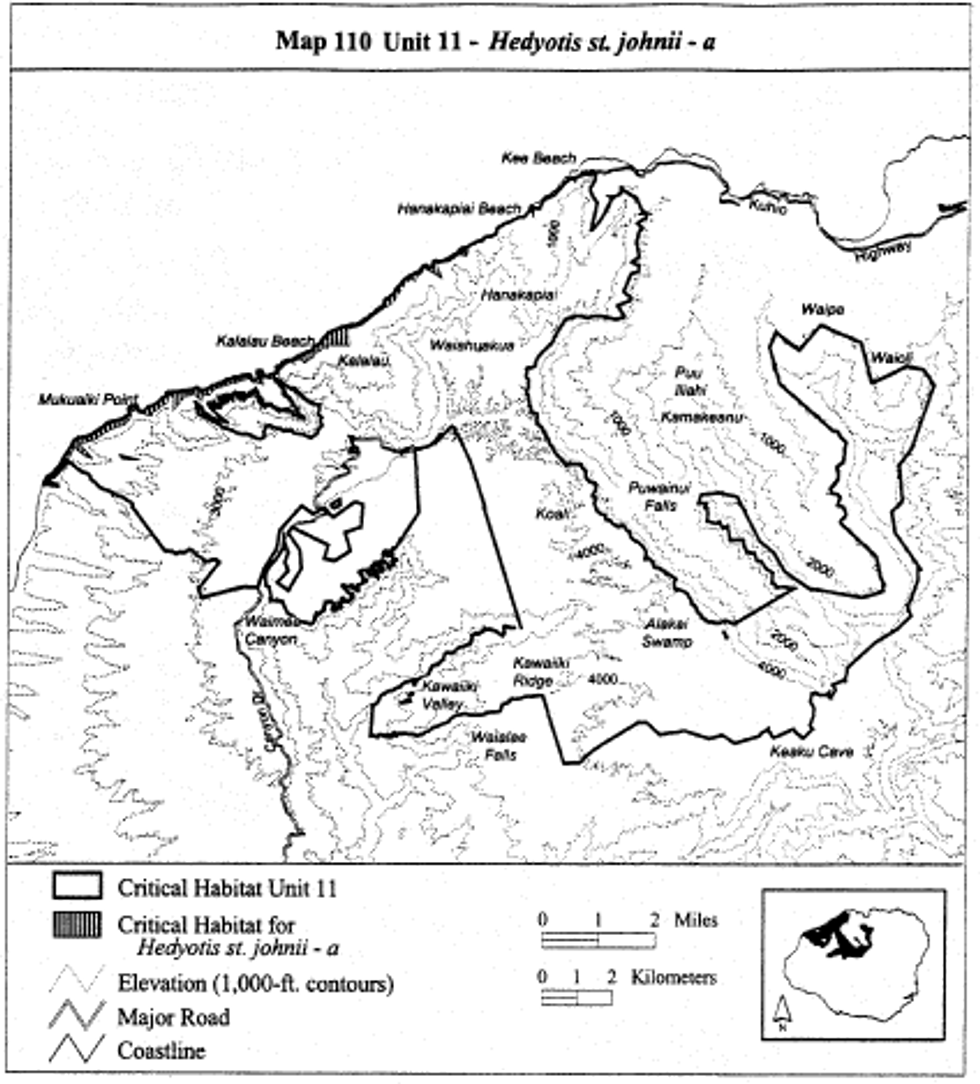
(ccv) Kauai 11 - Hesperomannia lydgatei - b (913 ha; 2,257 ac)
(A) [Reserved]
(B) Map 111 follows:
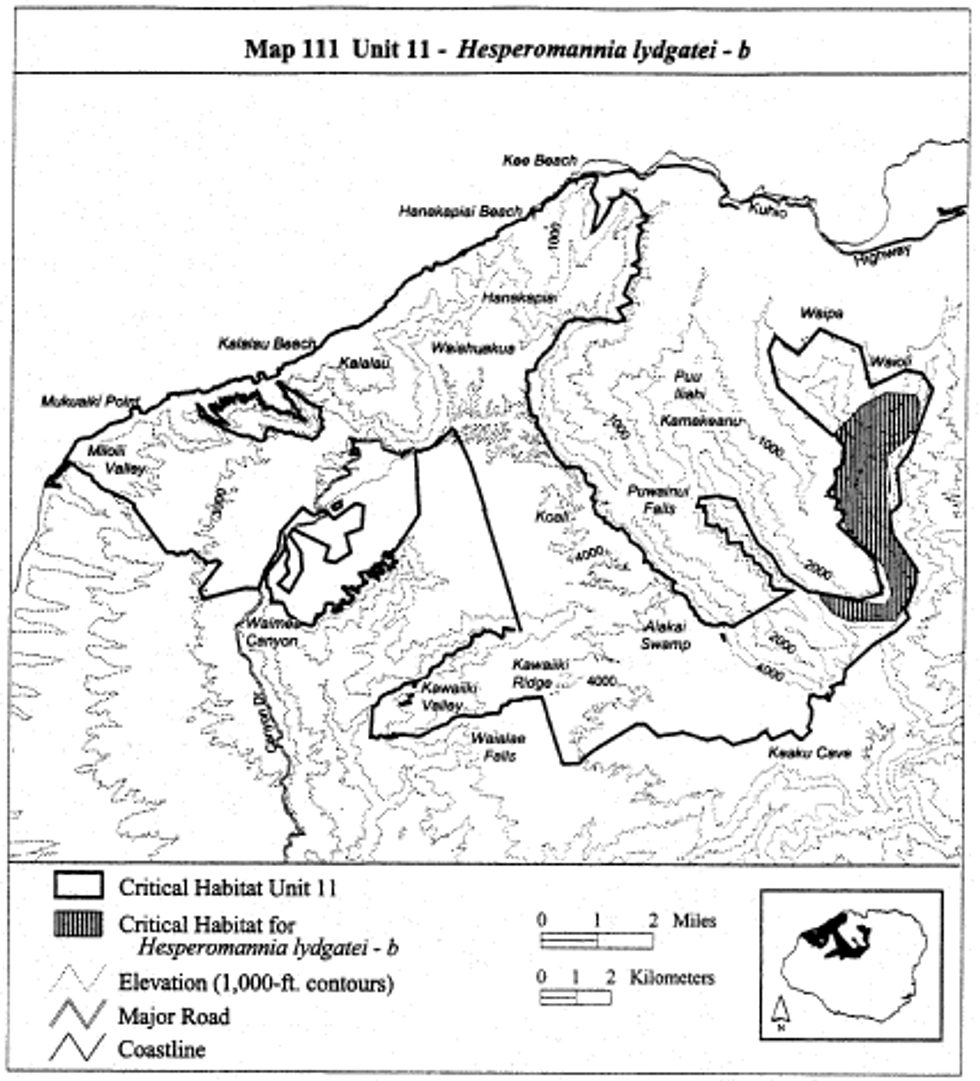
(ccvi) Kauai 11 - Hesperomannia lydgatei - c (180 ha; 444 ac)
(A) [Reserved]
(B) Map 112 follows:
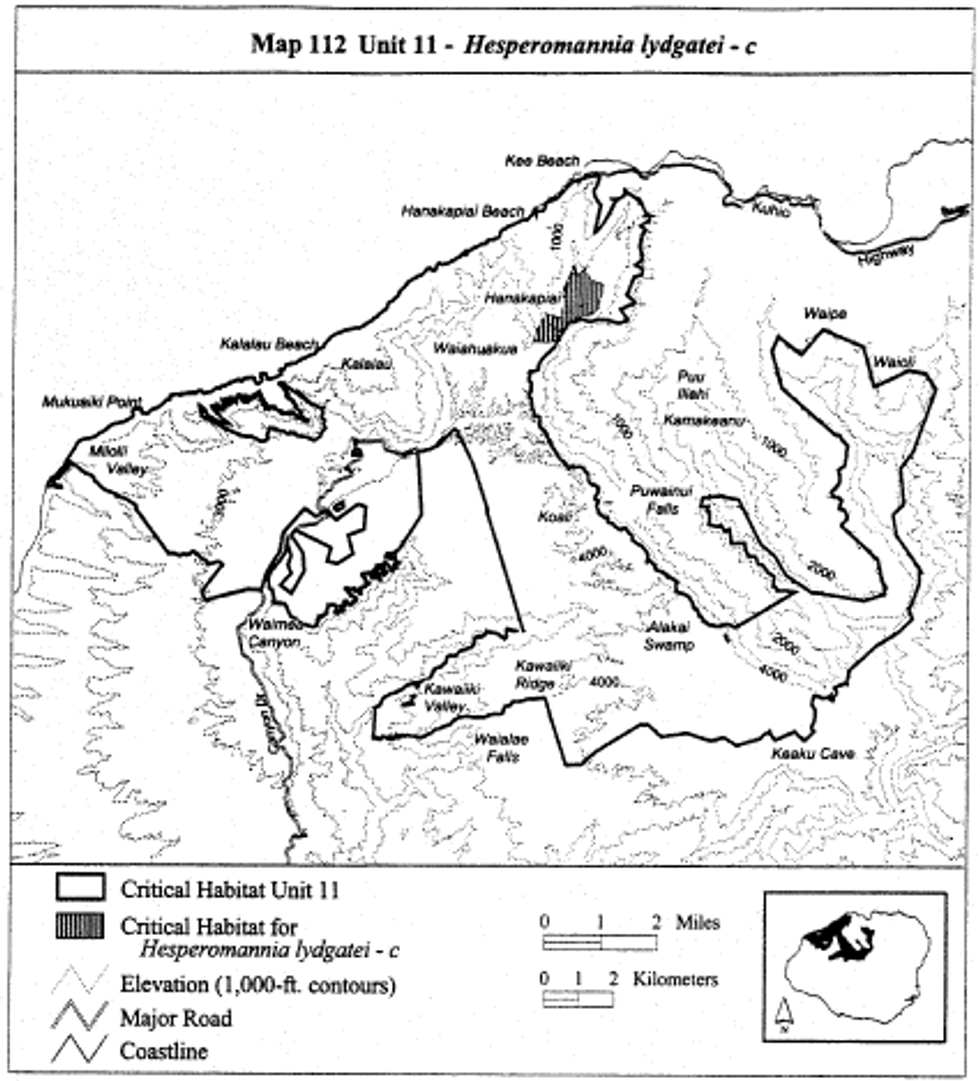
(ccvii) Kauai 11 - Hibiscadelphus woodii - a (278 ha; 686 ac)
(A) [Reserved]
(B) Map 113 follows:
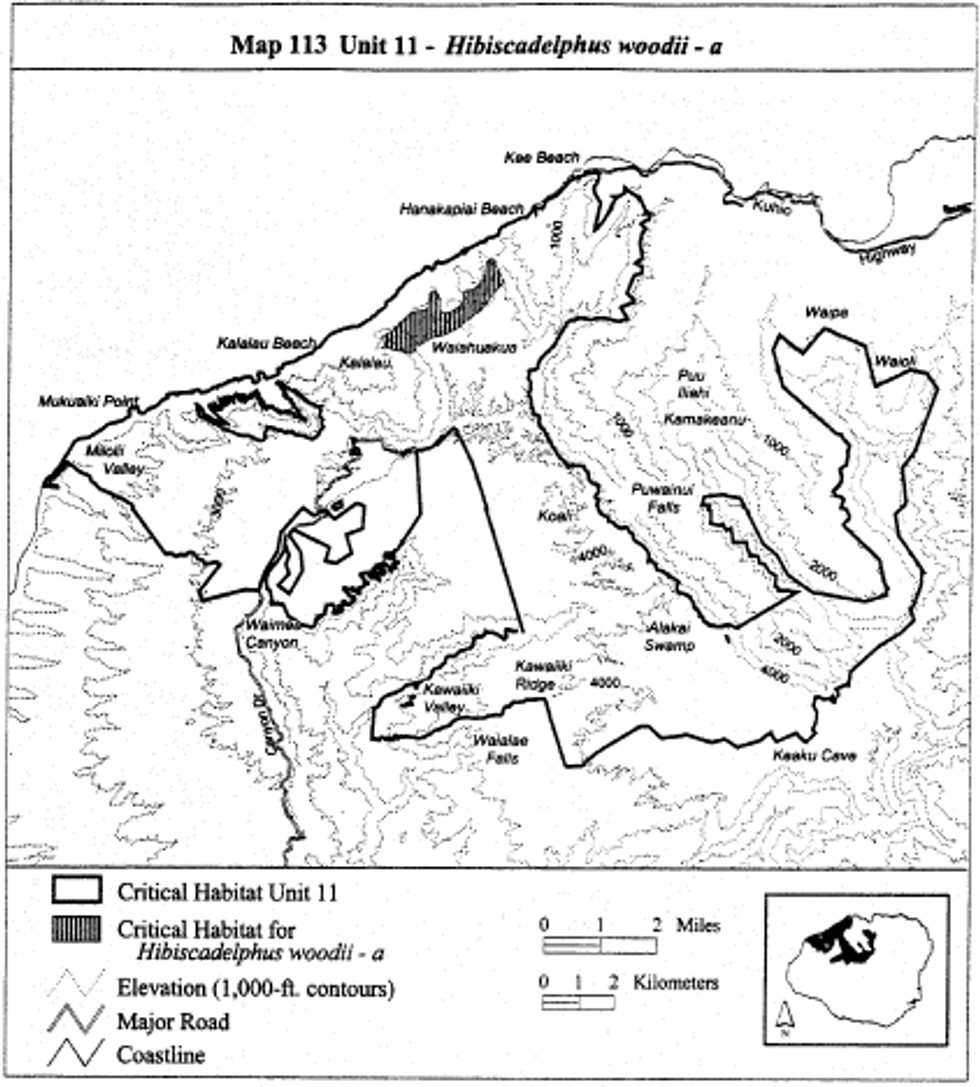
(ccviii) Kauai 11 - Hibiscadelphus woodii - b (72 ha; 177 ac)
(A) [Reserved]
(B) Map 114 follows:
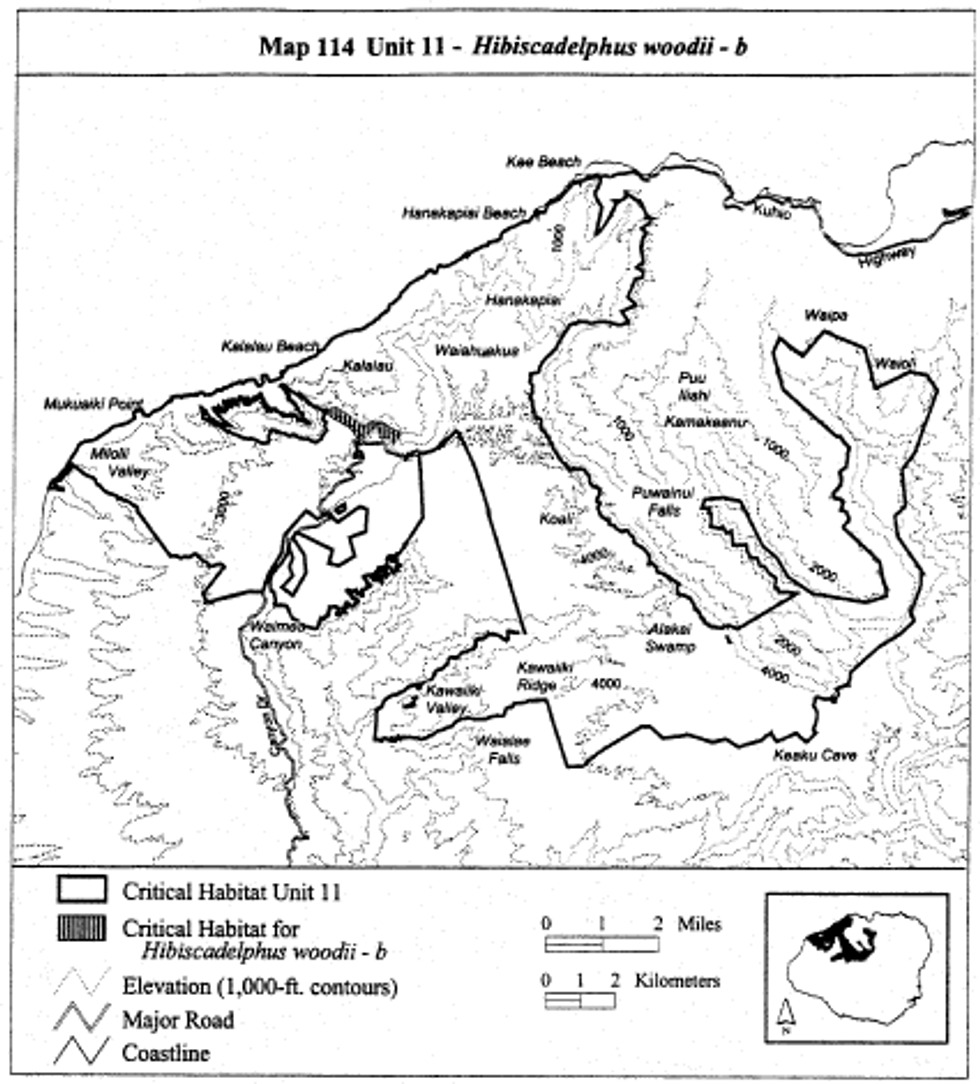
(ccix) Kauai 11 - Hibiscus waimeae ssp. hannerae - a (1,119 ha; 2,765 ac)
(A) [Reserved]
(B) Map 115 follows:
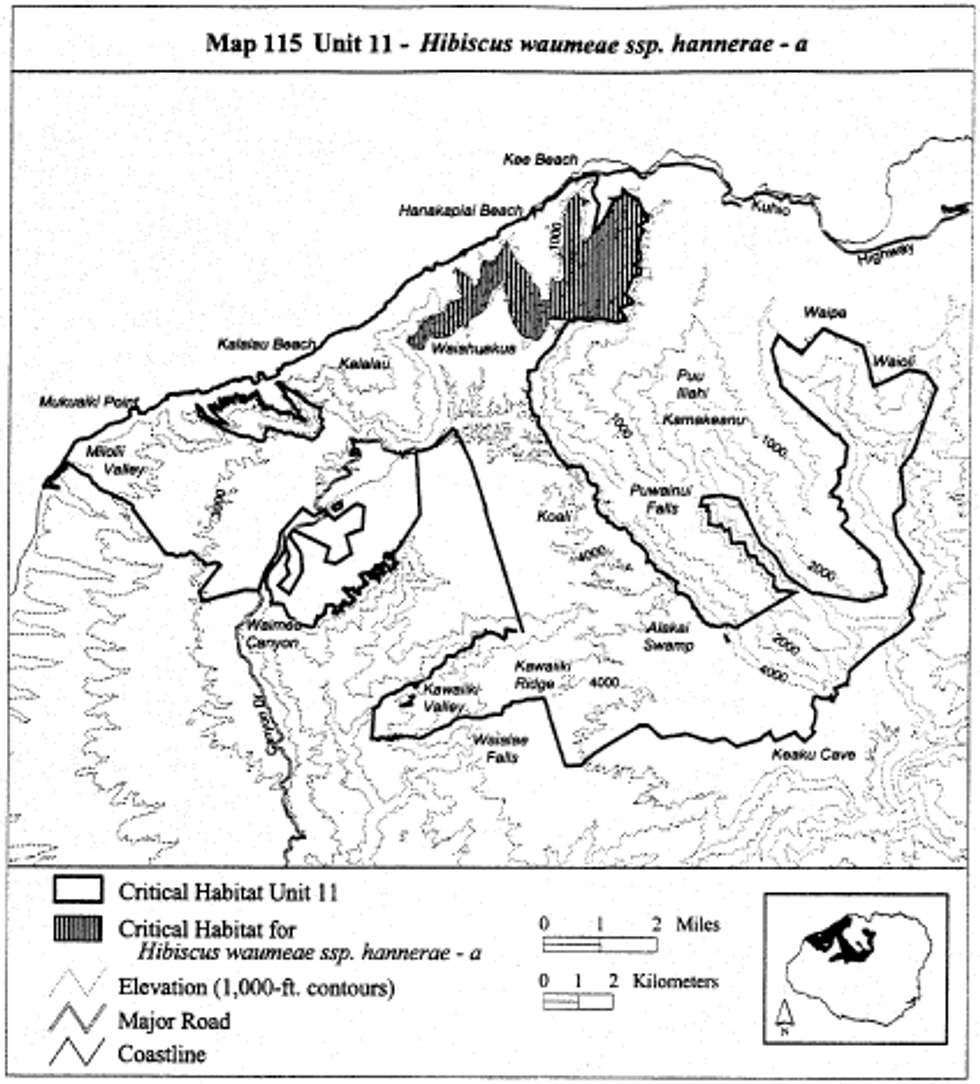
(ccx) Kauai 11 - Ischaemum byrone - d (45 ha; 111 ac)
(A) [Reserved]
(B) Map 116 follows:
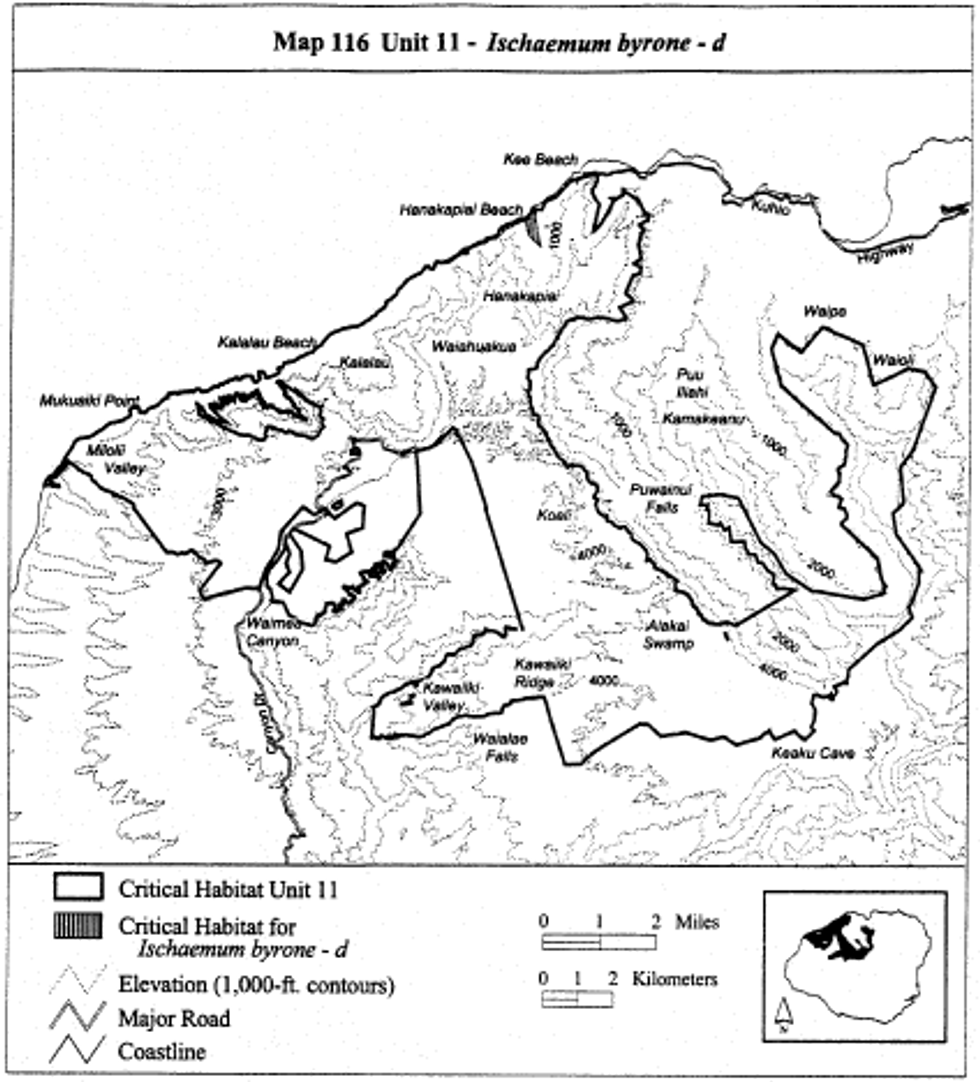
(ccxi) Kauai 11 - Isodendrion laurifolium - a (401 ha; 991 ac)
(A) [Reserved]
(B) Map 117 follows:
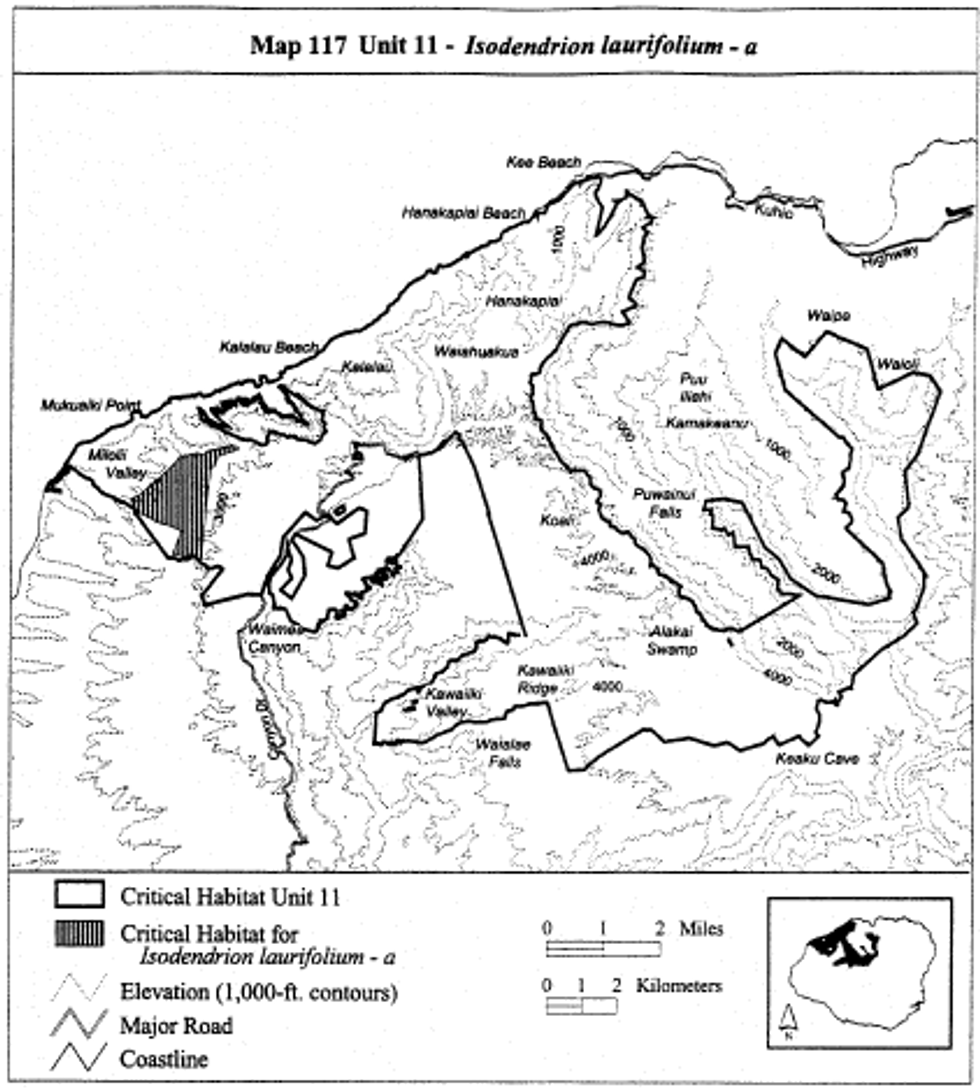
(ccxii) Kauai 11 - Isodendrion laurifolium - b (400 ha; 988 ac)
(A) [Reserved]
(B) Map 118 follows:
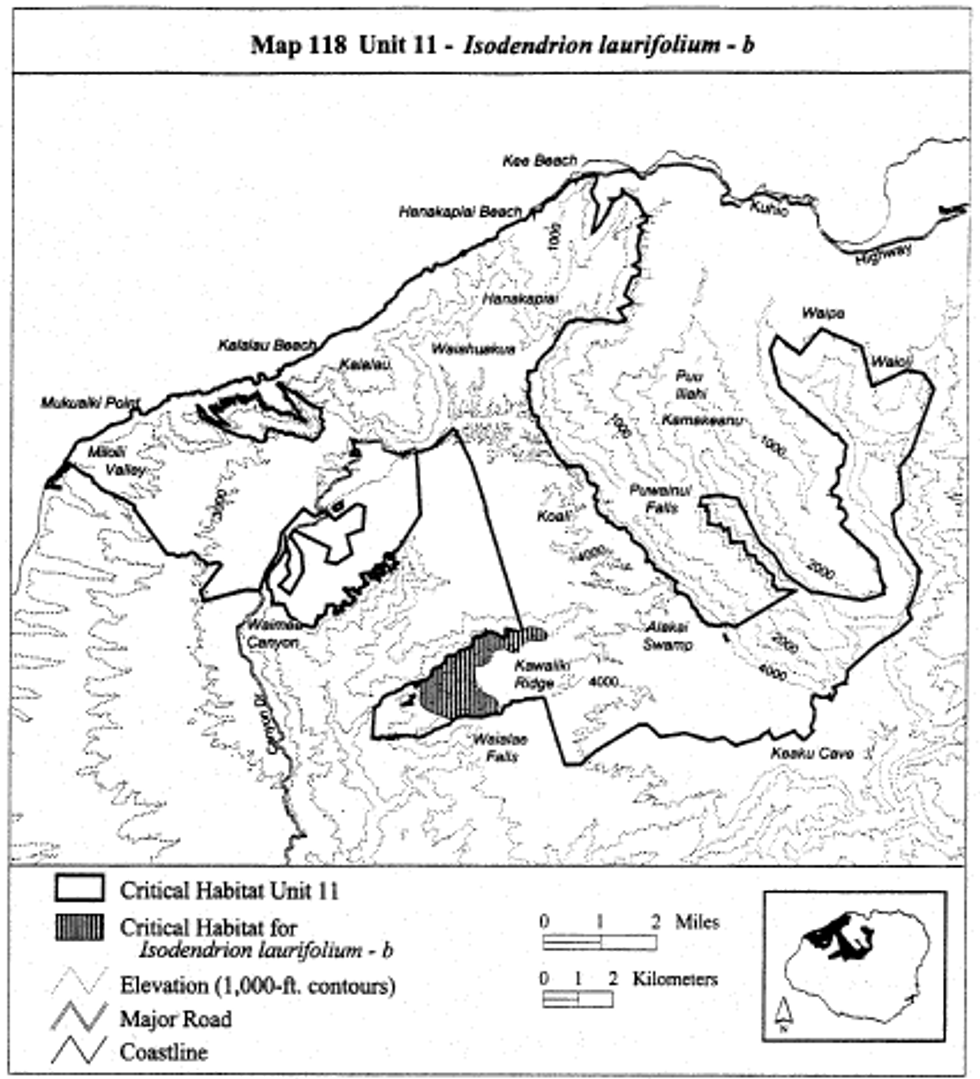
(ccxiii) Kauai 11 - Isodendrion longifolium - c (59 ha; 146 ac)
(A) [Reserved]
(B) Map 119 follows:
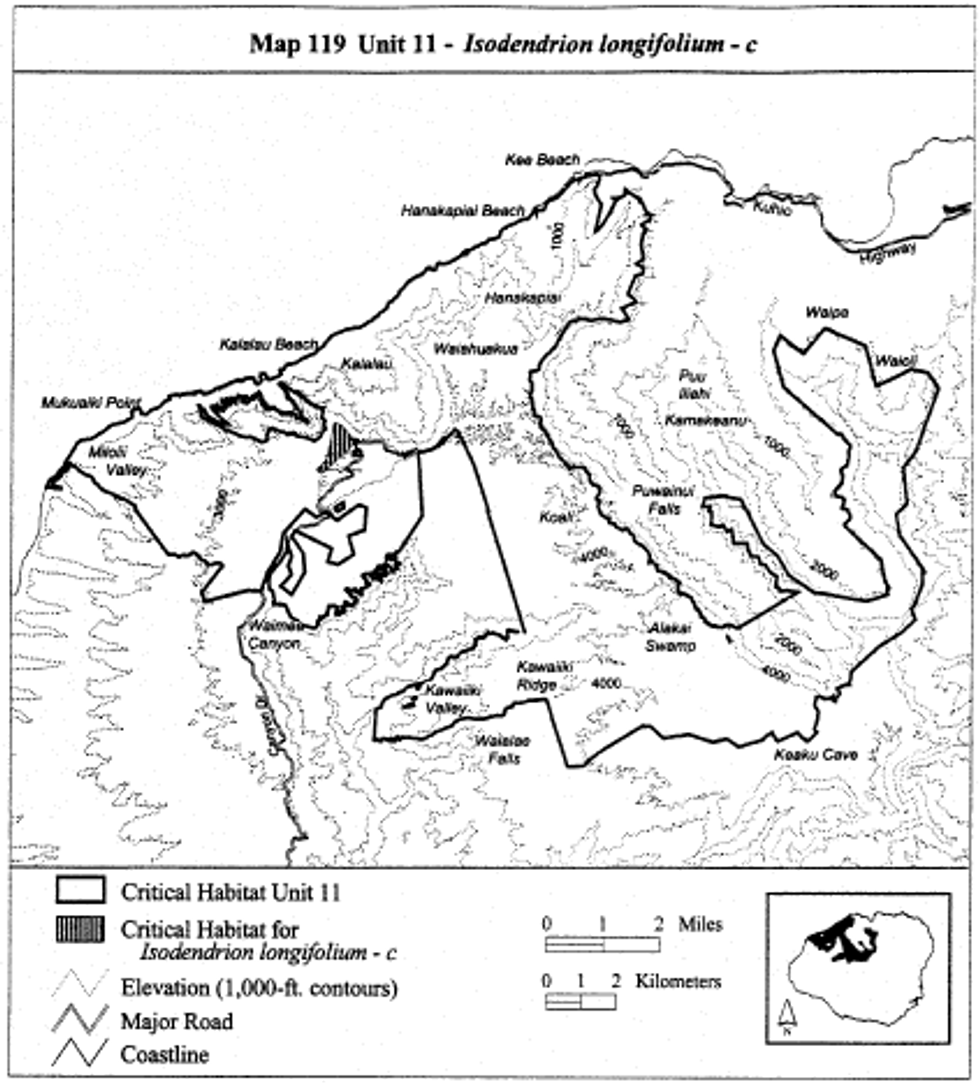
(ccxiv) Kauai 11 - Isodendrion longifolium - d (493 ha; 1,218 ac)
(A) [Reserved]
(B) Map 120 follows:
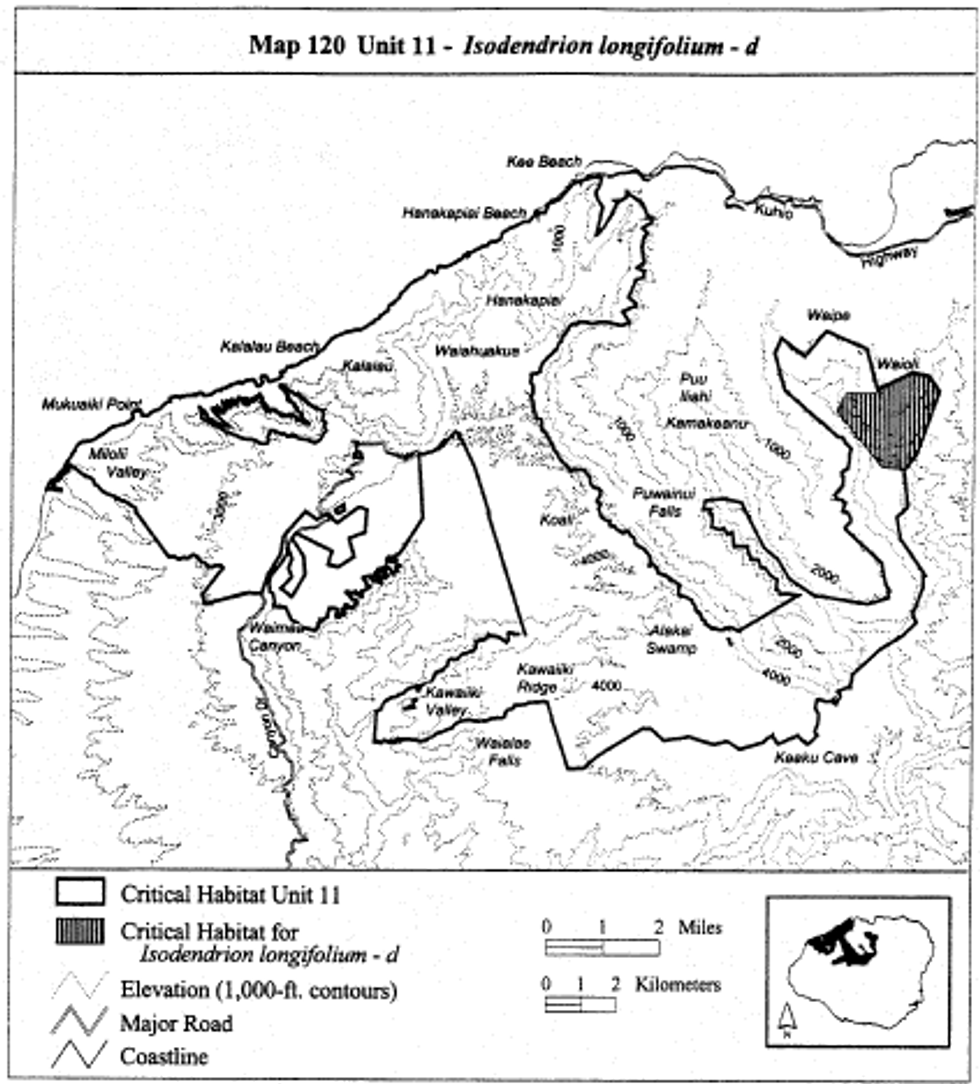
(ccxv) Kauai 11 - Isodendrion longifolium - e (381 ha; 941 ac)
(A) [Reserved]
(B) Map 121 follows:
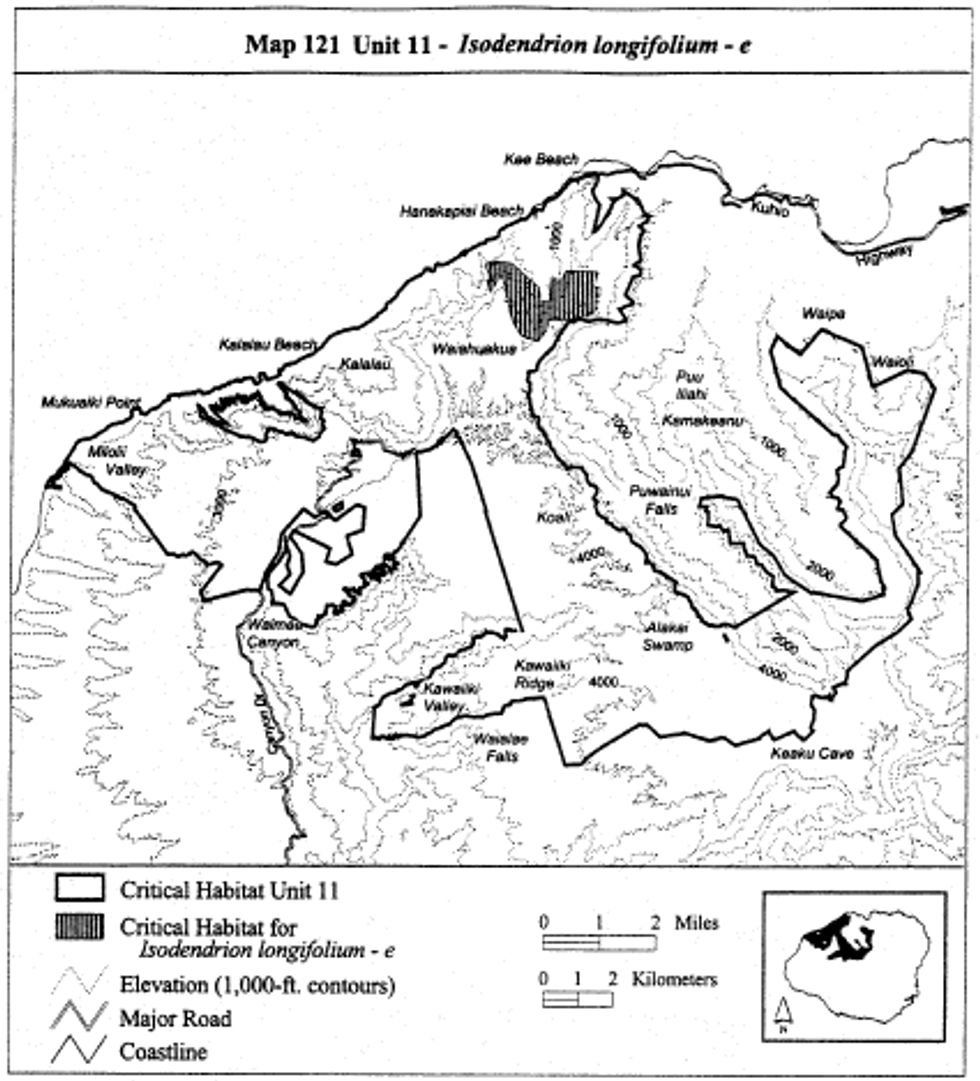
(ccxvi) Kauai 11-Keysseria erici-b
(A) [Reserved]
(B) See paragraph (a)(1)(cxxx)(B) of this section for the map of this unit.
(ccxvii) Kauai 11-Keysseria helenae-b
(A) [Reserved]
(B) See paragraph (a)(1)(cxxx)(B) of this section for the map of this unit.
(ccxviii) Kauai 11 - Kokia kauaiensis - a (155 ha; 384 ac)
(A) [Reserved]
(B) Map 122 follows:
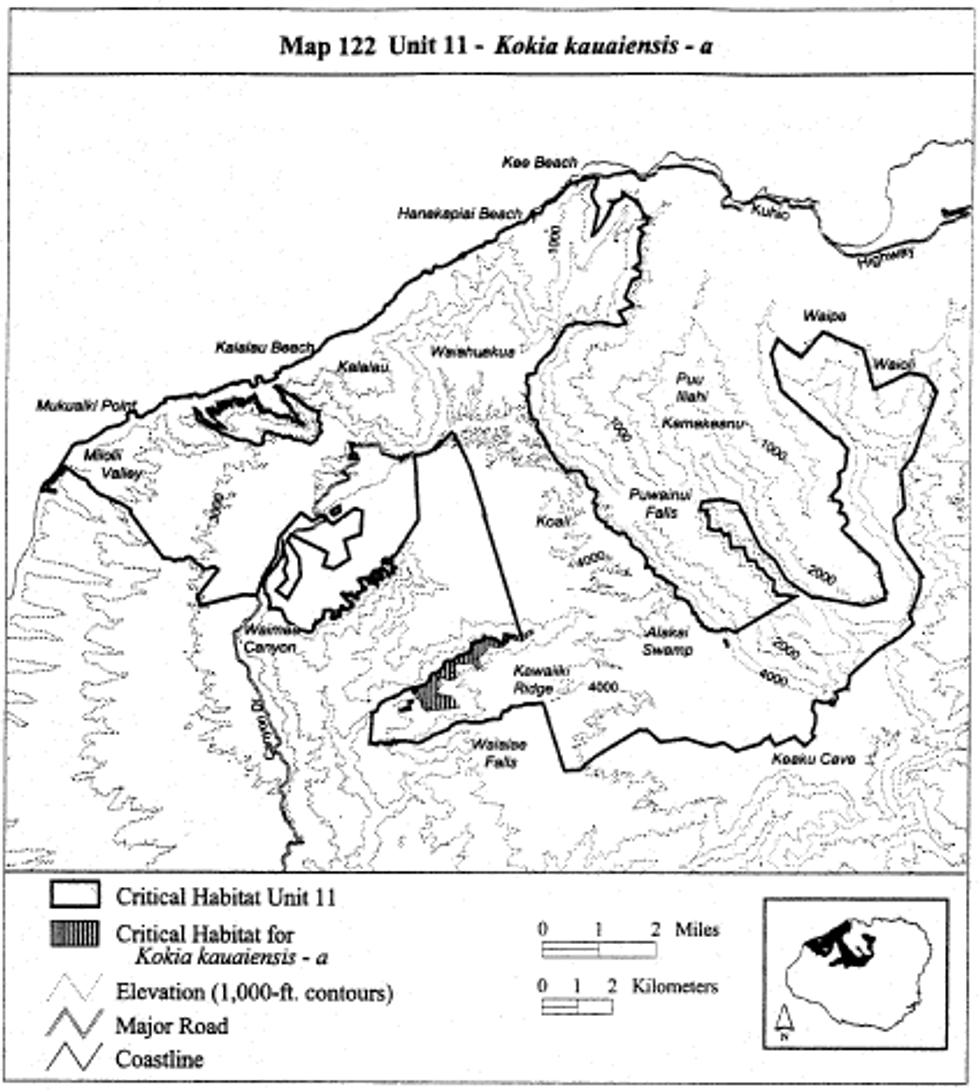
(ccxix) Kauai 11 - Kokia kauaiensis - b (30 ha; 74 ac)
(A) [Reserved]
(B) Map 123 follows:
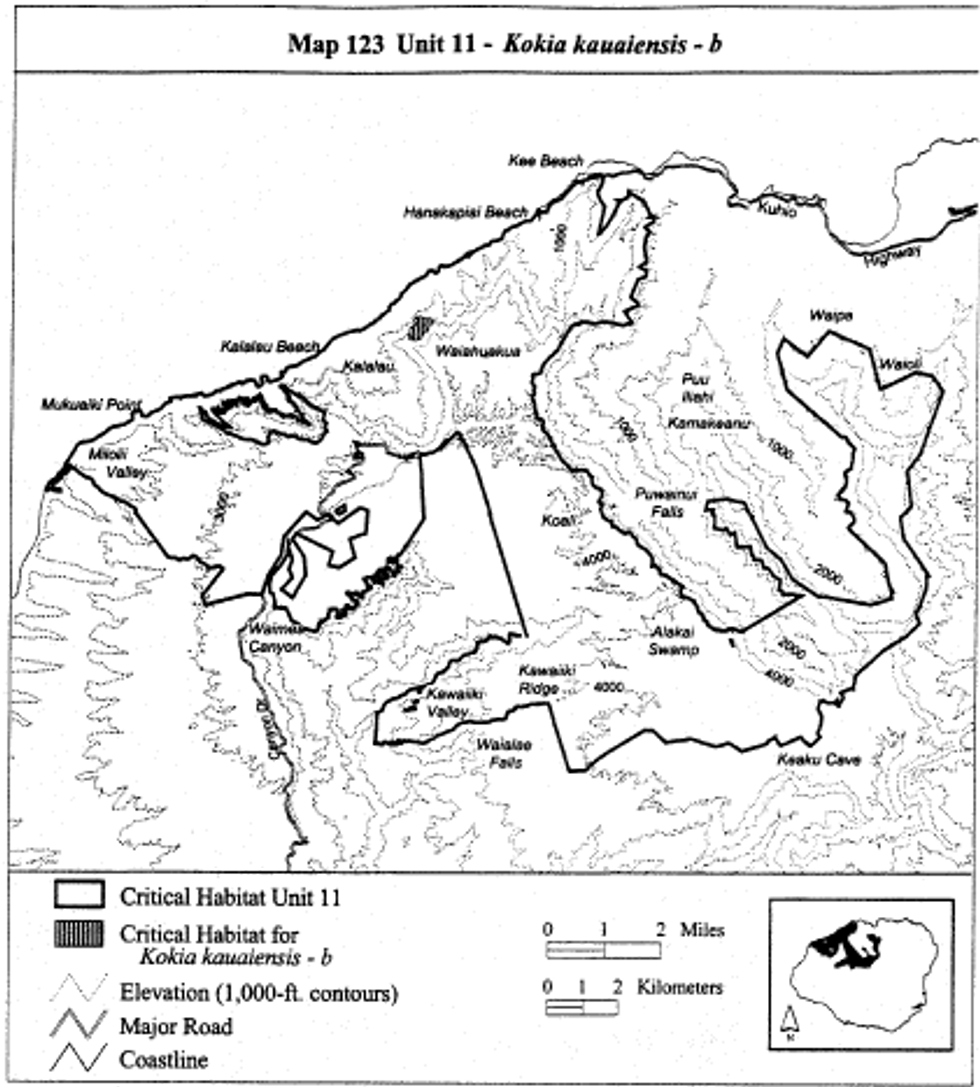
(ccxx) Kauai 11 - Kokia kauaiensis - c (667 ha; 1,647 ac)
(A) [Reserved]
(B) Map 124 follows:
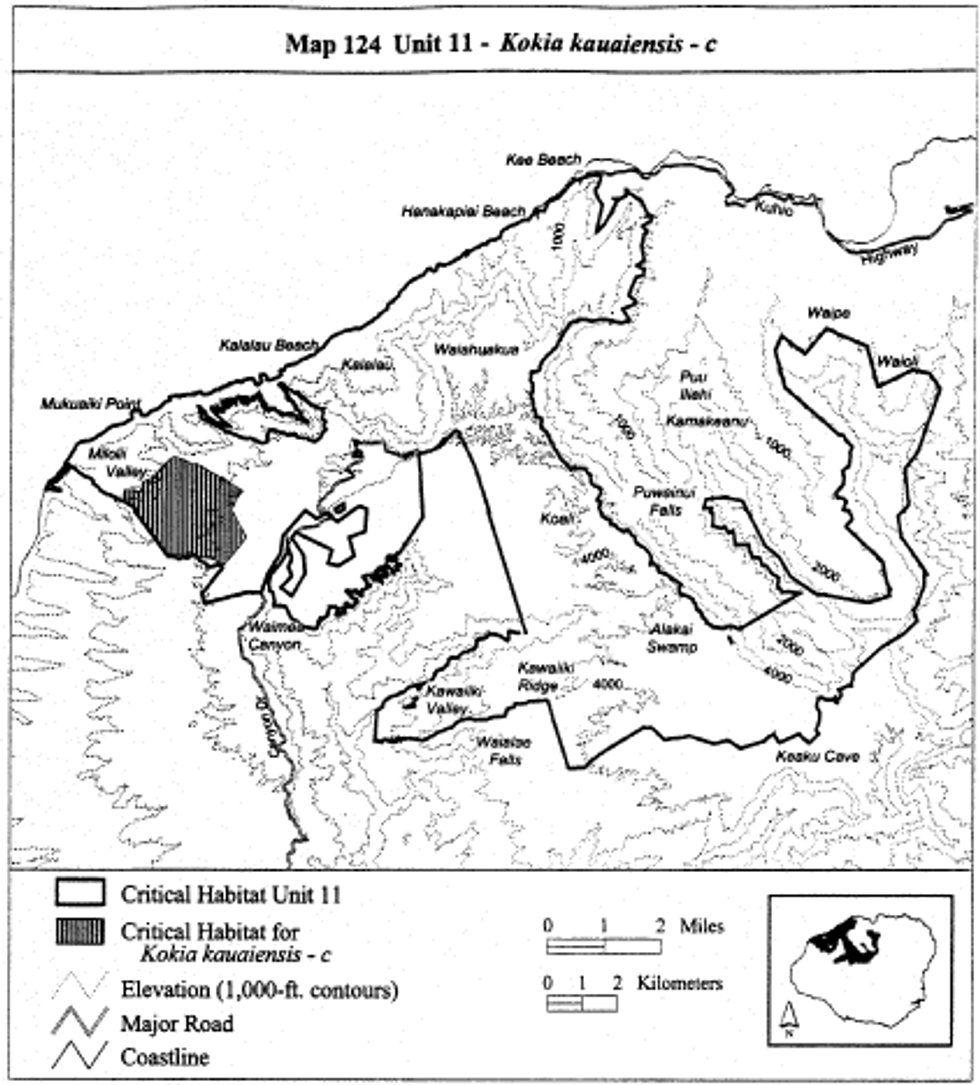
(ccxxi) Kauai 11 - Kokia kauaiensis - d (126 ha; 312 ac)
(A) [Reserved]
(B) Map 125 follows:
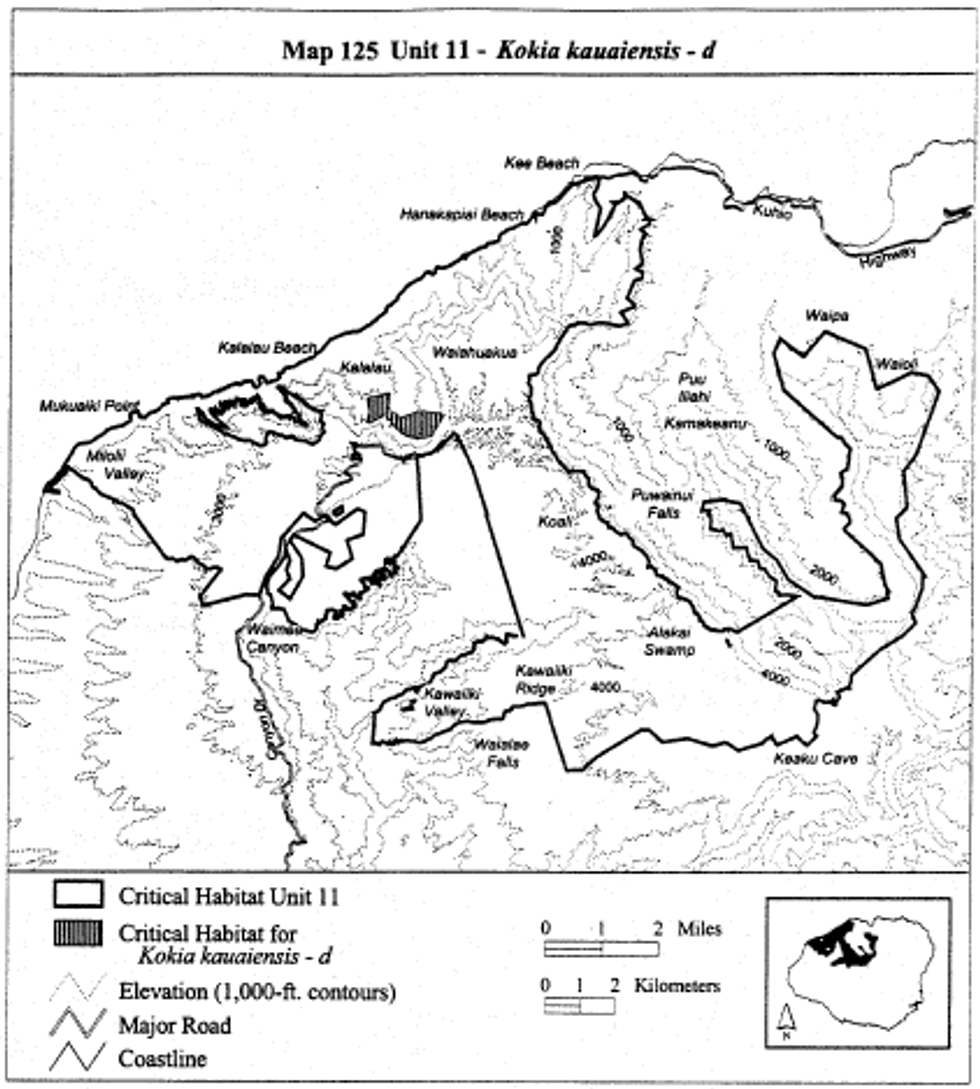
(ccxxii) Kauai 11-Labordia helleri-d
(A) [Reserved]
(B) See paragraph (a)(1)(cxxx)(B) of this section for the map of this unit.
(ccxxiii) Kauai 11-Labordia helleri-e
(A) [Reserved]
(B) See paragraph (a)(1)(cxxxiii)(B) of this section for the map of this unit.
(ccxxiv) Kauai 11-Labordia helleri-f
(A) [Reserved]
(B) See paragraph (a)(1)(cxl)(B) of this section for the map of this unit.
(ccxxv) Kauai 11-Labordia helleri-g
(A) [Reserved]
(B) See paragraph (a)(1)(cxlvi)(B) of this section for the map of this unit.
(ccxxvi) Kauai 11 - Labordia lydgatei - c (325 ha; 803 ac)
(A) [Reserved]
(B) Map 126 follows:
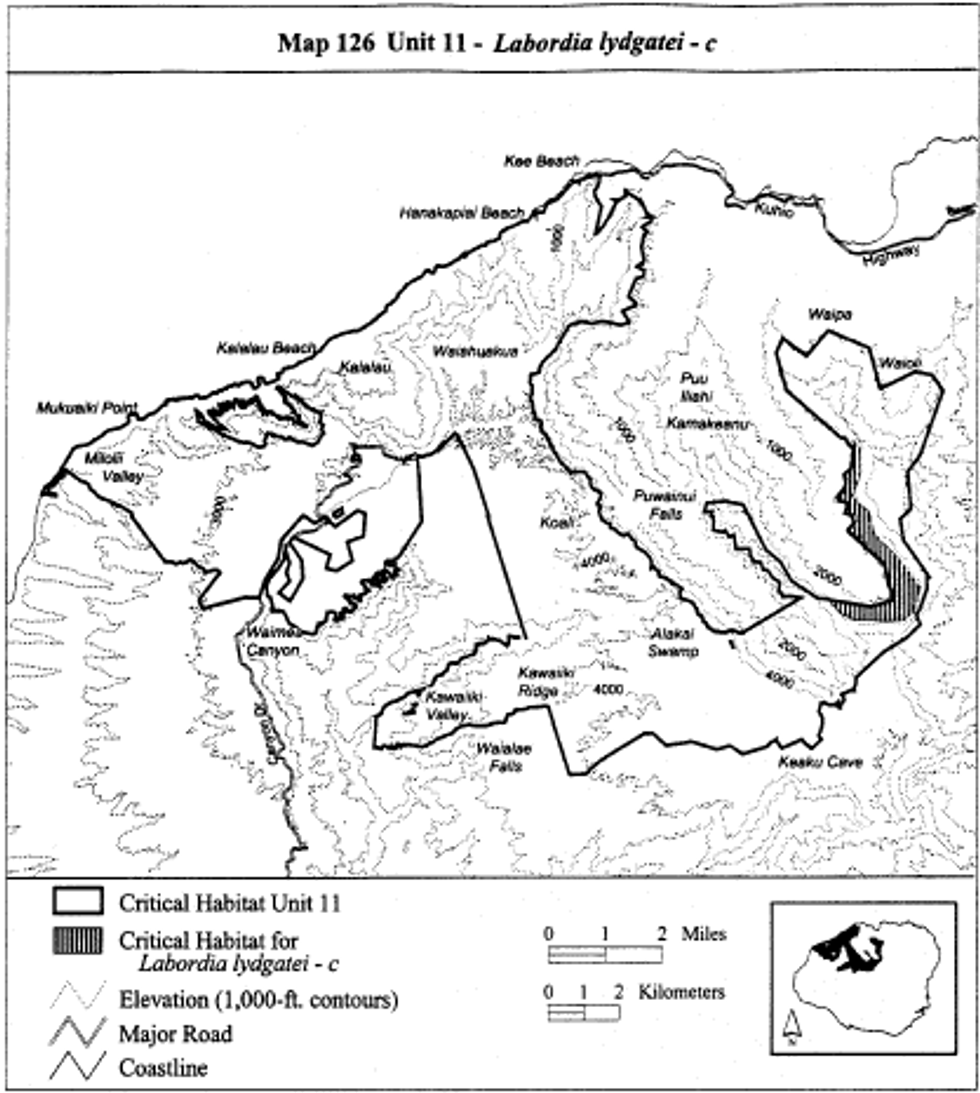
(ccxxvii) Kauai 11 - Labordia lydgatei - d (82 ha; 203 ac)
(A) [Reserved]
(B) Map 127 follows:
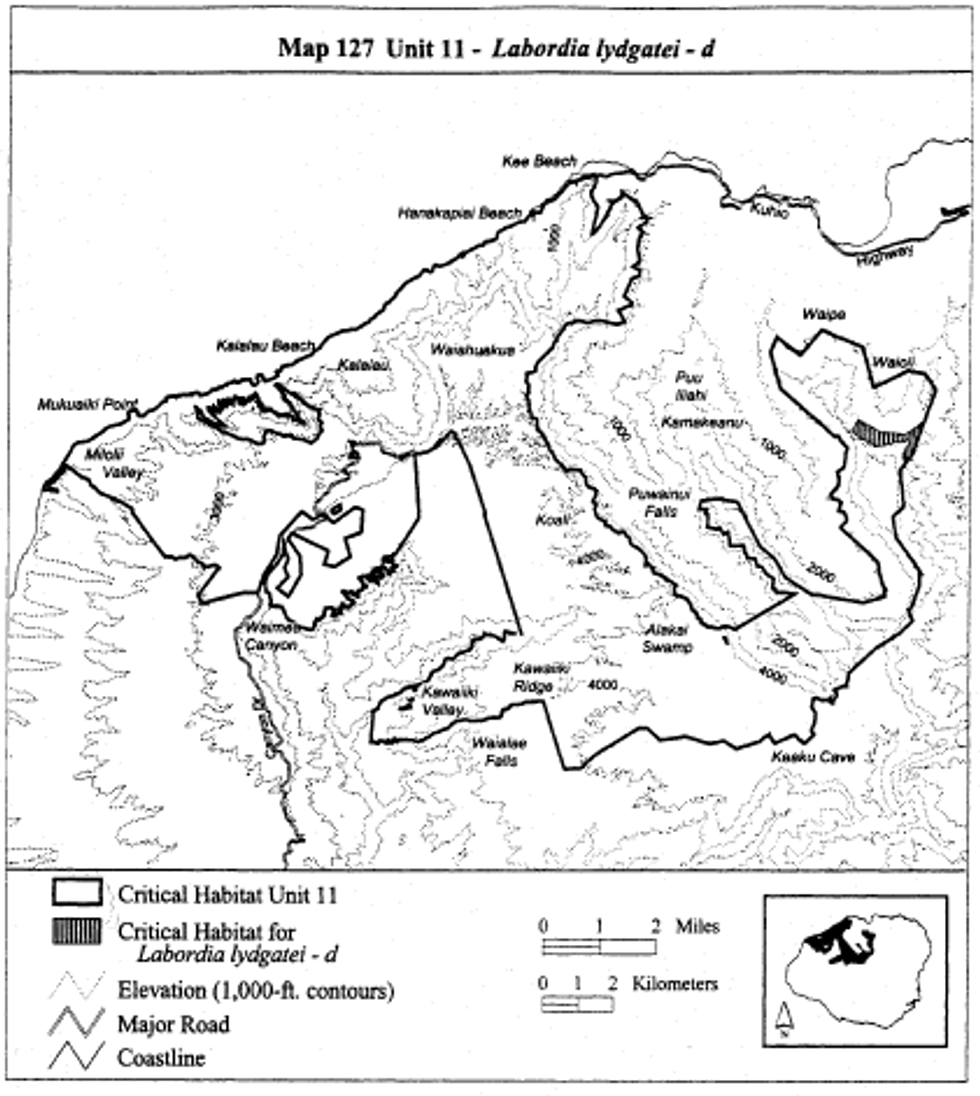
(ccxxviii) Kauai 11 - Labordia lydgatei - e (117 ha; 290 ac)
(A) [Reserved]
(B) Map 128 follows:
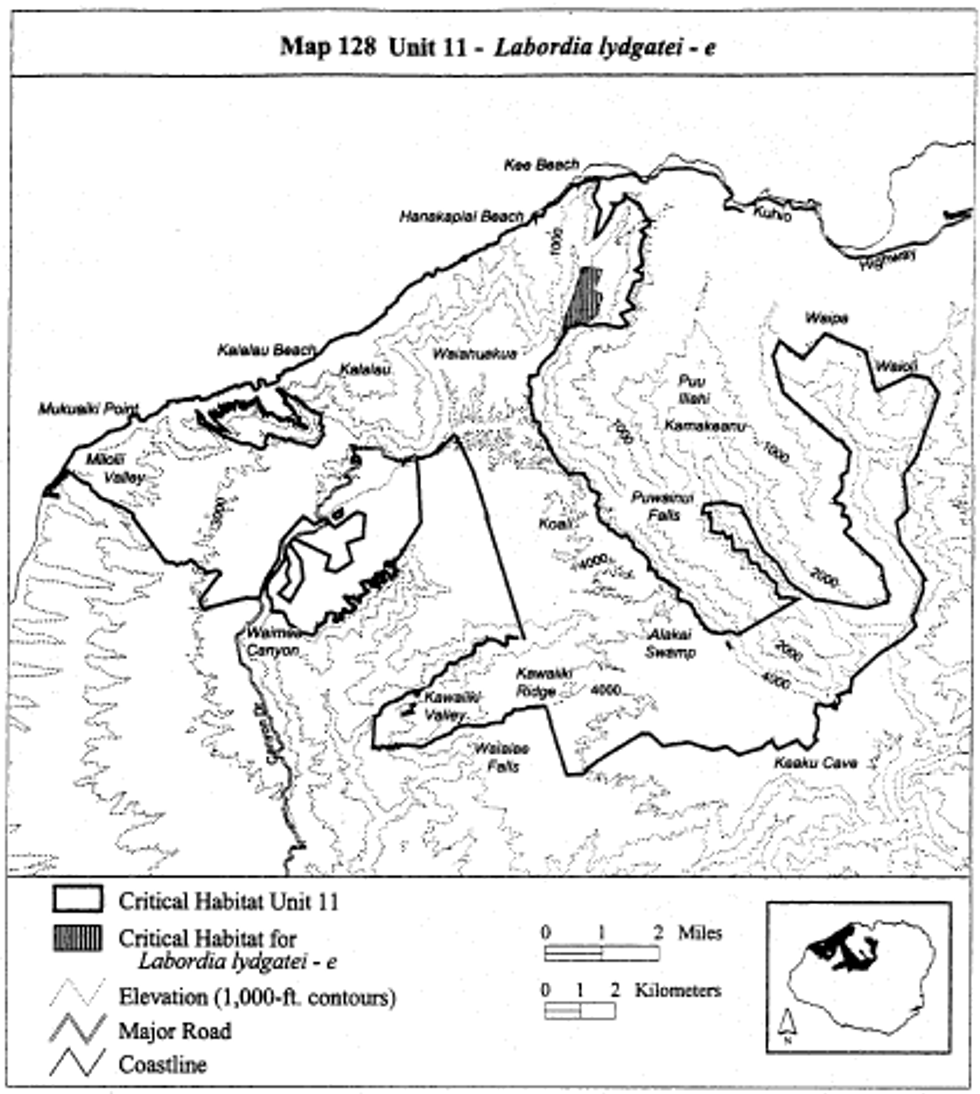
(ccxxix) Kauai 11-Labordia pumila-b
(A) [Reserved]
(B) See paragraph (a)(1)(cxxx)(B) of this section for the map of this unit.
(ccxxx) Kauai 11 - Lipochaeta fauriei - a (106 ha; 262 ac)
(A) [Reserved]
(B) Map 129 follows:
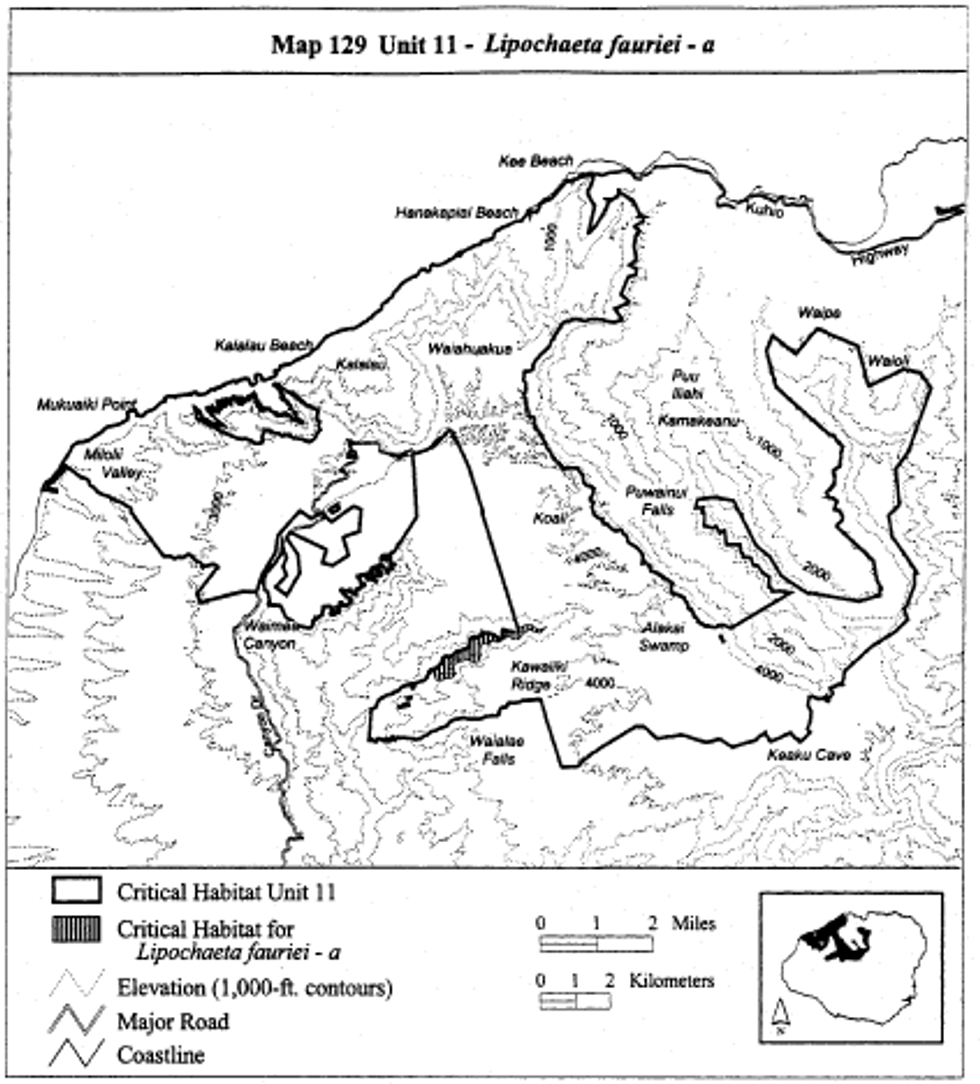
(ccxxxi) Kauai 11 - Lipochaeta fauriei - b (545 ha; 1,347 ac)
(A) [Reserved]
(B) Map 130 follows:
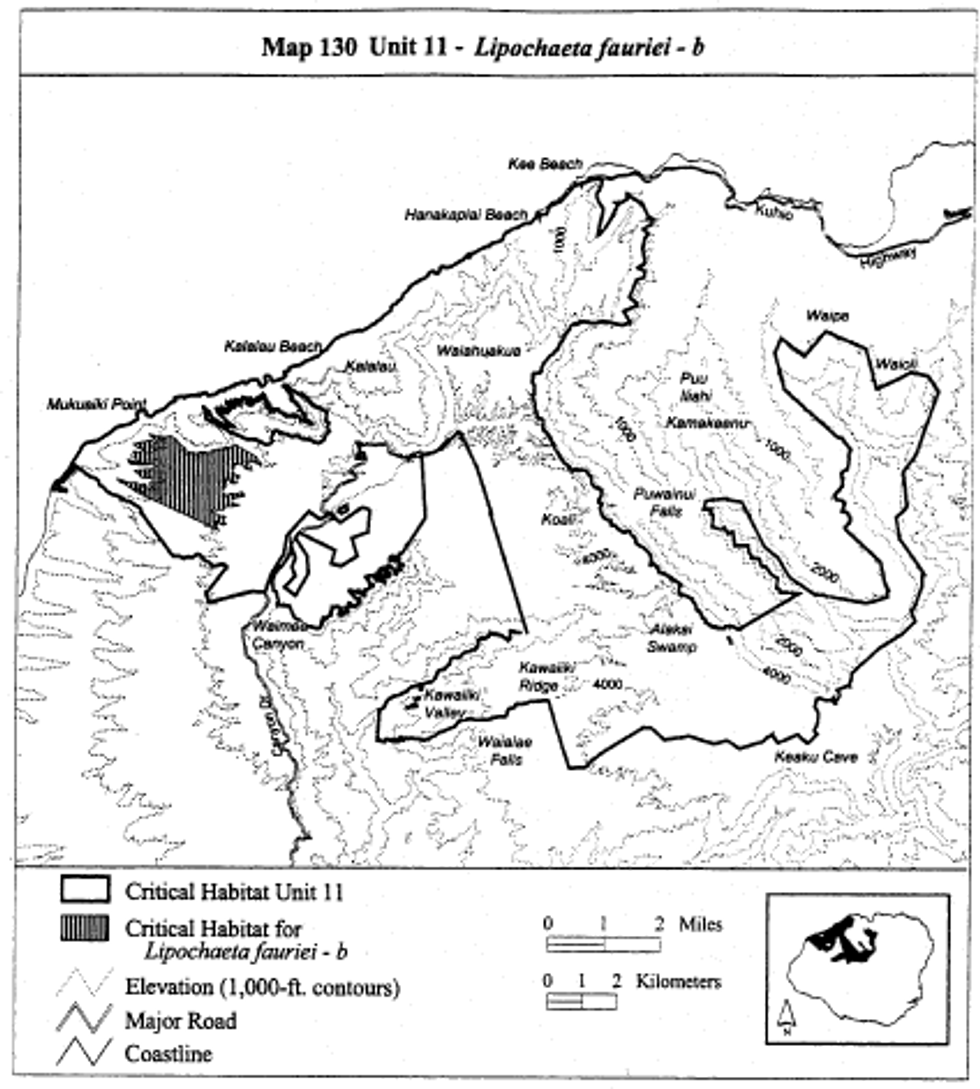
(ccxxxii) Kauai 11 - Lipochaeta micrantha - b (212 ha; 523 ac)
(A) [Reserved]
(B) Map 131 follows:
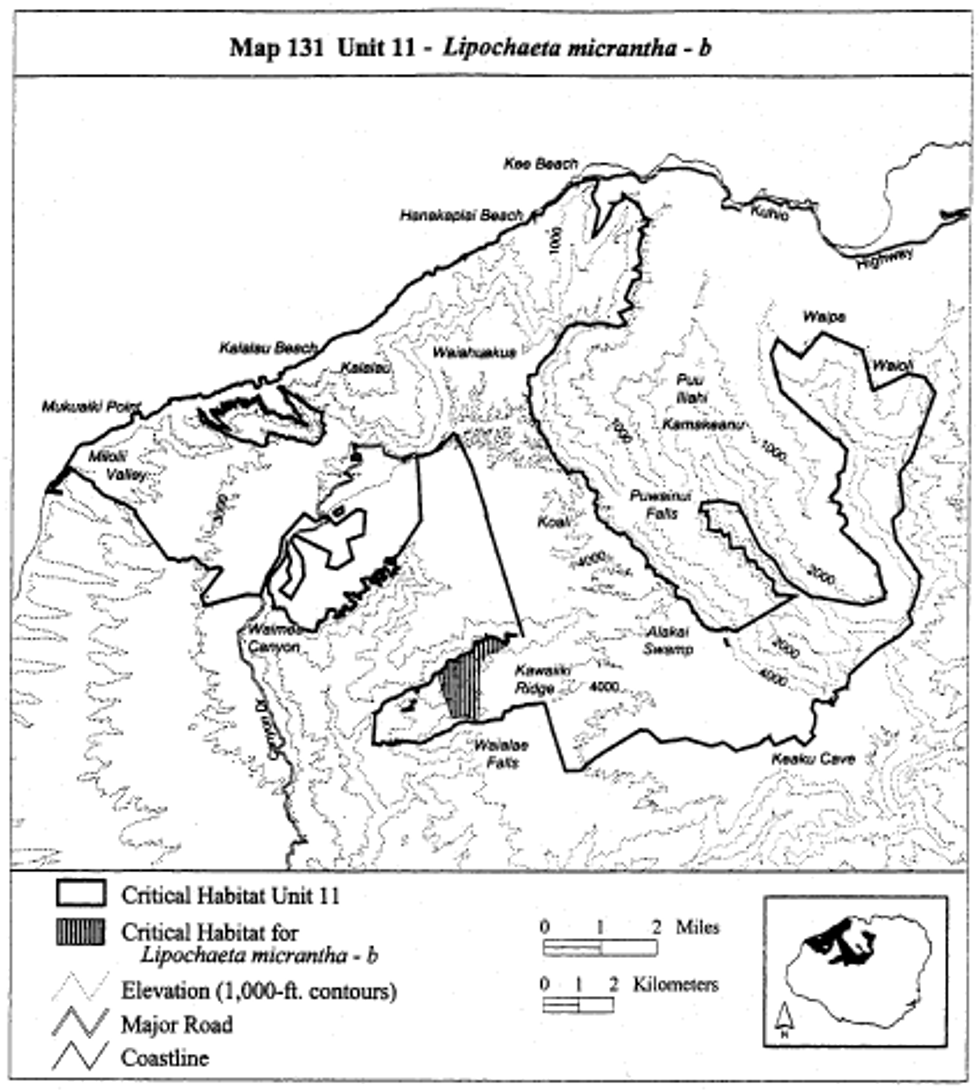
(ccxxxiii) Kauai 11 - Lobelia niihauensis - a (89 ha; 220 ac)
(A) [Reserved]
(B) Map 132 follows:
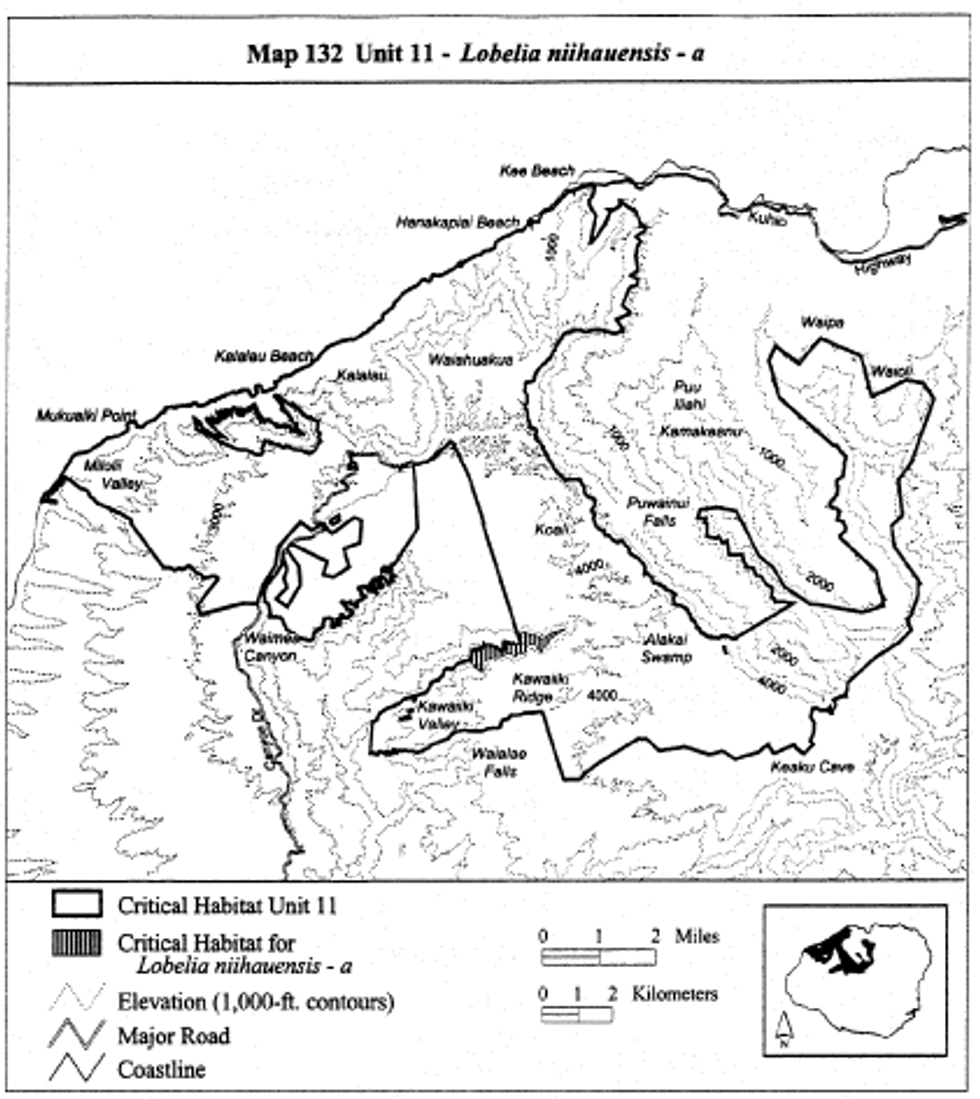
(ccxxxiv) Kauai 11 - Lobelia niihauensis - b (2,001 ha; 4,945 ac)
(A) [Reserved]
(B) Map 133 follows:
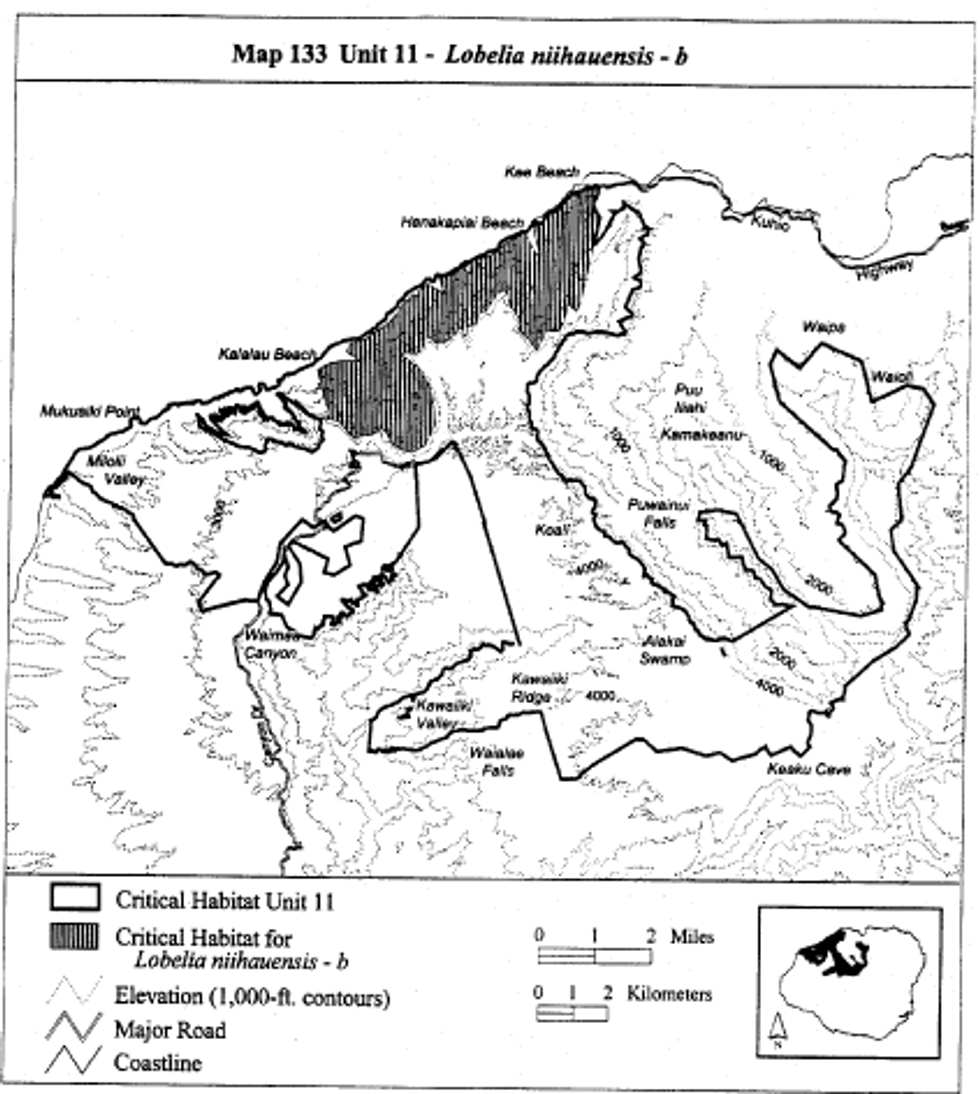
(ccxxxv) Kauai 11-Lysimachia daphnoides-b
(A) [Reserved]
(B) See paragraph (a)(1)(cxxx)(B) of this section for the map of this unit.
(ccxxxvi) Kauai 11-Lysimachia iniki-c
(A) [Reserved]
(B) See paragraph (a)(1)(cxli)(B) of this section for the map of this unit.
(ccxxxvii) Kauai 11-Lysimachia pendens-c
(A) [Reserved]
(B) See paragraph (a)(1)(cxli)(B) of this section for the map of this unit.
(ccxxxviii) Kauai 11-Lysimachia scopulensis-a
(A) [Reserved]
(B) See paragraph (a)(1)(cxxxvi)(B) of this section for the map of this unit.
(ccxxxix) Kauai 11-Lysimachia venosa-c
(A) [Reserved]
(B) See paragraph (a)(1)(cxli)(B) of this section for the map of this unit.
(ccxl) Kauai 11 - Cyperus pennatiformis - a (1,003 ha; 2,479 ac)
(A) [Reserved]
(B) Map 134 follows:
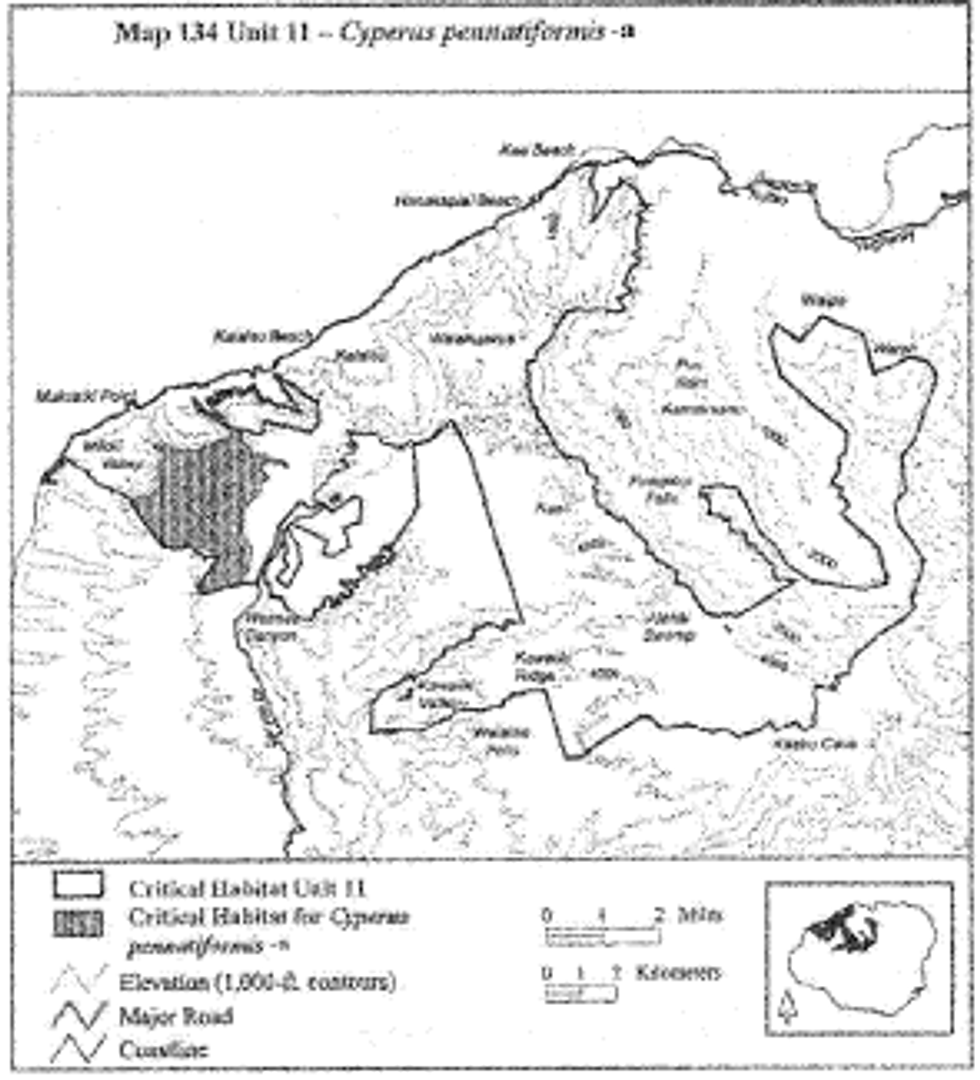
(ccxli) Kauai 11-Melicope degeneri-b
(A) [Reserved]
(B) See paragraph (a)(1)(cxxx)(B) of this section for the map of this unit.
(ccxlii) Kauai 11 - Melicope haupuensis - b (574 ha; 1,418 ac)
(A) [Reserved]
(B) Map 135 follows:
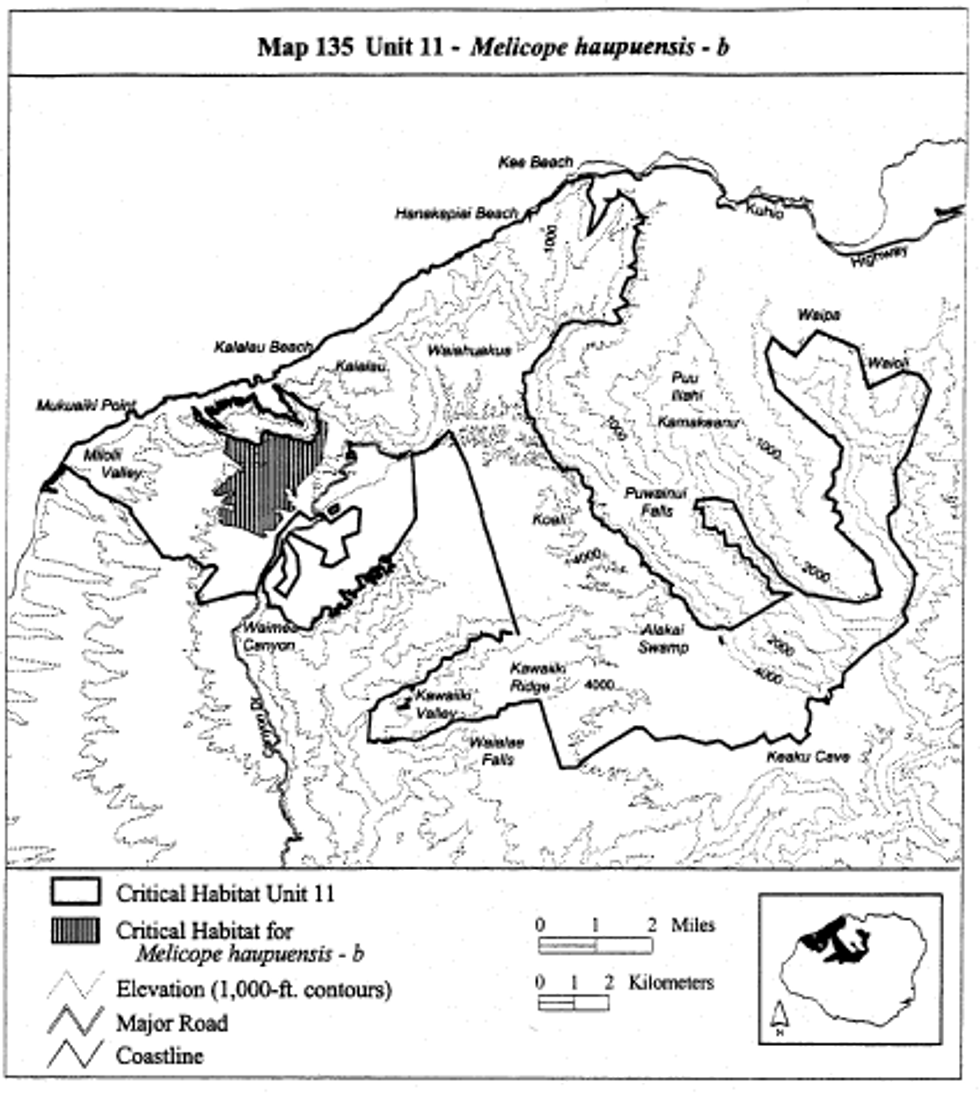
(ccxliii) Kauai 11 - Melicope haupuensis - c (290 ha; 716 ac)
(A) [Reserved]
(B) Map 136 follows:
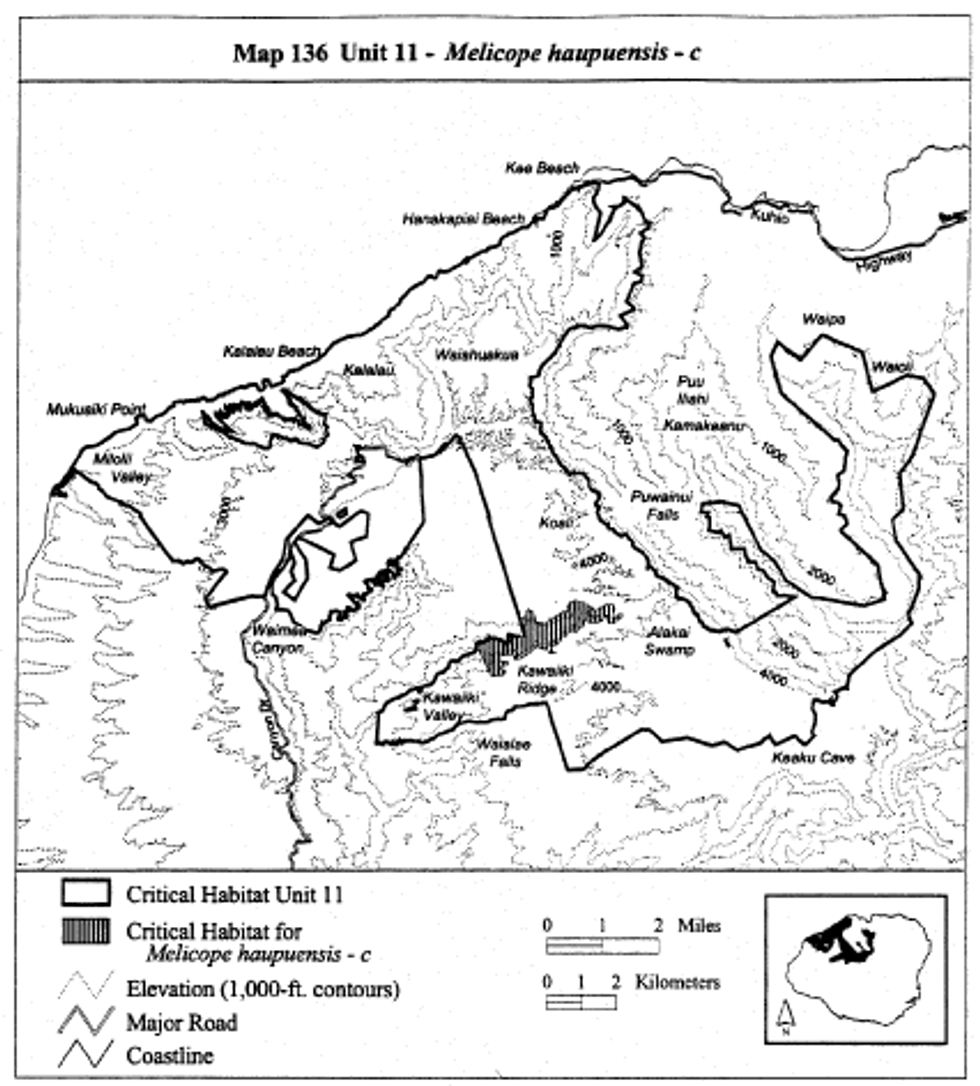
(ccxliv) Kauai 11 - Melicope knudsenii - a (966 ha; 2,388 ac)
(A) [Resserved]
(B) Map 137 follows:
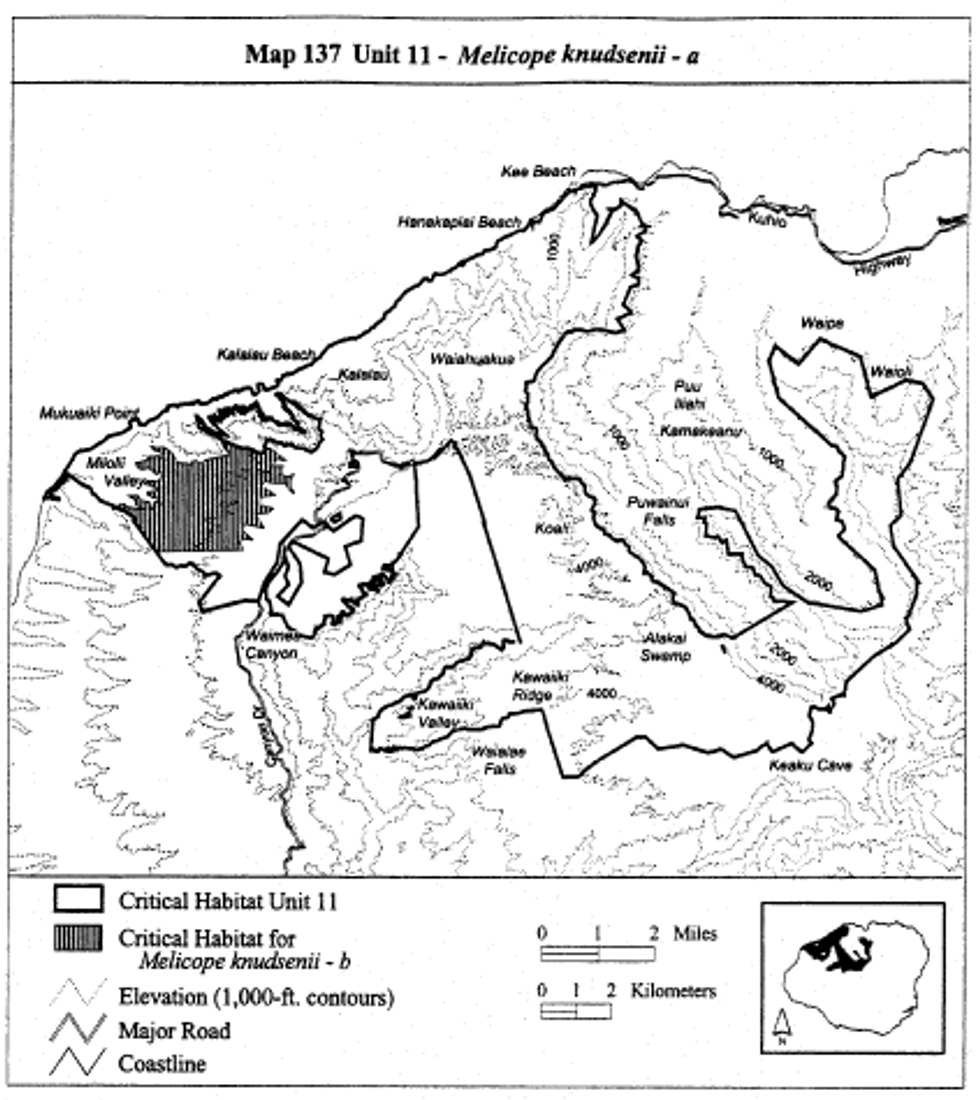
(ccxlv) Kauai 11 - Melicope knudsenii - b (374 ha; 922 ac)
(A) [Reserved]
(B) Excluding 2 areas:
(1) Bounded by the following 3 points (1 ha, 3 ac): Start at 435132, 2442248; 435160, 2442164; 434848, 2442098; return to starting point; and
(2) Bounded by the following 4 points (0 ha, 1 ac): Start at 435151, 2442425; 435215, 2442393; 435195, 2442353; 435128, 2442379; return to starting point.
(C) Map 138 follows:

(ccxlvi) Kauai 11 - Melicope pallida - a (143 ha, 353 ac)
(A) [Reserved]
(B) Map 139 follows:
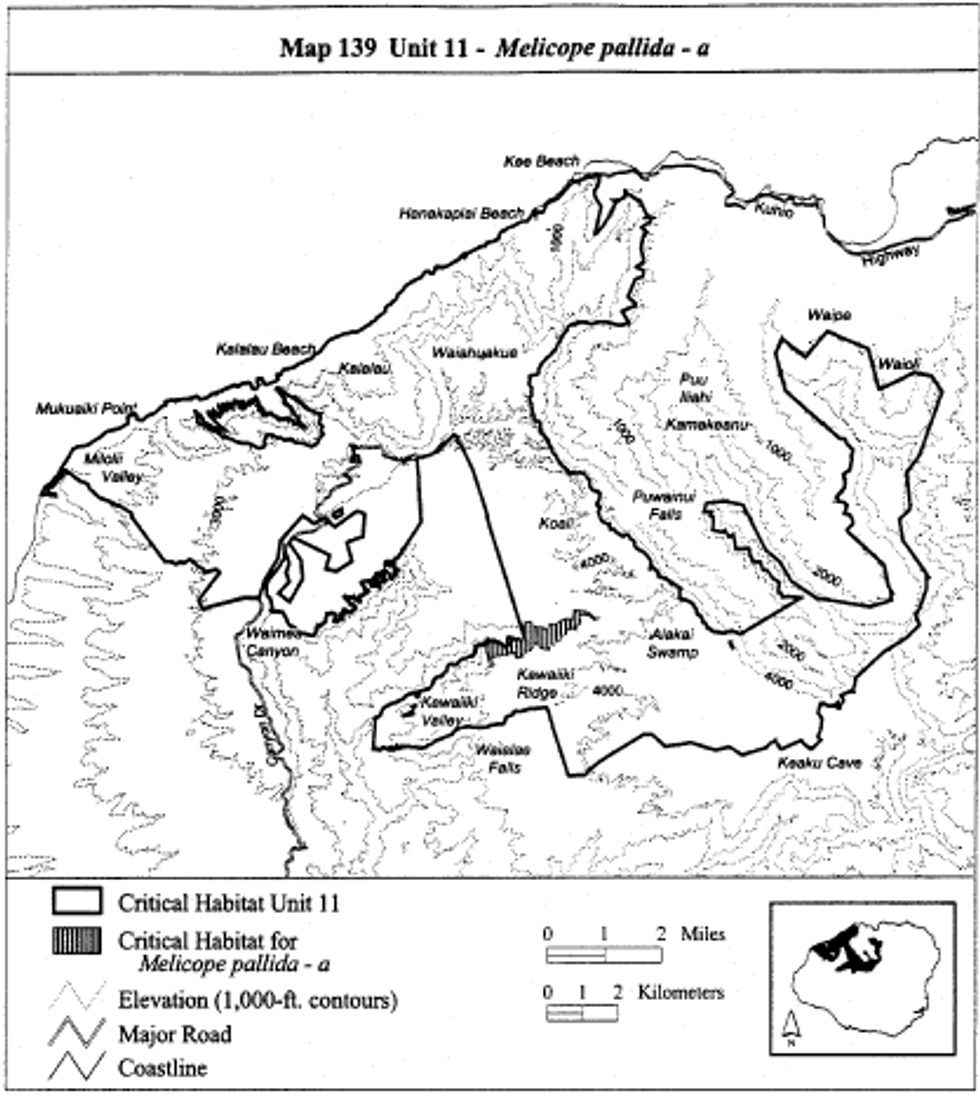
(ccxlvii) Kauai 11 - Melicope pallida - b (310 ha; 765 ac)
(A) [Reserved]
(B) Map 140 follows:
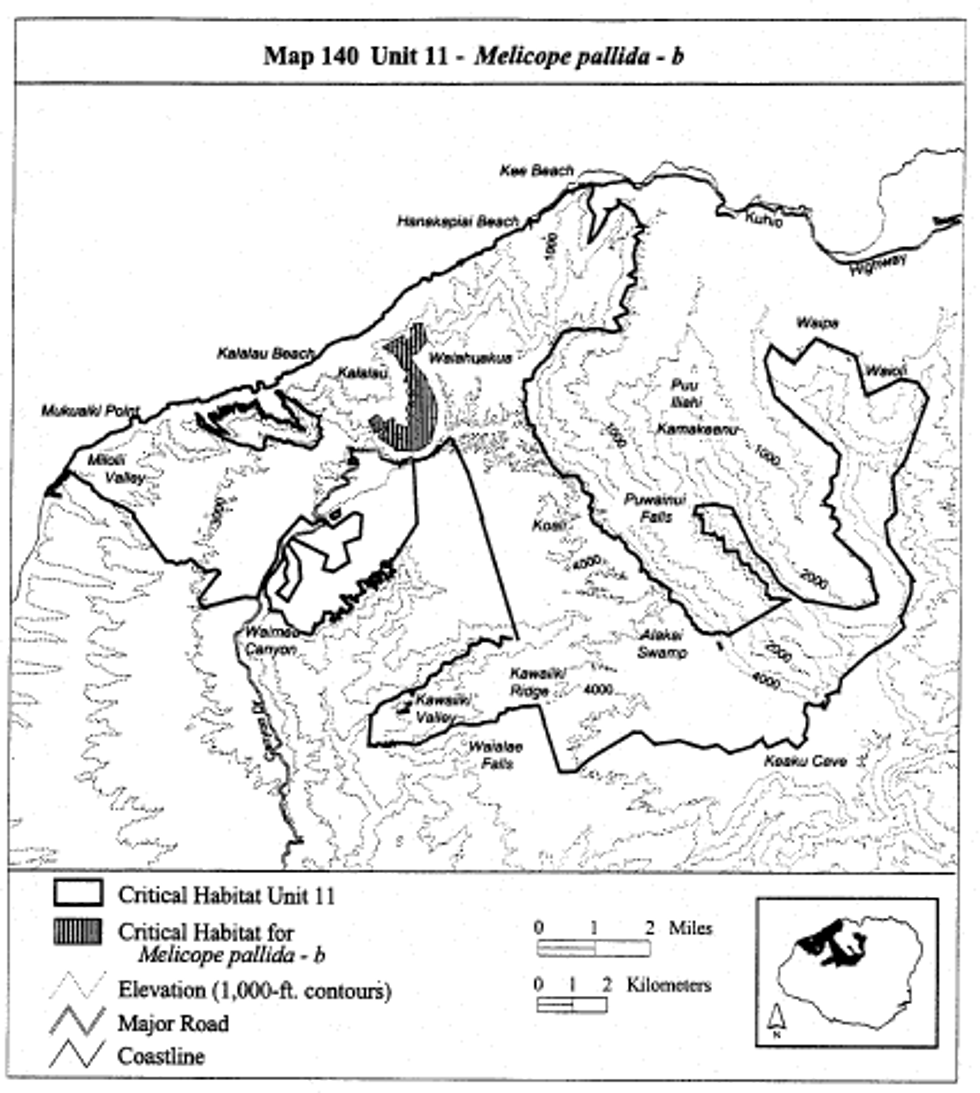
(ccxlviii) Kauai 11-Melicope paniculata-b
(A) [Reserved]
(B) See paragraph (a)(1)(cxl)(B) of this section for the map of this unit.
(ccxlix) Kauai 11-Melicope puberula-c
(A) [Reserved]
(B) See paragraph (a)(1)(cxxx)(B) of this section for the map of this unit.
(ccl) Kauai 11-Melicope puberula-d
(A) [Reserved]
(B) See paragraph (a)(1)(cxl)(B) of this section for the map of this unit.
(ccli) Kauai 11 - Munroidendron racemosum - c (1,950 ha; 4,819 ac)
(A) [Reserved]
(B) Map 141 follows:
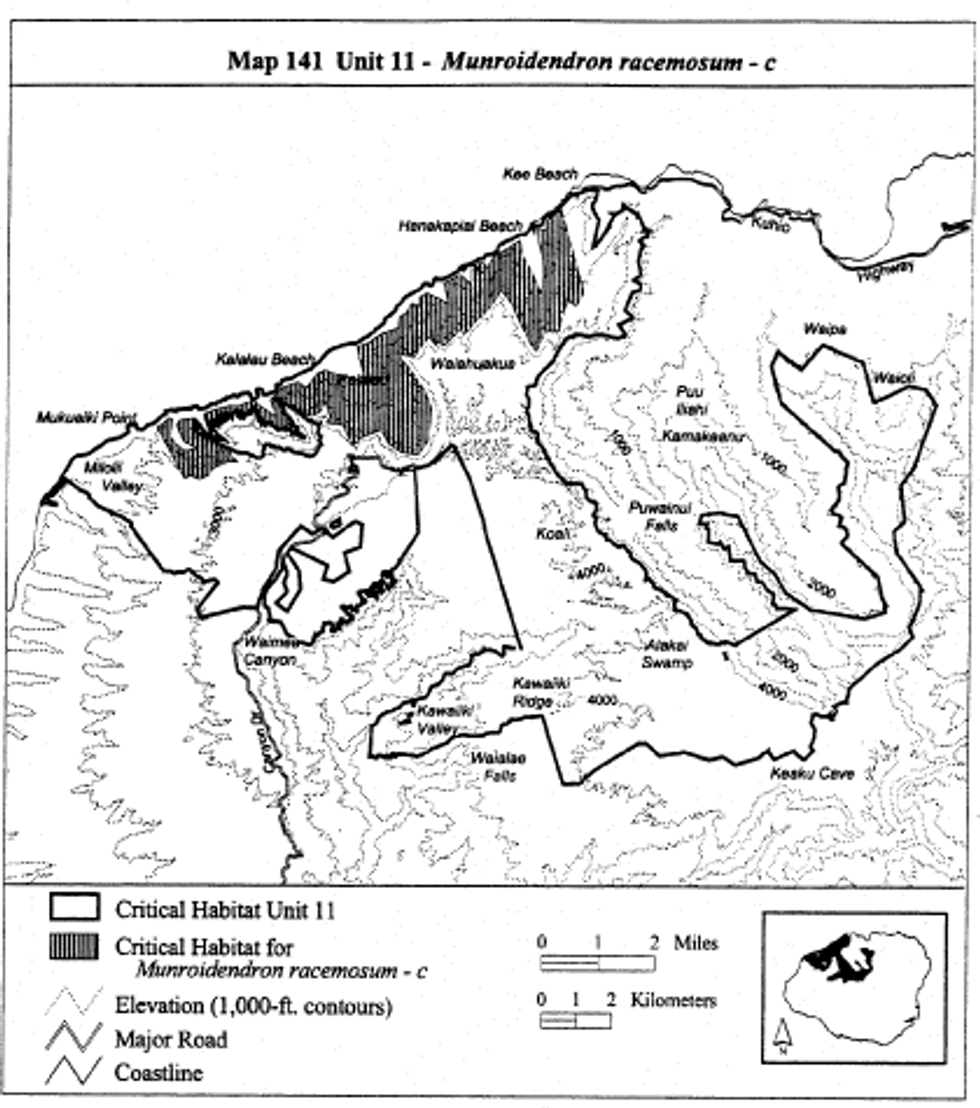
(cclii) Kauai 11 - Munroidendron racemosum - d (153 ha; 379 ac)
(A) [Reserved]
(B) Map 142 follows:
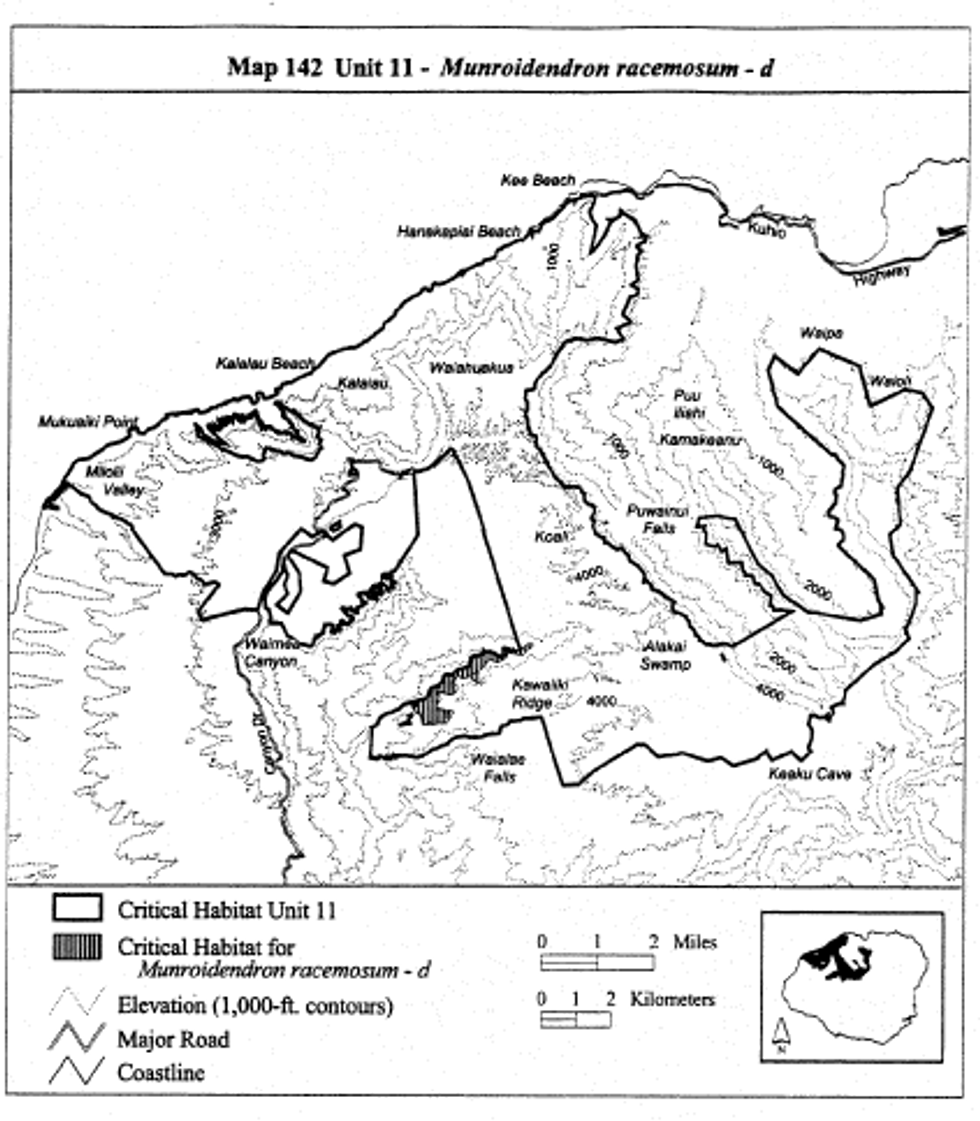
(ccliii) Kauai 11-Myrsine knudsenii-a
(A) [Reserved]
(B) See paragraph (a)(1)(cxlvi)(B) of this section for the map of this unit.
(ccliv) Kauai 11 - Myrsine linearifolia - c (684 ha; 1,691 ac)
(A) [Reserved]
(B) Map 143 follows:
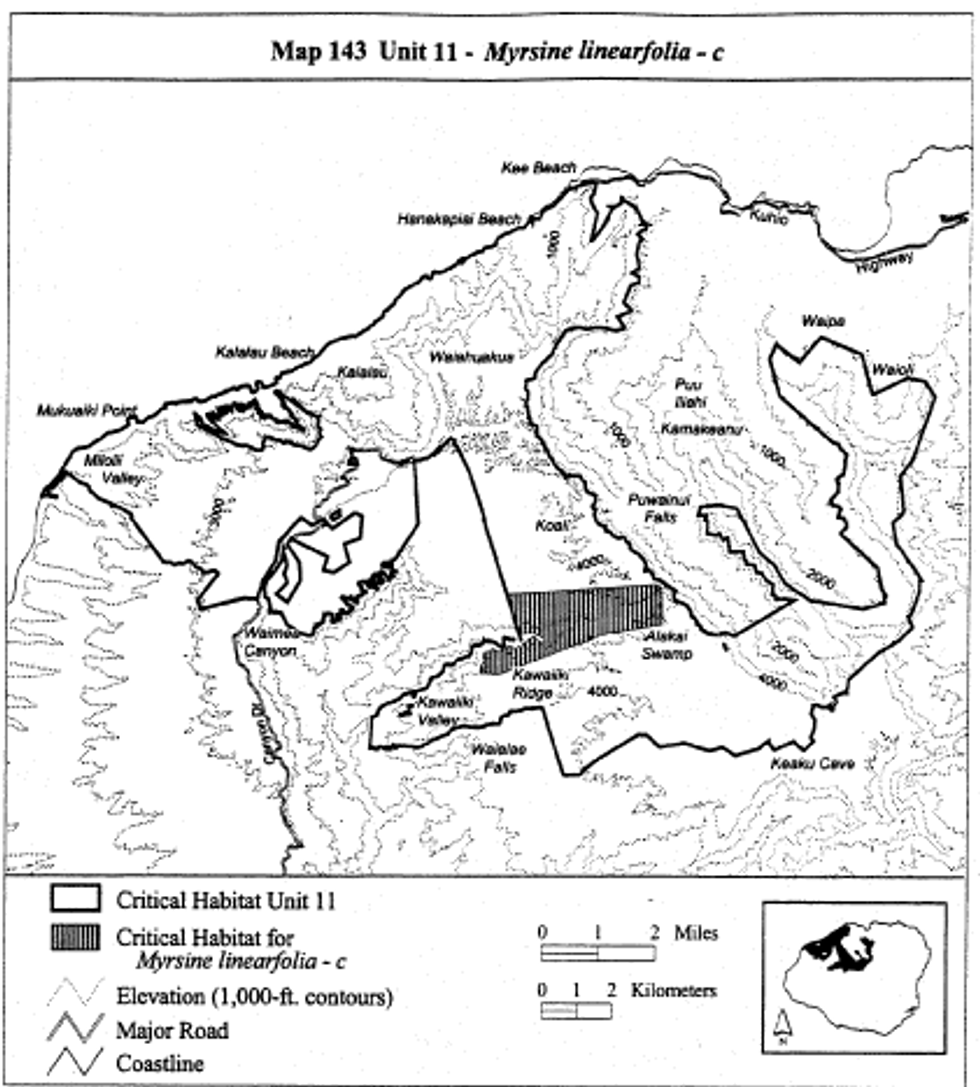
(cclv) Kauai 11 - Myrsine linearifolia - d (286 ha; 707 ac)
(A) [Reserved]
(B) Map 144 follows:
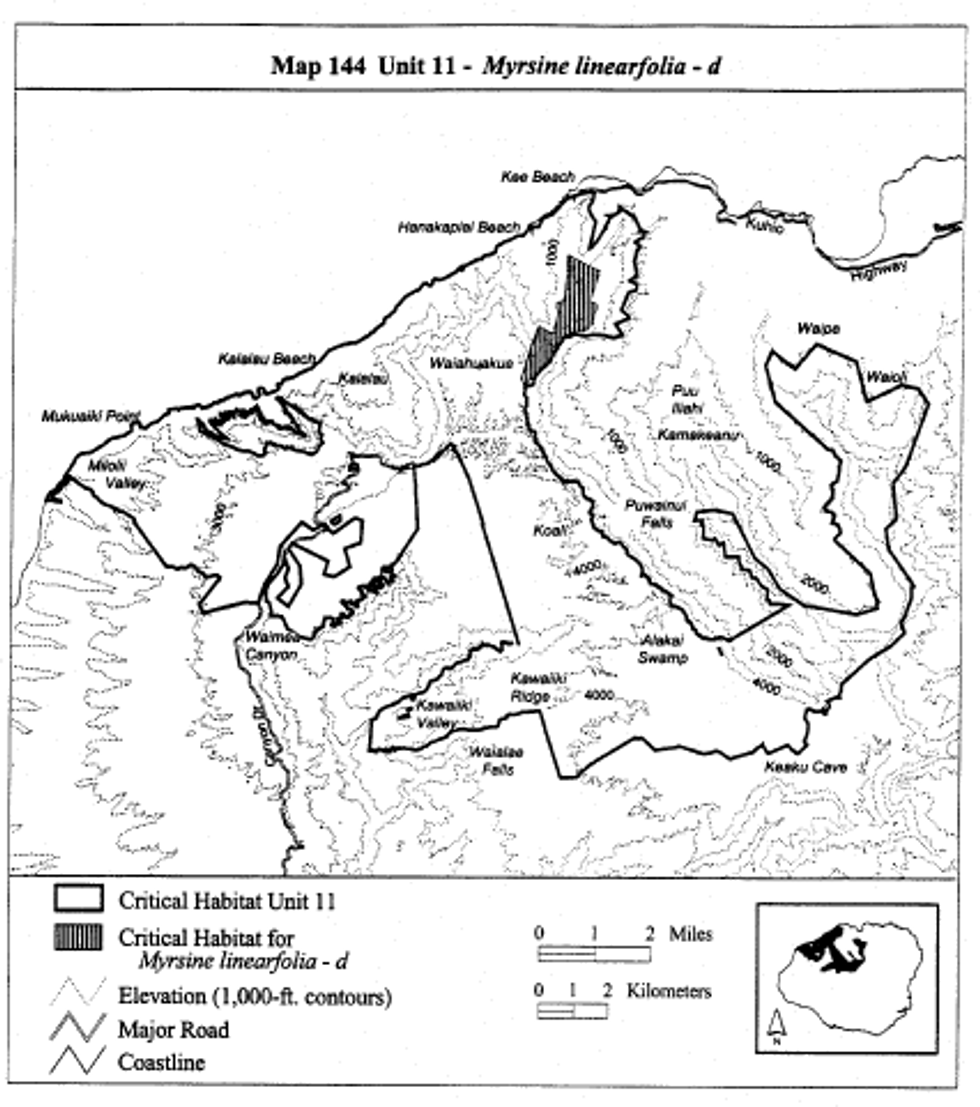
(cclvi) Kauai 11 - Myrsine linearifolia - e (346 ha; 854 ac)
(A) [Reserved]
(B) Excluding 1 area bounded by the following 11 points (<1 ha, 1 ac): Start at 434908, 2449290; 434890, 2449251; 434848, 2449239; 434839, 2449258; 434834, 2449277; 434833, 2449281; 434881, 2449297; 435011, 2449352; 435005, 2449310; 434948, 2449300; 434908, 2449290; return to starting point.
(C) Map 145 follows:
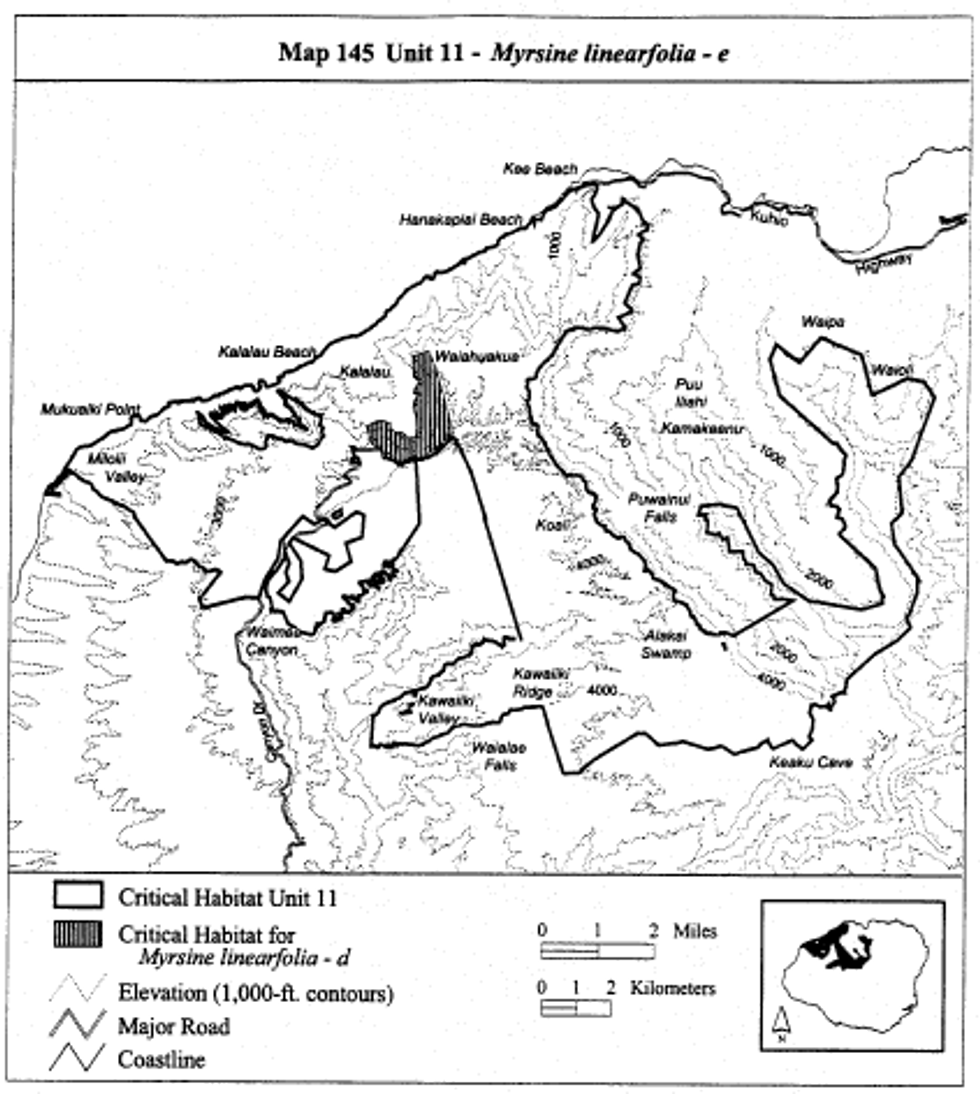
(cclvii) Kauai 11 - Myrsine linearifolia - f (135 ha; 334 ac)
(A) [Reserved]
(B) Map 146 follows:
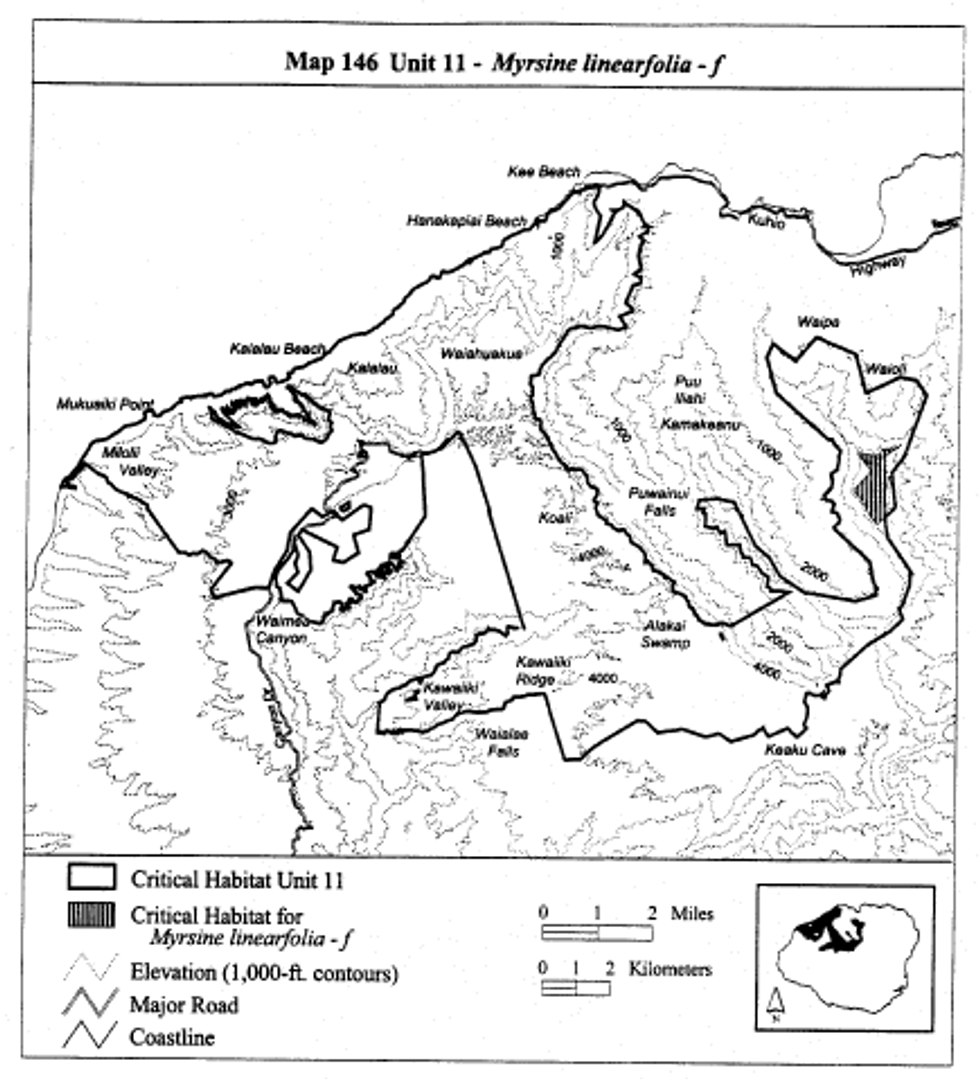
(cclviii) Kauai 11-Myrsine mezii-b
(A) [Reserved]
(B) See paragraph (a)(1)(cxxx)(B) of this section for the map of this unit.
(cclix) Kauai 11-Myrsine mezii-c
(A) [Reserved]
(B) See paragraph (a)(1)(cxlvi)(B) of this section for the map of this unit.
(cclx) Kauai 11 - Nothocestrum peltatum - a (427 ha; 1,056 ac)
(A) [Reserved]
(B) Map 147 follows:
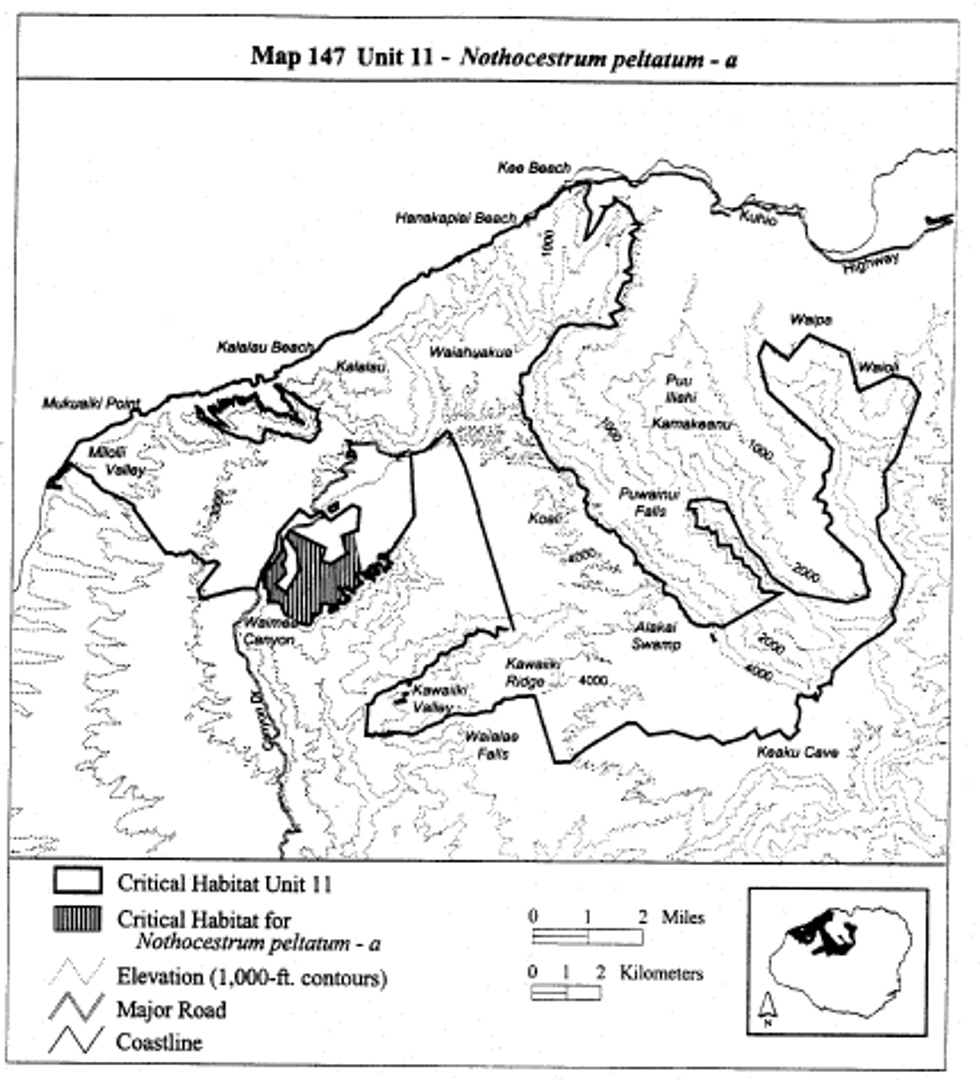
(cclxi) Kauai 11 - Nothocestrum peltatum - b (1,464 ha; 3,617 ac)
(A) [Reserved]
(B) Excluding 1 area bounded by the following 4 points (3 ha, 8 ac): Start at 433109, 2447775; 432932, 2447668; 432827, 2447751; 433094, 2447922; return to starting point.
(C) Map 148 follows:
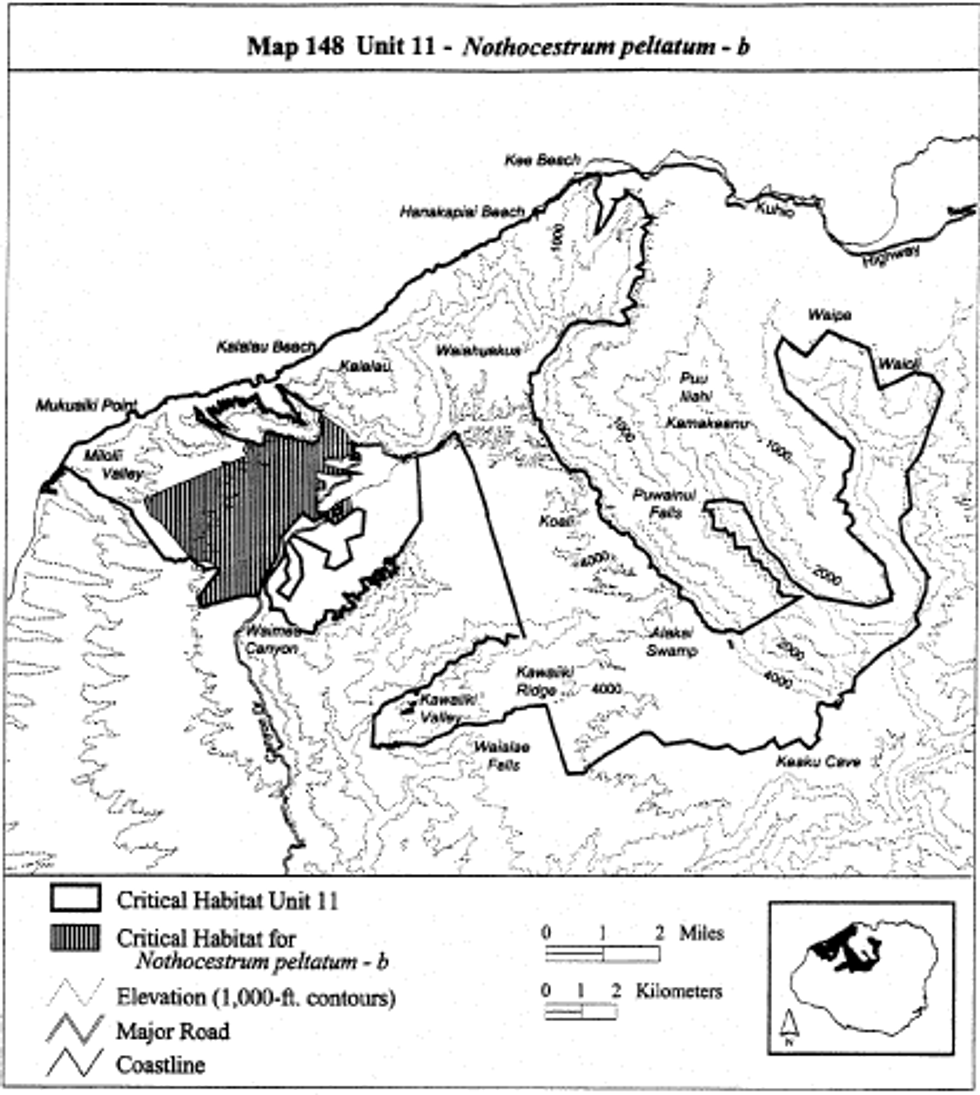
(cclxii) Kauai 11 - Nothocestrum peltatum - c (80 ha; 198 ac)
(A) [Reserved]
(B) Map 149 follows:
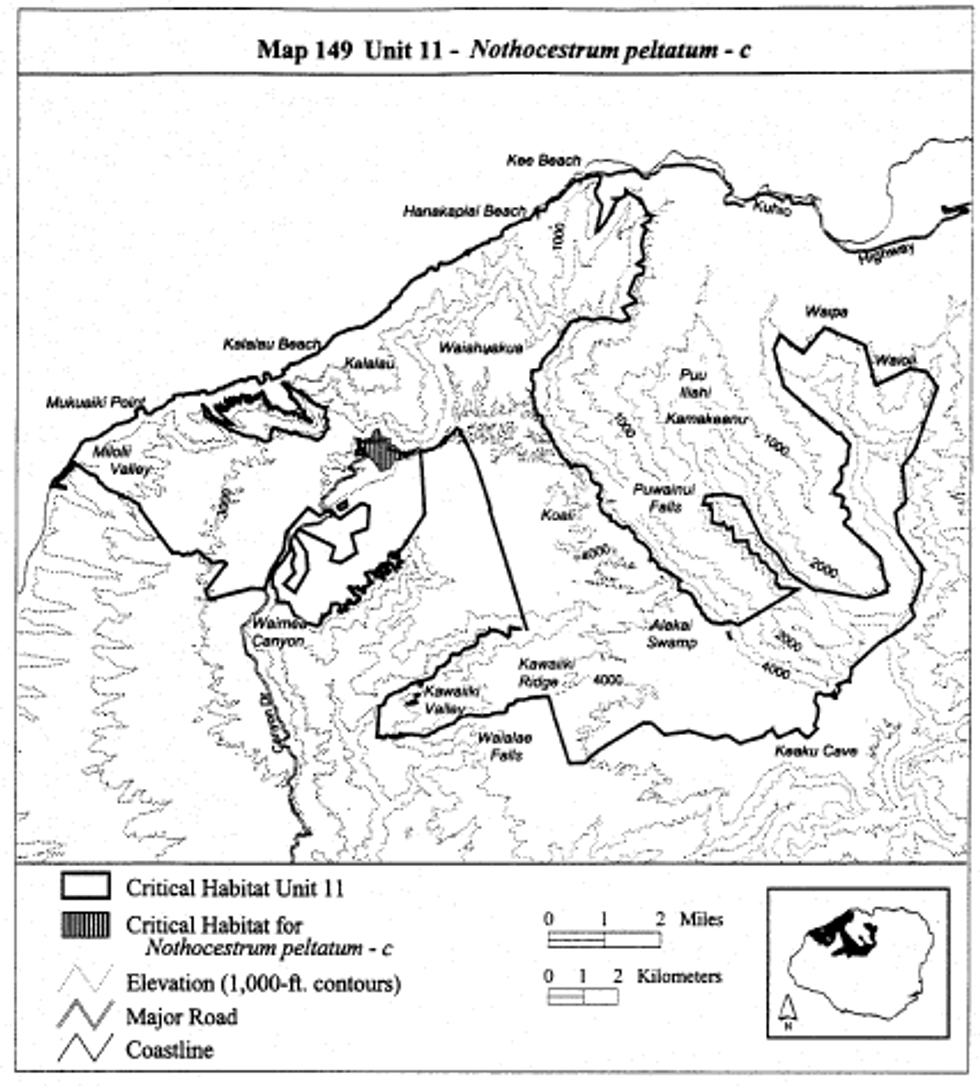
(cclxiii) Kauai 11 - Peucedanum sandwicense - b (579 ha; 1,430 ac)
(A) [Reserved]
(B) Map 150 follows:
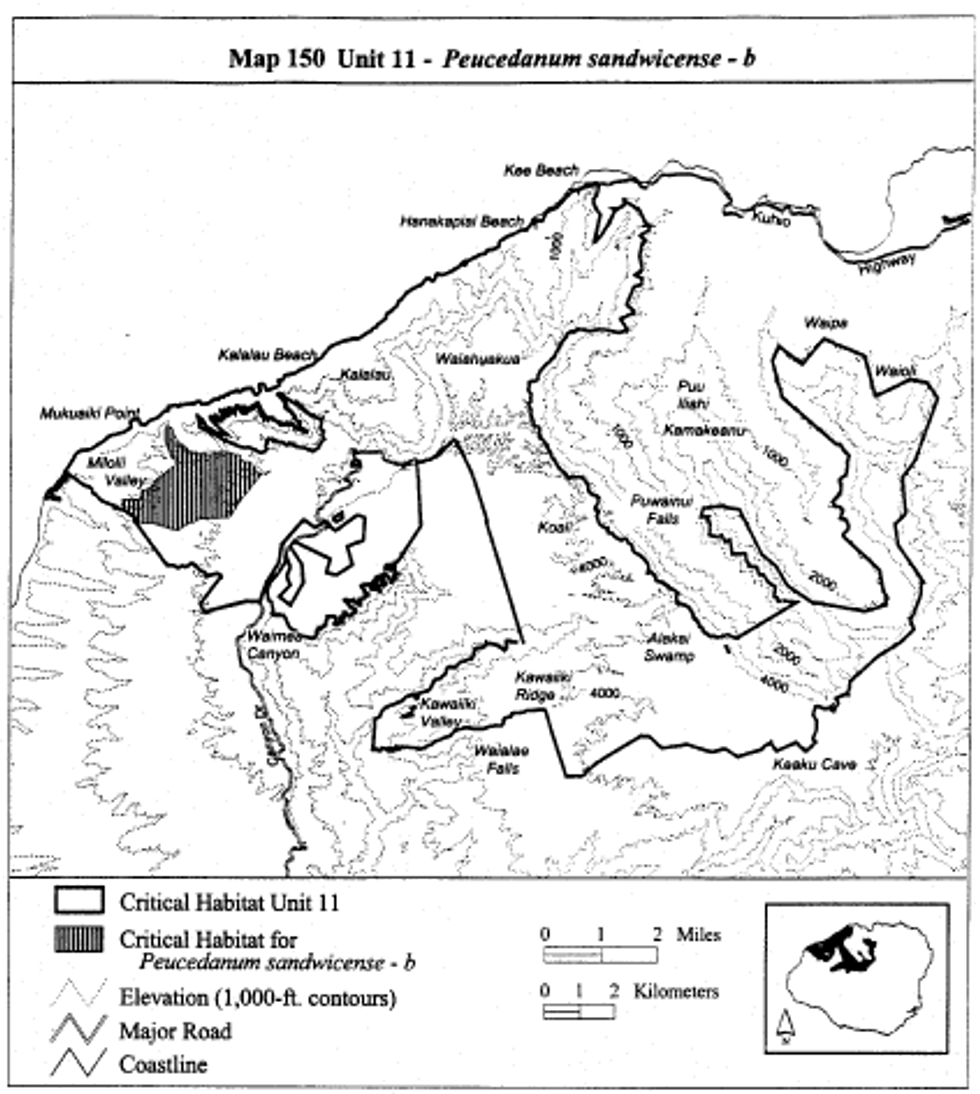
(cclxiv) Kauai 11 - Peucedanum sandwicense - c (181 ha; 447 ac)
(A) [Reserved]
(B) Map 151 follows:
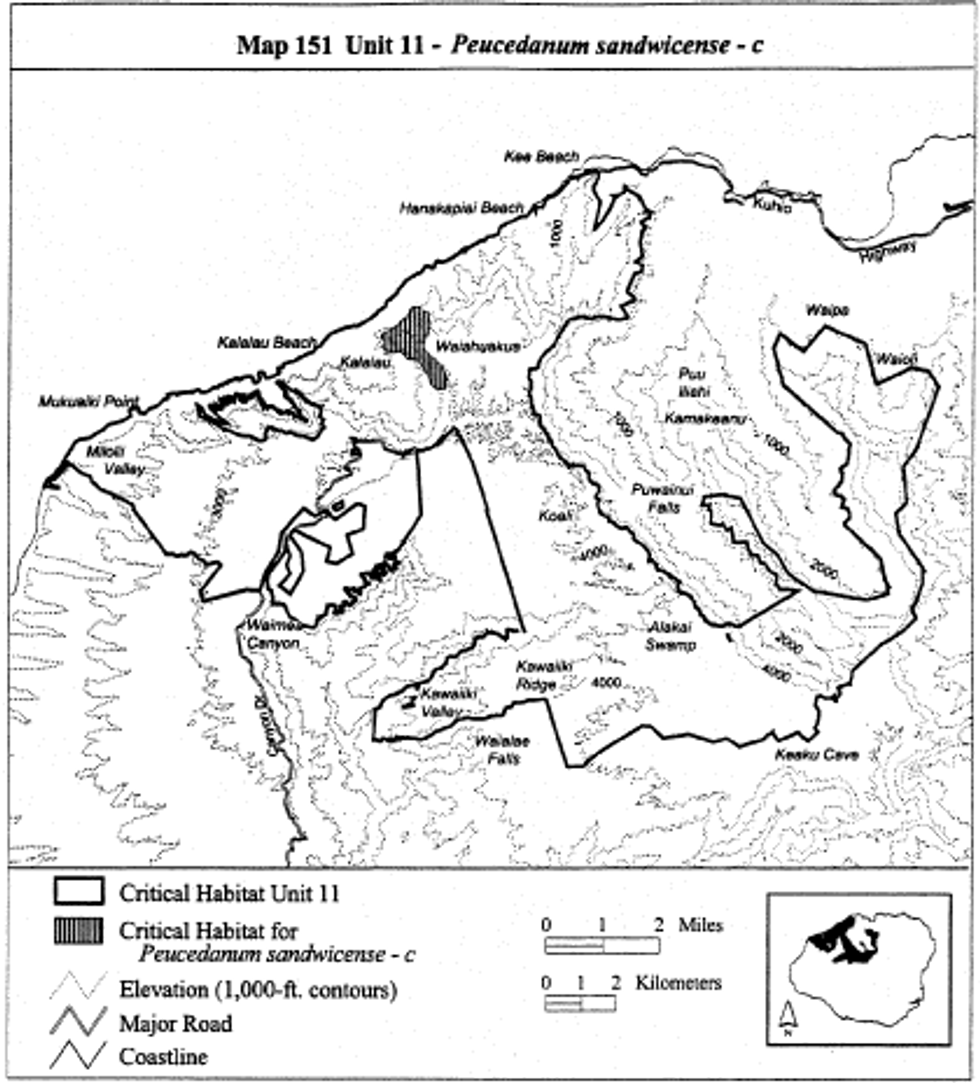
(cclxv) Kauai 11 - Phyllostegia knudsenii - a (297 ha, 735 ac)
(A) [Reserved]
(B) Map 152 follows:
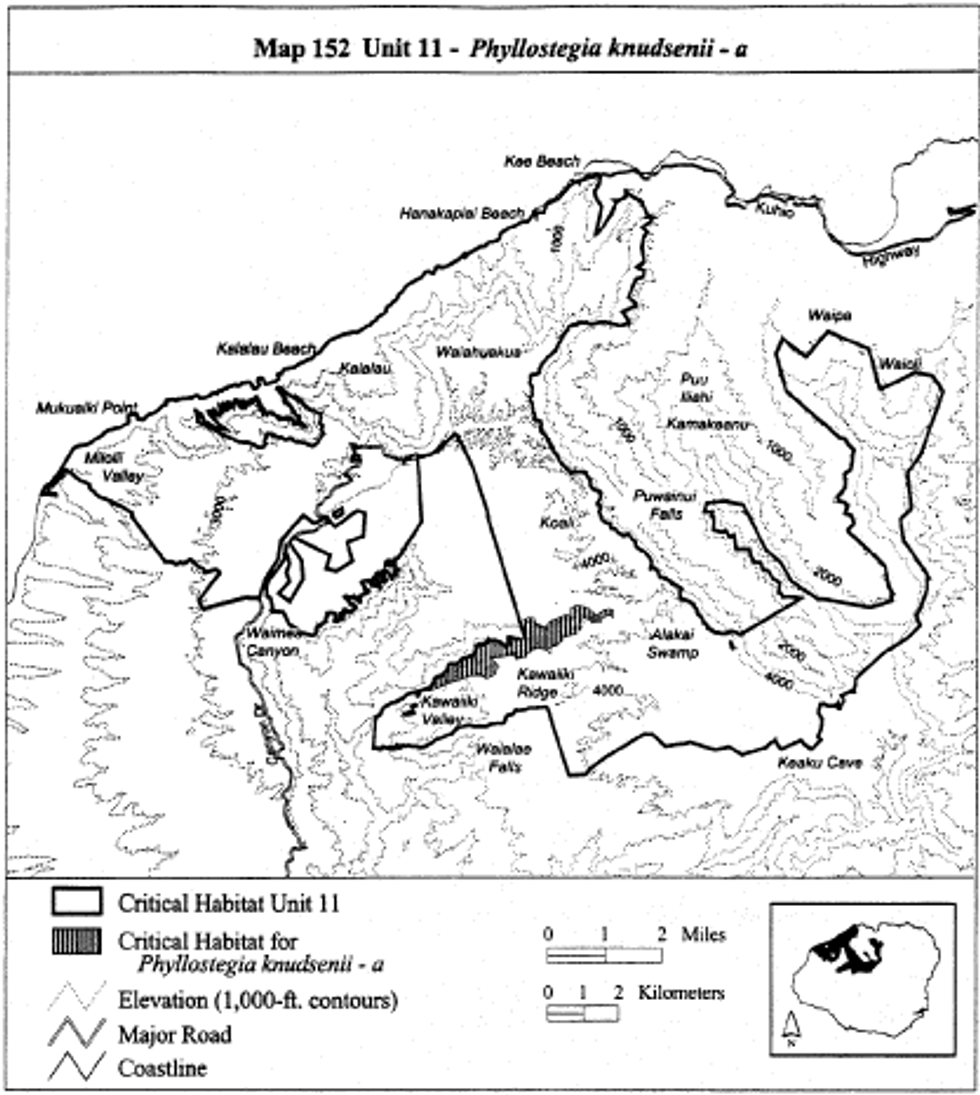
(cclxvi) Kauai 11-Phyllostegia renovans-c
(A) [Reserved]
(B) See paragraph (a)(1)(cxxx)(B) of this section for the map of this unit.
(cclxvii) Kauai 11-Phyllostegia renovans-d
(A) [Reserved]
(B) See paragraph (a)(1)(cxl)(B) of this section for the map of this unit.
(cclxviii) Kauai 11 - Phyllostegia waimeae - a (364 ha; 901 ac)
(A) [Reserved]
(B) Map 153 follows:
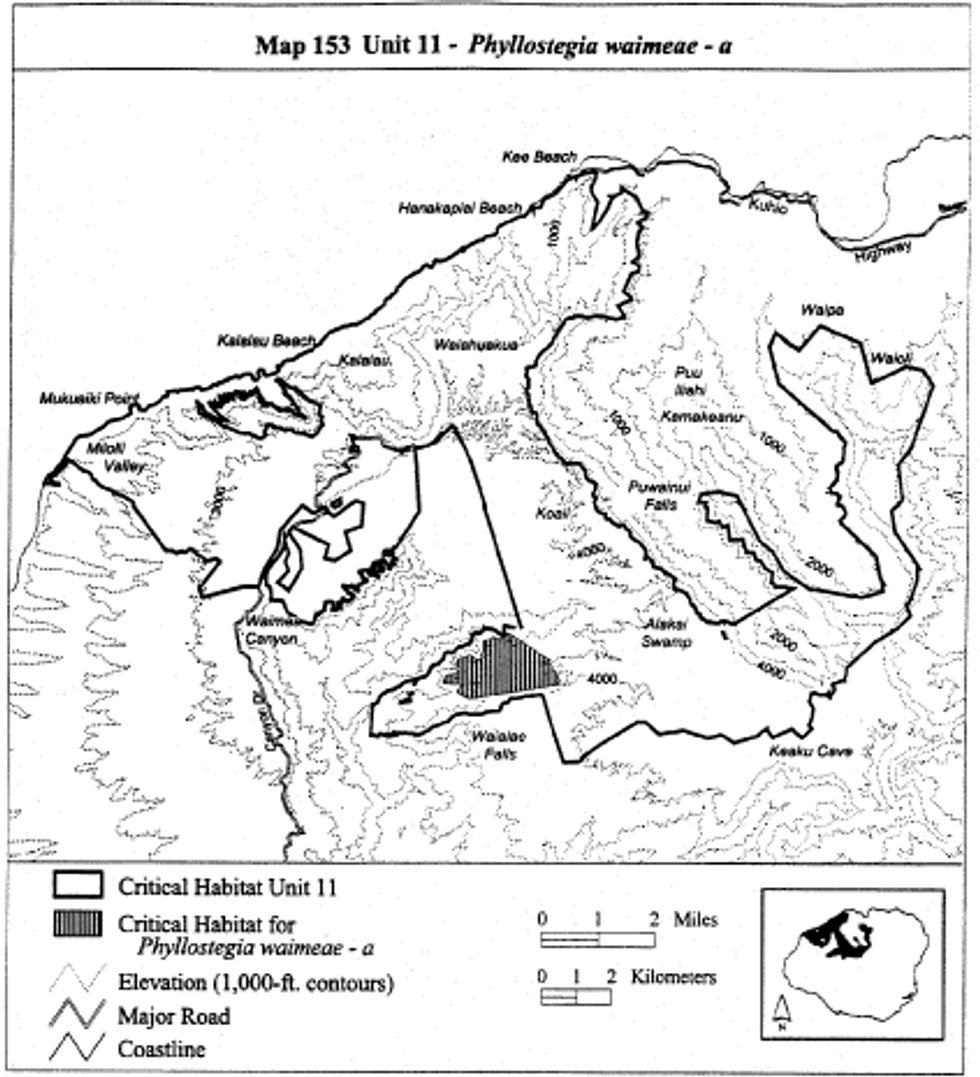
(cclxix) Kauai 11 - Phyllostegia wawrana - b (1,037 ha; 2,562 ac)
(A) [Reserved]
(B) Map 154 follows:
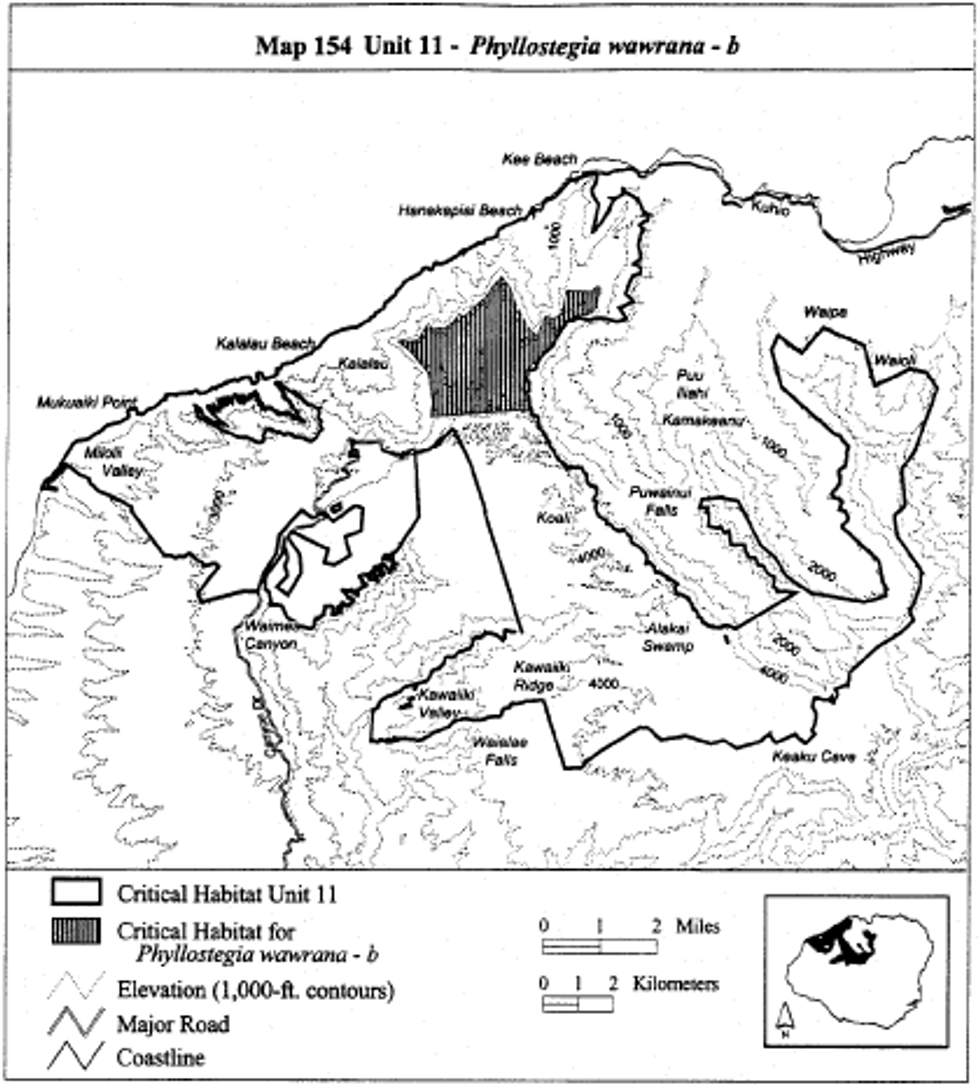
(cclxx) Kauai 11 - Phyllostegia wawrana - c (108 ha; 268 ac)
(A) [Reserved]
(B) Map 155 follows:
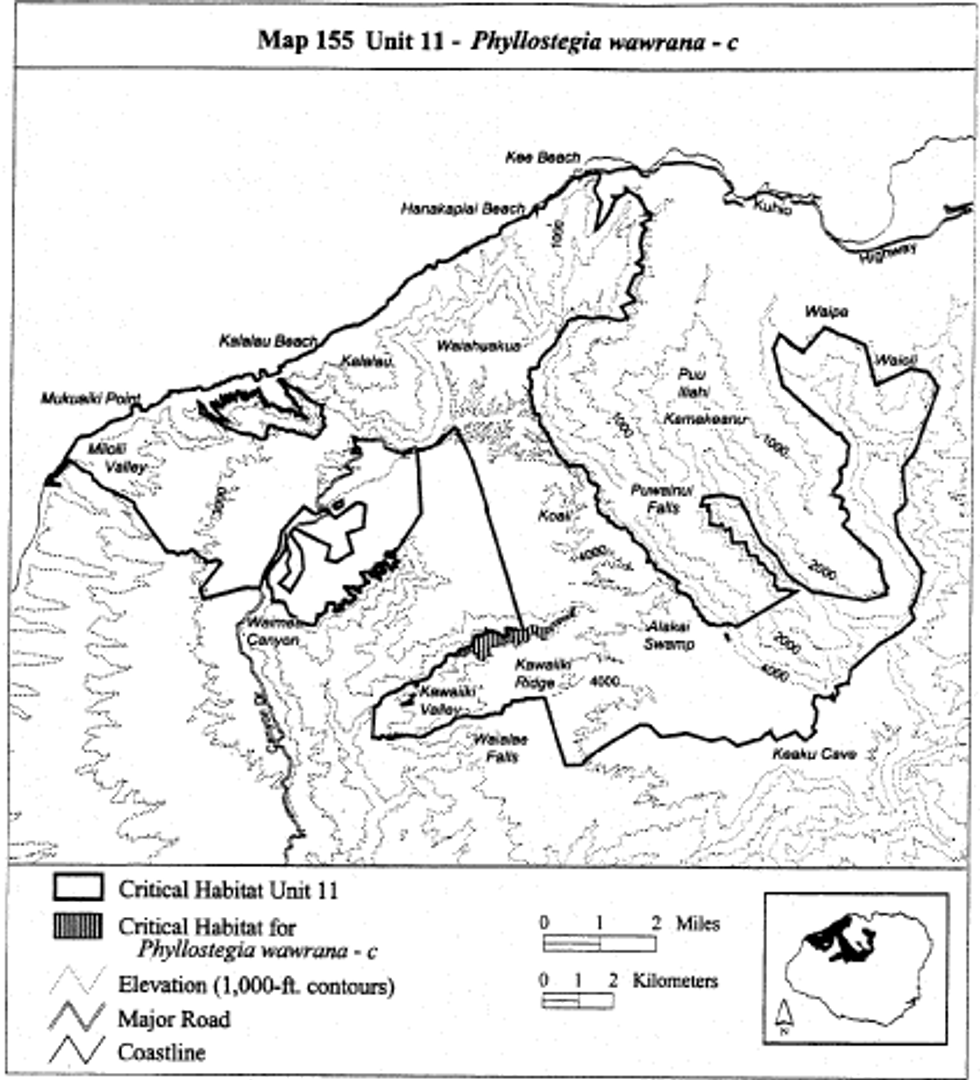
(cclxxi) Kauai 11 - Phyllostegia wawrana - d (251 ha; 619 ac)
(A) [Reserved]
(B) Excluding 1 area bounded by the following 10 points (3 ha, 8 ac): Start at 433368, 2449292; 433367, 2449352; 433448, 2449426; 433546, 2449412; 433567, 2449398; 433589, 2449323; 433612, 2449262; 433588, 2449244; 433567, 2449260; 433369, 2449255; return to starting point.
(C) Map 156 follows:
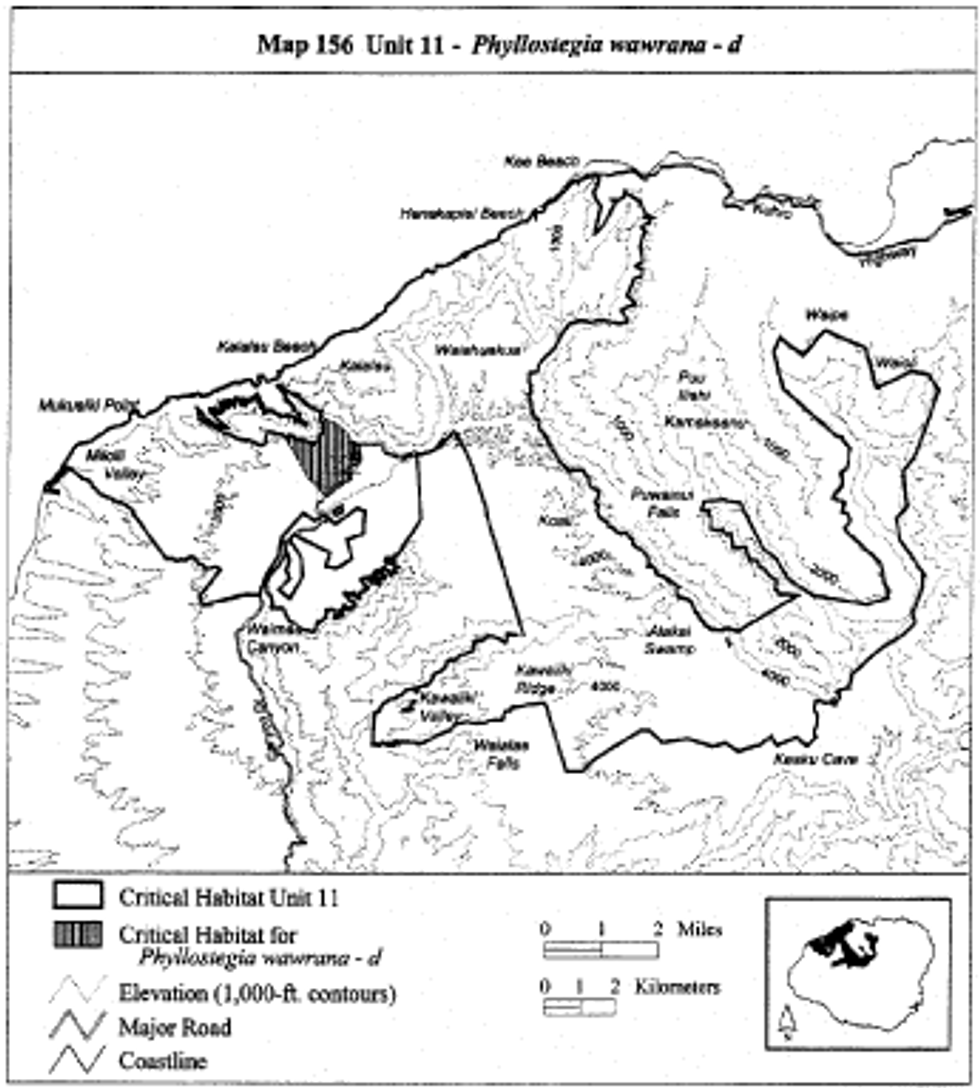
(cclxxii) Kauai 11-Pittosporum napaliense-b
(A) [Reserved]
(B) See paragraph (a)(1)(cxxxiii)(B) of this section for the map of this unit.
(cclxxiii) Kauai 11 - Plantago princeps - b (126 ha; 312 ac)
(A) [Reserved]
(B) Map 157 follows:

(cclxxiv) Kauai 11 - Plantago princeps - c (244 ha; 603 ac)
(A) [Reserved]
(B) Map 158 follows:
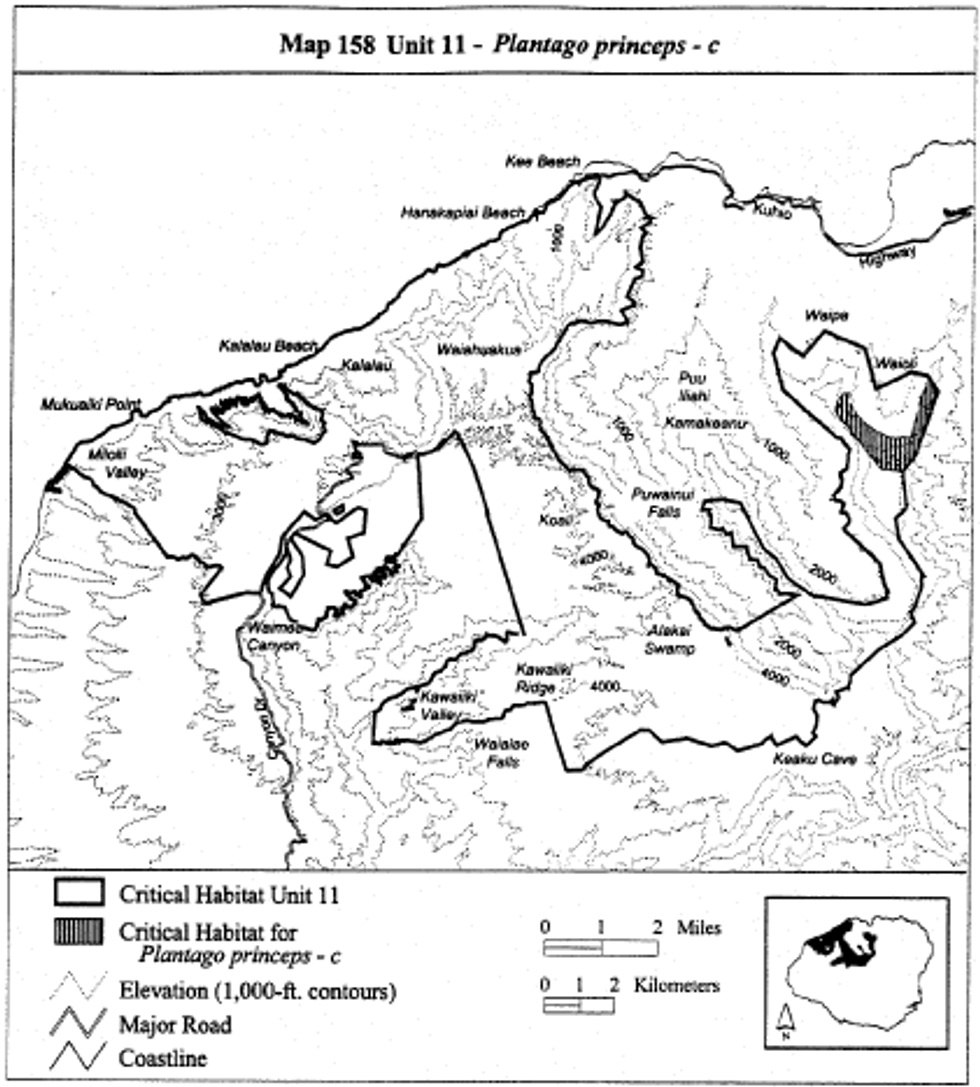
(cclxxv) Kauai 11 - Plantago princeps - d (77 ha; 189 ac)
(A) [Reserved]
(B) Map 159 follows:
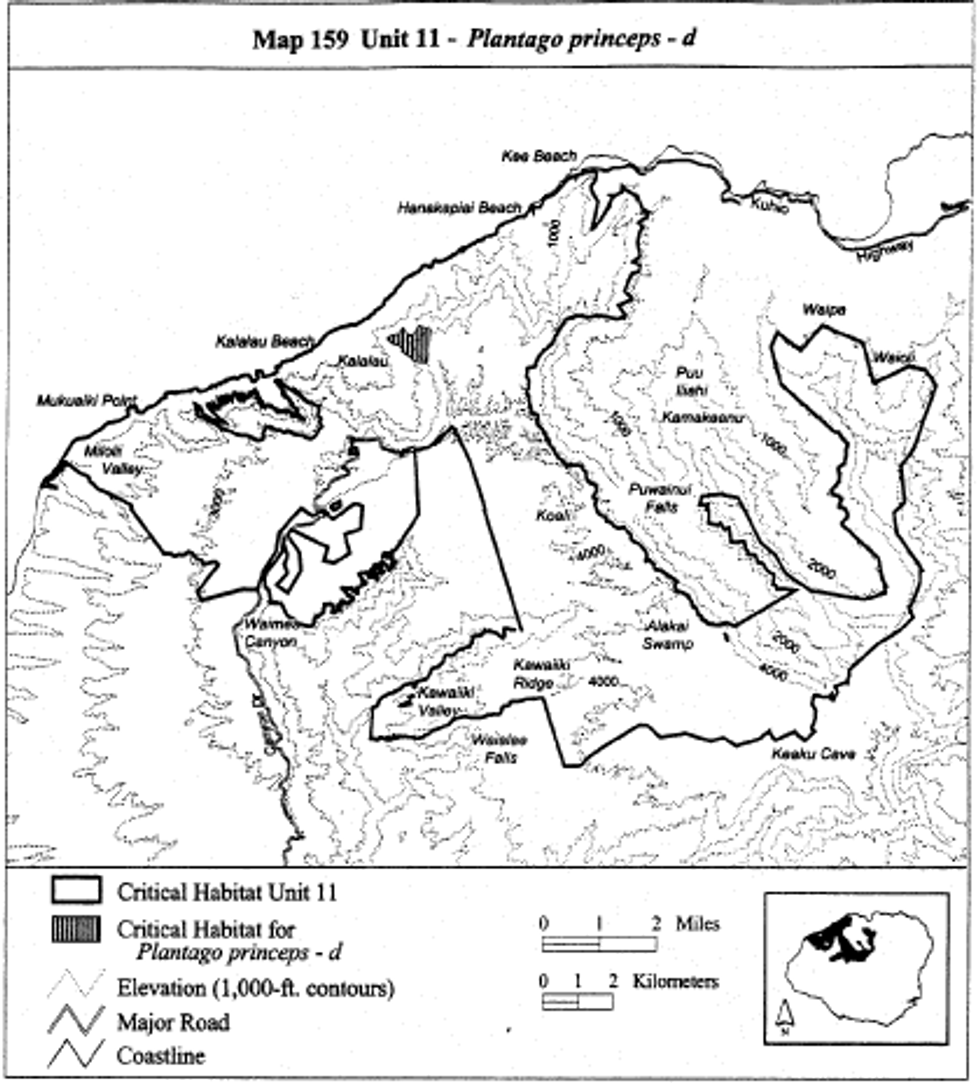
(cclxxvi) Kauai 11 - Platanthera holochila - a (4,149 ha; 10,253 ac)
(A) [Reserved]
(B) Map 160 follows:
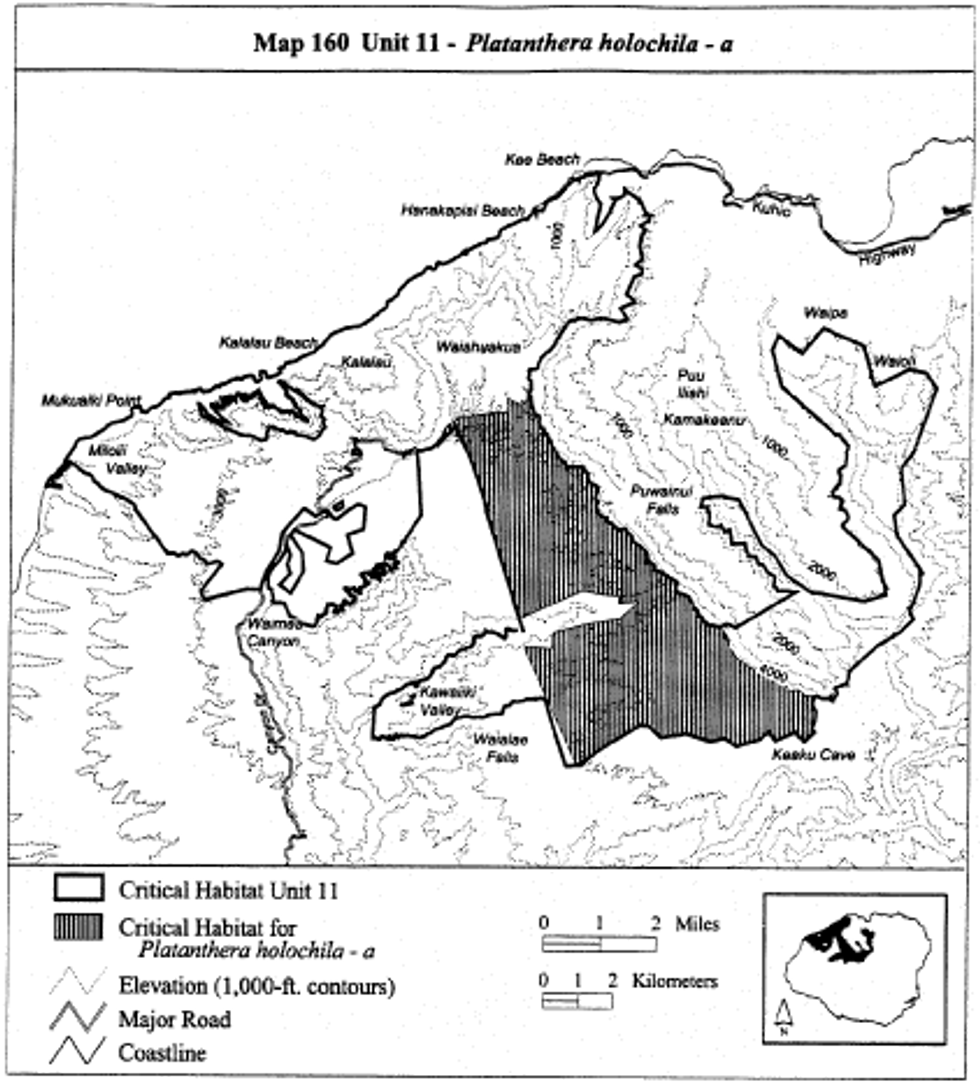
(cclxxvii) Kauai 11- Melicope rostrata -f
(A) [Reserved]
(B) See paragraph (a)(1)(cxxx)(B) of this section for the map of this unit.
(cclxxviii) Kauai 11-Platydesma rostrata-g
(A) [Reserved]
(B) See paragraph (a)(1)(cxxxiii)(B) of this section for the map of this unit.
(cclxxix) Kauai 11- Melicope rostrata -h
(A) [Reserved]
(B) See paragraph (a)(1)(cxl)(B) of this section for the map of this unit.
(cclxxx) Kauai 11- Melicope rostrata -i
(A) [Reserved]
(B) See paragraph (a)(1)(cxli)(B) of this section for the map of this unit.
(cclxxxi) Kauai 11- Melicope rostrata -j
(A) [Reserved]
(B) See paragraph (a)(1)(cxlvi)(B) of this section for the map of this unit.
(cclxxxii) Kauai 11 - Poa mannii - a (1,871 ha; 4,624 ac)
(A) [Reserved]
(B) Map 161 follows:
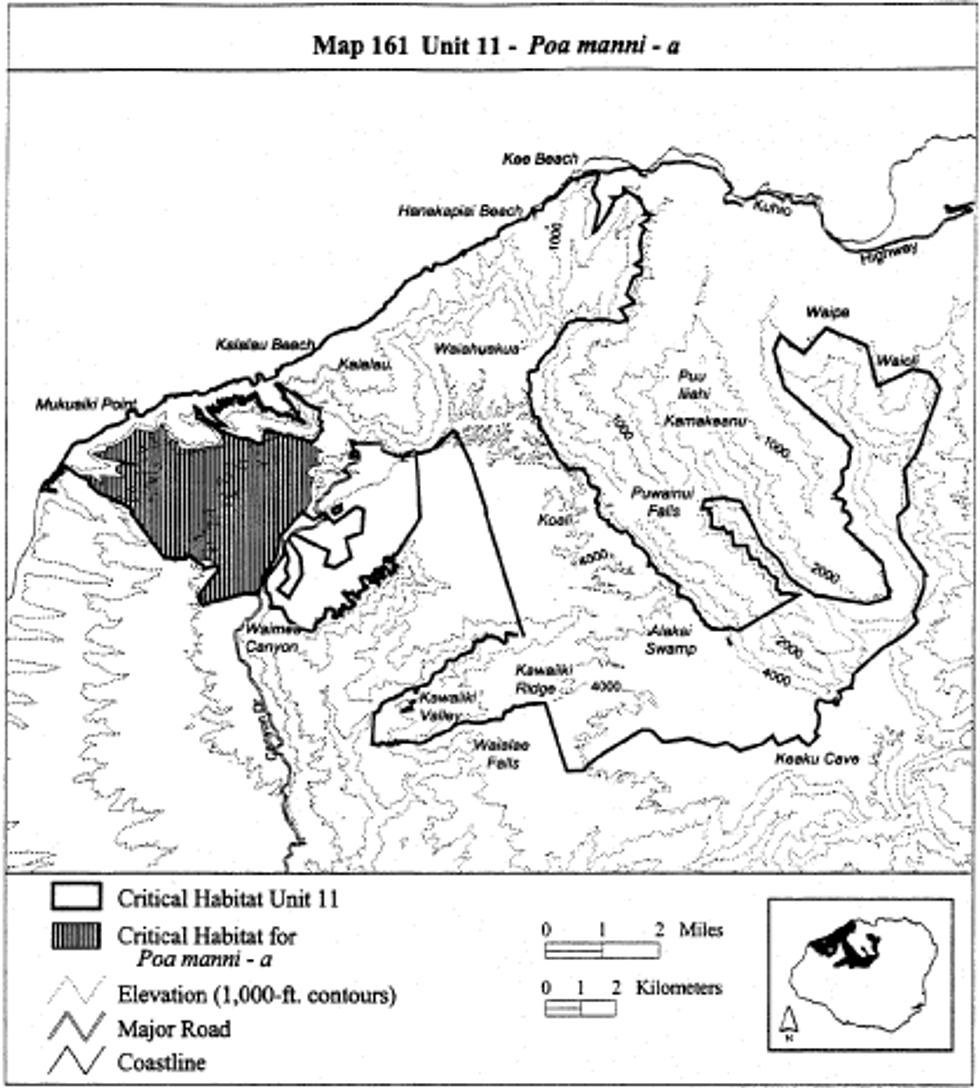
(cclxxxiii) Kauai 11 - Poa mannii - b (677 ha; 1,673 ac)
(A) [Reserved]
(B) Map 162 follows:
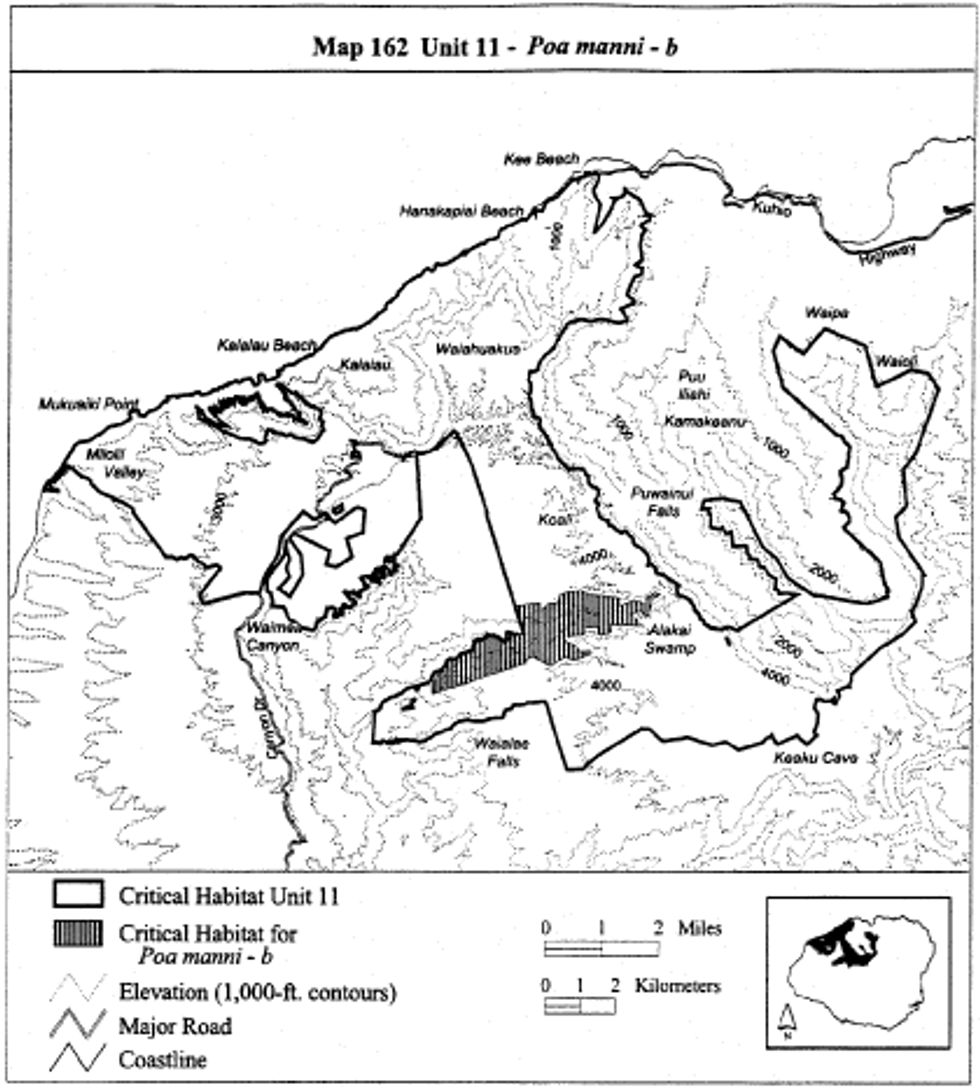
(cclxxxiv) Kauai 11 - Poa mannii - c (155 ha; 382 ac)
(A) [Reserved]
(B) Map 163 follows:
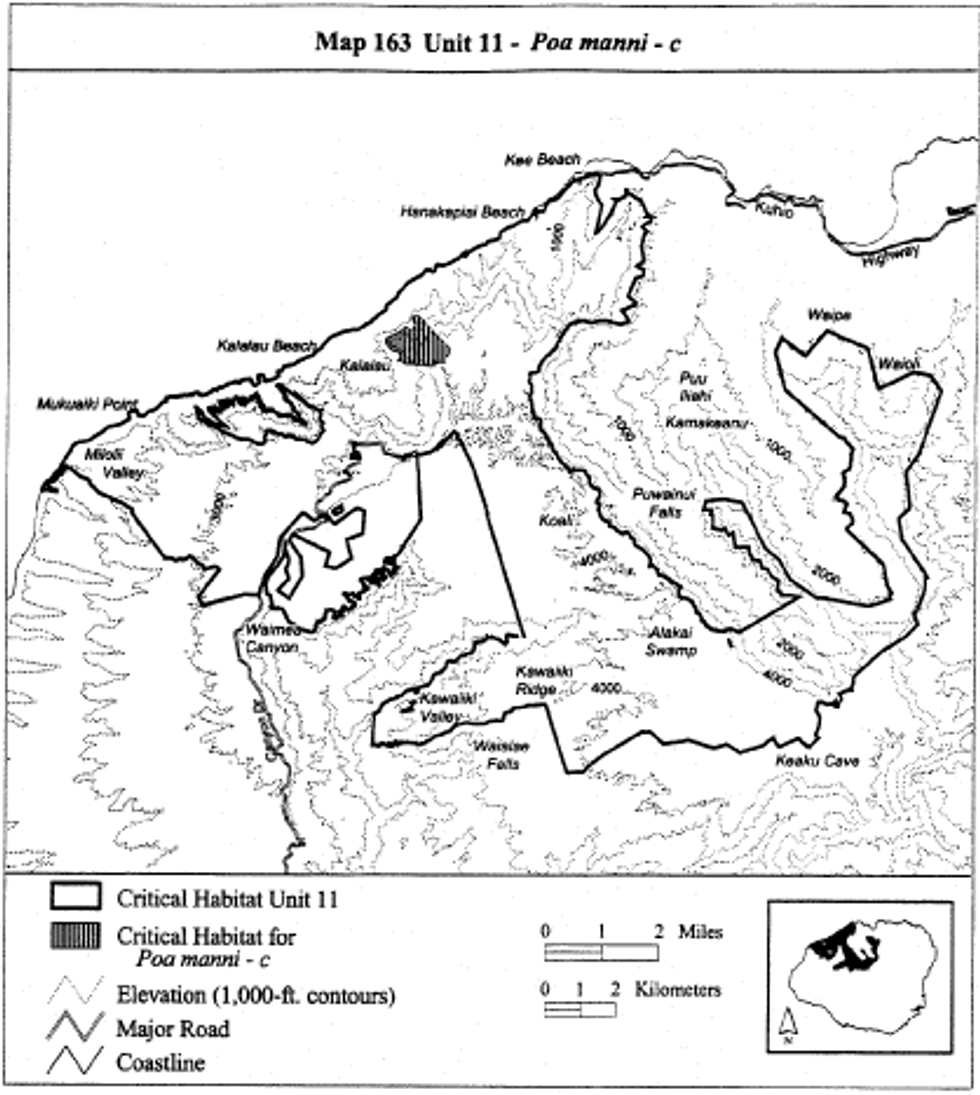
(cclxxxv) Kauai 11 - Poa mannii - d (307 ha; 758 ac)
(A) [Reserved]
(B) Map 164 follows:
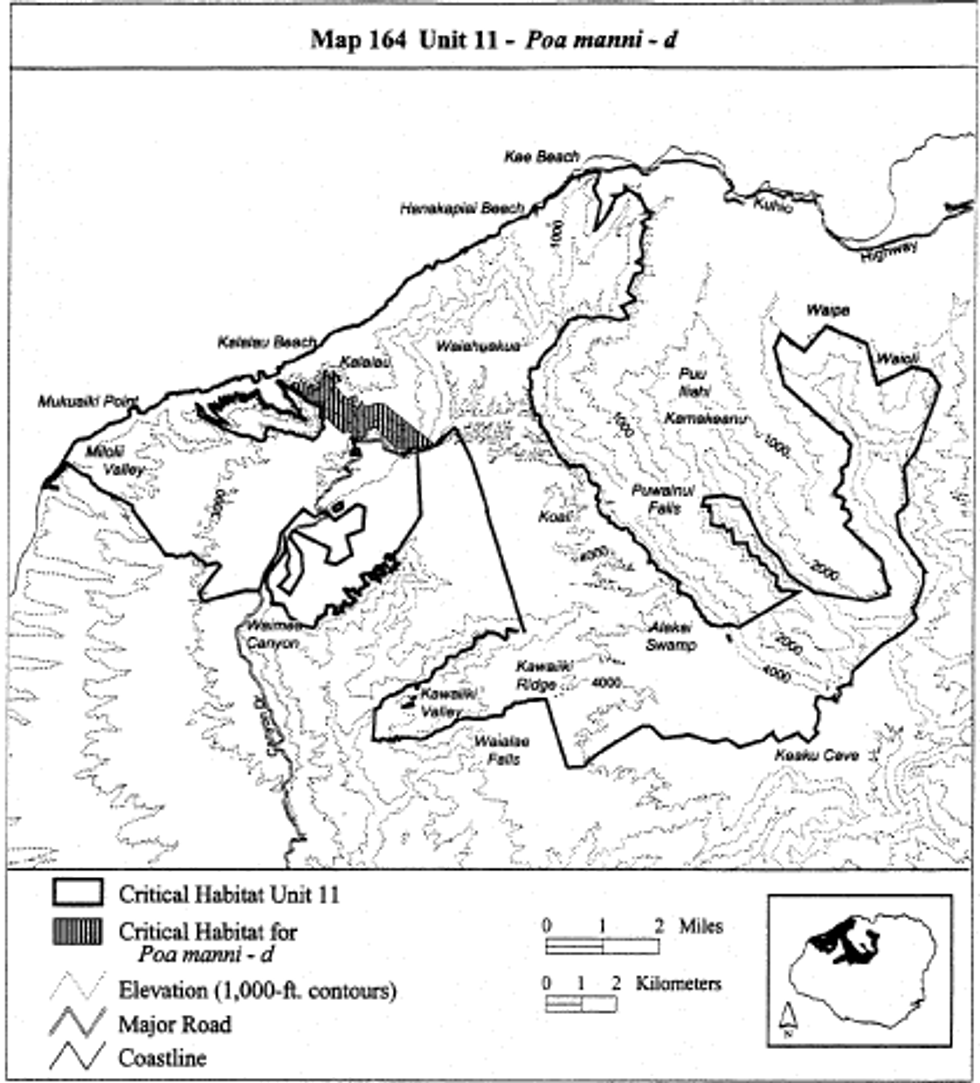
(cclxxxvi) Kauai 11 - Poa sandvicensis - a (1,111 ha; 2,745 ac)
(A) [Reserved]
(B) Map 165 follows:
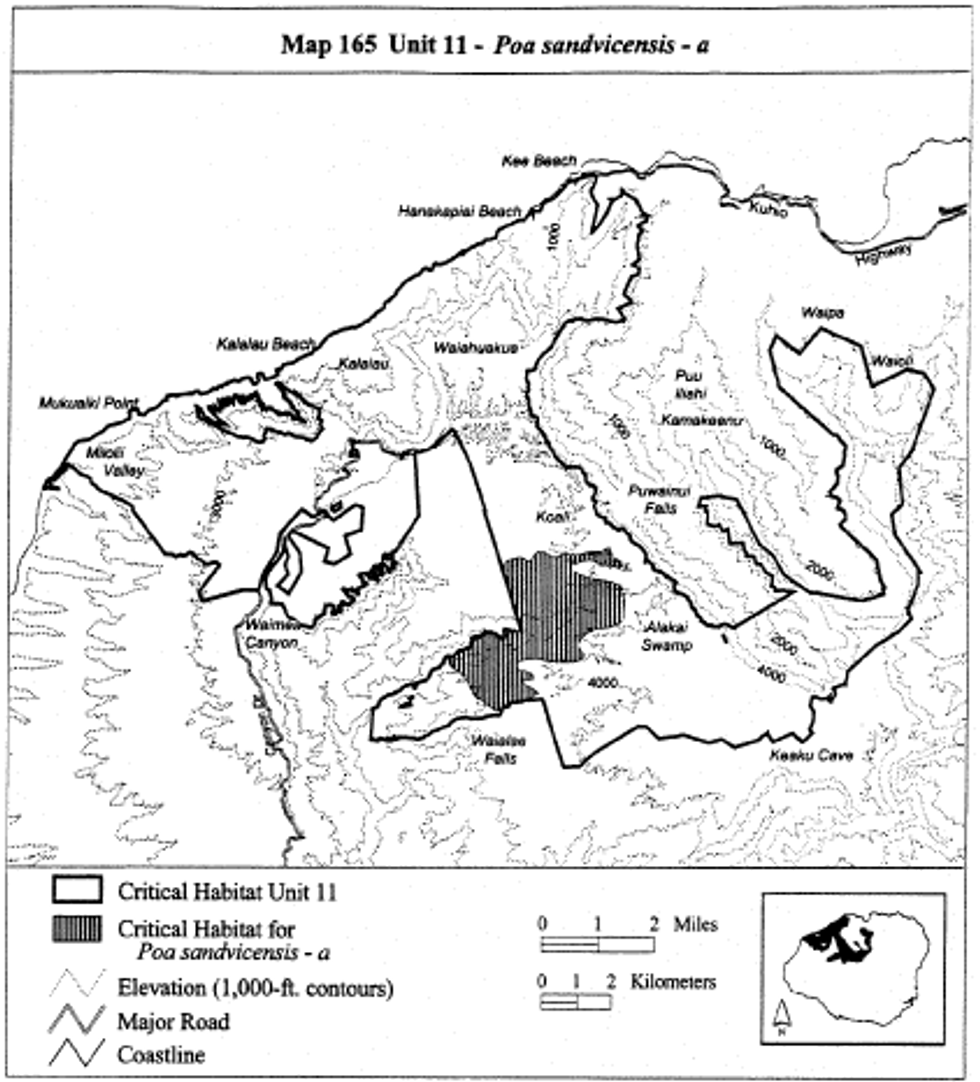
(cclxxxvii) Kauai 11 - Poa sandvicensis - b (52 ha; 129 ac)
(A) [Reserved]
(B) Map 166 follows:
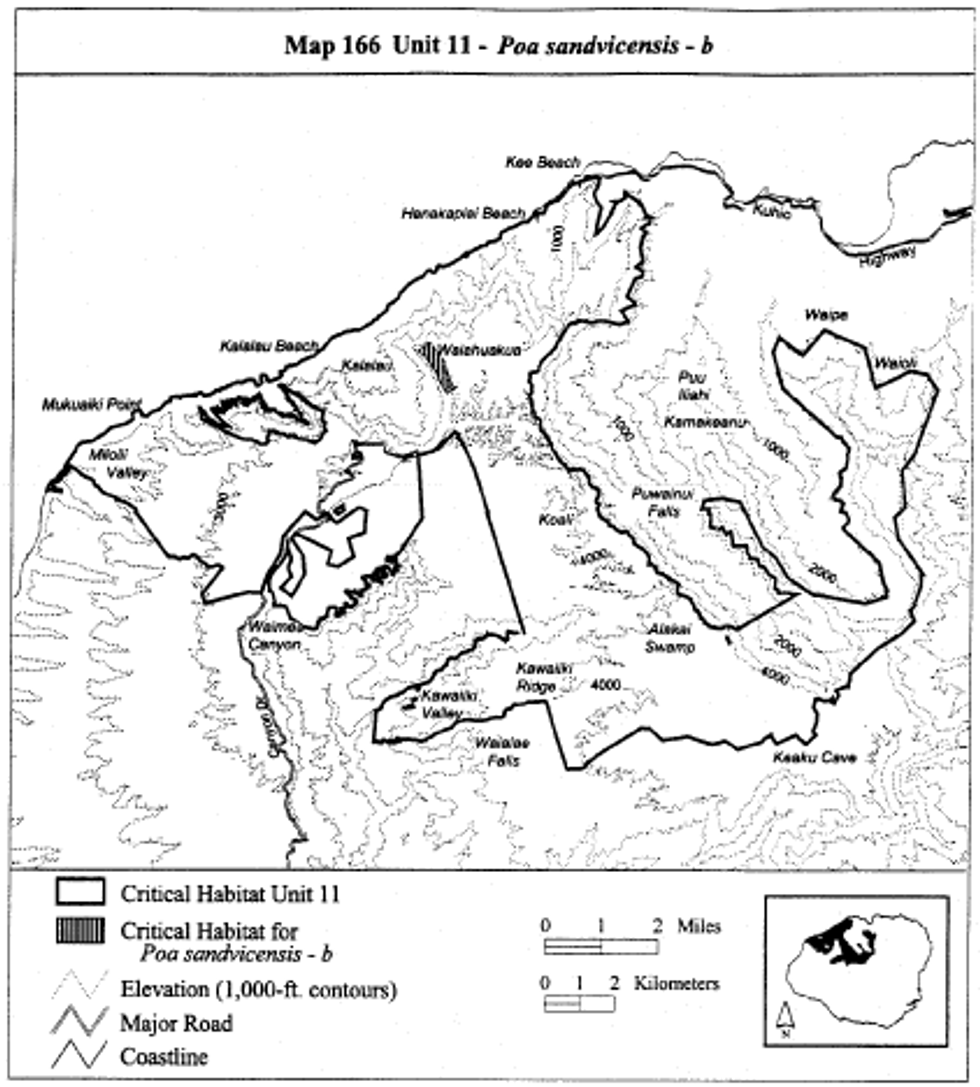
(cclxxxviii) Kauai 11 - Poa siphonoglossa - a (1,621 ha; 4,006 ac)
(A) [Reserved]
(B) Excluding 3 areas:
(1) Bounded by the following 10 points (3 ha, 8 ac): Start at 433368, 2449292; 433367, 2449352; 433448, 2449426; 433546, 2449412; 433567, 2449398; 433589, 2449323; 433612, 2449262; 433588, 2449244; 433567, 2449260; 433369, 2449255; return to starting point; and
(2) Bounded by the following 9 points (1 ha, 2 ac): Start at 433484, 2449703; 433480, 2449629; 433457, 2449622; 433440, 2449604; 433426, 2449556; 433419, 2449599; 433399, 2449709; 433436, 2449707; 433460, 2449707; return to starting point; and
(3) Bounded by the following 11 points (1 ha, 1 ac): Start at 434908, 2449290; 434890, 2449251; 434848, 2449239; 434839, 2449258; 434834, 2449277; 434833, 2449281; 434881, 2449297; 435011, 2449352; 435005, 2449310; 434948, 2449300; 434908, 2449290; return to starting point.
(C) Map 167 follows:
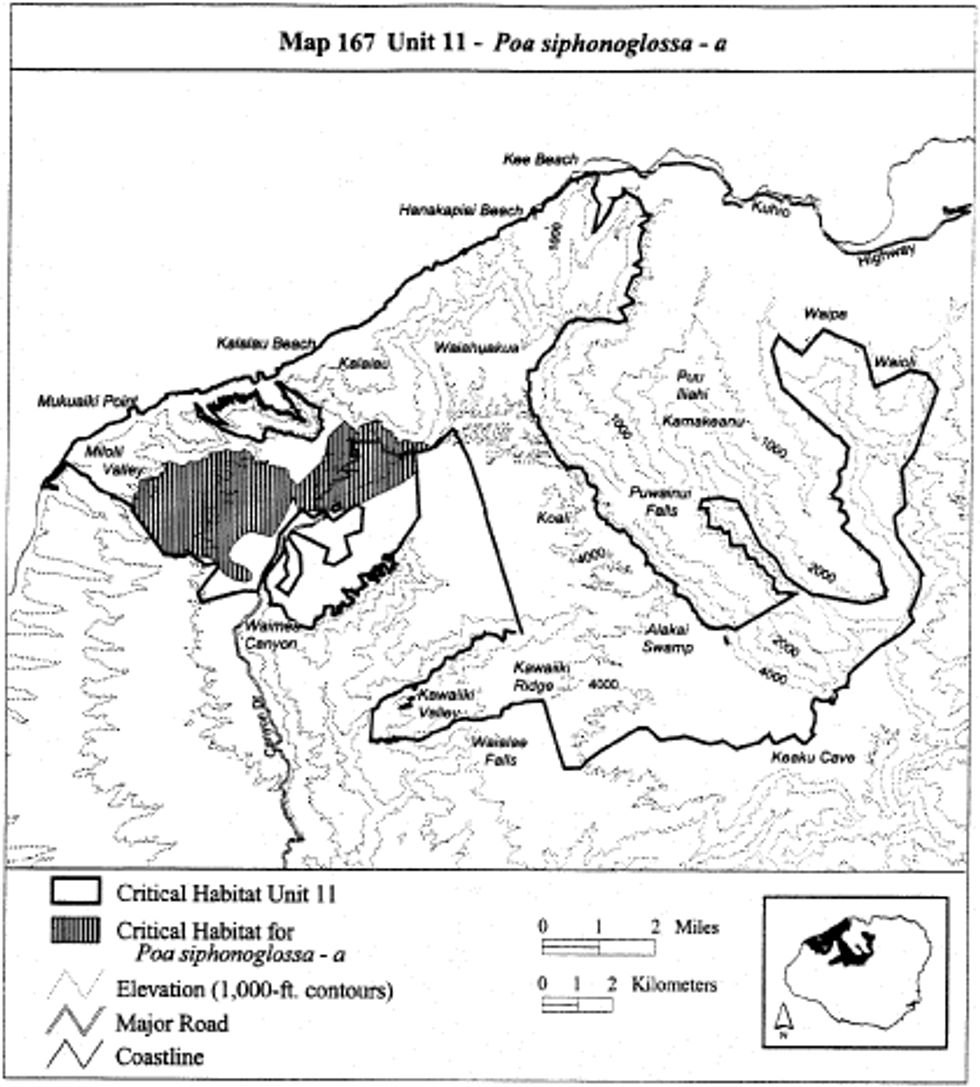
(cclxxxix) Kauai 11 - Poa siphonoglossa - b (2,190 ha; 5,411 ac)
(A) [Reserved]
(B) Map 168 follows:
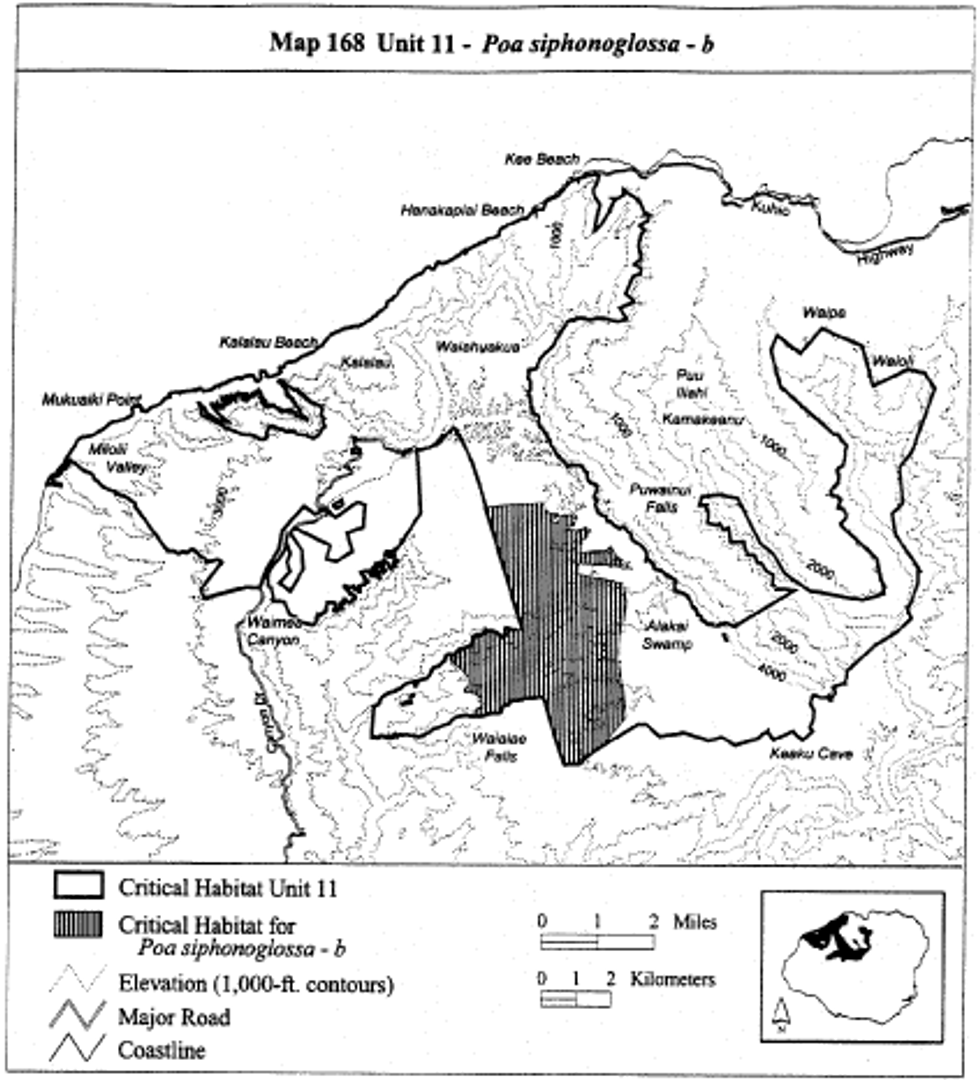
(ccxc) Kauai 11-Psychotria grandiflora-b
(A) [Reserved]
(B) See paragraph (a)(1)(cxxx)(B) of this section for the map of this unit.
(ccxci) Kauai 11-Psychotria grandiflora-c
(A) [Reserved]
(B) See paragraph (a)(1)(cxlvi)(B) of this section for the map of this unit.
(ccxcii) Kauai 11-Psychotria hobdyi-b
(A) [Reserved]
(B) See paragraph (a)(1)(cxxxiii)(B) of this section for the map of this unit.
(ccxciii) Kauai 11 - Pteralyxia kauaiensis - c (209 ha; 516 ac)
(A) [Reserved]
(B) Map 169 follows:
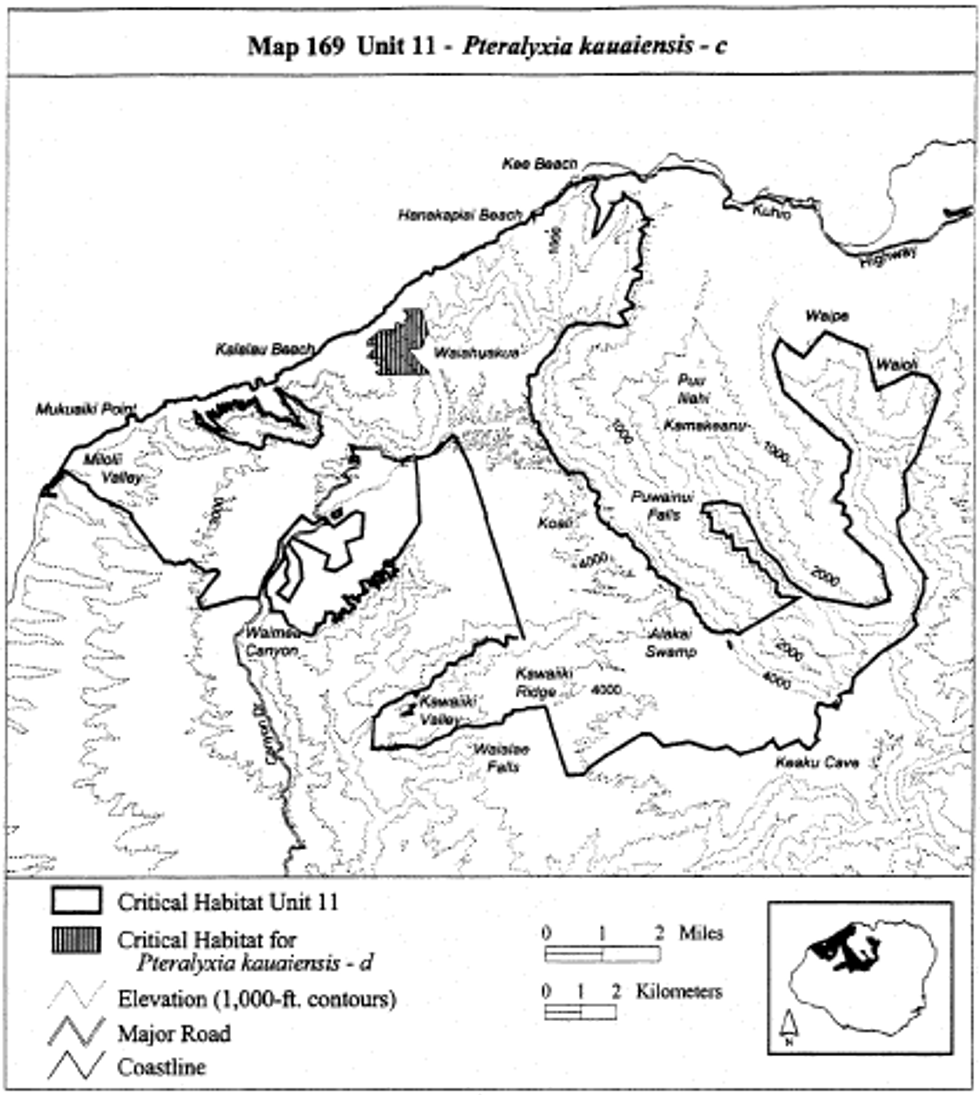
(ccxciv) Kauai 11 - Pteralyxia kauaiensis - d (57 ha; 141 ac)
(A) [Reserved]
(B) Map 170 follows:
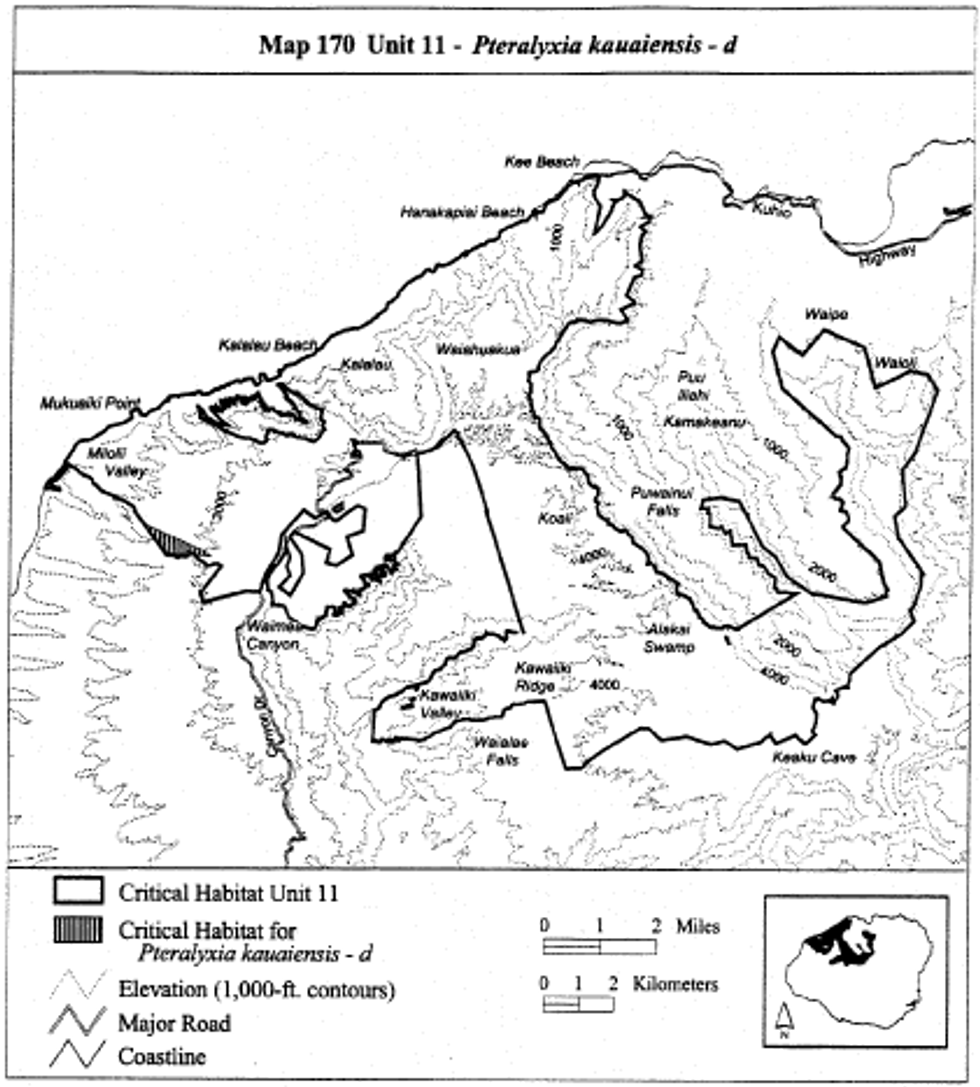
(ccxcv) Kauai 11 - Pteralyxia kauaiensis - e (353 ha; 872 ac)
(A) [Reserved]
(B) Map 171 follows:
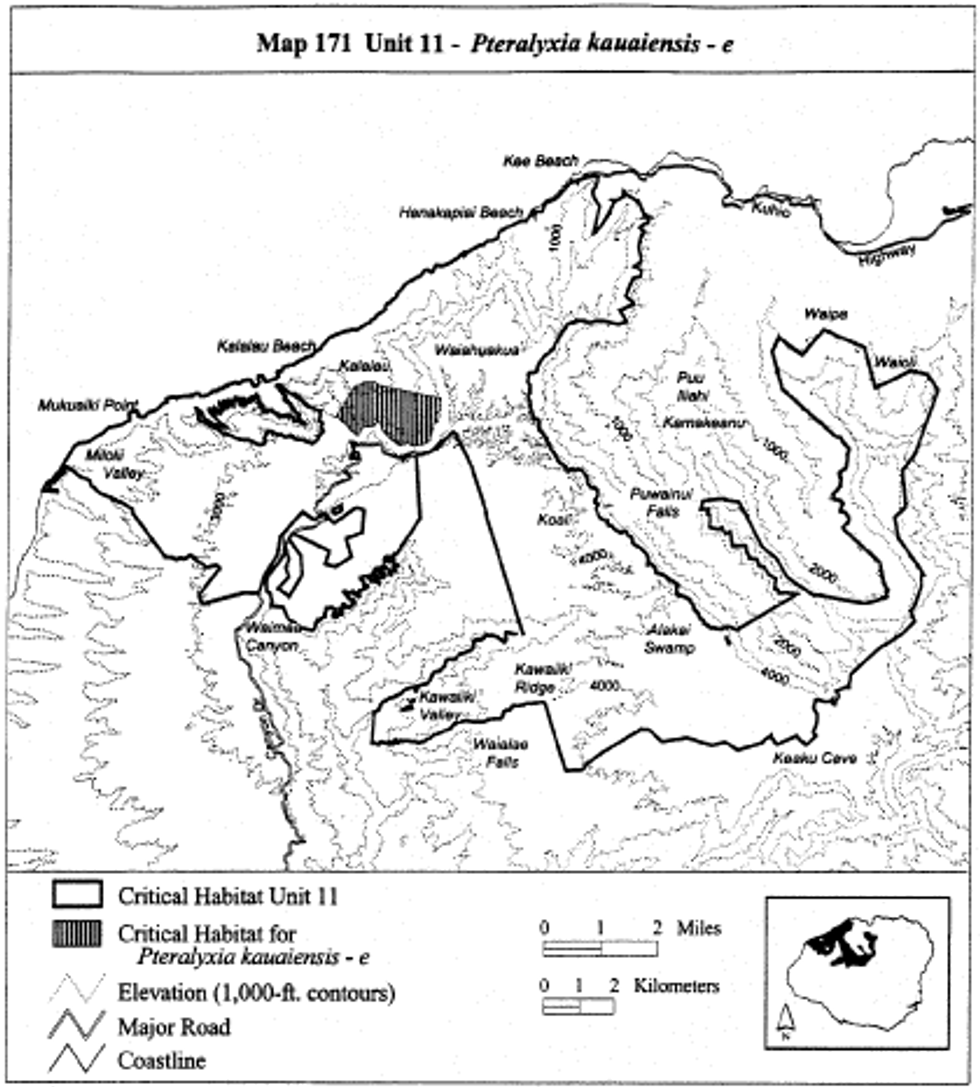
(ccxcvi) Kauai 11 - Pteralyxia kauaiensis - f (589 ha; 1,453 ac)
(A) [Reserved]
(B) Excluding 2 areas:
(1) Bounded by the following 3 points (1 ha; 3 ac): Start at 435132, 2442248; 435160, 2442164; 434848, 2442098; return to starting point; and
(2) Bounded by the following 4 points (0 ha; 1 ac): Start at 435151, 2442425; 435215, 2442393; 435195, 2442353; 435128, 2442379; return to starting point.
(C) Map 172 follows:
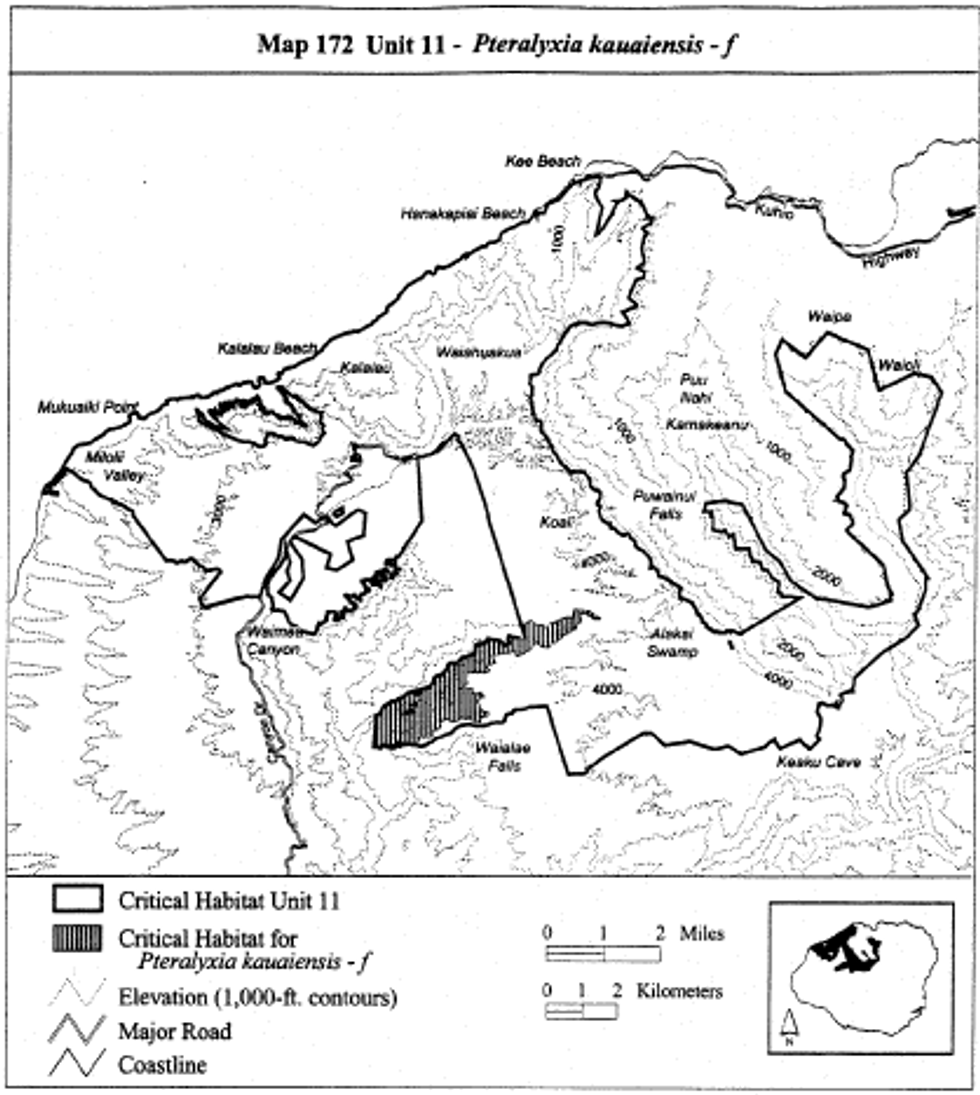
(ccxcvii) Kauai 11 - Pteralyxia kauaiensis - g (445 ha; 1,100 ac)
(A) [Reserved]
(B) Map 173 follows:
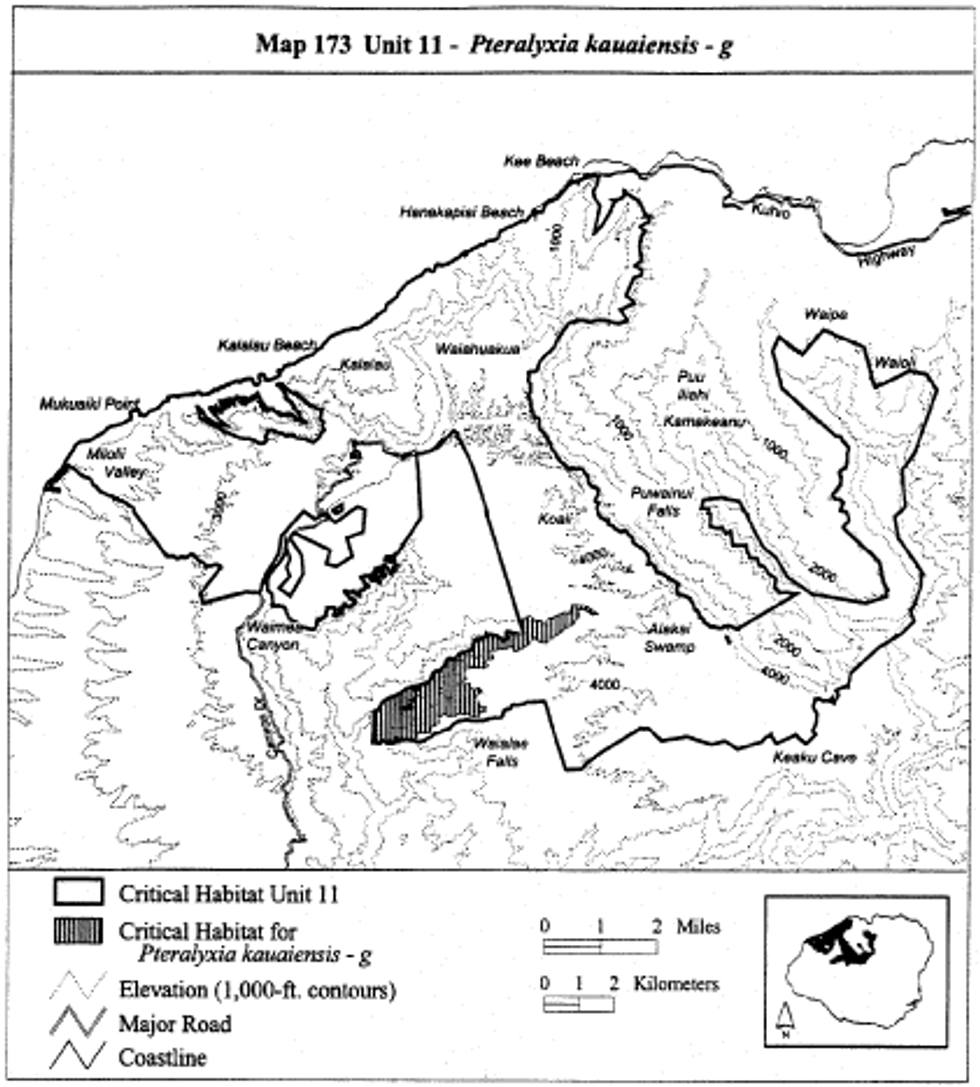
(ccxcviii) Kauai 11 - Remya kauaiensis - a (172 ha; 426 ac)
(A) [Reserved]
(B) Map 174 follows:
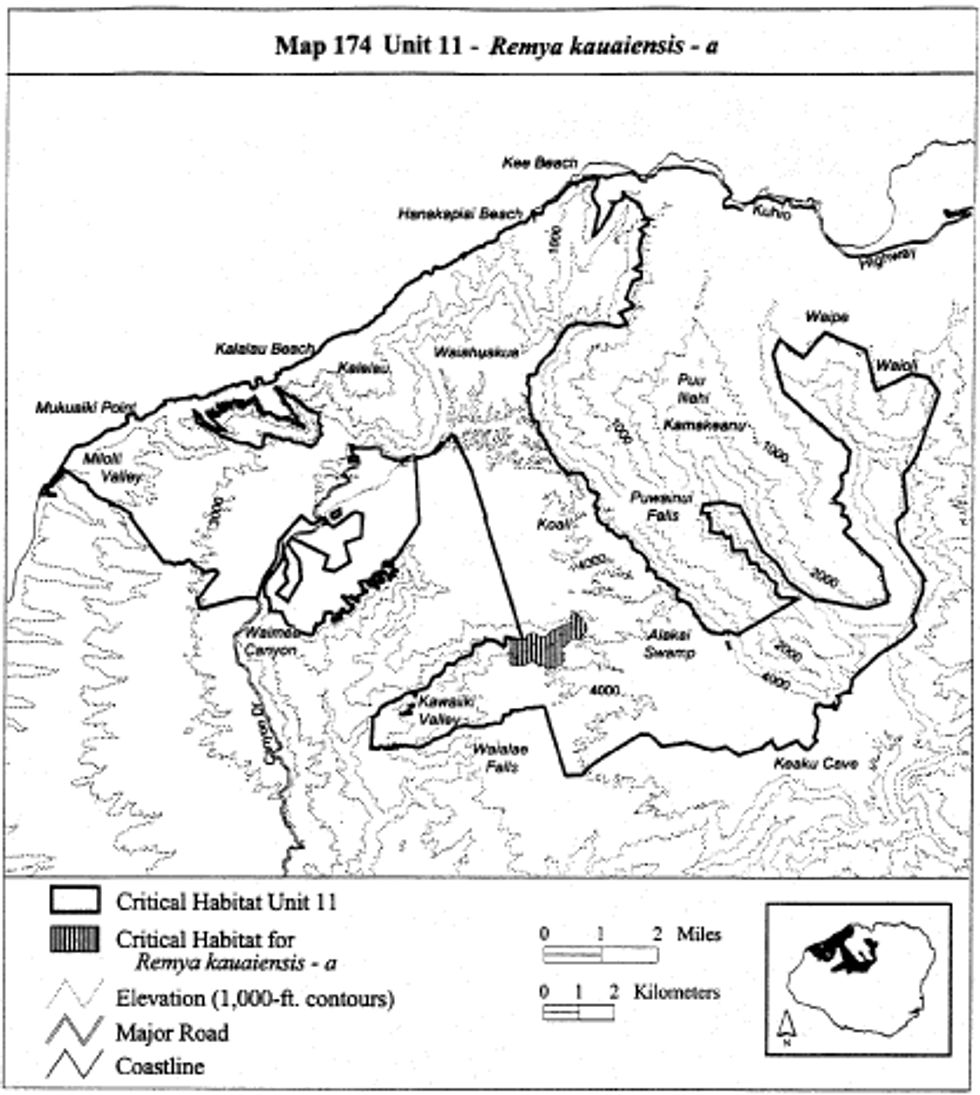
(ccxcix) Kauai 11 - Remya kauaiensis - b (66 ha; 163 ac)
(A) [Reserved]
(B) Map 175 follows:
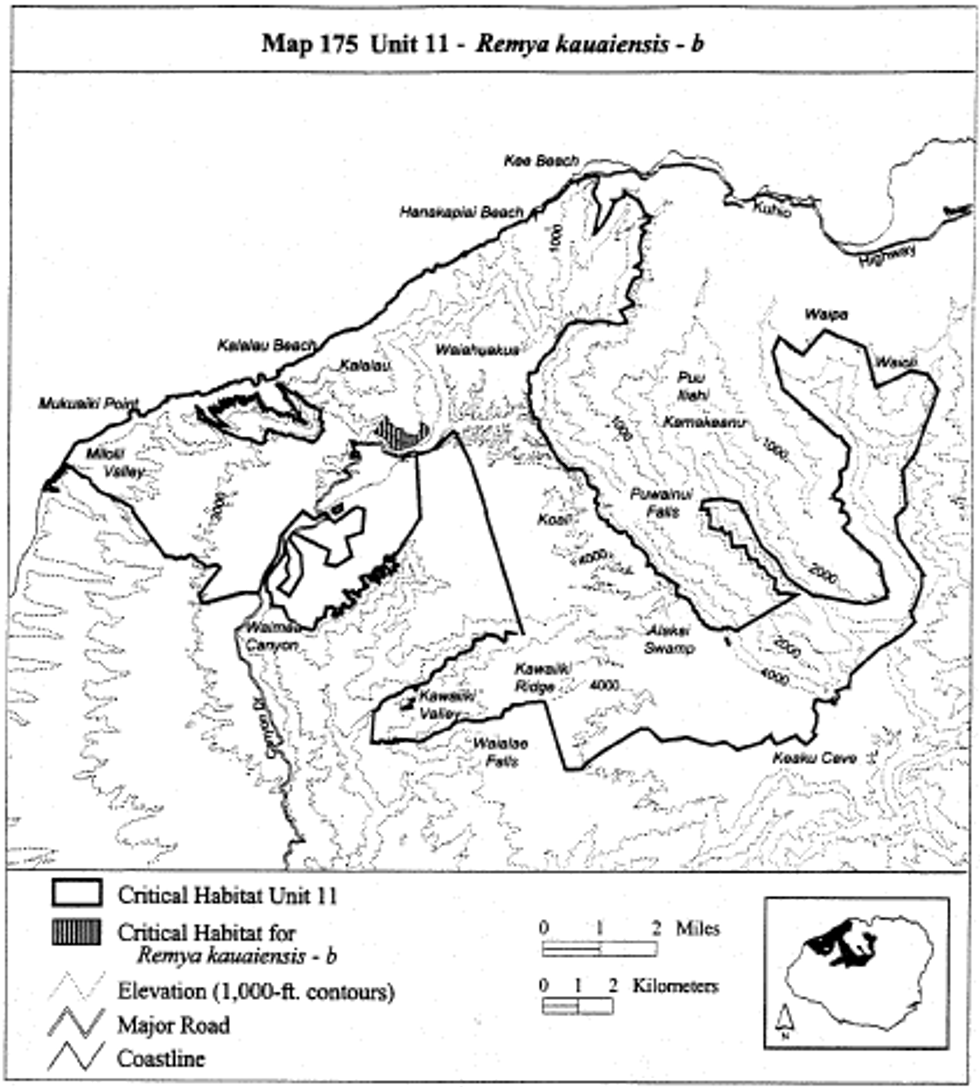
(ccc) Kauai 11 - Remya kauaiensis - c (886 ha; 2,190 ac)
(A) [Reserved]
(B) Map 176 follows:
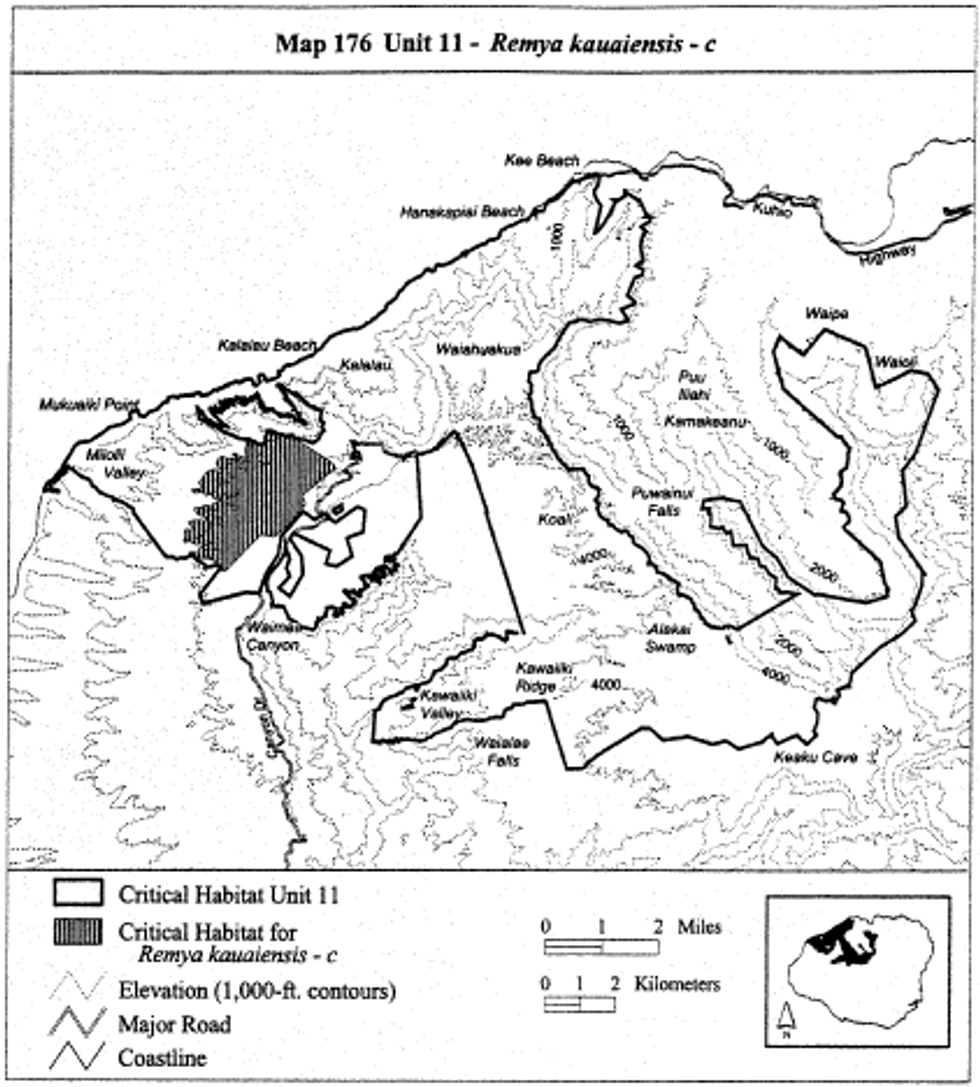
(ccci) Kauai 11 - Remya kauaiensis - d (47 ha; 115 ac)
(A) [Reserved]
(B) Map 177 follows:
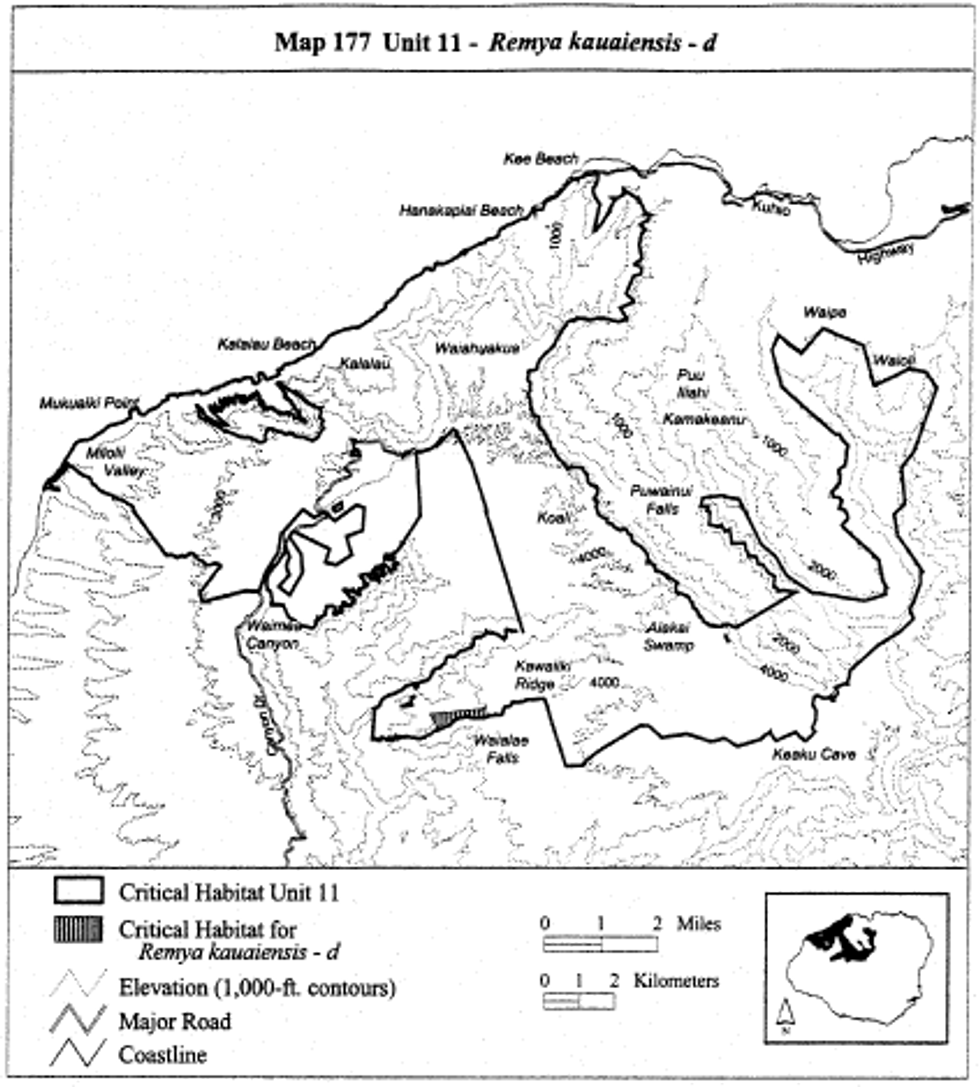
(cccii) Kauai 11 - Remya kauaiensis - e (66 ha, 163 ac)
(A) [Reserved]
(B) Map 178 follows:
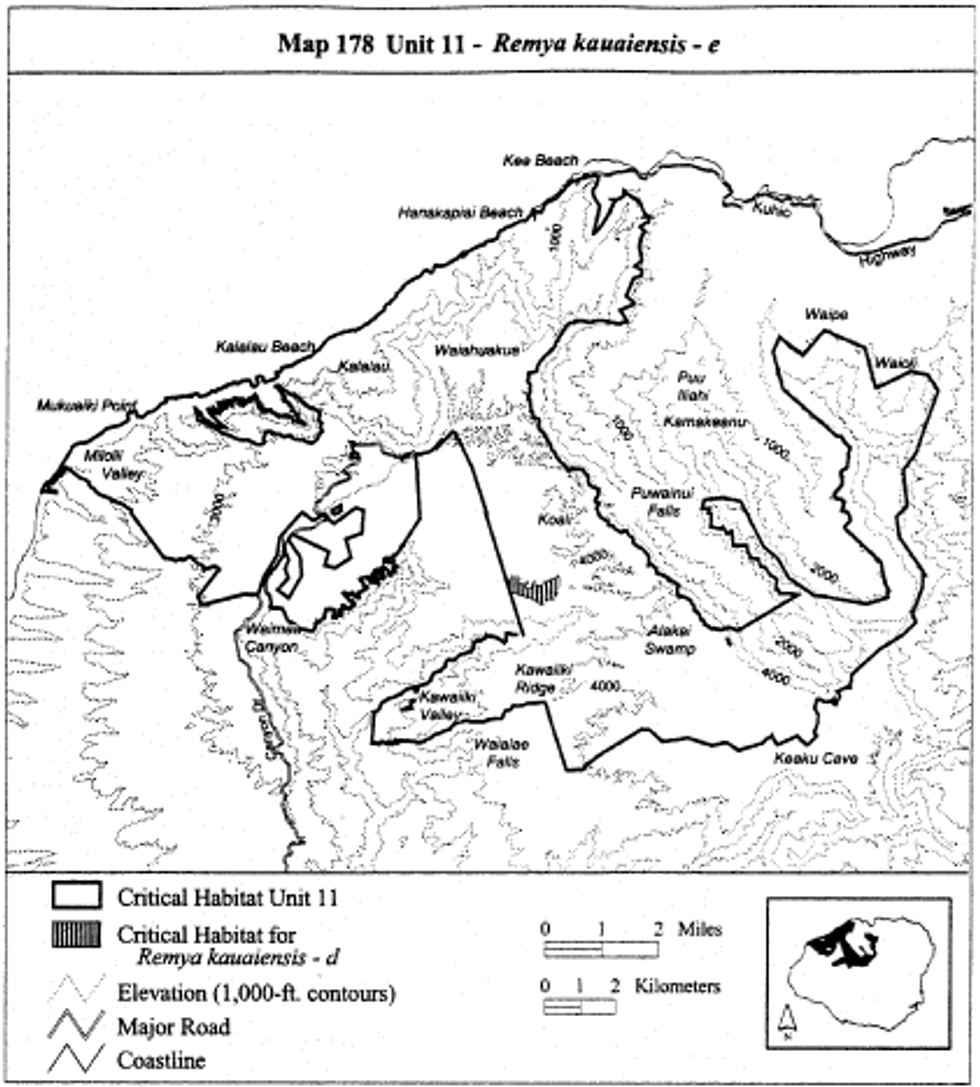
(ccciii) Kauai 11 - Remya montgomeryi - a (69 ha; 171 ac)
(A) [Reserved]
(B) Map 179 follows:
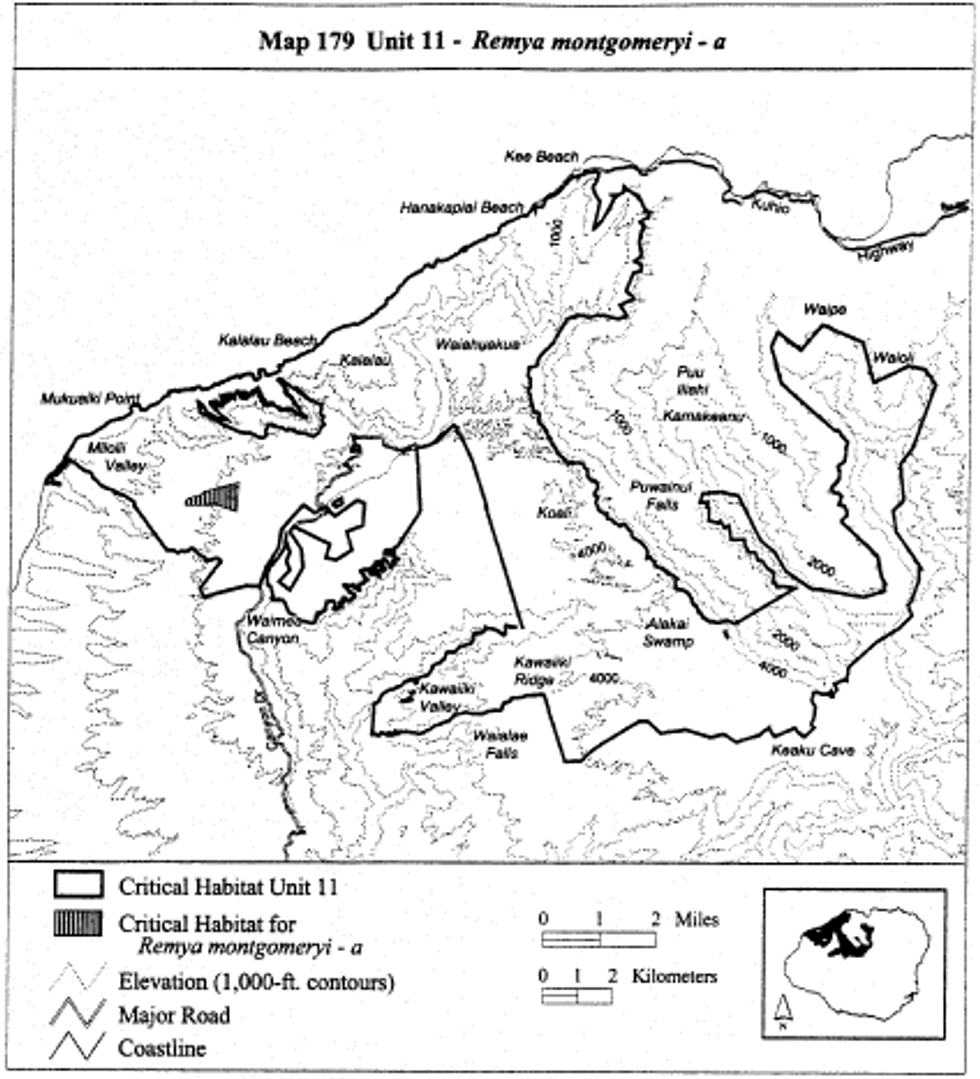
(ccciv) Kauai 11 - Remya montgomeryi - b (1,010 ha; 2,496 ac)
(A) [Reserved]
(B) Map 180 follows:
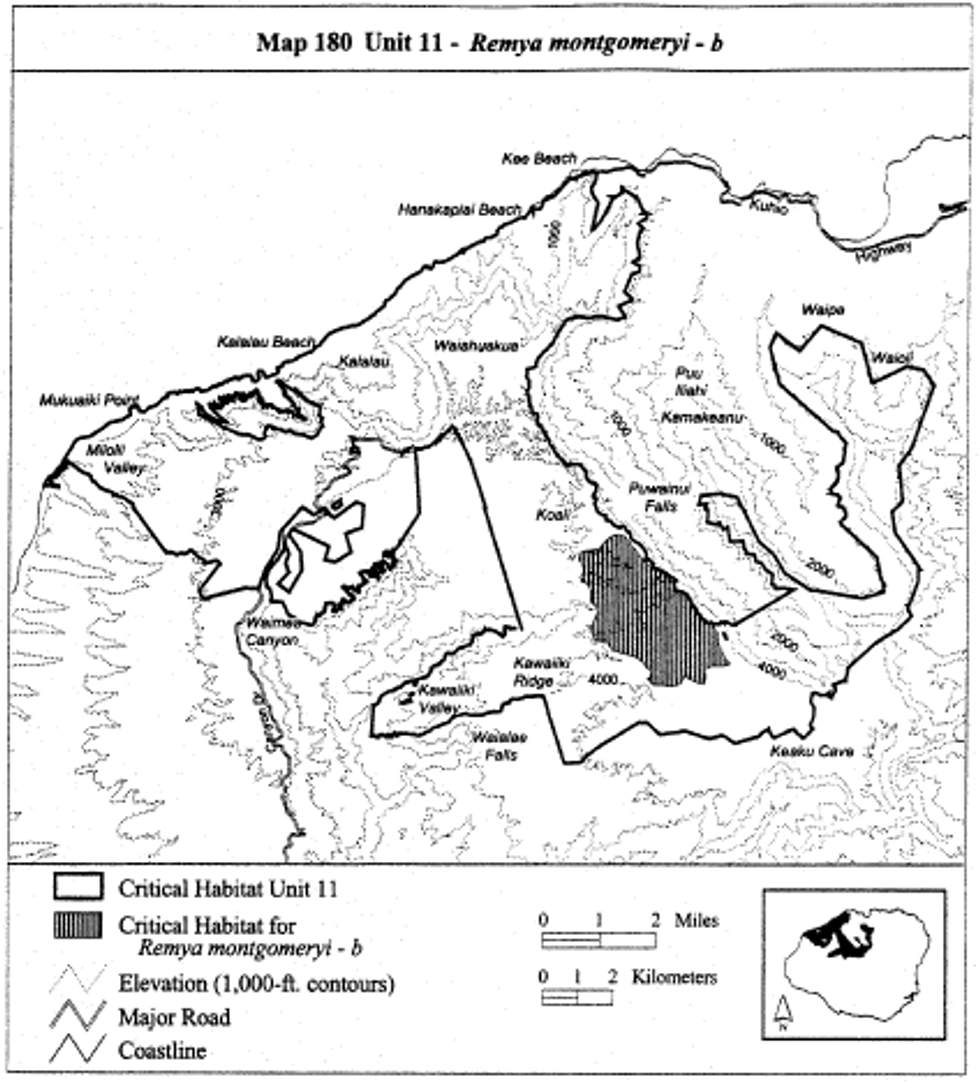
(cccv) Kauai 11 - Remya montgomeryi - c (435 ha; 1,076 ac)
(A) [Reserved]
(B) Map 181 follows:
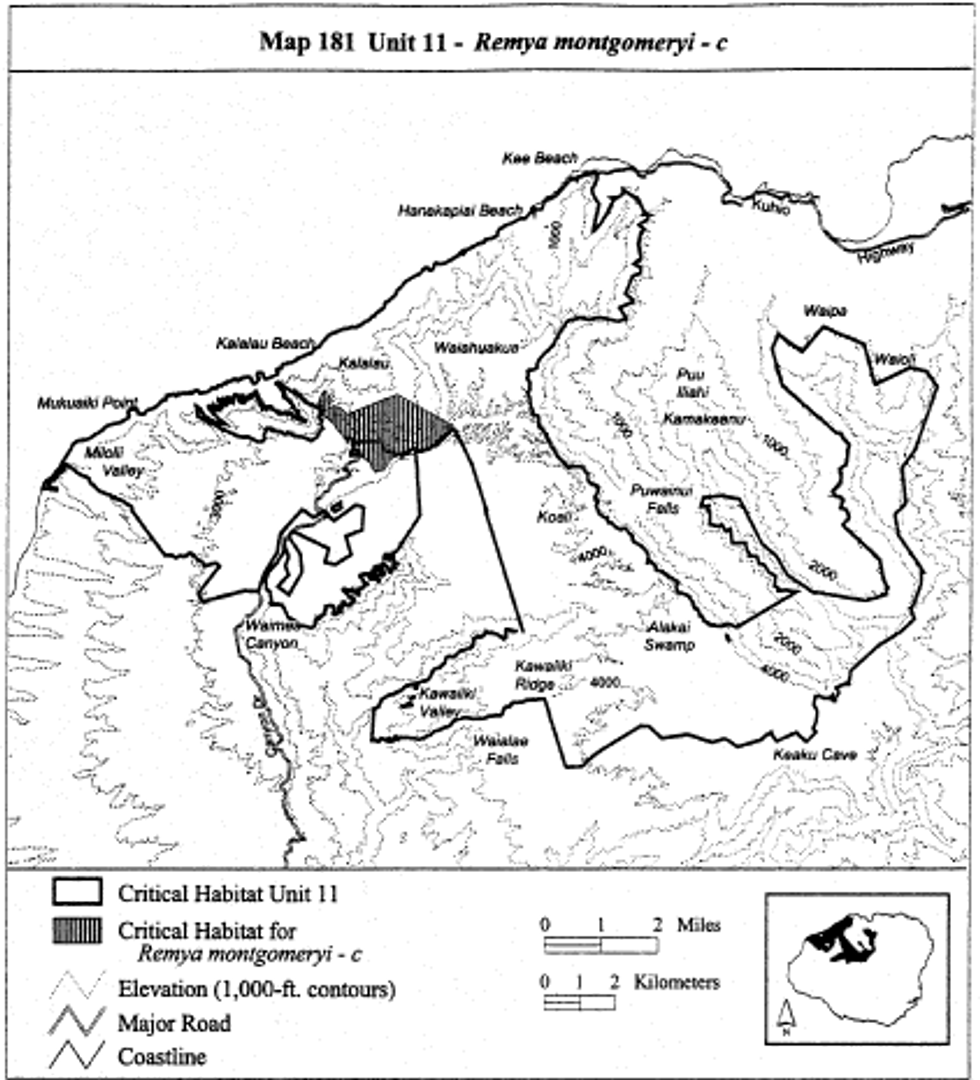
(cccvi) Kauai 11 - Schiedea apokremnos - a (170 ha; 420 ac)
(A) [Reserved]
(B) Map 182 follows:
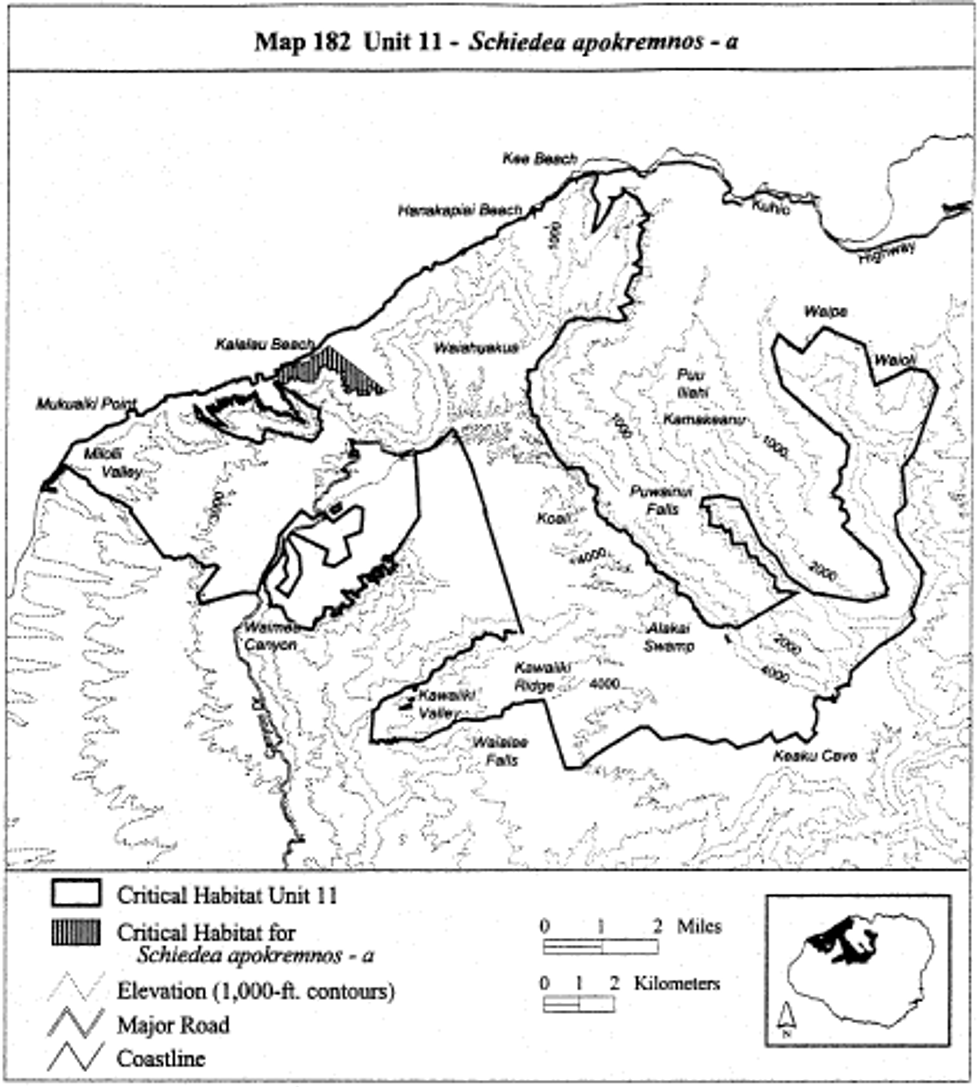
(cccvii) Kauai 11 - Schiedea apokremnos - b (187 ha; 463 ac)
(A) [Reserved]
(B) Map 183 follows:
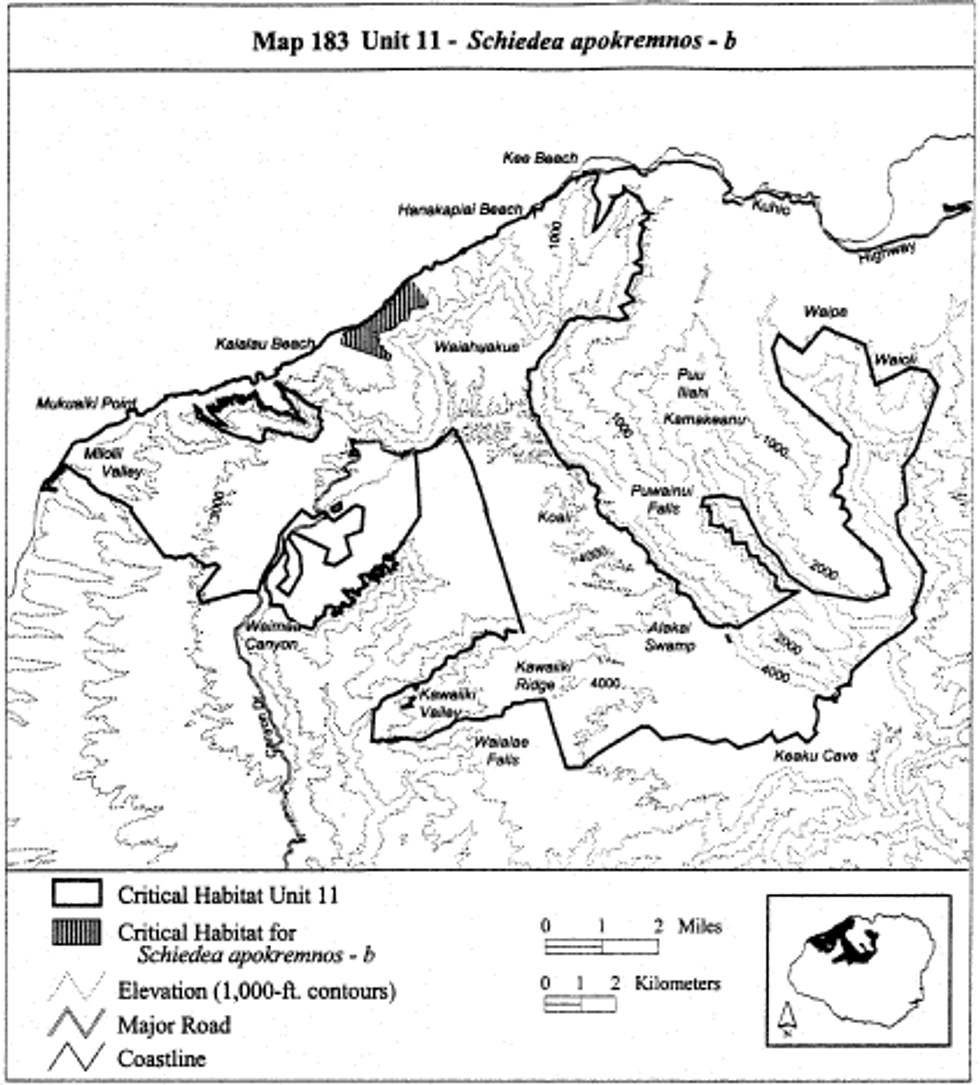
(cccviii) Kauai 11 - Schiedea apokremnos - c (295 ha; 730 ac)
(A) [Reserved]
(B) Map 184 follows:
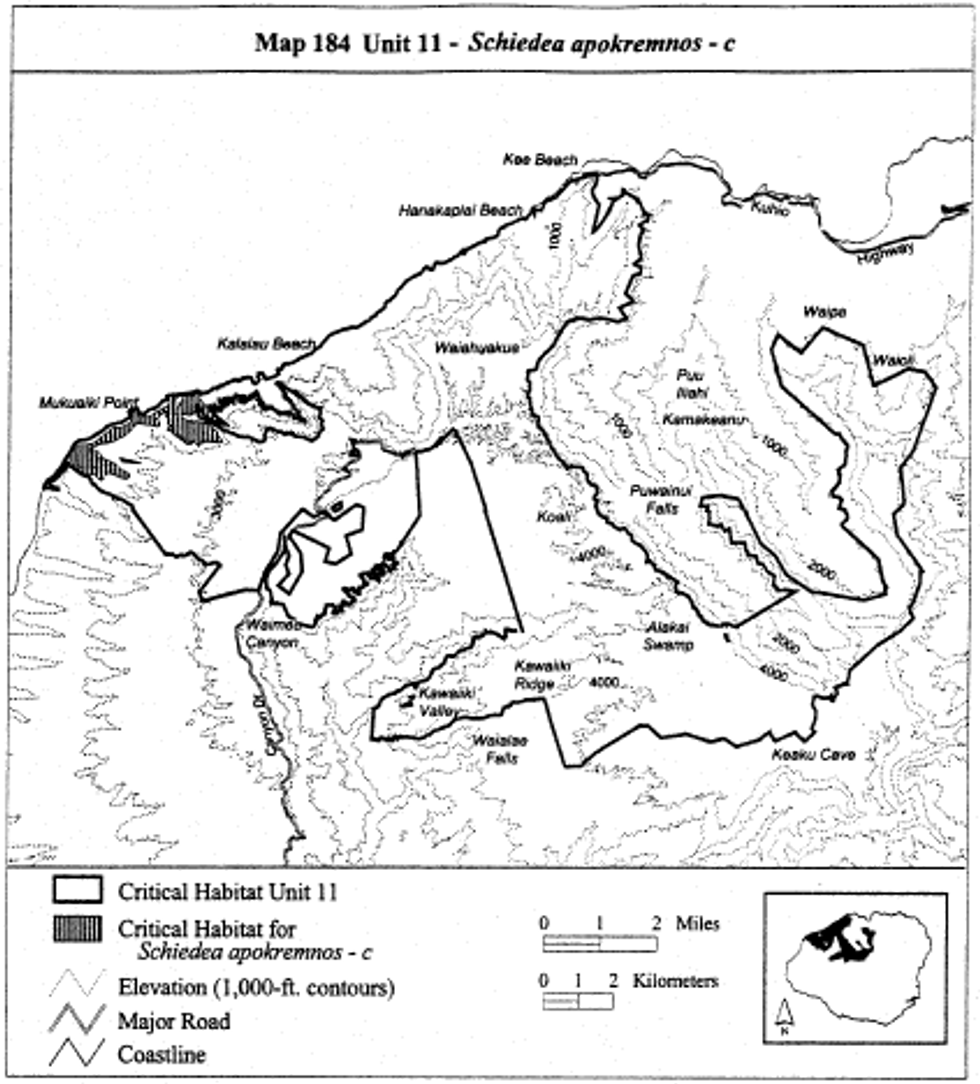
(cccix) Kauai 11-Schiedea attenuata-a
(A) [Reserved]
(B) See paragraph (a)(1)(cxxxvi)(B) of this section for the map of this unit.
(cccx) Kauai 11 - Schiedea helleri - a (485 ha; 1,198 ac)
(A) [Reserved]
(B) Map 185 follows:
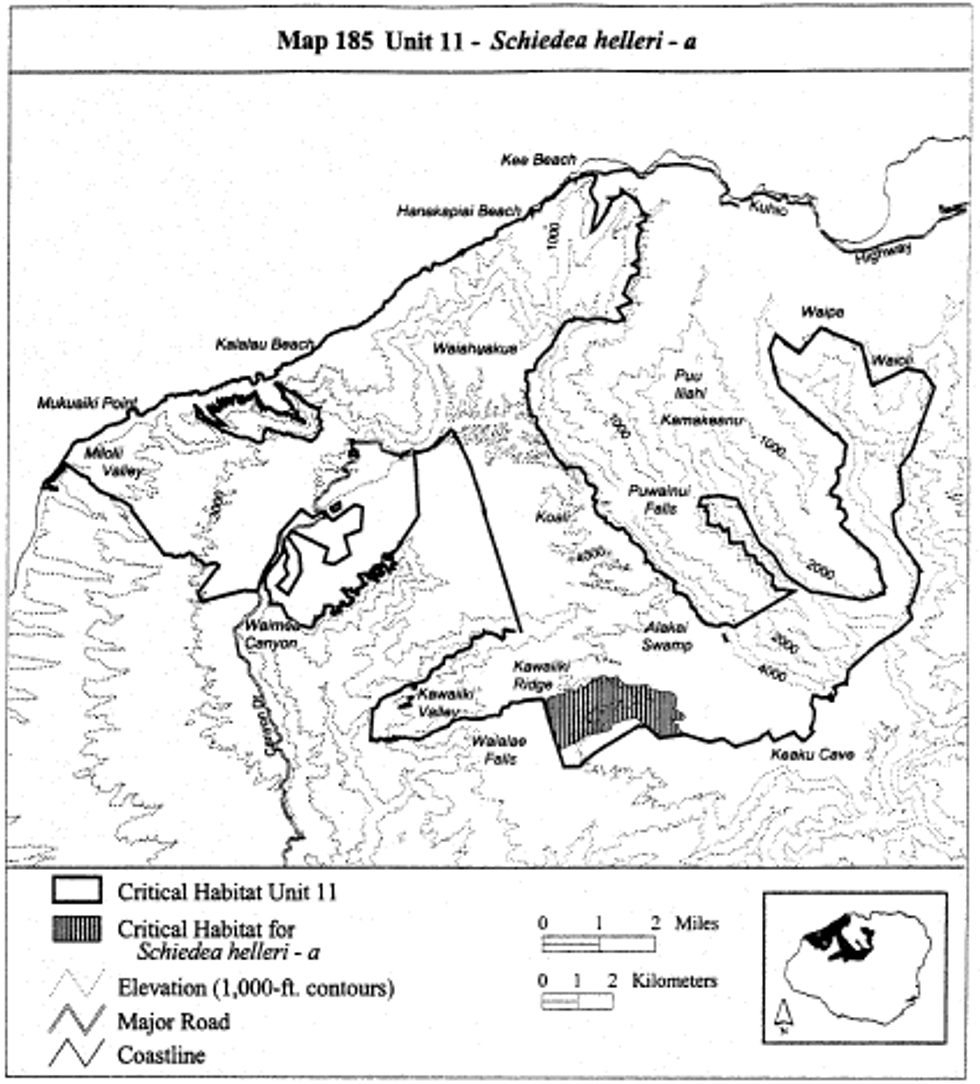
(cccxi) Kauai 11 - Schiedea helleri - b (154 ha; 381 ac)
(A) [Reserved]
(B) Map 186 follows:

(cccxii) Kauai 11 - Schiedea helleri - c (172 ha; 426 ac)
(A) [Reserved]
(B) Map 187 follows:
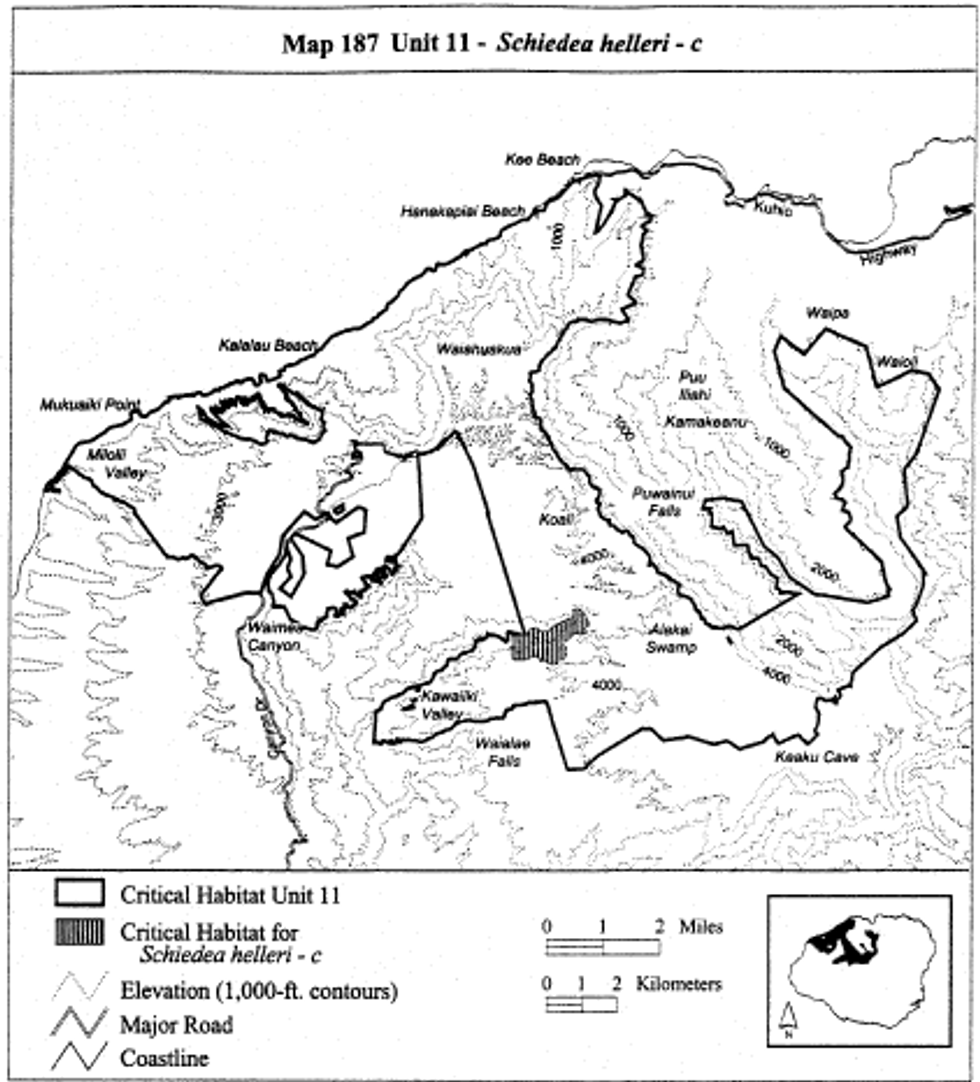
(cccxiii) Kauai 11 - Schiedea kauaiensis - a (12 ha; 29 ac)
(A) [Reserved]
(B) Map 188 follows:
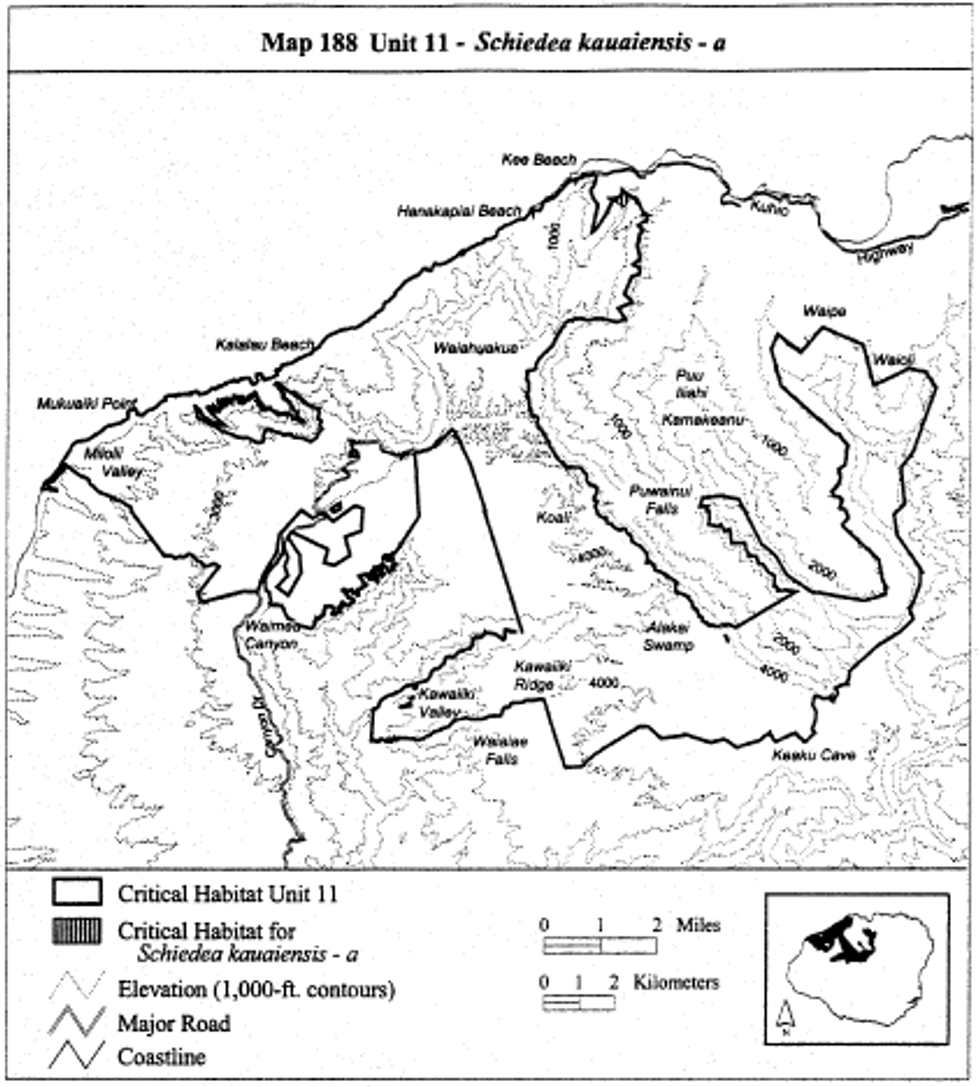
(cccxiv) Kauai 11 - Schiedea kauaiensis - b (394 ha; 974 ac)
(A) [Reserved]
(B) Map 189 follows:
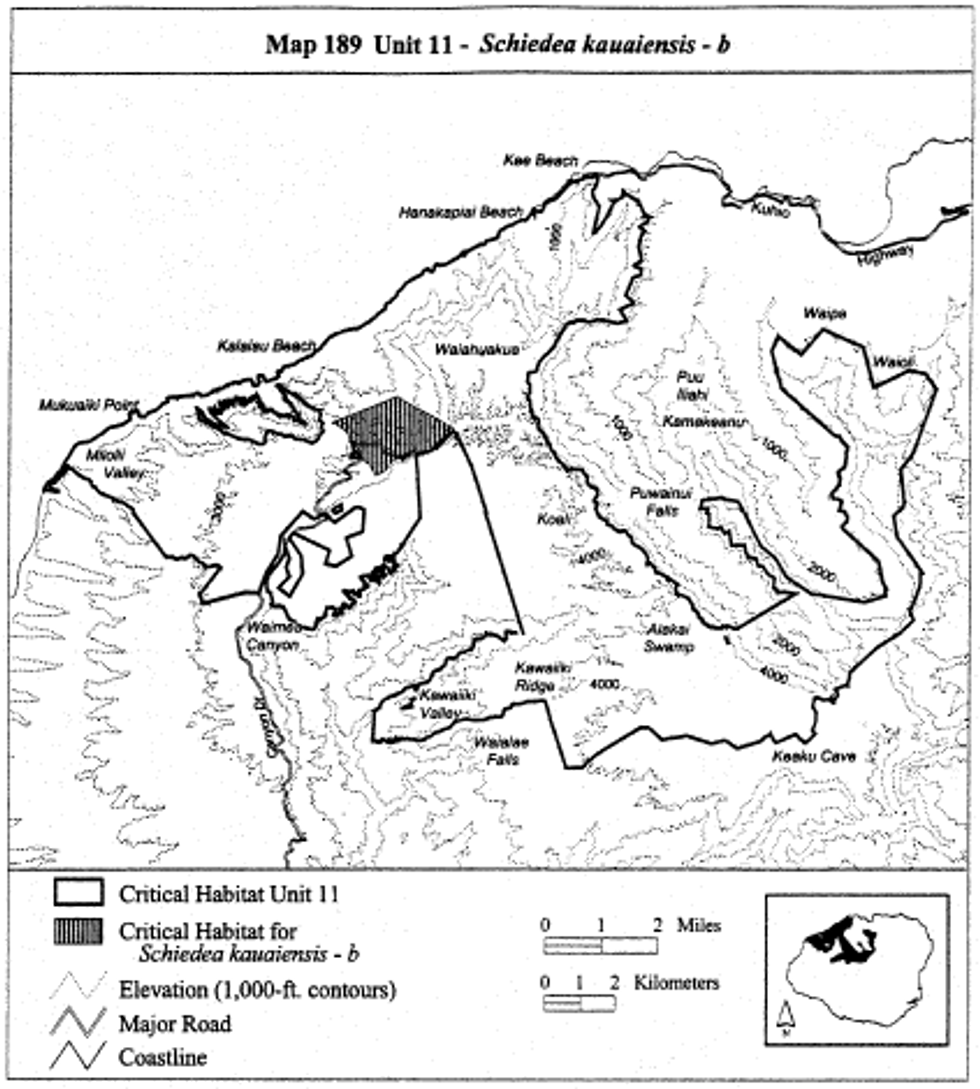
(cccxv) Kauai 11 - Schiedea kauaiensis - c (510 ha; 1,260 ac)
(A) [Reserved]
(B) Map 190 follows:
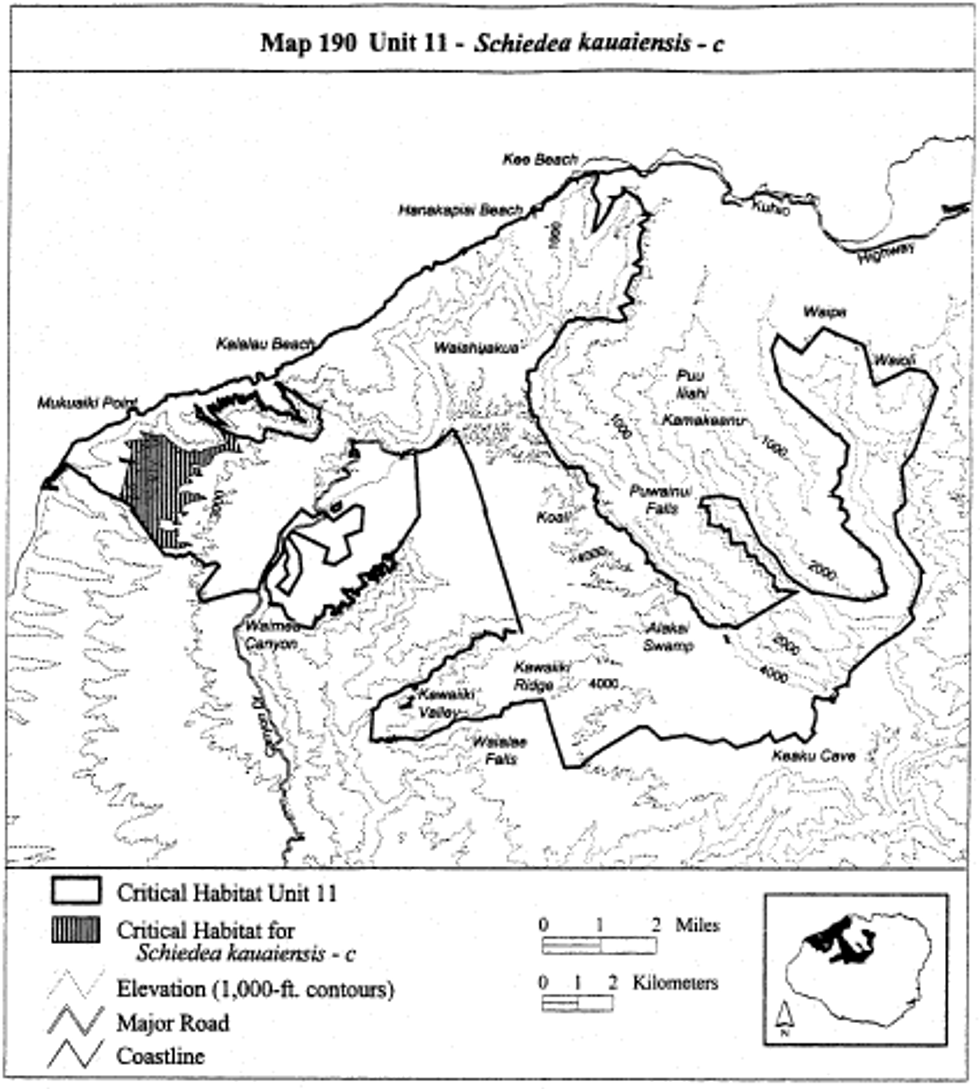
(cccxvi) Kauai 11 - Schiedea kauaiensis - d (11 ha; 28 ac)
(A) [Reserved]
(B) Map 191 follows:
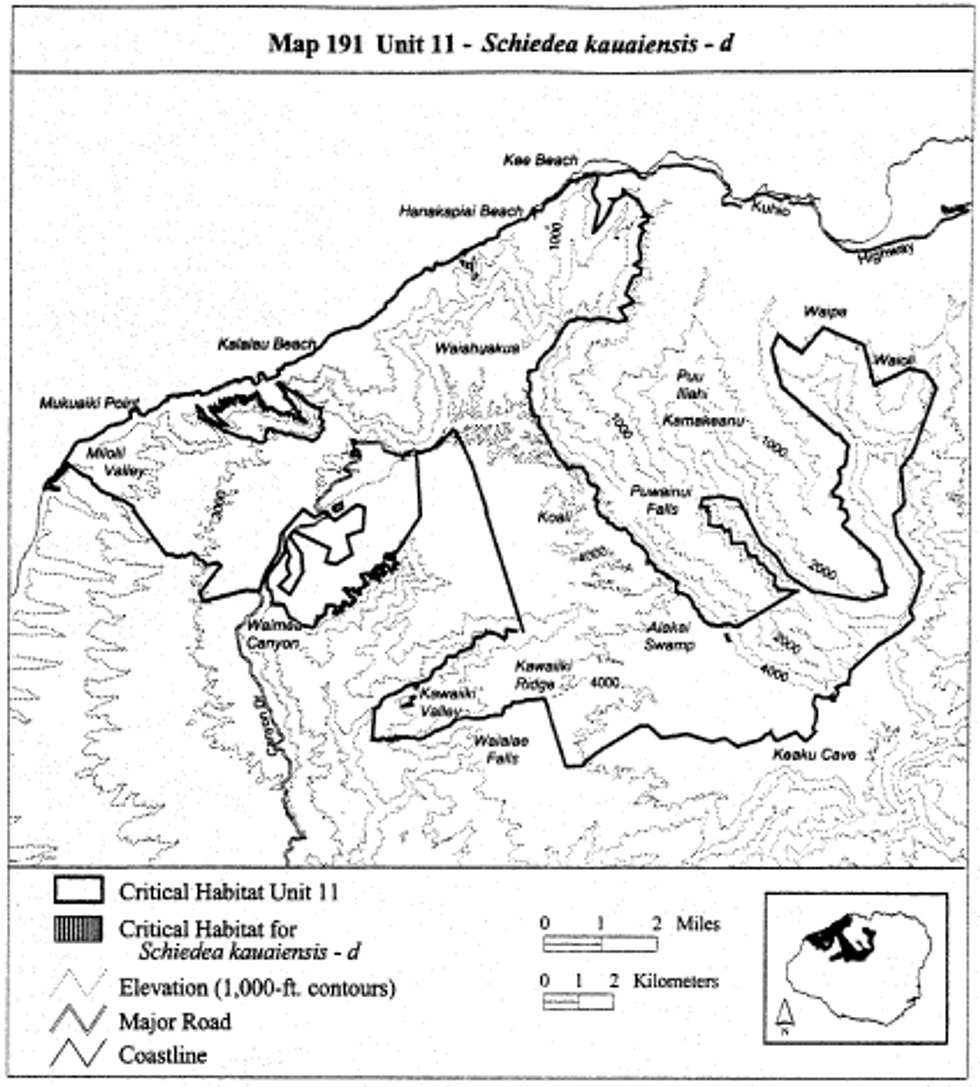
(cccxvii) Kauai 11 - Schiedea membranacea - a (251 ha; 620 ac)
(A) [Reserved]
(B) Map 192 follows:
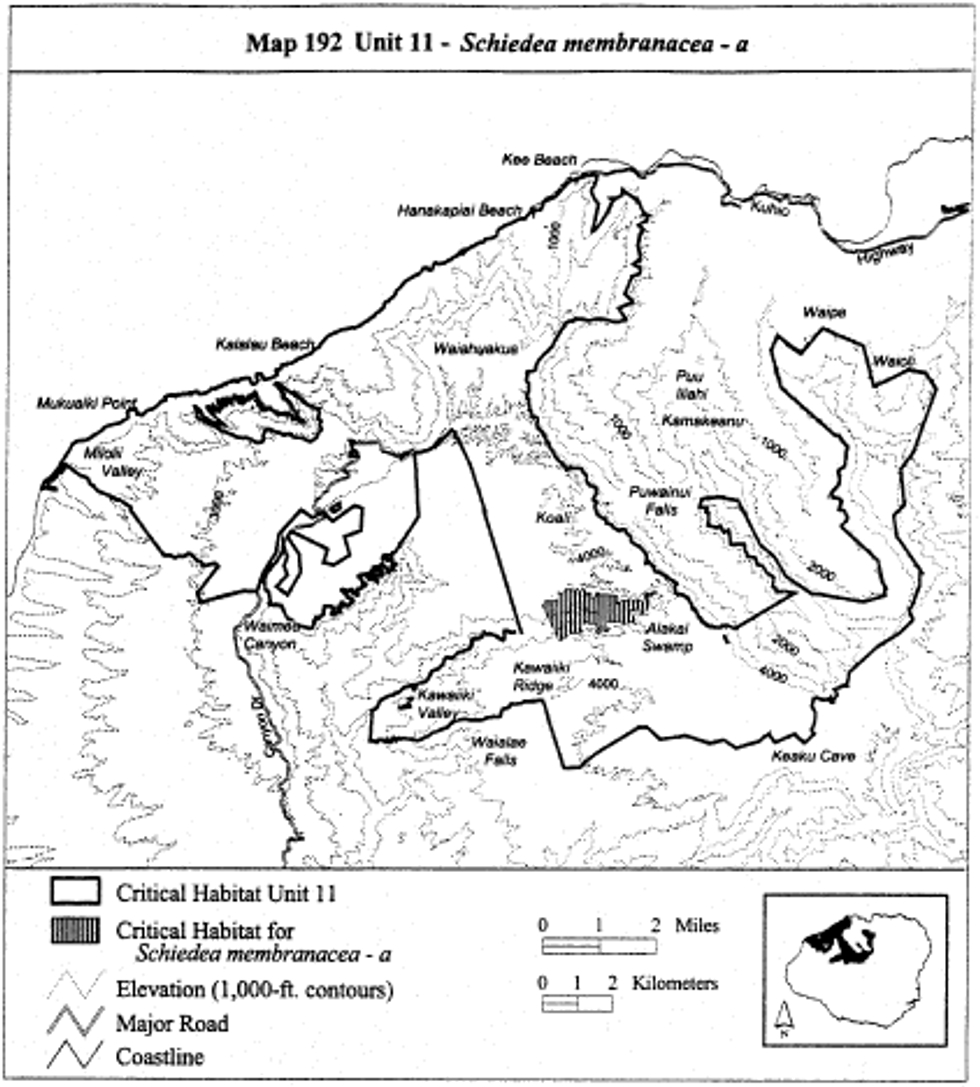
(cccxviii) Kauai 11 - Schiedea membranacea - b (234 ha; 579 ac)
(A) [Reserved]
(B) Map 193 follows:
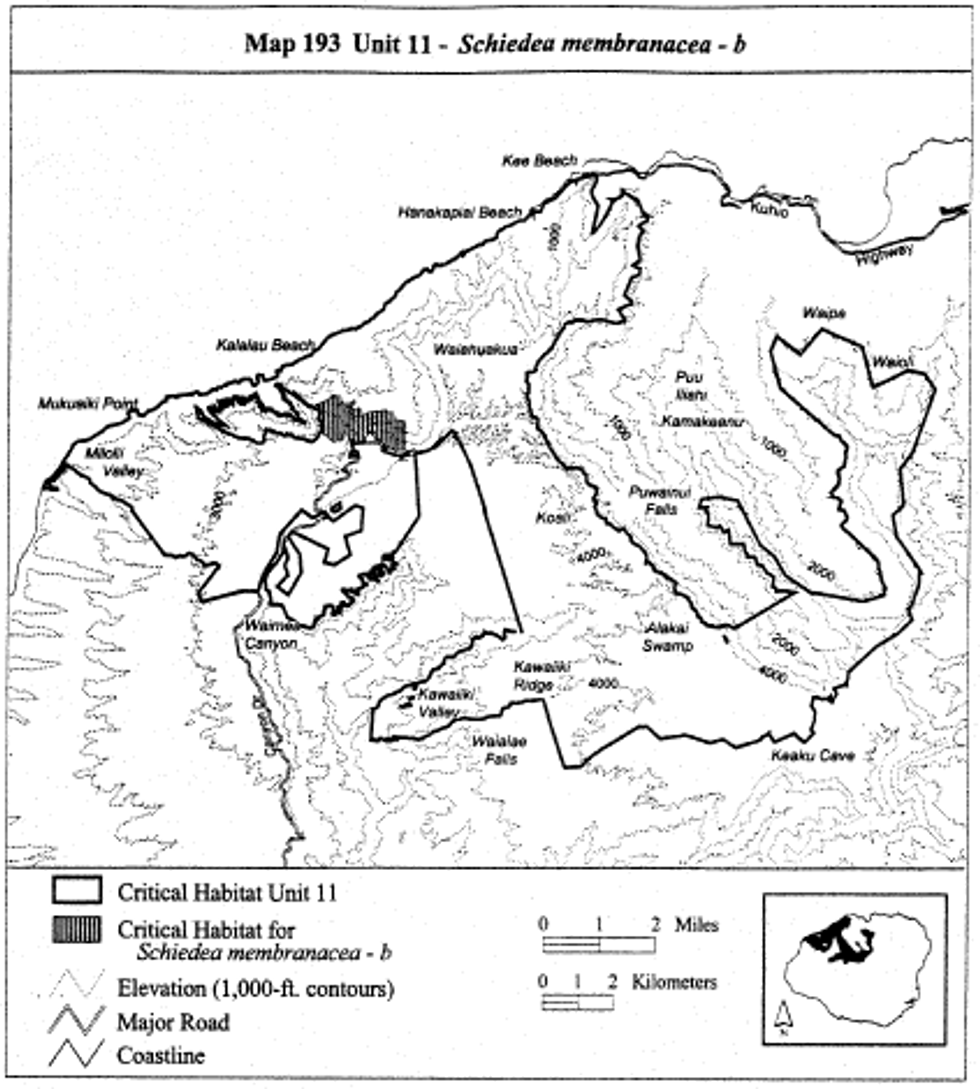
(cccxix) Kauai 11 - Schiedea membranacea - c (527 ha; 1,303 ac)
(A) [Reserved]
(B) Map 194 follows:
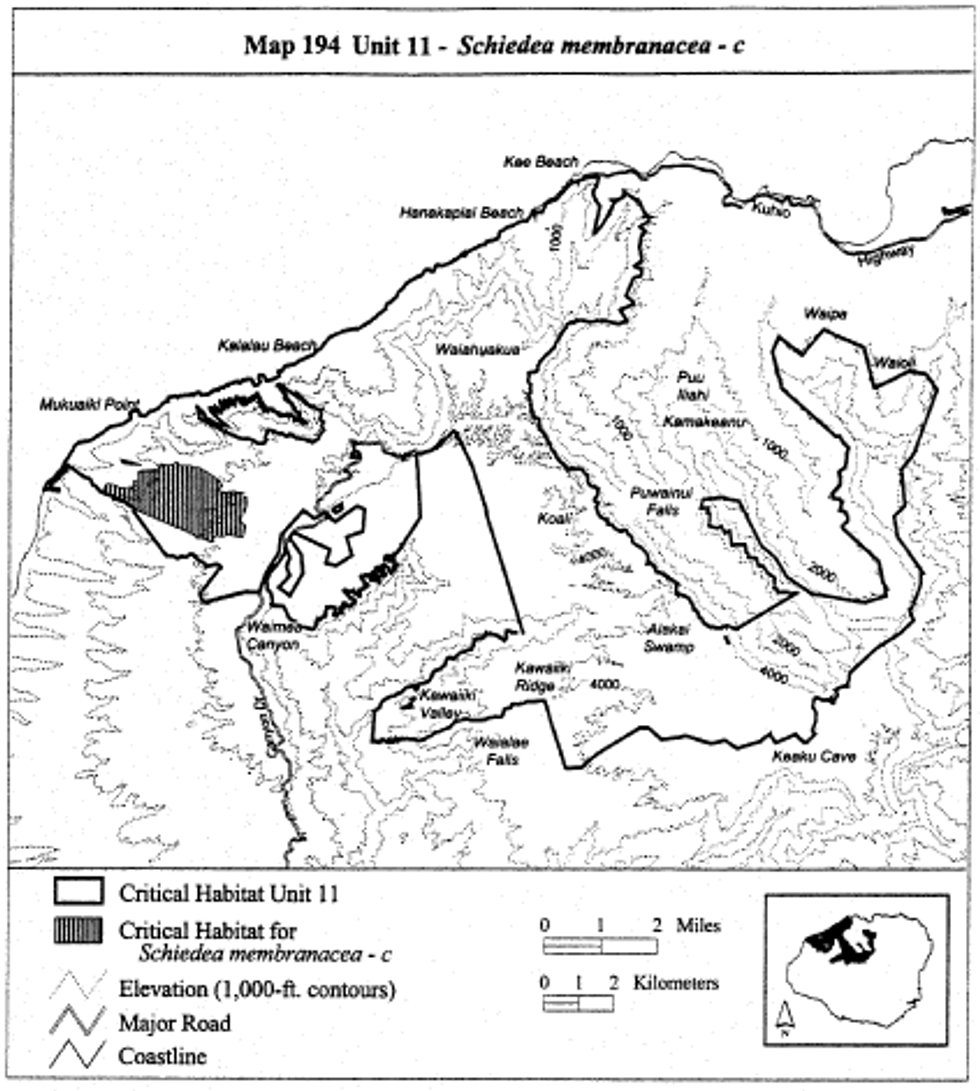
(cccxx) Kauai 11 - Schiedea membranacea - d (327 ha; 809 ac)
(A) [Reserved]
(B) Map 195 follows:
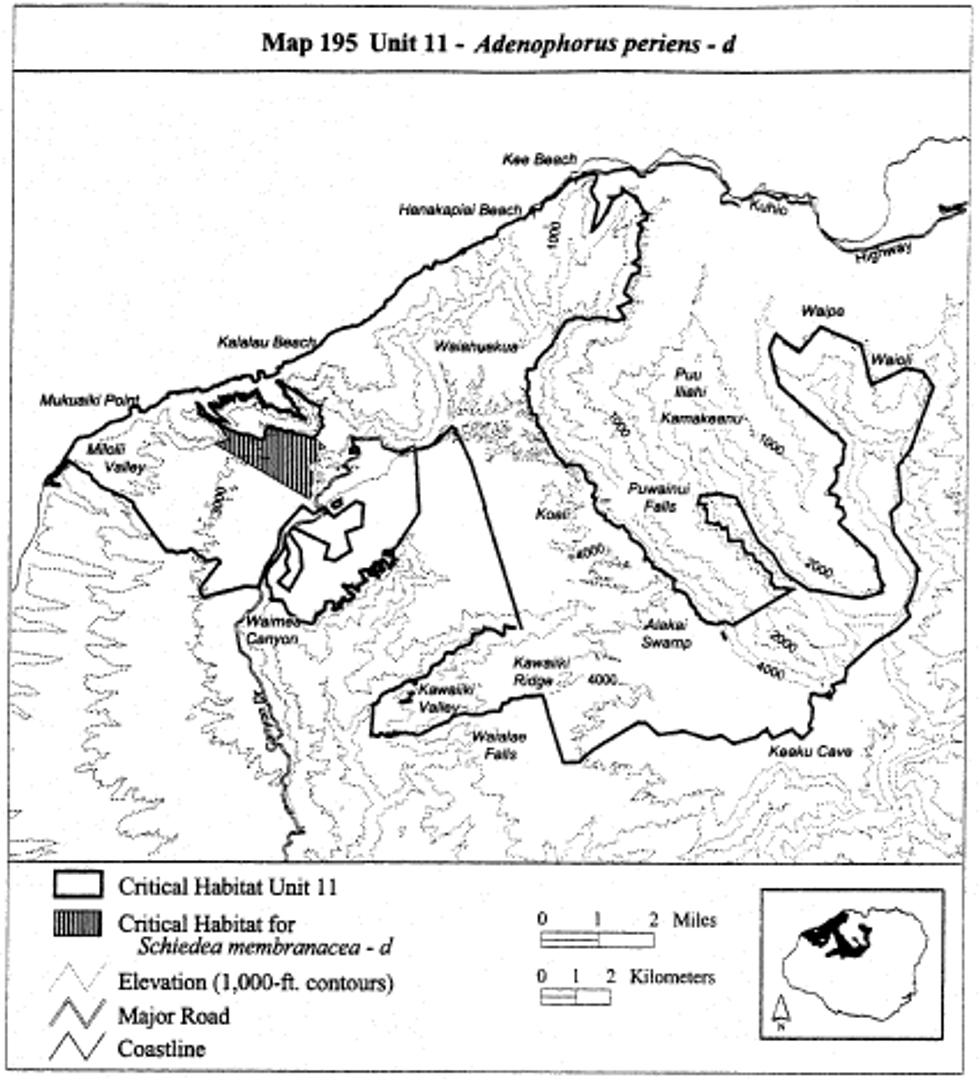
(cccxxi) Kauai 11 - Schiedea spergulina var. spergulina - a (131 ha; 323 ac)
(A) [Reserved]
(B) Map 196 follows:
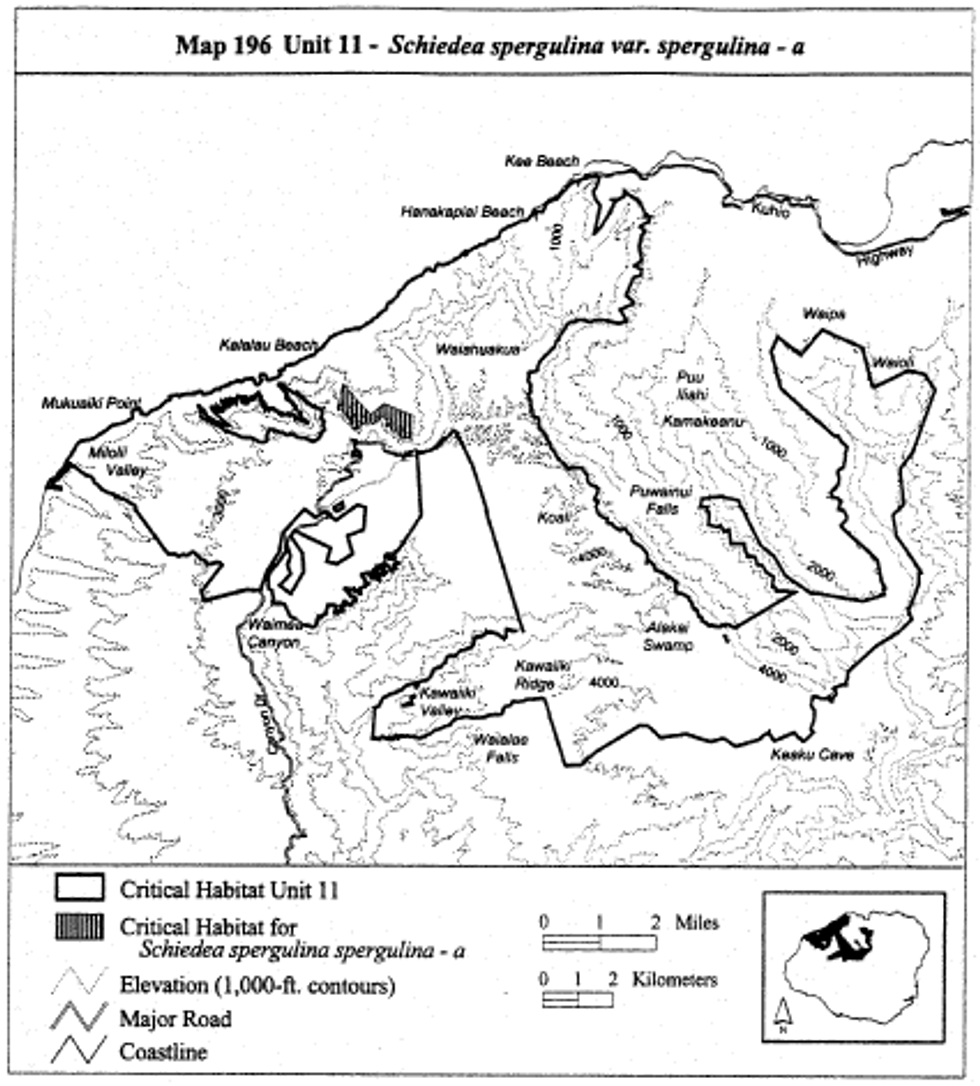
(cccxxii) Kauai 11 - Schiedea spergulina var. spergulina - b (78 ha; 191 ac)
(A) [Reserved]
(B) Excluding 1 area bounded by the following 4 points (0 ha, 1 ac): Start at 435151, 2442425; 435215, 2442393; 435195, 2442353; 435128, 2442379; return to starting point.
(C) Map 197 follows:
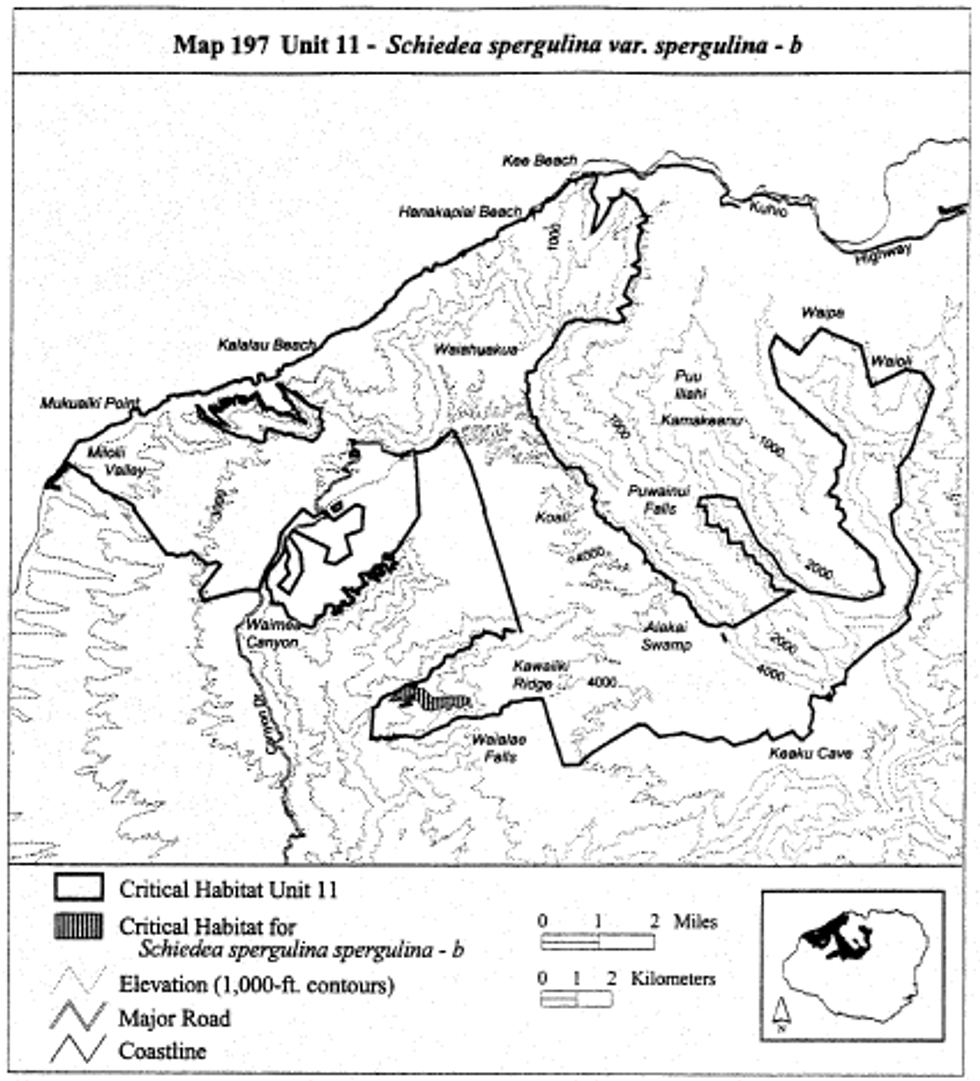
(cccxxiii) Kauai 11 - Schiedea stellarioides - a (1,260 ha; 3,112 ac)
(A) [Reserved]
(B) Excluding 2 areas:
(1) Bounded by the following 3 points (1 ha; 3 ac): Start at 435132, 2442248; 435160, 2442164; 434848, 2442098; return to starting point; and
(2) Bounded by the following 4 points (0 ha; 1 ac): Start at 435151, 2442425; 435215, 2442393; 435195, 2442353; 435128, 2442379; return to starting point.
(C) Map 198 follows:
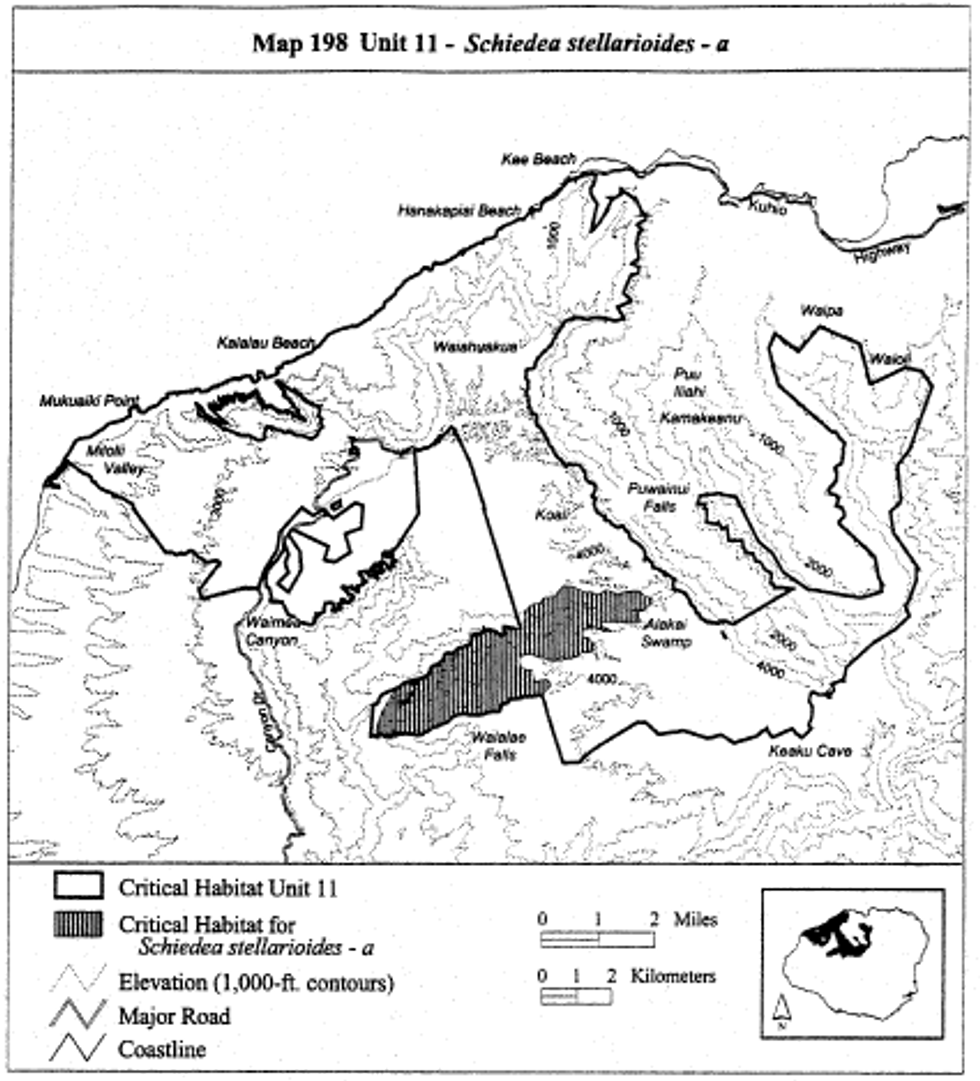
(cccxxiv) Kauai 11 - Schiedea stellarioides - b (129 ha; 320 ac)
(A) [Reserved]
(B) Map 199 follows:
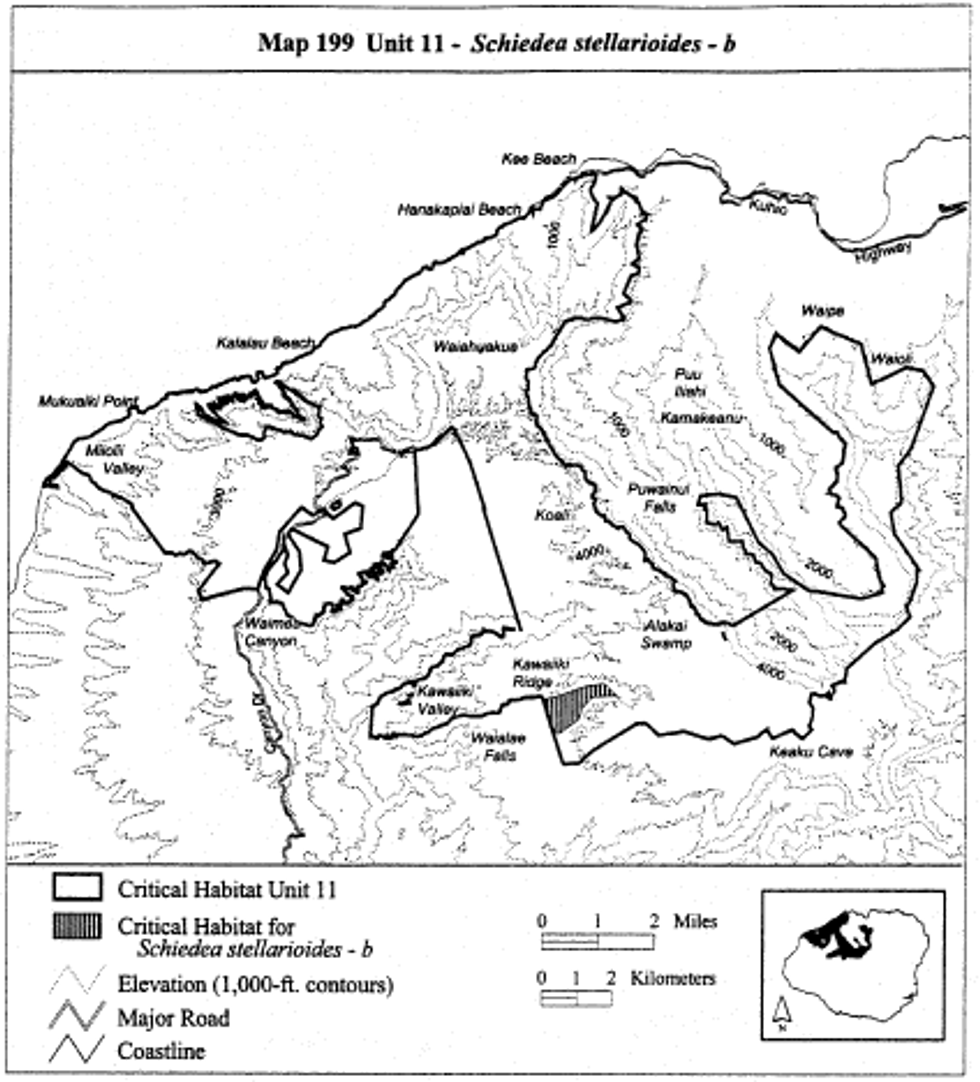
(cccxxv) Kauai 11 - Solanum sandwicense - a (2,398 ha; 5,924 ac)
(A) [Reserved]
(B) Excluding 3 areas:
(1) Bounded by the following 10 points (3 ha; 8 ac): Start at 433368, 2449292; 433367, 2449352; 433448, 2449426; 433546, 2449412; 433567, 2449398; 433589, 2449323; 433612, 2449262; 433588, 2449244; 433567, 2449260; 433369, 2449255; return to starting point;
(2) Bounded by the following 4 points (3 ha; 8 ac): Start at 433109, 2447775; 432932, 2447668; 432827, 2447751; 433094, 2447922; return to starting point; and
(3) Bounded by the following 9 points (1 ha; 2ac): Start at 433484, 2449703; 433480, 2449629; 433457, 2449622; 433440, 2449604; 433426, 2449556; 433419, 2449599; 433399, 2449709; 433436, 2449707; 433460, 2449707; return to starting point.
(C) Map 200 follows:
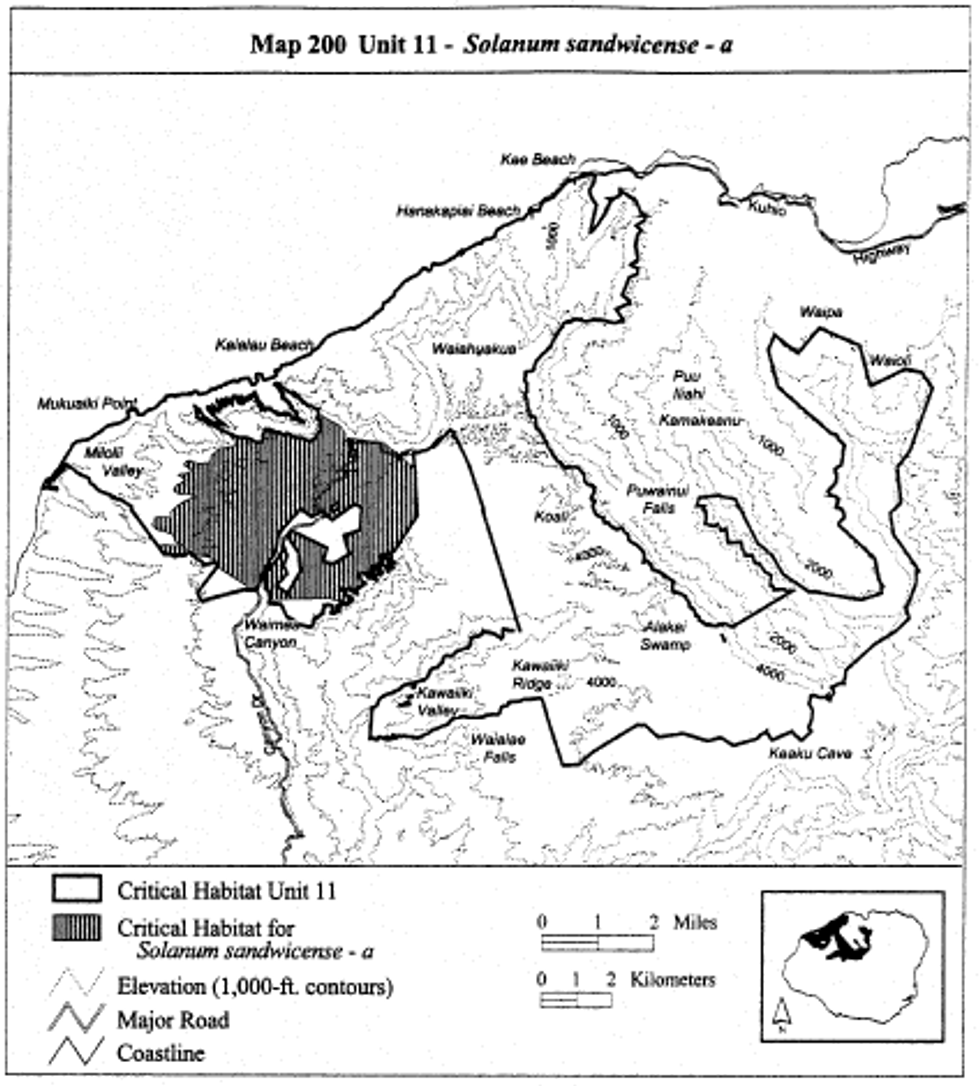
(cccxxvi) Kauai 11 - Solanum sandwicense - b (249 ha; 614 ac)
(A) [Reserved]
(B) Map 201 follows:
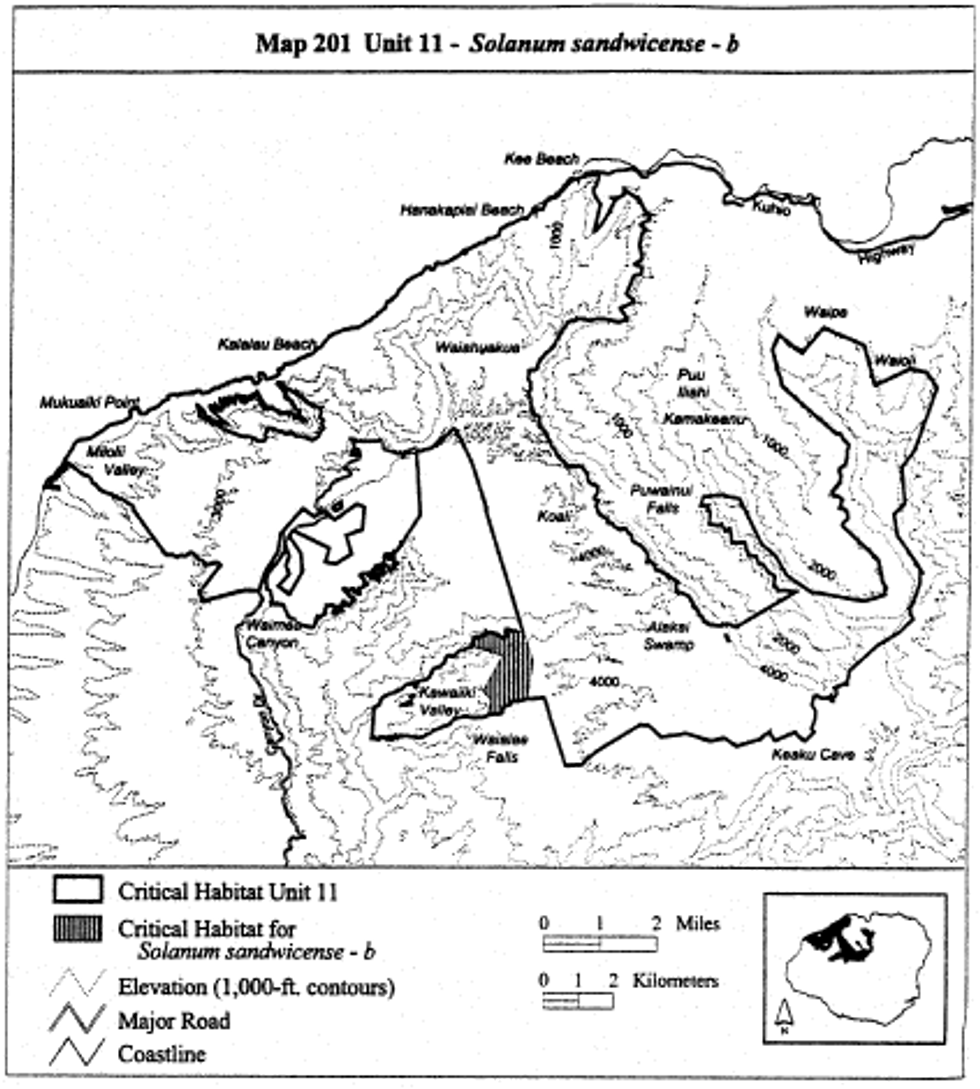
(cccxxvii) Kauai 11 - Spermolepis hawaiiensis - a (96 ha; 237 ac)
(A) [Reserved]
(B) Map 202 follows:
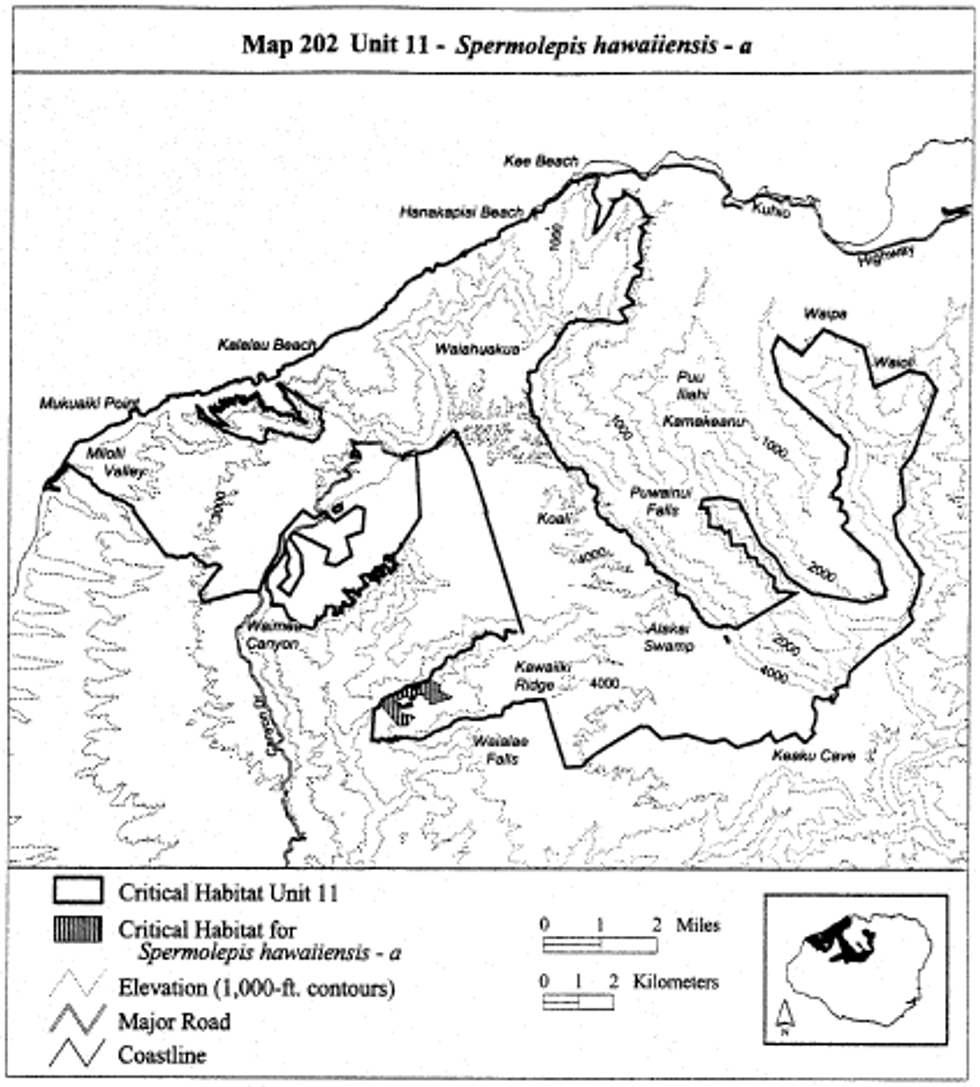
(cccxxviii) Kauai 11 - Stenogyne campanulata - a (425 ha; 1,050 ac)
(A) [Reserved]
(B) Map 203 follows:
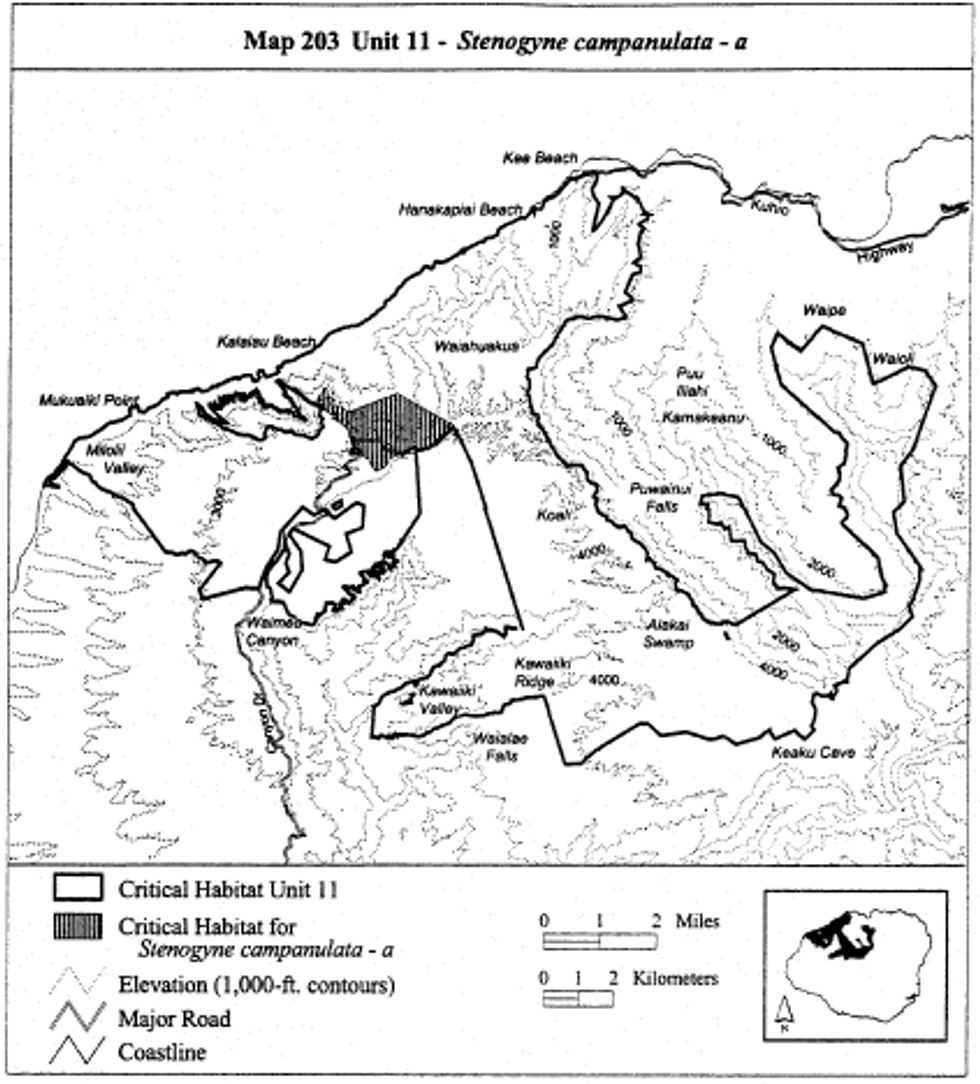
(cccxxix) Kauai 11-Stenogyne kealiae-b
(A) [Reserved]
(B) See paragraph (a)(1)(cxxxvi)(B) of this section for the map of this unit.
(cccxxx) Kauai 11-Stenogyne kealiae-c
(A) [Reserved]
(B) See paragraph (a)(1)(cxl)(B) of this section for the map of this unit.
(cccxxxi) Kauai 11-Stenogyne kealiae-d
(A) [Reserved]
(B) See paragraph (a)(1)(cxlvi)(B) of this section for the map of this unit.
(cccxxxii) Kauai 11-Tetraplasandra bisattenuata-c
(A) [Reserved]
(B) See paragraph (a)(1)(cxxxiii)(B) of this section for the map of this unit.
(cccxxxiii) Kauai 11-Tetraplasandra bisattenuata-d
(A) [Reserved]
(B) See paragraph (a)(1)(cxl)(B) of this section for the map of this unit.
(cccxxxiv) Kauai 11-Tetraplasandra flynnii-c
(A) [Reserved]
(B) See paragraph (a)(1)(cxxx)(B) of this section for the map of this unit.
(cccxxxv) Kauai 11-Tetraplasandra flynnii-d
(A) [Reserved]
(B) See paragraph (a)(1)(cxl)(B) of this section for the map of this unit.
(cccxxxvi) Kauai 11-Tetraplasandra flynnii-e
(A) [Reserved]
(B) See paragraph (a)(1)(cxlvi)(B) of this section for the map of this unit.
(cccxxxvii) Kauai 11 - Wilkesia hobdyi - a (775 ha; 1,914 ac)
(A) [Reserved]
(B) Map 204 follows:
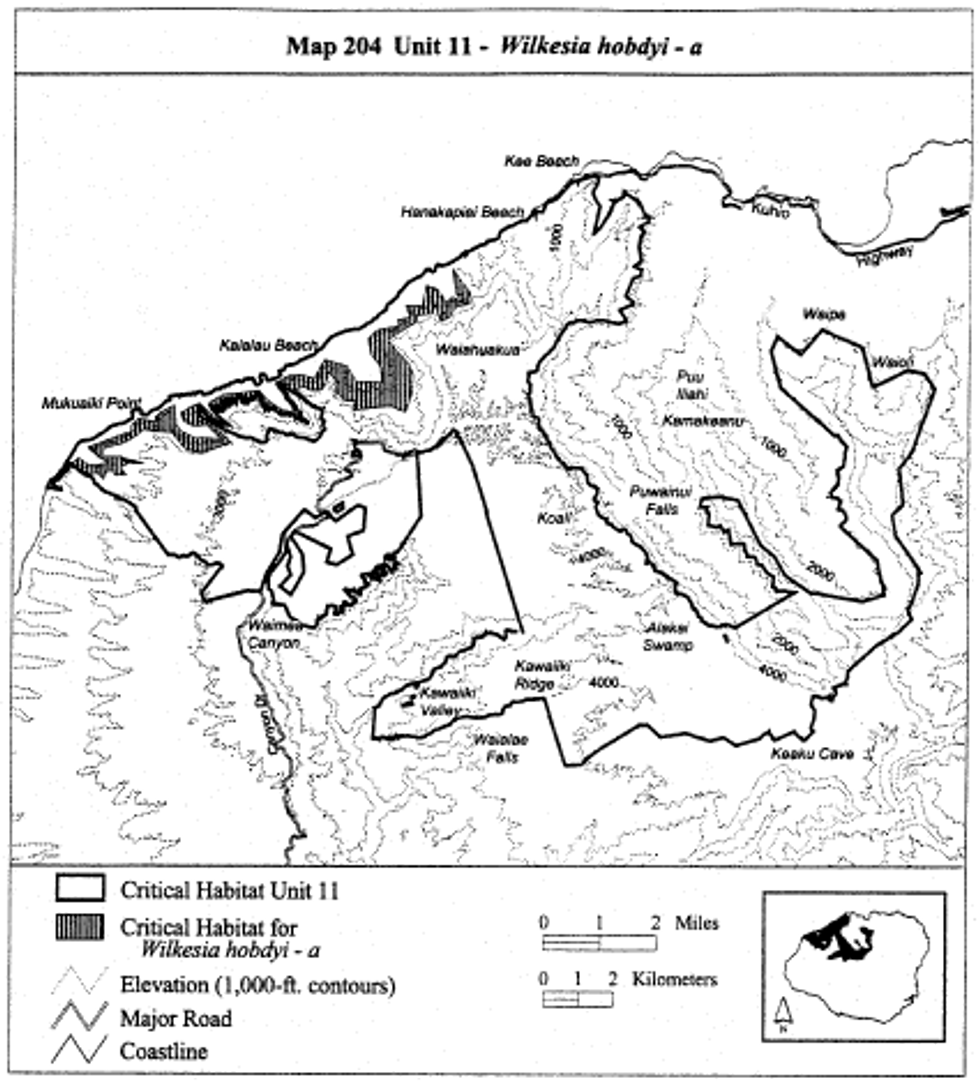
(cccxxxviii) Kauai 11 - Xylosma crenatum - a (840 ha; 2,076 ac)
(A) [Reserved]
(B) Map 205 follows:
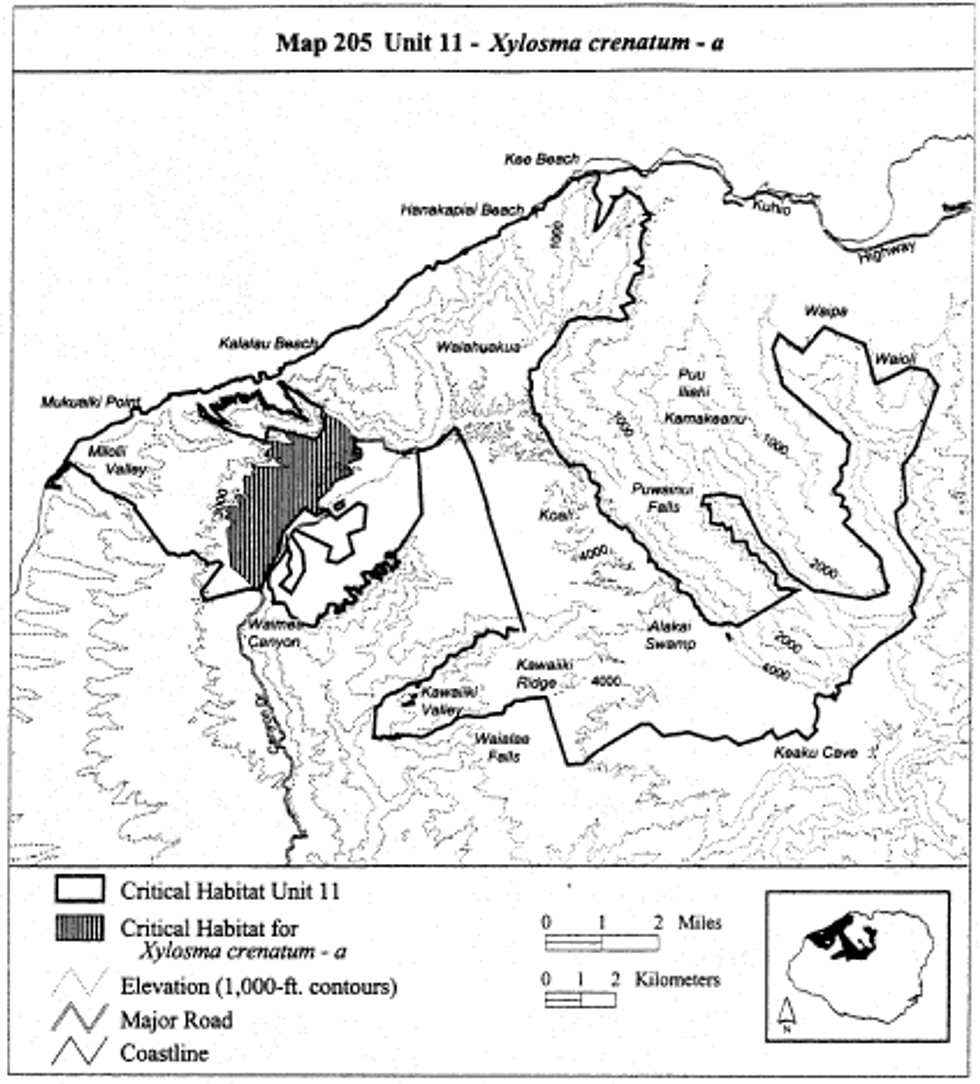
(cccxxxix) Kauai 11 - Zanthoxylum hawaiiense - a (523 ha; 1,292 ac)
(A) [Reserved]
(B) Excluding 2 areas:
(1) Bounded by the following 3 points (1 ha, 3 ac): Start at 435132, 2442248; 435160, 2442164; 434848, 2442098; return to starting point; and
(2) Bounded by the following 4 points (0 ha, 1 ac): Start at 435151, 2442425; 435215, 2442393; 435195, 2442353; 435128, 2442379; return to starting point.
(C) Map 206 follows:
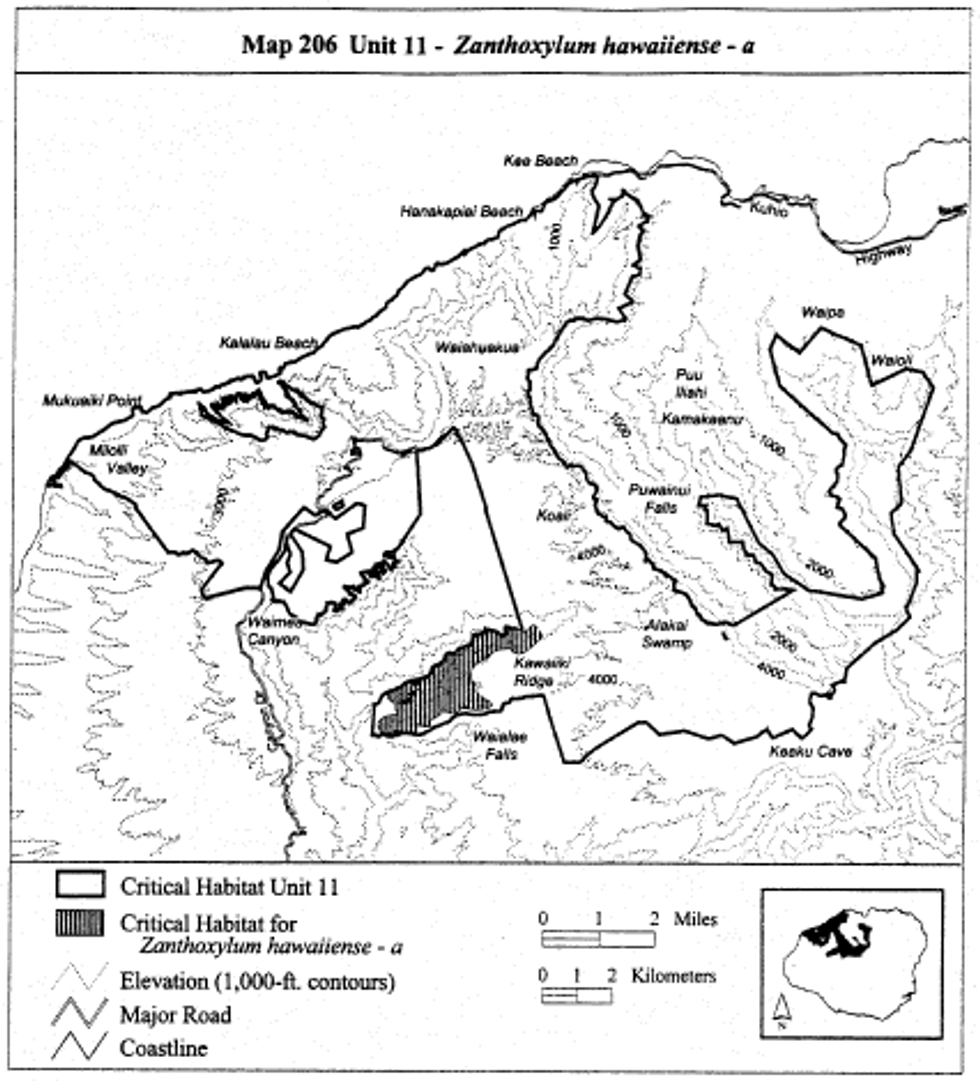
(cccxl) Kauai 12 - Nothocestrum peltatum - d (162 ha; 400 ac)
(A) [Reserved]
(B) Map 207 follows:
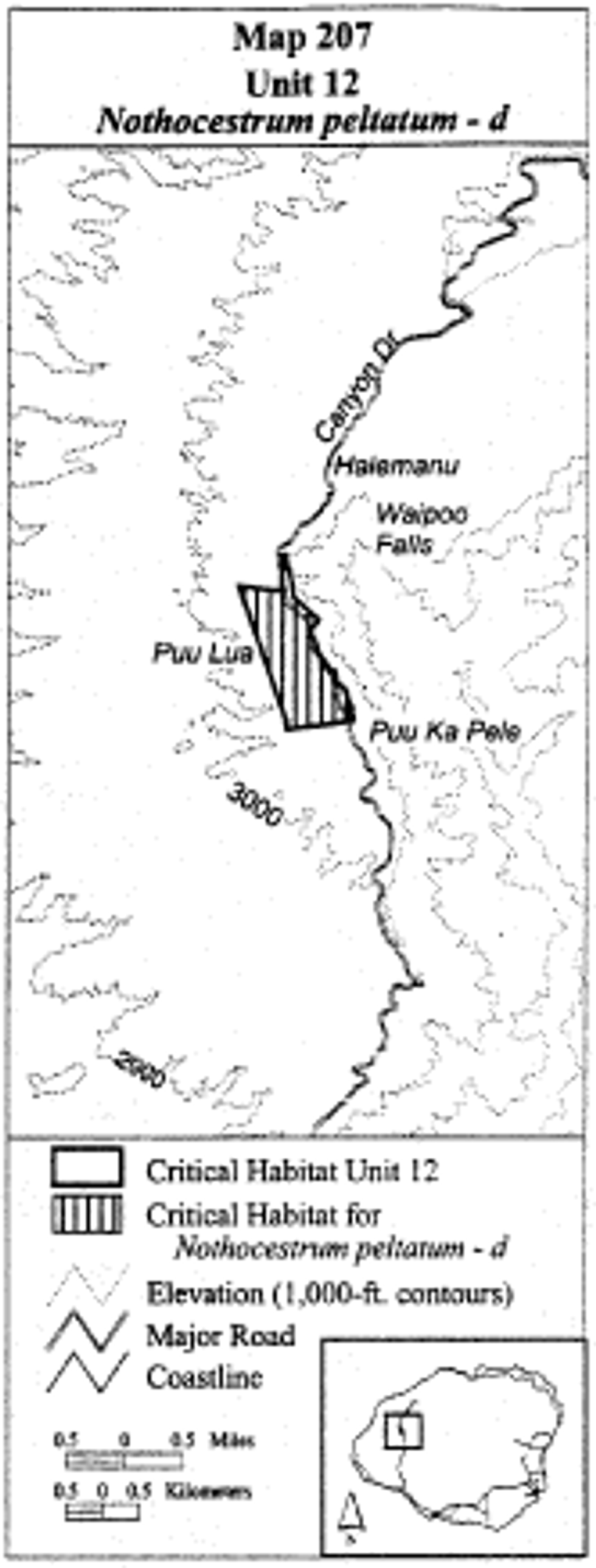
(cccxli) Kauai 12 - Remya kauaiensis - f (52 ha; 128 ac)
(A) [Reserved]
(B) Map 208 follows:
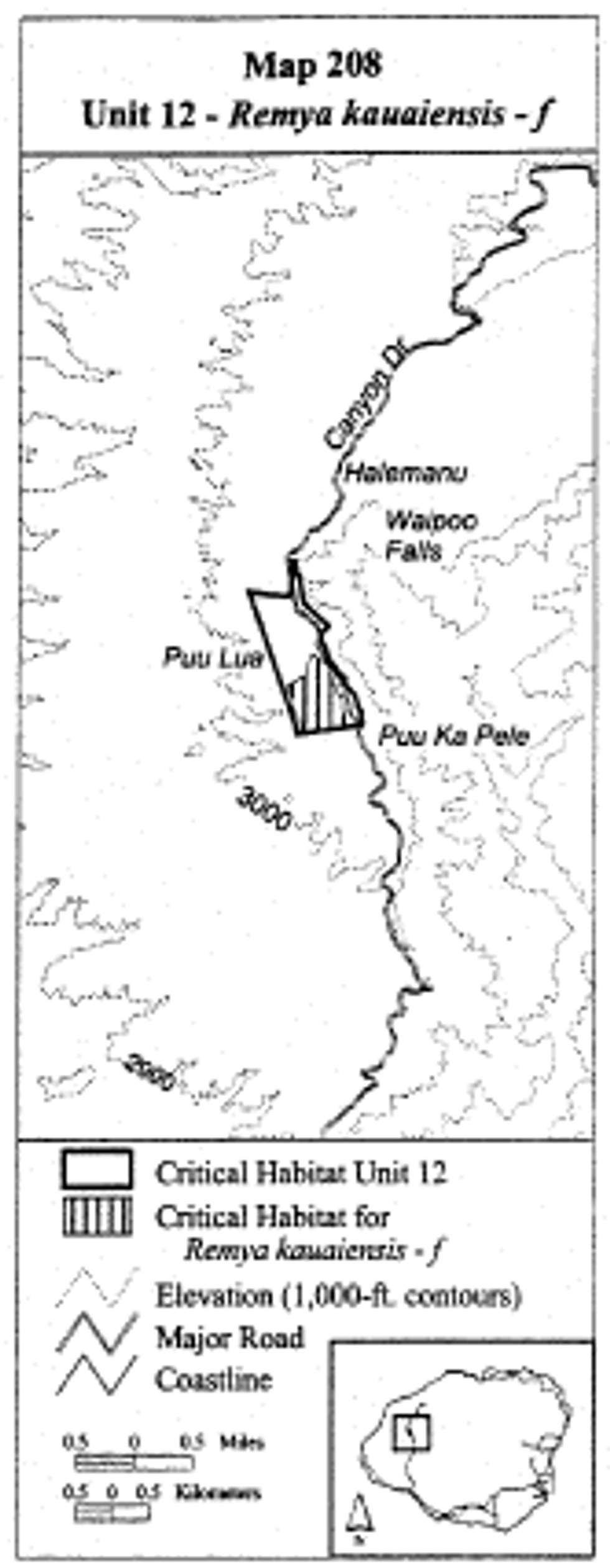
(cccxlii) Kauai 12 - Xylosma crenatum - b (52 ha; 128 ac)
(A) [Reserved]
(B) Map 209 follows:
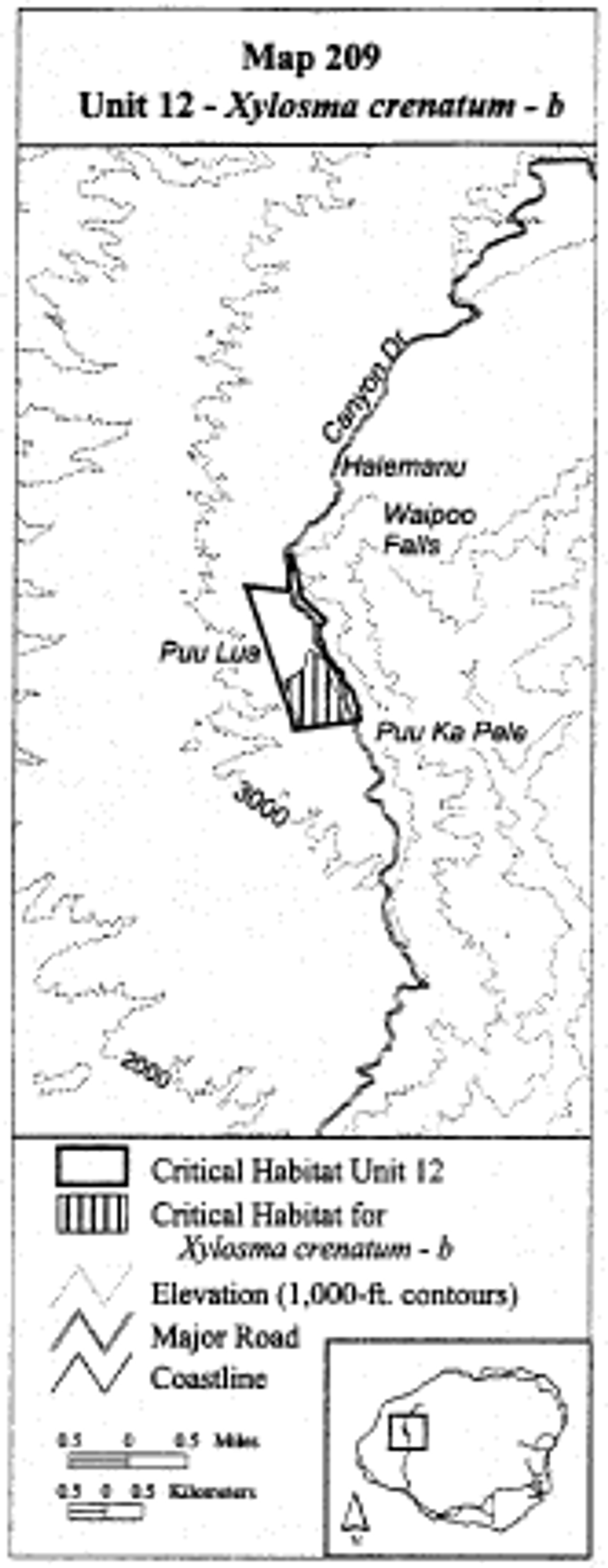
(cccxliii) Kauai 13 - Lipochaeta waimeaensis - a (56 ha; 139 ac)
(A) [Reserved]
(B) Map 210 follows:
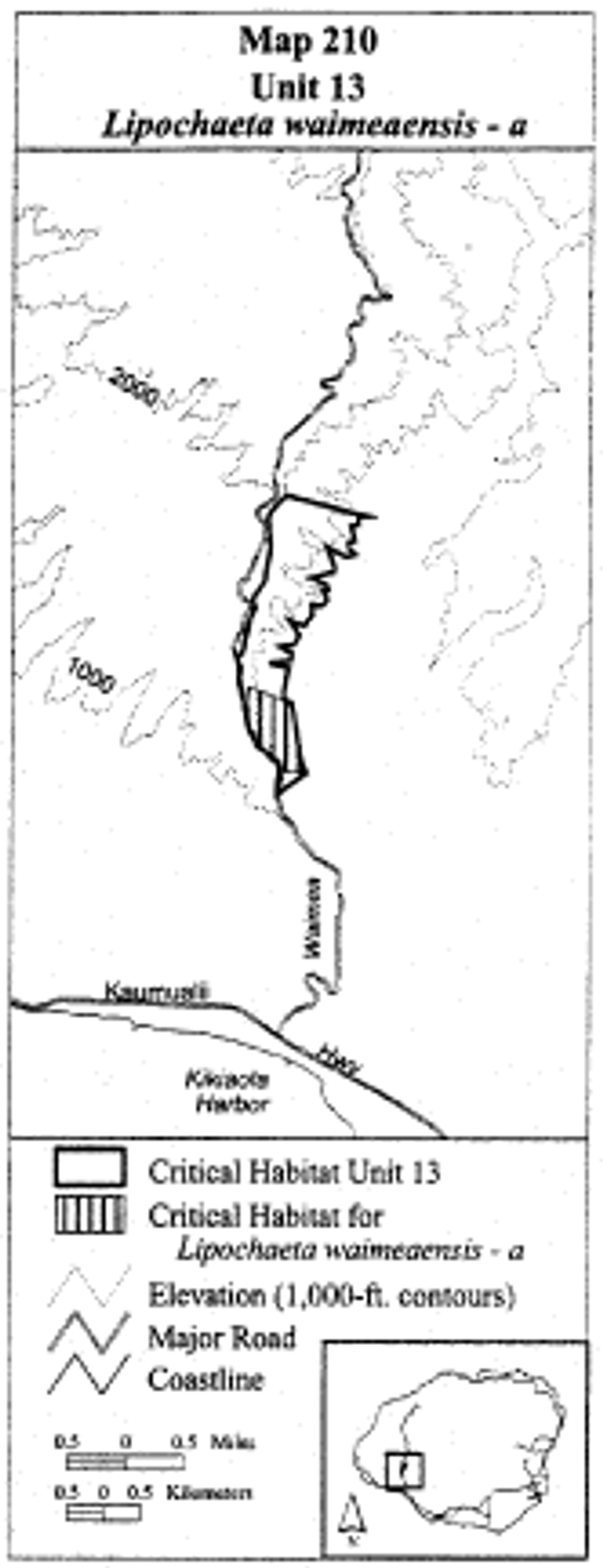
(cccxliv) Kauai 13 - Schiedea spergulina var. spergulina - c (221 ha; 545 ac)
(A) [Reserved]
(B) Map 211 follows:
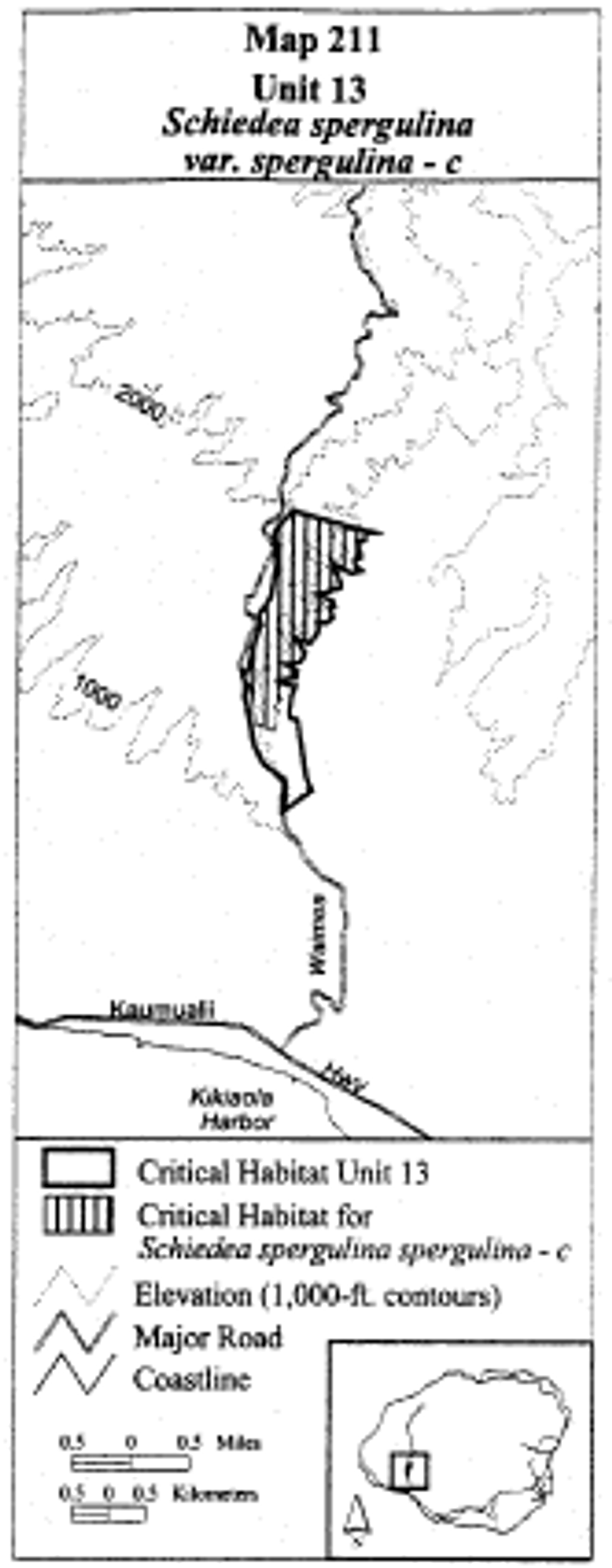
(cccxlv) Kauai 13 - Spermolepis hawaiiensis - b (87 ha; 215 ac)
(A) [Reserved]
(B) Map 212 follows:
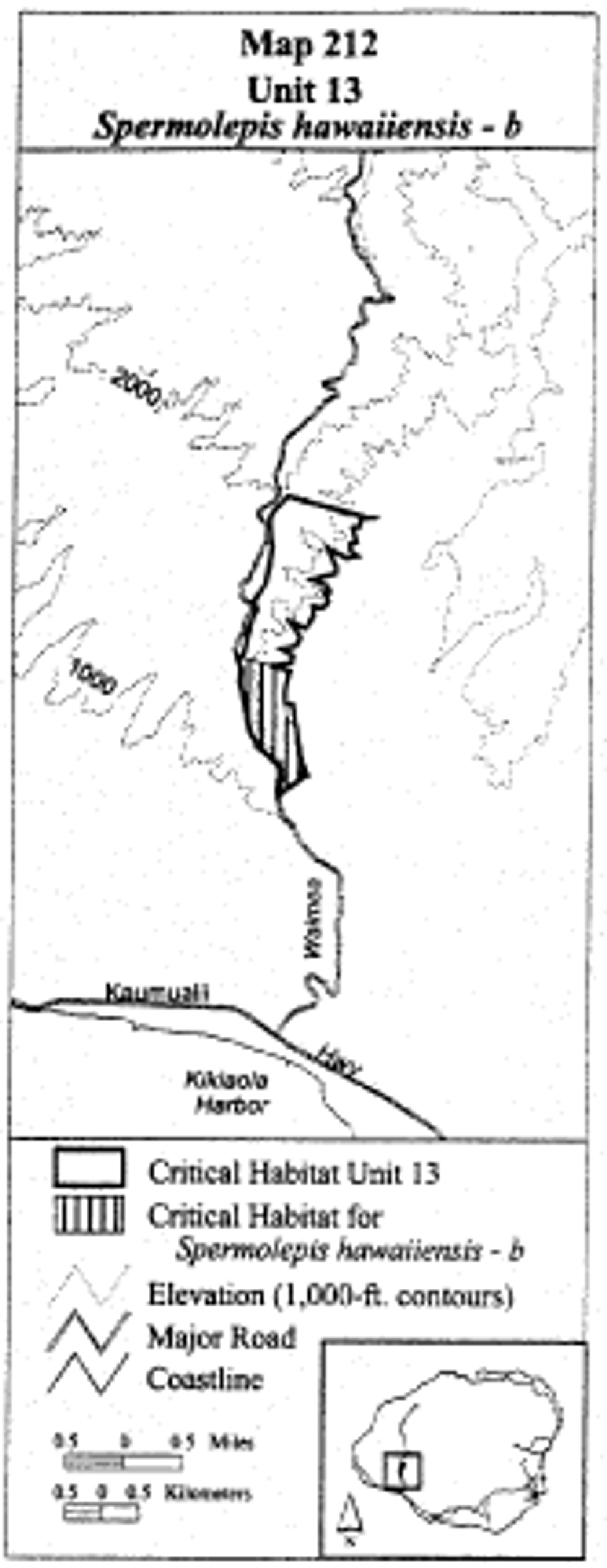
(cccxlvi) Kauai 14 - Panicum niihauense - a (120 ha; 297 ac)
(A) [Reserved]
(B) Map 213 follows:
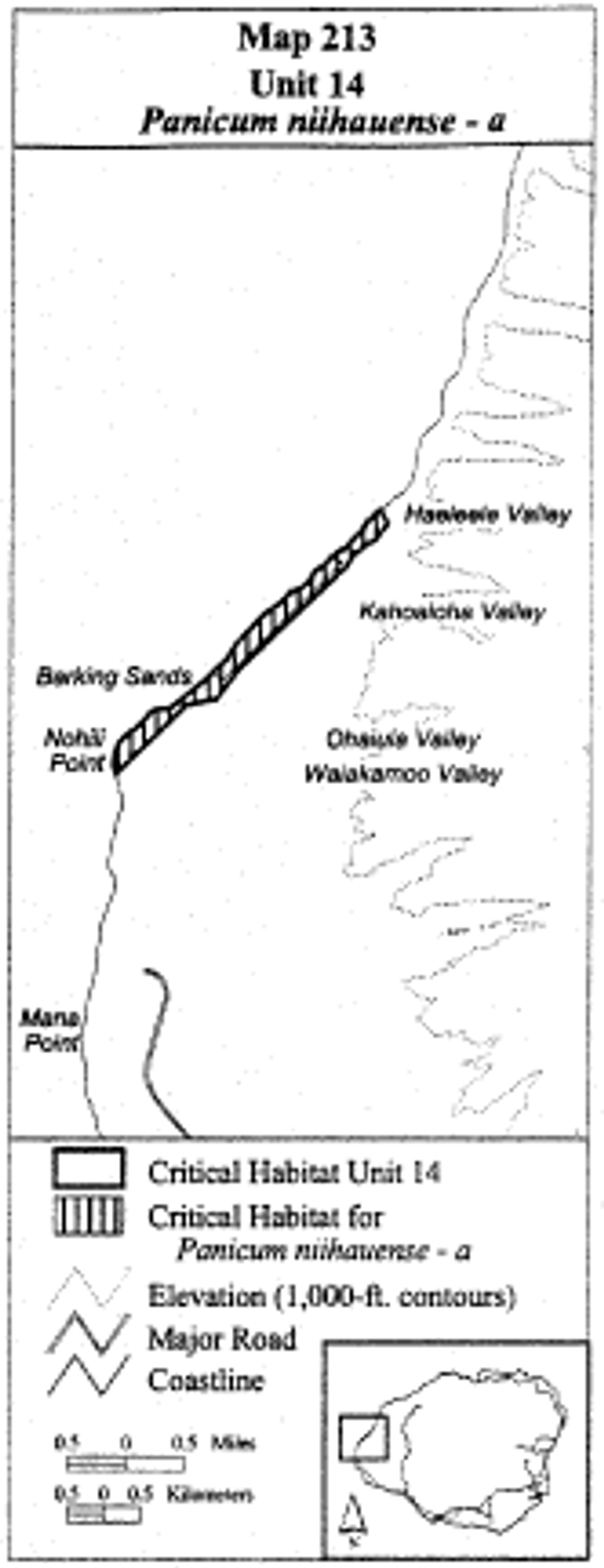
(cccxlvii) Kauai 14 - Sesbania tomentosa - b (44 ha; 110 ac)
(A) [Reserved]
(B) Map 214 follows:
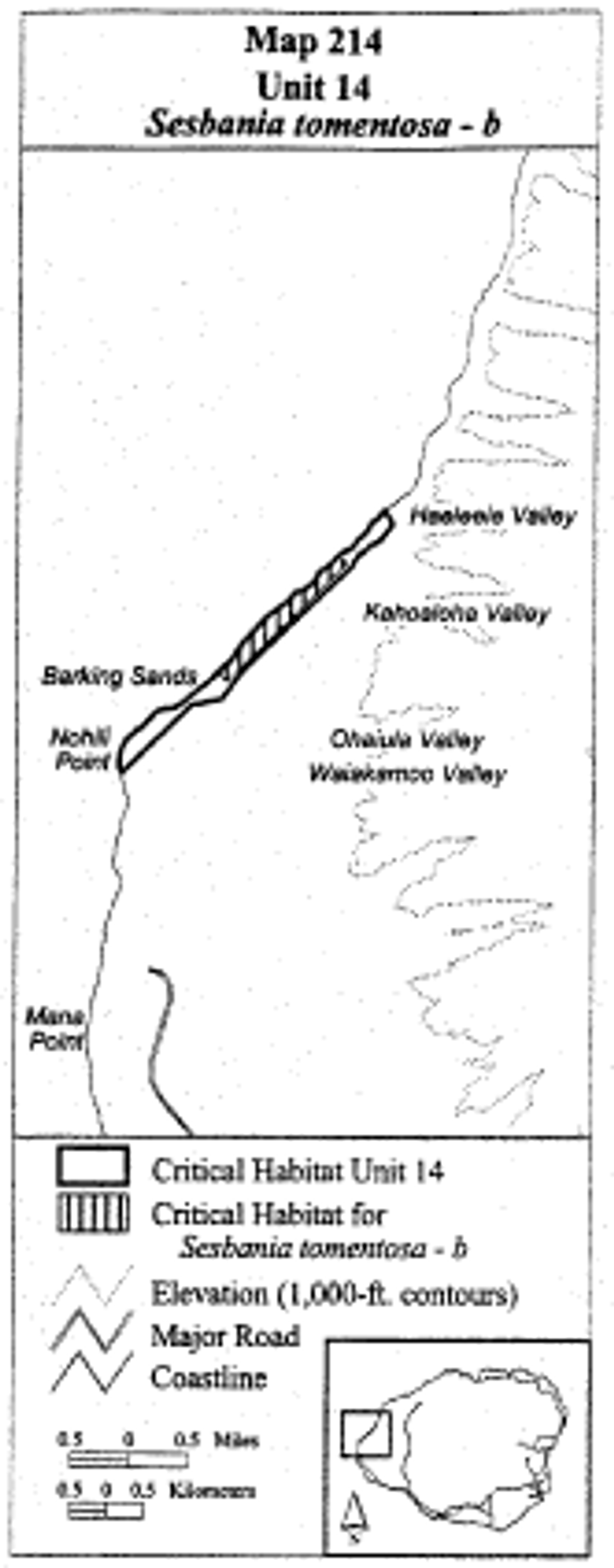
(cccxlviii) Kauai 15 - Panicum niihauense - b (16 ha; 39 ac)
(A) [Reserved]
(B) Map 215 follows:
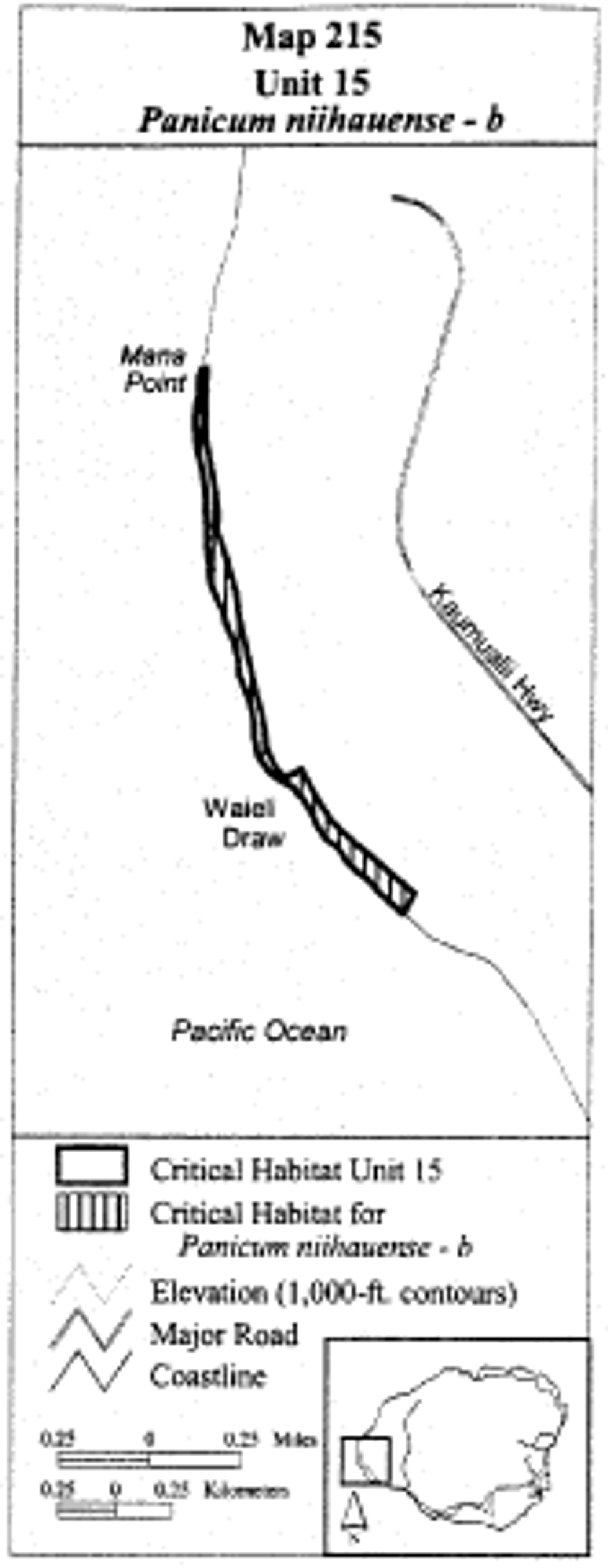
(cccxlix) Kauai 16 - Panicum niihauense - c (11 ha; 28 ac)
(A) [Reserved]
(B) Map 216 follows:
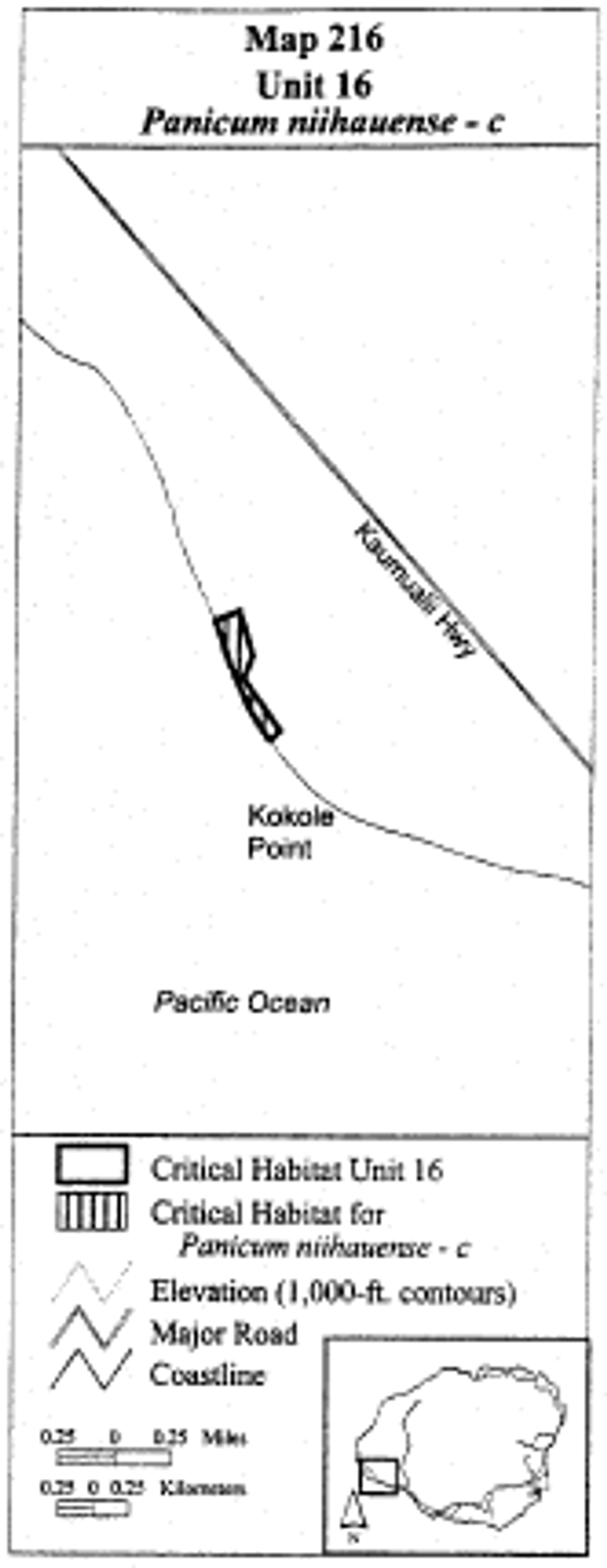
(cccl) Kauai 17 - Panicum niihauense - d (28 ha; 68 ac)
(A) [Reserved]
(B) Map 217 follows:
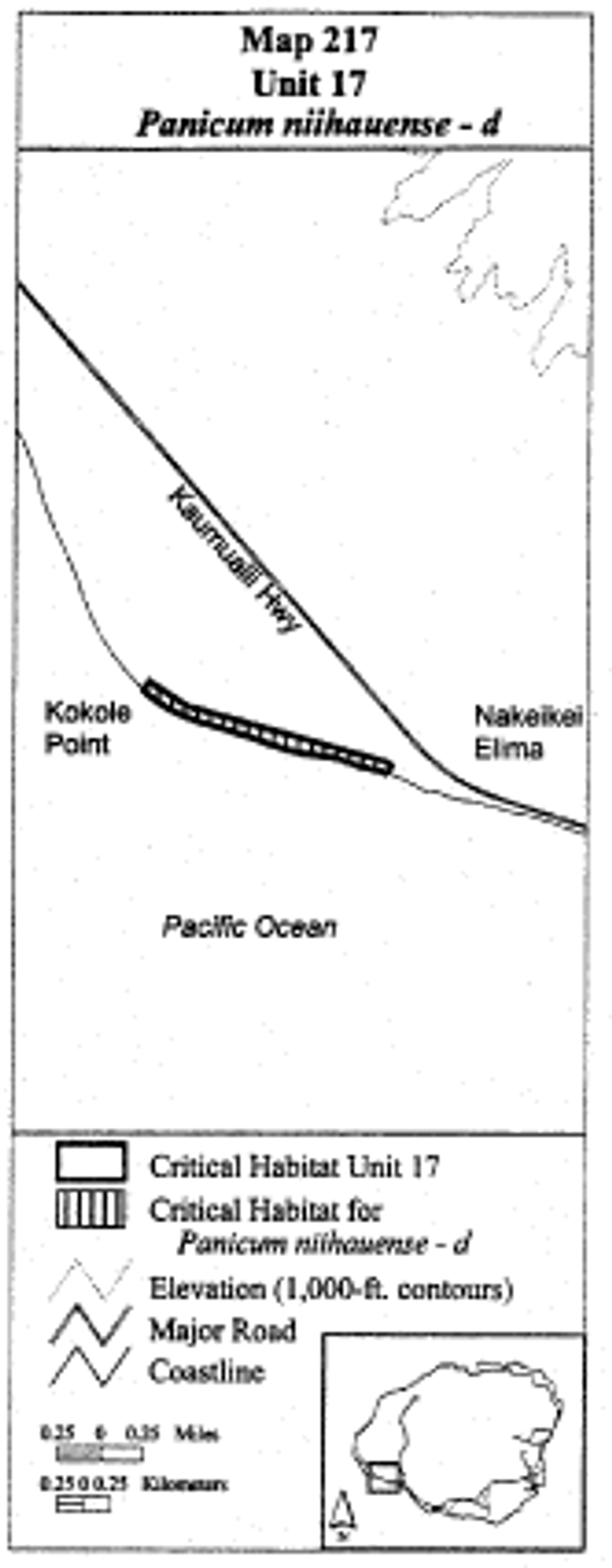
(cccli) Kauai 18 - Chamaesyce remyi var. kauaiensis-f
(A) This is a unit of the Wet Cliff ecosystem and consists of 296 ac (120 ha). This unit is also critical habitat for Kauai 18-Chamaesyce remyi var. remyi-k, Kauai 18-Cyanea dolichopoda-d, Kauai 18-Cyrtandra oenobarba-f, Kauai 18-Cyrtandra paliku-d, Kauai 18-Dubautia plantaginea ssp. magnifolia-d, Kauai 18-Lysimachia iniki-d, Kauai 18-Lysimachia pendens-d, Kauai 18- Lysimachia venosa-d, and Kauai 18- Melicope rostrata -k (see paragraphs (a)(1)(ccclii), (a)(1)(cccliii), (a)(1)(cccliv), (a)(1)(ccclv), (a)(1)(ccclvi), (a)(1)(ccclvii), (a)(1)(ccclviii), (a)(1)(ccclix), and (a)(1)(ccclx), respectively, of this section).
(B) Note: The reference to �Kauai 18- Platydesma rostrata -k� on the map is equivalent to �Kauai 18- Melicope rostrata -k�. Map 217a follows:
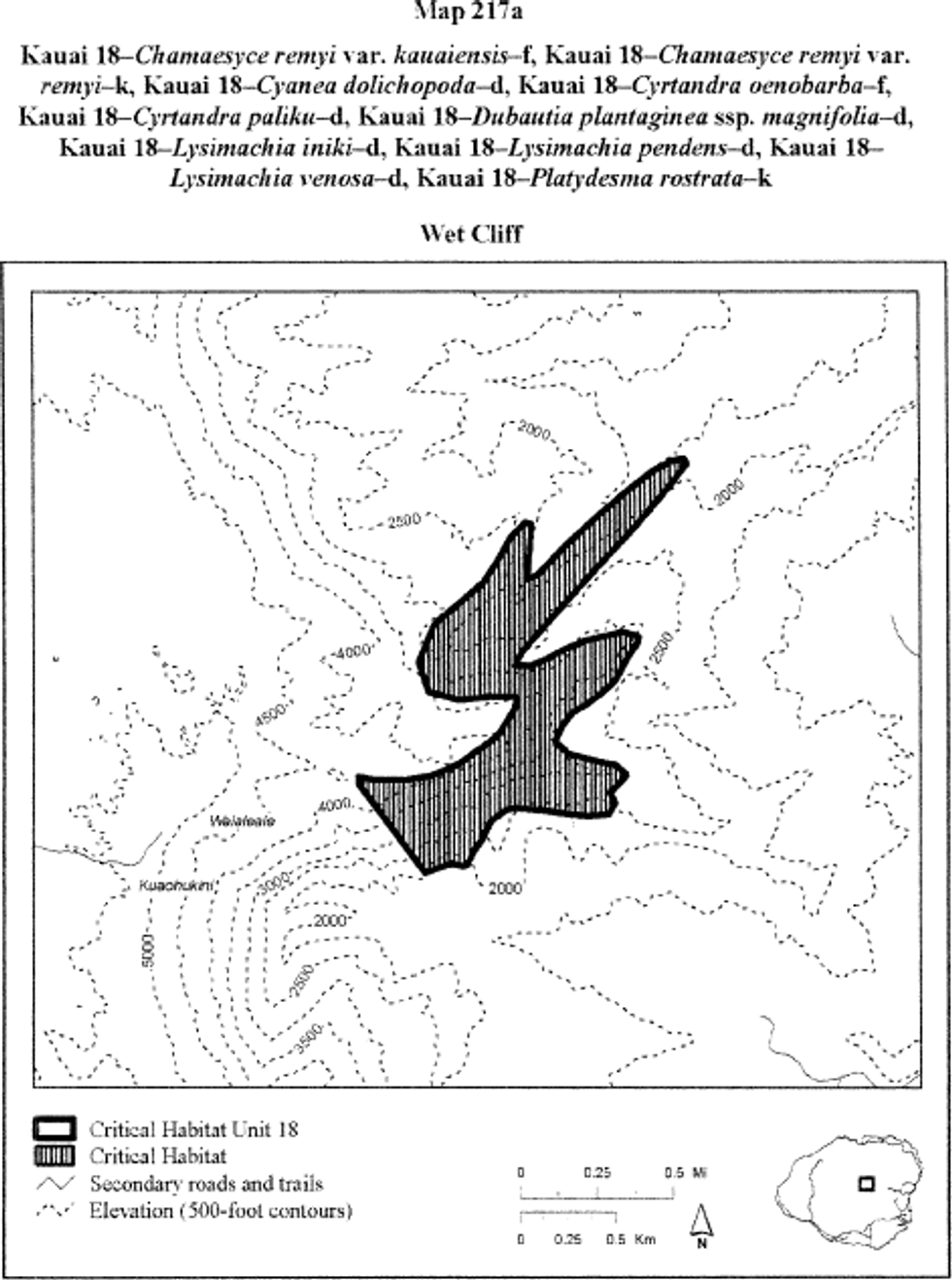
(ccclii) Kauai 18-Chamaesyce remyi var. remyi-k
(A) [Reserved]
(B) See paragraph (a)(1)(cccli)(B) of this section for the map of this unit.
(cccliii) Kauai 18-Cyanea dolichopoda-d
(A) [Reserved]
(B) See paragraph (a)(1)(cccli)(B) of this section for the map of this unit.
(cccliv) Kauai 18-Cyrtandra oenobarba-f
(A) [Reserved]
(B) See paragraph (a)(1)(cccli)(B) of this section for the map of this unit.
(ccclv) Kauai 18-Cyrtandra paliku-d
(A) [Reserved]
(B) See paragraph (a)(1)(cccli)(B) of this section for the map of this unit.
(ccclvi) Kauai 18-Dubautia plantaginea ssp. magnifolia-d
(A) [Reserved]
(B) See paragraph (a)(1)(cccli)(B) of this section for the map of this unit.
(ccclvii) Kauai 18-Lysimachia iniki-d
(A) [Reserved]
(B) See paragraph (a)(1)(cccli)(B) of this section for the map of this unit.
(ccclviii) Kauai 18-Lysimachia pendens-d
(A) [Reserved]
(B) See paragraph (a)(1)(cccli)(B) of this section for the map of this unit.
(ccclix) Kauai 18-Lysimachia venosa-d
(A) [Reserved]
(B) See paragraph (a)(1)(cccli)(B) of this section for the map of this unit.
(ccclx) Kauai 18- Melicope rostrata -k
(A) [Reserved]
(B) See paragraph (a)(1)(cccli)(B) of this section for the map of this unit.
(ccclxi) Kauai 19-Chamaesyce remyi var. kauaiensis-g
(A) This is a unit of the Wet Cliff ecosystem and consists of 23 ac (9 ha). This unit is also critical habitat for Kauai 19-Chamaesyce remyi var. remyi-l, Kauai 19-Cyanea dolichopoda-e, Kauai 19-Cyrtandra oenobarba-g, Kauai 19-Cyrtandra paliku-e, Kauai 19-Dubautia plantaginea ssp. magnifolia-e, Kauai 19-Lysimachia iniki-e, Kauai 19-Lysimachia pendens-e, Kauai 19-Lysimachia venosa-e, and Kauai 19- Melicope rostrata -l (see paragraphs (a)(1)(ccclxii), (a)(1)(ccclxiii), (a)(1)(ccclxiv), (a)(1)(ccclxv), (a)(1)(ccclxvi), (a)(1)(ccclxvii), (a)(1)(ccclxviii), (a)(1)(ccclxix), and (a)(1)(ccclxx), respectively, of this section).
((B) Note: The reference to �Kauai 19- Platydesma rostrata -l� on the map is equivalent to �Kauai 19- Melicope rostrata -l�. Map 217b follows:
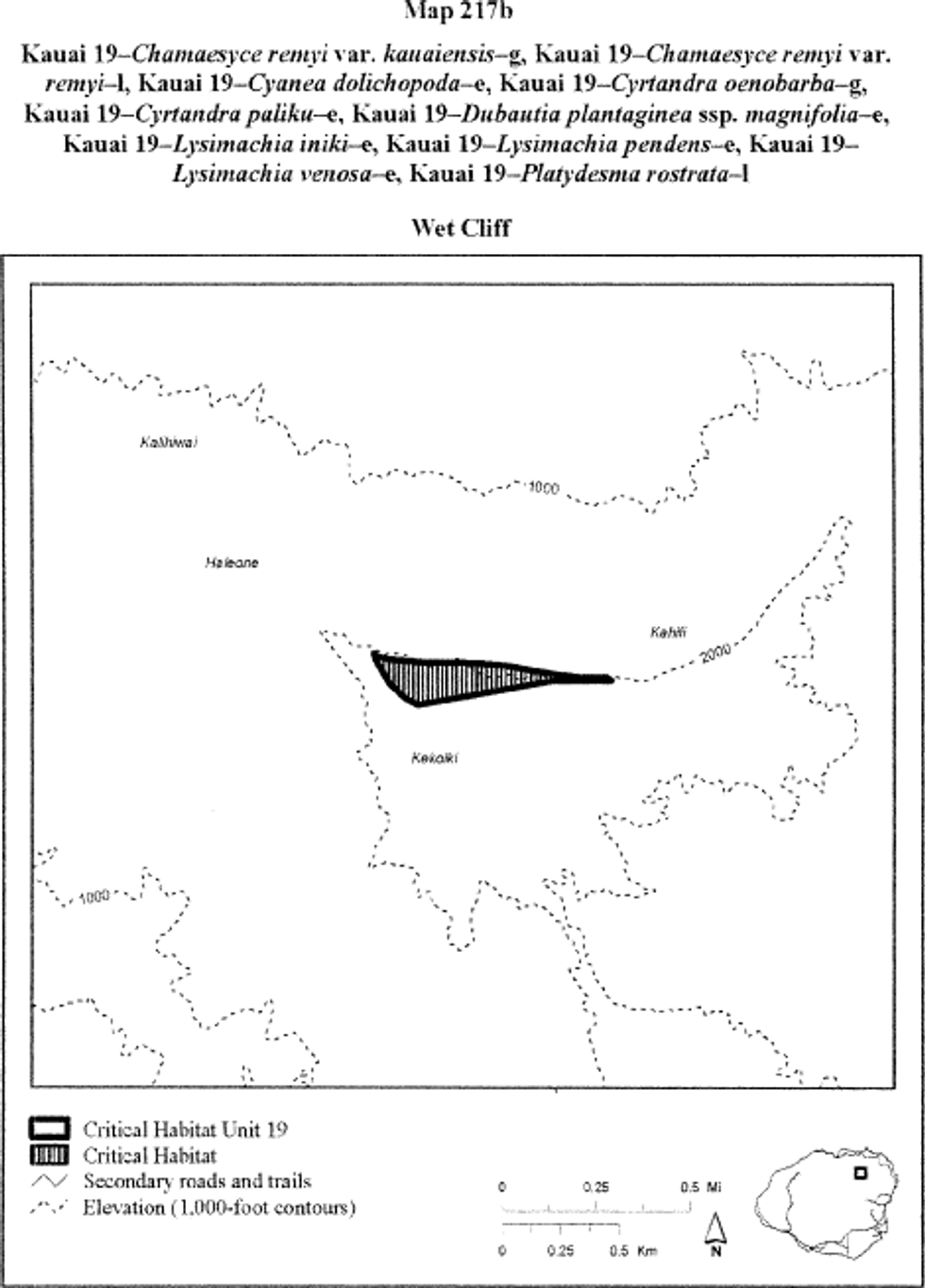
(ccclxii) Kauai 19-Chamaesyce remyi var. remyi-l
(A) [Reserved]
(B) See paragraph (a)(1)(ccclxi)(B) of this section for the map of this unit.
(ccclxiii) Kauai 19-Cyanea dolichopoda-e
(A) [Reserved]
(B) See paragraph (a)(1)(ccclxi)(B) of this section for the map of this unit.
(ccclxiv) Kauai 19-Cyrtandra oenobarba-g
(A) [Reserved]
(B) See paragraph (a)(1)(ccclxi)(B) of this section for the map of this unit.
(ccclxv) Kauai 19-Cyrtandra paliku-e
(A) [Reserved]
(B) See paragraph (a)(1)(ccclxi)(B) of this section for the map of this unit.
(ccclxvi) Kauai 19-Dubautia plantaginea ssp. magnifolia-e
(A) [Reserved]
(B) See paragraph (a)(1)(ccclxi)(B) of this section for the map of this unit.
(ccclxvii) Kauai 19-Lysimachia iniki-e
(A) [Reserved]
(B) See paragraph (a)(1)(ccclxi)(B) of this section for the map of this unit.
(ccclxviii) Kauai 19-Lysimachia pendens-e
(A) [Reserved]
(B) See paragraph (a)(1)(ccclxi)(B) of this section for the map of this unit.
(ccclxix) Kauai 19-Lysimachia venosa-e
(A) [Reserved]
(B) See paragraph (a)(1)(ccclxi)(B) of this section for the map of this unit.
(ccclxx) Kauai 19- Melicope rostrata -l
(A) [Reserved]
(B) See paragraph (a)(1)(ccclxi)(B) of this section for the map of this unit.
(ccclxxi) Kauai 20-Chamaesyce remyi var. kauaiensis-h
(A) This is a unit of the Lowland Wet ecosystem and consists of 65 ac (26 ha). This unit is also critical habitat for Kauai 20-Chamaesyce remyi var. remyi-m, Kauai 20-Charpentiera densiflora-e, Kauai 20-Cyanea eleeleensis-c, Kauai 20-Cyanea kolekoleensis-c, Kauai 20-Cyanea kuhihewa-c, Kauai 20-Cyrtandra oenobarba-h, Kauai 20-Dubautia imbricata ssp. imbricata-c, Kauai 20-Labordia helleri-h, Kauai 20-Melicope paniculata-c, Kauai 20-Melicope puberula-e, Kauai 20-Phyllostegia renovans-e, Kauai 20- Melicope rostrata -m, Kauai 20-Stenogyne kealiae-e, Kauai 20-Tetraplasandra bisattenuata-e, and Kauai 20-Tetraplasandra flynnii-f, (see paragraphs (a)(1)(ccclxxii), (a)(1)(ccclxxiii), (a)(1)(ccclxxiv), (a)(1)(ccclxxv), (a)(1)(ccclxxvi), (a)(1)(ccclxxvii), (a)(1)(ccclxxviii), (a)(1)(ccclxxix), (a)(1)(ccclxxx), (a)(1)(ccclxxxi), (a)(1)(ccclxxxii), (a)(1)(ccclxxxiii), (a)(1)(ccclxxxiv), (a)(1)(ccclxxxv), and (a)(1)(ccclxxxvi), respectively, of this section).
(B) Note: The reference to �Kauai 20- Platydesma rostrata -m� on the map is equivalent to �Kauai 20- Melicope rostrata -m�. Map 217c follows:
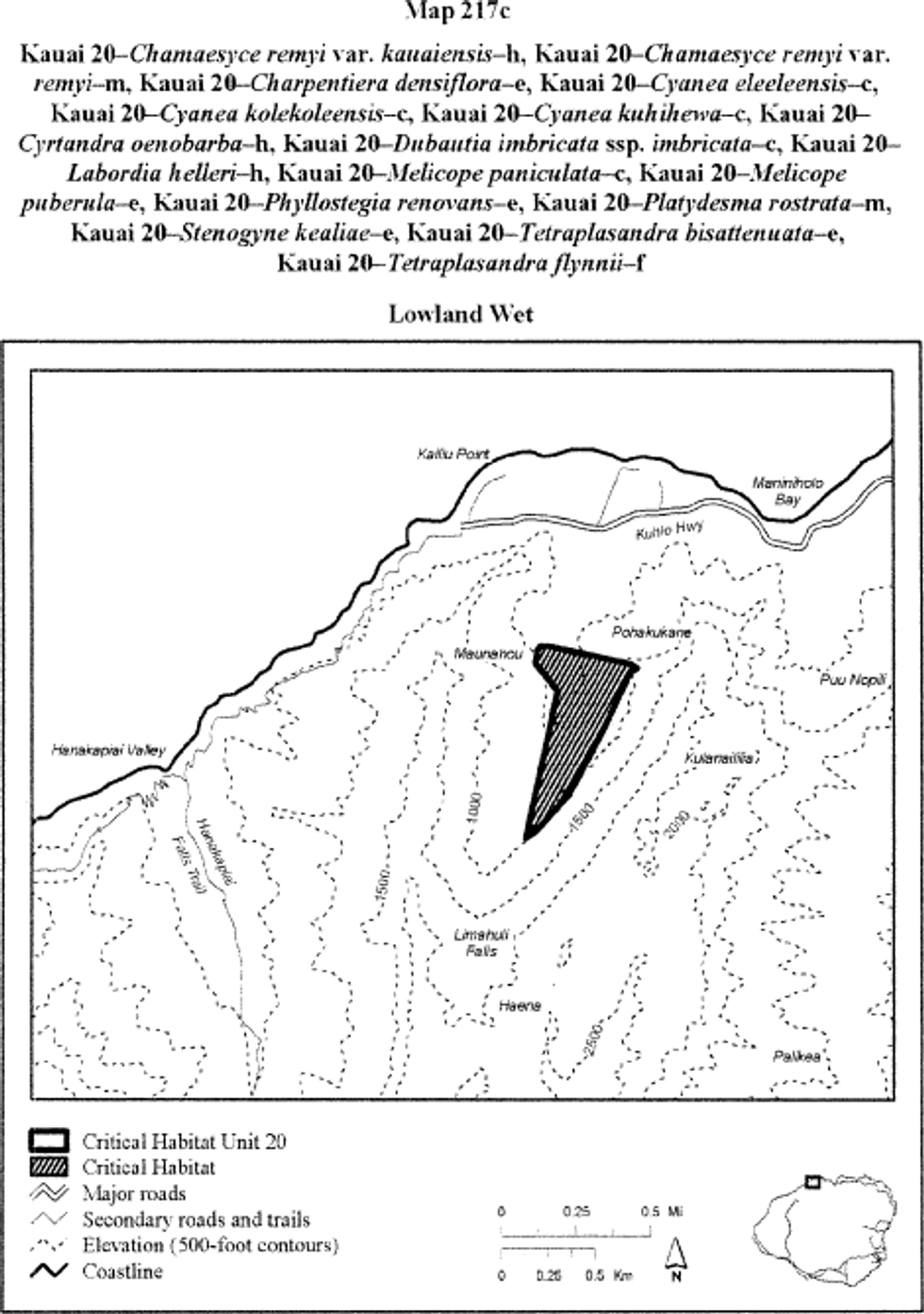
(ccclxxii) Kauai 20-Chamaesyce remyi var. remyi-m
(A) [Reserved]
(B) See paragraph (a)(1)(ccclxxi)(B) of this section for the map of this unit.
(ccclxxiii) Kauai 20-Charpentiera densiflora-e
(A) [Reserved]
(B) See paragraph (a)(1)(ccclxxi)(B) of this section for the map of this unit.
(ccclxxiv) Kauai 20-Cyanea eleeleensis-c
(A) [Reserved]
(B) See paragraph (a)(1)(ccclxxi)(B) of this section for the map of this unit.
(ccclxxv) Kauai 20-Cyanea kolekoleensis-c
(A) [Reserved]
(B) See paragraph (a)(1)(ccclxxi)(B) of this section for the map of this unit.
(ccclxxvi) Kauai 20-Cyanea kuhihewa-c
(A) [Reserved]
(B) See paragraph (a)(1)(ccclxxi)(B) of this section for the map of this unit.
(ccclxxvii) Kauai 20-Cyrtandra oenobarba-h
(A) [Reserved]
(B) See paragraph (a)(1)(ccclxxi)(B) of this section for the map of this unit.
(ccclxxviii) Kauai 20-Dubautia imbricata ssp. imbricata-c
(A) [Reserved]
(B) See paragraph (a)(1)(ccclxxi)(B) of this section for the map of this unit.
(ccclxxix) Kauai 20-Labordia helleri-h
(A) [Reserved]
(B) See paragraph (a)(1)(ccclxxi)(B) of this section for the map of this unit.
(ccclxxx) Kauai 20-Melicope paniculata-c
(A) [Reserved]
(B) See paragraph (a)(1)(ccclxxi)(B) of this section for the map of this unit.
(ccclxxxi) Kauai 20-Melicope puberula-e
(A) [Reserved]
(B) See paragraph (a)(1)(ccclxxi)(B) of this section for the map of this unit.
(ccclxxxii) Kauai 20-Phyllostegia renovans-e
(A) [Reserved]
(B) See paragraph (a)(1)(ccclxxi)(B) of this section for the map of this unit.
(ccclxxxiii) Kauai 20- Melicope rostrata -m
(A) [Reserved]
(B) See paragraph (a)(1)(ccclxxi)(B) of this section for the map of this unit.
(ccclxxxiv) Kauai 20-Stenogyne kealiae-e
(A) [Reserved]
(B) See paragraph (a)(1)(ccclxxi)(B) of this section for the map of this unit.
(ccclxxxv) Kauai 20-Tetraplasandra bisattenuata-e
(A) [Reserved]
(B) See paragraph (a)(1)(ccclxxi)(B) of this section for the map of this unit.
(ccclxxxvi) Kauai 20-Tetraplasandra flynnii-f
(A) [Reserved]
(B) See paragraph (a)(1)(ccclxxi)(B) of this section for the map of this unit.
(ccclxxxvii) Kauai 21-Chamaesyce remyi var. remyi-n
(A) This is a unit of the Montane Mesic ecosystem and consists of 8 ac (3 ha). This unit is also critical habitat for Kauai 21-Diellia mannii-b, Kauai 21-Labordia helleri-i, Kauai 21-Myrsine knudsenii-b, Kauai 21-Myrsine mezii-d, Kauai 21- Melicope rostrata -n, Kauai 21-Psychotria grandiflora-d, Kauai 21-Stenogyne kealiae-f, and Kauai 21-Tetraplasandra flynnii-g (see paragraphs (a)(1)(ccclxxxviii), (a)(1)(ccclxxxix), (a)(1)(cccxc), (a)(1)(cccxci), (a)(1)(cccxcii), (a)(1)(cccxciii), (a)(1)(cccxciv), and (a)(1)(cccxcv), respectively, of this section).
(B) Note: The reference to �Kauai 21- Platydesma rostrata -n� on the map is equivalent to �Kauai 21- Melicope rostrata -n�. Map 217d follows:
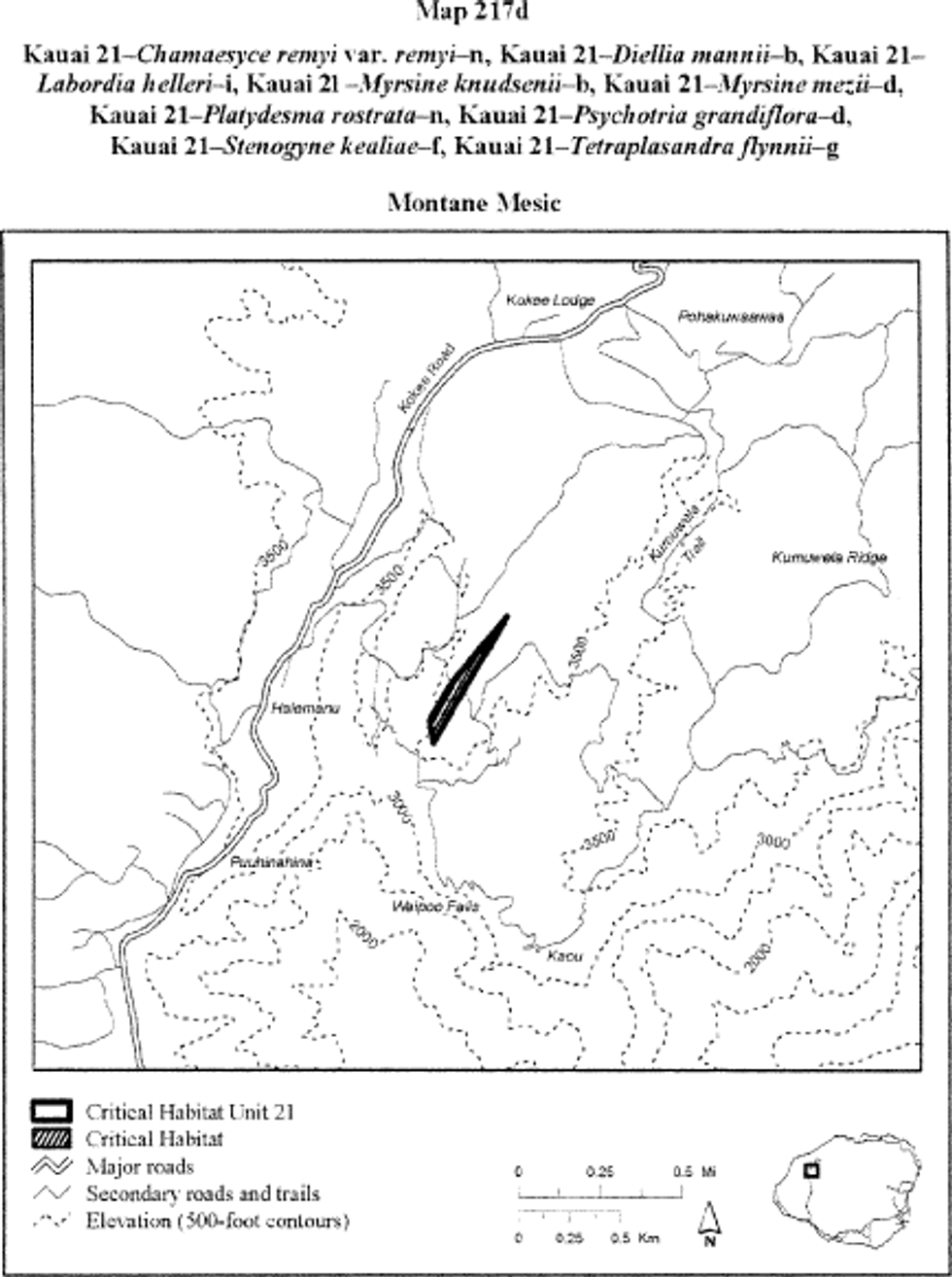
(ccclxxxviii) Kauai 21-Diellia mannii-b
(A) [Reserved]
(B) See paragraph (a)(1)(ccclxxxvii)(B) of this section for the map of this unit.
(ccclxxxix) Kauai 21-Labordia helleri-i
(A) [Reserved]
(B) See paragraph (a)(1)(ccclxxxvii)(B) of this section for the map of this unit.
(cccxc) Kauai 21-Myrsine knudsenii-b
(A) [Reserved]
(B) See paragraph (a)(1)(ccclxxxvii)(B) of this section for the map of this unit.
(cccxci) Kauai 21-Myrsine mezii-d
(A) [Reserved]
(B) See paragraph (a)(1)(ccclxxxvii)(B) of this section for the map of this unit.
(cccxcii) Kauai 21- Melicope rostrata -n
(A) [Reserved]
(B) See paragraph (a)(1)(ccclxxxvii)(B) of this section for the map of this unit.
(cccxciii) Kauai 21-Psychotria grandiflora-d
(A) [Reserved]
(B) See paragraph (a)(1)(ccclxxxvii)(B) of this section for the map of this unit.
(cccxciv) Kauai 21-Stenogyne kealiae-f
(A) [Reserved]
(B) See paragraph (a)(1)(ccclxxxvii)(B) of this section for the map of this unit.
(cccxcv) Kauai 21-Tetraplasandra flynnii-g
(A) [Reserved]
(B) See paragraph (a)(1)(ccclxxxvii)(B) of this section for the map of this unit.
(cccxcvi) Kauai 22-Chamaesyce remyi var. remyi-o
(A) This is a unit of the Montane Mesic ecosystem and consists of 139 ac (56 ha). This unit is also critical habitat for Kauai 22-Diellia mannii-c, Kauai 22-Labordia helleri-j, Kauai 22-Myrsine knudsenii-c, Kauai 22-Myrsine mezii-e, Kauai 22- Melicope rostrata -o, Kauai 22-Psychotria grandiflora-e, Kauai 22-Stenogyne kealiae-g, and Kauai 22-Tetraplasandra flynnii-h (see paragraphs (a)(1)(cccxcvii), (a)(1)(cccxcviii), (a)(1)(cccxcix), (a)(1)(cd), (a)(1)(cdi), (a)(1)(cdii), (a)(1)(cdiii), and (a)(1)(cdiv), respectively, of this section).
(B) Note: The reference to �Kauai 22- Platydesma rostrata -o� on the map is equivalent to �Kauai 22- Melicope rostrata -o�. Map 217e follows:
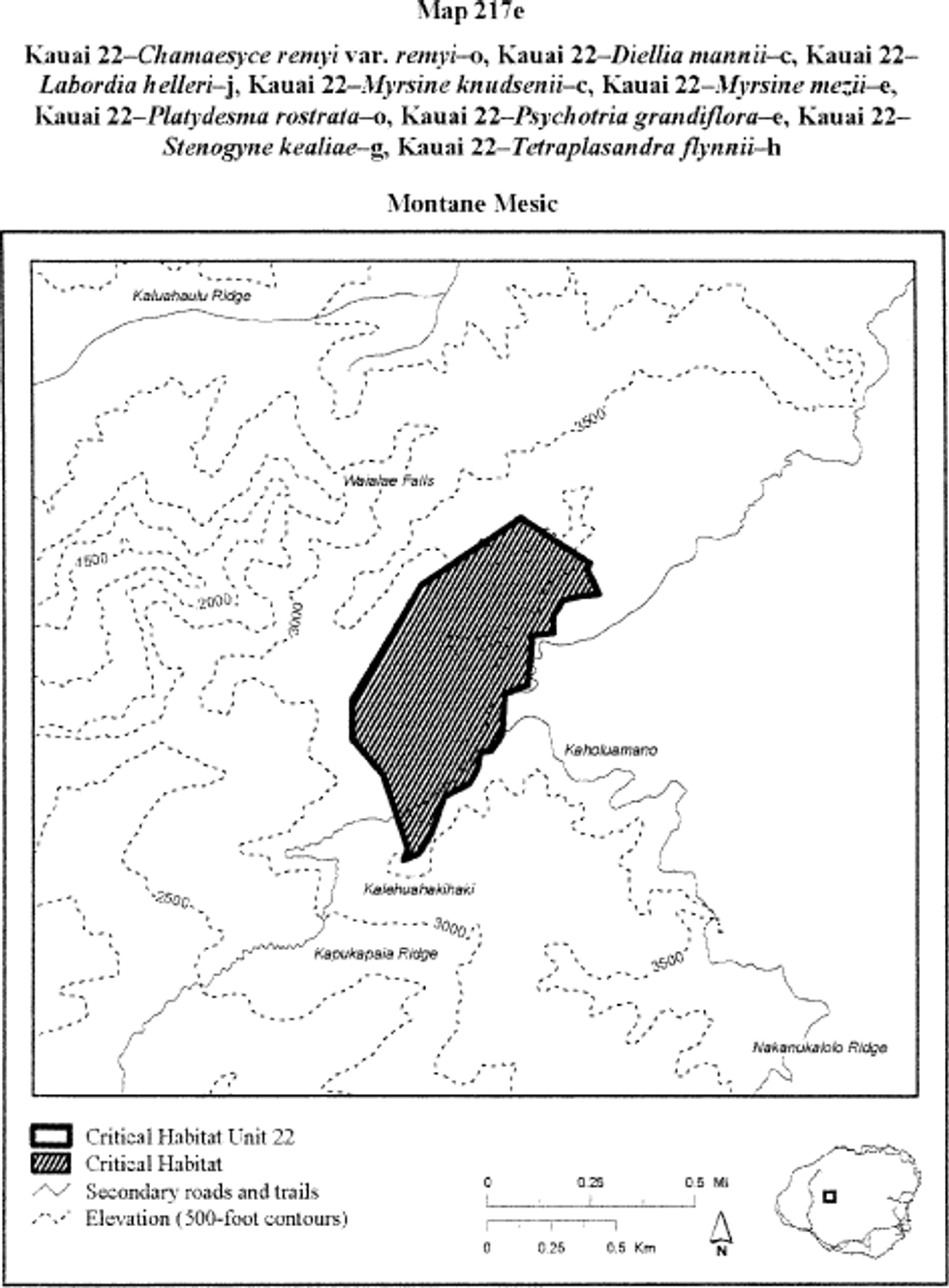
(cccxcvii) Kauai 22-Diellia mannii-c
(A) [Reserved]
(B) See paragraph (a)(1)(cccxcvi)(B) of this section for the map of this unit.
(cccxcviii) Kauai 22-Labordia helleri-j
(A) [Reserved]
(B) See paragraph (a)(1)(cccxcvi)(B) of this section for the map of this unit.
(cccxcix) Kauai 22-Myrsine knudsenii-c
(A) [Reserved]
(B) See paragraph (a)(1)(cccxcvi)(B) of this section for the map of this unit.
(cd) Kauai 22-Myrsine mezii-e
(A) [Reserved]
(B) See paragraph (a)(1)(cccxcvi)(B) of this section for the map of this unit.
(cdi) Kauai 22- Melicope rostrata -o
(A) [Reserved]
(B) See paragraph (a)(1)(cccxcvi)(B) of this section for the map of this unit.
(cdii) Kauai 22-Psychotria grandiflora-e
(A) [Reserved]
(B) See paragraph (a)(1)(cccxcvi)(B) of this section for the map of this unit.
(cdiii) Kauai 22-Stenogyne kealiae-g
(A) [Reserved]
(B) See paragraph (a)(1)(cccxcvi)(B) of this section for the map of this unit.
(cdiv) Kauai 22-Tetraplasandra flynnii-h
(A) [Reserved]
(B) See paragraph (a)(1)(cccxcvi)(B) of this section for the map of this unit.
(cdv) Kauai 23-Astelia waialealae-c
(A) This is a unit of the Montane Wet ecosystem and consists of 0.4 ac (0.2 ha). This unit is also critical habitat for Kauai 23-Chamaesyce remyi var. remyi-p, Kauai 23-Dryopteris crinalis var. podosorus-c, Kauai 23-Dubautia kalalauensis-c, Kauai 23-Dubautia waialealae-c, Kauai 23-Geranium kauaiense-c, Kauai 23-Keysseria erici-c, Kauai 23-Keysseria helenae-c, Kauai 23-Labordia helleri-k, Kauai 23-Labordia pumila-c, Kauai 23-Lysimachia daphnoides-c, Kauai 23-Melicope degeneri-c, Kauai 23-Melicope puberula-f, Kauai 23-Myrsine mezii-f, Kauai 23-Phyllostegia renovans-f, Kauai 23- Melicope rostrata -p, Kauai 23-Psychotria grandiflora-f, and Kauai 23-Tetraplasandra flynnii-i (see paragraphs (a)(1)(cdvi), (a)(1)(cdvii), (a)(1)(cdviii), (a)(1)(cdix), (a)(1)(cdx), (a)(1)(cdxi), (a)(1)(cdxii), (a)(1)(cdxiii), (a)(1)(cdxiv), (a)(1)(cdxv), (a)(1)(cdxvi), (a)(1)(cdxvii), (a)(1)(cdxviii), (a)(1)(cdxix), (a)(1)(cdxx), (a)(1)(cdxxi), and (a)(1)(cdxxii), respectively, of this section).
(B) Note: The reference to �Kauai 23- Platydesma rostrata -p� on the map is equivalent to �Kauai 23- Melicope rostrata -p�. Map 217f follows:
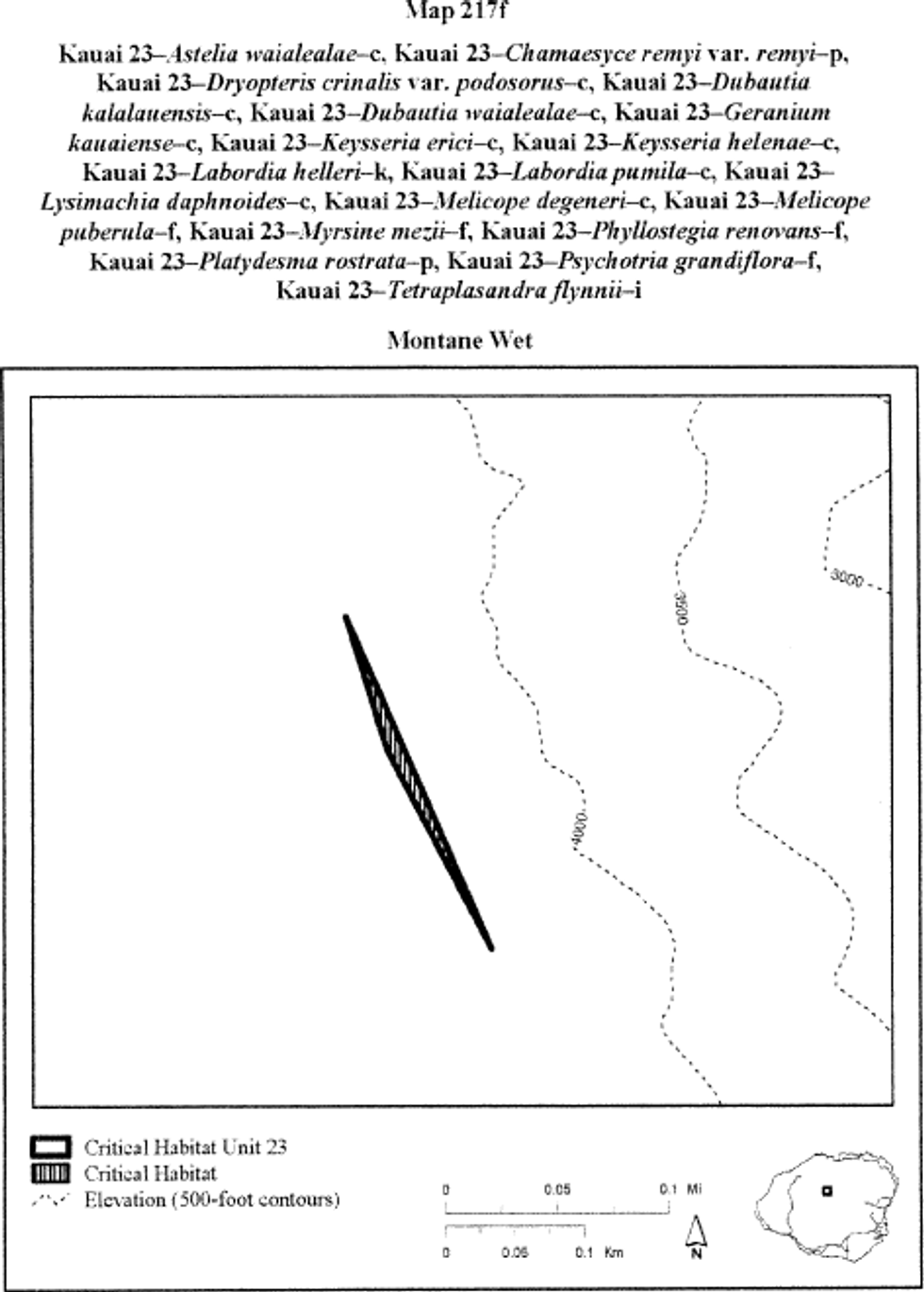
(cdvi) Kauai 23-Chamaesyce remyi var. remyi-p
(A) [Reserved]
(B) See paragraph (a)(1)(cdv)(B) of this section for the map of this unit.
(cdvii) Kauai 23-Dryopteris crinalis var. podosorus-c
(A) [Reserved]
(B) See paragraph (a)(1)(cdv)(B) of this section for the map of this unit.
(cdviii) Kauai 23-Dubautia kalalauensis-c
(A) [Reserved]
(B) See paragraph (a)(1)(cdv)(B) of this section for the map of this unit.
(cdix) Kauai 23-Dubautia waialealae-c
(A) [Reserved]
(B) See paragraph (a)(1)(cdv)(B) of this section for the map of this unit.
(cdx) Kauai 23-Geranium kauaiense-c
(A) [Reserved]
(B) See paragraph (a)(1)(cdv)(B) of this section for the map of this unit.
(cdxi) Kauai 23-Keysseria erici-c
(A) [Reserved]
(B) See paragraph (a)(1)(cdv)(B) of this section for the map of this unit.
(cdxii) Kauai 23-Keysseria helenae-c
(A) [Reserved]
(B) See paragraph (a)(1)(cdv)(B) of this section for the map of this unit.
(cdxiii) Kauai 23-Labordia helleri-k
(A) [Reserved]
(B) See paragraph (a)(1)(cdv)(B) of this section for the map of this unit.
(cdxiv) Kauai 23-Labordia pumila-c
(A) [Reserved]
(B) See paragraph (a)(1)(cdv)(B) of this section for the map of this unit.
(cdxv) Kauai 23-Lysimachia daphnoides-c
(A) [Reserved]
(B) See paragraph (a)(1)(cdv)(B) of this section for the map of this unit.
(cdxvi) Kauai 23-Melicope degeneri-c
(A) [Reserved]
(B) See paragraph (a)(1)(cdv)(B) of this section for the map of this unit.
(cdxvii) Kauai 23-Melicope puberula-f
(A) [Reserved]
(B) See paragraph (a)(1)(cdv)(B) of this section for the map of this unit.
(cdxviii) Kauai 23-Myrsine mezii-f
(A) [Reserved]
(B) See paragraph (a)(1)(cdv)(B) of this section for the map of this unit.
(cdxix) Kauai 23-Phyllostegia renovans-f
(A) [Reserved]
(B) See paragraph (a)(1)(cdv)(B) of this section for the map of this unit.
(cdxx) Kauai 23- Melicope rostrata -p
(A) [Reserved]
(B) See paragraph (a)(1)(cdv)(B) of this section for the map of this unit.
(cdxxi) Kauai 23-Psychotria grandiflora-f
(A) [Reserved]
(B) See paragraph (a)(1)(cdv)(B) of this section for the map of this unit.
(cdxxii) Kauai 23-Tetraplasandra flynnii-i
(A) [Reserved]
(B) See paragraph (a)(1)(cdv)(B) of this section for the map of this unit.
(cdxxiii) Kauai 24-Astelia waialealae-d
(A) This is a unit of the Montane Wet ecosystem and consists of 0.04 ac (0.01 ha). This unit is also critical habitat for Kauai 24-Chamaesyce remyi var. remyi-q, Kauai 24-Dryopteris crinalis var. podosorus-d, Kauai 24-Dubautia kalalauensis-d, Kauai 24-Dubautia waialealae-d, Kauai 24-Geranium kauaiense-d, Kauai 24-Keysseria erici-d, Kauai 24-Keysseria helenae-d, Kauai 24-Labordia helleri-l, Kauai 24-Labordia pumila-d, Kauai 24-Lysimachia daphnoides-d, Kauai 24-Melicope degeneri-d, Kauai 24-Melicope puberula-g, Kauai 24-Myrsine mezii-g, Kauai 24-Phyllostegia renovans-g, Kauai 24- Melicope rostrata -q, Kauai 24-Psychotria grandiflora-g, and Kauai 24-Tetraplasandra flynnii-j (see paragraphs (a)(1)(cdxxiv), (a)(1)(cdxxv), (a)(1)(cdxxvi), (a)(1)(cdxxvii), (a)(1)(cdxxviii), (a)(1)(cdxxix), (a)(1)(cdxxx), (a)(1)(cdxxxi), (a)(1)(cdxxxii), (a)(1)(cdxxxiii), (a)(1)(cdxxxiv), (a)(1)(cdxxxv), (a)(1)(cdxxxvi), (a)(1)(cdxxxvii), (a)(1)(cdxxxviii), (a)(1)(cdxxxix), and (a)(1)(cdxl), respectively, of this section).
(B) Note: The reference to �Kauai 24- Platydesma rostrata -q� on the map is equivalent to �Kauai 24- Melicope rostrata -q�. Map 217g follows:
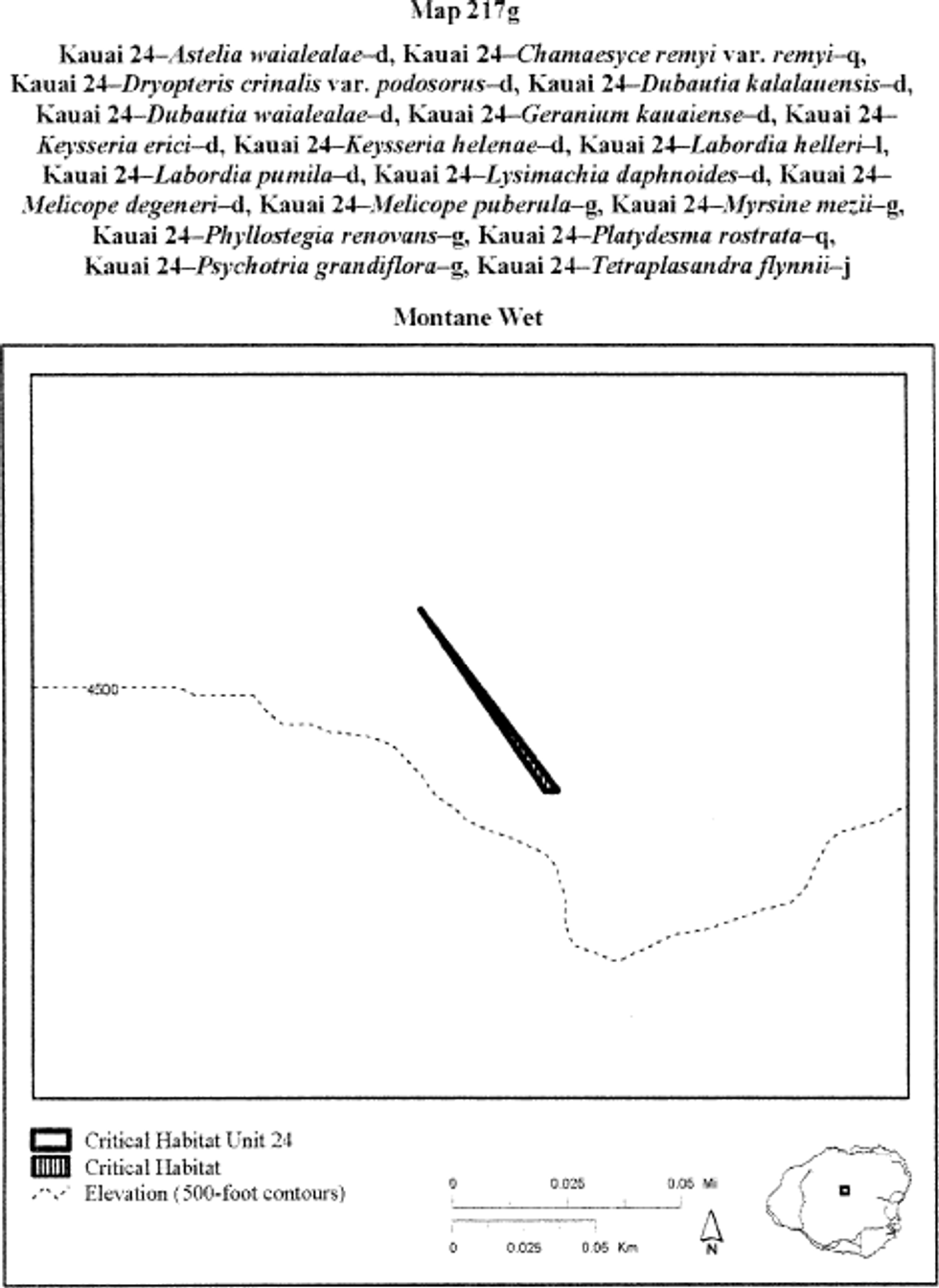
(cdxxiv) Kauai 24-Chamaesyce remyi var. remyi-q
(A) [Reserved]
(B) See paragraph (a)(1)(cdxxiii)(B) of this section for the map of this unit.
(cdxxv) Kauai 24-Dryopteris crinalis var. podosorus-d
(A) [Reserved]
(B) See paragraph (a)(1)(cdxxiii)(B) of this section for the map of this unit.
(cdxxvi) Kauai 24-Dubautia kalalauensis-d
(A) [Reserved]
(B) See paragraph (a)(1)(cdxxiii)(B) of this section for the map of this unit.
(cdxxvii) Kauai 24-Dubautia waialealae-d
(A) [Reserved]
(B) See paragraph (a)(1)(cdxxiii)(B) of this section for the map of this unit.
(cdxxviii) Kauai 24-Geranium kauaiense-e
(A) [Reserved]
(B) See paragraph (a)(1)(cdxxiii)(B) of this section for the map of this unit.
(cdxxix) Kauai 24-Keysseria erici-d
(A) [Reserved]
(B) See paragraph (a)(1)(cdxxiii)(B) of this section for the map of this unit.
(cdxxx) Kauai 24-Keysseria helenae-d
(A) [Reserved]
(B) See paragraph (a)(1)(cdxxiii)(B) of this section for the map of this unit.
(cdxxxi) Kauai 24-Labordia helleri-l
(A) [Reserved]
(B) See paragraph (a)(1)(cdxxiii)(B) of this section for the map of this unit.
(cdxxxii) Kauai 24-Labordia pumila-d
(A) [Reserved]
(B) See paragraph (a)(1)(cdxxiii)(B) of this section for the map of this unit.
(cdxxxiii) Kauai 24-Lysimachia daphnoides-d
(A) [Reserved]
(B) See paragraph (a)(1)(cdxxiii)(B) of this section for the map of this unit.
(cdxxxiv) Kauai 24-Melicope degeneri-d
(A) [Reserved]
(B) See paragraph (a)(1)(cdxxiii)(B) of this section for the map of this unit.
(cdxxxv) Kauai 24-Melicope puberula-g
(A) [Reserved]
(B) See paragraph (a)(1)(cdxxiii)(B) of this section for the map of this unit.
(cdxxxvi) Kauai 24-Myrsine mezii-g
(A) [Reserved]
(B) See paragraph (a)(1)(cdxxiii)(B) of this section for the map of this unit.
(cdxxxvii) Kauai 24-Phyllostegia renovans-g
(A) [Reserved]
(B) See paragraph (a)(1)(cdxxiii)(B) of this section for the map of this unit.
(cdxxxviii) Kauai 24- Melicope rostrata -q
(A) [Reserved]
(B) See paragraph (a)(1)(cdxxiii)(B) of this section for the map of this unit.
(cdxxxix) Kauai 24-Psychotria grandiflora-g
(A) [Reserved]
(B) See paragraph (a)(1)(cdxxiii)(B) of this section for the map of this unit.
(cdxl) Kauai 24-Tetraplasandra flynnii-j
(A) [Reserved]
(B) See paragraph (a)(1)(cdxxiii)(B) of this section for the map of this unit.
(cdxli) Kauai 25-Astelia waialealae-e
(A) This is a unit of the Montane Wet ecosystem and consists of 64 ac (26 ha). This unit is also critical habitat for Kauai 25-Chamaesyce remyi var. remyi-r, Kauai 25-Dryopteris crinalis var. podosorus-e, Kauai 25-Dubautia kalalauensis-e, Kauai 25-Dubautia waialealae-e, Kauai 25-Geranium kauaiense-e, Kauai 25-Keysseria erici-e, Kauai 25-Keysseria helenae-e, Kauai 25-Labordia helleri-m, Kauai 25-Labordia pumila-e, Kauai 25-Lysimachia daphnoides-e, Kauai 25-Melicope degeneri-e, Kauai 25-Melicope puberula-h, Kauai 25-Myrsine mezii-h, Kauai 25-Phyllostegia renovans-h, v, Kauai 25-Psychotria grandiflora-h, and Kauai 25-Tetraplasandra flynnii-k (see paragraphs (a)(1)(cdxlii), (a)(1)(cdxliii), (a)(1)(cdxliv), (a)(1)(cdxlv), (a)(1)(cdxlvi), (a)(1)(cdxlvii), (a)(1)(cdxlviii), (a)(1)(cdxlix), (a)(1)(cdl), (a)(1)(cdli), (a)(1)(cdlii), (a)(1)(cdliii), (a)(1)(cdliv), (a)(1)(cdlv), (a)(1)(cdlvi), (a)(1)(cdlvii), and (a)(1)(cdlviii), respectively, of this section).
(B) Note: The reference to �Kauai 25- Platydesma rostrata -r� on the map is equivalent to �Kauai 25- Melicope rostrata -r�. Map 217h follows:
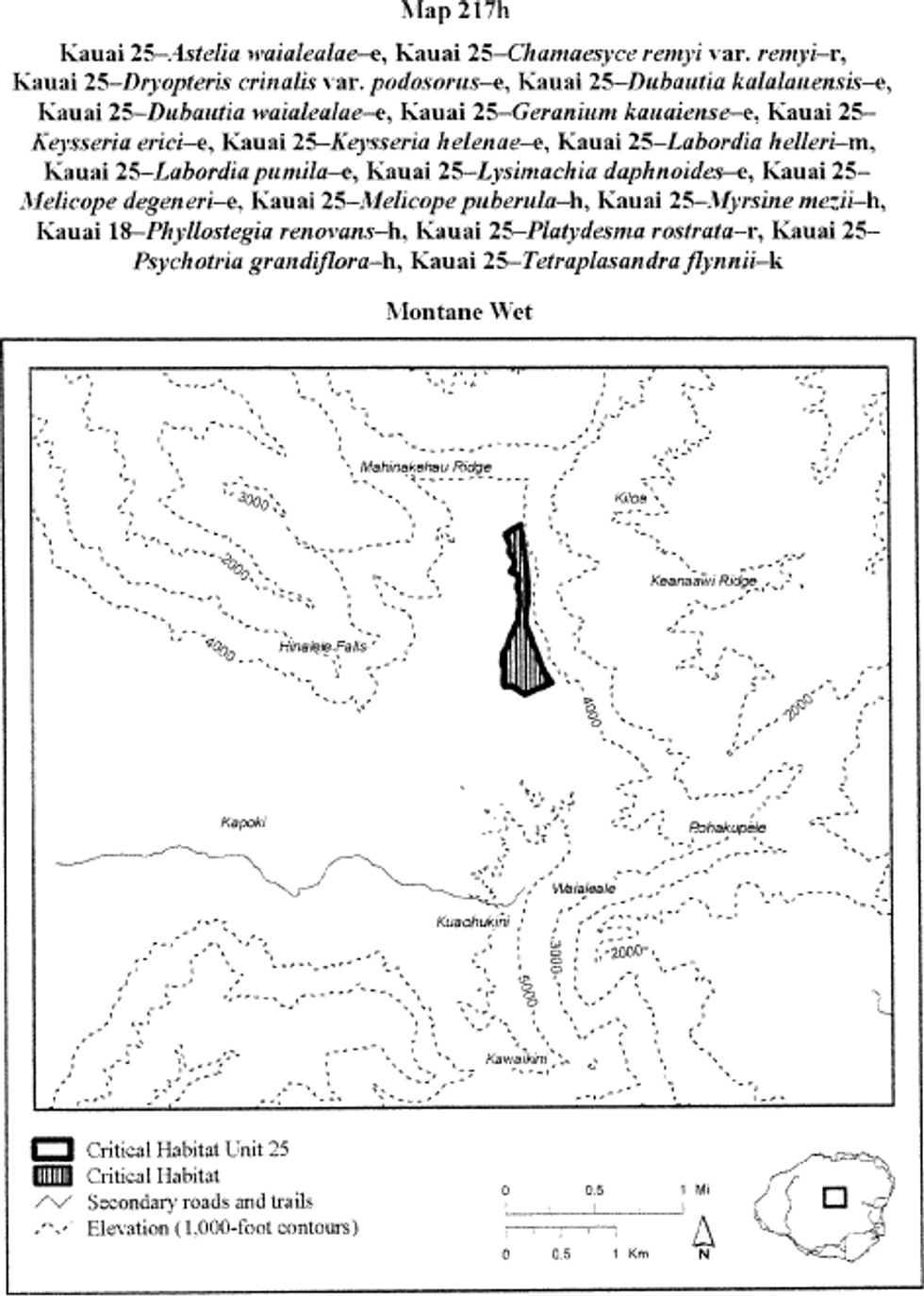
(cdxlii) Kauai 25-Chamaesyce remyi var. remyi-r
(A) [Reserved]
(B) See paragraph (a)(1)(cdxli)(B) of this section for the map of this unit.
(cdxliii) Kauai 25-Dryopteris crinalis var. podosorus-e
(A) [Reserved]
(B) See paragraph (a)(1)(cdxli)(B) of this section for the map of this unit.
(cdxliv) Kauai 25-Dubautia kalalauensis-d
(A) [Reserved]
(B) See paragraph (a)(1)(cdxli)(B) of this section for the map of this unit.
(cdxlv) Kauai 25-Dubautia waialealae-e
(A) [Reserved]
(B) See paragraph (a)(1)(cdxli)(B) of this section for the map of this unit.
(cdxlvi) Kauai 25-Geranium kauaiense-f
(A) [Reserved]
(B) See paragraph (a)(1)(cdxli)(B) of this section for the map of this unit.
(cdxlvii) Kauai 25-Keysseria erici-e
(A) [Reserved]
(B) See paragraph (a)(1)(cdxli)(B) of this section for the map of this unit.
(cdxlviii) Kauai 25-Keysseria helenae-e
(A) [Reserved]
(B) See paragraph (a)(1)(cdxli)(B) of this section for the map of this unit.
(cdxlix) Kauai 25-Labordia helleri-m
(A) [Reserved]
(B) See paragraph (a)(1)(cdxli)(B) of this section for the map of this unit.
(cdl) Kauai 25-Labordia pumila-e
(A) [Reserved]
(B) See paragraph (a)(1)(cdxli)(B) of this section for the map of this unit.
(cdli) Kauai 25-Lysimachia daphnoides-e
(A) [Reserved]
(B) See paragraph (a)(1)(cdxli)(B) of this section for the map of this unit.
(cdlii) Kauai 25-Melicope degeneri-e
(A) [Reserved]
(B) See paragraph (a)(1)(cdxli)(B) of this section for the map of this unit.
(cdliii) Kauai 25-Melicope puberula-h
(A) [Reserved]
(B) See paragraph (a)(1)(cdxli)(B) of this section for the map of this unit.
(cdliv) Kauai 25-Myrsine mezii-h
(A) [Reserved]
(B) See paragraph (a)(1)(cdxli)(B) of this section for the map of this unit.
(cdlv) Kauai 25-Phyllostegia renovans-h
(A) [Reserved]
(B) See paragraph (a)(1)(cdxli)(B) of this section for the map of this unit.
(cdlvi) Kauai 25- Melicope rostrata -r
(A) [Reserved]
(B) See paragraph (a)(1)(cdxli)(B) of this section for the map of this unit.
(cdlvii) Kauai 25-Psychotria grandiflora-h
(A) [Reserved]
(B) See paragraph (a)(1)(cdxli)(B) of this section for the map of this unit.
(cdlviii) Kauai 25-Tetraplasandra flynnii-k
(A) [Reserved]
(B) See paragraph (a)(1)(cdxli)(B) of this section for the map of this unit.
| Unit name | Species occupied | Species unoccupied |
|---|---|---|
| Kauai 1 - Ischaemum byrone - a | Ischaemum byrone | |
| Kauai 2 - Ischaemum byrone - b | Ischaemum byrone | |
| Kauai 3 - Ischaemum byrone - c | Ischaemum byrone | |
| Kauai 4 - Adenophorus periens - a | Adenophorus periens | |
| Kauai 4 - Chamaesyce remyi var. kauaiensis - a | Chamaesyce remyi var. kauaiensis | |
| Kauai 4 - Chamaesyce remyi var. remyi - a | Chamaesyce remyi var. remyi | |
| Kauai 4 - Cyanea asarifolia - a | Cyanea asarifolis | |
| Kauai 4 - Cyanea dolichopoda - a | Cyanea dolichopoda | |
| Kauai 4 - Cyanea recta - a | Cyanea recta | |
| Kauai 4 - Cyanea recta - b | Cyanea recta | |
| Kauai 4 - Cyanea remyi - a | Cyanea remyi | |
| Kauai 4 - Cyrtandra cyaneoides - a | Cyrtandra cyaneoides | |
| Kauai 4- Cyrtandra kealiae ssp. kealiae -a | Cyrtandra kealiae ssp. kealiae | |
| Kauai 4- Cyrtandra kealiae ssp. kealiae -b | Cyrtandra kealiae ssp. kealiae | |
| Kauai 4 - Cyrtandra oenobarba-a | Cyrtandra oenobarba | |
| Kauai 4 - Cyrtandra paliku-a | Cyrtandra paliku | Cyrtandra paliku |
| Kauai 4 - Dubautia plantaginea ssp. magnifolia-a | Dubautia plantaginea ssp. magnifolia | |
| Kauai 4 - Hibiscus clayi - a | Hibiscus clayi | |
| Kauai 4 - Hibiscus clayi - b | Hibiscus clayi | |
| Kauai 4 - Hibiscus clayi - c | Hibiscus clayi | |
| Kauai 4 - Hibiscus clayi - d | Hibiscus clayi | |
| Kauai 4 - Hibiscus clayi - e | Hibiscus clayi | |
| Kauai 4 - Labordia lydgatei - a | Labordia lydgatei | |
| Kauai 4 - Lysimachia iniki-a | Lysimachia iniki | |
| Kauai 4 - Lysimachia pendens-a | Lysimachia pendens | |
| Kauai 4 - Lysimachia venosa-a | Lysimachia venosa | |
| Kauai 4 - Phyllostegia wawrana - a | Phyllostegia wawrana | |
| Kauai 4- Melicope rostrata -a | Melicope rostrata. | |
| Kauai 5 - Hibiscus clayi - f | Hibiscus clayi | |
| Kauai 5 - Munroidendron racemosum - a | Munroidendron racemosum | |
| Kauai 6 - Brighamia insignis - a | Brighamia insignis | |
| Kauai 7 - Brighamia insignis - b | Brighamia insignis | |
| Kauai 7 - Canavalia napaliensis-a | Canavalia napaliensis | |
| Kauai 7 - Chamaesyce eleanoriae-a | Chamaesyce eleanoriae | |
| Kauai 7 - Chamaesyce remyi var. remyi-b | Chamaesyce remyi var. remyi | Chamaesyce remyi var. remyi |
| Kauai 7 - Charpentiera densiflora-a | Charpentiera densiflora | |
| Kauai 7 - Delissea rhytidosperma - a | Delissea rhytidosperma | |
| Kauai 7 - Doryopteris angelica-a | Doryopteris angelica | |
| Kauai 7 - Dubautia kenwoodii-a | Dubautia kenwoodii | |
| Kauai 7 - Isodendrion longifolium - a | Isodendrion longifolium | |
| Kauai 7 - Labordia helleri-a | Labordia helleri | |
| Kauai 7 - Lipochaeta micrantha - a | Lipochaeta micrantha | |
| Kauai 7 - Melicope haupuensis - a | Melicope haupuensis | |
| Kauai 7- Melicope rostrata -b | Melicope rostrata. | |
| Kauai 7 - Munroidendron racemosum - b | Munroidendron racemosum | |
| Kauai 7 - Myrsine linearifolia - a | Myrsine linearifolia | |
| Kauai 7 - Peucedanum sandwicense - a | Peucedanum sandwicense | |
| Kauai 7 - Pittosporum napaliense-a | Pittosporum napaliense | |
| Kauai 7 - Psychotria hobdyi-a | Psychotria hobdyi | |
| Kauai 7 - Pteralyxia kauaiensis - a | Pteralyxia kauaiensis | |
| Kauai 7 - Schiedea nuttallii - a | Schiedea nuttallii | |
| Kauai 7 - Tetraplasandra bisattenuata-a | Tetraplasandra bisattenuata | Tetraplasandra bisattenuata |
| Kauai 8 - Sesbania tomentosa - a | Sesbania tomentosa | |
| Kauai 9 - Schiedea spergulina var. leiopoda - a | Schiedea spergulina var. leiopoda | |
| Kauai 10 - Adenophorus periens - b | Adenophorus periens | |
| Kauai 10 - Astelia waialealae-a | Astelia waialealae | Astelia waialealae |
| Kauai 10 - Bonamia menziesii - a | Bonamia menziesii | |
| Kauai 10 - Chamaesyce remyi var. kauaiensis-b | Chamaesyce remyi var. kauaiensis | |
| Kauai 10 - Chamaesyce remyi var. kauaiensis-c | Chamaesyce remyi var. kauaiensis | Chamaesyce remyi var. kauaiensis |
| Kauai 10 - Chamaesyce remyi var. remyi-c | Chamaesyce remyi var. remyi | Chamaesyce remyi var. remyi |
| Kauai 10 - Chamaesyce remyi var. remyi-d | Chamaesyce remyi var. remyi | Chamaesyce remyi var. remyi |
| Kauai 10 - Chamaesyce remyi var. remyi-e | Chamaesyce remyi var. remyi | |
| Kauai 10 - Charpentiera densiflora-b | Charpentiera densiflora | |
| Kauai 10 - Cyanea asarifolia - b | Cyanea asarifolia | |
| Kauai 10 - Cyanea dolichopoda-b | Cyanea dolichopoda | |
| Kauai 10 - Cyanea eleeleensis-a | Cyanea eleeleensis | |
| Kauai 10 - Cyanea kolekoleensis-a | Cyanea kolekoleensis | |
| Kauai 10 - Cyanea kuhihewa-a | Cyanea kuhihewa | |
| Kauai 10 - Cyanea remyi - b | Cyanea remyi | |
| Kauai 10 - Cyanea undulata - a | Cyanea undulata | |
| Kauai 10- Cyrtandra kealiae ssp. kealiae -c | Cyrtandra kealiae ssp. kealiae | |
| Kauai 10 - Cyrtandra oenobarba-b | Cyrtandra oenobarba | Cyrtandra oenobarba |
| Kauai 10 - Cyrtandra oenobarba-c | Cyrtandra oenobarba | Cyrtandra oenobarba |
| Kauai 10 - Cyrtandra paliku-b | Cyrtandra paliku | |
| Kauai 10 - Dryopteris crinalis var. podosorus-a | Dryopteris crinalis var. podosorus | Dryopteris crinalis var. podosorus |
| Kauai 10 - Dubautia imbricata ssp. imbricata-a | Dubautia imbricata ssp. imbricata | Dubautia imbricata ssp. imbricata |
| Kauai 10 - Dubautia kalalauensis-a | Dubautia kalalauensis | |
| Kauai 10 - Dubautia pauciflorula - a | Dubautia pauciflorula | |
| Kauai 10 - Dubautia plantaginea ssp. magnifolia-b | Dubautia plantaginea ssp. magnifolia | Dubautia plantaginea ssp. magnifolia |
| Kauai 10 - Dubautia waialealae-a | Dubautia waialealae | Dubautia waialealae |
| Kauai 10 - Exocarpos luteolus - a | Exocarpos luteolus | |
| Kauai 10 - Geranium kauaiense-a | Geranium kauaiense | Geranium kauaiense |
| Kauai 10 - Hesperomannia lydgatei - a | Hesperomannia lydgatei | |
| Kauai 10 - Isodendrion longifolium - b | Isodendrion longifolium | |
| Kauai 10 - Keysseria erici-a | Keysseria erici | Keysseria erici |
| Kauai 10 - Keysseria helenae-a | Keysseria helenae | Keysseria helenae |
| Kauai 10 - Labordia helleri-b | Labordia helleri | Labordia helleri |
| Kauai 10 - Labordia helleri-c | Labordia helleri | |
| Kauai 10 - Labordia lydgatei - b | Labordia lydgatei | |
| Kauai 10 - Labordia pumila-a | Labordia pumila | Labordia pumila |
| Kauai 10 - Labordia tinifolia var. wahiawaensis - a | Labordia tinifolia var. wahiawaensis | |
| Kauai 10 - Lysimachia daphnoides-a | Lysimachia daphnoides | Lysimachia daphnoides |
| Kauai 10 - Lysimachia filifolia - a | Lysimachia filifolia | |
| Kauai 10 - Lysimachia iniki-b | Lysimachia iniki | Lysimachia iniki |
| Kauai 10 - Lysimachia pendens-b | Lysimachia pendens | Lysimachia pendens |
| Kauai 10 - Lysimachia venosa-b | Lysimachia venosa | |
| Kauai 10 - Melicope degeneri-a | Melicope paniculata | Melicope paniculata |
| Kauai 10 - Melicope paniculata-a | Melicope paniculata | Melicope paniculata |
| Kauai 10 - Melicope puberula-a | Melicope puberula | Melicope puberula |
| Kauai 10 - Melicope puberula-b | Melicope puberula | |
| Kauai 10- Melicope rostrata -c | Melicope rostrata | Melicope rostrata. |
| Kauai 10- Melicope rostrata -d | Melicope rostrata | Melicope rostrata. |
| Kauai 10- Melicope rostrata -e | Melicope rostrata | Melicope rostrata. |
| Kauai 10 - Myrsine linearifolia - b | Myrsine linearifolia | |
| Kauai 10 - Myrsine mezii-a | Myrsine mezii | Myrsine mezii |
| Kauai 10- Phlegmariurus nutans -a | Phlegmariurus nutans. | |
| Kauai 10 - Phyllostegia renovans-a | Phyllostegia renovans | Phyllostegia renovans |
| Kauai 10 - Phyllostegia renovans-b | Phyllostegia renovans | Phyllostegia renovans |
| Kauai 10 - Plantago princeps - a | Plantago princeps | |
| Kauai 10 - Psychotria grandiflora-a | Psychotria grandiflora | |
| Kauai 10 - Pteralyxia kauaiensis - b | Pteralyxia kauaiensis | |
| Kauai 10 - Stenogyne kealiae-a | Stenogyne kealiae | |
| Kauai 10 - Tetraplasandra bisattenuata-b | Tetraplasandra bisattenuata | Tetraplasandra bisattenuata |
| Kauai 10 - Tetraplasandra flynnii-a | Tetraplasandra flynnii | |
| Kauai 10 - Tetraplasandra flynnii-b | Tetraplasandra flynnii | |
| Kauai 10 - Viola helenae - a | Viola helenae | |
| Kauai 10 - Viola kauaiensis var. wahiawaensis - a | Viola kauaiensis var. wahiawaensis | |
| Kauai 11 - Adenophorus periens - c | Adenophorus periens | |
| Kauai 11 - Adenophorus periens - d | Adenophorus periens | |
| Kauai 11 - Alectryon macrococcus - a | Alectryon macrococcus | |
| Kauai 11 - Alectryon macrococcus - b | Alectryon macrococcus | |
| Kauai 11 - Alsinidendron lychnoides - a | Alsinidendron lychnoides | |
| Kauai 11 - Alsinidendron lychnoides - b | 11 - Alsinidendron lychnoides - a | |
| Kauai 11 - Alsinidendron lychnoides - c | Alsinidendron lychnoides | |
| Kauai 11 - Alsinidendron viscosum - a | Alsinidendron viscosum | |
| Kauai 11 - Alsinidendron viscosum - b | Alsinidendron viscosum | |
| Kauai 11 - Alsinidendron viscosum - c | Alsinidendron viscosum | |
| Kauai 11 - Alsinidendron viscosum - d | Alsinidendron viscosum | |
| Kauai 11- Asplenium dielpallidum -a | Asplenium dielpallidum | |
| Kauai 11- Asplenium dielpallidum -b | Asplenium dielpallidum | |
| Kauai 11 - Astelia waialealae-b | Astelia waialealae | Astelia waialealae |
| Kauai 11 - Bonamia menziesii - b | Bonamia menziesii | |
| Kauai 11 - Brighamia insignis - c | Brighamia insignis | |
| Kauai 11 - Canavalia napaliensis-b | Canavalia napaliensis | Canavalia napaliensis |
| Kauai 11 - Schenkia sebaeoides - a | Schenkia sebaeoides | |
| Kauai 11 - Chamaesyce eleanoriae-b | Chamaesyce eleanoriae | Chamaesyce eleanoriae |
| Kauai 11 - Chamaesyce eleanoriae-c | Chamaesyce eleanoriae | Chamaesyce eleanoriae |
| Kauai 11 - Chamaesyce halemanui - a | Chamaesyce halemanui | |
| Kauai 11 - Chamaesyce halemanui - b | Chamaesyce halemanui | |
| Kauai 11 - Chamaesyce halemanui - c | Chamaesyce halemanui | |
| Kauai 11 - Chamaesyce remyi var. kauaiensis-d | Chamaesyce remyi var. kauaiensis | Chamaesyce remyi var. kauaiensis |
| Kauai 11 - Chamaesyce remyi var. kauaiensis-e | Chamaesyce remyi var. kauaiensis | |
| Kauai 11 - Chamaesyce remyi var. remyi-f | Chamaesyce remyi var. remyi | Chamaesyce remyi var. remyi |
| Kauai 11 - Chamaesyce remyi var. remyi-g | Chamaesyce remyi var. remyi | Chamaesyce remyi var. remyi |
| Kauai 11 - Chamaesyce remyi var. remyi-h | Chamaesyce remyi var. remyi | Chamaesyce remyi var. remyi |
| Kauai 11 - Chamaesyce remyi var. remyi-i | Chamaesyce remyi var. remyi | Chamaesyce remyi var. remyi |
| Kauai 11 - Chamaesyce remyi var. remyi-j | Chamaesyce remyi var. remyi | Chamaesyce remyi var. remyi |
| Kauai 11 - Charpentiera densiflora-c | Charpentiera densiflora | Charpentiera densiflora |
| Kauai 11 - Charpentiera densiflora-d | Charpentiera densiflora | Charpentiera densiflora |
| Kauai 11 - Ctenitis squamigera - a | Ctenitis squamigera | |
| Kauai 11 - Cyanea dolichopoda-c | Cyanea dolichopoda | |
| Kauai 11 - Cyanea eleeleensis-b | Cyanea eleeleensis | |
| Kauai 11 - Cyanea kolekoleensis-b | Cyanea kolekoleensis | |
| Kauai 11 - Cyanea kuhihewa-b | Cyanea kuhihewa | |
| Kauai 11 - Cyanea recta - c | Cyanea recta | |
| Kauai 11 - Cyanea recta - d | Cyanea recta | |
| Kauai 11 - Cyanea remyi - c | Cyanea remyi | |
| Kauai 11 - Cyanea remyi - d | Cyanea remyi | |
| Kauai 11- Cyanea rivularis -a | Cyanea rivularis | |
| Kauai 11 - Cyperus trachysanthos - a | Cyperus trachysanthos | |
| Kauai 11 - Cyrtandra cyaneoides - b | Cyrtandra cyaneoides | |
| Kauai 11 - Cyrtandra cyaneoides - c | Cyrtandra cyaneoides | |
| Kauai 11- Cyrtandra kealiae ssp. kealiae -d | Cyrtandra kealiae ssp. kealiae | |
| Kauai 11- Cyrtandra kealiae ssp. kealiae -e | Cyrtandra kealiae ssp. kealiae | |
| Kauai 11 - Cyrtandra oenobarba-d | Cyrtandra oenobarba | Cyrtandra oenobarba |
| Kauai 11 - Cyrtandra oenobarba-e | Cyrtandra oenobarba | |
| Kauai 11 - Cyrtandra paliku-c | Cyrtandra paliku | |
| Kauai 11 - Delissea rhytidosperma - b | Delissea rhytidosperma | |
| Kauai 11 - Delissea rhytidosperma - c | Delissea rhytidosperma | |
| Kauai 11 - Delissea undulata - a | Delissea undulata | |
| Kauai 11 - Delissea undulata - b | Delissea undulata | |
| Kauai 11 - Asplenium dielerectum - a | Asplenium dielerectum | |
| Kauai 11 - Diellia mannii-a | Diellia mannii | Diellia mannii |
| Kauai 11 - Diplazium molokaiense - a | Diplazium molokaiense | |
| Kauai 11 - Doryopteris angelica-b | Doryopteris angelica | Doryopteris angelica |
| Kauai 11 - Dryopteris crinalis var. podosorus-b | Dryopteris crinalis var. podosorus | Dryopteris crinalis var. podosorus |
| Kauai 11 - Dubautia imbricata ssp. imbricata-b | Dubautia imbricata ssp. imbricata | |
| Kauai 11 - Dubautia kalalauensis-b | Dubautia kalalauensis | Dubautia kalalauensis |
| Kauai 11 - Dubautia kenwoodii-b | Dubautia kenwoodii | |
| Kauai 11 - Dubautia latifolia - 1 | Dubautia latifolia | |
| Kauai 11 - Dubautia latifolia - b | Dubautia latifolia | |
| Kauai 11 - Dubautia latifolia - c | Dubautia latifolia | |
| Kauai 11 - Dubautia plantaginea ssp. magnifolia-c | Dubautia plantaginea ssp. magnifolia | |
| Kauai 11 - Dubautia waialealae-b | Dubautia waialealae | Dubautia waialealae |
| Kauai 11 - Euphorbia haeleeleana - a | Euphorbia haeleeleana | |
| Kauai 11 - Euphorbia haeleeleana - b | Euphorbia haeleeleana | |
| Kauai 11 - Euphorbia haeleeleana - c | Euphorbia haeleeleana | |
| Kauai 11 - Exocarpos luteolus - b | Exocarpos luteolus | |
| Kauai 11 - Exocarpos luteolus - c | Exocarpos luteolus | |
| Kauai 11 - Exocarpos luteolus - d | Exocarpos luteolus | |
| Kauai 11 - Exocarpos luteolus - e | Exocarpos luteolus | |
| Kauai 11 - Flueggea neowawraea - a | Flueggea neowawraea | |
| Kauai 11 - Flueggea neowawraea - b | Flueggea neowawraea | |
| Kauai 11 - Flueggea neowawraea - c | Flueggea neowawraea | |
| Kauai 11 - Flueggea neowawraea - d | Flueggea neowawraea | |
| Kauai 11 - Flueggea neowawraea - e | Flueggea neowawraea | |
| Kauai 11 - Flueggea neowawraea - f | Flueggea neowawraea | |
| Kauai 11 - Geranium kauaiense-b | Geranium kauaiense | Geranium kauaiense |
| Kauai 11 - Gouania meyenii - a | Gouania meyenii | |
| Kauai 11 - Gouania meyenii - b | Gouania meyenii | |
| Kauai 11 - Gouania meyenii - c | Gouania meyenii | |
| Kauai 11 - Heduptos st.-johnii - a | Heduptos st.-johnii | |
| Kauai 11 - Hesperomannia lydgatei - b | Hesperomannia lydgatei | |
| Kauai 11 - Hesperomannia lydgatei - e | Hesperomannia lydgatei | |
| Kauai 11 - Hibiscadelphus woodii - a | Hibiscadelphus woodii | |
| Kauai 11 - Hibiscadelphus woodii - b | Hibiscadelphus woodii | |
| Kauai 11 - Hibiscus waimeae ssp. hannerae - a | Hibiscus waimeae ssp. hannerae | |
| Kauai 11 - Ischaemum byrone - d | Ischaemum byrone | |
| Kauai 11 - Isodendrion laurifolium - a | Isodendrion laurifolium | |
| Kauai 11 - Isodendrion laurifolium - b | Isodendrion laurifolium | |
| Kauai 11 - Isodendrion longifolium - c | Isodendrion longifolium | |
| Kauai 11 - Isodendrion longifolium - d | Isodendrion longifolium | |
| Kauai 11 - Isodendrion longifolium - e | Isodendrion longifolium | |
| Kauai 11- Kadua cookiana -a | Kadua cookiana | |
| Kauai 11 - Keysseria erici-b | Keysseria erici | Keysseria erici |
| Kauai 11 - Keysseria helenae-b | Keysseria helenae | Keysseria helenae |
| Kauai 11 - Kokia kauaiensis - a | Kokia kauaiensis | |
| Kauai 11 - Kokia kauaiensis - b | Kokia kauaiensis | |
| Kauai 11 - Kokia kauaiensis - c | Kokia kauaiensis | |
| Kauai 11 - Kokia kauaiensis - d | Kokia kauaiensis | |
| Kauai 11 - Labordia helleri-d | Labordia helleri | Labordia helleri |
| Kauai 11 - Labordia helleri-e | Labordia helleri | Labordia helleri |
| Kauai 11 - Labordia helleri-f | Labordia helleri | Labordia helleri |
| Kauai 11 - Labordia helleri-g | Labordia helleri | Labordia helleri |
| Kauai 11 - Labordia lydgatei - c | Labordia lydgatei | |
| Kauai 11 - Labordia lydgatei - d | Labordia lydgatei | |
| Kauai 11 - Labordia lydgatei - e | Labordia lydgatei | |
| Kauai 11 - Labordia pumila-b | Labordia pumila | Labordia pumila |
| Kauai 11 - Lipochaeta fauriei - a | Lipochaeta fauriei | |
| Kauai 11 - Lipochaeta fauriei - b | Lipochaeta fauriei | |
| Kauai 11 - Lipochaeta micrantha - b | Lipochaeta micrantha | |
| Kauai 11 - Lobelia niihauensis - a | Lobelia niihauensis | |
| Kauai 11 - Lobelia niihauensis - b | Lobelia niihauensis | |
| Kauai 11 - Lysimachia daphnoides-b | Lysimachia daphnoides | Lysimachia daphnoides |
| Kauai 11 - Lysimachia iniki-c | Lysimachia iniki | |
| Kauai 11 - Lysimachia pendens-c | Lysimachia pendens | |
| Kauai 11 - Lysimachia scopulensis-a | Lysimachia scopulensis | Lysimachia scopulensis |
| Kauai 11 - Lysimachia venosa-c | Lysimachia venosa | |
| Kauai 11 - Cyperus pennatiformis - a | Cyperus pennatiformis | |
| Kauai 11 - Melicope degeneri-b | Melicope degeneri | Melicope degeneri |
| Kauai 11 - Melicope haupuensis - b | Melicope haupuensis | |
| Kauai 11 - Melicope haupuensis - c | Melicope haupuensis | |
| Kauai 11 - Melicope knudsenii - a | Melicope knudsenii | |
| Kauai 11 - Melicope knudsenii - b | Melicope knudsenii | |
| Kauai 11 - Melicope pallida - a | Melicope pallida | |
| Kauai 11 - Melicope pallida - b | Melicope pallida | |
| Kauai 11 - Melicope paniculata-b | Melicope paniculata | Melicope paniculata |
| Kauai 11 - Melicope puberula-c | Melicope puberula | Melicope puberula |
| Kauai 11 - Melicope puberula-d | Melicope puberula | Melicope puberula |
| Kauai 11- Melicope rostrata -f | Melicope rostrata | Melicope rostrata. |
| Kauai 11- Melicope rostrata -g | Melicope rostrata | Melicope rostrata. |
| Kauai 11- Melicope rostrata -h | Melicope rostrata | Melicope rostrata. |
| Kauai 11- Melicope rostrata -i | Melicope rostrata | |
| Kauai 11- Melicope rostrata -j | Melicope rostrata | Melicope rostrata. |
| Kauai 11 - Munroidendron racemosum - c | Munroidendron racemosum | |
| Kauai 11 - Munroidendron racemosum - d | Munroidendron racemosum | |
| Kauai 11 - Myrsine knudsenii-a | Myrsine knudsenii | Myrsine knudsenii |
| Kauai 11 - Myrsine linearifolia - c | Myrsine linearifolia | |
| Kauai 11 - Myrsine linearifolia - d | Myrsine linearifolia | |
| Kauai 11 - Myrsine linearifolia - e | Myrsine linearifolia | |
| Kauai 11 - Myrsine linearifolia - f | Myrsine linearifolia | |
| Kauai 11 - Myrsine mezii-b | Myrsine mezii | Myrsine mezii |
| Kauai 11 - Myrsine mezii-c | Myrsine mezii | |
| Kauai 11 - Nothocestrum peltatum - a | Nothocestrum peltatum | |
| Kauai 11 - Nothocestrum peltatum - b | Nothocestrum peltatum | |
| Kauai 11 - Nothocestrum peltatum - c | Nothocestrum peltatum | |
| Kauai 11 - Peucedanum sandwicense - b | Peucedanum sandwicense | |
| Kauai 11 - Peucedanum sandwicense - c | Peucedanum sandwicense | |
| Kauai 11 - Phyllostegia knudsenii - a | Phyllostegia knudsenii | |
| Kauai 11 - Phyllostegia renovans-c | Phyllostegia renovans | Phyllostegia renovans |
| Kauai 11 - Phyllostegia renovans-d | Phyllostegia renovans | Phyllostegia renovans |
| Kauai 11 - Phyllostegia waimeae - a | Phyllostegia waimeae | |
| Kauai 11 - Phyllostegia wawrana - b | Phyllostegia wawrana | |
| Kauai 11 - Phyllostegia wawrana - c | Phyllostegia wawrana | |
| Kauai 11 - Phyllostegia wawrana - d | Phyllostegia wawrana | |
| Kauai 11 - Pittosporum napaliense-b | Pittosporum napaliense | Pittosporum napaliense |
| Kauai 11 - Plantago princeps - b | Plantago princeps | |
| Kauai 11 - Plantago princeps - c | Plantago princeps | |
| Kauai 11 - Plantago princeps - d | Plantago princeps | |
| Kauai 11 - Platanthera holochila - a | Platanthera holochila | |
| Kauai 11 - Poa mannii - a | Poa mannii | |
| Kauai 11 - Poa mannii - b | Poa mannii | |
| Kauai 11 - Poa mannii - c | Poa mannii | |
| Kauai 11 - Poa mannii - d | Poa mannii | |
| Kauai 11 - Poa sandvicensis - a | Poa sandvicensis | |
| Kauai 11 - Poa sandvicensis - b | Poa sandvicensis | |
| Kauai 11 - Poa siphonoglossa - a | Poa siphonoglossa | |
| Kauai 11 - Poa siphonoglossa - b | Poa siphonoglossa | |
| Kauai 11 - Psychotria grandiflora-b | Psychotria grandiflora | Psychotria grandiflora |
| Kauai 11 - Psychotria grandiflora-c | Psychotria grandiflora | Psychotria grandiflora |
| Kauai 11 - Psychotria hobdyi-b | Psychotria hobdyi | Psychotria hobdyi |
| Kauai 11 - Pteralyxia kauaiensis - c | Pteralyxia kauaiensis | |
| Kauai 11 - Pteralyxia kauaiensis - d | Pteralyxia kauaiensis | |
| Kauai 11 - Pteralyxia kauaiensis - e | Pteralyxia kauaiensis | |
| Kauai 11 - Pteralyxia kauaiensis - f | Pteralyxia kauaiensis | |
| Kauai 11 - Pteralyxia kauaiensis - g | Pteralyxia kauaiensis | |
| Kauai 11 - Remya kauaiensis - a | Remya kauaiensis | |
| Kauai 11 - Remya kauaiensis - b | Remya kauaiensis | |
| Kauai 11 - Remya kauaiensis - c | Remya kauaiensis | |
| Kauai 11 - Remya kauaiensis - d | Remya kauaiensis | |
| Kauai 11 - Remya kauaiensis - e | Remya kauaiensis | |
| Kauai 11 - Remya montgomeryi - a | Remya montgomeryi | |
| Kauai 11 - Remya montgomeryi - b | Remya montgomeryi | |
| Kauai 11 - Remya montgomeryi - c | Remya montgomeryi | |
| Kauai 11 - Schiedea apokremnos - a | Schiedea apokremnos | |
| Kauai 11 - Schiedea apokremnos - b | Schiedea apokremnos | |
| Kauai 11 - Schiedea apokremnos - c | Schiedea apokremnos | |
| Kauai 11 - Schiedea attenuata-a | Schiedea attenuata | Schiedea attenuata |
| Kauai 11 - Schiedea helleri - a | Schiedea helleri | |
| Kauai 11 - Schiedea helleri - b | Schiedea helleri | |
| Kauai 11 - Schiedea helleri - c | Schiedea helleri | |
| Kauai 11 - Schiedea kauaiensis - a | Schiedea kauaiensis | |
| Kauai 11 - Schiedea kauaiensis - c | Schiedea kauaiensis | |
| Kauai 11 - Schiedea kauaiensis - c | Schiedea kauaiensis | |
| Kauai 11 - Schiedea kauaiensis - d | Schiedea kauaiensis | |
| Kauai 11 - Schiedea membranacea - a | Schiedea membranacea | |
| Kauai 11 - Schiedea membranacea - b | Schiedea membranacea | |
| Kauai 11 - Schiedea membranacea - c | Schiedea membranacea | |
| Kauai 11 - Schiedea membranacea - d | Schiedea membranacea | |
| Kauai 11 - Schiedea spergulina var. spergulina - a | Schiedea spergulina var. spergulina | |
| Kauai 11 - Schiedea spergulina var. spergulina - b | Schiedea spergulina var. spergulina | |
| Kauai 11 - Schiedea stellarioides - a | Schiedea stellarioides | |
| Kauai 11 - Schiedea stellarioides - b | Schiedea stellarioides | |
| Kauai 11 - Solanum sandwicense - a | Solanum sandwicense | |
| Kauai 11 - Solanum sandwicense - b | Solanum sandwicense | |
| Kauai 11 - Spermolepis hawaiiensis - a | Spermolepis hawaiiensis | |
| Kauai 11 - Stenogyne campanulata - a | Stenogyne campanulata | |
| Kauai 11 - Stenogyne kealiae-b | Stenogyne kealiae | Stenogyne kealiae |
| Kauai 11 - Stenogyne kealiae-c | Stenogyne kealiae | Stenogyne kealiae |
| Kauai 11 - Stenogyne kealiae-d | Stenogyne kealiae | Stenogyne kealiae |
| Kauai 11 - Tetraplasandra bisattenuata-c | Tetraplasandra bisattenuata | |
| Kauai 11 - Tetraplasandra bisattenuata-d | Tetraplasandra bisattenuata | |
| Kauai 11 - Tetraplasandra flynnii-c | Tetraplasandra flynnii | Tetraplasandra flynnii |
| Kauai 11 - Tetraplasandra flynnii-d | Tetraplasandra flynnii | |
| Kauai 11 - Tetraplasandra flynnii-e | Tetraplasandra flynnii | Tetraplasandra flynnii |
| Kauai 11 - Wilkesia hobdyi - a | Wilkesia hobdyi | |
| Kauai 11 - Xylosma crenatum - a | Xylosma crenatum | |
| Kauai 11 - Zanthoxylum hawaiiense - a | Zanthoxylum hawaiiense | |
| Kauai 12 - Nothocestrum peltatum - d | Nothocestrum peltatum | |
| Kauai 12 - Remya kauaiensis - f | Remya kauaiensis | |
| Kauai 12 - Xylosma crenatum - b | Xylosma crenatum | |
| Kauai 13 - Lipochaeta waimeaensis - a | Lipochaeta waimeaensis | |
| Kauai 13 - Schiedea spergulina var. spergulina - c | Schiedea spergulina var. spergulina | |
| Kauai 13 - Spermolepis hawaiiensis - b | Spermolepis hawaiiensis | |
| Kauai 14 - Panicum niihauense - a | Panicum niihauense | |
| Kauai 14 - Sesbania tomentosa - b | Sesbania tomentosa | |
| Kauai 15 - Panicum niihauense - b | Panicum niihauense | |
| Kauai 16 - Panicum niihauense - c | Panicum niihauense | |
| Kauai 17 - Panicum niihauense - d | Panicum niihauense | |
| Kauai 18 - Chamaesyce remyi var. kauaiensis-f | Chamaesyce remyi var. kauaiensis | Chamaesyce remyi var. kauaiensis |
| Kauai 18 - Chamaesyce remyi var. remyi-k | Chamaesyce remyi var. remyi | |
| Kauai 18 - Cyanea dolichopoda-d | Cyanea dolichopoda | |
| Kauai 18 - Cyrtandra oenobarba-f | Cyrtandra oenobarba | Cyrtandra oenobarba |
| Kauai 18 - Cyrtandra paliku-d | Cyrtandra paliku | |
| Kauai 18 - Dubautia plantaginea ssp. magnifolia-d | Dubautia plantaginea ssp. magnifolia | Dubautia plantaginea ssp. magnifolia |
| Kauai 18 - Lysimachia iniki-d | Lysimachia iniki | Lysimachia iniki |
| Kauai 18 - Lysimachia pendens-d | Lysimachia pendens | Lysimachia pendens |
| Kauai 18 - Lysimachia venosa-d | Lysimachia venosa | |
| Kauai 18- Melicope rostrata -k | Melicope rostrata. | |
| Kauai 19 - Chamaesyce remyi var. kauaiensis-g | Chamaesyce remyi var. kauaiensis | |
| Kauai 19 - Chamaesyce remyi var. remyi-l | Chamaesyce remyi var. remyi | |
| Kauai 19 - Cyanea dolichopoda-e | Cyanea dolichopoda | |
| Kauai 19 - Cyrtandra oenobarba-g | Cyrtandra oenobarba | |
| Kauai 19 - Cyrtandra paliku-e | Cyrtandra paliku | Cyrtandra paliku |
| Kauai 19 - Dubautia plantaginea ssp. magnifolia-e | Dubautia plantaginea ssp. magnifolia | |
| Kauai 19 - Lysimachia iniki-e | Lysimachia iniki | |
| Kauai 19 - Lysimachia pendens-e | Lysimachia pendens | |
| Kauai 19 - Lysimachia venosa-e | Lysimachia venosa | |
| Kauai 19- Melicope rostrata -l | Melicope rostrata. | |
| Kauai 20 - Chamaesyce remyi var. kauaiensis-h | Chamaesyce remyi var. kauaiensis | |
| Kauai 20 - Chamaesyce remyi var. remyi-m | Chamaesyce remyi var. remyi | Chamaesyce remyi var. remyi |
| Kauai 20 - Charpentiera densiflora-e | Charpentiera densiflora | Charpentiera densiflora |
| Kauai 20 - Cyanea eleeleensis-c | Cyanea eleeleensis | |
| Kauai 20 - Cyanea kolekoleensis-c | Cyanea kolekoleensis | |
| Kauai 20 - Cyanea kuhihewa-c | Cyanea kuhihewa | |
| Kauai 20 - Cyrtandra oenobarba-h | Cyrtandra oenobarba | |
| Kauai 20 - Dubautia imbricata ssp. imbricata-c | Dubautia imbricata ssp. imbricata | Dubautia imbricata ssp. imbricata |
| Kauai 20 - Labordia helleri-h | Labordia helleri | Labordia helleri |
| Kauai 20 - Melicope paniculata-c | Melicope paniculata | |
| Kauai 20 - Melicope puberula-e | Melicope puberula | |
| Kauai 20- Melicope rostrata -m | Melicope rostrata. | |
| Kauai 20 - Phyllostegia renovans-e | Phyllostegia renovans | Phyllostegia renovans |
| Kauai 20 - Stenogyne kealiae-e | Stenogyne kealiae | |
| Kauai 20 - Tetraplasandra bisattenuata-e | Tetraplasandra bisattenuata | |
| Kauai 20 - Tetraplasandra flynii-f | Tetraplasandra flynii | |
| Kauai 21 - Chamaesyce remyi var. remyi-n | Chamaesyce remyi var. remyi | |
| Kauai 21 - Diellia mannii-b | Diellia mannii | Diellia mannii |
| Kauai 21 - Labordia helleri-i | Labordia helleri | |
| Kauai 21- Melicope rostrata -n | Melicope rostrata. | |
| Kauai 21 - Myrsine knudsenii-b | Myrsine knudsenii | |
| Kauai 21 - Myrsine mezii-d | Myrsine mezii | |
| Kauai 21 - Psychotria grandiflora-d | Psychotria grandiflora | |
| Kauai 21 - Stenogyne kealiae-f | Stenogyne kealiae | |
| Kauai 21 - Tetraplasandra flynnii-g | Tetraplasandra flynnii | |
| Kauai 22 - Chamaesyce remyi var. remyi-o | Chamaesyce remyi var. remyi | |
| Kauai 22 - Diellia mannii-c | Diellia mannii | |
| Kauai 22 - Labordia helleri-j | Labordia helleri | |
| Kauai 22- Melicope rostrata -o | Melicope rostrata. | |
| Kauai 22 - Myrsine knudsenii-c | Myrsine knudsenii | |
| Kauai 22 - Myrsine mezii-e | Myrsine mezii | Myrsine mezii |
| Kauai 22 - Psychotria grandiflora-e | Psychotria grandiflora | |
| Kauai 22 - Stenogyne kealiae-g | Stenogyne kealiae | |
| Kauai 22 - Tetraplasandra flynnii-h | Tetraplasandra flynnii | |
| Kauai 23 - Astelia waialealae-c | Astelia waialealae | Astelia waialealae |
| Kauai 23 - Chamaesyce remyi var. remyi-p | Chamaesyce remyi var. remyi | Chamaesyce remyi var. remyi |
| Kauai 23 - Dryopteris crinalis var. podosorus-c | Dryopteris crinalis var. podosorus | Dryopteris crinalis var. podosorus |
| Kauai 23 - Dubautia kalalauensis-c | Dubautia kalalauensis | |
| Kauai 23 - Dubautia waialealae-c | Dubautia waialealae | Dubautia waialealae |
| Kauai 23 - Geranium kauaiense-c | Geranium kauaiense | Geranium kauaiense |
| Kauai 23 - Keysseria erici-c | Keysseria erici | Keysseria erici |
| Kauai 23 - Keysseria helenae-c | Keysseria helenae | Keysseria helenae |
| Kauai 23 - Labordia helleri-k | Labordia helleri | Labordia helleri |
| Kauai 23 - Labordia pumila-c | Labordia pumila | Labordia pumila |
| Kauai 23 - Lysimachia daphnoides-c | Lysimachia daphnoides | Lysimachia daphnoides |
| Kauai 23 - Melicope degeneri-c | Melicope degeneri | Melicope degeneri |
| Kauai 23 - Melicope puberula-f | Melicope puberula | Melicope puberula |
| Kauai 23- Melicope rostrata -p | Melicope rostrata | Melicope rostrata. |
| Kauai 23 - Myrsine mezii-f | Myrsine mezii | Myrsine mezii |
| Kauai 23 - Phyllostegia renovans-f | Phyllostegia renovans | Phyllostegia renovans |
| Kauai 23 - Psychotria grandiflora-f | Psychotria grandiflora | |
| Kauai 23 - Tetraplasandra flynnii-i | Tetraplasandra flynnii | |
| Kauai 24 - Astelia waialealae-d | Astelia waialealae | Astelia waialealae |
| Kauai 24 - Chamaesyce remyi var. remyi-q | Chamaesyce remyi var. remyi | Chamaesyce remyi var. remyi |
| Kauai 24 - Dryopteris crinalis var. podosorus-d | Dryopteris crinalis var. podosorus | Dryopteris crinalis var. podosorus |
| Kauai 24 - Dubautia kalalauensis-d | Dubautia kalalauensis | |
| Kauai 24 - Dubautia waialealae-d | Dubautia waialealae | Dubautia waialealae |
| Kauai 24 - Geranium kauaiense-d | Geranium kauaiense | Geranium kauaiense |
| Kauai 24 - Keysseria erici-d | Keysseria erici | Keysseria erici |
| Kauai 24 - Keysseria helenae-d | Keysseria helenae | Keysseria helenae |
| Kauai 24 - Labordia helleri-l | Labordia helleri | Labordia helleri |
| Kauai 24 - Labordia pumila-d | Labordia pumila | Labordia pumila |
| Kauai 24 - Lysimachia daphnoides-d | Lysimachia daphnoides | Lysimachia daphnoides |
| Kauai 24 - Melicope degeneri-d | Melicope degeneri | Melicope degeneri |
| Kauai 24 - Melicope puberula-g | Melicope puberula | Melicope puberula |
| Kauai 24- Melicope rostrata -q | Melicope rostrata | Melicope rostrata. |
| Kauai 24 - Myrsine mezii-g | Myrsine mezii | Myrsine mezii |
| Kauai 24 - Phyllostegia renovans-g | Phyllostegia renovans | Phyllostegia renovans |
| Kauai 24 - Psychotria grandiflora-g | Psychotria grandiflora | |
| Kauai 24 - Tetraplasandra flynnii-j | Tetraplasandra flynnii | |
| Kauai 25 - Astelia waialealae-e | Astelia waialealae | Astelia waialealae |
| Kauai 25 - Chamaesyce remyi var. remyi-r | Chamaesyce remyi var. remyi | Chamaesyce remyi var. remyi |
| Kauai 25 - Dryopteris crinalis var. podosorus-e | Dryopteris crinalis var. podosorus | Dryopteris crinalis var. podosorus |
| Kauai 25 - Dubautia kalalauensis-e | Dubautia kalalauensis | |
| Kauai 25 - Dubautia waialealae-e | Dubautia waialealae | Dubautia waialealae |
| Kauai 25 - Geranium kauaiense-e | Geranium kauaiense | Geranium kauaiense |
| Kauai 25 - Keysseria erici-e | Keysseria erici | Keysseria erici |
| Kauai 25 - Keysseria helenae-e | Keysseria helenae | Keysseria helenae |
| Kauai 25 - Labordia helleri-m | Labordia helleri | Labordia helleri |
| Kauai 25 - Labordia pumila-e | Labordia pumila | Labordia pumila |
| Kauai 25 - Lysimachia daphnoides-e | Lysimachia daphnoides | Lysimachia daphnoides |
| Kauai 25 - Melicope degeneri-e | Melicope degeneri | Melicope degeneri |
| Kauai 25 - Melicope puberula-h | Melicope puberula | Melicope puberula |
| Kauai 25- Melicope rostrata -r | Melicope rostrata | Melicope rostrata. |
| Kauai 25 - Myrsine mezii-h | Myrsine mezii | Myrsine mezii |
| Kauai 25 - Phyllostegia renovans-h | Phyllostegia renovans | Phyllostegia renovans |
| Kauai 25 - Psychotria grandiflora-h | Psychotria grandiflora | |
| Kauai 25 - Tetraplasandra flynnii-k | Tetraplasandra flynnii |
(2) Niihau. Critical habitat units are described below. Coordinates in UTM Zone 4 with units in meters using North American Datum of 1983 (NAD83). The following map shows the general location of the one critical habitat unit designated on the island of Niihau.
(i) Niihau 1 - Brighamia insignis - a (144 ha; 357 ac)
(A) [Reserved]
(B) Map 218 follows:
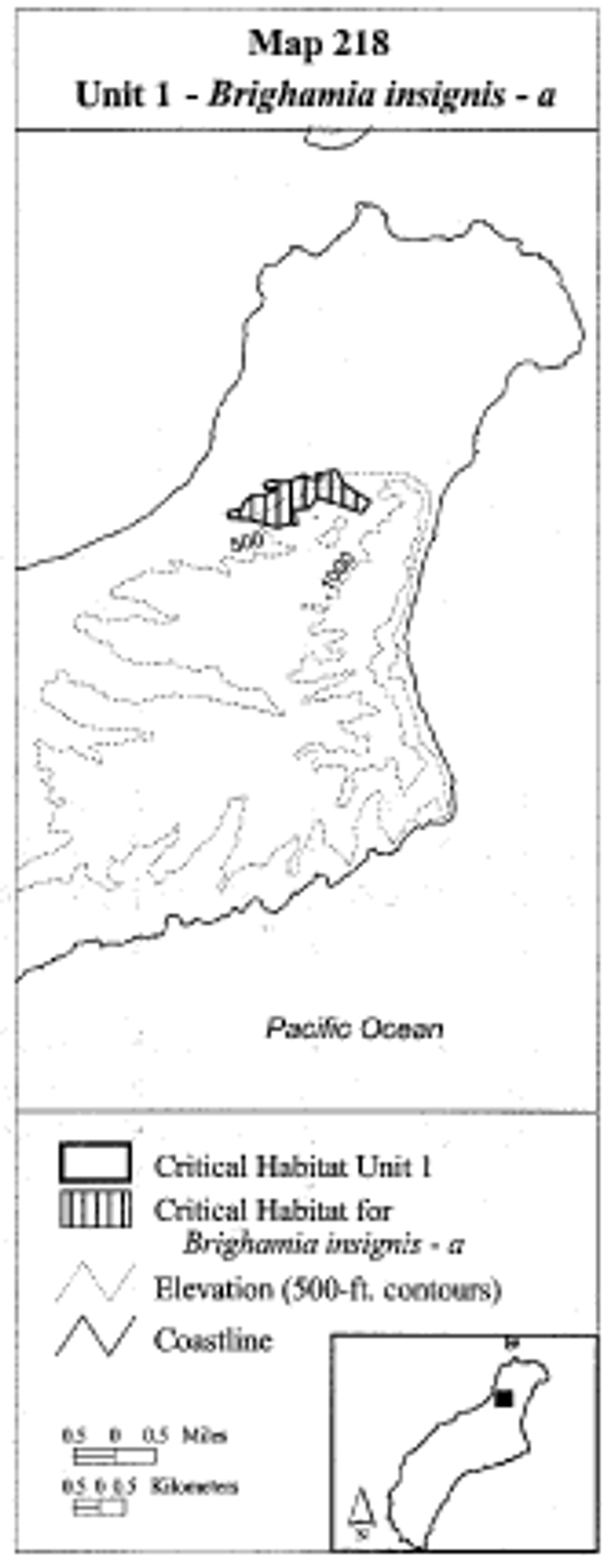
(ii) Table of Protected Species Within Each Critical Habitat Unit for Niihau
| Unit name | Species occupied | Species unoccupied |
|---|---|---|
| Niihau 1 - Brighamia insignis - a | Brighamia insignis |
(b) Plants on Kauai and Niihau; Constituent elements. (1) Flowering plants.
Family Amaranathaceae: Charpentiera densiflora (papala)
Kauai 7-Charpentiera densiflora-a, Kauai 10-Charpentiera densiflora-b, Kauai 11-Charpentiera densiflora-c, Kauai 11-Charpentiera densiflora-d, and Kauai 20-Charpentiera densiflora-e, identified in the legal descriptions in paragraph (a)(1) of this section, constitute critical habitat for Charpentiera densiflora on Kauai.
(i) In units Kauai 7-Charpentiera densiflora-a, and Kauai 11-Charpentiera densiflora-c, the primary constituent elements of critical habitat are:
(A) Elevation: Less than 3,000 ft (914 m).
(B) Annual precipitation: 50 to 75 inches (127 to 190 centimeters).
(C) Substrate: Shallow soils, little to no herbaceous layer.
(D) Canopy: Acacia, Diospyros, Metrosideros, Myrsine, Pouteria, Santalum.
(E) Subcanopy: Dodonaea, Freycinetia, Leptecophylla, Melanthera, Osteomeles, Pleomele, Psydrax.
(F) Understory: Carex, Dicranopteris, Diplazium, Elaphoglossum, Peperomia.
(ii) In units Kauai 10-Charpentiera densiflora-b, Kauai 11-Charpentiera densiflora-d, and Kauai 20-Charpentiera densiflora-e, the primary constituent elements of critical habitat are:
(A) Elevation: Less than 3,000 ft (914 m).
(B) Annual precipitation: Greater than 75 inches (190 centimeters).
(C) Substrate: Clays, ashbeds, deep well-drained soils, lowland bogs.
(D) Canopy: Antidesma, Metrosideros, Myrsine, Pisonia, Psychotria.
(E) Subcanopy: Cibotium, Claoxylon, Kadua, Melicope.
(F) Understory: Alyxia, Cyrtandra, Dicranopteris, Diplazium, Machaerina, Microlepia.
Family Apiaceae: Peucedanum sandwicense (makou)
Kauai 7 - Peucedanum sandwicense - a, Kauai 11 - Peucedanum sandwicense - b, and Kauai 11 - Peucedanum sandwicense - c, identified in the legal descriptions in paragraph (a)(1) of this section, constitute critical habitat for Peucedanum sandwicense on Kauai. Within these units, the currently known primary constituent elements of critical habitat include, but are not limited to, the habitat components provided by:
(i) Cliff habitats in mixed shrub coastal dry cliff communities or diverse mesic forest and containing one or more of the following associated native plant species: Acacia koa, Artemisia australis, Bidens spp., Brighamia insignis, Carex meyenii, Chamaesyce celastroides, Diospyros spp., Dodonaea viscosa, Eragrostis variabilis, Hibiscus kokio, Lobelia niihauensis, Metrosideros polymorpha, Panicum lineale, Psydrax odorata, Psychotria spp., or Wilkesia spp.; and
(ii) Elevations between 119 and 1,232 m (391 and 4,041 ft).
Family Apiaceae: Spermolepis hawaiiensis (NCN)
Kauai 11 - Spermolepis hawaiiensis - a, Kauai 13 - Spermolepis hawaiiensis - b, and Kauai 13 - Spermolepis hawaiiensis - c, identified in the legal descriptions in paragraph (a)(1) of this section, constitute critical habitat for Spermolepis hawaiiensis on Kauai. Within these units, the currently known primary constituent elements of critical habitat include, but are not limited to, the habitat components provided by:
(i) Metrosideros polymorpha forests or Dodonaea viscosa lowland dry shrubland and containing one or more of the following associated plant species: Bidens sandvicensis, Doryopteris spp., Eragrostis variabilis, Erythrina sandwicensis, Lipochaeta spp., Schiedea spergulina, or Sida fallax; and
(ii) Elevations between 56 and 662 m (184 and 2,172 ft).
Family Apocynaceae: Pteralyxia kauaiensis (kaulu)
Kauai 7 - Pteralyxia kauaiensis - a, Kauai 10 - Pteralyxia kauaiensis - b, Kauai 11 - Pteralyxia kauaiensis - c, Kauai 11 - Pteralyxia kauaiensis - d, Kauai 11 - Pteralyxia kauaiensis - e, Kauai 11 - Pteralyxia kauaiensis - f, and Kauai 11 - Pteralyxia kauaiensis - g, identified in the legal descriptions in paragraph (a)(1) of this section, constitute critical habitat for Pteralyxia kauaiensis on Kauai. Within these units, the currently known primary constituent elements of critical habitat include, but are not limited to, the habitat components provided by:
(i) Diverse mesic or Diospyros sandwicensis mixed mesic forests with Pisonia spp. and containing one or more of the following associated plant species: Acacia koa, Alectryon macrococcus, Alphitonia ponderosa, Antidesma platyphyllum var. hillebrandii, Bobea brevipes, Carex spp., Charpentiera elliptica, Claoxylon sandwicense, Cyanea spp., Dianella sandwicensis, Diospyros spp., Dodonaea viscosa, Diplazium sandwichianum, Euphorbia haeleeleana, Freycinetia arborea, Gahnia spp., Gardenia remyi, Hedyotis terminalis, Hibiscus kokio, Kokia kauaiensis, Leptecophylla tameiameiae, Metrosideros polymorpha, Myrsine lanaiensis, Neraudia spp., Nesoluma polynesicum, Nestegis sandwicensis, Peperomia spp., Pisonia sandwicensis, Pipturus spp., Pleomele aurea, Poa sandvicensis, Pouteria sandwicensis, Pritchardia spp., Psydrax odorata, Psychotria spp., Rauvolfia sandwicensis, Santalum freycinetianum var. pyrularium, Schiedea spp., Syzygium sandwicensis, Tetraplasandra spp., Xylosma hawaiiense, or Zanthoxylum dipetalum; and
(ii) Elevations between 127 and 1,563 m (418 and 5,128 ft).
Family Araliaceae: Munroidendron racemosum (NCN)
Kauai 5 - Munroidendron racemosum - a, Kauai 7 - Munroidendron racemosum - b, Kauai 11 - Munroidendron racemosum - c, and Kauai 11 - Munroidendron racemosum - d, identified in the legal descriptions in paragraph (a)(1) of this section, constitute critical habitat for Munroidendron racemosum on Kauai. Within these units the currently known primary constituent elements of critical habitat include, but are not limited to, the habitat components provided by:
(i) Steep exposed cliffs or ridge slopes in coastal or lowland mesic forest and containing one or more of the following associated plant species: Bobea brevipes, Brighamia insignis, Canavalia napaliensis, Diospyros sandwicensis, Diospyros hillebrandii, Nestegis sandwicensis, Pisonia sandwicensis, Pisonia umbellifera, Pleomele aurea, Pouteria sandwicensis, Psychotria spp., Psydrax odorata, Rauvolfia sandwicensis, Schiedea spp., Sida fallax, or Tetraplasandra spp.; and
(ii) Elevations between 11 and 938 m (37 and 3,077 ft).
Family Araliaceae: Tetraplasandra bisattenuata (NCN)
Kauai 7-Tetraplasandra bisattenuata-a, Kauai 10-Tetraplasandra bisattenuata-b, Kauai 11-Tetraplasandra bisattenuata-c, Kauai 11-Tetraplasandra bisattenuata-d, and Kauai 20-Tetraplasandra bisattenuata-e, identified in the legal descriptions in paragraph (a)(1) of this section, constitute critical habitat for Tetraplasandra bisattenuata on Kauai.
(i) In units Kauai 7-Tetraplasandra bisattenuata-a, and Kauai 11-Tetraplasandra bisattenuata-c, the primary constituent elements of critical habitat are:
(A) Elevation: Less than 3,000 ft (914 m).
(B) Annual precipitation: 50 to 75 inches (127 to 190 centimeters).
(C) Substrate: Shallow soils, little to no herbaceous layer.
(D) Canopy: Acacia, Diospyros, Metrosideros, Myrsine, Pouteria, Santalum.
(E) Subcanopy: Dodonaea, Freycinetia, Leptecophylla, Melanthera, Osteomeles, Pleomele, Psydrax.
(F) Understory: Carex, Dicranopteris, Diplazium, Elaphoglossum, Peperomia.
(ii) In units Kauai 10-Tetraplasandra bisattenuata-b, Kauai 11-Tetraplasandra bisattenuata-d, and Kauai 20-Tetraplasandra bisattenuata-e, the primary constituent elements of critical habitat are:
(A) Elevation: Less than 3,000 ft (914 m).
(B) Annual precipitation: Greater than 75 inches (190 centimeters).
(C) Substrate: Clays, ashbeds, deep well-drained soils, lowland bogs.
(D) Canopy: Antidesma, Metrosideros, Myrsine, Pisonia, Psychotria.
(E) Subcanopy: Cibotium, Claoxylon, Kadua, Melicope.
(F) Understory: Alyxia, Cyrtandra, Dicranopteris, Diplazium, Machaerina, Microlepia.
Family Araliaceae: Tetraplasandra flynnii (NCN)
Kauai 10-Tetraplasandra flynnii-a, Kauai 10-Tetraplasandra flynnii-b, Kauai 11-Tetraplasandra flynnii-c, Kauai 11-Tetraplasandra flynnii-d, Kauai 11-Tetraplasandra flynnii-e, Kauai 20-Tetraplasandra flynnii-f, Kauai 21-Tetraplasandra flynnii-g, Kauai 22-Tetraplasandra flynnii-h, Kauai 23-Tetraplasandra flynnii-i, Kauai 24-Tetraplasandra flynnii-j, and Kauai 25-Tetraplasandra flynnii-k, identified in the legal descriptions in paragraph (a)(1) of this section, constitute critical habitat for Tetraplasandra flynnii on Kauai.
(i) In units Kauai 11-Tetraplasandra flynnii-e, Kauai 21-Tetraplasandra flynnii-g, and Kauai 22-Tetraplasandra flynnii-h, the primary constituent elements of critical habitat are:
(A) Elevation: 3,000 to 5,243 ft (914 to 1,598 m).
(B) Annual precipitation: 50 to 75 inches (127 to 190 centimeters).
(C) Substrate: Weathered aa lava flows, rocky mucks, thin silty loams, deep volcanic ash soils.
(D) Canopy: Acacia, Metrosideros, Psychotria, Tetraplasandra, Zanthoxylum.
(E) Subcanopy: Cheirodendron, Coprosma, Kadua, Ilex, Myoporum, Myrsine.
(F) Understory: Bidens, Dryopteris, Leptecophylla, Poa, Scaevola, Sophora.
(ii) In units Kauai 10-Tetraplasandra flynnii-a, Kauai 11-Tetraplasandra flynnii-c, Kauai 23-Tetraplasandra flynnii-i, Kauai 24-Tetraplasandra flynnii-j, and Kauai 25-Tetraplasandra flynnii-k, the primary constituent elements of critical habitat are:
(A) Elevation: 3,000 to 5,243 ft (914 to 1,598 m).
(B) Annual precipitation: Greater than 75 inches (190 centimeters).
(C) Substrate: Well-developed soils, montane bogs.
(D) Canopy: Acacia, Charpentiera, Cheirodendron, Metrosideros.
(E) Subcanopy: Broussaisia, Cibotium, Eurya, Ilex, Myrsine.
(F) Understory: Ferns, Carex, Coprosma, Leptecophylla, Oreobolus, Rhynchospora, Vaccinium.
(iii) In units Kauai 10-Tetraplasandra flynii-b, Kauai 11-Tetraplasandra flynii-d, and Kauai 20-Tetraplasandra flynnii-f, the primary constituent elements of critical habitat are:
(A) Elevation: Less than 3,000 ft (914 m).
(B) Annual precipitation: Greater than 75 inches (190 centimeters).
(C) Substrate: Clays, ashbeds, deep well-drained soils, lowland bogs.
(D) Canopy: Antidesma, Metrosideros, Myrsine, Pisonia, Psychotria.
(E) Subcanopy: Cibotium, Claoxylon, Kadua, Melicope.
(F) Understory: Alyxia, Cyrtandra, Dicranopteris, Diplazium, Machaerina, Microlepia.
Family Asteliaceae: Astelia waialealae (painiu)
Kauai 10-Astelia waialealae-a, Kauai 11-Astelia waialealae-b, Kauai 23-Astelia waialealae-c, Kauai 24-Astelia waialealae-d, and Kauai 25-Astelia waialealae-e, identified in the legal descriptions in paragraph (a)(1) of this section, constitute critical habitat for Astelia waialealae on Kauai. Within these units, the primary constituent elements of critical habitat are:
(i) Elevation: 3,000 to 5,243 ft (914 to 1,598 m).
(ii) Annual precipitation: Greater than 75 inches (190 centimeters).
(iii) Substrate: Well-developed soils, montane bogs.
(iv) Canopy: Acacia, Charpentiera, Cheirodendron, Metrosideros.
(v) Subcanopy: Broussaisia, Cibotium, Eurya, Ilex, Myrsine.
(vi) Understory: Ferns, Carex, Coprosma, Leptecophylla, Oreobolus, Rhynchospora, Vaccinium.
(vii) Hummocks in bogs.
Family Asteraceae: Dubautia imbricata ssp. imbricata (naenae)
Kauai 10-Dubautia imbricata ssp. imbricata-a, Kauai 11-Dubautia imbricata ssp. imbricata-b, and Kauai 20-Dubautia imbricata ssp. imbricata-c, identified in the legal descriptions in paragraph (a)(1) of this section, constitute critical habitat for Dubautia imbricata ssp. imbricata on Kauai. Within these units, the primary constituent elements of critical habitat are:
(i) Elevation: Less than 3,000 ft (914 m).
(ii) Annual precipitation: Greater than 75 inches (190 centimeters).
(iii) Substrate: Clays, ashbeds, deep well-drained soils, lowland bogs.
(iv) Canopy: Antidesma, Metrosideros, Myrsine, Pisonia, Psychotria.
(v) Subcanopy: Cibotium, Claoxylon, Kadua, Melicope.
(vi) Understory: Alyxia, Cyrtandra, Dicranopteris, Diplazium, Machaerina, Microlepia.
Family Asteraceae: Dubautia kalalauensis (naenae)
Kauai 10-Dubautia kalalauensis-a, Kauai 11-Dubautia kalalauensis-b, Kauai 23-Dubautia kalalauensis-c, Kauai 24-Dubautia kalalauensis-d, and Kauai 25-Dubautia kalalauensis-e, identified in the legal descriptions in paragraph (a)(1) of this section, constitute critical habitat for Dubautia kalalauensis on Kauai. Within these units, the primary constituent elements of critical habitat are:
(i) Elevation: 3,000 to 5,243 ft (914 to 1,598 m).
(ii) Annual precipitation: Greater than 75 inches (190 centimeters).
(iii) Substrate: Well-developed soils, montane bogs.
(iv) Canopy: Acacia, Charpentiera, Cheirodendron, Metrosideros.
(v) Subcanopy: Broussaisia, Cibotium, Eurya, Ilex, Myrsine.
(vi) Understory: Ferns, Carex, Coprosma, Leptecophylla, Oreobolus, Rhynchospora, Vaccinium.
Family Asteraceae: Dubautia kenwoodii (naenae)
Kauai 7-Dubautia kenwoodii-a and Kauai 11-Dubautia kenwoodii-b, identified in the legal descriptions in paragraph (a)(1) of this section, constitute critical habitat for Dubautia kenwoodii on Kauai. Within these units, the primary constituent elements of critical habitat are:
(i) Elevation: Less than 3,000 ft (914 m).
(ii) Annual precipitation: 50 to 75 inches (127 to 190 centimeters).
(iii) Substrate: Shallow soils, little to no herbaceous layer.
(iv) Canopy: Acacia, Diospyros, Metrosideros, Myrsine, Pouteria, Santalum.
(v) Subcanopy: Dodonaea, Freycinetia, Leptecophylla, Melanthera, Osteomeles, Pleomele, Psydrax.
(vi) Understory: Carex, Dicranopteris, Diplazium, Elaphoglossum, Peperomia.
Family Asteraceae: Dubautia latifolia (naenae)
Kauai 11 - Dubautia latifolia - a, Kauai 11 - Dubautia latifolia - b, and Kauai 11 - Dubautia latifolia - c, identified in the legal descriptions in paragraph (a)(1) of this section, constitute critical habitat for Dubautia latifolia on Kauai. Within these units, the currently known primary constituent elements of critical habitat include, but are not limited to, the habitat components provided by:
(i) Gentle or steep slopes on well drained soil in semi-open or closed, diverse montane mesic forest dominated by Acacia koa and/or Metrosideros polymorpha and containing one or more of the following native plant species: Alphitonia ponderosa, Antidesma platyphyllum, Bobea spp., Claoxylon sandwicense, Coprosma waimeae, Cyrtandra spp., Dicranopteris linearis, Diplazium sandwichianum, Dodonaea viscosa, Elaeocarpus bifidus, Hedyotis terminalis, Ilex anomala, Melicope anisata, Nestegis sandwicensis, Pleomele aurea, Pouteria sandwicensis, Psychotria mariniana, Scaevola spp., or Xylosma spp.; and
(ii) Elevations between 545 and 1,277 m (1,786 and 4,189 ft).
Family Asteraceae: Dubautia pauciflorula (naenae)
Kauai 10 - Dubautia pauciflorul - a, identified in the legal description in paragraph (a)(1) of this section, constitutes critical habitat for Dubautia pauciflorula on Kauai. Within this unit, the currently known primary constituent elements of critical habitat include, but are not limited to, the habitat components provided by:
(i) Metrosideros polymorpha-Dicranopteris linearis lowland wet forest within stream drainages containing one or more of the following associated native plant species: Antidesma platyphyllum, Broussaisia arguta, Cheirodendron spp., Dubautia laxa, Embelia pacifica, Hesperomannia lydgatei, Labordia waialealae, Melicope spp., Nothoperanema rubiginosa, Pritchardia spp., Psychotria spp., Sadleria spp., Scaevola mollis, Syzygium sandwicensis, or Tetraplasandra spp.; and
(ii) Elevations between 564 and 1,094 m (1,849 and 3,587 ft).
Family Asteraceae: Dubautia plantaginea ssp. magnifolia (naenae)
Kauai 4-Dubautia plantaginea ssp. magnifolia-a, Kauai 10-Dubautia plantaginea ssp. magnifolia-b, Kauai 11-Dubautia plantaginea ssp. magnifolia-c, Kauai 18-Dubautia plantaginea ssp. magnifolia-d, and Kauai 19-Dubautia plantaginea ssp. magnifolia-e, identified in the legal descriptions in paragraph (a)(1) of this section, constitute critical habitat for Dubautia plantaginea ssp. magnifolia on Kauai. Within these units, the primary constituent elements of critical habitat are:
(i) Annual precipitation: Greater than 75 inches (190 centimeters).
(ii) Substrate: Greater than 65 degree slope, shallow soils, weathered lava.
(iii) Subcanopy: Broussaisia, Cheirodendron, Leptecophylla, Metrosideros.
(iv) Understory: Ferns, Bryophytes, Coprosoma, Dubautia, Kadua, Peperomia.
Family Asteraceae: Dubautia waialealae (naenae)
Kauai 10-Dubautia waialealae-a, Kauai 11-Dubautia waialealae-b, Kauai 23-Dubautia waialealae-c, Kauai 24-Dubautia waialealae-d, and Kauai 25-Dubautia waialealae-e, identified in the legal descriptions in paragraph (a)(1) of this section, constitute critical habitat for Dubautia waialealae on Kauai. Within these units, the primary constituent elements of critical habitat are:
(i) Elevation: 3,000 to 5,243 ft (914 to 1,598 m).
(ii) Annual precipitation: Greater than 75 inches (190 centimeters).
(iii) Substrate: Well-developed soils, montane bogs.
(iv) Canopy: Acacia, Charpentiera, Cheirodendron, Metrosideros.
(v) Subcanopy: Broussaisia, Cibotium, Eurya, Ilex, Myrsine.
(vi) Understory: Ferns, Carex, Coprosma, Leptecophylla, Oreobolus, Rhynchospora, Vaccinium.
(vii) Bogs.
Family Asteraceae: Hesperomannia lydgatei (NCN)
Kauai 10 - Hesperomannia lydgatei - a, Kauai 11 - Hesperomannia lydgatei - b, and Kauai 11 - Hesperomannia lydgatei - c, identified in the legal descriptions in paragraph (a)(1) of this section, constitute critical habitat for Hesperomannia lydgatei on Kauai. Within these units, the currently known primary constituent elements of critical habitat include, but are not limited to, the habitat components provided by:
(i) Stream banks and forested slopes in rich brown soil and silty clay in Metrosideros polymorpha or Metrosideros polymorpha-Dicranopteris linearis lowland wet forest and containing one or more of the following associated native plant species: Adenophorus periens, Antidesma platyphyllum, Broussaisia arguta, Cheirodendron spp., Cyanea spp., Dubautia knudsenii, Dubautia laxa, Dubautia pauciflorula, Dubautia raillardioides, Elaphoglossum spp., Freycinetia arborea, Hedyotis terminalis, Labordia lydgatei, Machaerina angustifolia, Peperomia spp., Pritchardia spp., Psychotria hexandra, or Syzygium sandwicensis; and
(ii) Elevations between 207 and 1,344 m (680 and 4,409 ft).
Family Asteraceae: Keysseria erici (NCN)
Kauai 10-Keysseria erici-a, Kauai 11-Keysseria erici-b, Kauai 23-Keysseria erici-c, Kauai 24-Keysseria erici-d, and Kauai 25-Keysseria erici-e, identified in the legal descriptions in paragraph (a)(1) of this section, constitute critical habitat for Keysseria erici on Kauai. Within these units, the primary constituent elements of critical habitat are:
(i) Elevation: 3,000 to 5,243 ft (914 to 1,598 m).
(ii) Annual precipitation: Greater than 75 inches (190 centimeters).
(iii) Substrate: Well-developed soils, montane bogs.
(iv) Canopy: Acacia, Charpentiera, Cheirodendron, Metrosideros.
(v) Subcanopy: Broussaisia, Cibotium, Eurya, Ilex, Myrsine.
(vi) Understory: Ferns, Carex, Coprosma, Leptecophylla, Oreobolus, Rhynchospora, Vaccinium.
(vii) Bogs.
Family Asteraceae: Keysseria helenae (NCN)
Kauai 10-Keysseria helenae-a, Kauai 11-Keysseria helenae-b, Kauai 23-Keysseria helenae-c, Kauai 24-Keysseria helenae-d, and Kauai 25-Keysseria helenae-e, identified in the legal descriptions in paragraph (a)(1) of this section, constitute critical habitat for Keysseria helenae on Kauai. Within these units, the primary constituent elements of critical habitat are:
(i) Elevation: 3,000 to 5,243 ft (914 to 1,598 m).
(ii) Annual precipitation: Greater than 75 inches (190 centimeters).
(iii) Substrate: Well-developed soils, montane bogs.
(iv) Canopy: Acacia, Charpentiera, Cheirodendron, Metrosideros.
(v) Subcanopy: Broussaisia, Cibotium, Eurya, Ilex, Myrsine.
(vi) Understory: Ferns, Carex, Coprosma, Leptecophylla, Oreobolus, Rhynchospora, Vaccinium.
(vii) Bogs.
Family Asteraceae: Lipochaeta fauriei (nehe)
Kauai 11 - Lipochaeta fauriei - a, and Kauai 11 - Lipochaeta fauriei - b, identified in the legal descriptions in paragraph (a)(1) of this section, constitute critical habitat for Lipochaeta fauriei on Kauai. Within these units, the currently known primary constituent elements of critical habitat include, but are not limited to, the habitat components provided by:
(i) Moderate shade to full sun on the sides of steep gulches in diverse lowland mesic forests and containing one or more of the following native species: Acacia koa, Carex meyenii, Carex wahuensis, Dicranopteris linearis, Diospyros spp., Dodonaea viscosa, Euphorbia haeleeleana, Hibiscus waimeae, Kokia kauaiensis, Myrsine lanaiensis, Nestegis sandwicensis, Pleomele aurea, Psychotria greenwelliae, Psychotria mariniana, or Sapindus oahuensis; and
(ii) Elevations between 438 and 948 m (1,438 and 3,108 ft).
Family Asteraceae: Lipochaeta micrantha (nehe)
Kauai 7 - Lipochaeta micrantha - a, and Kauai 11 - Lipochaeta micrantha - b, identified in the legal descriptions in paragraph (a)(1) of this section, constitute critical habitat for Lipochaeta micrantha on Kauai. Within these units the currently known primary constituent elements of critical habitat for Lipochaeta micrantha are the habitat components provided by:
(i) Cliffs, ridges, stream banks, or slopes in mesic to wet mixed communities and containing one or more of the following associated native plant species: Acacia koa, Antidesma spp., Artemisia australis, Bidens sandvicensis, Bobea spp., Chamaesyce celastroides var. hanapepensis, Diospyros spp., Dodonaea viscosa, Eragrostis grandis, Eragrostis variabilis, Hibiscus kokio, Lepidium bidentatum, Lobelia niihauensis, Melicope spp., Metrosideros polymorpha, Neraudia kauaiensis, Nototrichium spp., Pipturus spp., Plectranthus parviflorus, Pleomele aurea, Psydrax odorata, Rumex albescens, Sida fallax, or Xylosma hawaiiense; and
(ii) Elevations between 127 and 1,090 m (418 and 3,574 ft).
Family Asteraceae: Lipochaeta waimeaensis (nehe)
Kauai 13 - Lipochaeta waimeaensis - a, identified in the legal description in paragraph (a)(1) of this section, constitutes critical habitat for Lipochaeta waimeaensis on Kauai. Within this unit, the currently known primary constituent elements of critical habitat include, but are not limited to, the habitat components provided by:
(i) Precipitous, shrub-covered gulches in diverse lowland forest and containing one or more of the following associated native plant species: Artemisia australis, Chamaesyce celastroides, Dodonaea viscosa, Lipochaeta connata, Santalum freycinetianum, Schiedea spergulina, or Panicum spp.; and
(ii) Elevations between 44 and 409 m (145 and 1,340 ft).
Family Asteraceae: Remya kauaiensis (NCN)
Kauai 11 - Remya kauaiensis - a, Kauai 11 - Remya kauaiensis - b, Kauai 11 - Remya kauaiensis - c, Kauai 11 - Remya kauaiensis - d, Kauai 11 - Remya kauaiensis - e, and Kauai 12 - Remya kauaiensis - f, identified in the legal descriptions in paragraph (a)(1) of this section, constitute critical habitat for Remya kauaiensis on Kauai. Within these units, the currently known primary constituent elements of critical habitat include, but are not limited to, the habitat components provided by:
(i) Steep, north or northeast-facing slopes in Acacia koa-Metrosideros polymorpha lowland mesic forest and containing one or more of the following associated native plant species: Chamaesyce spp., Claoxylon sandwicense, Dianella sandwicensis, Diospyros spp., Dodonaea viscosa, Hedyotis terminalis, Melicope spp., Nestegis sandwicensis, Pouteria sandwicensis, Psychotria spp., Schiedea spp., or Tetraplasandra spp.; and
(ii) Elevations between 560 and 1,249 m (1,836 and 4,097 ft).
Family Asteraceae: Remya montgomeryi (NCN)
Kauai 11 - Remya montgomeryi - a, Kauai 11 - Remya montgomeryi - b, and Kauai 11 - Remya montgomeryi - c, identified in the legal descriptions in paragraph (a)(1) of this section, constitute critical habitat for Remya montgomeryi on Kauai. Within these units, the currently known primary constituent elements of critical habitat include, but are not limited to, the habitat components provided by:
(i) Steep, north or northeast-facing slopes or cliffs in transitional wet or Metrosideros polymorpha-dominated mixed mesic forest and containing one or more of the following associated native plant species: Artemisia australis, Bobea spp., Boehmeria grandis, Cheirodendron spp., Claoxylon sandwicense, Cyrtandra spp., Dubautia spp., Ilex anomala, Lepidium serra, Lysimachia spp., Myrsine linearifolia, Nototrichium spp., Pleomele aurea, Poa mannii, Sadleria spp., Scaevola spp., Stenogyne campanulata, Tetraplasandra spp., or Zanthoxylum dipetalum; and
(ii) Elevations between 336 and 1,345 m (1,102 and 4,411 ft).
Family Asteraceae: Wilkesia hobdyi (dwarf iliau)
Kauai 11 - Wilkesia hobdyi - a, identified in the legal description in paragraph (a)(1) of this section, constitutes critical habitat for Wilkesia hobdyi on Kauai. Within this unit, the currently known primary constituent elements of critical habitat include, but are not limited to, the habitat components provided by:
(i) Coastal dry cliffs or very dry ridges containing one or more of the following associated native plant species: Artemisia australis, Dodonaea viscosa, Eragrostis variabilis, Hibiscus kokio ssp. saint johnianus, Lipochaeta connata, Lobelia niihauensis, Myoporum sandwicense, Peperomia blanda, Peperomia spp., Peperomia tetraphylla, Peucedanum sandwicense, Psydrax odorata, Sida fallax, Waltheria indica, or Wilkesia gymnoxiphium; and
(ii) Elevations between 12 and 685 m (40 and 2,246 ft).
Family Campanulaceae: Brighamia insignis (olulu)
Kauai 6 - Brighamia insignis - a, Kauai 7 - Brighamia insignis - b, and Kauai 11 - Brighamia insignis - c identified in the legal descriptions in paragraph (a)(1) of this section, and Niihau 1 - Brighamia insignis - a, identified in the legal description in paragraph (a)(2) of this section, constitute critical habitat for Brighamia insignis on Kauai and Niihau. Within these units, the currently known primary constituent elements of critical habitat include, but are not limited to, the habitat components provided by:
(i) Rocky ledges with little soil or steep sea cliffs in lowland dry grasslands or shrublands with annual rainfall that is usually less than 170 cm (65 in) and containing one or more of the following native plant species: Artemisia australis, Chamaesyce celastroides, Eragrostis variabilis, Heteropogon contortus, Hibiscus kokio, Hibiscus kokio ssp. saintjohnianus, Lepidium serra, Lipochaeta succulenta, Munroidendron racemosum, or Sida fallax; and
(ii) Elevations between 0 and 748 m (0 and 2,453 ft).
Family Campanulaceae: Cyanea asarifolia (haha)
Kauai 4 - Cyanea asarifolia - a, and Kauai 10 - Cyanea asarifolia - b, identified in the legal descriptions in paragraph (a)(1) of this section, constitute critical habitat for Cyanea asarifolia on Kauai. Within these units, the currently known primary constituent elements of critical habitat include, but are not limited to, the habitat components provided by:
(i) Pockets of soil on sheer wet rock cliffs and waterfalls in lowland wet forests and containing one or more of the following native plant species: Bidens spp., Dubautia plantaginea, Hedyotis centranthoides, Hedyotis elatior, Lysimachia filifolia, Machaerina angustifolia, Metrosideros polymorpha, or Panicum lineale; and
(ii) Elevations between 182 and 1,212 m (597 and 3,976 ft).
Family Campanulaceae: Cyanea dolichopoda (haha)
Kauai 4-Cyanea dolichopoda-a, Kauai 10-Cyanea dolichopoda-b, Kauai 11-Cyanea dolichopoda-c, Kauai 18-Cyanea dolichopoda-d, and Kauai 19-Cyanea dolichopoda-e, identified in the legal descriptions in paragraph (a)(1) of this section, constitute critical habitat for Cyanea dolichopoda on Kauai. Within these units, the primary constituent elements of critical habitat are:
(i) Annual precipitation: Greater than 75 inches (190 centimeters).
(ii) Substrate: Greater than 65 degree slope, shallow soils, weathered lava.
(iii) Subcanopy: Broussaisia, Cheirodendron, Leptecophylla, Metrosideros.
(iv) Understory: Ferns, Bryophytes, Coprosoma, Dubautia, Kadua, Peperomia.
Family Campanulaceae: Cyanea eleeleensis (haha)
Kauai 10-Cyanea eleeleensis-a, Kauai 11-Cyanea eleeleensis-b, and Kauai 20-Cyanea eleeleensis-c, identified in the legal descriptions in paragraph (a)(1) of this section, constitute critical habitat for Cyanea eleeleensis on Kauai. Within these units, the primary constituent elements of critical habitat are:
(i) Elevation: Less than 3,000 ft (914 m).
(ii) Annual precipitation: Greater than 75 inches (190 centimeters).
(iii) Substrate: Clays, ashbeds, deep well-drained soils, lowland bogs.
(iv) Canopy: Antidesma, Metrosideros, Myrsine, Pisonia, Psychotria.
(v) Subcanopy: Cibotium, Claoxylon, Kadua, Melicope.
(vi) Understory: Alyxia, Cyrtandra, Dicranopteris, Diplazium, Machaerina, Microlepia.
Family Campanulaceae: Cyanea kolekoleensis (haha)
Kauai 10-Cyanea kolekoleensis-a, Kauai 11-Cyanea kolekoleensis-b, and Kauai 20-Cyanea kolekoleensis-c, identified in the legal descriptions in paragraph (a)(1) of this section, constitute critical habitat for Cyanea kolekoleensis on Kauai. Within these units, the primary constituent elements of critical habitat are:
(i) Elevation: Less than 3,000 ft (914 m).
(ii) Annual precipitation: Greater than 75 inches (190 centimeters).
(iii) Substrate: Clays, ashbeds, deep well-drained soils, lowland bogs.
(iv) Canopy: Antidesma, Metrosideros, Myrsine, Pisonia, Psychotria.
(v) Subcanopy: Cibotium, Claoxylon, Kadua, Melicope.
(vi) Understory: Alyxia, Cyrtandra, Dicranopteris, Diplazium, Machaerina, Microlepia.
Family Campanulaceae: Cyanea kuhihewa (haha)
Kauai 10-Cyanea kuhihewa-a, Kauai 11-Cyanea kuhihewa-b, and Kauai 20-Cyanea kuhihewa-c, identified in the legal descriptions in paragraph (a)(1) of this section, constitute critical habitat for Cyanea kuhihewa on Kauai. Within these units, the primary constituent elements of critical habitat are:
(i) Elevation: Less than 3,000 ft (914 m).
(ii) Annual precipitation: Greater than 75 inches (190 centimeters).
(iii) Substrate: Clays, ashbeds, deep well-drained soils, lowland bogs.
(iv) Canopy: Antidesma, Metrosideros, Myrsine, Pisonia, Psychotria.
(v) Subcanopy: Cibotium, Claoxylon, Kadua, Melicope.
(vi) Understory: Alyxia, Cyrtandra, Dicranopteris, Diplazium, Machaerina, Microlepia.
Family Campanulaceae: Cyanea recta (haha)
Kauai 4 - Cyanea recta - a, Kauai 4 - Cyanea recta - b, Kauai 11 - Cyanea recta - c, and Kauai 11 - Cyanea recta - d, identified in the legal descriptions in paragraph (a)(1) of this section, constitute critical habitat for Cyanea recta on Kauai. Within these units, the currently known primary constituent elements of critical habitat include, but are not limited to, the habitat components provided by:
(i) Gulches or slopes in lowland wet or mesic Metrosideros polymorpha forest or shrubland and containing one or more of the following native plant species: Antidesma platyphyllum, Cheirodendron platyphyllum, Cibotium spp., Dicranopteris linearis, Diplazium spp., or Psychotria spp.; and
(ii) Elevations between 297 and 1,345 m (975 and 4,411 ft).
Family Campanulaceae: Cyanea remyi (haha)
Kauai 4 - Cyanea remyi - a, Kauai 10 - Cyanea remyi - b, Kauai 11 - Cyanea remyi - c, and Kauai 11 - Cyanea remyi - d, identified in the legal descriptions in paragraph (a)(1) of this section, constitute critical habitat for Cyanea remyi on Kauai. Within these units, the currently known primary constituent elements of critical habitat include, but are not limited to, the habitat components provided by:
(i) Narrow drainages and wet stream banks in lowland wet forest or shrubland and containing one or more of the following native plant species: various grammitid and filmy ferns (Grammitidaceae and Hymenophyllaceae), Adenophorus spp., Antidesma platyphyllum, Bidens spp., Broussaisia arguta, Cheirodendron spp., Cyrtandra spp., Diplazium sandwichianum, Eragrostis grandis, Freycinetia arborea, Hedyotis terminalis, Machaerina angustifolia, Metrosideros polymorpha, Perrottetia sandwicensis, Pipturus spp., Psychotria hexandra, Syzygium sandwicensis, Thelypteris spp., Touchardia latifolia, or Urera glabra; and
(ii) Elevations between 219 and 1,089 m (719 and 3,571 ft).
Family Campanulaceae: Cyanea undulata (haha)
Kauai 10 - Cyanea undulata - a, identified in the legal description in paragraph (a)(1) of this section, constitutes critical habitat for Cyanea undulata on Kauai. Within this unit, the currently known primary constituent elements of critical habitat include, but are not limited to, the habitat components provided by:
(i) Narrow drainages and wet stream banks in Metrosideros polymorpha dry to montane wet forest or shrubland and containing one or more of the following associated native species: various grammitid and filmy ferns (Grammitidaceae and Hymenophyllaceae), Adenophorus spp., Antidesma platyphyllum, Bidens spp., Broussaisia arguta, Cheirodendron spp., Diplazium sandwichianum, Dryopteris glabra, Eragrostis grandis, Freycinetia arborea, Machaerina angustifolia, Mariscus spp., Melicope feddei, Perrottetia sandwicensis, Pipturus spp., Psychotria hexandra, Psychotria mariniana, Sadleria pallida, Sadleria squarrosa, Smilax melastomifolia, Sphenomeris chinensis, Syzygium sandwicensis, or Thelypteris spp.; and
(ii) Elevations between 375 and 1,046 m (1,231 and 3,430 ft).
Family Campanulaceae: Delissea rhytidosperma (no common name)
Kauai 7 - Delissea rhytidosperma - a, Kauai 11 - Delissea rhytidosperma - b, and Kauai 11 - Delissea rhytidosperma - c, identified in the legal descriptions in paragraph (a)(1) of this section, constitute critical habitat for Delissea rhytidosperma on Kauai. Within these units, the currently known primary constituent elements of critical habitat include, but are not limited to, the habitat components provided by:
(i) Well-drained soils with medium or fine-textured subsoil in Diospyros diverse lowland mesic forests or diverse Metrosideros polymorpha-Acacia koa forests and containing one or more of the following native species: Adenophorus spp., Cyanea spp., Dianella sandwicensis, Diospyros sandwicensis, Dodonaea viscosa, Doodia kunthiana, Euphorbia haeleeleana, grammitid ferns (Grammitidaceae), Hedyotis spp., Leptecophylla tameiameiae, Microlepia strigosa, Nestegis sandwicensis, Pisonia spp., Psychotria hobdyi, or Pteralyxia kauaiensis; and
(ii) Elevations between 167 and 895 m (547 and 2,935 ft).
Family Campanulaceae: Cyanea rivularis (oha)
Kauai 11- Cyanea rivularis -a, identified in the legal description in paragraph (a)(1) of this section, constitutes critical habitat for Cyanea rivularis on Kauai. Within this unit, the currently known primary constituent elements of critical habitat include, but are not limited to, the habitat components provided by:
(i) Steep slopes near streams in Metrosideros polymorpha-Cheirodendron trigynum montane wet or mesic forest and containing one or more of the following native plant species: Boehmeria grandis, Broussaisia arguta, Carex spp., Coprosma spp., Diplazium sandwichianum, Dubautia knudsenii, Hedyotis foggiana, Ilex anomala, Machaerina angustifolia, Melicope anisata, Melicope clusiifolia, Pipturus spp., Psychotria hexandra, or Sadleria spp.; and
(ii) Elevations between 823 and 1,307 m (2,701 and 4,286 ft).
Family Campanulaceae: Delissea undulata (NCN)
Kauai 11 - Delissea undulata - a, and Kauai 11 - Delissea undulata - b, identified in the legal descriptions in paragraph (a)(1) of this section, constitute critical habitat for Delissea undulata on Kauai. Within these units, the currently known primary constituent elements of critical habitat include, but are not limited to, the habitat components provided by:
(i) Dry or open Acacia koa-Metrosideros polymorpha mesic forests or Alphitonia ponderosa montane forest and containing one or more of the following native plant species: Diospyros sandwicensis, Dodonaea viscosa, Doodia kunthiana, Eragrostis variabilis, Euphorbia haeleeleana, Kokia kauaiensis, Microlepia strigosa, Panicum spp., Pleomele aurea, Psychotria mariniana, Psychotria greenwelliae, or Santalum freycinetianum; and
(ii) Elevations between 139 and 1,006 m (456 and 3,299 ft).
Family Campanulaceae: Lobelia niihauensis (NCN)
Kauai 11 - Lobelia niihauensis - a, and Kauai 11 - Lobelia niihauensis - b, identified in the legal descriptions in paragraph (a)(1) of this section, constitute critical habitat for Lobelia niihauensis on Kauai. Within these units, the currently known primary constituent elements of critical habitat include, but are not limited to, the habitat components provided by:
(i) Exposed mesic mixed shrubland or coastal dry cliffs and containing one or more of the following associated native plant species: Artemisia australis, Bidens sandvicensis, Chamaesyce celastroides, Charpentiera spp., Eragrostis variabilis, Hibiscus kokio ssp. saint-johnianus, Lipochaeta connata var. acris, Lythrum spp., Nototrichium spp., Plectranthus parviflorus, Schiedea apokremnos, or Wilkesia hobdyi; and
(ii) Elevations between 36 and 888 m (117 and 2,911 ft).
Family Caryophyllaceae: Alsinidendron lychnoides (kuawawaenohu)
Kauai 11 - Alsinidendron lychnoides - a, Kauai 11 - Alsinidendron lychnoides - b, and Kauai 11 - Alsinidendron lychnoides - c, identified in the legal descriptions in paragraph (a)(1) of this section, constitute critical habitat for Alsinidendron lychnoides on Kauai. Within these units, the currently known primary constituent elements of critical habitat include, but are not limited to, the habitat components provided by:
(i) Steep riparian clay or silty soil banks in montane wet forests dominated by Metrosideros polymorpha and Cheirodendron spp., or by Metrosideros polymorpha and Dicranopteris linearis and containing one or more of the following native plant species: Asplenium spp., Astelia spp., Broussaisia arguta, Carex spp., Cyrtandra spp., Diplazium sandwichianum, Elaphoglossum spp., Hedyotis terminalis, Machaerina spp., Peperomia spp., or Vaccinium spp.; and
(ii) Elevations between 828 and 1,344 m (2,715 and 4,408 ft).
Family Caryophyllaceae: Alsinidendron viscosum (NCN)
Kauai 11 - Alsinidendron viscosum - a, Kauai 11 - Alsinidendron viscosum - b, Kauai 11 - Alsinidendron viscosum - c, and Kauai 11 - Alsinidendron viscosum - d, identified in the legal descriptions in paragraph (a)(1) of this section, constitute critical habitat for Alsinidendron viscosum on Kauai. Within these units, the currently known primary constituent elements of critical habitat include, but are not limited to, the habitat components provided by:
(i) Steep slopes in Acacia koa-Metrosideros polymorpha lowland and montane mesic forest and containing one or more of the following native plant species: Alyxia oliviformis, Asplenium polyodon, Bidens cosmoides, Bobea spp., Carex meyenii, Carex wahuensis, Coprosma spp., Dianella sandwicensis, Dodonaea viscosa, Doodia kunthiana, Dryopteris glabra, Dryopteris unidentata, Dryopteris wallichiana, Dubautia laevigata, Gahnia spp., Ilex anomala, Melicope spp., Panicum nephelophilum, Pleomele aurea, Psychotria spp., Pteridium aquilinum var. decompositum, Schiedea stellarioides, or Vaccinium dentatum; and
(ii) Elevations between 754 and 1,224 m (2,474 and 4,016 ft).
Family Caryophyllaceae: Schiedea apokremnos (maolioli)
Kauai 11 - Schiedea apokremnos - a, Kauai 11 - Schiedea apokremnos - b, and Kauai 11 - Schiedea apokremnos - c, identified in the legal descriptions in paragraph (a)(1) of this section, constitute critical habitat for Schiedea apokremnos on Kauai. Within these units, the currently known primary constituent elements of critical habitat include, but are not limited to, the habitat components provided by:
(i) Crevices of near-vertical basalt coastal cliff faces in sparse dry coastal cliff shrub vegetation and containing one or more of the following associated native plant species: Artemisia australis, Bidens spp., Carex meyenii, Chamaesyce celastroides, Eragrostis variabilis, Lepidium serra, Lipochaeta connata, Lobelia niihauensis, Myoporum sandwicense, Peperomia spp., Pleomele aurea, Psydrax odorata, or Wilkesia spp.; and
(ii) Elevations between 11 and 538 m (35 and 1,765 ft).
Family Caryophyllaceae: Schiedea attenuata (NCN)
Kauai 11-Schiedea attenuata-a, identified in the legal description in paragraph (a)(1) of this section, constitutes critical habitat for Schiedea attenuata on Kauai. Within this unit, the primary constituent elements of critical habitat are:
(i) Annual precipitation: Less than 75 inches (190 centimeters).
(ii) Substrate: Greater than 65 degree slope, rocky talus.
(iii) Subcanopy: Antidesma, Chamaesyce, Diospyros, Dodonaea.
(iv) Understory: Bidens, Eragrostis, Melanthera, Schiedea.
Family Caryophyllaceae: Schiedea helleri (NCN)
Kauai 11 - Schiedea helleri - a, Kauai 11 - Schiedea helleri - b, and Kauai 11 - Schiedea helleri - c, identified in the legal descriptions in paragraph (a)(1) of this section, constitute critical habitat for Schiedea helleri on Kauai. Within these units, the currently known primary constituent elements of critical habitat include, but are not limited to, the habitat components provided by:
(i) Ridges and steep cliffs in closed Metrosideros polymorpha-Dicranopteris linearis montane wet forest, M. polymorpha-Cheirodendron spp. montane wet forest, or Acacia koa-M. polymorpha montane mesic forest and containing one or more of the following associated native plant species: Broussaisia arguta, Cheirodendron spp., Cibotium spp., Cyanea spp., Dianella sandwicensis, Dubautia spp., Elaeocarpus bifidus, Hedyotis terminalis, Melicope spp., Myrsine spp., Poa sandvicensis, Scaevola procera, Syzygium sandwicensis, or Viola wailenalenae; and
(ii) Elevations between 664 and 1,361 m (2,178 and 4,464 ft).
Family Caryophyllaceae: Schiedea kauaiensis (NCN)
Kauai 11 - Schiedea kauaiensis - a, Kauai 11 - Schiedea kauaiensis - b, Kauai 11 - Schiedea kauaiensis - c, and Kauai 11 - Schiedea kauaiensis - d, identified in the legal descriptions in paragraph (a)(1) of this section, constitute critical habitat for Schiedea kauaiensis on Kauai. Within these units, the currently known primary constituent elements of critical habitat include, but are not limited to, the habitat components provided by:
(i) Steep slopes in diverse mesic to wet Acacia koa-Metrosideros polymorpha forest and containing one or more of the following associated plant species: Alphitonia ponderosa, Cryptocarya mannii, Diospyros spp., Dodonaea viscosa, Euphorbia haeleeleana, Exocarpos luteolus, Leptocophylla tameiameiae, Microlepia strigosa, Nestegis sandwicensis, Peucedanum sandwicense, Pisonia spp., Psychotria spp., or Psydrax odorata; and
(ii) Elevations between 117 and 1,290 m (385 and 4,232 ft).
Family Caryophyllaceae: Schiedea membranacea (NCN)
Kauai 11 - Schiedea membranacea - a, Kauai 11 - Schiedea membranacea - b, Kauai 11 - Schiedea membranacea - c, and Kauai 11 - Schiedea membranacea - d, identified in the legal descriptions in paragraph (a)(1) of this section, constitute critical habitat for Schiedea membranacea on Kauai. Within these units, the currently known primary constituent elements of critical habitat include, but are not limited to, the habitat components provided by:
(i) Cliffs or cliff bases in mesic or wet habitats in lowland or montane shrubland or forest communities dominated by Acacia koa, Pipturus spp. and Metrosideros polymorpha or Urticaceae shrubland on talus slopes and containing one or more of the following associated native plant species: Alphitonia ponderosa, Alyxia oliviformis, Asplenium spp., Athyrium sandwicensis, Bobea brevipes, Boehmeria grandis, Cyrtandra spp., Diplazium sandwichianum, Dodonaea viscosa, Eragrostis variabilis, Hedyotis terminalis, Hibiscus waimeae, Joinvillea ascendens ssp. ascendens, Labordia helleri, Lepidium serra, Lysimachia kalalauensis, Machaerina angustifolia, Mariscus pennatiformis, Melicope spp., Myrsine spp., Perrottetia sandwicensis, Pisonia spp., Pleomele aurea, Poa mannii, Poa sandvicensis, Pouteria sandwicensis, Psychotria spp., Psydrax odorata, Remya kauaiensis, Sadleria cyatheoides, Scaevola procera, Thelypteris cyatheoides, Thelypteris sandwicensis, or Touchardia latifolia; and
(ii) Elevations between 423 and 1,259 m (1,386 and 4,131 ft).
Family Caryophyllaceae: Schiedea nuttallii (NCN)
Kauai 7 - Schiedea nuttallii - a, identified in the legal description in paragraph (a)(1) of this section, constitutes critical habitat for Schiedea nuttallii on Kauai. Within this unit, the currently known primary constituent elements of critical habitat include, but are not limited to, the habitat components provided by:
(i) Cliffs in lowland diverse mesic forest dominated by Metrosideros polymorpha and containing one or more of the following associated native plant species: Antidesma platyphyllum var. hillebrandii, Bidens valida, Chamaesyce celastroides, Eragrostis variabilis, Hedyotis acuminata, Hedyotis fluviatilis, Heteropogon contortus, Lepidium spp., Lobelia niihauensis, Psychotria spp., Perrottetia sandwicensis, or Pisonia spp.; and
(ii) Elevations between 127 and 702 m (418 and 2,303 ft).
Family Caryophyllaceae: Schiedea spergulina var. leiopoda (NCN)
Kauai 9 - Schiedea spergulina var. leiopoda - a, identified in the legal description in paragraph (a)(1) of this section, constitutes critical habitat for Schiedea spergulina var. leiopoda on Kauai. Within this unit, the currently known primary constituent elements of critical habitat include, but are not limited to, the habitat components provided by:
(i) Bare rock outcrops or sparsely vegetated portions of rocky cliff faces or cliff bases in diverse lowland dry to mesic forests and containing one or more of the following native plant species: Acacia koa, Artemisia australis, Bidens sandvicensis, Carex meyenii, Chamaesyce celastroides, Dianella sandwicensis, Doryopteris spp., Eragrostis variabilis, Erythrina sandwicensis, Gahnia spp., Heliotropium spp., Lepidium serra, Lipochaeta connata, Microlepia strigosa, Nestegis sandwicensis, Nototrichium sandwicense, Panicum lineale, Peucedanum sandwicense, or Wilkesia gymnoxiphium; and
(ii) Elevations between 21 and 90 m (69 and 294 ft).
Family Caryophyllaceae: Schiedea spergulina var. spergulina (NCN)
Kauai 11 - Schiedea spergulina var. spergulina - a, Kauai 11 - Schiedea spergulina var. spergulina - b, and Kauai 13 - Schiedea spergulina var. spergulina - c, identified in the legal descriptions in paragraph (a)(1) of this section, constitute critical habitat for Schiedea spergulina var. spergulina on Kauai. Within these units, the currently known primary constituent elements of critical habitat include, but are not limited to, the habitat components provided by:
(i) Bare rock outcrops or sparsely vegetated portions of rocky cliff faces or cliff bases in diverse lowland dry to mesic forests and containing one or more of the following associated plant species: Acacia koa, Artemisia australis, Bidens sandvicensis, Carex meyenii, Chamaesyce celastroides, Dianella sandwicensis, Doryopteris spp., Eragrostis variabilis, Erythrina sandwicensis, Gahnia spp., Heliotropium spp., Lepidium serra, Lipochaeta connata, Microlepia strigosa, Nestegis sandwicensis, Nototrichium sandwicense, Panicum lineale, Peucedanum sandwicense, or Wilkesia gymnoxiphium; and
(ii) Elevations between 145 and 829 m (474 and 2,718 ft).
Family Caryophyllaceae: Schiedea stellarioides (laulihilihi (=maolioli))
Kauai 11 - Schiedea stellarioides - a, and Kauai 11 - Schiedea stellarioides - b, identified in the legal descriptions in paragraph (a)(1) of this section, constitute critical habitat for Schiedea stellarioides on Kauai. Within these units, the currently known primary constituent elements of critical habitat include, but are not limited to, the habitat components provided by:
(i) Steep slopes in closed Acacia koa-Metrosideros polymorpha lowland or montane mesic forest or shrubland and containing one or more of the following native plant species: Alsinidendron viscosum, Artemisia australis, Bidens cosmoides, Chenopodium spp., Dianella sandwicensis, Dodonaea viscosa, Mariscus spp., Melicope spp., Nototrichium sandwicense, Pipturus spp., Leptecophylla tameiameiae, Syzygium sandwicensis, or Zanthoxylum dipetalum; and
(ii) Elevations between 376 and 1,251 m (1,135 and 4,102 ft).
Family Convolvulaceae: Bonamia menziesii (NCN)
Kauai 10 - Bonamia menziesii - a, and Kauai 11 - Bonamia menziesii - b, identified in the legal descriptions in paragraph (a)(1) of this section, constitute critical habitat for Bonamia menziesii on Kauai. Within these units, the currently known primary constituent elements of critical habitat include, but are not limited to, the habitat components provided by:
(i) Dry, mesic, or wet Metrosideros polymorpha-Cheirodendron-Dicranopteris forest and containing one or more of the following native plant species: Antidesma platyphyllum, Alphitonia ponderosa, Acacia koa, Cyanea spp., Cyrtandra pickeringii, Cyrtandra limahuliensis, Dianella sandwicensis, Diospyros sandwicensis, Dodonaea viscosa, Dubautia knudsenii, Hedyotis terminalis, Isodendrion longifolium, Labordia hirtella, Melicope anisata, Melicope barbigera, Myoporum sandwicense, Nestegis sandwicensis, Pisonia spp., Pittosporum spp., Pouteria sandwicensis, Psychotria mariniana, Psychotria hexandra, Psydrax odorata, Sapindus oahuensis, Scaevola procera, or Syzygium sandwicensis; and
(ii) Elevations between 566 and 1,127 m (1,858 and 3,695 ft).
Family Cyperaceae: Cyperus trachysanthos (puukaa)
Kauai 11 - Cyperus trachysanthos - a, identified in the legal description in paragraph (a)(1) of this section, constitutes critical habitat for Cyperus trachysanthos on Kauai. Within this unit, the currently known primary constituent elements of critical habitat include, but are not limited to, the habitat components provided by:
(i) Wet sites (mud flats, wet clay soil, or wet cliff seeps) on seepy flats or talus slopes and containing the native plant species Talipariti tiliaceum; and
(ii) Elevations between 0 and 235 m (0 and 771 ft).
Family Cyperaceae: Cyperus pennatiformis (NCN)
Kauai 11 - Cyperus pennatiformis - a, identified in the legal description in paragraph (a)(1) of this section, constitutes critical habitat for Cyperus pennatiformis on Kauai. Within this unit, the currently known primary constituent elements of critical habitat include, but are not limited to, the habitat components provided by:
(i) Open sites in Metrosideros polymorpha-Acacia koa mixed mesic forest and containing one or more of the following associated native plant species: Alsinidendron viscosum, Antidesma platyphyllum var. hillebrandii, Carex alligata, Cyperus laevigatus, Dianella sandwicensis, Diospyros hillebrandii, Diospyros sandwicensis, Dodonaea viscosa, Leptecophylla tameiameiae, Myrsine linearifolia, Nestegis sandwicensis, Panicum nephelophilum, Poa sandvicensis, Psydrax odorata, Schiedea stellarioides, or endemic ferns; and
(ii) Elevations between 605 and 1,065 m (1,983 and 3,493 ft).
Family Euphorbiaceae: Chamaesyce eleanoriae (akoko)
Kauai 7-Chamaesyce eleanoriae-a, Kauai 11-Chamaesyce eleanoriae-b, and Kauai 11-Chamaesyce eleanoriae-c, identified in the legal descriptions in paragraph (a)(1) of this section, constitute critical habitat for Chamaesyce eleanoriae on Kauai.
(i) In units Kauai 7-Chamaesyce eleanoriae-a and Kauai 11-Chamaesyce eleanoriae-b, the primary constituent elements of critical habitat are:
(A) Elevation: Less than 3,000 ft (914 m).
(B) Annual precipitation: 50 to 75 inches (127 to 190 centimeters).
(C) Substrate: Shallow soils, little to no herbaceous layer.
(D) Canopy: Acacia, Diospyros, Metrosideros, Myrsine, Pouteria, Santalum.
(E) Subcanopy: Dodonaea, Freycinetia, Leptecophylla, Melanthera, Osteomeles, Pleomele, Psydrax.
(F) Understory: Carex, Dicranopteris, Diplazium, Elaphoglossum, Peperomia.
(ii) In unit Kauai 11-Chamaesyce eleanoriae-c, the primary constituent elements of critical habitat are:
(A) Annual precipitation: Less than 75 inches (190 centimeters).
(B) Substrate: Greater than 65 degree slope, rocky talus.
(C) Subcanopy: Antidesma, Chamaesyce, Diospyros, Dodonaea.
(D) Understory: Bidens, Eragrostis, Melanthera, Schiedea.
Family Euphorbiaceae: Chamaesyce halemanui (NCN)
Kauai 11 - Chamaesyce halemanui - a, Kauai 11 - Chamaesyce halemanui - b, and Kauai 11 - Chamaesyce halemanui - c, identified in the legal descriptions in paragraph (a)(1) of this section, constitute critical habitat for Chamaesyce halemanui on Kauai. Within these units, the currently known primary constituent elements of critical habitat include, but are not limited to, the habitat components provided by:
(i) Steep slopes of gulches in mesic Acacia koa forests and containing one or more of the following native plant species: Asplenium spp., Alphitonia ponderosa, Antidesma platyphyllum, Bobea brevipes, Carex meyenii, Carex wahuensis, Cheirodendron trigynum, Coprosma spp., Diospyros sandwicensis, Dodonaea viscosa, Elaeocarpus bifidus, Hedyotis terminalis, Kokia kauaiensis, Leptecophylla tameiameiae, Microlepia strigosa, Melicope haupuensis, Metrosideros polymorpha, Panicum nephelophilum, Pisonia spp., Pittosporum spp., Pleomele aurea, Psychotria greenwelliae, Psychotria mariniana, Pouteria sandwicensis, or Santalum freycinetianum; and
(ii) Elevations between 556 and 1,249 m (1,825 and 4,097 ft).
Family Euphorbiaceae: Chamaesyce remyi var. kauaiensis (akoko)
Kauai 4-Chamaesyce remyi var. kauaiensis-a, Kauai 10-Chamaesyce remyi var. kauaiensis-b, Kauai 10-Chamaesyce remyi var. kauaiensis-c, Kauai 11-Chamaesyce remyi var. kauaiensis-d, Kauai 11-Chamaesyce remyi var. kauaiensis-e, Kauai 18-Chamaesyce remyi var. kauaiensis-f, Kauai 19-Chamaesyce remyi var. kauaiensis-g, and Kauai 20-Chamaesyce remyi var. kauaiensis-h, identified in the legal descriptions in paragraph (a)(1) of this section, constitute critical habitat for Chamaesyce remyi var. kauaiensis on Kauai.
(i) In units Kauai 10-Chamaesyce remyi var. kauaiensis-b, Kauai 11-Chamaesyce remyi var. kauaiensis-d, and Kauai 20-Chamaesyce remyi var. kauaiensis-h, the primary constituent elements of critical habitat are:
(A) Elevation: Less than 3,000 ft (914 m).
(B) Annual precipitation: Greater than 75 inches (190 centimeters).
(C) Substrate: Clays, ashbeds, deep well-drained soils, lowland bogs.
(D) Canopy: Antidesma, Metrosideros, Myrsine, Pisonia, Psychotria.
(E) Subcanopy: Cibotium, Claoxylon, Kadua, Melicope.
(F) Understory: Alyxia, Cyrtandra, Dicranopteris, Diplazium, Machaerina, Microlepia.
(ii) In units Kauai 4-Chamaesyce remyi var. kauaiensis-a, Kauai 10-Chamaesyce remyi var. kauaiensis-c, Kauai 11-Chamaesyce remyi var. kauaiensis-e, Kauai 18-Chamaesyce remyi var. kauaiensis-f, and Kauai 19-Chamaesyce remyi var. kauaiensis-g, the primary constituent elements of critical habitat are:
(A) Annual precipitation: Greater than 75 inches (190 centimeters).
(B) Substrate: Greater than 65 degree slope, shallow soils, weathered lava.
(C) Subcanopy: Broussaisia, Cheirodendron, Leptecophylla, Metrosideros.
(D) Understory: Ferns, Bryophytes, Coprosoma, Dubautia, Kadua, Peperomia.
Family Euphorbiaceae: Chamaesyce remyi var. remyi (akoko)
Kauai 4-Chamaesyce remyi var. remyi-a, Kauai 7-Chamaesyce remyi var. remyi-b, Kauai 10-Chamaesyce remyi var. remyi-c, Kauai 10-Chamaesyce remyi var. remyi-d, Kauai 10-Chamaesyce remyi var. remyi-e, Kauai 11-Chamaesyce remyi var. remyi-f, Kauai 11-Chamaesyce remyi var. remyi-g, Kauai 11-Chamaesyce remyi var. remyi-h, Kauai 11-Chamaesyce remyi var. remyi-i, Kauai 11-Chamaesyce remyi var. remyi-j, Kauai 18-Chamaesyce remyi var. remyi-k, Kauai 19-Chamaesyce remyi var. remyi-l, Kauai 20-Chamaesyce remyi var. remyi-m, Kauai 21-Chamaesyce remyi var. remyi-n, Kauai 22-Chamaesyce remyi var. remyi-o, Kauai 23-Chamaesyce remyi var. remyi-p, Kauai 24-Chamaesyce remyi var. remyi-q, and Kauai 25-Chamaesyce remyi var. remyi-r, identified in the legal descriptions in paragraph (a)(1) of this section, constitute critical habitat for Chamaesyce remyi var. remyi on Kauai.
(i) In units Kauai 7-Chamaesyce remyi var. remyi-b and Kauai 11-Chamaesyce remyi var. remyi-g, the primary constituent elements of critical habitat are:
(A) Elevation: Less than 3,000 ft (914 m).
(B) Annual precipitation: 50 to 75 inches (127 to 190 centimeters).
(C) Substrate: Shallow soils, little to no herbaceous layer.
(D) Canopy: Acacia, Diospyros, Metrosideros, Myrsine, Pouteria, Santalum.
(E) Subcanopy: Dodonaea, Freycinetia, Leptecophylla, Melanthera, Osteomeles, Pleomele, Psydrax.
(F) Understory: Carex, Dicranopteris, Diplazium, Elaphoglossum, Peperomia.
(ii) In units Kauai 10-Chamaesyce remyi var. remyi-d, Kauai 11-Chamaesyce remyi var. remyi-h, and Kauai 20-Chamaesyce remyi var. remyi-m, the primary constituent elements of critical habitat are:
(A) Elevation: Less than 3,000 ft (914 m).
(B) Annual precipitation: Greater than 75 inches (190 centimeters).
(C) Substrate: Clays, ashbeds, deep well-drained soils, lowland bogs.
(D) Canopy: Antidesma, Metrosideros, Myrsine, Pisonia, Psychotria.
(E) Subcanopy: Cibotium, Claoxylon, Kadua, Melicope.
(F) Understory: Alyxia, Cyrtandra, Dicranopteris, Diplazium, Machaerina, Microlepia.
(iii) In units Kauai 11-Chamaesyce remyi var. remyi-j, Kauai 21-Chamaesyce remyi var. remyi-n, and Kauai 22-Chamaesyce remyi var. remyi-o, the primary constituent elements of critical habitat are:
(A) Elevation: 3,000 to 5,243 ft (914 to 1,598 m).
(B) Annual precipitation: 50 to 75 inches (127 to 190 centimeters).
(C) Substrate: Weathered aa lava flows, rocky mucks, thin silty loams, deep volcanic ash soils.
(D) Canopy: Acacia, Metrosideros, Psychotria, Tetraplasandra, Zanthoxylum.
(E) Subcanopy: Cheirodendron, Coprosma, Kadua, Ilex, Myoporum, Myrsine.
(F) Understory: Bidens, Dryopteris, Leptecophylla, Poa, Scaevola, Sophora.
(iv) In units Kauai 10-Chamaesyce remyi var. remyi-c, Kauai 11-Chamaesyce remyi var. remyi-f, Kauai 23-Chamaesyce remyi var. remyi-p, Kauai 24-Chamaesyce remyi var. remyi-q, and Kauai 25-Chamaesyce remyi var. remyi-r, the primary constituent elements of critical habitat are:
(A) Elevation: 3,000 to 5,243 ft (914 to 1,598 m).
(B) Annual precipitation: Greater than 75 inches (190 centimeters).
(C) Substrate: Well-developed soils, montane bogs.
(D) Canopy: Acacia, Charpentiera, Cheirodendron, Metrosideros.
(E) Subcanopy: Broussaisia, Cibotium, Eurya, Ilex, Myrsine.
(F) Understory: Ferns, Carex, Coprosma, Leptecophylla, Oreobolus, Rhynchospora, Vaccinium.
(v) In units Kauai 4-Chamaesyce remyi var. remyi-a, Kauai 10-Chamaesyce remyi var. remyi-e, Kauai 11-Chamaesyce remyi var. remyi-i, Kauai 18-Chamaesyce remyi var. remyi-k, and Kauai 19-Chamaesyce remyi var. remyi-l, the primary constituent elements of critical habitat are:
(A) Annual precipitation: Greater than 75 inches (190 centimeters).
(B) Substrate: Greater than 65 degree slope, shallow soils, weathered lava.
(C) Subcanopy: Broussaisia, Cheirodendron, Leptecophylla, Metrosideros.
(D) Understory: Ferns, Bryophytes, Coprosoma, Dubautia, Kadua, Peperomia.
Family Euphorbiaceae: Euphorbia haeleeleana (akoko)
Kauai 11 - Euphorbia haeleeleana - a, Kauai 11 - Euphorbia haeleeleana - b, and Kauai 11 - Euphorbia haeleeleana - c, identified in the legal descriptions in paragraph (a)(1) of this section, constitute critical habitat for Euphorbia haeleeleana on Kauai. Within these units, the currently known primary constituent elements of critical habitat include, but are not limited to, the habitat components provided by:
(i) Lowland mixed mesic or dry Diospyros forest that is often codominated by Metrosideros polymorpha and Alphitonia ponderosa and containing one or more of the following native plant species: Acacia koaia, Antidesma platyphyllum, Carex meyenii, Carex wahuensis, Claoxylon sandwicense, Diplazium sandwichianum, Dodonaea viscosa, Erythrina sandwicensis, Kokia kauaiensis, Pisonia sandwicensis, Pleomele aurea, Pouteria sandwicensis, Psychotria greenwelliae, Psychotria mariniana, Pteralyxia kauaiensis, Rauvolfia sandwicensis, Sapindus oahuensis, Tetraplasandra kavaiensis, or Xylosma spp.; and
(ii) Elevations between 284 and 1,179 m (931 and 3,866 ft).
Family Euphorbiaceae: Flueggea neowawraea (mehamehame)
Kauai 11 - Flueggea neowawraea - a, Kauai 11 - Flueggea neowawraea - b, Kauai 11 - Flueggea neowawraea - c, Kauai 11 - Flueggea neowawraea - d, Kauai 11 - Flueggea neowawraea - e, and Kauai 11 - Flueggea neowawraea - f, identified in the legal descriptions in paragraph (a)(1) of this section, constitute critical habitat for Flueggea neowawraea on Kauai. Within these units, the currently known primary constituent elements of critical habitat include, but are not limited to, the habitat components provided by:
(i) Dry or mesic forests containing one or more of the following native plant species: Alectryon macrococcus, Antidesma platyphyllum, Bidens sandvicensis, Bobea timonioides, Caesalpinia kavaiensis, Charpentiera spp., Diospyros spp., Diplazium sandwichianum, Freycinetia arborea, Hibiscus spp., Isodendrion laurifolium, Kokia kauaiensis, Melicope spp., Metrosideros polymorpha, Munroidendron racemosum, Myrsine lanaiensis, Nesoluma polynesicum, Nestegis sandwicensis, Pittosporum spp., Pouteria sandwicensis, Pritchardia minor, Psychotria spp., Psydrax odorata, Pteralyxia kauaiensis, Rauvolfia sandwicensis, Streblus pendulinus, Tetraplasandra spp., Xylosma crenatum, or Xylosma hawaiiense; and
(ii) Elevations between 210 and 1,178 m (689 and 3,865 ft).
Family Fabaceae: Canavalia napaliensis (awikiwiki)
Kauai 7-Canavalia napaliensis-a and Kauai 11-Canavalia napaliensis-b, identified in the legal descriptions in paragraph (a)(1) of this section, constitute critical habitat for Canavalia napaliensis on Kauai. Within these units, the primary constituent elements of critical habitat are:
(i) Elevation: Less than 3,000 ft (914 m).
(ii) Annual precipitation: 50 to 75 inches (127 to 190 centimeters).
(iii) Substrate: Shallow soils, little to no herbaceous layer.
(iv) Canopy: Acacia, Diospyros, Metrosideros, Myrsine, Pouteria, Santalum.
(v) Subcanopy: Dodonaea, Freycinetia, Leptecophylla, Melanthera, Osteomeles, Pleomele, Psydrax.
(vi) Understory: Carex, Dicranopteris, Diplazium, Elaphoglossum, Peperomia.
Family Fabaceae: Sesbania tomentosa (ohai)
Kauai 8 - Sesbania tomentosa - a, and Kauai 14 - Sesbania tomentosa - b, identified in the legal descriptions in paragraph (a)(1) of this section, constitute critical habitat for Sesbania tomentosa on Kauai. Within these units, the currently known primary constituent elements of critical habitat include, but are not limited to, the habitat components provided by:
(i) Sandy beaches, dunes, or pond margins in coastal dry shrublands or mixed coastal dry cliffs, and containing one or more of the following associated native plant species: Chamaesyce celastroides, Cuscuta sandwichiana, Dodonaea viscosa, Heteropogon contortus, Myoporum sandwicense, Nama sandwicensis, Scaevola sericea, Sida fallax, Sporobolus virginicus, Vitex rotundifolia, or Waltheria indica; and
(ii) Elevations between 0 and 130 m (0 and 427 ft).
Family Flacourtiaceae: Xylosma crenatum (NCN)
Kauai 11 - Xylosma crenatum - a, and Kauai 12 - Xylosma crenatum - b, identified in the legal descriptions in paragraph (a)(1) of this section, constitute critical habitat for Xylosma crenatum on Kauai. Within these units, the currently known primary constituent elements of critical habitat include, but are not limited to, the habitat components provided by:
(i) Diverse Acacia koa-Metrosideros polymorpha montane mesic or wet forest, or Metrosideros polymorpha-Dicranopteris linearis montane wet forest, and containing one or more of the following associated native plant species: Athyrium sandwicensis, Cheirodendron spp., Claoxylon sandwicense, Coprosma spp., Cyanea spp., Diplazium sandwichianum, Dubautia knudsenii, Hedyotis spp., Ilex anomala, Lobelia yuccoides, Myrsine spp., Nestegis sandwicensis, Perrottetia sandwicensis, Pleomele aurea, Poa sandvicensis, Pouteria sandwicensis, Psychotria spp., Scaevola procera, Streblus pendulinus, Tetraplasandra spp., Touchardia latifolia, or Zanthoxylum dipetalum; and
(ii) Elevations between 941 and 1,284 m (3,086 and 4,212 ft).
Family Gentianaceae: Schenkia sebaeoides (awiwi)
Kauai 11 - Schenkia sebaeoides - a, identified in the legal description in paragraph (a)(1) of this section, constitutes critical habitat for Schenkia sebaeoides on Kauai. Within this unit, the currently known primary constituent elements of critical habitat include, but are not limited to, the habitat components provided by:
(i) Volcanic or clay soils or on cliffs in arid coastal areas and containing one or more of the following native plant species: Artemisia spp., Bidens spp., Chamaesyce celastroides, Cyperus phleoides, Dodonaea viscosa, Fimbristylis cymosa, Heteropogon contortus, Jacquemontia ovalifolia, Lipochaeta spp., Lycium sandwicense, Lysimachia mauritiana, Melanthera integrifolia, Panicum fauriei, Panicum torridum, Scaevola sericea, Sida fallax, or Wikstroemia uva-ursi; and
(ii) Elevations between 0 and 147 m (0 and 483 ft).
Family Geraniaceae: Geranium kauaiense (nohoanu)
Kauai 10-Geranium kauaiense-a, Kauai 11-Geranium kauaiense-b, Kauai 23-Geranium kauaiense-c, Kauai 24-Geranium kauaiense-d, and Kauai 25-Geranium kauaiense-e, identified in the legal descriptions in paragraph (a)(1) of this section, constitute critical habitat for Geranium kauaiense on Kauai. Within these units, the primary constituent elements of critical habitat are:
(i) Elevation: 3,000 to 5,243 ft (914 to 1,598 m).
(ii) Annual precipitation: Greater than 75 inches (190 centimeters).
(iii) Substrate: Well-developed soils, montane bogs.
(iv) Canopy: Acacia, Charpentiera, Cheirodendron, Metrosideros.
(v) Subcanopy: Broussaisia, Cibotium, Eurya, Ilex, Myrsine.
(vi) Understory: Ferns, Carex, Coprosma, Leptecophylla, Oreobolus, Rhynchospora, Vaccinium.
(vii) Bogs.
Family Gesneriaceae: Cyrtandra cyaneoides (mapele)
Kauai 4 - Cyrtandra cyaneoides - a, Kauai 11 - Cyrtandra cyaneoides - b, and Kauai 11 - Cyrtandra cyaneoides - c, identified in the legal descriptions in paragraph (a)(1) of this section, constitute critical habitat for Cyrtandra cyaneoides on Kauai. Within these units, the currently known primary constituent elements of critical habitat include, but are not limited to, the habitat components provided by:
(i) Talus rubble on steep slopes or cliffs with water seeps running below, near streams or waterfalls in lowland or montane wet forest or shrubland dominated by Metrosideros polymorpha or a mixture of Metrosideros polymorpha, Cheirodendron spp., and Dicranopteris linearis and containing one or more of the following native species: Bidens spp., Boehmeria grandis, Coprosma spp., Cyanea spp., Cyrtandra kauaiensis, Cyrtandra limahuliensis, Cyrtandra longifolia, Diplazium sandwichianum, Freycinetia arborea, Gunnera kauaiensis, Hedyotis terminalis, Hedyotis tryblium, Machaerina spp., Melicope clusiifolia, Melicope puberula, Perrottetia sandwicensis, Pipturus spp., Psychotria spp., Pritchardia spp., or Stenogyne purpurea; and
(ii) Elevations between 157 and 1,407 m (514 and 4,614 ft).
Family Gesneriaceae: Cyrtandra kealiae ssp. kealiae (haiwale)
Kauai 4- Cyrtandra kealiae ssp. kealiae -a, Kauai 4- Cyrtandra kealiae ssp. kealiae -b, Kauai 10- Cyrtandra kealiae ssp. kealiae -c, Kauai 11- Cyrtandra kealiae ssp. kealiae -d, and Kauai 11- Cyrtandra kealiae ssp. kealiae -e, identified in the legal descriptions in paragraph (a)(1) of this section, constitute critical habitat for Cyrtandra kealiae ssp. kealiae on Kauai. Within these units, the currently known primary constituent elements of critical habitat include, but are not limited to, the habitat components provided by:
(i) Stream banks in lowland wet forests containing one or more of the following native plant species: Antidesma platyphyllum, Bidens spp., Boehmeria grandis, Charpentiera spp., Cibotium glaucum, Cyanea spp., Cyrtandra kealiae, Dicranopteris linearis, Diplazium sandwichianum, Dubautia spp., Eugenia reinwardtiana, Gunnera kauaiensis, Hedyotis terminalis, Hibiscus waimeae, Metrosideros polymorpha, Perrottetia sandwicensis, Pisonia spp., Pipturus spp., Pritchardia spp., Psychotria spp., or Touchardia latifolia; and
(ii) Elevations between 208 and 1,591 m (681 and 5,217 ft).
Family Gesneriaceae: Cyrtandra oenobarba (haiwale)
Kauai 4-Cyrtandra oenobarba-a, Kauai 10-Cyrtandra oenobarba-b, Kauai 10-Cyrtandra oenobarba-c, Kauai 11-Cyrtandra oenobarba-d, Kauai 11-Cyrtandra oenobarba-e, Kauai 18-Cyrtandra oenobarba-f, Kauai 19-Cyrtandra oenobarba-g, and Kauai 20-Cyrtandra oenobarba-h, identified in the legal descriptions in paragraph (a)(1) of this section, constitute critical habitat for Cyrtandra oenobarba on Kauai.
(i) In units Kauai 10-Cyrtandra oenobarba-b, Kauai 11-Cyrtandra oenobarba-d, and Kauai 20-Cyrtandra oenobarba-h, the primary constituent elements of critical habitat are:
(A) Elevation: Less than 3,000 ft (914 m).
(B) Annual precipitation: Greater than 75 inches (190 centimeters).
(C) Substrate: Clays, ashbeds, deep well-drained soils, lowland bogs.
(D) Canopy: Antidesma, Metrosideros, Myrsine, Pisonia, Psychotria.
(E) Subcanopy: Cibotium, Claoxylon, Kadua, Melicope.
(F) Understory: Alyxia, Cyrtandra, Dicranopteris, Diplazium, Machaerina, Microlepia.
(ii) In units Kauai 4-Cyrtandra oenobarba-a, Kauai 10-Cyrtandra oenobarba-c, Kauai 11-Cyrtandra oenobarba-e, Kauai 18-Cyrtandra oenobarba-f, and Kauai 19-Cyrtandra oenobarba-g, the primary constituent elements of critical habitat are:
(A) Annual precipitation: Greater than 75 inches (190 centimeters).
(B) Substrate: Greater than 65 degree slope, shallow soils, weathered lava.
(C) Subcanopy: Broussaisia, Cheirodendron, Leptecophylla, Metrosideros.
(D) Understory: Ferns, Bryophytes, Coprosoma, Dubautia, Kadua, Peperomia.
Family Gesneriaceae: Cyrtandra paliku (haiwale)
Kauai 4-Cyrtandra paliku-a, Kauai 10-Cyrtandra paliku-b, Kauai 11-Cyrtandra paliku-c, Kauai 18-Cyrtandra paliku-d, and Kauai 19-Cyrtandra paliku-e, identified in the legal descriptions in paragraph (a)(1) of this section, constitute critical habitat for Cyrtandra paliku on Kauai. Within these units, the primary constituent elements of critical habitat are:
(i) Annual precipitation: Greater than 75 inches (190 centimeters).
(ii) Substrate: Greater than 65 degree slope, shallow soils, weathered lava.
(iii) Subcanopy: Broussaisia, Cheirodendron, Leptecophylla, Metrosideros.
(iv) Understory: Ferns, Bryophytes, Coprosoma, Dubautia, Kadua, Peperomia.
Family Lamiaceae: Phyllostegia knudsenii (NCN)
Kauai 11 - Phyllostegia knudsenii - a, identified in the legal description in paragraph (a)(1) of this section, constitutes critical habitat for Phyllostegia knudsenii on Kauai. Within this unit, the currently known primary constituent elements of critical habitat include, but are not limited to, the habitat components provided by:
(i) Metrosideros polymorpha lowland mesic or wet forest containing one or more of the following associated native plant species: Bobea timonioides, Claoxylon sandwicense, Cryptocarya mannii, Cyrtandra kauaiensis, Cyrtandra paludosa, Diospyros sandwicensis, Elaeocarpus bifidus, Ilex anomala, Myrsine linearifolia, Perrottetia sandwicensis, Pittosporum kauaiense, Pouteria sandwicensis, Pritchardia minor, Selaginella arbuscula, Tetraplasandra oahuensis, or Zanthoxylum dipetalum; and
(ii) Elevations between 401 and 1,059 m (1,315 and 3,475 ft).
Family Lamiaceae: Phyllostegia renovans (NCN)
Kauai 10-Phyllostegia renovans-a, Kauai 10-Phyllostegia renovans-b, Kauai 11-Phyllostegia renovans-c, Kauai 11-Phyllostegia renovans-d, Kauai 20-Phyllostegia renovans-e, Kauai 23-Phyllostegia renovans-f, Kauai 24-Phyllostegia renovans-g, and Kauai 25-Phyllostegia renovans-h, identified in the legal descriptions in paragraph (a)(1) of this section, constitute critical habitat for Phyllostegia renovans on Kauai.
(i) In units Kauai 10-Phyllostegia renovans-b, Kauai 11-Phyllostegia renovans-d, and Kauai 20-Phyllostegia renovans-e, the primary constituent elements of critical habitat are:
(A) Elevation: Less than 3,000 ft (914 m).
(B) Annual precipitation: Greater than 75 inches (190 centimeters).
(C) Substrate: Clays, ashbeds, deep well-drained soils, lowland bogs.
(D) Canopy: Antidesma, Metrosideros, Myrsine, Pisonia, Psychotria.
(E) Subcanopy: Cibotium, Claoxylon, Kadua, Melicope.
(F) Understory: Alyxia, Cyrtandra, Dicranopteris, Diplazium, Machaerina, Microlepia.
(ii) In units Kauai 10-Phyllostegia renovans-a, Kauai 11-Phyllostegia renovans-c, Kauai 23-Phyllostegia renovans-f, Kauai 24-Phyllostegia renovans-g, and Kauai 25-Phyllostegia renovans-h, the primary constituent elements of critical habitat are:
(A) Elevation: 3,000 to 5,243 ft (914 to 1,598 m).
(B) Annual precipitation: Greater than 75 inches (190 centimeters).
(C) Substrate: Well-developed soils, montane bogs.
(D) Canopy: Acacia, Charpentiera, Cheirodendron, Metrosideros.
(E) Subcanopy: Broussaisia, Cibotium, Eurya, Ilex, Myrsine.
(F) Understory: Ferns, Carex, Coprosma, Leptecophylla, Oreobolus, Rhynchospora, Vaccinium.
Family Lamiaceae: Phyllostegia waimeae (no common name)
Kauai 11 - Phyllostegia waimeae - a, and Kauai 11 - Phyllostegia waimeae - b, identified in the legal descriptions in paragraph (a)(1) of this section, constitute critical habitat for Phyllostegia waimeae on Kauai. Within these units, the currently known primary constituent elements of critical habitat include, but are not limited to, the habitat components provided by:
(i) Acacia koa-Metrosideros polymorpha dominated wet or mixed mesic forest with Cheirodendron spp. or Dicranopteris linearis as co-dominants and containing one or more of the following associated native plant species: Broussaisia arguta, Claoxylon sandwicense, Diplazium sandwichianum, Dubautia knudsenii, Elaphoglossum spp., Gunnera kauaiensis, Hedyotis spp., Myrsine lanaiensis, Pleomele aurea, Psychotria spp., Sadleria spp., Scaevola procera, Syzygium sandwicensis, or Vaccinium spp.; and
(ii) Elevations between 655 and 1,224 m (2,149 and 4,016 ft).
Family Lamiaceae: Phyllostegia wawrana (no common name)
Kauai 4 - Phyllostegia wawrana - a, Kauai 11 - Phyllostegia wawrana - b, Kauai 11 - Phyllostegia wawrana - c, and Kauai 11 - Phyllostegia wawrana - d, identified in the legal descriptions in paragraph (a)(1) of this section, constitute critical habitat for Phyllostegia wawrana on Kauai. Within these units, the currently known primary constituent elements of critical habitat include, but are not limited to, the habitat components provided by:
(i) Acacia koa-Metrosideros polymorpha-Cheirodendron mixed mesic forest containing one or more of the following associated native plant species: Alectryon macrococcus, Asplenium polyodon, Athyrium microphyllum, Carex spp., Claoxylon sandwicense, Cyanea fissa, Delissea rivularis, Dianella sandwicensis, Diplazium sandwichianum, Dodonaea viscosa, Doodia kunthiana, Dryopteris wallichiana, Dubautia knudsenii, Dubautia laevigata, Hedyotis tryblium, Machaerina angustifolia, Panicum nephelophilum, Peperomia spp., Perrottetia sandwicensis, Poa sandvicensis, Pleomele aurea, Pteridium aquilinum var. decompositum, Sadleria pallida, Scaevola procera, Schiedea stellarioides, Syzygium sandwicensis, Touchardia latifolia, or Vaccinium dentatum; and
(ii) Elevations between 400 and 1,284 m (1,311 and 4,212 ft).
Family Lamiaceae: Stenogyne campanulata (NCN)
Kauai 11 - Stenogyne campanulata - a, identified in the legal description in paragraph (a)(1) of this section, constitutes critical habitat for Stenogyne campanulata on Kauai. Within this unit, the currently known primary constituent elements of critical habitat include, but are not limited to, the habitat components provided by:
(i) Rock faces of nearly vertical, north-facing cliffs in diverse lowland or montane mesic forest and containing one or more of the following associated native plant species: Lepidium serra, Lobelia niihauensis, Lysimachia spp., Melicope pallida, Metrosideros polymorpha, Neraudia kauaiensis, Nototrichium divaricatum, Poa mannii, Remya montgomeryi, or Wilkesia gymnoxiphium; and
(ii) Elevations between 335 and 1,290 (1,100 and 4,232 ft).
Family Lamiaceae: Stenogyne kealiae (NCN)
Kauai 10-Stenogyne kealiae-a, Kauai 11-Stenogyne kealiae-b, Kauai 11-Stenogyne kealiae-c, Kauai 11-Stenogyne kealiae-d, Kauai 20-Stenogyne kealiae-e, Kauai 21-Stenogyne kealiae-f, and Kauai 22-Stenogyne kealiae-g, identified in the legal descriptions in paragraph (a)(1) of this section, constitute critical habitat for Stenogyne kealiae on Kauai.
(i) In units Kauai 10-Stenogyne kealiae-a, Kauai 11-Stenogyne kealiae-c, and Kauai 20-Stenogyne kealiae-e, the primary constituent elements of critical habitat are:
(A) Elevation: Less than 3,000 ft (914 m).
(B) Annual precipitation: Greater than 75 inches (190 centimeters).
(C) Substrate: Clays, ashbeds, deep well-drained soils, lowland bogs.
(D) Canopy: Antidesma, Metrosideros, Myrsine, Pisonia, Psychotria.
(E) Subcanopy: Cibotium, Claoxylon, Kadua, Melicope.
(F) Understory: Alyxia, Cyrtandra, Dicranopteris, Diplazium, Machaerina, Microlepia.
(ii) In units Kauai 11-Stenogyne kealiae-d, Kauai 21-Stenogyne kealiae-f, and Kauai 22-Stenogyne kealiae-g, the primary constituent elements of critical habitat are:
(A) Elevation: 3,000 to 5,243 ft (914 to 1,598 m).
(B) Annual precipitation: 50 to 75 inches (127 to 190 centimeters).
(C) Substrate: Weathered aa lava flows, rocky mucks, thin silty loams, deep volcanic ash soils.
(D) Canopy: Acacia, Metrosideros, Psychotria, Tetraplasandra, Zanthoxylum.
(E) Subcanopy: Cheirodendron, Coprosma, Kadua, Ilex, Myoporum, Myrsine.
(F) Understory: Bidens, Dryopteris, Leptecophylla, Poa, Scaevola, Sophora.
(iii) In unit Kauai 11-Stenogyne kealiae-b, the primary constituent elements of critical habitat are:
(A) Annual precipitation: Less than 75 inches (190 centimeters).
(B) Substrate: Greater than 65 degree slope, rocky talus.
(C) Subcanopy: Antidesma, Chamaesyce, Diospyros, Dodonaea.
(D) Understory: Bidens, Eragrostis, Melanthera, Schiedea.
Family Loganiaceae: Labordia helleri (kamakahala)
Kauai 7-Labordia helleri-a, Kauai 10-Labordia helleri-b, Kauai 10-Labordia helleri-c, Kauai 11-Labordia helleri-d, Kauai 11-Labordia helleri-e, Kauai 11-Labordia helleri-f, Kauai 11-Labordia helleri-g, Kauai 20-Labordia helleri-h, Kauai 21-Labordia helleri-i, Kauai 22-Labordia helleri-j, Kauai 23-Labordia helleri-k, Kauai 24-Labordia helleri-l, and Kauai 25-Labordia helleri-m, identified in the legal descriptions in paragraph (a)(1) of this section, constitute critical habitat for Labordia helleri on Kauai.
(i) In units Kauai 7-Labordia helleri-a and Kauai 11-Labordia helleri-e, the primary constituent elements of critical habitat are:
(A) Elevation: Less than 3,000 ft (914 m).
(B) Annual precipitation: 50 to 75 inches (127 to 190 centimeters).
(C) Substrate: Shallow soils, little to no herbaceous layer.
(D) Canopy: Acacia, Diospyros, Metrosideros, Myrsine, Pouteria, Santalum.
(E) Subcanopy: Dodonaea, Freycinetia, Leptecophylla, Melanthera, Osteomeles, Pleomele, Psydrax.
(F) Understory: Carex, Dicranopteris, Diplazium, Elaphoglossum, Peperomia.
(ii) In units Kauai 10-Labordia helleri-c, Kauai 11-Labordia helleri-f, and Kauai 20-Labordia helleri-h, the primary constituent elements of critical habitat are:
(A) Elevation: Less than 3,000 ft (914 m).
(B) Annual precipitation: Greater than 75 inches (190 centimeters).
(C) Substrate: Clays, ashbeds, deep well-drained soils, lowland bogs.
(D) Canopy: Antidesma, Metrosideros, Myrsine, Pisonia, Psychotria.
(E) Subcanopy: Cibotium, Claoxylon, Kadua, Melicope.
(F) Understory: Alyxia, Cyrtandra, Dicranopteris, Diplazium, Machaerina, Microlepia.
(iii) In units Kauai 11-Labordia helleri-g, Kauai 21-Labordia helleri-i, and Kauai 22-Labordia helleri-j, the primary constituent elements of critical habitat are:
(A) Elevation: 3,000 to 5,243 ft (914 to 1,598 m).
(B) Annual precipitation: 50 to 75 inches (127 to 190 centimeters).
(C) Substrate: Weathered aa lava flows, rocky mucks, thin silty loams, deep volcanic ash soils.
(D) Canopy: Acacia, Metrosideros, Psychotria, Tetraplasandra, Zanthoxylum.
(E) Subcanopy: Cheirodendron, Coprosma, Kadua, Ilex, Myoporum, Myrsine.
(F) Understory: Bidens, Dryopteris, Leptecophylla, Poa, Scaevola, Sophora.
(iv) In units Kauai 10-Labordia helleri-b, Kauai 11-Labordia helleri-d, Kauai 23-Labordia helleri-k, Kauai 24-Labordia helleri-l, and Kauai 25-Labordia helleri-m, the primary constituent elements of critical habitat are:
(A) Elevation: 3,000 to 5,243 ft (914 to 1,598 m).
(B) Annual precipitation: Greater than 75 inches (190 centimeters).
(C) Substrate: Well-developed soils, montane bogs.
(D) Canopy: Acacia, Charpentiera, Cheirodendron, Metrosideros.
(E) Subcanopy: Broussaisia, Cibotium, Eurya, Ilex, Myrsine.
(F) Understory: Ferns, Carex, Coprosma, Leptecophylla, Oreobolus, Rhynchospora, Vaccinium.
Family Loganiaceae: Labordia lydgatei (kamakahala)
Kauai 4 - Labordia lydgatei - a, Kauai 10 - Labordia lydgatei - b, Kauai 11 - Labordia lydgatei - c, Kauai 11 - Labordia lydgatei - d, and Kauai 11 - Labordia lydgatei - e, identified in the legal descriptions in paragraph (a)(1) of this section, constitute critical habitat for Labordia lydgatei on Kauai. Within these units, the currently known primary constituent elements of critical habitat include, but are not limited to, the habitat components provided by:
(i) Streambanks in Metrosideros polymorpha-Dicranopteris linearis lowland wet forest containing one or more of the following associated native plant species: Antidesma platyphyllum var. hillebrandii, Cyanea spp., Cyrtandra spp., Dubautia knudsenii, Hedyotis terminalis, Ilex anomala, Labordia hirtella, Psychotria spp., or Syzygium sandwicensis; and
(ii) Elevations between 182 and 1,148 m (597 and 3,737 ft).
Family Loganiaceae: Labordia pumila (kamahala)
Kauai 10-Labordia pumila-a, Kauai 11-Labordia pumila-b, Kauai 23-Labordia pumila-c, Kauai 24-Labordia pumila-d, and Kauai 25-Labordia pumila-e, identified in the legal descriptions in paragraph (a)(1) of this section, constitute critical habitat for Labordia pumila on Kauai. Within these units, the primary constituent elements of critical habitat are:
(i) Elevation: 3,000 to 5,243 ft (914 to 1,598 m).
(ii) Annual precipitation: Greater than 75 inches (190 centimeters).
(iii) Substrate: Well-developed soils, montane bogs.
(iv) Canopy: Acacia, Charpentiera, Cheirodendron, Metrosideros.
(v) Subcanopy: Broussaisia, Cibotium, Eurya, Ilex, Myrsine.
(vi) Understory: Ferns, Carex, Coprosma, Leptecophylla, Oreobolus, Rhynchospora, Vaccinium.
(vii) Bogs.
Family Loganiaceae: Labordia tinifolia var. wahiawaensis (kamakahala)
Kauai 10 - Labordia tinifolia var. wahiawaensis - a, identified in the legal description in paragraph (a)(1) of this section, constitutes critical habitat for Labordia tinifolia var. wahiawaensis on Kauai. Within this unit, the currently known primary constituent elements of critical habitat include, but are not limited to, the habitat components provided by:
(i) Streambanks in lowland wet forests dominated by Metrosideros polymorpha and containing one or more of the following associated species: Antidesma platyphyllum, Athyrium microphyllum, Cheirodendron spp., Cyrtandra spp., Dicranopteris linearis, Hedyotis terminalis, or Psychotria spp.; and
(ii) Elevations between 458 and 1,006 m (1,502 and 3,301 ft).
Family Malvaceae: Hibiscadelphus woodii (hau kuahiwi)
Kauai 11 - Hibiscadelphus woodii - a, and Kauai 11 - Hibiscadelphus woodii - b, identified in the legal descriptions in paragraph (a)(1) of this section, constitute critical habitat for Hibiscadelphus woodii on Kauai. Within these units, the currently known primary constituent elements of critical habitat include, but are not limited to, the habitat components provided by:
(i) Basalt talus or cliff walls in Metrosideros polymorpha montane mesic forest and containing one or more of the following associated native plant species: Artemisia australis, Bidens sandvicensis, Carex meyenii, Chamaesyce celastroides var. hanapepensis, Dubautia spp., Hedyotis spp., Lepidium serra, Lipochaeta spp., Lobelia niihauensis, Lysimachia glutinosa, Melicope pallida, Myrsine spp., Nototrichium spp., Panicum lineale, Poa mannii, or Stenogyne campanulata; and
(ii) Elevations between 219 and 1,197 m (717 and 3,926 ft).
Family Malvaceae: Hibiscus clayi (Clay's hibiscus)
Kauai 4 - Hibiscus clayi - a, Kauai 4 - Hibiscus clayi - b, Kauai 4 - Hibiscus clayi - c, Kauai 4 - Hibiscus clayi - d, Kauai 4 - Hibiscus clayi - e, and Kauai 5 - Hibiscus clayi - f, identified in the legal descriptions in paragraph (a)(1) of this section, constitute critical habitat for Hibiscus clayi on Kauai. Within these units, the currently known primary constituent elements of critical habitat include, but are not limited to, the habitat components provided by:
(i) Slopes in Acacia koa or Diospyros spp.-Pisonia spp.-Metrosideros polymorpha lowland dry or mesic forest and containing one or more of the following associated native plant species: Artemisia australis, Bidens spp., Cyanea hardyi, Gahnia spp., Hedyotis acuminata, Munroidendron racemosum, Pandanus tectorius, Panicum tenuifolium, Pleomele aurea, Pipturus spp., Psychotria spp., or Psydrax odorata; and
(ii) Elevations between 121 and 765 m (396 and 2,509 ft).
Family Malvaceae: Hibiscus waimeae ssp. hannerae (kokio keokeo)
Kauai 11 - Hibiscus waimeae ssp. hannerae - a, identified in the legal description in paragraph (a)(1) of this section, constitutes critical habitat for Hibiscus waimeae ssp. hannerae on Kauai. Within this unit, the currently known primary constituent elements of critical habitat include, but are not limited to, the habitat components provided by:
(i) Metrosideros polymorpha-Dicranopteris linearis or Pisonia spp.-Charpentiera elliptica lowland wet or mesic forest and containing one or more of the following associated native plant species: Antidesma spp., Bidens spp., Bobea spp., Cibotium spp., Cyanea spp., Cyrtandra spp., Perrottetia sandwicensis, Pipturus spp., Psychotria spp., Sadleria spp., or Syzygium sandwicensis; and
(ii) Elevations between 174 and 1,155 m (570 and 3,787 ft).
Family Malvaceae: Kokia kauaiensis (kokio)
Kauai 11 - Kokia kauaiensis - a, Kauai 11 - Kokia kauaiensis - b, Kauai 11 - Kokia kauaiensis - c, and Kauai 11 - Kokia kauaiensis - d, identified in the legal descriptions in paragraph (a)(1) of this section, constitute critical habitat for Kokia kauaiensis on Kauai. Within these units, the currently known primary constituent elements of critical habitat include, but are not limited to, the habitat components provided by:
(i) Diverse mesic forest containing one or more of the following associated native plant species: Acacia koa, Alyxia oliviformis, Antidesma spp., Bobea spp., Chamaesyce celastroides, Claoxylon sandwicense, Dicranopteris linearis, Diellia pallida, Diospyros hillebrandii, Diospyros sandwicensis, Dodonaea viscosa, Flueggea neowawraea, Hedyotis spp., Hibiscus spp., Isodendrion laurifolium, Lipochaeta fauriei, Melicope spp., Metrosideros polymorpha, Nestegis sandwicensis, Nototrichium spp., Pisonia spp., Pleomele aurea, Pouteria sandwicensis, Psydrax odorata, Pteralyxia kauaiensis, Rauvolfia sandwicensis, Santalum freycinetianum var. pyrularium, Streblus pendulinus, Syzygium sandwicensis, Tetraplasandra spp., or Xylosma spp.; and
(ii) Elevations between 300 and 1,049 m (984 and 3,441 ft).
Family Myrsinaceae: Lysimachia daphnoides (lehua makanoe)
Kauai 10-Lysimachia daphnoides-a, Kauai 11-Lysimachia daphnoides-b, Kauai 23-Lysimachia daphnoides-c, Kauai 24-Lysimachia daphnoides-d, and Kauai 25-Lysimachia daphnoides-e, identified in the legal descriptions in paragraph (a)(1) of this section, constitute critical habitat for Lysimachia daphnoides on Kauai. Within these units, the primary constituent elements of critical habitat are:
(i) Elevation: 3,000 to 5,243 ft (914 to 1,598 m).
(ii) Annual precipitation: Greater than 75 inches (190 centimeters).
(iii) Substrate: Well-developed soils, montane bogs.
(iv) Canopy: Acacia, Charpentiera, Cheirodendron, Metrosideros.
(v) Subcanopy: Broussaisia, Cibotium, Eurya, Ilex, Myrsine.
(vi) Understory: Ferns, Carex, Coprosma, Leptecophylla, Oreobolus, Rhynchospora, Vaccinium.
(vii) Hummocks in bogs.
Family Myrsinaceae: Lysimachia iniki (NCN)
Kauai 4-Lysimachia iniki-a, Kauai 10-Lysimachia iniki-b, Kauai 11-Lysimachia iniki-c, Kauai 18-Lysimachia iniki-d, and Kauai 19-Lysimachia iniki-e, identified in the legal descriptions in paragraph (a)(1) of this section, constitute critical habitat for Lysimachia iniki on Kauai. Within these units, the primary constituent elements of critical habitat are:
(i) Annual precipitation: Greater than 75 inches (190 centimeters).
(ii) Substrate: Greater than 65 degree slope, shallow soils, weathered lava.
(iii) Subcanopy: Broussaisia, Cheirodendron, Leptecophylla, Metrosideros.
(iv) Understory: Ferns, Bryophytes, Coprosoma, Dubautia, Kadua, Peperomia.
Family Myrsinaceae: Lysimachia pendens (NCN)
Kauai 4-Lysimachia pendens-a, Kauai 10-Lysimachia pendens-b, Kauai 11-Lysimachia pendens-c, Kauai 18-Lysimachia pendens-d, and Kauai 19-Lysimachia pendens-e, identified in the legal descriptions in paragraph (a)(1) of this section, constitute critical habitat for Lysimachia pendens on Kauai. Within these units, the primary constituent elements of critical habitat are:
(i) Annual precipitation: Greater than 75 inches (190 centimeters).
(ii) Substrate: Greater than 65 degree slope, shallow soils, weathered lava.
(iii) Subcanopy: Broussaisia, Cheirodendron, Leptecophylla, Metrosideros.
(iv) Understory: Ferns, Bryophytes, Coprosoma, Dubautia, Kadua, Peperomia.
Family Myrsinaceae: Lysimachia scopulensis (NCN)
Kauai 11-Lysimachia scopulensis-a, identified in the legal description in paragraph (a)(1) of this section, constitutes critical habitat for Lysimachia scopulensis on Kauai. Within this unit, the primary constituent elements of critical habitat are:
(i) Annual precipitation: Less than 75 inches (190 centimeters).
(ii) Substrate: Greater than 65 degree slope, rocky talus.
(iii) Subcanopy: Antidesma, Chamaesyce, Diospyros, Dodonaea.
(iv) Understory: Bidens, Eragrostis, Melanthera, Schiedea.
Family Myrsinaceae: Lysimachia venosa (NCN)
Kauai 4-Lysimachia venosa-a, Kauai 10-Lysimachia venosa-b, Kauai 11-Lysimachia venosa-c, Kauai 18-Lysimachia venosa-d, and Kauai 19-Lysimachia venosa-e, identified in the legal descriptions in paragraph (a)(1) of this section, constitute critical habitat for Lysimachia venosa on Kauai. Within these units, the primary constituent elements of critical habitat are:
(i) Annual precipitation: Greater than 75 inches (190 centimeters).
(ii) Substrate: Greater than 65 degree slope, shallow soils, weathered lava.
(iii) Subcanopy: Broussaisia, Cheirodendron, Leptecophylla, Metrosideros.
(iv) Understory: Ferns, Bryophytes, Coprosoma, Dubautia, Kadua, Peperomia.
Family Myrsinaceae: Myrsine knudsenii (KOLEA)
Kauai 11-Myrsine knudsenii-a, Kauai 21-Myrsine knudsenii-b, and Kauai 22-Myrsine knudsenii-c, identified in the legal descriptions in paragraph (a)(1) of this section, constitute critical habitat for Myrsine knudsenii on Kauai. Within these units, the primary constituent elements of critical habitat are:
(i) Elevation: 3,000 to 5,243 ft (914 to 1,598 m).
(ii) Annual precipitation: 50 to 75 inches (127 to 190 centimeters).
(iii) Substrate: Weathered aa lava flows, rocky mucks, thin silty loams, deep volcanic ash soils.
(iv) Canopy: Acacia, Metrosideros, Psychotria, Tetraplasandra, Zanthoxylum.
(v) Subcanopy: Cheirodendron, Coprosma, Kadua, Ilex, Myoporum, Myrsine.
(vi) Understory: Bidens, Dryopteris, Leptecophylla, Poa, Scaevola, Sophora.
Family Myrsinaceae: Myrsine linearifolia (kolea)
Kauai 7 - Myrsine linearifolia - a, Kauai 10 - Myrsine linearifolia - b, Kauai 11 - Myrsine linearifolia - c, Kauai 11 - Myrsine linearifolia - d, Kauai 11 - Myrsine linearifolia - e, and Kauai 11 - Myrsine linearifolia - f, identified in the legal descriptions in paragraph (a)(1) of this section, constitute critical habitat for Myrsine linearifolia on Kauai. Within these units, the currently known primary constituent elements of critical habitat include, but are not limited to, the habitat components provided by:
(i) Diverse mesic or wet lowland or montane Metrosideros polymorpha forest with Cheirodendron spp. or Dicranopteris linearis as co-dominant species, and containing one or more of the following associated native plant species: Bobea brevipes, Cryptocarya mannii, Dubautia spp., Eurya sandwicensis, Freycinetia arborea, Hedyotis terminalis, Lysimachia glutinosa, Machaerina angustifolia, Melicope spp., Myrsine spp., Nothocestrum spp., Psychotria spp., Sadleria pallida, or Syzygium sandwicensis; and
(ii) Elevations between 129 and 1,345 m (424 and 4,411 ft).
Family Myrsinaceae: Myrsine mezii (kolea)
Kauai 10-Myrsine mezii-a, Kauai 11-Myrsine mezii-b, Kauai 11-Myrsine mezii-c, Kauai 21-Myrsine mezii-d, Kauai 22-Myrsine mezii-e, Kauai 23-Myrsine mezii-f, Kauai 24-Myrsine mezii-g, and Kauai 25-Myrsine mezii-h, identified in the legal descriptions in paragraph (a)(1) of this section, constitute critical habitat for Myrsine mezii on Kauai.
(i) In units Kauai 11-Myrsine mezii-c, Kauai 21-Myrsine mezii-d, and Kauai 22-Myrsine mezii-e, the primary constituent elements of critical habitat are:
(A) Elevation: 3,000 to 5,243 ft (914 to 1,598 m).
(B) Annual precipitation: 50 to 75 inches (127 to 190 centimeters).
(C) Substrate: Weathered aa lava flows, rocky mucks, thin silty loams, deep volcanic ash soils.
(D) Canopy: Acacia, Metrosideros, Psychotria, Tetraplasandra, Zanthoxylum.
(E) Subcanopy: Cheirodendron, Coprosma, Kadua, Ilex, Myoporum, Myrsine.
(F) Understory: Bidens, Dryopteris, Leptecophylla, Poa, Scaevola, Sophora.
(ii) In units Kauai 10-Myrsine mezii-a, Kauai 11-Myrsine mezii-b, Kauai 23-Myrsine mezii-f, Kauai 24-Myrsine mezii-g, and Kauai 25-Myrsine mezii-h, the primary constituent elements of critical habitat are:
(A) Elevation: 3,000 to 5,243 ft (914 to 1,598 m).
(B) Annual precipitation: Greater than 75 inches (190 centimeters).
(C) Substrate: Well-developed soils, montane bogs.
(D) Canopy: Acacia, Charpentiera, Cheirodendron, Metrosideros.
(E) Subcanopy: Broussaisia, Cibotium, Eurya, Ilex, Myrsine.
(F) Understory: Ferns, Carex, Coprosma, Leptecophylla, Oreobolus, Rhynchospora, Vaccinium.
Family Orchidaceae: Platanthera holochila (NCN)
Kauai 11 - Platanthera holochila - a, identified in the legal description in paragraph (a)(1) of this section, constitutes critical habitat for Platanthera holochila on Kauai. Within this unit, the currently known primary constituent elements of critical habitat include, but are not limited to, the habitat components provided by:
(i) Montane Metrosideros polymorpha - Dicranopteris linearis wet forest or M. polymorpha mixed bog and containing one or more of the following associated native plant species: Carex montis-eeka, Cibotium spp., Clermontia fauriei, Coprosma elliptica, Dichanthelium spp., grammitid ferns (Grammitidaceae), Leptecophylla tameiameiae, Lobelia kauaensis, Machaerina angustifolia, Myrsine denticulata, Oreobolus furcatus, Rhynchospora spp., Vaccinium spp., or Viola kauaensis; and
(ii) Elevations between 861 and 1,453 m (2,825 and 4,766 ft).
Family Pittosporaceae: Pittosporum napaliense (hoawa)
Kauai 7-Pittosporum napaliense-a and Kauai 11-Pittosporum napaliense-b, identified in the legal descriptions in paragraph (a)(1) of this section, constitute critical habitat for Pittosporum napaliense on Kauai. Within these units, the primary constituent elements of critical habitat are:
(i) Elevation: Less than 3,000 ft (914 m).
(ii) Annual precipitation: 50 to 75 inches (127 to 190 centimeters).
(iii) Substrate: Shallow soils, little to no herbaceous layer.
(iv) Canopy: Acacia, Diospyros, Metrosideros, Myrsine, Pouteria, Santalum.
(v) Subcanopy: Dodonaea, Freycinetia, Leptecophylla, Melanthera, Osteomeles, Pleomele, Psydrax.
(vi) Understory: Carex, Dicranopteris, Diplazium, Elaphoglossum, Peperomia.
Family Plantaginaceae: Plantago princeps (laukahi kuahiwi)
Kauai 10 - Plantago princeps - a, Kauai 11 - Plantago princeps - b, Kauai 11 - Plantago princeps - c, and Kauai 11 - Plantago princeps - d, identified in the legal descriptions in paragraph (a)(1) of this section, constitute critical habitat for Plantago princeps on Kauai. Within these units, the currently known primary constituent elements of critical habitat include, but are not limited to, the habitat components provided by:
(i) Windswept areas near waterfalls in Metrosideros polymorpha-Cheirodendron montane wet forest with riparian vegetation or Metrosideros polymorpha lowland to montane transitional wet forest on cliffs and ridges, growing on basalt rocky outcrops, and containing one or more of the following associated native plant species: Antidesma platyphyllum var. hillebrandii, Bidens forbesii, Bidens sandvicensis, Bobea elatior, Boehmeria grandis, Carex meyenii, Carex wahuensis, Charpentiera elliptica, Cyrtandra spp., Diplazium sandwichianum, Freycinetia arborea, Gunnera kauaiensis, Hedyotis spp., Huperzia spp. Isachne pallens, Lipochaeta connata, Lysimachia glutinosa, Lysimachia kalalauensis, Machaerina angustifolia, Melicope spp., Myrsine linearifolia, Perrottetia sandwicensis, Pilea peploides, Pipturus spp., Poa mannii, Sadleria cyatheoides, Tetraplasandra spp., or Wilkesia gymnoxiphium; and
(ii) Elevations between 434 and 1,563 m (1,424 and 5,128 ft).
Family Poaceae: Ischaemum byrone (Hilo ischaemum)
Kauai 1 - Ischaemum byrone - a, Kauai 2 - Ischaemum byrone - b, Kauai 3 - Ischaemum byrone - c, and Kauai 11 - Ischaemum byrone - d, identified in the legal descriptions in paragraph (a)(1) of this section, constitute critical habitat for Ischaemum byrone on Kauai. Within these units, the currently known primary constituent elements of critical habitat include, but are not limited to, the habitat components provided by:
(i) Coastal shrubland near the ocean among rocks and seepy cliffs and containing one or more of the following associated native plant species: Bidens spp., Chamaesyce celastroides, Fimbristylis cymosa, Lipochaeta succulenta, Lysimachia mauritiana, or Scaevola sericea; and
(ii) Elevations between 0 and 159 m (0 and 523 ft).
Family Poaceae: Panicum niihauense (lau ehu)
Kauai 14 - Panicum niihauense - a, Kauai 15 - Panicum niihauense - b, Kauai 16 - Panicum niihauense - c, and Kauai 17 - Panicum niihauense - d, identified in the legal descriptions in paragraph (a)(1) of this section, constitute critical habitat for Panicum niihauense on Kauai. Within these units, the currently known primary constituent elements of critical habitat include, but are not limited to, the habitat components provided by:
(i) Sand dunes in coastal shrubland and containing one or more of the following associated native plant species: Cassytha filiformis, Chamaesyce celastroides, Dodonaea viscosa, Nama sandwicensis, Ophioglossum pendulum ssp. falcatum, Scaevola sericea, Sida fallax, Sporobolus virginicus, or Vitex rotundifolia; and
(ii) Elevations between 0 and 29 m (0 and 95 ft).
Family Poaceae: Poa mannii (Mann's bluegrass)
Kauai 11 - Poa mannii - a, Kauai 11 - Poa mannii - b, Kauai 11 - Poa mannii - c, and Kauai 11 - Poa mannii - d, identified in the legal descriptions in paragraph (a)(1) of this section, constitute critical habitat for Poa mannii on Kauai. Within these units, the currently known primary constituent elements of critical habitat include, but are not limited to, the habitat components provided by:
(i) Cliffs or rock faces in lowland or montane mesic Metrosideros polymorpha or Acacia koa-Metrosideros polymorpha forest and containing one or more of the following associated native plant species: Antidesma platyphyllum, Artemisia australis, Bidens cosmoides, Bidens sandvicensis, Carex meyenii, Carex wahuensis, Chamaesyce celastroides var. hanapepensis, Cyperus phleoides, Diospyros sandwicensis, Dodonaea viscosa, Eragrostis variabilis, Hedyotis terminalis, Lobelia niihauensis, Lobelia yuccoides, Luzula hawaiiensis, Melicope anisata, Melicope barbigera, Melicope pallida, Nototrichium spp., Panicum lineale, Pleomele aurea, Pouteria sandwicensis, Psychotria greenwelliae, Psychotria mariniana, Schiedea spp., or Wilkesia gymnoxiphium; and
(ii) Elevations between 327 and 1,222 m (1,072 and 4,009 ft).
Family Poaceae: Poa sandvicensis (Hawaiian bluegrass)
Kauai 11 - Poa sandvicensis - a, and Kauai 11 - Poa sandvicensis - b, identified in the legal descriptions in paragraph (a)(1) of this section, constitute critical habitat for Poa sandvicensis on Kauai. Within these units, the currently known primary constituent elements of critical habitat include, but are not limited to, the habitat components provided by:
(i) Wet, shaded, gentle to steep slopes, ridges, and rock ledges of stream banks in semi-open to closed, wet, diverse Acacia koa-Metrosideros polymorpha montane forest and containing one or more of the following associated native species: Alyxia oliviformis, Bidens sandvicensis, Cheirodendron spp., Claoxylon sandwicense, Coprosma spp., Dianella sandwicensis, Dicranopteris linearis, Dodonaea viscosa, Dubautia spp., Hedyotis spp., Melicope spp., Peperomia spp., Psychotria spp., Scaevola procera, Schiedea stellarioides, or Syzygium sandwicensis; and
(ii) Elevations between 473 and 1,270 m (1,553 and 4,165 ft).
Family Poaceae: Poa siphonoglossa (NCN)
Kauai 11 - Poa siphonoglossa - a, and Kauai 11 - Poa siphonoglossa - b, identified in the legal descriptions in paragraph (a)(1) of this section, constitute critical habitat for Poa siphonoglossa on Kauai. Within these units, the currently known primary constituent elements of critical habitat include, but are not limited to, the habitat components provided by:
(i) Shady banks on steep slopes in mesic Metrosideros polymorpha-Acacia koa forests and containing one or more of the following associated native plant species: Alphitonia ponderosa, Alyxia oliviformis, Bobea brevipes, Carex meyenii, Carex wahuensis, Coprosma waimeae, Dianella sandwicensis, Dodonaea viscosa, Dubautia spp., Hedyotis spp., Leptecophylla tameiameiae, Lobelia yuccoides, Melicope spp., Microlepia strigosa, Myrsine spp., Panicum nephelophilum, Poa sandvicensis, Psychotria spp., Scaevola procera, Tetraplasandra kavaiensis, Vaccinium spp., Wilkesia gymnoxiphium, Xylosma spp., or Zanthoxylum dipetalum; and
(ii) Elevations between 480 and 1,296 m (1,573 and 4,251 ft).
Family Primulaceae: Lysimachia filifolia (no common name)
Kauai 10 - Lysimachia filifolia - a, identified in the legal description in paragraph (a)(1) of this section, constitutes critical habitat for Lysimachia filifolia on Kauai. Within this unit, the currently known primary constituent elements of critical habitat include, but are not limited to, the habitat components provided by:
(i) Mossy banks at the base of cliff faces within the spray zone of waterfalls or along streams in lowland wet forests and containing one or more of the following associated native plant species: Antidesma platyphyllum, Bidens valida, Bobea elatior, Chamaesyce remyi var kauaiensis, Cyanea asarifolia, Dubautia plantaginea ssp. magnifolia, Eragrostis variabilis, Machaerina angustifolia, Melicope spp., Metrosideros polymorpha, or Panicum lineale; and
(ii) Elevations between 454 and 1,308 m (1,490 and 4,290 ft).
Family Rhamnaceae: Gouania meyenii (NCN)
Kauai 11 - Gouania meyenii - a, Kauai 11 - Gouania meyenii - b, and Kauai 11 - Gouania meyenii - c, identified in the legal descriptions in paragraph (a)(1) of this section, constitute critical habitat for Gouania meyenii on Kauai. Within these units, the currently known primary constituent elements of critical habitat include, but are not limited to, the habitat components provided by:
(i) Rocky ledges, cliff faces, and ridge tops in dry shrubland or Metrosideros polymorpha lowland diverse mesic forest and containing one or more of the following native plant species: Bidens spp., Carex meyenii, Chamaesyce spp., Dodonaea viscosa, Diospyros spp., Eragrostis variabilis, Euphorbia haeleeleana, Hedyotis spp., Hibiscadelphus spp., Lysimachia spp., Melicope pallida, Neraudia kauaiensis, Nestegis sandwicensis, Nototrichium divaricatum, Panicum lineale, Poa mannii, Psychotria spp., Senna gaudichaudii, or Wilkesia gymnoxiphium; and
(ii) Elevations between 375 and 1,179 m (1,231 and 3,867 ft).
Family Rubiaceae: Kadua cookiana (awiwi)
Kauai 11- Kadua cookiana -a - a, identified in the legal description in paragraph (a)(1) of this section, constitutes critical habitat for Kadua cookiana on Kauai. Within this unit, the currently known primary constituent elements of critical habitat include, but are not limited to, the habitat components provided by:
(i) Streambeds or steep cliffs close to water sources in relict Metrosideros polymorpha lowland mesic and lowland wet forest communities containing one or more of the following associated native plant species: Boehmeria grandis, Chamaesyce celastroides var. hanapepensis, Hibiscus kokio ssp. saintjohnianus, Machaerina angustifolia, Nototrichium sandwicense, Pipturus kauaiensis, Pleomele aurea, Pouteria sandwicensis, Psydrax odorata, or Rauvolfia sandwicensis; and
(ii) Elevations between 120 and 553 m (392 and 1,814 ft).
Family Rubiaceae: Hedyotis st.-johnii (Na Pali beach hedyotis)
Kauai 11 - Hedyotis st.-johnii - a, identified in the legal description in paragraph (a)(1) of this section, constitutes critical habitat for Hedyotis st.-johnii on Kauai. Within this unit, the currently known primary constituent elements of critical habitat include, but are not limited to, the habitat components provided by:
(i) Crevices of north-facing, near-vertical coastal cliff faces within the spray zone in sparse dry coastal shrubland and containing one or more of the following native plant species: Artemisia australis, Bidens spp., Capparis sandwichiana, Chamaesyce celastroides, Eragrostis variabilis, Heteropogon contortus, Lipochaeta connata, Lycium sandwicense, Myoporum sandwicense, Nototrichium sandwicense, or Schiedea apokremnos; and
(ii) Elevations between 0 and 187 m (0 and 613 ft).
Family Rubiaceae: Psychotria grandiflora (kopiko)
Kauai 10-Psychotria grandiflora-a, Kauai 11-Psychotria grandiflora-b, Kauai 11-Psychotria grandiflora-c, Kauai 21-Psychotria grandiflora-d, Kauai 22-Psychotria grandiflora-e, Kauai 23-Psychotria grandiflora-f, Kauai 24-Psychotria grandiflora-g, and Kauai 25-Psychotria grandiflora-h, identified in the legal descriptions in paragraph (a)(1) of this section, constitute critical habitat for Psychotria grandiflora on Kauai.
(i) In units Kauai 11-Psychotria grandiflora-c, Kauai 21-Psychotria grandiflora-d, and Kauai 22-Psychotria grandiflora-e, the primary constituent elements of critical habitat are:
(A) Elevation: 3,000 to 5,243 ft (914 to 1,598 m).
(B) Annual precipitation: 50 to 75 inches (127 to 190 centimeters).
(C) Substrate: Weathered aa lava flows, rocky mucks, thin silty loams, deep volcanic ash soils.
(D) Canopy: Acacia, Metrosideros, Psychotria, Tetraplasandra, Zanthoxylum.
(E) Subcanopy: Cheirodendron, Coprosma, Kadua, Ilex, Myoporum, Myrsine.
(F) Understory: Bidens, Dryopteris, Leptecophylla, Poa, Scaevola, Sophora.
(ii) In units Kauai 10-Psychotria grandiflora-a, Kauai 11-Psychotria grandiflora-b, Kauai 23-Psychotria grandiflora-f, Kauai 24-Psychotria grandiflora-g, and Kauai 25-Psychotria grandiflora-h, the primary constituent elements of critical habitat are:
(A) Elevation: 3,000 to 5,243 ft (914 to 1,598 m).
(B) Annual precipitation: Greater than 75 inches (190 centimeters).
(C) Substrate: Well-developed soils, montane bogs.
(D) Canopy: Acacia, Charpentiera, Cheirodendron, Metrosideros.
(E) Subcanopy: Broussaisia, Cibotium, Eurya, Ilex, Myrsine.
(F) Understory: Ferns, Carex, Coprosma, Leptecophylla, Oreobolus, Rhynchospora, Vaccinium.
Family Rubiaceae: Psychotria hobdyi (kopiko)
Kauai 7-Psychotria hobdyi-a and Kauai 11-Psychotria hobdyi-b, identified in the legal descriptions in paragraph (a)(1) of this section, constitute critical habitat for Psychotria hobdyi on Kauai. Within these units, the primary constituent elements of critical habitat are:
(i) Elevation: Less than 3,000 ft (914 m).
(ii) Annual precipitation: 50 to 75 inches (127 to 190 centimeters).
(iii) Substrate: Shallow soils, little to no herbaceous layer.
(iv) Canopy: Acacia, Diospyros, Metrosideros, Myrsine, Pouteria, Santalum.
(v) Subcanopy: Dodonaea, Freycinetia, Leptecophylla, Melanthera, Osteomeles, Pleomele, Psydrax.
(vi) Understory: Carex, Dicranopteris, Diplazium, Elaphoglossum, Peperomia.
Family Rutaceae: Melicope degeneri (alani)
Kauai 10-Melicope degeneri-a, Kauai 11-Melicope degeneri-b, Kauai 23-Melicope degeneri-c, Kauai 24-Melicope degeneri-d, and Kauai 25-Melicope degeneri-e, identified in the legal descriptions in paragraph (a)(1) of this section, constitute critical habitat for Melicope degeneri on Kauai. Within these units, the primary constituent elements of critical habitat are:
(i) Elevation: 3,000 to 5,243 ft (914 to 1,598 m).
(ii) Annual precipitation: Greater than 75 inches (190 centimeters).
(iii) Substrate: Well-developed soils, montane bogs.
(iv) Canopy: Acacia, Charpentiera, Cheirodendron, Metrosideros.
(v) Subcanopy: Broussaisia, Cibotium, Eurya, Ilex, Myrsine.
(vi) Understory: Ferns, Carex, Coprosma, Leptecophylla, Oreobolus, Rhynchospora, Vaccinium.
Family Rutaceae: Melicope haupuensis (alani)
Kauai 7 - Melicope haupuensis - a, Kauai 11 - Melicope haupuensis - b, and Kauai 11 - Melicope haupuensis - c, identified in the legal descriptions in paragraph (a)(1) of this section, constitute critical habitat for Melicope haupuensis on Kauai. Within these units, the currently known primary constituent elements of critical habitat include, but are not limited to, the habitat components provided by:
(i) Moist talus slopes in Metrosideros polymorpha-dominated lowland mesic forests or Metrosideros polymorpha-Acacia koa montane mesic forest and containing one or more of the following associated native plant species: Antidesma platyphyllum var. hillebrandii, Bobea brevipes, Cheirodendron trigynum, Claoxylon sandwicense, Cryptocarya mannii, Dianella sandwicensis, Diospyros hillebrandii, Diospyros sandwicensis, Dodonaea viscosa, Elaeocarpus bifidus, Hedyotis terminalis, Melicope anisata, Melicope barbigera, Melicope ovata, Pleomele aurea, Pouteria sandwicensis, Pritchardia minor, Psychotria greenwelliae, Psychotria mariniana, Tetraplasandra waimeae, or Zanthoxylum dipetalum; and
(ii) Elevations between 125 and 1,249 m (410 and 4,097 ft).
Family Rutaceae: Melicope knudsenii (alani)
Kauai 11 - Melicope knudsenii - a, and Kauai 11 - Melicope knudsenii - b, identified in the legal descriptions in paragraph (a)(1) of this section, constitute critical habitat for Melicope knudsenii on Kauai. Within these units, the currently known primary constituent elements of critical habitat include, but are not limited to, the habitat components provided by:
(i) Forested flats with brown granular soil in lowland dry to montane mesic forests and containing one or more of the following associated native plant species: Alectryon macrococcus, Antidesma platyphylla, Bobea brevipes, Carex meyenii, Cryptocarya mannii, Diospyros sandwicensis, Diplazium sandwichianum, Dodonaea viscosa, Euphorbia haeleeleana, Gahnia beecheyi, Hedyotis spp., Hibiscus waimeae, Isodendrion laurifolium, Leptecophylla tameiameiae, Melicope spp., Metrosideros polymorpha, Myrsine lanaiensis, Nestegis sandwicensis, Panicum nephelophilum, Peucedanum sandwicense, Pisonia sandwicensis, Pittosporum kauaiensis, Pleomele aurea, Pouteria sandwicensis, Pritchardia minor, Psychotria hobdyi, Psydrax odorata, Rauvolfia sandwicensis, Remya kauaiensis, Scaevola procera, or Xylosma hawaiiense; and
(ii) Elevations between 346 and 1,065 m (1,135 and 3,492 ft).
Family Rutaceae: Melicope pallida (alani)
Kauai 11 - Melicope pallida - a, and Kauai 11 - Melicope pallida - b, identified in the legal descriptions in paragraph (a)(1) of this section, constitute critical habitat for Melicope pallida on Kauai. Within these units, the currently known primary constituent elements of critical habitat include, but are not limited to, the habitat components provided by:
(i) Steep rock faces in lowland to montane mesic to wet forests or shrubland and containing one or more of the following associated native plant species: Alyxia oliviformis, Artemisia australis, Boehmeria grandis, Carex meyenii, Chamaesyce celastroides var. hanapepensis, Coprosma kauensis, Coprosma waimeae, Dodonaea viscosa, Dryopteris spp., Hedyotis terminalis, Lepidium serra, Melicope spp., Metrosideros polymorpha, Nototrichium spp., Pipturus albidus, Pleomele aurea, Poa mannii, Psychotria mariniana, Pritchardia minor, Sapindus oahuensis, Schiedea membranacea, Tetraplasandra waialealae, or Xylosma hawaiiense; and
(ii) Elevations between 418 and 1,081 m (1,371 and 3,546 ft).
Family Rutaceae: Melicope paniculata (alani)
Kauai 10-Melicope paniculata-a, Kauai 11-Melicope paniculata-b, and Kauai 20-Melicope paniculata-c, identified in the legal descriptions in paragraph (a)(1) of this section, constitute critical habitat for Melicope paniculata on Kauai. Within these units, the primary constituent elements of critical habitat are:
(i) Elevation: Less than 3,000 ft (914 m).
(ii) Annual precipitation: Greater than 75 inches (190 centimeters).
(iii) Substrate: Clays, ashbeds, deep well-drained soils, lowland bogs.
(iv) Canopy: Antidesma, Metrosideros, Myrsine, Pisonia, Psychotria.
(v) Subcanopy: Cibotium, Claoxylon, Kadua, Melicope.
(vi) Understory: Alyxia, Cyrtandra, Dicranopteris, Diplazium, Machaerina, Microlepia.
Family Rutaceae: Melicope puberula (alani)
Kauai 10-Melicope puberula-a, Kauai 10-Melicope puberula-b, Kauai 11-Melicope puberula-c, Kauai 11-Melicope puberula-d, Kauai 20-Melicope puberula-e, Kauai 23-Melicope puberula-f, Kauai 24-Melicope puberula-g, and Kauai 25-Melicope puberula-h, identified in the legal descriptions in paragraph (a)(1) of this section, constitute critical habitat for Melicope puberula on Kauai.
(i) In units Kauai 10-Melicope puberula-b, Kauai 11-Melicope puberula-d, and Kauai 20-Melicope puberula-e, the primary constituent elements of critical habitat are:
(A) Elevation: Less than 3,000 ft (914 m).
(B) Annual precipitation: Greater than 75 inches (190 centimeters).
(C) Substrate: Clays, ashbeds, deep well-drained soils, lowland bogs.
(D) Canopy: Antidesma, Metrosideros, Myrsine, Pisonia, Psychotria.
(E) Subcanopy: Cibotium, Claoxylon, Kadua, Melicope.
(F) Understory: Alyxia, Cyrtandra, Dicranopteris, Diplazium, Machaerina, Microlepia.
(ii) In units Kauai 10-Melicope puberula-a, Kauai 11-Melicope puberula-c, Kauai 23-Melicope puberula-f, Kauai 24-Melicope puberula-g, and Kauai 25-Melicope puberula-h, the primary constituent elements of critical habitat are:
(A) Elevation: 3,000 to 5,243 ft (914 to 1,598 m).
(B) Annual precipitation: Greater than 75 inches (190 centimeters).
(C) Substrate: Well-developed soils, montane bogs.
(D) Canopy: Acacia, Charpentiera, Cheirodendron, Metrosideros.
(E) Subcanopy: Broussaisia, Cibotium, Eurya, Ilex, Myrsine.
(F) Understory: Ferns, Carex, Coprosma, Leptecophylla, Oreobolus, Rhynchospora, Vaccinium.
Family Rutaceae: Melicope rostrata (pilo kea lau lii)
Kauai 4- Melicope rostrata -a, Kauai 7- Melicope rostrata -b, Kauai 10- Melicope rostrata -c, Kauai 10- Melicope rostrata -d, Kauai 10- Melicope rostrata -e, Kauai 11- Melicope rostrata -f, Kauai 11- Melicope rostrata -g, Kauai 11- Melicope rostrata -h, Kauai 11- Melicope rostrata -i, Kauai 11- Melicope rostrata -j, Kauai 18- Melicope rostrata -k, Kauai 19- Melicope rostrata -l, Kauai 20- Melicope rostrata -m, Kauai 21- Melicope rostrata -n, Kauai 22- Melicope rostrata -o, Kauai 23- Melicope rostrata -p, Kauai 24- Melicope rostrata -q, and Kauai 25- Melicope rostrata -r, identified in the legal descriptions in paragraph (a)(1) of this section, constitute critical habitat for Platydesma rostrata on Kauai.
(i) In units Kauai 7- Melicope rostrata -b and Kauai 11- Melicope rostrata -g, the primary constituent elements of critical habitat are:
(A) Elevation: Less than 3,000 ft (914 m).
(B) Annual precipitation: 50 to 75 inches (127 to 190 centimeters).
(C) Substrate: Shallow soils, little to no herbaceous layer.
(D) Canopy: Acacia, Diospyros, Metrosideros, Myrsine, Pouteria, Santalum.
(E) Subcanopy: Dodonaea, Freycinetia, Leptecophylla, Melanthera, Osteomeles, Pleomele, Psydrax.
(F) Understory: Carex, Dicranopteris, Diplazium, Elaphoglossum, Peperomia.
(ii) In units Kauai 10- Melicope rostrata -d, Kauai 11- Melicope rostrata -h, and Kauai 20- Melicope rostrata -m, the primary constituent elements of critical habitat are:
(A) Elevation: Less than 3,000 ft (914 m).
(B) Annual precipitation: Greater than 75 inches (190 centimeters).
(C) Substrate: Clays, ashbeds, deep well-drained soils, lowland bogs.
(D) Canopy: Antidesma, Metrosideros, Myrsine, Pisonia, Psychotria.
(E) Subcanopy: Cibotium, Claoxylon, Kadua, Melicope.
(F) Understory: Alyxia, Cyrtandra, Dicranopteris, Diplazium, Machaerina, Microlepia.
(iii) In units Kauai 11- Melicope rostrata -j, Kauai 21- Melicope rostrata -n, and Kauai 22- Melicope rostrata -o, the primary constituent elements of critical habitat are:
(A) Elevation: 3,000 to 5,243 ft (914 to 1,598 m).
(B) Annual precipitation: 50 to 75 inches (127 to 190 centimeters).
(C) Substrate: Weathered aa lava flows, rocky mucks, thin silty loams, deep volcanic ash soils.
(D) Canopy: Acacia, Metrosideros, Psychotria, Tetraplasandra, Zanthoxylum.
(E) Subcanopy: Cheirodendron, Coprosma, Kadua, Ilex, Myoporum, Myrsine.
(F) Understory: Bidens, Dryopteris, Leptecophylla, Poa, Scaevola, Sophora.
(iv) In units Kauai 10- Melicope rostrata -c, Kauai 11- Melicope rostrata -f, Kauai 23- Melicope rostrata -p, Kauai 24- Melicope rostrata -q, and Kauai 25- Melicope rostrata -r, the primary constituent elements of critical habitat are:
(A) Elevation: 3,000 to 5,243 ft (914 to 1,598 m).
(B) Annual precipitation: Greater than 75 inches (190 centimeters).
(C) Substrate: Well-developed soils, montane bogs.
(D) Canopy: Acacia, Charpentiera, Cheirodendron, Metrosideros.
(E) Subcanopy: Broussaisia, Cibotium, Eurya, Ilex, Myrsine.
(F) Understory: Ferns, Carex, Coprosma, Leptecophylla, Oreobolus, Rhynchospora, Vaccinium.
(v) In units Kauai 4- Melicope rostrata -a, Kauai 10- Melicope rostrata -e, Kauai 11- Melicope rostrata -i, Kauai 18- Melicope rostrata -k, and Kauai 19- Melicope rostrata -l, the primary constituent elements of critical habitat are:
(A) Annual precipitation: Greater than 75 inches (190 centimeters).
(B) Substrate: Greater than 65 degree slope, shallow soils, weathered lava.
(C) Subcanopy: Broussaisia, Cheirodendron, Leptecophylla, Metrosideros.
(D) Understory: Ferns, Bryophytes, Coprosoma, Dubautia, Kadua, Peperomia.
Family Rutaceae: Zanthoxylum hawaiiense (ae)
Kauai 11 - Zanthoxylum hawaiiense - a, identified in the legal description in paragraph (a)(1) of this section, constitutes critical habitat for Zanthoxylum hawaiiense on Kauai. Within this unit, the currently known primary constituent elements of critical habitat include, but are not limited to, the habitat components provided by:
(i) Lowland dry or mesic forests dominated by Metrosideros polymorpha or Diospyros sandwicensis, and containing one or more of the following associated plant species: Alectryon macrococcus, Antidesma platyphyllum, Charpentiera elliptica, Dodonaea viscosa, Melicope spp., Myrsine lanaiensis, Pisonia spp., Pleomele aurea, Streblus pendulinus, or Zanthoxylum dipetalum; and
(ii) Elevations between 332 and 1,151 m (1,089 and 3,774 ft).
Family Santalaceae: Exocarpos luteolus (heau)
Kauai 10 - Exocarpos luteolus - a, Kauai 11 - Exocarpos luteolus - b, Kauai 11 - Exocarpos luteolus - c, Kauai 11 - Exocarpos luteolus - d, and Kauai 11 - Exocarpos luteolus - e, identified in the legal descriptions in paragraph (a)(1) of this section, constitute critical habitat for Exocarpos luteolus on Kauai. Within these units, the currently known primary constituent elements of critical habitat include, but are not limited to, the habitat components provided by:
(i) Wet places bordering swamps or open bogs or on open or dry ridges in lowland or montane mesic Acacia koa-Metrosideros polymorpha-dominated forest communities with Dicranopteris linearis and containing one or more of the following native plant species: Bobea brevipes, Cheirodendron trigynum, Claoxylon sandwicense, Dianella sandwicensis, Dodonaea viscosa, Dubautia laevigata, Elaeocarpus bifidus, Hedyotis terminalis, Leptecophylla tameiameiae, Melicope haupuensis, Peperomia spp., Pleomele aurea, Poa sandvicensis, Pouteria sandwicensis, Psychotria greenwelliae, Psychotria mariniana, Santalum freycinetianum, or Schiedea stellarioides; and
(ii) Elevations between 416 and 1,453 m (1,364 and 4,766 ft).
Family Sapindaceae: Alectryon macrococcus (mahoe)
Kauai 11 - Alectryon macrococcus - a, and Kauai 11 - Alectryon macrococcus - b, identified in the legal descriptions in paragraph (a)(1) of this section, constitute critical habitat for Alectryon macrococcus on Kauai. Within these units, the currently known primary constituent elements of critical habitat include, but are not limited to, the habitat components provided by:
(i) Dry slopes or gulches in Diospyros spp.-Metrosideros polymorpha lowland mesic forest, Metrosideros polymorpha mixed mesic forest, or Diospyros spp. mixed mesic forest, and containing one or more of the following native plant species: Acacia koa, Alyxia oliviformis, Antidesma spp., Bobea timonioides, Caesalpinia kavaiense, Canavalia spp., Carex meyenii, Carex wahuensis, Doodia kunthiana, Hibiscus waimeae, Kokia kauaiensis, Melicope knudsenii, Microlepia strigosa, Munroidendron racemosum, Myrsine lanaiensis, Nesoluma polynesicum, Nestegis sandwicensis, Pisonia spp., Pleomele aurea, Pouteria sandwicensis, Psychotria spp., Psydrax odorata, Pteralyxia kauaiensis, Rauvolfia sandwicensis, Streblus pendulinus, Tetraplasandra spp., Xylosma spp., or Zanthoxylum spp.; and
(ii) Elevations between 343 and 954 m (1,126 and 3,129 ft).
Family Solanaceae: Nothocestrum peltatum (aiea)
Kauai 11 - Nothocestrum peltatum - a, Kauai 11 - Nothocestrum peltatum - b, Kauai 11 - Nothocestrum peltatum - c, and Kauai 12 - Nothocestrum peltatum - d, identified in the legal descriptions in paragraph (a)(1) of this section, constitute critical habitat for Nothocestrum peltatum on Kauai. Within these units, the currently known primary constituent elements of critical habitat include, but are not limited to, the habitat components provided by:
(i) Rich soil on steep slopes in mesic or wet forest dominated by Acacia koa or a mixture of Acacia koa and Metrosideros polymorpha and containing one or more of the following associated native plant species: Alphitonia ponderosa, Antidesma spp., Bobea brevipes, Broussaisia arguta, Cheirodendron trigynum, Claoxylon sandwicense, Coprosma spp., Cryptocarya mannii, Dianella sandwicensis, Dicranopteris linearis, Diplazium sandwichianum, Dodonaea viscosa, Elaeocarpus bifidus, Hedyotis terminalis, Ilex anomala, Melicope anisata, Melicope barbigera, Melicope haupuensis, Perrottetia sandwicensis, Pleomele aurea, Pouteria sandwicensis, Psychotria mariniana, Psychotria greenwelliae, Tetraplasandra kavaiensis, or Xylosma spp.; and
(ii) Elevations between 581 and 1,290 m (1,906 and 4,232 ft).
Family Solanaceae: Solanum sandwicense (aiakeakua, popolo)
Kauai 11 - Solanum sandwicense - a, and Kauai 11 - Solanum sandwicense - b, identified in the legal descriptions in paragraph (a)(1) of this section, constitute critical habitat for Solanum sandwicense on Kauai. Within these units, the currently known primary constituent elements of critical habitat include, but are not limited to, the habitat components provided by:
(i) Under forest canopies in diverse lowland or montane Acacia koa or Acacia koa-Metrosideros polymorpha mesic or wet forests and containing one or more of the following associated plant species: Alphitonia ponderosa, Athyrium sandwicensis, Bidens spp., Carex meyenii, Coprosma spp., Cryptocarya mannii, Dianella sandwicensis, Dicranopteris linearis, Dubautia spp., Hedyotis spp., Ilex anomala, Melicope spp., Poa spp., Pouteria sandwicensis, Psychotria spp., Syzygium sandwicensis, or Xylosma hawaiiense; and
(ii) Elevations between 540 and 1,290 m (1,770 and 4,232 ft).
Family Violaceae: Isodendrion laurifolium (aupaka)
Kauai 11 - Isodendrion laurifolium - a, and Kauai 11 - Isodendrion laurifolium - b, identified in the legal descriptions in paragraph (a)(1) of this section, constitute critical habitat for Isodendrion laurifolium on Kauai. Within these units, the currently known primary constituent elements of critical habitat include, but are not limited to, the habitat components provided by:
(i) Diverse mesic forest dominated by Metrosideros polymorpha, Acacia koa or Diospyros spp. and containing one or more of the following associated native plant species: Alphitonia ponderosa, Antidesma spp., Claoxylon sandwicense, Dodonaea viscosa, Dubautia spp., Elaeocarpus bifidus, Euphorbia haeleeleana, Hedyotis terminalis, Kokia kauaiensis, Melicope anisata, Melicope barbigera, Melicope ovata, Melicope peduncularis, Myrsine lanaiensis, Nestegis sandwicensis, Pisonia spp., Pittosporum glabrum, Pleomele aurea, Pouteria sandwicensis, Psydrax odorata, Streblus pendulinus, or Xylosma hawaiiense; and
(ii) Elevations between 397 and 1,164 m (1,303 and 3,817 ft).
Family Violaceae: Isodendrion longifolium (aupaka)
Kauai 7 - Isodendrion longifolium - a, Kauai 10 - Isodendrion longifolium - b, Kauai 11 - Isodendrion longifolium - c, Kauai 11 - Isodendrion longifolium - d, and Kauai 11 - Isodendrion longifolium - e, identified in the legal descriptions in paragraph (a)(1) of this section, constitute critical habitat for Isodendrion longifolium on Kauai. Within these units, the currently known primary constituent elements of critical habitat include, but are not limited to, the habitat components provided by:
(i) Steep slopes, gulches, or streambanks and flats in undisturbed areas, in mesic or wet Metrosideros polymorpha-Acacia koa forests and containing one or more of the following native species: Antidesma spp., Bidens spp., Bobea brevipes, Cheirodendron spp., Cibotium spp., Cyanea hardyi, Cyrtandra spp., Dicranopteris linearis, Diospyros spp., Eugenia reinwardtiana, Hedyotis spp., Ilex anomala, Melicope spp., Nestegis sandwicensis, Peperomia spp., Perrottetia sandwicensis, Pipturus spp., Pittosporum spp., Pritchardia spp., Psychotria spp., Psydrax odorata, or Syzygium sandwicensis; and
(ii) Elevations between 127 and 1,295 m (418 and 4,246 ft).
Family Violaceae: Viola helenae (NCN)
Kauai 10 - Viola helenae - a, identified in the legal description in paragraph (a)(1) of this section, constitutes critical habitat for Viola helenae on Kauai. Within this unit, the currently known primary constituent elements of critical habitat include, but are not limited to, the habitat components provided by:
(i) Stream drainage banks or adjacent valley bottoms in light to moderate shade in Metrosideros polymorpha-Dicranopteris linearis lowland wet forest or Metrosideros polymorpha-Cheirodendron wet forest and containing one or more of the following native plant species: Antidesma platyphyllum var. hillebrandii, Broussaisia arguta, Dicranopteris linearis, Diplazium sandwichianum, Dubautia spp., Freycinetia arborea, Hesperomannia lydgatei, Melicope spp., or Pritchardia spp.; and
(ii) Elevations between 522 and 1,006 m (1,712 and 3,301 ft).
Family Violaceae: Viola kauaiensis var. wahiawaensis (nani waialeale)
Kauai 10 - Viola kauaiensis var. wahiawaensis - a, identified in the legal description in paragraph (a)(1) of this section, constitutes critical habitat for Viola kauaiensis var. wahiawaensis on Kauai. Within this unit, the currently known primary constituent elements of critical habitat include, but are not limited to, the habitat components provided by:
(i) Machaerina angustifolia-Rhynchospora rugosa lowland bog or mixed wet shrubland and adjacent Metrosideros polymorpha wet forest and containing one or more of the following native plant species: Antidesma platyphyllum var. hillebrandii, Bidens forbesii, Chamaesyce remyi, Chamaesyce sparsiflora, Coprosma spp., Cyanea fissa, Dicranopteris linearis, Diplopterygium pinnatum, Dubautia imbricata, Dubautia raillardioides, Gahnia vitiensis, Leptechophylla tameiameiae, Lobelia kauaensis, Machaerina angustifolia, Machaerina mariscoides, Melicope spp., Psychotria wawrae, Sadleria pallida, Scaevola gaudichaudii, Sphenomeris chinensis, Syzygium sandwicensis, Tetraplasandra oahuensis, or Vaccinium dentatum; and
(ii) Elevations between 394 and 1,006 (1,291 and 3,301 ft).
(2) Ferns and allies.
Family Aspleniaceae: Asplenium dielerectum (no common name)
Kauai 11 - Asplenium dielerectum - a, identified in the legal description in paragraph (a)(1) of this section, constitutes critical habitat for Asplenium dielerectum - on Kauai. Within this unit, the currently known primary constituent elements of critical habitat include, but are not limited to, the habitat components provided by:
(i) Brown granular soil with leaf litter and occasional terrestrial moss on north-facing slopes in deep shade on steep slopes or gulch bottoms in Metrosideros polymorpha-Dicranopteris linearis wet forest or Metrosideros polymorpha mixed mesic forest with Acacia koa and Acacia koaia as co-dominants and containing one or more of the following native plant species: Asplenium aethiopicum, Asplenium contiguum, Asplenium macraei, Coprosma spp., Dodonaea viscosa, Dryopteris fusco-atra, Dryopteris unidentata, Hedyotis terminalis, Leptecophylla tameiameiae, Melicope spp., Microlepia strigosa, Myrsine spp., Nestegis sandwicensis, Psychotria spp., Syzygium sandwicensis, or Wikstroemia spp.; and
(ii) Elevations between 655 and 1,224 m (2,149 and 4,016 ft).
Family Aspleniaceae: Diellia mannii (NCN)
Kauai 11-Diellia mannii-a, Kauai 21-Diellia mannii-b, and Kauai 22-Diellia mannii-c, identified in the legal descriptions in paragraph (a)(1) of this section, constitute critical habitat for Diellia mannii on Kauai. Within these units, the primary constituent elements of critical habitat are:
(i) Elevation: 3,000 to 5,243 ft (914 to 1,598 m).
(ii) Annual precipitation: 50 to 75 inches (127 to 190 centimeters).
(iii) Substrate: Weathered aa lava flows, rocky mucks, thin silty loams, deep volcanic ash soils.
(iv) Canopy: Acacia, Metrosideros, Psychotria, Tetraplasandra, Zanthoxylum.
(v) Subcanopy: Cheirodendron, Coprosma, Kadua, Ilex, Myoporum, Myrsine.
(vi) Understory: Bidens, Dryopteris, Leptecophylla, Poa, Scaevola, Sophora.
Family Aspleniaceae: Asplenium dielpallidum (no common name)
Kauai 11- Asplenium dielpallidum -a and Kauai 11- Asplenium dielpallidum -b, identified in the legal descriptions in paragraph (a)(1) of this section, constitute critical habitat for Asplenium dielpallidum on Kauai. Within these units, the currently known primary constituent elements of critical habitat include, but are not limited to, the habitat components provided by:
(i) Bare granular soil with dry to mesophytic leaf litter with a pH of 6.9 to 7.9 on steep talus slopes in lowland mesic forests and containing one or more of the following native plant species: Acacia koa, Alectryon macrococcus, Alphitonia ponderosa, Alyxia oliviformis, Antidesma platyphyllum, Asplenium spp., Carex meyenii, Diospyros hillebrandii, Diospyros sandwicensis, Doodia kunthiana, Hedyotis knudsenii, Leptecophylla tameiameiae, Metrosideros polymorpha, Microlepia strigosa, Myrsine lanaiensis, Nestegis sandwicensis, Psychotria mariniana, Psydrax odorata, Pteralyxia kauaiensis, Rauvolfia sandwicensis, Tetraplasandra kavaiensis, Wilkesia gymnoxiphium, or Zanthoxylum dipetalum; and
(ii) Elevations between 445 and 1,028 m (1,461 and 3,371 ft).
Family Aspleniaceae: Diplazium molokaiense (NCN)
Kauai 11 - Diplazium molokaiense - a, identified in the legal description in paragraph (a)(1) of this section, constitutes critical habitat for Diplazium molokaiense on Kauai. Within this unit, the currently known primary constituent elements of critical habitat include, but are not limited to, the habitat components provided by:
(i) Brown soil with basalt outcrops near waterfalls in lowland or montane mesic Metrosideros polymorpha-Acacia koa forest; and
(ii) Elevations between 624 and 1,234 m (2,048 and 4,048 ft).
Family Aspleniaceae: Ctenitis squamigera (pauoa)
Kauai 11 - Ctenitis squamigera - a, identified in the legal description in paragraph (a)(1) of this section, constitutes critical habitat for Ctenitis squamigera on Kauai. Within this unit, the currently known primary constituent elements of critical habitat include, but are not limited to, the habitat components provided by:
(i) Rock faces in gulches in the understory of Metrosideros polymorpha-Diospyros spp. mesic forest and diverse mesic forest and containing one or more of the following native plant species: Myrsine spp., Psychotria spp., or Xylosma spp.; and
(ii) Elevations between 538 and 1,069 m (1,765 and 3,507 ft).
Family Dryopteridaceae: Dryopteris crinalis var. podosorus (palapalai aumakua)
Kauai 10-Dryopteris crinalis var. podosorus-a, Kauai 11-Dryopteris crinalis var. podosorus-b, Kauai 23-Dryopteris crinalis var. podosorus-c, Kauai 24-Dryopteris crinalis var. podosorus-d, and Kauai 25-Dryopteris crinalis var. podosorus-e, identified in the legal descriptions in paragraph (a)(1) of this section, constitute critical habitat for Dryopteris crinalis var. podosorus on Kauai. Within these units, the primary constituent elements of critical habitat are:
(i) Elevation: 3,000 to 5,243 ft (914 to 1,598 m).
(ii) Annual precipitation: Greater than 75 inches (190 centimeters).
(iii) Substrate: Well-developed soils, montane bogs.
(iv) Canopy: Acacia, Charpentiera, Cheirodendron, Metrosideros.
(v) Subcanopy: Broussaisia, Cibotium, Eurya, Ilex, Myrsine.
(vi) Understory: Ferns, Carex, Coprosma, Leptecophylla, Oreobolus, Rhynchospora, Vaccinium.
Family Grammitidaceae: Adenophorus periens (palai laau)
Kauai 4 - Adenophorus periens - a, Kauai 10 - Adenophorus periens - b, Kauai 11 - Adenophorus periens - c, and Kauai 11 - Adenophorus periens - d, identified in the legal descriptions in paragraph (a)(1) of this section, constitute critical habitat for Adenophorus periens on Kauai. Within these units, the currently known primary constituent elements of critical habitat include, but are not limited to, the habitat components provided by:
(i) On Metrosideros polymorpha trunks, in riparian banks of stream systems in well-developed, closed canopy that provides deep shade or high humidity in Metrosideros polymorpha-Cibotium glaucum lowland wet forests, open Metrosideros polymorpha montane wet forest, or Metrosideros polymorpha-Dicranopteris linearis lowland wet forest and containing one or more of the following native plant species: Antidesma platyphyllum, Athyrium sandwichianum, Broussaisia arguta, Cheirodendron trigynum, Cyanea spp., Cyrtandra spp., Dicranopteris linearis, Freycinetia arborea, Hedyotis terminalis, Labordia hirtella, Machaerina angustifolia, Psychotria spp., Syzygium sandwicensis, or Tetraplasandra oahuensis; and
(ii) Elevations between 169 and 1,345 m (553 and 4,411 ft).
Family Lycopodiaceae: Phlegmariurus nutans (wawaeiole)
Kauai 10- Phlegmariurus nutans -a - a, identified in the legal description in paragraph (a)(1) of this section, constitutes critical habitat for Phlegmariurus nutans on Kauai. Within this unit, the currently known primary constituent elements of critical habitat include, but are not limited to, the habitat components provided by:
(i) Tree trunks, usually on open ridges and slopes in Metrosideros polymorpha-Dicranopteris linearis wet or mesic forests and containing one or more of the following associated native plant species: Antidesma platyphyllum, Broussaisia arguta, Cheirodendron fauriei, Cibotium spp., Diplopterygium pinnatum, Hedyotis terminalis, Hibiscus kokio ssp. kokio, Melicope waialealae, Perrottetia sandwicensis, Psychotria hexandra, Psychotria mariniana, Psychotria wawrae, Scaevola gaudichaudii, or Syzygium sandwicensis; and
(ii) Elevations between 615 and 1,591 m (2,016 and 5,217 ft).
Family Pteridaceae: Doryopteris angelica (NCN)
Kauai 7-Doryopteris angelica-a and Kauai 11-Doryopteris angelica-b, identified in the legal descriptions in paragraph (a)(1) of this section, constitute critical habitat for Doryopteris angelica on Kauai. Within these units, the primary constituent elements of critical habitat are:
(i) Elevation: Less than 3,000 ft (914 m).
(ii) Annual precipitation: 50 to 75 inches (127 to 190 centimeters).
(iii) Substrate: Shallow soils, little to no herbaceous layer.
(iv) Canopy: Acacia, Diospyros, Metrosideros, Myrsine, Pouteria, Santalum.
(v) Subcanopy: Dodonaea, Freycinetia, Leptecophylla, Melanthera, Osteomeles, Pleomele, Psydrax.
(vi) Understory: Carex, Dicranopteris, Diplazium, Elaphoglossum, Peperomia.
(c) Maps and critical habitat unit descriptions for the island of Molokai, HI. Critical habitat units are described below. Coordinates are in UTM Zone 4 with units in meters using North American Datum of 1983 (NAD83). The following map shows the locations of the critical habitat units designated on the island of Molokai. Existing manmade features and structures, such as buildings, roads, railroads, airports, runways, other paved areas, lawns, and other urban landscaped areas, do not contain one or more of the physical and biological features. Federal actions limited to those areas, therefore, would not trigger a consultation under section 7 of the Act unless they may affect the species or physical or biological features in adjacent critical habitat.
(1) NOTE: Map 1 - Index map follows:
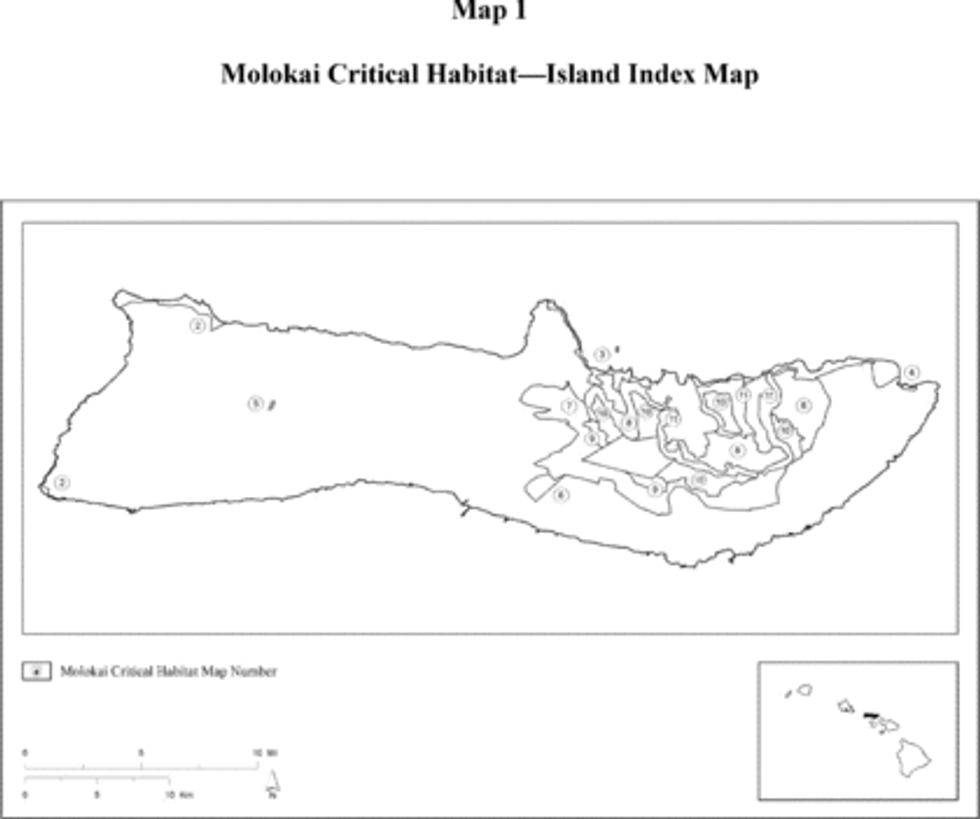
(2) Molokai - Coastal - Unit 1 (125 ac, 50 ha) and Molokai - Coastal - Unit 2 (977 ac, 396 ha).
(i) These units are critical habitat for Bidens wiebkei, Brighamia rockii, Canavalia molokaiensis, Hibiscus arnottianus ssp. immaculatus, Hibiscus brackenridgei, Ischaemum byrone, Marsilea villosa, Peucedanum sandwicense, Pittosporum halophilum, Schenkia sebaeoides, Sesbania tomentosa, and Tetramolopium rockii.
(ii) Map of Molokai - Coastal - Unit 1 and Molokai - Coastal - Unit 2 (Map 2) follows:
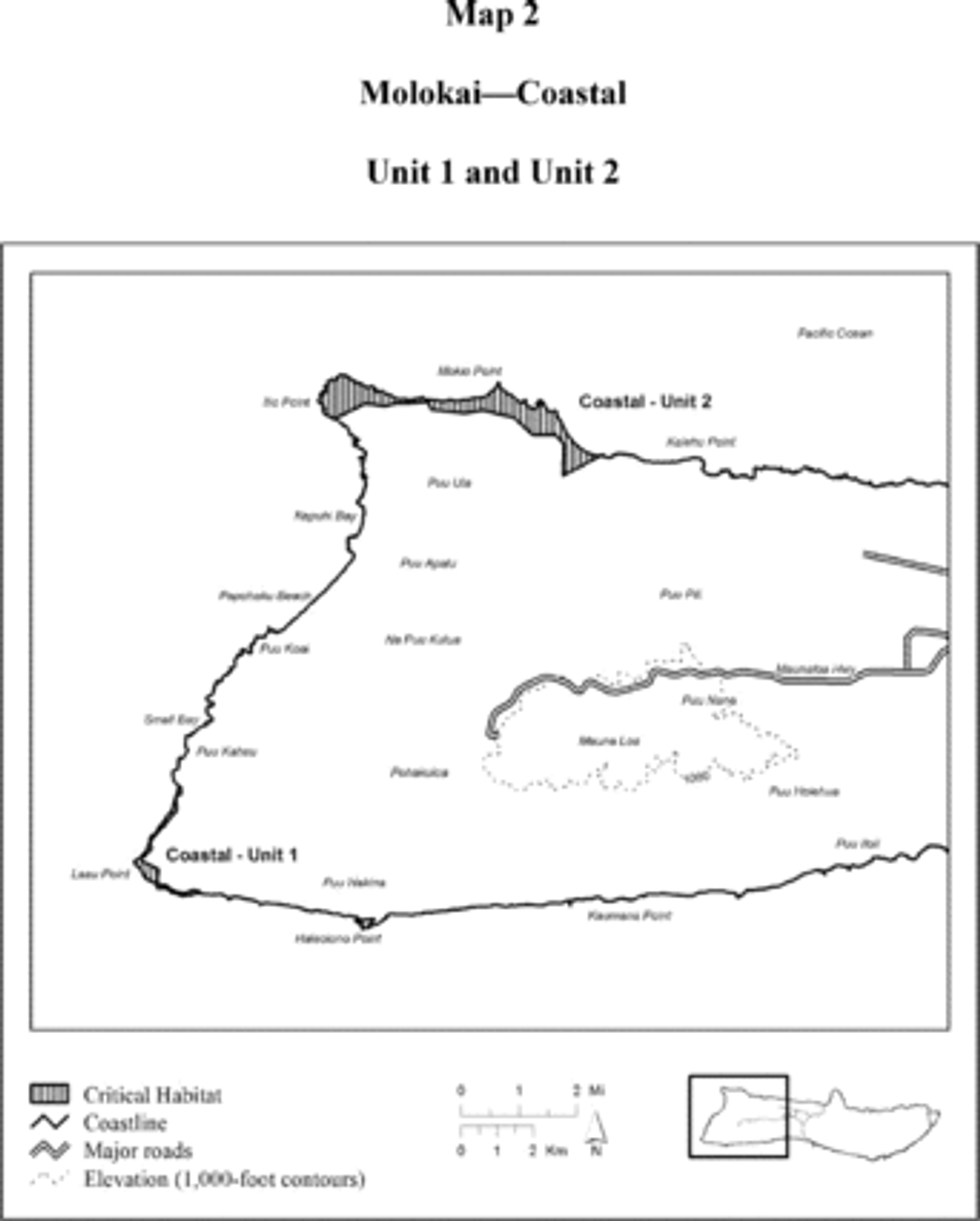
(3) Molokai - Coastal - Unit 3 (805 ac, 325 ha), Molokai - Coastal - Unit 4 (10 ac, 4 ha), and Molokai - Coastal - Unit 5 (1 ac, 0.5 ha).
(i) These units are critical habitat for Bidens wiebkei, Brighamia rockii, Canavalia molokaiensis, Hibiscus arnottianus ssp. immaculatus, Hibiscus brackenridgei, Ischaemum byrone, Marsilea villosa, Peucedanum sandwicense, Pittosporum halophilum, Schenkia sebaeoides, Sesbania tomentosa, and Tetramolopium rockii.
(ii) Map of Molokai - Coastal - Unit 3, Molokai - Coastal - Unit 4, and Molokai - Coastal - Unit 5 (Map 3) follows:
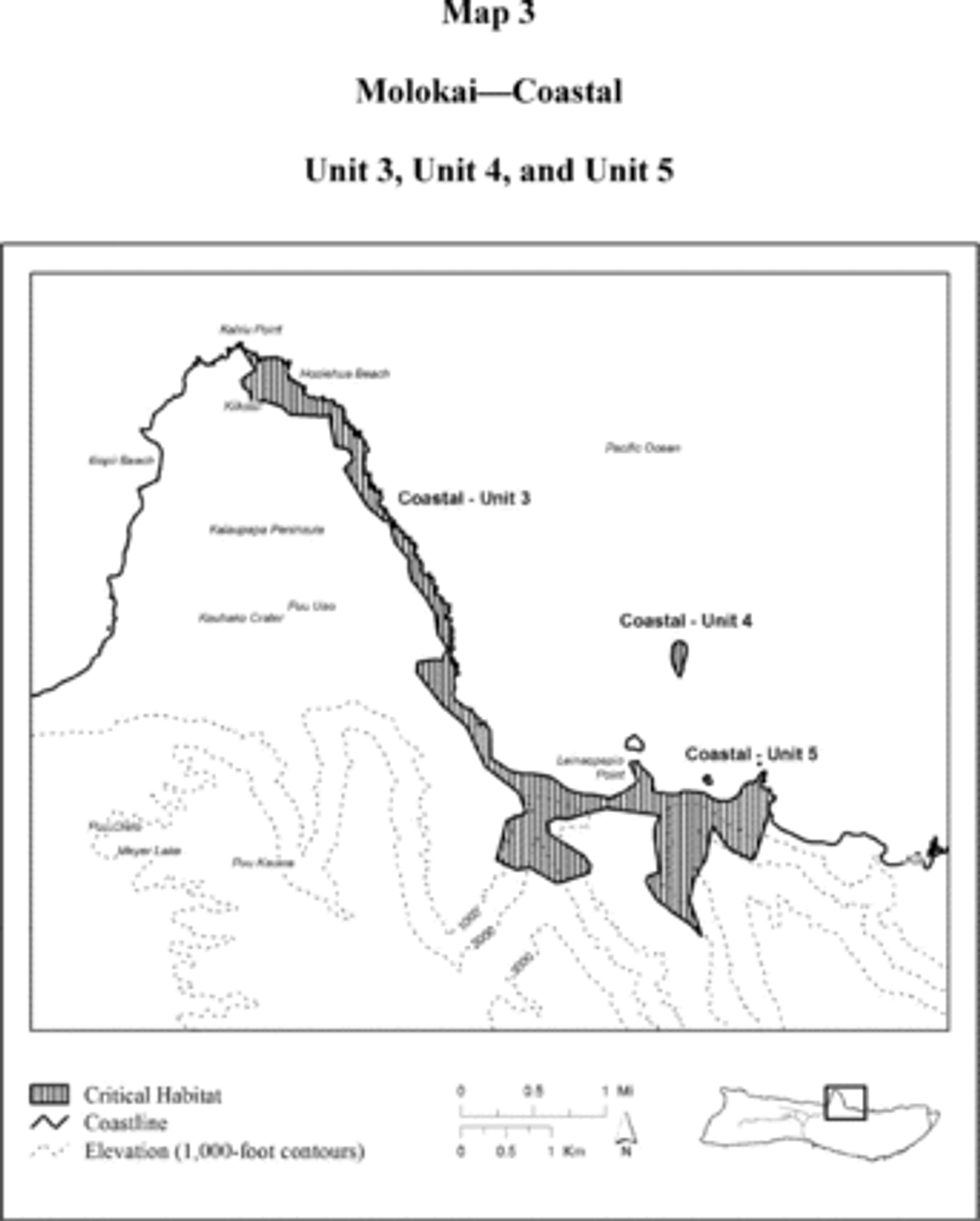
(4) Molokai - Coastal - Unit 6 (1,884 ac, 762 ha) and Molokai - Coastal - Unit 7 (49 ac, 24 ha).
(i) These units are critical habitat for Bidens wiebkei, Brighamia rockii, Canavalia molokaiensis, Hibiscus arnottianus ssp. immaculatus, Hibiscus brackenridgei, Ischaemum byrone, Marsilea villosa, Peucedanum sandwicense, Pittosporum halophilum, Schenkia sebaeoides, Sesbania tomentosa, and Tetramolopium rockii.
(ii) Map of Molokai - Coastal - Unit 6 and Molokai - Coastal - Unit 7 (Map 4) follows:
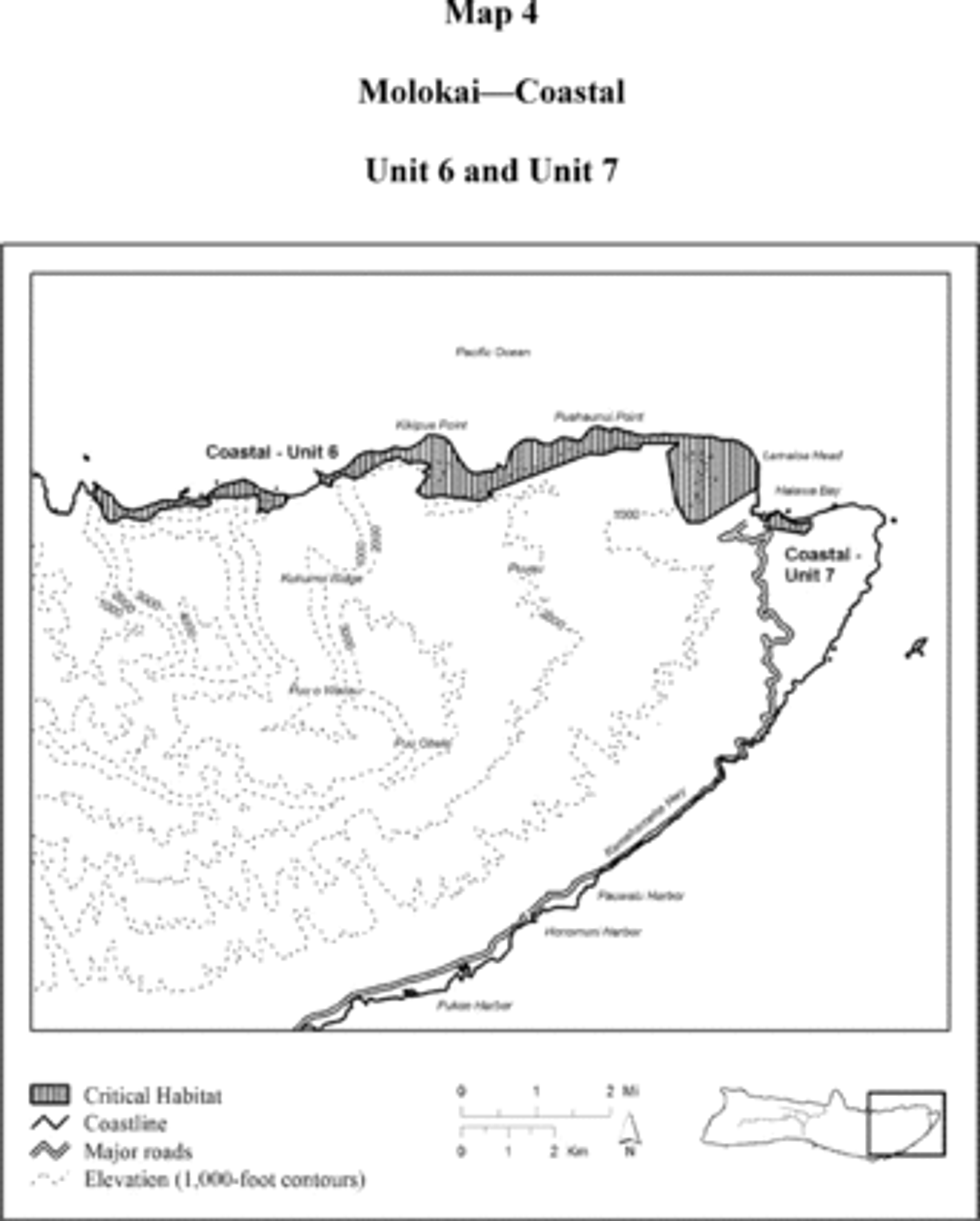
(5) Molokai - Lowland Dry - Unit 1 (24 ac, 10 ha).
(i) This unit is critical habitat for Bonamia menziesii, Cyperus trachysanthos, Eugenia koolauensis, Hibiscus brackenridgei, Kokia cookei, and Sesbania tomentosa.
(ii) Map of Molokai - Lowland Dry - Unit 1 (Map 5) follows:

(6) Molokai - Lowland Dry - Unit 2 (589 ac, 238 ha)
(i) This unit is critical habitat for Bonamia menziesii, Cyperus trachysanthos, Eugenia koolauensis, Hibiscus brackenridgei, Kokia cookei, and Sesbania tomentosa.
(ii) Map of Molokai - Lowland Dry - Unit 2 (Map 6) follows:

(7) Molokai - Lowland Mesic - Unit 1 (8,770 ac, 3,549 ha).
(i) This unit is critical habitat for Alectryon macrococcus, Asplenium dielerectum, Bonamia menziesii, Canavalia molokaiensis, Clermontia oblongifolia ssp. brevipes, Ctenitis squamigera, Cyanea dunbariae, Cyanea mannii, Cyanea procera, Cyanea profuga, Cyanea solanacea, Cyperus fauriei, Cyrtandra filipes, Diplazium molokaiense, Festuca molokaiensis, Flueggea neowawraea, Gouania hillebrandii, Isodendrion pyrifolium, Kadua laxiflora, Labordia triflora, Melicope mucronulata, Melicope munroi, Melicope reflexa, Neraudia sericea, Phyllostegia haliakalae, Phyllostegia mannii, Phyllostegia pilosa, Santalum haleakalae var. lanaiense, Schiedea lydgatei, Schiedea sarmentosa, Sesbania tomentosa, Silene alexandri, Silene lanceolata, Spermolepis hawaiiensis, Stenogyne bifida, Vigna o-wahuensis, and Zanthoxylum hawaiiense.
(ii) Map of Molokai - Lowland Mesic - Unit 1 (Map 7) follows:
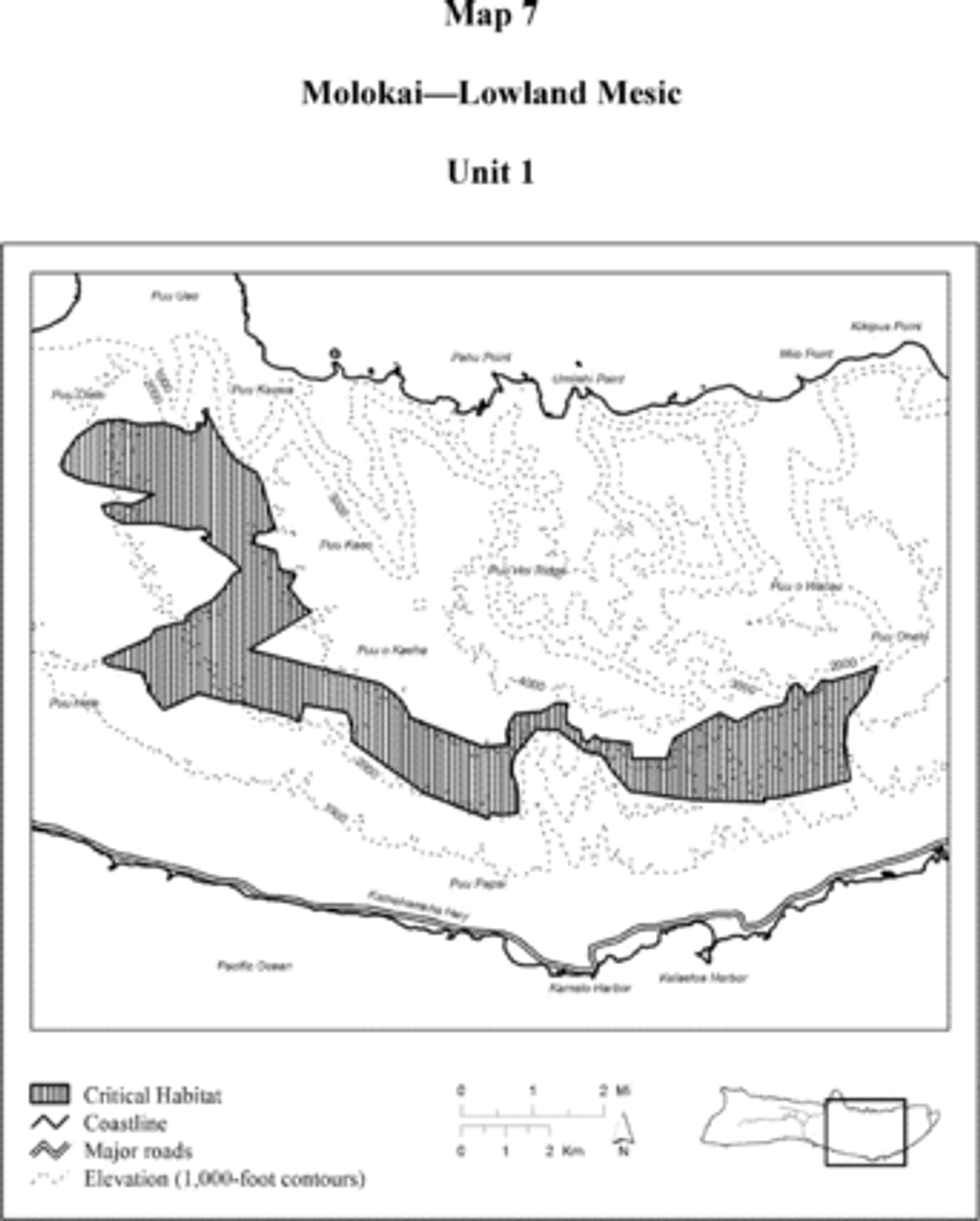
(8) Molokai - Lowland Wet - Unit 1 (2,949 ac, 1,193 ha), Molokai - Lowland Wet - Unit 2 (1,950 ac, 789 ha), and Molokai - Lowland Wet - Unit 3 (3,219 ac, 1,303 ha).
(i) These units are critical habitat for Asplenium dielerectum, Bidens wiebkei, Canavalia molokaiensis, Clermontia oblongifolia ssp. brevipes, Cyanea dunbariae, Cyanea grimesiana ssp. grimesiana, Cyanea solanacea, Cyrtandra filipes, Lysimachia maxima, Melicope reflexa, Peucedanum sandwicense, Phyllostegia hispida, Phyllostegia mannii, Plantago princeps, Stenogyne bifida, and Zanthoxylum hawaiiense.
(ii) Map of Molokai - Lowland Wet - Unit 1, Molokai - Lowland Wet - Unit 2, and Molokai - Lowland Wet - Unit 3 (Map 8) follows
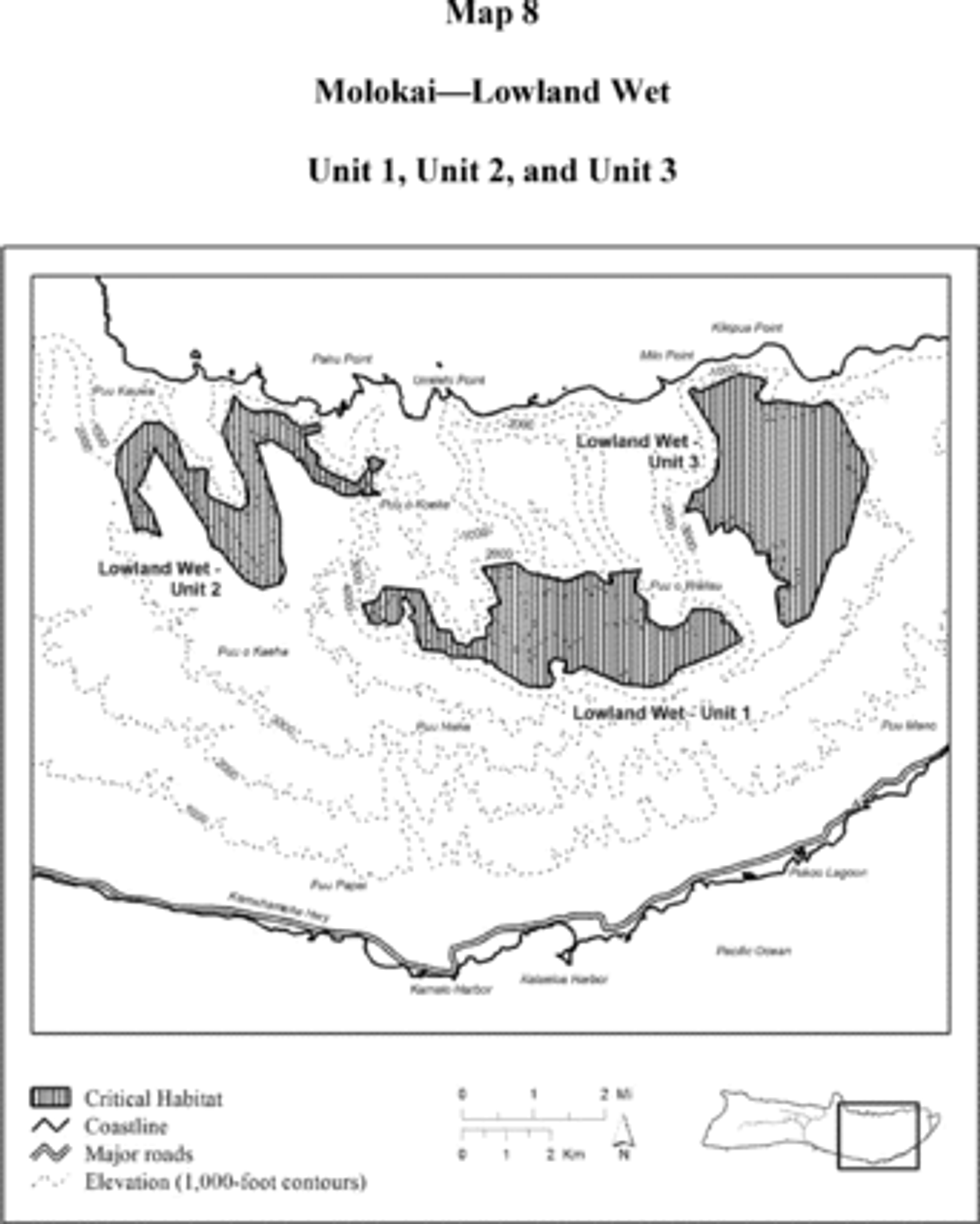
(9) Molokai - Montane Wet - Unit 1 (3,397 ac, 1,375 ha), Molokai - Montane Wet - Unit 2 (910 ac, 368 ha), and Molokai - Montane Wet - Unit 3 (803 ac, 325 ha).
(i) These units are critical habitat for Adenophorus periens, Bidens wiebkei, Clermontia oblongifolia ssp. brevipes, Cyanea mannii, Cyanea procera, Cyanea profuga, Cyanea solanacea, Hesperomannia arborescens, Lysimachia maxima, Melicope reflexa, Phyllostegia hispida, Phyllostegia mannii, Phyllostegia pilosa, Platanthera holochila, Pteris lidgatei, Schiedea laui, Stenogyne bifida, and Zanthoxylum hawaiiense.
(ii) Map of Molokai - Montane Wet - Unit 1, Molokai - Montane Wet - Unit 2, and Molokai - Montane Wet - Unit 3 (Map 9) follows:
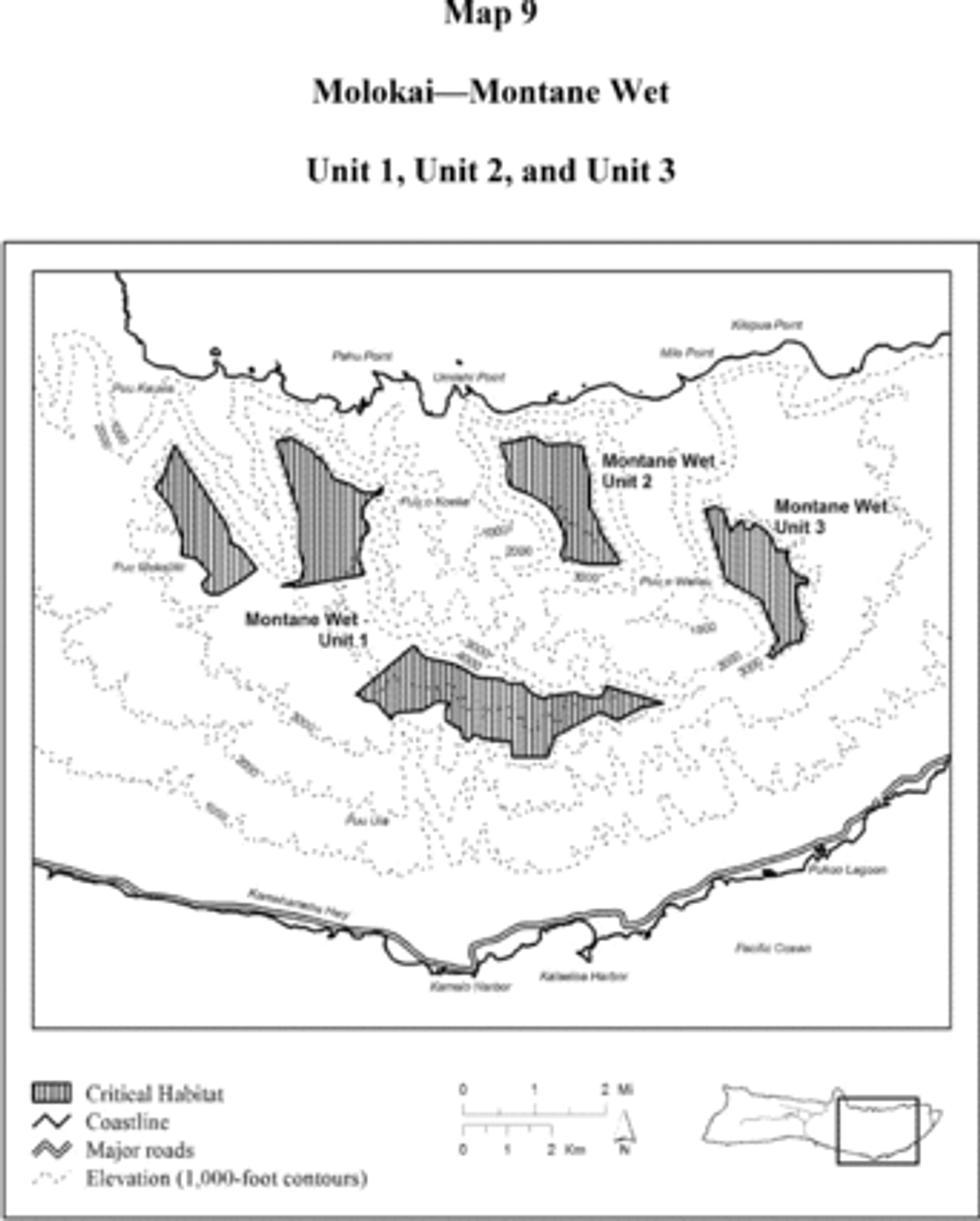
(10) Molokai - Montane Mesic - Unit 1 (816 ac, 330 ha).
(i) This unit is critical habitat for Alectryon macrococcus, Asplenium dielerectum, Bidens wiebkei, Cyanea dunbariae, Cyanea mannii, Cyanea procera, Cyanea solanacea, Cyperus fauriei, Kadua laxiflora, Melicope mucronulata, Neraudia sericea, Plantago princeps, Santalum haleakalae var. lanaiense, Spermolepis hawaiiensis, and Stenogyne bifida.
(ii) Map of Molokai-Montane Mesic - Unit 1 (Map 10) follows:
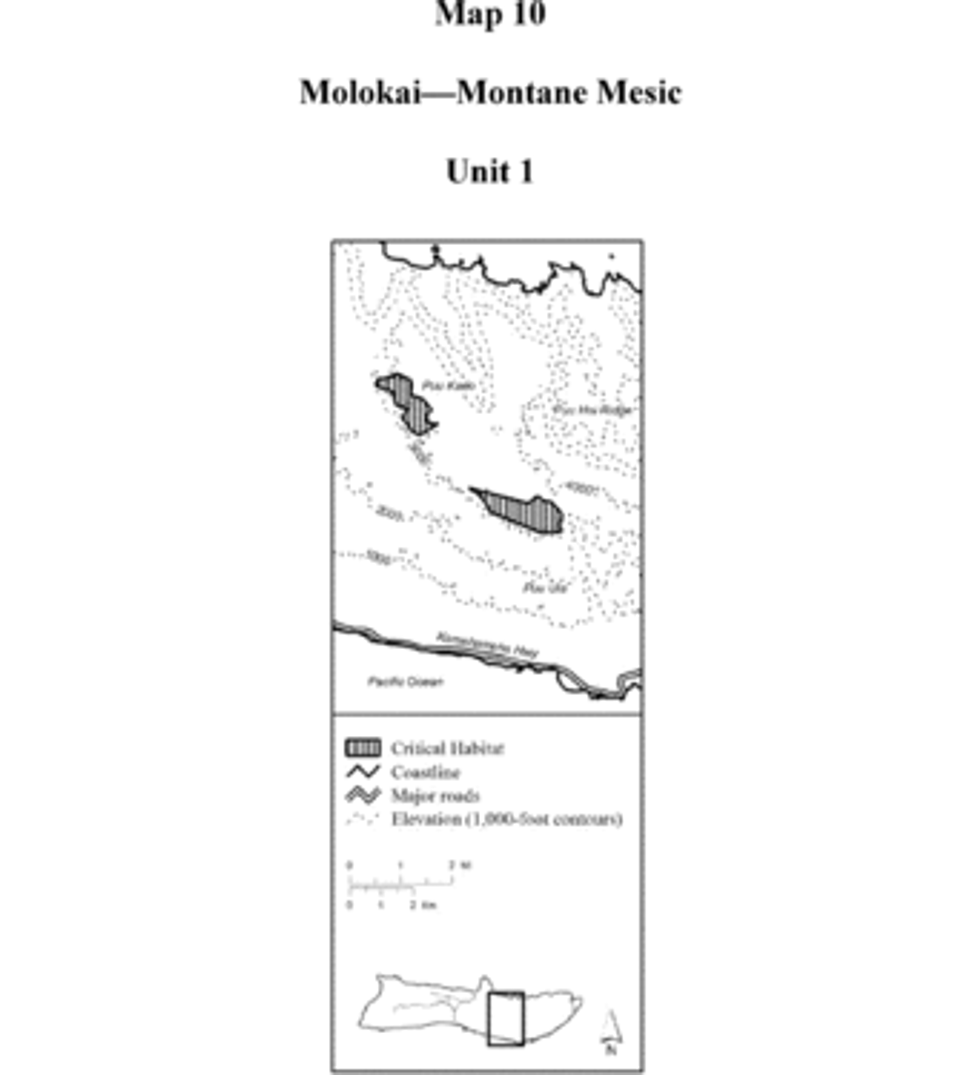
(11) Molokai - Wet Cliff - Unit 1 (1,607 ac, 651 ha), Molokai - Wet Cliff - Unit 2 (1,268 ac, 513 ha), and Molokai - Wet Cliff - Unit 3 (1,362 ac, 551 ha).
(i) This unit is critical habitat for Brighamia rockii, Canavalia molokaiensis, Clermontia oblongifolia ssp. brevipes, Cyanea grimesiana ssp. grimesiana, Cyanea munroi, Hesperomannia arborescens, Hibiscus arnottianus ssp. immaculatus, Phyllostegia hispida, Pteris lidgatei, and Stenogyne bifida.
(ii) Map of Molokai - Wet Cliff - Unit 1, Molokai - Wet Cliff - Unit 2, and Molokai - Wet Cliff - Unit 3 (Map 11) follows:
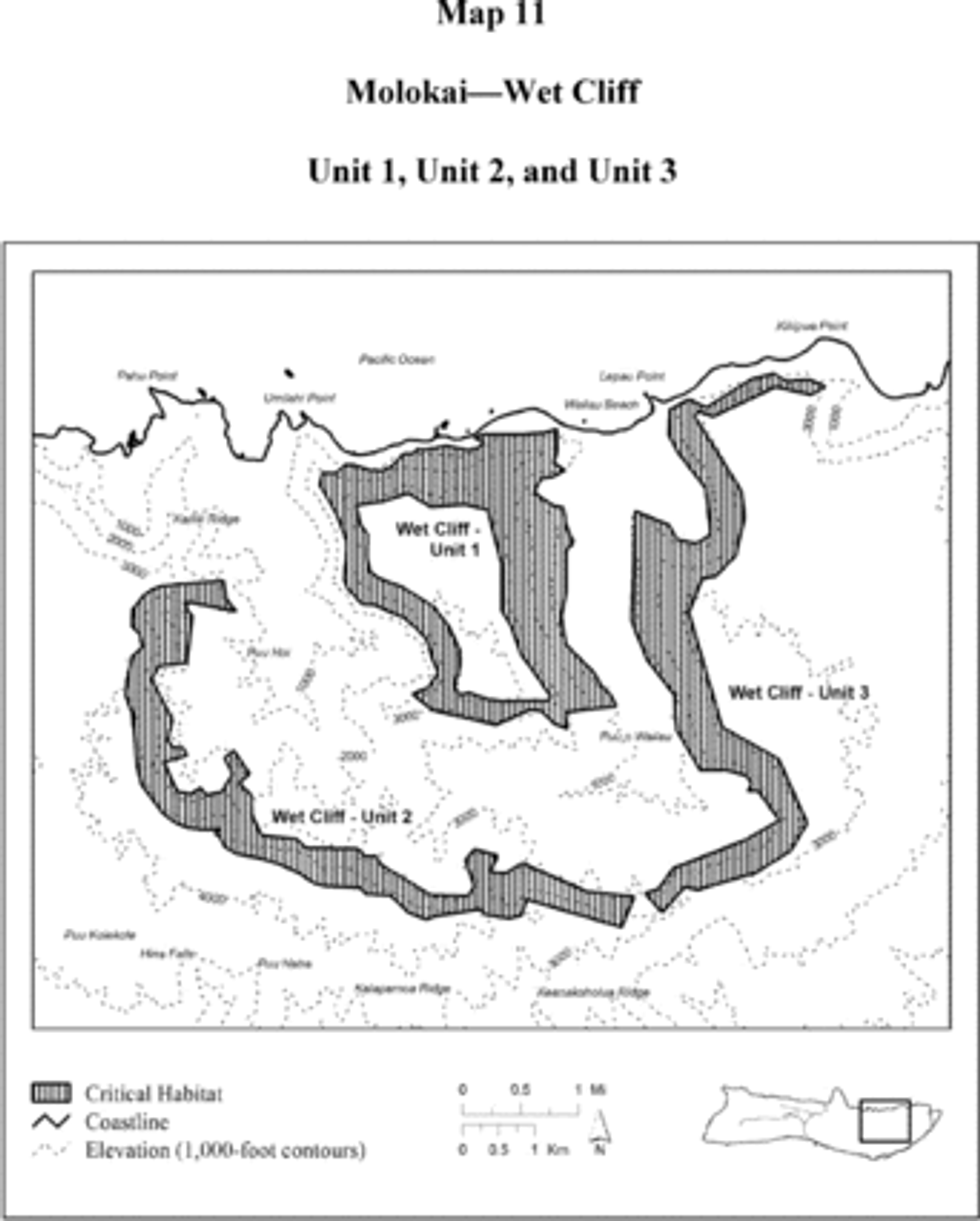
| Unit | Species occupied | Species unoccupied |
|---|---|---|
| Molokai - Coastal - Unit 1 | Bidens wiebkei. | |
| Brighamia rockii. | ||
| Canavalia molokaiensis. | ||
| Hibiscus arnottianus ssp. immaculatus. | ||
| Hibiscus brackenridgei. | ||
| Ischaemum byrone. | ||
| Marsilea villosa | ||
| Peucedanum sandwicense. | ||
| Pittosporum halophilum. | ||
| Schenkia sebaeoides. | ||
| Sesbania tomentosa. | ||
| Tetramolopium rockii. | ||
| Molokai-Coastal - Unit 2 | Bidens wiebkei. | |
| Brighamia rockii. | ||
| Canavalia molokaiensis. | ||
| Hibiscus arnottianus ssp. immaculatus. | ||
| Hibiscus brackenridgei. | ||
| Ischaemum byrone. | ||
| Marsilea villosa | ||
| Peucedanum sandwicense. | ||
| Pittosporum halophilum. | ||
| Schenkia sebaeoides. | ||
| Sesbania tomentosa. | ||
| Tetramolopium rockii. | ||
| Molokai - Coastal - Unit 3 | Bidens wiebkei. | |
| Brighamia rockii. | ||
| Canavalia molokaiensis. | ||
| Hibiscus arnottianus ssp. immaculatus. | ||
| Hibiscus brackenridgei. | ||
| Ischaemum byrone. | ||
| Marsilea villosa. | ||
| Peucedanum sandwicense. | ||
| Pittosporum halophilum | ||
| Schenkia sebaeoides | ||
| Sesbania tomentosa. | ||
| Tetramolopium rockii | ||
| Molokai - Coastal - Unit 4 | Bidens wiebkei. | |
| Brighamia rockii. | ||
| Canavalia molokaiensis. | ||
| Hibiscus arnottianus ssp. immaculatus. | ||
| Hibiscus brackenridgei. | ||
| Ischaemum byrone. | ||
| Marsilea villosa. | ||
| Peucedanum sandwicense | ||
| Pittosporum halophilum | ||
| Schenkia sebaeoides. | ||
| Sesbania tomentosa. | ||
| Tetramolopium rockii. | ||
| Molokai - Coastal - Unit 5 | Bidens wiebkei. | |
| Brighamia rockii | ||
| Canavalia molokaiensis. | ||
| Hibiscus arnottianus ssp. immaculatus. | ||
| Hibiscus brackenridgei. | ||
| Ischaemum byrone. | ||
| Marsilea villosa. | ||
| Peucedanum sandwicense | ||
| Pittosporum halophilum | ||
| Schenkia sebaeoides. | ||
| Sesbania tomentosa. | ||
| Tetramolopium rockii. | ||
| Molokai - Coastal - Unit 6 | Bidens wiebkei | |
| Brighamia rockii. | ||
| Canavalia molokaiensis | ||
| Hibiscus arnottianus ssp. immaculatus | ||
| Hibiscus brackenridgei. | ||
| Ischaemum byrone | ||
| Marsilea villosa. | ||
| Peucedanum sandwicense. | ||
| Pittosporum halophilum. | ||
| Schenkia sebaeoides. | ||
| Sesbania tomentosa. | ||
| Tetramolopium rockii. | ||
| Molokai - Coastal - Unit 7 | Bidens wiebkei. | |
| Brighamia rockii. | ||
| Canavalia molokaiensis. | ||
| Hibiscus arnottianus ssp. immaculatus. | ||
| Hibiscus brackenridgei. | ||
| Ischaemum byrone. | ||
| Marsilea villosa. | ||
| Peucedanum sandwicense. | ||
| Pittosporum halophilum. | ||
| Schenkia sebaeoides. | ||
| Sesbania tomentosa. | ||
| Tetramolopium rockii. | ||
| Molokai - Lowland Dry - Unit 1 | Bonamia menziesii. | |
| Cyperus trachysanthos. | ||
| Eugenia koolauensis. | ||
| Hibiscus brackenridgei. | ||
| Kokia cookei. | ||
| Sesbania tomentosa. | ||
| Molokai - Lowland Dry - Unit 2 | Bonamia menziesii. | |
| Cyperus trachysanthos. | ||
| Eugenia koolauensis. | ||
| Hibiscus brackenridgei. | ||
| Kokia cookei. | ||
| Sesbania tomentosa. | ||
| Molokai - Lowland Mesic - Unit 1 | Alectryon macrococcus | |
| Asplenium dielerectum. | ||
| Bonamia menziesii. | ||
| Canavalia molokaiensis. | ||
| Clermontia oblongifolia ssp. brevipes. | ||
| Ctenitis squamigera | ||
| Cyanea dunbariae | ||
| Cyanea mannii | ||
| Cyanea procera. | ||
| Cyanea profuga | ||
| Cyanea solanacea. | ||
| Cyperus fauriei | ||
| Cyrtandra filipes | ||
| Diplazium molokaiense. | ||
| Festuca molokaiensis. | ||
| Flueggea neowawraea. | ||
| Gouania hillebrandii | ||
| Isodendrion pyrifolium. | ||
| Kadua laxiflora. | ||
| Labordia triflora | ||
| Melicope mucronulata. | ||
| Melicope munroi. | ||
| Melicope reflexa. | ||
| Neraudia sericea | ||
| Phyllostegia haliakalae. | ||
| Phyllostegia mannii. | ||
| Phyllostegia pilosa. | ||
| Santalum haleakalae var. lanaiense | ||
| Schiedea lydgatei | ||
| Schiedea sarmentosa | ||
| Sesbania tomentosa. | ||
| Silene alexandri | ||
| Silene lanceolata | ||
| Spermolepis hawaiiensis | ||
| Stenogyne bifida. | ||
| Vigna o-wahuensis. | ||
| Zanthoxylum hawaiiense | ||
| Molokai - Lowland Wet - Unit 1 | Asplenium dielerectum. | |
| Bidens wiebkei. | ||
| Canavalia molokaiensis. | ||
| Clermontia oblongifolia ssp. brevipes. | ||
| Cyanea dunbariae. | ||
| Cyanea grimesiana ssp. grimesiana. | ||
| Cyanea solanacea. | ||
| Cyrtandra filipes | ||
| Lysimachia maxima. | ||
| Melicope reflexa. | ||
| Peucedanum sandwicense. | ||
| Phyllostegia hispida. | ||
| Phyllostegia mannii. | ||
| Plantago princeps. | ||
| Stenogyne bifida. | ||
| Zanthoxylum hawaiiense. | ||
| Molokai - Lowland Wet - Unit 2 | Asplenium dielerectum. | |
| Bidens wiebkei. | ||
| Canavalia molokaiensis. | ||
| Clermontia oblongifolia ssp. brevipes. | ||
| Cyanea dunbariae. | ||
| Cyanea grimesiana ssp. grimesiana. | ||
| Cyanea solanacea. | ||
| Cyrtandra filipes. | ||
| Lysimachia maxima | ||
| Melicope reflexa. | ||
| Peucedanum sandwicense. | ||
| Phyllostegia hispida. | ||
| Phyllostegia mannii. | ||
| Plantago princeps. | ||
| Stenogyne bifida. | ||
| Zanthoxylum hawaiiense. | ||
| Molokai - Lowland Wet - Unit 3 | Asplenium dielerectum. | |
| Bidens wiebkei. | ||
| Canavalia molokaiensis. | ||
| Clermontia oblongifolia ssp. brevipes. | ||
| Cyanea dunbariae. | ||
| Cyanea grimesiana ssp. grimesiana. | ||
| Cyanea solanacea. | ||
| Cyrtandra filipes. | ||
| Lysimachia maxima. | ||
| Melicope reflexa. | ||
| Peucedanum sandwicense. | ||
| Phyllostegia hispida. | ||
| Phyllostegia mannii. | ||
| Plantago princeps. | ||
| Stenogyne bifida. | ||
| Zanthoxylum hawaiiense. | ||
| Molokai - Montane Wet - Unit 1 | Adenophorus periens | |
| Bidens wiebkei | ||
| Clermontia oblongifolia ssp. brevipes | ||
| Cyanea mannii | ||
| Cyanea procera. | ||
| Cyanea profuga | ||
| Cyanea solanacea. | ||
| Hesperomannia arborescens. | ||
| Lysimachia maxima. | ||
| Melicope reflexa. | ||
| Phyllostegia hispida | ||
| Phyllostegia mannii. | ||
| Phyllostegia pilosa. | ||
| Platanthera holochila. | ||
| Pteris lidgatei | ||
| Schiedea laui. | ||
| Stenogyne bifida. | ||
| Zanthoxylum hawaiiense. | ||
| Molokai - Montane Wet - Unit 2 | Adenophorus periens. | |
| Bidens wiebkei. | ||
| Clermontia oblongifolia ssp. brevipes. | ||
| Cyanea mannii. | ||
| Cyanea procera. | ||
| Cyanea profuga. | ||
| Cyanea solanacea. | ||
| Hesperomannia arborescens. | ||
| Lysimachia maxima. | ||
| Melicope reflexa. | ||
| Phyllostegia hispida. | ||
| Phyllostegia mannii. | ||
| Phyllostegia pilosa. | ||
| Platanthera holochila. | ||
| Pteris lidgatei. | ||
| Schiedea laui. | ||
| Stenogyne bifida. | ||
| Zanthoxylum hawaiiense. | ||
| Molokai - Montane Wet - Unit 3 | Adenophorus periens. | |
| Bidens wiebkei. | ||
| Clermontia oblongifolia ssp. brevipes. | ||
| Cyanea mannii. | ||
| Cyanea procera. | ||
| Cyanea profuga. | ||
| Cyanea solanacea. | ||
| Hesperomannia arborescens. | ||
| Lysimachia maxima. | ||
| Melicope reflexa | ||
| Phyllostegia hispida. | ||
| Phyllostegia mannii. | ||
| Phyllostegia pilosa. | ||
| Platanthera holochila. | ||
| Pteris lidgatei. | ||
| Schiedea laui. | ||
| Stenogyne bifida. | ||
| Zanthoxylum hawaiiense. | ||
| Molokai - Montane Mesic - Unit 1 | Alectryon macrococcus | |
| Asplenium dielerectum. | ||
| Bidens wiebkei | ||
| Cyanea dunbariae. | ||
| Cyanea mannii. | ||
| Cyanea procera. | ||
| Cyanea solanacea. | ||
| Cyperus fauriei. | ||
| Kadua laxiflora. | ||
| Melicope mucronulata. | ||
| Neraudia sericea. | ||
| Plantago princeps. | ||
| Santalum haleakalae var. lanaiense | ||
| Spermolepis hawaiiensis | ||
| Stenogyne bifida. | ||
| Molokai - Wet Cliff - Unit 1 | Brighamia rockii | |
| Canavalia molokaiensis | ||
| Clermontia oblongifolia ssp. brevipes | ||
| Cyanea grimesiana ssp. grimesiana. | ||
| Cyanea munroi | ||
| Hesperomannia arborescens. | ||
| Hibiscus arnottianus ssp. immaculatus | ||
| Phyllostegia hispida. | ||
| Pteris lidgatei. | ||
| Stenogyne bifida. | ||
| Molokai - Wet Cliff - Unit 2 | Brighamia rockii. | |
| Canavalia molokaiensis. | ||
| Clermontia oblongifolia ssp. brevipes | ||
| Cyanea grimesiana ssp. grimesiana. | ||
| Cyanea munroi. | ||
| Hesperomannia arborescens. | ||
| Hibiscus arnottianus ssp. immaculatus. | ||
| Phyllostegia hispida | ||
| Pteris lidgatei. | ||
| Stenogyne bifida. | ||
| Molokai - Wet Cliff - Unit 3 | Brighamia rockii. | |
| Canavalia molokaiensis. | ||
| Clermontia oblongifolia ssp. brevipes. | ||
| Cyanea grimesiana ssp. grimesiana. | ||
| Cyanea munroi. | ||
| Hesperomannia arborescens. | ||
| Hibiscus arnottianus ssp. immaculatus. | ||
| Phyllostegia hispida. | ||
| Pteris lidgatei. | ||
| Stenogyne bifida. |
(d) Plants on Molokai; Constituent elements.
(1) Flowering plants.
Family Apiaceae
Peucedanum sandwicense (MAKOU)
Molokai - Coastal - Unit 1, Molokai - Coastal - Unit 2, Molokai - Coastal - Unit 3, Molokai - Coastal - Unit 4, Molokai - Coastal - Unit 5, Molokai - Coastal - Unit 6, Molokai - Coastal - Unit 7, Molokai - Lowland Wet - Unit 1, Molokai - Lowland Wet - Unit 2, and Molokai - Lowland Wet - Unit 3, identified in the legal descriptions in paragraph (c) of this section, constitute critical habitat for Peucedanum sandwicense on Molokai.
(i) In units Molokai - Coastal - Unit 1, Molokai - Coastal - Unit 2, Molokai - Coastal - Unit 3, Molokai - Coastal - Unit 4, Molokai - Coastal - Unit 5, Molokai - Coastal - Unit 6, and Molokai - Coastal - Unit 7, the physical and biological features of critical habitat are:
(A) Elevation: Less than 980 ft (300 m).
(B) Annual precipitation: Less than 20 in (50 cm).
(C) Substrate: Well-drained, calcareous, talus slopes; dunes; weathered clay soils; ephemeral pools; mudflats.
(D) Canopy: Hibiscus, Myoporum, Santalum, Scaevola.
(E) Subcanopy: Gossypium, Sida, Vitex.
(F) Understory: Eragrostis, Jacquemontia, Lyceum, Nama, Sesuvium, Sporobolus, Vigna.
(ii) In units Molokai - Lowland Wet - Unit 1, Molokai - Lowland Wet - Unit 2, and Molokai - Lowland Wet - Unit 3, the physical and biological features of critical habitat are:
(A) Elevation: Less than 3,300 ft (1,000 m).
(B) Annual precipitation: Greater than 75 in (190 cm).
(C) Substrate: Clays; ashbeds; deep, well-drained soils; lowland bogs.
(D) Canopy: Antidesma, Metrosideros, Myrsine, Pisonia, Psychotria.
(E) Subcanopy: Cibotium, Claoxylon, Kadua, Melicope.
(F) Understory: Alyxia, Cyrtandra, Dicranopteris, Diplazium, Machaerina, Microlepia.
Spermolepis hawaiiensis (NCN)
Molokai - Lowland Mesic - Unit 1 and Molokai - Montane Mesic - Unit 1, identified in the legal descriptions in paragraph (c) of this section, constitute critical habitat for Spermolepis hawaiiensis on Molokai.
(i) In unit Molokai - Lowland Mesic - Unit 1, the physical and biological features of critical habitat are:
(A) Elevation: Less than 3,300 ft (1,000 m).
(B) Annual precipitation: 50 to 75 in (130 to 190 cm).
(C) Substrate: Shallow soils, little to no herbaceous layer.
(D) Canopy: Acacia, Diospyros, Metrosideros, Myrsine, Pouteria, Santalum.
(E) Subcanopy: Dodonaea, Freycinetia, Leptecophylla, Melanthera, Osteomeles, Pleomele, Psydrax.
(F) Understory: Carex, Dicranopteris, Diplazium, Elaphoglossum, Peperomia.
(ii) In unit Molokai - Montane Mesic - Unit 1, the physical and biological features of critical habitat are:
(A) Elevation: 3,300 to 6,500 ft (1,000 to 2,000 m).
(B) Annual precipitation: 50 to 75 in (130 to 190 cm).
(C) Substrate: Deep ash deposits, thin silty loams.
(D) Canopy: Acacia, Ilex, Metrosideros, Myrsine, Nestegis, Nothocestrum, Pisonia, Pittosporum, Psychotria, Sophora, Zanthoxylum.
(E) Subcanopy: Alyxia, Charpentiera, Coprosma, Dodonaea, Kadua, Labordia, Leptecophylla, Phyllostegia, Vaccinium.
(F) Understory: Ferns, Carex, Peperomia.
Family Asteraceae
Bidens wiebkei (KOOKOOLAU)
Molokai - Coastal - Unit 1, Molokai - Coastal - Unit 2, Molokai - Coastal - Unit 3, Molokai - Coastal - Unit 4, Molokai - Coastal - Unit 5, Molokai - Coastal - Unit 6, Molokai - Coastal - Unit 7, Molokai - Lowland Wet - Unit 1, Molokai - Lowland Wet - Unit 2, Molokai - Lowland Wet - Unit 3, Molokai - Montane Wet - Unit 1, Molokai - Montane Wet - Unit 2, Molokai - Montane Wet - Unit 3, and Molokai - Montane Mesic - Unit 1, identified in the legal descriptions in paragraph (c) of this section, constitute critical habitat for Bidens wiebkei on Molokai.
(i) In units Molokai - Coastal - Unit 1, Molokai - Coastal - Unit 2, Molokai - Coastal - Unit 3, Molokai - Coastal - Unit 4, Molokai - Coastal - Unit 5, Molokai - Coastal - Unit 6, and Molokai - Coastal - Unit 7, the physical and biological features of critical habitat are:
(A) Elevation: Less than 980 ft (300 m).
(B) Annual precipitation: Less than 20 in (50 cm).
(C) Substrate: Well-drained, calcareous, talus slopes; dunes; weathered clay soils; ephemeral pools; mudflats.
(D) Canopy: Hibiscus, Myoporum, Santalum, Scaevola.
(E) Subcanopy: Gossypium, Sida, Vitex.
(F) Understory: Eragrostis, Jacquemontia, Lyceum, Nama, Sesuvium, Sporobolus, Vigna.
(ii) In units Molokai - Lowland Wet - Unit 1, Molokai - Lowland Wet - Unit 2, and Molokai - Lowland Wet - Unit 3, the physical and biological features of critical habitat are:
(A) Elevation: Less than 3,300 ft (1,000 m).
(B) Annual precipitation: Greater than 75 in (190 cm).
(C) Substrate: Clays; ashbeds; deep, well-drained soils; lowland bogs.
(D) Canopy: Antidesma, Metrosideros, Myrsine, Pisonia, Psychotria.
(E) Subcanopy: Cibotium, Claoxylon, Kadua, Melicope.
(F) Understory: Alyxia, Cyrtandra, Dicranopteris, Diplazium, Machaerina, Microlepia.
(iii) In units Molokai - Montane Wet - Unit 1, Molokai - Montane Wet - Unit 2, and Molokai - Montane Wet - Unit 3, the physical and biological features of critical habitat are:
(A) Elevation: 3,300 to 6,500 ft (1,000 to 2,000 m).
(B) Annual precipitation: Greater than 75 in (190 cm).
(C) Substrate: Well-developed soils, montane bogs.
(D) Canopy: Acacia, Charpentiera, Cheirodendron, Metrosideros.
(E) Subcanopy: Broussaisia, Cibotium, Eurya, Ilex, Myrsine.
(F) Understory: Ferns, Carex, Coprosma, Leptecophylla, Oreobolus, Rhynchospora, Vaccinium.
(iv) In unit Molokai - Montane Mesic - Unit 1, the physical and biological features of critical habitat are:
(A) Elevation: 3,300 to 6,500 ft (1,000 to 2,000 m).
(B) Annual precipitation: 50 to 75 in (130 to 190 cm).
(C) Substrate: Deep ash deposits, thin silty loams.
(D) Canopy: Acacia, Ilex, Metrosideros, Myrsine, Nestegis, Nothocestrum, Pisonia, Pittosporum, Psychotria, Sophora, Zanthoxylum.
(E) Subcanopy: Alyxia, Charpentiera, Coprosma, Dodonaea, Kadua, Labordia, Leptecophylla, Phyllostegia, Vaccinium.
(F) Understory: Ferns, Carex, Peperomia.
Hesperomannia arborescens (NCN)
Molokai - Montane Wet - Unit 1, Molokai - Montane Wet - Unit 2, Molokai - Montane Wet - Unit 3, Molokai - Wet Cliff - Unit 1, Molokai - Wet Cliff - Unit 2, and Molokai - Wet Cliff - Unit 3, identified in the legal descriptions in paragraph (c) of this section, constitute critical habitat for Hesperomannia arborescens on Molokai.
(i) In units Molokai - Montane Wet - Unit 1, Molokai - Montane Wet - Unit 2, and Molokai - Montane Wet - Unit 3, the physical and biological features of critical habitat are:
(A) Elevation: 3,300 to 6,500 ft (1,000 to 2,000 m).
(B) Annual precipitation: Greater than 75 in (190 cm).
(C) Substrate: Well-developed soils, montane bogs.
(D) Canopy: Acacia, Charpentiera, Cheirodendron, Metrosideros.
(E) Subcanopy: Broussaisia, Cibotium, Eurya, Ilex, Myrsine.
(F) Understory: Ferns, Carex, Coprosma, Leptecophylla, Oreobolus, Rhynchospora, Vaccinium.
(ii) In units Molokai - Wet Cliff - Unit 1, Molokai - Wet Cliff - Unit 2, and Molokai - Wet Cliff - Unit 3, the physical and biological features of critical habitat are:
(A) Elevation: Unrestricted.
(B) Annual precipitation: Greater than 75 in (190 cm).
(C) Substrate: Greater than 65 degree slope, shallow soils, weathered lava.
(D) Canopy: None.
(E) Subcanopy: Broussaisia, Cheirodendron, Leptecophylla, Metrosideros.
(F) Understory: Bryophytes, ferns, Coprosma, Dubautia, Kadua, Peperomia.
Tetramolopium rockii (NCN)
Molokai - Coastal - Unit 1, Molokai - Coastal - Unit 2, Molokai - Coastal - Unit 3, Molokai - Coastal - Unit 4, Molokai - Coastal - Unit 5, Molokai - Coastal - Unit 6, and Molokai - Coastal - Unit 7, identified in the legal descriptions in paragraph (c) of this section, constitute critical habitat for Tetramolopium rockii on Molokai. In units Molokai - Coastal - Unit 1, Molokai - Coastal - Unit 2, Molokai - Coastal - Unit 3, Molokai - Coastal - Unit 4, Molokai - Coastal - Unit 5, Molokai - Coastal - Unit 6, and Molokai - Coastal - Unit 7, the physical and biological features of critical habitat are:
(i) Elevation: Less than 980 ft (300 m).
(ii) Annual precipitation: Less than 20 in (50 cm).
(iii) Substrate: Well-drained, calcareous, talus slopes; dunes; weathered clay soils; ephemeral pools; mudflats.
(iv) Canopy: Hibiscus, Myoporum, Santalum, Scaevola.
(v) Subcanopy: Gossypium, Sida, Vitex.
(vi) Understory: Eragrostis, Jacquemontia, Lyceum, Nama, Sesuvium, Sporobolus, Vigna.
Family Campanulaceae
Brighamia rockii (PUA ALA)
Molokai - Coastal - Unit 1, Molokai - Coastal - Unit 2, Molokai - Coastal - Unit 3, Molokai - Coastal - Unit 4, Molokai - Coastal - Unit 5, Molokai - Coastal - Unit 6, Molokai - Coastal - Unit 7, Molokai - Wet Cliff - Unit 1, Molokai - Wet Cliff - Unit 2, and Molokai - Wet Cliff - Unit 3, identified in the legal descriptions in paragraph (c) of this section, constitute critical habitat for Brighamia rockii on Molokai.
(i) In units Molokai - Coastal - Unit 1, Molokai - Coastal - Unit 2, Molokai - Coastal - Unit 3, Molokai - Coastal - Unit 4, Molokai - Coastal - Unit 5, Molokai - Coastal - Unit 6, and Molokai - Coastal - Unit 7, the physical and biological features of critical habitat are:
(A) Elevation: Less than 980 ft (300 m).
(B) Annual precipitation: Less than 20 in (50 cm).
(C) Substrate: Well-drained, calcareous, talus slopes; dunes; weathered clay soils; ephemeral pools; mudflats.
(D) Canopy: Hibiscus, Myoporum, Santalum, Scaevola.
(E) Subcanopy: Gossypium, Sida, Vitex.
(F) Understory: Eragrostis, Jacquemontia, Lyceum, Nama, Sesuvium, Sporobolus, Vigna.
(ii) In units Molokai - Wet Cliff - Unit 1, Molokai - Wet Cliff - Unit 2, and Molokai - Wet Cliff - Unit 3, the physical and biological features of critical habitat are:
(A) Elevation: Unrestricted.
(B) Annual precipitation: Greater than 75 in (190 cm).
(C) Substrate: Greater than 65 degree slope, shallow soils, weathered lava.
(D) Canopy: None.
(E) Subcanopy: Broussaisia, Cheirodendron, Leptecophylla, Metrosideros.
(F) Understory: Bryophytes, ferns, Coprosma, Dubautia, Kadua, Peperomia.
Clermontia oblongifolia ssp. brevipes (OHA WAI)
Molokai - Lowland Mesic - Unit 1, Molokai - Lowland Wet - Unit 1, Molokai - Lowland Wet - Unit 2, Molokai - Lowland Wet - Unit 3, Molokai - Montane Wet - Unit 1, Molokai - Montane Wet - Unit 2, Molokai - Montane Wet - Unit 3, Molokai - Wet Cliff - Unit 1, Molokai - Wet Cliff - Unit 2, and Molokai - Wet Cliff - Unit 3, identified in the legal descriptions in paragraph (c) of this section, constitute critical habitat for Clermontia oblongifolia ssp. brevipes on Molokai.
(i) In unit Molokai - Lowland Mesic - Unit 1, the physical and biological features of critical habitat are:
(A) Elevation: Less than 3,300 ft (1,000 m).
(B) Annual precipitation: 50 to 75 in (130 to 190 cm).
(C) Substrate: Shallow soils, little to no herbaceous layer.
(D) Canopy: Acacia, Diospyros, Metrosideros, Myrsine, Pouteria, Santalum.
(E) Subcanopy: Dodonaea, Freycinetia, Leptecophylla, Melanthera, Osteomeles, Pleomele, Psydrax.
(F) Understory: Carex, Dicranopteris, Diplazium, Elaphoglossum, Peperomia.
(ii) In units Molokai - Lowland Wet - Unit 1, Molokai - Lowland Wet - Unit 2, and Molokai - Lowland Wet - Unit 3, the physical and biological features of critical habitat are:
(A) Elevation: Less than 3,300 ft (1,000 m).
(B) Annual precipitation: Greater than 75 in (190 cm).
(C) Substrate: Clays; ashbeds; deep, well-drained soils; lowland bogs.
(D) Canopy: Antidesma, Metrosideros, Myrsine, Pisonia, Psychotria.
(E) Subcanopy: Cibotium, Claoxylon, Kadua, Melicope.
(F) Understory: Alyxia, Cyrtandra, Dicranopteris, Diplazium, Machaerina, Microlepia.
(iii) In units Molokai - Montane Wet - Unit 1, Molokai - Montane Wet - Unit 2, and Molokai - Montane Wet - Unit 3, the physical and biological features of critical habitat are:
(A) Elevation: 3,300 to 6,500 ft (1,000 to 2,000 m).
(B) Annual precipitation: Greater than 75 in (190 cm).
(C) Substrate: Well-developed soils, montane bogs.
(D) Canopy: Acacia, Charpentiera, Cheirodendron, Metrosideros.
(E) Subcanopy: Broussaisia, Cibotium, Eurya, Ilex, Myrsine.
(F) Understory: Ferns, Carex, Coprosma, Leptecophylla, Oreobolus, Rhynchospora, Vaccinium.
(iv) In units Molokai - Wet Cliff - Unit 1, Molokai - Wet Cliff - Unit 2, and Molokai - Wet Cliff - Unit 3, the physical and biological features of critical habitat are:
(A) Elevation: Unrestricted.
(B) Annual precipitation: Greater than 75 in (190 cm).
(C) Substrate: Greater than 65 degree slope, shallow soils, weathered lava.
(D) Canopy: None.
(E) Subcanopy: Broussaisia, Cheirodendron, Leptecophylla, Metrosideros.
(F) Understory: Bryophytes, ferns, Coprosma, Dubautia, Kadua, Peperomia.
Cyanea dunbariae (HAHA)
Molokai - Lowland Mesic - Unit 1, Molokai - Lowland Wet - Unit 1, Molokai - Lowland Wet - Unit 2, Molokai - Lowland Wet - Unit 3, and Molokai - Montane Mesic - Unit 1, identified in the legal descriptions in paragraph (c) of this section, constitute critical habitat for Cyanea dunbariae on Molokai.
(i) In unit Molokai - Lowland Mesic - Unit 1, the physical and biological features of critical habitat are:
(A) Elevation: Less than 3,300 ft (1,000 m).
(B) Annual precipitation: 50 to 75 in (130 to 190 cm).
(C) Substrate: Shallow soils, little to no herbaceous layer.
(D) Canopy: Acacia, Diospyros, Metrosideros, Myrsine, Pouteria, Santalum.
(E) Subcanopy: Dodonaea, Freycinetia, Leptecophylla, Melanthera, Osteomeles, Pleomele, Psydrax.
(F) Understory: Carex, Dicranopteris, Diplazium, Elaphoglossum, Peperomia.
(ii) In units Molokai - Lowland Wet - Unit 1, Molokai - Lowland Wet - Unit 2, and Molokai - Lowland Wet - Unit 3, the physical and biological features of critical habitat are:
(A) Elevation: Less than 3,300 ft (1,000 m).
(B) Annual precipitation: Greater than 75 in (190 cm).
(C) Substrate: Clays; ashbeds; deep, well-drained soils; lowland bogs.
(D) Canopy: Antidesma, Metrosideros, Myrsine, Pisonia, Psychotria.
(E) Subcanopy: Cibotium, Claoxylon, Kadua, Melicope.
(F) Understory: Alyxia, Cyrtandra, Dicranopteris, Diplazium, Machaerina, Microlepia.
(iii) In unit Molokai - Montane Mesic - Unit 1, the physical and biological features of critical habitat are:
(A) Elevation: 3,300 to 6,500 ft (1,000 to 2,000 m).
(B) Annual precipitation: 50 to 75 in (130 to 190 cm).
(C) Substrate: Deep ash deposits, thin silty loams.
(D) Canopy: Acacia, Ilex, Metrosideros, Myrsine, Nestegis, Nothocestrum, Pisonia, Pittosporum, Psychotria, Sophora, Zanthoxylum.
(E) Subcanopy: Alyxia, Charpentiera, Coprosma, Dodonaea, Kadua, Labordia, Leptecophylla, Phyllostegia, Vaccinium.
(F) Understory: Ferns, Carex, Peperomia.
Cyanea grimesiana ssp. grimesiana (HAHA)
Molokai - Lowland Wet - Unit 1, Molokai - Lowland Wet - Unit 2, Molokai - Lowland Wet - Unit 3, Molokai - Wet Cliff - Unit 1, Molokai - Wet Cliff - Unit 2, and Molokai - Wet Cliff - Unit 3, identified in the legal descriptions in paragraph (c) of this section, constitute critical habitat for Cyanea grimesiana ssp. grimesiana on Molokai.
(i) In units Molokai - Lowland Wet - Unit 1, Molokai - Lowland Wet - Unit 2, and Molokai - Lowland Wet - Unit 3, the physical and biological features of critical habitat are:
(A) Elevation: Less than 3,300 ft (1,000 m).
(B) Annual precipitation: Greater than 75 in (190 cm).
(C) Substrate: Clays; ashbeds; deep, well-drained soils; lowland bogs.
(D) Canopy: Antidesma, Metrosideros, Myrsine, Pisonia, Psychotria.
(E) Subcanopy: Cibotium, Claoxylon, Kadua, Melicope.
(F) Understory: Alyxia, Cyrtandra, Dicranopteris, Diplazium, Machaerina, Microlepia.
(ii) In units Molokai - Wet Cliff - Unit 1, Molokai - Wet Cliff - Unit 2, and Molokai - Wet Cliff - Unit 3, the physical and biological features of critical habitat are:
(A) Elevation: Unrestricted.
(B) Annual precipitation: Greater than 75 in (190 cm).
(C) Substrate: Greater than 65 degree slope, shallow soils, weathered lava.
(D) Canopy: None.
(E) Subcanopy: Broussaisia, Cheirodendron, Leptecophylla, Metrosideros.
(F) Understory: Bryophytes, ferns, Coprosma, Dubautia, Kadua, Peperomia.
Cyanea mannii (HAHA)
Molokai - Lowland Mesic - Unit 1, Molokai - Montane Wet - Unit 1, Molokai - Montane Wet - Unit 2, Molokai - Montane Wet - Unit 3, and Molokai - Montane Mesic - Unit 1, identified in the legal descriptions in paragraph (c) of this section, constitute critical habitat for Cyanea mannii on Molokai.
(i) In unit Molokai - Lowland Mesic - Unit 1, the physical and biological features of critical habitat are:
(A) Elevation: Less than 3,300 ft (1,000 m).
(B) Annual precipitation: 50 to 75 in (130 to 190 cm).
(C) Substrate: Shallow soils, little to no herbaceous layer.
(D) Canopy: Acacia, Diospyros, Metrosideros, Myrsine, Pouteria, Santalum.
(E) Subcanopy: Dodonaea, Freycinetia, Leptecophylla, Melanthera, Osteomeles, Pleomele, Psydrax.
(F) Understory: Carex, Dicranopteris, Diplazium, Elaphoglossum, Peperomia.
(ii) In units Molokai - Montane Wet - Unit 1, Molokai - Montane Wet - Unit 2, and Molokai - Montane Wet - Unit 3, the physical and biological features of critical habitat are:
(A) Elevation: 3,300 to 6,500 ft (1,000 to 2,000 m).
(B) Annual precipitation: Greater than 75 in (190 cm).
(C) Substrate: Well-developed soils, montane bogs.
(D) Canopy: Acacia, Charpentiera, Cheirodendron, Metrosideros.
(E) Subcanopy: Broussaisia, Cibotium, Eurya, Ilex, Myrsine.
(F) Understory: Ferns, Carex, Coprosma, Leptecophylla, Oreobolus, Rhynchospora, Vaccinium.
(iii) In unit Molokai - Montane Mesic - Unit 1, the physical and biological features of critical habitat are:
(A) Elevation: 3,300 to 6,500 ft (1,000 to 2,000 m).
(B) Annual precipitation: 50 to 75 in (130 to 190 cm).
(C) Substrate: Deep ash deposits, thin silty loams.
(D) Canopy: Acacia, Ilex, Metrosideros, Myrsine, Nestegis, Nothocestrum, Pisonia, Pittosporum, Psychotria, Sophora, Zanthoxylum.
(E) Subcanopy: Alyxia, Charpentiera, Coprosma, Dodonaea, Kadua, Labordia, Leptecophylla, Phyllostegia, Vaccinium.
(F) Understory: Ferns, Carex, Peperomia.
Cyanea munroi (HAHA)
Molokai - Wet Cliff - Unit 1, Molokai - Wet Cliff - Unit 2, and Molokai - Wet Cliff - Unit 3, identified in the legal descriptions in paragraph (c) of this section, constitute critical habitat for Cyanea munroi on Molokai. In units Molokai - Wet Cliff - Unit 1, Molokai - Wet Cliff - Unit 2, and Molokai - Wet Cliff - Unit 3, the physical and biological features of critical habitat are:
(i) Elevation: Unrestricted.
(ii) Annual precipitation: Greater than 75 in (190 cm).
(iii) Substrate: Greater than 65 degree slope, shallow soils, weathered lava.
(iv) Canopy: None.
(v) Subcanopy: Broussaisia, Cheirodendron, Leptecophylla, Metrosideros.
(vi) Understory: Bryophytes, ferns, Coprosma, Dubautia, Kadua, Peperomia.
Cyanea procera (HAHA)
Molokai - Lowland Mesic - Unit 1, Molokai - Montane Wet - Unit 1, Molokai - Montane Wet - Unit 2, Molokai - Montane Wet - Unit 3, and Molokai - Montane Mesic - Unit 1, identified in the legal descriptions in paragraph (c) of this section, constitute critical habitat for Cyanea procera on Molokai.
(i) In unit Molokai - Lowland Mesic - Unit 1, the physical and biological features of critical habitat are:
(A) Elevation: Less than 3,300 ft (1,000 m).
(B) Annual precipitation: 50 to 75 in (130 to 190 cm).
(C) Substrate: Shallow soils, little to no herbaceous layer.
(D) Canopy: Acacia, Diospyros, Metrosideros, Myrsine, Pouteria, Santalum.
(E) Subcanopy: Dodonaea, Freycinetia, Leptecophylla, Melanthera, Osteomeles, Pleomele, Psydrax.
(F) Understory: Carex, Dicranopteris, Diplazium, Elaphoglossum, Peperomia.
(ii) In units Molokai - Montane Wet - Unit 1, Molokai - Montane Wet - Unit 2, and Molokai - Montane Wet - Unit 3, the physical and biological features of critical habitat are:
(A) Elevation: 3,300 to 6,500 ft (1,000 to 2,000 m).
(B) Annual precipitation: Greater than 75 in (190 cm).
(C) Substrate: Well-developed soils, montane bogs.
(D) Canopy: Acacia, Charpentiera, Cheirodendron, Metrosideros.
(E) Subcanopy: Broussaisia, Cibotium, Eurya, Ilex, Myrsine.
(F) Understory: Ferns, Carex, Coprosma, Leptecophylla, Oreobolus, Rhynchospora, Vaccinium.
(iii) In unit Molokai - Montane Mesic - Unit 1, the physical and biological features of critical habitat are:
(A) Elevation: 3,300 to 6,500 ft (1,000 to 2,000 m).
(B) Annual precipitation: 50 to 75 in (130 to 190 cm).
(C) Substrate: Deep ash deposits, thin silty loams.
(D) Canopy: Acacia, Ilex, Metrosideros, Myrsine, Nestegis, Nothocestrum, Pisonia, Pittosporum, Psychotria, Sophora, Zanthoxylum.
(E) Subcanopy: Alyxia, Charpentiera, Coprosma, Dodonaea, Kadua, Labordia, Leptecophylla, Phyllostegia, Vaccinium.
(F) Understory: Fern, Carex, Peperomia.
Cyanea profuga (HAHA)
Molokai - Lowland Mesic - Unit 1, Molokai - Montane Wet - Unit 1, Molokai - Montane Wet - Unit 2, and Molokai - Montane Wet - Unit 3, identified in the legal descriptions in paragraph (c) of this section, constitute critical habitat for Cyanea profuga on Molokai.
(i) In unit Molokai - Lowland Mesic - Unit 1, the physical and biological features of critical habitat are:
(A) Elevation: Less than 3,300 ft (1,000 m).
(B) Annual precipitation: 50 to 75 in (130 to 190 cm).
(C) Substrate: Shallow soils, little to no herbaceous layer.
(D) Canopy: Acacia, Diospyros, Metrosideros, Myrsine, Pouteria, Santalum.
(E) Subcanopy: Dodonaea, Freycinetia, Leptecophylla, Melanthera, Osteomeles, Pleomele, Psydrax.
(F) Understory: Carex, Dicranopteris, Diplazium, Elaphoglossum, Peperomia.
(ii) In units Molokai - Montane Wet - Unit 1, Molokai - Montane Wet - Unit 2, and Molokai - Montane Wet - Unit 3, the physical and biological features of critical habitat are:
(A) Elevation: 3,300 to 6,500 ft (1,000 to 2,000 m).
(B) Annual precipitation: Greater than 75 in (190 cm).
(C) Substrate: Well-developed soils, montane bogs.
(D) Canopy: Acacia, Charpentiera, Cheirodendron, Metrosideros.
(E) Subcanopy: Broussaisia, Cibotium, Eurya, Ilex, Myrsine.
(F) Understory: Ferns, Carex, Coprosma, Leptecophylla, Oreobolus, Rhynchospora, Vaccinium.
Cyanea solanacea (POPOLO, HAHA NUI)
Molokai - Lowland Mesic - Unit 1, Molokai - Lowland Wet - Unit 1, Molokai - Lowland Wet - Unit 2, Molokai - Lowland Wet - Unit 3, Molokai - Montane Wet - Unit 1, Molokai - Montane Wet - Unit 2, Molokai - Montane Wet - Unit 3, and Molokai - Montane Mesic - Unit 1, identified in the legal descriptions in paragraph (c) of this section, constitute critical habitat for Cyanea solanacea on Molokai.
(i) In unit Molokai - Lowland Mesic - Unit 1, the physical and biological features of critical habitat are:
(A) Elevation: Less than 3,300 ft (1,000 m).
(B) Annual precipitation: 50 to 75 in (130 to 190 cm).
(C) Substrate: Shallow soils, little to no herbaceous layer.
(D) Canopy: Acacia, Diospyros, Metrosideros, Myrsine, Pouteria, Santalum.
(E) Subcanopy: Dodonaea, Freycinetia, Leptecophylla, Melanthera, Osteomeles, Pleomele, Psydrax.
(F) Understory: Carex, Dicranopteris, Diplazium, Elaphoglossum, Peperomia.
(ii) In units Molokai - Lowland Wet - Unit 1, Molokai - Lowland Wet - Unit 2, and Molokai - Lowland Wet - Unit 3, the physical and biological features of critical habitat are:
(A) Elevation: Less than 3,300 ft (1,000 m).
(B) Annual precipitation: Greater than 75 in (190 cm).
(C) Substrate: Clays; ashbeds; deep, well-drained soils; lowland bogs.
(D) Canopy: Antidesma, Metrosideros, Myrsine, Pisonia, Psychotria.
(E) Subcanopy: Cibotium, Claoxylon, Kadua, Melicope.
(F) Understory: Alyxia, Cyrtandra, Dicranopteris, Diplazium, Machaerina, Microlepia.
(iii) In units Molokai - Montane Wet - Unit 1, Molokai - Montane Wet - Unit 2, and Molokai - Montane Wet - Unit 3, the physical and biological features of critical habitat are:
(A) Elevation: 3,300 to 6,500 ft (1,000 to 2,000 m).
(B) Annual precipitation: Greater than 75 in (190 cm).
(C) Substrate: Well-developed soils, montane bogs.
(D) Canopy: Acacia, Charpentiera, Cheirodendron, Metrosideros.
(E) Subcanopy: Broussaisia, Cibotium, Eurya, Ilex, Myrsine.
(F) Understory: Ferns, Carex, Coprosma, Leptecophylla, Oreobolus, Rhynchospora, Vaccinium.
(iv) In unit Molokai - Montane Mesic - Unit 1, the physical and biological features of critical habitat are:
(A) Elevation: 3,300 to 6,500 ft (1,000 to 2,000 m).
(B) Annual precipitation: 50 to 75 in (130 to 190 cm).
(C) Substrate: Deep ash deposits, thin silty loams.
(D) Canopy: Acacia, Ilex, Metrosideros, Myrsine, Nestegis, Nothocestrum, Pisonia, Pittosporum, Psychotria, Sophora, Zanthoxylum.
(E) Subcanopy: Alyxia, Charpentiera, Coprosma, Dodonaea, Kadua, Labordia, Leptecophylla, Phyllostegia, Vaccinium.
(F) Understory: Ferns, Carex, Peperomia.
Family Caryophyllaceae
Schiedea laui (NCN)
Molokai - Montane Wet - Unit 1, Molokai - Montane Wet - Unit 2, and Molokai - Montane Wet - Unit 3, identified in the legal descriptions in paragraph (c) of this section, constitute critical habitat for Schiedea laui on Molokai. In units Molokai - Montane Wet - Unit 1, Molokai - Montane Wet - Unit 2, and Molokai - Montane Wet - Unit 3, the physical and biological features of critical habitat are:
(i) Elevation: 3,300 to 6,500 ft (1,000 to 2,000 m).
(ii) Annual precipitation: Greater than 75 in (190 cm).
(iii) Substrate: Well-developed soils, montane bogs.
(iv) Canopy: Acacia, Charpentiera, Cheirodendron, Metrosideros.
(v) Subcanopy: Broussaisia, Cibotium, Eurya, Ilex, Myrsine.
(vi) Understory: Ferns, Carex, Coprosma, Leptecophylla, Oreobolus, Rhynchospora, Vaccinium.
Schiedea lydgatei (NCN)
Molokai - Lowland Mesic - Unit 1, identified in the legal descriptions in paragraph (c) of this section, constitutes critical habitat for Schiedea lydgatei on Molokai. In unit Molokai - Lowland Mesic - Unit 1, the physical and biological features of critical habitat are:
(i) Elevation: Less than 3,300 ft (1,000 m).
(ii) Annual precipitation: 50 to 75 in (130 to 190 cm).
(iii) Substrate: Shallow soils, little to no herbaceous layer.
(iv) Canopy: Acacia, Diospyros, Metrosideros, Myrsine, Pouteria, Santalum.
(v) Subcanopy: Dodonaea, Freycinetia, Leptecophylla, Melanthera, Osteomeles, Pleomele, Psydrax.
(vi) Understory: Carex, Dicranopteris, Diplazium, Elaphoglossum, Peperomia.
Schiedea sarmentosa (NCN)
Molokai - Lowland Mesic - Unit 1, identified in the legal descriptions in paragraph (c) of this section, constitutes critical habitat for Schiedea sarmentosa on Molokai. In unit Molokai - Lowland Mesic - Unit 1, the physical and biological features of critical habitat are:
(i) Elevation: Less than 3,300 ft (1,000 m).
(ii) Annual precipitation: 50 to 75 in (130 to 190 cm).
(iii) Substrate: Shallow soils, little to no herbaceous layer.
(iv) Canopy: Acacia, Diospyros, Metrosideros, Myrsine, Pouteria, Santalum.
(v) Subcanopy: Dodonaea, Freycinetia, Leptecophylla, Melanthera, Osteomeles, Pleomele, Psydrax.
(vi) Understory: Carex, Dicranopteris, Diplazium, Elaphoglossum, Peperomia.
Silene alexandri (NCN)
Molokai - Lowland Mesic - Unit 1, identified in the legal descriptions in paragraph (c) of this section, constitutes critical habitat for Silene alexandri on Molokai. In unit Molokai - Lowland Mesic - Unit 1, the physical and biological features of critical habitat are:
(i) Elevation: Less than 3,300 ft (1,000 m).
(ii) Annual precipitation: 50 to 75 in (130 to 190 cm).
(iii) Substrate: Shallow soils, little to no herbaceous layer.
(iv) Canopy: Acacia, Diospyros, Metrosideros, Myrsine, Pouteria, Santalum.
(v) Subcanopy: Dodonaea, Freycinetia, Leptecophylla, Melanthera, Osteomeles, Pleomele, Psydrax.
(vi) Understory: Carex, Dicranopteris, Diplazium, Elaphoglossum, Peperomia.
Silene lanceolata (NCN)
Molokai - Lowland Mesic - Unit 1, identified in the legal descriptions in paragraph (c) of this section, constitutes critical habitat for Silene lanceolata on Molokai. In unit Molokai - Lowland Mesic - Unit 1, the physical and biological features of critical habitat are:
(i) Elevation: Less than 3,300 ft (1,000 m).
(ii) Annual precipitation: 50 to 75 in (130 to 190 cm).
(iii) Substrate: Shallow soils, little to no herbaceous layer.
(iv) Canopy: Acacia, Diospyros, Metrosideros, Myrsine, Pouteria, Santalum.
(v) Subcanopy: Dodonaea, Freycinetia, Leptecophylla, Melanthera, Osteomeles, Pleomele, Psydrax.
(vi) Understory: Carex, Dicranopteris, Diplazium, Elaphoglossum, Peperomia.
Family Convolvulaceae
Bonamia menziesii (NCN)
Molokai - Lowland Dry - Unit 1, Molokai - Lowland Dry - Unit 2, and Molokai - Lowland Mesic - Unit 1, identified in the legal descriptions in paragraph (c) of this section, constitute critical habitat for Bonamia menziesii on Molokai.
(i) In units Molokai - Lowland Dry - Unit 1 and Molokai - Lowland Dry - Unit 2, the physical and biological features of critical habitat are:
(A) Elevation: Less than 3,300 ft (1,000 m).
(B) Annual precipitation: Less than 50 in (130 cm).
(C) Substrate: Weathered silty loams to stony clay, rocky ledges, little-weathered lava.
(D) Canopy: Diospyros, Myoporum, Pleomele, Santalum.
(E) Subcanopy: Chamaesyce, Dodonaea, Leptecophylla, Osteomeles, Psydrax, Scaevola, Wikstroemia.
(F) Understory: Alyxia, Artemisia, Bidens, Chenopodium, Nephrolepis, Peperomia, Sicyos.
(ii) In unit Molokai - Lowland Mesic - Unit 1, the physical and biological features of critical habitat are:
(A) Elevation: Less than 3,300 ft (1,000 m).
(B) Annual precipitation: 50 to 75 in (130 to 190 cm).
(C) Substrate: Shallow soils, little to no herbaceous layer.
(D) Canopy: Acacia, Diospyros, Metrosideros, Myrsine, Pouteria, Santalum.
(E) Subcanopy: Dodonaea, Freycinetia, Leptecophylla, Melanthera, Osteomeles, Pleomele, Psydrax.
(F) Understory: Carex, Dicranopteris, Diplazium, Elaphoglossum, Peperomia.
Family Cyperaceae
Cyperus fauriei (NCN)
Molokai - Lowland Mesic - Unit 1 and Molokai - Montane Mesic - Unit 1, identified in the legal descriptions in paragraph (c) of this section, constitute critical habitat for Cyperus fauriei on Molokai.
(i) In unit Molokai - Lowland Mesic - Unit 1, the physical and biological features of critical habitat are:
(A) Elevation: Less than 3,300 ft (1,000 m).
(B) Annual precipitation: 50 to 75 in (130 to 190 cm).
(C) Substrate: Shallow soils, little to no herbaceous layer.
(D) Canopy: Acacia, Diospyros, Metrosideros, Myrsine, Pouteria, Santalum.
(E) Subcanopy: Dodonaea, Freycinetia, Leptecophylla, Melanthera, Osteomeles, Pleomele, Psydrax.
(F) Understory: Carex, Dicranopteris, Diplazium, Elaphoglossum, Peperomia.
(ii) In unit Molokai - Montane Mesic - Unit 1, the physical and biological features of critical habitat are:
(A) Elevation: 3,300 to 6,500 ft (1,000 to 2,000 m).
(B) Annual precipitation: 50 to 75 in (130 to 190 cm).
(C) Substrate: Deep ash deposits, thin silty loams.
(D) Canopy: Acacia, Ilex, Metrosideros, Myrsine, Nestegis, Nothocestrum, Pisonia, Pittosporum, Psychotria, Sophora, Zanthoxylum.
(E) Subcanopy: Alyxia, Charpentiera, Coprosma, Dodonaea, Kadua, Labordia, Leptecophylla, Phyllostegia, Vaccinium.
(F) Understory: Ferns, Carex, Peperomia.
Cyperus trachysanthos (PUUKAA)
Molokai - Lowland Dry - Unit 1 and Molokai - Lowland Dry - Unit 2, identified in the legal descriptions in paragraph (c) of this section, constitute critical habitat for Cyperus trachysanthos on Molokai. In units Molokai - Lowland Dry - Unit 1 and Molokai - Lowland Dry - Unit 2, the physical and biological features of critical habitat are:
(i) Elevation: Less than 3,300 ft (1,000 m).
(ii) Annual precipitation: Less than 50 in (130 cm).
(iii) Substrate: Weathered silty loams to stony clay, rocky ledges, little-weathered lava.
(iv) Canopy: Diospyros, Myoporum, Pleomele, Santalum.
(v) Subcanopy: Chamaesyce, Dodonaea, Leptecophylla, Osteomeles, Psydrax, Scaevola, Wikstroemia.
(vi) Understory: Alyxia, Artemisia, Bidens, Chenopodium, Nephrolepis, Peperomia, Sicyos.
Family Euphorbiaceae
Flueggea neowawraea (MEHAMEHAME)
Molokai - Lowland Mesic - Unit 1, identified in the legal descriptions in paragraph (c) of this section, constitutes critical habitat for Flueggea neowawraea on Molokai. In unit Molokai - Lowland Mesic - Unit 1, the physical and biological features of critical habitat are:
(i) Elevation: Less than 3,300 ft (1,000 m).
(ii) Annual precipitation: 50 to 75 in (130 to 190 cm).
(iii) Substrate: Shallow soils, little to no herbaceous layer.
(iv) Canopy: Acacia, Diospyros, Metrosideros, Myrsine, Pouteria, Santalum.
(v) Subcanopy: Dodonaea, Freycinetia, Leptecophylla, Melanthera, Osteomeles, Pleomele, Psydrax.
(vi) Understory: Carex, Dicranopteris, Diplazium, Elaphoglossum, Peperomia.
Family Fabaceae
Canavalia molokaiensis (AWIKIWIKI)
Molokai - Coastal - Unit 1, Molokai - Coastal - Unit 2, Molokai - Coastal - Unit 3, Molokai - Coastal - Unit 4, Molokai - Coastal - Unit 5, Molokai - Coastal - Unit 6, Molokai - Coastal - Unit 7, Molokai - Lowland Mesic - Unit 1, Molokai - Lowland Wet - Unit 1, Molokai - Lowland Wet - Unit 2, Molokai - Lowland Wet - Unit 3, Molokai - Wet Cliff - Unit 1, Molokai - Wet Cliff - Unit 2, and Molokai - Wet Cliff - Unit 3, identified in the legal descriptions in paragraph (c) of this section, constitute critical habitat for Canavalia molokaiensis on Molokai.
(i) In units Molokai - Coastal - Unit 1, Molokai - Coastal - Unit 2, Molokai - Coastal - Unit 3, Molokai - Coastal - Unit 4, Molokai - Coastal - Unit 5, Molokai - Coastal - Unit 6, and Molokai - Coastal - Unit 7, the physical and biological features of critical habitat are:
(A) Elevation: Less than 980 ft (300 m).
(B) Annual precipitation: Less than 20 in (50 cm).
(C) Substrate: Well-drained, calcareous, talus slopes; dunes; weathered clay soils; ephemeral pools; mudflats.
(D) Canopy: Hibiscus, Myoporum, Santalum, Scaevola.
(E) Subcanopy: Gossypium, Sida, Vitex.
(F) Understory: Eragrostis, Jacquemontia, Lyceum, Nama, Sesuvium, Sporobolus, Vigna.
(ii) In unit Molokai - Lowland Mesic - Unit 1, the physical and biological features of critical habitat are:
(A) Elevation: Less than 3,300 ft (1,000 m).
(B) Annual precipitation: 50 to 75 in (130 to 190 cm).
(C) Substrate: Shallow soils, little to no herbaceous layer.
(D) Canopy: Acacia, Diospyros, Metrosideros, Myrsine, Pouteria, Santalum.
(E) Subcanopy: Dodonaea, Freycinetia, Leptecophylla, Melanthera, Osteomeles, Pleomele, Psydrax.
(F) Understory: Carex, Dicranopteris, Diplazium, Elaphoglossum, Peperomia.
(iii) In units Molokai - Lowland Wet - Unit 1, Molokai - Lowland Wet - Unit 2, and Molokai - Lowland Wet - Unit 3, the physical and biological features of critical habitat are:
(A) Elevation: Less than 3,300 ft (1,000 m).
(B) Annual precipitation: Greater than 75 in (190 cm).
(C) Substrate: Clays; ashbeds; deep, well-drained soils; lowland bogs.
(D) Canopy: Antidesma, Metrosideros, Myrsine, Pisonia, Psychotria.
(E) Subcanopy: Cibotium, Claoxylon, Kadua, Melicope.
(F) Understory: Alyxia, Cyrtandra, Dicranopteris, Diplazium, Machaerina, Microlepia.
(iv) In units Molokai - Wet Cliff - Unit 1, Molokai - Wet Cliff - Unit 2, and Molokai - Wet Cliff - Unit 3, the physical and biological features of critical habitat are:
(A) Elevation: Unrestricted.
(B) Annual precipitation: Greater than 75 in (190 cm).
(C) Substrate: Greater than 65 degree slope, shallow soils, weathered lava.
(D) Canopy: None.
(E) Subcanopy: Broussaisia, Cheirodendron, Leptecophylla, Metrosideros.
(F) Understory: Bryophytes, ferns, Coprosma, Dubautia, Kadua, Peperomia.
Sesbania tomentosa (OHAI)
Molokai - Coastal - Unit 1, Molokai - Coastal - Unit 2, Molokai - Coastal - Unit 3, Molokai - Coastal - Unit 4, Molokai - Coastal - Unit 5, Molokai - Coastal - Unit 6, Molokai - Coastal - Unit 7, Molokai - Lowland Dry - Unit 1, Molokai - Lowland Dry - Unit 2, and Molokai - Lowland Mesic - Unit 1, identified in the legal descriptions in paragraph (c) of this section, constitute critical habitat for Sesbania tomentosa on Molokai.
(i) In units Molokai - Coastal - Unit 1, Molokai - Coastal - Unit 2, Molokai - Coastal - Unit 3, Molokai - Coastal - Unit 4, Molokai - Coastal - Unit 5, Molokai - Coastal - Unit 6, and Molokai - Coastal - Unit 7, the physical and biological features of critical habitat are:
(A) Elevation: Less than 980 ft (300 m).
(B) Annual precipitation: Less than 20 in (50 cm).
(C) Substrate: Well-drained, calcareous, talus slopes; dunes; weathered clay soils; ephemeral pools; mudflats.
(D) Canopy: Hibiscus, Myoporum, Santalum, Scaevola.
(E) Subcanopy: Gossypium, Sida, Vitex.
(F) Understory: Eragrostis, Jacquemontia, Lyceum, Nama, Sesuvium, Sporobolus, Vigna.
(ii) In units Molokai - Lowland Dry - Unit 1 and Molokai - Lowland Dry - Unit 2, the physical and biological features of critical habitat are:
(A) Elevation: Less than 3,300 ft (1,000 m).
(B) Annual precipitation: Less than 50 in (130 cm).
(C) Substrate: Weathered silty loams to stony clay, rocky ledges, little-weathered lava.
(D) Canopy: Diospyros, Myoporum, Pleomele, Santalum.
(E) Subcanopy: Chamaesyce, Dodonaea, Leptecophylla, Osteomeles, Psydrax, Scaevola, Wikstroemia.
(F) Understory: Alyxia, Artemisia, Bidens, Chenopodium, Nephrolepis, Peperomia, Sicyos.
(iii) In unit Molokai - Lowland Mesic - Unit 1, the physical and biological features of critical habitat are:
(A) Elevation: Less than 3,300 ft (1,000 m).
(B) Annual precipitation: 50 to 75 in (130 to 190 cm).
(C) Substrate: Shallow soils, little to no herbaceous layer.
(D) Canopy: Acacia, Diospyros, Metrosideros, Myrsine, Pouteria, Santalum.
(E) Subcanopy: Dodonaea, Freycinetia, Leptecophylla, Melanthera, Osteomeles, Pleomele, Psydrax.
(F) Understory: Carex, Dicranopteris, Diplazium, Elaphoglossum, Peperomia.
Vigna o-wahuensis (NCN)
Molokai - Lowland Mesic - Unit 1, identified in the legal descriptions in paragraph (c) of this section, constitutes critical habitat for Vigna o-wahuensis on Molokai. In unit Molokai - Lowland Mesic - Unit 1, the physical and biological features of critical habitat are:
(i) Elevation: Less than 3,300 ft (1,000 m).
(ii) Annual precipitation: 50 to 75 in (130 to 190 cm).
(iii) Substrate: Shallow soils, little to no herbaceous layer.
(iv) Canopy: Acacia, Diospyros, Metrosideros, Myrsine, Pouteria, Santalum.
(v) Subcanopy: Dodonaea, Freycinetia, Leptecophylla, Melanthera, Osteomeles, Pleomele, Psydrax.
(vi) Understory: Carex, Dicranopteris, Diplazium, Elaphoglossum, Peperomia.
Family Gentianaceae
Schenkia sebaeoides (AWIWI)
Molokai - Coastal - Unit 1, Molokai - Coastal - Unit 2, Molokai - Coastal - Unit 3, Molokai - Coastal - Unit 4, Molokai - Coastal - Unit 5, Molokai - Coastal - Unit 6, and Molokai - Coastal - Unit 7, identified in the legal descriptions in paragraph (c) of this section, constitute critical habitat for Schenkia sebaeoides on Molokai. In units Molokai - Coastal - Unit 1, Molokai - Coastal - Unit 2, Molokai - Coastal - Unit 3, Molokai - Coastal - Unit 4, Molokai - Coastal - Unit 5, Molokai - Coastal - Unit 6, and Molokai - Coastal - Unit 7, the physical and biological features of critical habitat are:
(i) Elevation: Less than 980 ft (300 m).
(ii) Annual precipitation: Less than 20 in (50 cm).
(iii) Substrate: Well-drained, calcareous, talus slopes; dunes; weathered clay soils; ephemeral pools; mudflats.
(iv) Canopy: Hibiscus, Myoporum, Santalum, Scaevola.
(v) Subcanopy: Gossypium, Sida, Vitex.
(vi) Understory: Eragrostis, Jacquemontia, Lyceum, Nama, Sesuvium, Sporobolus, Vigna.
Family Gesneriaceae
Cyrtandra filipes (HAIWALE)
Molokai - Lowland Mesic - Unit 1, Molokai - Lowland Wet - Unit 1, Molokai - Lowland Wet - Unit 2, and Molokai - Lowland Wet - Unit 3, identified in the legal descriptions in paragraph (c) of this section, constitute critical habitat for Cyrtandra filipes on Molokai.
(i) In unit Molokai - Lowland Mesic - Unit 1, the physical and biological features of critical habitat are:
(A) Elevation: Less than 3,300 ft (1,000 m).
(B) Annual precipitation: 50 to 75 in (130 to 190 cm).
(C) Substrate: Shallow soils, little to no herbaceous layer.
(D) Canopy: Acacia, Diospyros, Metrosideros, Myrsine, Pouteria, Santalum.
(E) Subcanopy: Dodonaea, Freycinetia, Leptecophylla, Melanthera, Osteomeles, Pleomele, Psydrax.
(F) Understory: Carex, Dicranopteris, Diplazium, Elaphoglossum, Peperomia.
(ii) In units Molokai - Lowland Wet - Unit 1, Molokai - Lowland Wet - Unit 2, and Molokai - Lowland Wet - Unit 3, the physical and biological features of critical habitat are:
(A) Elevation: Less than 3,300 ft (1,000 m).
(B) Annual precipitation: Greater than 75 in (190 cm).
(C) Substrate: Clays; ashbeds; deep, well-drained soils; lowland bogs.
(D) Canopy: Antidesma, Metrosideros, Myrsine, Pisonia, Psychotria.
(E) Subcanopy: Cibotium, Claoxylon, Kadua, Melicope.
(F) Understory: Alyxia, Cyrtandra, Dicranopteris, Diplazium, Machaerina, Microlepia.
Family Lamiaceae
Phyllostegia haliakalae (NCN)
Molokai - Lowland Mesic - Unit 1, identified in the legal descriptions in paragraph (c) of this section, constitutes critical habitat for Phyllostegia haliakalae on Molokai. In unit Molokai - Lowland Mesic - Unit 1, the physical and biological features of critical habitat are:
(i) Elevation: Less than 3,300 ft (1,000 m).
(ii) Annual precipitation: 50 to 75 in (130 to 190 cm).
(iii) Substrate: Shallow soils, little to no herbaceous layer.
(iv) Canopy: Acacia, Diospyros, Metrosideros, Myrsine, Pouteria, Santalum.
(v) Subcanopy: Dodonaea, Freycinetia, Leptecophylla, Melanthera, Osteomeles, Pleomele, Psydrax.
(vi) Understory: Carex, Dicranopteris, Diplazium, Elaphoglossum, Peperomia.
Phyllostegia hispida (NCN)
Molokai - Lowland Wet - Unit 1, Molokai - Lowland Wet - Unit 2, Molokai - Lowland Wet - Unit 3, Molokai - Montane Wet - Unit 1, Molokai - Montane Wet - Unit 2, Molokai - Montane Wet - Unit 3, Molokai - Wet Cliff - Unit 1, Molokai - Wet Cliff - Unit 2, and Molokai - Wet Cliff - Unit 3, identified in the legal descriptions in paragraph (c) of this section, constitute critical habitat for Phyllostegia hispida on Molokai.
(i) In units Molokai - Lowland Wet - Unit 1, Molokai - Lowland Wet - Unit 2, and Molokai - Lowland Wet - Unit 3, the physical and biological features of critical habitat are:
(A) Elevation: Less than 3,300 ft (1,000 m).
(B) Annual precipitation: Greater than 75 in (190 cm).
(C) Substrate: Clays; ashbeds; deep, well-drained soils; lowland bogs.
(D) Canopy: Antidesma, Metrosideros, Myrsine, Pisonia, Psychotria.
(E) Subcanopy: Cibotium, Claoxylon, Kadua, Melicope.
(F) Understory: Alyxia, Cyrtandra, Dicranopteris, Diplazium, Machaerina, Microlepia.
(ii) In units Molokai - Montane Wet - Unit 1, Molokai - Montane Wet - Unit 2, and Molokai - Montane Wet - Unit 3, the physical and biological features of critical habitat are:
(A) Elevation: 3,300 to 6,500 ft (1,000 to 2,000 m).
(B) Annual precipitation: Greater than 75 in (190 cm).
(C) Substrate: Well-developed soils, montane bogs.
(D) Canopy: Acacia, Charpentiera, Cheirodendron, Metrosideros.
(E) Subcanopy: Broussaisia, Cibotium, Eurya, Ilex, Myrsine.
(F) Understory: Ferns, Carex, Coprosma, Leptecophylla, Oreobolus, Rhynchospora, Vaccinium.
(iii) In units Molokai - Wet Cliff - Unit 1, Molokai - Wet Cliff - Unit 2, and Molokai - Wet Cliff - Unit 3, the physical and biological features of critical habitat are:
(A) Elevation: Unrestricted.
(B) Annual precipitation: Greater than 75 in (190 cm).
(C) Substrate: Greater than 65 degree slope, shallow soils, weathered lava.
(D) Canopy: None.
(E) Subcanopy: Broussaisia, Cheirodendron, Leptecophylla, Metrosideros.
(F) Understory: Bryophytes, ferns, Coprosma, Dubautia, Kadua, Peperomia.
Phyllostegia mannii (NCN)
Molokai - Lowland Mesic - Unit 1, Molokai - Lowland Wet - Unit 1, Molokai - Lowland Wet - Unit 2, Molokai - Lowland Wet - Unit 3, Molokai - Montane Wet - Unit 1, Molokai - Montane Wet - Unit 2, and Molokai - Montane Wet - Unit 3, identified in the legal descriptions in paragraph (c) of this section, constitute critical habitat for Phyllostegia mannii on Molokai.
(i) In unit Molokai - Lowland Mesic - Unit 1, the physical and biological features of critical habitat are:
(A) Elevation: Less than 3,300 ft (1,000 m).
(B) Annual precipitation: 50 to 75 in (130 to 190 cm).
(C) Substrate: Shallow soils, little to no herbaceous layer.
(D) Canopy: Acacia, Diospyros, Metrosideros, Myrsine, Pouteria, Santalum.
(E) Subcanopy: Dodonaea, Freycinetia, Leptecophylla, Melanthera, Osteomeles, Pleomele, Psydrax.
(F) Understory: Carex, Dicranopteris, Diplazium, Elaphoglossum, Peperomia.
(ii) In units Molokai - Lowland Wet - Unit 1, Molokai - Lowland Wet - Unit 2, and Molokai - Lowland Wet - Unit 3, the physical and biological features of critical habitat are:
(A) Elevation: Less than 3,300 ft (1,000 m).
(B) Annual precipitation: Greater than 75 in (190 cm).
(C) Substrate: Clays; ashbeds; deep, well-drained soils; lowland bogs.
(D) Canopy: Antidesma, Metrosideros, Myrsine, Pisonia, Psychotria.
(E) Subcanopy: Cibotium, Claoxylon, Kadua, Melicope.
(F) Understory: Alyxia, Cyrtandra, Dicranopteris, Diplazium, Machaerina, Microlepia.
(iii) In units Molokai--Montane Wet - Unit 1, Molokai--Montane Wet--Unit 2, Molokai--Montane Wet--Unit 3, the physical and biological features of critical habitat are:
(A) Elevation: 3,300 to 6,500 ft (1,000 to 2,000 m).
(B) Annual precipitation: Greater than 75 in (190 cm).
(C) Substrate: Well-developed soils, montane bogs.
(D) Canopy: Acacia, Charpentiera, Cheirodendron, Metrosideros.
(E) Subcanopy: Broussaisia, Cibotium, Eurya, Ilex, Myrsine.
(F) Understory: Ferns, Carex, Coprosma, Leptecophylla, Oreobolus, Rhynchospora, Vaccinium.
Phyllostegia pilosa (NCN)
Molokai--Lowland Mesic--Unit 1, Molokai--Montane Wet--Unit 1, Molokai--Montane Wet--Unit 2, and Molokai--Montane Wet--Unit 3, identified in the legal descriptions in paragraph (c) of this section, constitute critical habitat for Phyllostegia pilosa on Molokai.
(i) In unit Molokai--Lowland Mesic - Unit 1, the physical and biological features of critical habitat are:
(A) Elevation: Less than 3,300 ft (1,000 m).
(B) Annual precipitation: 50 to 75 in (130 to 190 cm).
(C) Substrate: Shallow soils, little to no herbaceous layer.
(D) Canopy: Acacia, Diospyros, Metrosideros, Myrsine, Pouteria, Santalum.
(E) Subcanopy: Dodonaea, Freycinetia, Leptecophylla, Melanthera, Osteomeles, Pleomele, Psydrax.
(F) Understory: Carex, Dicranopteris, Diplazium, Elaphoglossum, Peperomia.
(ii) In units Molokai--Montane Wet - Unit 1, Molokai--Montane Wet--Unit 2, and Molokai--Montane Wet--Unit 3, the physical and biological features of critical habitat are:
(A) Elevation: 3,300 to 6,500 ft (1,000 to 2,000 m).
(B) Annual precipitation: Greater than 75 in (190 cm).
(C) Substrate: Well-developed soils, montane bogs.
(D) Canopy: Acacia, Charpentiera, Cheirodendron, Metrosideros.
(E) Subcanopy: Broussaisia, Cibotium, Eurya, Ilex, Myrsine.
(F) Understory: Ferns, Carex, Coprosma,Leptecophylla, Oreobolus, Rhynchospora, Vaccinium.
Stenogyne bifida (NCN)
Molokai--Lowland Mesic--Unit 1, Molokai--Lowland Wet--Unit 1, Molokai--Lowland Wet--Unit 2, Molokai--Lowland Wet--Unit 3, Molokai--Montane Wet--Unit 1, Molokai--Montane Wet--Unit 2, Molokai--Montane Wet--Unit 3, Molokai--Montane Mesic--Unit 1, Molokai--Wet Cliff--Unit 1, Molokai--Wet Cliff--Unit 2, and Molokai--Wet Cliff--Unit 3, identified in the legal descriptions in paragraph (c) of this section, constitute critical habitat for Stenogyne bifida on Molokai.
(i) In unit Molokai--Lowland Mesic - Unit 1, the physical and biological features of critical habitat are:
(A) Elevation: Less than 3,300 ft (1,000 m).
(B) Annual precipitation: 50 to 75 in (130 to 190 cm).
(C) Substrate: Shallow soils, little to no herbaceous layer.
(D) Canopy: Acacia, Diospyros, Metrosideros, Myrsine, Pouteria, Santalum.
(E) Subcanopy: Dodonaea, Freycinetia, Leptecophylla, Melanthera, Osteomeles, Pleomele, Psydrax.
(F) Understory: Carex, Dicranopteris, Diplazium, Elaphoglossum, Peperomia.
(ii) In units Molokai--Lowland Wet - Unit 1, Molokai--Lowland Wet--Unit 2, and Molokai--Lowland Wet--Unit 3, the physical and biological features of critical habitat are:
(A) Elevation: Less than 3,300 ft (1,000 m).
(B) Annual precipitation: Greater than 75 in (190 cm).
(C) Substrate: Clays; ashbeds; deep, well-drained soils; lowland bogs.
(D) Canopy: Antidesma, Metrosideros, Myrsine, Pisonia, Psychotria.
(E) Subcanopy: Cibotium, Claoxylon, Kadua, Melicope.
(F) Understory: Alyxia, Cyrtandra, Dicranopteris, Diplazium, Machaerina, Microlepia.
(iii) In units Molokai--Montane Wet - Unit 1, Molokai--Montane Wet--Unit 2, and Molokai--Montane Wet--Unit 3, the physical and biological features of critical habitat are:
(A) Elevation: 3,300 to 6,500 ft (1,000 to 2,000 m).
(B) Annual precipitation: Greater than 75 in (190 cm).
(C) Substrate: Well-developed soils, montane bogs.
(D) Canopy: Acacia, Charpentiera, Cheirodendron, Metrosideros.
(E) Subcanopy: Broussaisia, Cibotium, Eurya, Ilex, Myrsine.
(F) Understory: Ferns, Carex, Coprosma, Leptecophylla, Oreobolus, Rhynchospora, Vaccinium.
(iv) In unit Molokai--Montane Mesic--Unit 1, the physical and biological features of critical habitat are:
(A) Elevation: 3,300 to 6,500 ft (1,000 to 2,000 m).
(B) Annual precipitation: 50 to 75 in (130 to 190 cm).
(C) Substrate: Deep ash deposits, thin silty loams.
(D) Canopy: Acacia, Ilex, Metrosideros, Myrsine, Nestegis, Nothocestrum, Pisonia, Pittosporum, Psychotria, Sophora, Zanthoxylum.
(E) Subcanopy: Alyxia, Charpentiera, Coprosma, Dodonaea, Kadua, Labordia, Leptecophylla, Phyllostegia, Vaccinium.
(F) Understory: Ferns, Carex, Peperomia.
(v) In units Molokai--Wet Cliff--Unit 1, Molokai--Wet Cliff--Unit 2, and Molokai--Wet Cliff--Unit 3, the physical and biological features of critical habitat are:
(A) Elevation: Unrestricted.
(B) Annual precipitation: Greater than 75 in (190 cm).
(C) Substrate: Greater than 65 degree slope, shallow soils, weathered lava.
(D) Canopy: None.
(E) Subcanopy: Broussaisia, Cheirodendron, Leptecophylla, Metrosideros.
(F) Understory: Bryophytes, ferns, Coprosma, Dubautia, Kadua, Peperomia.
Family Loganiaceae
Labordia triflora (KAMAKAHALA)
Molokai - Lowland Mesic - Unit 1, identified in the legal descriptions in paragraph (c) of this section, constitutes critical habitat for Labordia triflora on Molokai. In unit Molokai - Lowland Mesic - Unit 1, the physical and biological features of critical habitat are:
(i) Elevation: Less than 3,300 ft (1,000 m).
(ii) Annual precipitation: 50 to 75 in (130 to 190 cm).
(iii) Substrate: Shallow soils, little to no herbaceous layer.
(iv) Canopy: Acacia, Diospyros, Metrosideros, Myrsine, Pouteria, Santalum.
(v) Subcanopy: Dodonaea, Freycinetia, Leptecophylla, Melanthera, Osteomeles, Pleomele, Psydrax.
(vi) Understory: Carex, Dicranopteris, Diplazium, Elaphoglossum, Peperomia.
Family Malvaceae
Hibiscus arnottianus ssp. immaculatus (KOKIO KEOKEO)
Molokai - Coastal - Unit 1, Molokai - Coastal - Unit 2, Molokai - Coastal - Unit 3, Molokai - Coastal - Unit 4, Molokai - Coastal - Unit 5, Molokai - Coastal - Unit 6, Molokai - Coastal - Unit 7, Molokai - Wet Cliff - Unit 1, Molokai - Wet Cliff - Unit 2, and Molokai - Wet Cliff - Unit 3, identified in the legal descriptions in paragraph (c) of this section, constitute critical habitat for Hibiscus arnottianus ssp. immaculatus on Molokai.
(i) In units Molokai - Coastal - Unit 1, Molokai - Coastal - Unit 2, Molokai - Coastal - Unit 3, Molokai - Coastal - Unit 4, Molokai - Coastal - Unit 5, Molokai - Coastal - Unit 6, and Molokai - Coastal - Unit 7, the physical and biological features of critical habitat are:
(A) Elevation: Less than 980 ft (300 m).
(B) Annual precipitation: Less than 20 in (50 cm).
(C) Substrate: Well-drained, calcareous, talus slopes; dunes; weathered clay soils; ephemeral pools; mudflats.
(D) Canopy: Hibiscus, Myoporum, Santalum, Scaevola.
(E) Subcanopy: Gossypium, Sida, Vitex.
(F) Understory: Eragrostis, Jacquemontia, Lyceum, Nama, Sesuvium, Sporobolus, Vigna.
(ii) In units Molokai - Wet Cliff - Unit 1, Molokai - Wet Cliff - Unit 2, and Molokai - Wet Cliff - Unit 3, the physical and biological features of critical habitat are:
(A) Elevation: Unrestricted.
(B) Annual precipitation: Greater than 75 in (190 cm).
(C) Substrate: Greater than 65 degree slope, shallow soils, weathered lava.
(D) Canopy: None.
(E) Subcanopy: Broussaisia, Cheirodendron, Leptecophylla, Metrosideros.
(F) Understory: Bryophytes, ferns, Coprosma, Dubautia, Kadua, Peperomia.
Hibiscus brackenridgei (MAO HAU HELE)
Molokai - Coastal - Unit 1, Molokai - Coastal - Unit 2, Molokai - Coastal - Unit 3, Molokai - Coastal - Unit 4, Molokai - Coastal - Unit 5, Molokai - Coastal - Unit 6, Molokai - Coastal - Unit 7, Molokai - Lowland Dry - Unit 1, and Molokai - Lowland Dry - Unit 2, identified in the legal descriptions in paragraph (c) of this section, constitute critical habitat for Hibiscus brackenridgei on Molokai.
(i) In units Molokai - Coastal - Unit 1, Molokai - Coastal - Unit 2, Molokai - Coastal - Unit 3, Molokai - Coastal - Unit 4, Molokai - Coastal - Unit 5, Molokai - Coastal - Unit 6, and Molokai - Coastal - Unit 7, the physical and biological features of critical habitat are:
(A) Elevation: Less than 980 ft (300 m).
(B) Annual precipitation: Less than 20 in (50 cm).
(C) Substrate: Well-drained, calcareous, talus slopes; dunes; weathered clay soils; ephemeral pools; mudflats.
(D) Canopy: Hibiscus, Myoporum, Santalum, Scaevola.
(E) Subcanopy: Gossypium, Sida, Vitex.
(F) Understory: Eragrostis, Jacquemontia, Lyceum, Nama, Sesuvium, Sporobolus, Vigna.
(ii) In units Molokai - Lowland Dry - Unit 1 and Molokai - Lowland Dry - Unit 2, the physical and biological features of critical habitat are:
(A) Elevation: Less than 3,300 ft (1,000 m).
(B) Annual precipitation: Less than 50 in (130 cm).
(C) Substrate: Weathered silty loams to stony clay, rocky ledges, little-weathered lava.
(D) Canopy: Diospyros, Myoporum, Pleomele, Santalum.
(E) Subcanopy: Chamaesyce, Dodonaea, Leptecophylla, Osteomeles, Psydrax, Scaevola, Wikstroemia.
(F) Understory: Alyxia, Artemisia, Bidens, Chenopodium, Nephrolepis, Peperomia, Sicyos.
Kokia cookei (KOKIO)
Molokai - Lowland Dry - Unit 1 and Molokai - Lowland Dry - Unit 2, identified in the legal descriptions in paragraph (c) of this section, constitute critical habitat for Kokia cookei on Molokai. In units Molokai - Lowland Dry - Unit 1 and Molokai - Lowland Dry - Unit 2, the physical and biological features of critical habitat are:
(i) Elevation: Less than 3,300 ft (1,000 m).
(ii) Annual precipitation: Less than 50 in (130 cm).
(iii) Substrate: Weathered silty loams to stony clay, rocky ledges, little-weathered lava.
(iv) Canopy: Diospyros, Myoporum, Pleomele, Santalum.
(v) Subcanopy: Chamaesyce, Dodonaea, Leptecophylla, Osteomeles, Psydrax, Scaevola, Wikstroemia.
(vi) Understory: Alyxia, Artemisia, Bidens, Chenopodium, Nephrolepis, Peperomia, Sicyos.
Family Myrtaceae
Eugenia koolauensis (NIOI)
Molokai - Lowland Dry - Unit 1 and Molokai - Lowland Dry - Unit 2, identified in the legal descriptions in paragraph (c) of this section, constitute critical habitat for Eugenia koolauensis on Molokai. In units Molokai - Lowland Dry - Unit 1 and Molokai - Lowland Dry - Unit 2, the physical and biological features of critical habitat are:
(i) Elevation: Less than 3,300 ft (1,000 m).
(ii) Annual precipitation: Less than 50 in (130 cm).
(iii) Substrate: Weathered silty loams to stony clay, rocky ledges, little-weathered lava.
(iv) Canopy: Diospyros, Myoporum, Pleomele, Santalum.
(v) Subcanopy: Chamaesyce, Dodonaea, Leptecophylla, Osteomeles, Psydrax, Scaevola, Wikstroemia.
(vi) Understory: Alyxia, Artemisia, Bidens, Chenopodium, Nephrolepis, Peperomia, Sicyos.
Family Orchidaceae
Platanthera holochila (NCN)
Molokai - Montane Wet - Unit 1, Molokai - Montane Wet - Unit 2, and Molokai - Montane Wet - Unit 3, identified in the legal descriptions in paragraph (c) of this section, constitute critical habitat for Platanthera holochila on Molokai. In units Molokai - Montane Wet - Unit 1, Molokai - Montane Wet - Unit 2, and Molokai - Montane Wet - Unit 3, the physical and biological features of critical habitat are:
(i) Elevation: 3,300 to 6,500 ft (1,000 to 2,000 m).
(ii) Annual precipitation: Greater than 75 in (190 cm).
(iii) Substrate: Well-developed soils, montane bogs.
(iv) Canopy: Acacia, Charpentiera, Cheirodendron, Metrosideros.
(v) Subcanopy: Broussaisia, Cibotium, Eurya, Ilex, Myrsine.
(vi) Understory: Ferns, Carex, Coprosma, Leptecophylla, Oreobolus, Rhynchospora, Vaccinium.
Family Pittosporaceae
Pittosporum halophilum (HOAWA)
Molokai - Coastal - Unit 1, Molokai - Coastal - Unit 2, Molokai - Coastal - Unit 3, Molokai - Coastal - Unit 4, Molokai - Coastal - Unit 5, Molokai - Coastal - Unit 6, and Molokai - Coastal - Unit 7, identified in the legal descriptions in paragraph (c) of this section, constitute critical habitat for Pittosporum halophilum on Molokai. In units Molokai - Coastal - Unit 1, Molokai - Coastal - Unit 2, Molokai - Coastal - Unit 3, Molokai - Coastal - Unit 4, Molokai - Coastal - Unit 5, Molokai - Coastal - Unit 6, and Molokai - Coastal - Unit 7, the physical and biological features of critical habitat are:
(i) Elevation: Less than 980 ft (300 m).
(ii) Annual precipitation: Less than 20 in (50 cm).
(iii) Substrate: Well-drained, calcareous, talus slopes; dunes; weathered clay soils; ephemeral pools; mudflats.
(iv) Canopy: Hibiscus, Myoporum, Santalum, Scaevola.
(v) Subcanopy: Gossypium, Sida, Vitex.
(vi) Understory: Eragrostis, Jacquemontia, Lyceum, Nama, Sesuvium, Sporobolus, Vigna.
Family Plantaginaceae
Plantago princeps (LAUKAHI KUAHIWI)
Molokai - Lowland Wet - Unit 1, Molokai - Lowland Wet - Unit 2, Molokai - Lowland Wet - Unit 3, and Molokai - Montane Mesic - Unit 1, identified in the legal descriptions in paragraph (c) of this section, constitute critical habitat for Plantago princeps on Molokai.
(i) In units Molokai - Lowland Wet - Unit 1, Molokai - Lowland Wet - Unit 2, and Molokai - Lowland Wet - Unit 3, the physical and biological features of critical habitat are:
(A) Elevation: Less than 3,300 ft (1,000 m).
(B) Annual precipitation: Greater than 75 in (190 cm).
(C) Substrate: Clays; ashbeds; deep, well-drained soils; lowland bogs.
(D) Canopy: Antidesma, Metrosideros, Myrsine, Pisonia, Psychotria.
(E) Subcanopy: Cibotium, Claoxylon, Kadua, Melicope.
(F) Understory: Alyxia, Cyrtandra, Dicranopteris, Diplazium, Machaerina, Microlepia.
(ii) In unit Molokai - Montane Mesic - Unit 1, the physical and biological features of critical habitat are:
(A) Elevation: 3,300 to 6,500 ft (1,000 to 2,000 m).
(B) Annual precipitation: 50 to 75 in (130 to 190 cm).
(C) Substrate: Deep ash deposits, thin silty loams.
(D) Canopy: Acacia, Ilex, Metrosideros, Myrsine, Nestegis, Nothocestrum, Pisonia, Pittosporum, Psychotria, Sophora, Zanthoxylum.
(E) Subcanopy: Alyxia, Charpentiera, Coprosma, Dodonaea, Kadua, Labordia, Leptecophylla, Phyllostegia, Vaccinium.
(F) Understory: Ferns, Carex, Peperomia.
Family Poaceae
Festuca molokaiensis (NCN)
Molokai - Lowland Mesic - Unit 1, identified in the legal descriptions in paragraph (c) of this section, constitutes critical habitat for Festuca molokaiensis on Molokai. In unit Molokai - Lowland Mesic - Unit 1, the physical and biological features of critical habitat are:
(i) Elevation: Less than 3,300 ft (1,000 m).
(ii) Annual precipitation: 50 to 75 in (130 to 190 cm).
(iii) Substrate: Shallow soils, little to no herbaceous layer.
(iv) Canopy: Acacia, Diospyros, Metrosideros, Myrsine, Pouteria, Santalum.
(v) Subcanopy: Dodonaea, Freycinetia, Leptecophylla, Melanthera, Osteomeles, Pleomele, Psydrax.
(vi) Understory: Carex, Dicranopteris, Diplazium, Elaphoglossum, Peperomia.
Ischaemum byrone (HILO ISCHAEMUM)
Molokai - Coastal - Unit 1, Molokai - Coastal - Unit 2, Molokai - Coastal - Unit 3, Molokai - Coastal - Unit 4, Molokai - Coastal - Unit 5, Molokai - Coastal - Unit 6, and Molokai - Coastal - Unit 7, identified in the legal descriptions in paragraph (c) of this section, constitute critical habitat for Ischaemum byrone on Molokai. In units Molokai - Coastal - Unit 1, Molokai - Coastal - Unit 2, Molokai - Coastal - Unit 3, Molokai - Coastal - Unit 4, Molokai - Coastal - Unit 5, Molokai - Coastal - Unit 6, and Molokai - Coastal - Unit 7, the physical and biological features of critical habitat are:
(i) Elevation: Less than 980 ft (300 m).
(ii) Annual precipitation: Less than 20 in (50 cm).
(iii) Substrate: Well-drained, calcareous, talus slopes; dunes; weathered clay soils; ephemeral pools; mudflats.
(iv) Canopy: Hibiscus, Myoporum, Santalum, Scaevola.
(v) Subcanopy: Gossypium, Sida, Vitex.
(vi) Understory: Eragrostis, Jacquemontia, Lyceum, Nama, Sesuvium, Sporobolus, Vigna.
Family Primulaceae
Lysimachia maxima (NCN)
Molokai - Lowland Wet - Unit 1, Molokai - Lowland Wet - Unit 2, Molokai - Lowland Wet - Unit 3, Molokai - Montane Wet - Unit 1, Molokai - Montane Wet - Unit 2, and Molokai - Montane Wet - Unit 3, identified in the legal descriptions in paragraph (c) of this section, constitute critical habitat for Lysimachia maxima on Molokai.
(i) In units Molokai - Lowland Wet - Unit 1, Molokai - Lowland Wet - Unit 2, and Molokai - Lowland Wet - Unit 3, the physical and biological features of critical habitat are:
(A) Elevation: Less than 3,300 ft (1,000 m).
(B) Annual precipitation: Greater than 75 in (190 cm).
(C) Substrate: Clays; ashbeds; deep, well-drained soils; lowland bogs.
(D) Canopy: Antidesma, Metrosideros, Myrsine, Pisonia, Psychotria.
(E) Subcanopy: Cibotium, Claoxylon, Kadua, Melicope.
(F) Understory: Alyxia, Cyrtandra, Dicranopteris, Diplazium, Machaerina, Microlepia.
(ii) In units Molokai - Montane Wet - Unit 1, Molokai - Montane Wet - Unit 2, and Molokai - Montane Wet - Unit 3, the physical and biological features of critical habitat are:
(A) Elevation: 3,300 to 6,500 ft (1,000 to 2,000 m).
(B) Annual precipitation: Greater than 75 in (190 cm).
(C) Substrate: Well-developed soils, montane bogs.
(D) Canopy: Acacia, Charpentiera, Cheirodendron, Metrosideros.
(E) Subcanopy: Broussaisia, Cibotium, Eurya, Ilex, Myrsine.
(F) Understory: Ferns, Carex, Coprosma, Leptecophylla, Oreobolus, Rhynchospora, Vaccinium.
Family Rhamnaceae
Gouania hillebrandii (NCN)
Molokai - Lowland Mesic - Unit 1, identified in the legal descriptions in paragraph (c) of this section, constitutes critical habitat for Gouania hillebrandii on Molokai. In unit Molokai - Lowland Mesic - Unit 1, the physical and biological features of critical habitat are:
(i) Elevation: Less than 3,300 ft (1,000 m).
(ii) Annual precipitation: 50 to 75 in (130 to 190 cm).
(iii) Substrate: Shallow soils, little to no herbaceous layer.
(iv) Canopy: Acacia, Diospyros, Metrosideros, Myrsine, Pouteria, Santalum.
(v) Subcanopy: Dodonaea, Freycinetia, Leptecophylla, Melanthera, Osteomeles, Pleomele, Psydrax.
(vi) Understory: Carex, Dicranopteris, Diplazium, Elaphoglossum, Peperomia.
Family Rubiaceae
Kadua laxiflora (PILO)
Molokai - Lowland Mesic - Unit 1 and Molokai - Montane Mesic - Unit 1, identified in the legal descriptions in paragraph (c) of this section, constitute critical habitat for Kadua laxiflora on Molokai.
(i) In unit Molokai - Lowland Mesic - Unit 1, the physical and biological features of critical habitat are:
(A) Elevation: Less than 3,300 ft (1,000 m).
(B) Annual precipitation: 50 to 75 in (130 to 190 cm).
(C) Substrate: Shallow soils, little to no herbaceous layer.
(D) Canopy: Acacia, Diospyros, Metrosideros, Myrsine, Pouteria, Santalum.
(E) Subcanopy: Dodonaea, Freycinetia, Leptecophylla, Melanthera, Osteomeles, Pleomele, Psydrax.
(F) Understory: Carex, Dicranopteris, Diplazium, Elaphoglossum, Peperomia.
(ii) In unit Molokai - Montane Mesic - Unit 1, the physical and biological features of critical habitat are:
(A) Elevation: 3,300 to 6,500 ft (1,000 to 2,000 m).
(B) Annual precipitation: 50 to 75 in (130 to 190 cm).
(C) Substrate: Deep ash deposits, thin silty loams.
(D) Canopy: Acacia, Ilex, Metrosideros, Myrsine, Nestegis, Nothocestrum, Pisonia, Pittosporum, Psychotria, Sophora, Zanthoxylum.
(E) Subcanopy: Alyxia, Charpentiera, Coprosma, Dodonaea, Kadua, Labordia, Leptecophylla, Phyllostegia, Vaccinium.
(F) Understory: Ferns, Carex, Peperomia.
Family Rutaceae
Melicope mucronulata (ALANI)
Molokai - Lowland Mesic - Unit 1 and Molokai - Montane Mesic - Unit 1, identified in the legal descriptions in paragraph (c) of this section, constitute critical habitat for Melicope mucronulata on Molokai.
(i) In unit Molokai - Lowland Mesic - Unit 1, the physical and biological features of critical habitat are:
(A) Elevation: Less than 3,300 ft (1,000 m).
(B) Annual precipitation: 50 to 75 in (130 to 190 cm).
(C) Substrate: Shallow soils, little to no herbaceous layer.
(D) Canopy: Acacia, Diospyros, Metrosideros, Myrsine, Pouteria, Santalum.
(E) Subcanopy: Dodonaea, Freycinetia, Leptecophylla, Melanthera, Osteomeles, Pleomele, Psydrax.
(F) Understory: Carex, Dicranopteris, Diplazium, Elaphoglossum, Peperomia.
(ii) In unit Molokai - Montane Mesic - Unit 1, the physical and biological features of critical habitat are:
(A) Elevation: 3,300 to 6,500 ft (1,000 to 2,000 m).
(B) Annual precipitation: 50 to 75 in (130 to 190 cm).
(C) Substrate: Deep ash deposits, thin silty loams.
(D) Canopy: Acacia, Ilex, Metrosideros, Myrsine, Nestegis, Nothocestrum, Pisonia, Pittosporum, Psychotria, Sophora, Zanthoxylum.
(E) Subcanopy: Alyxia, Charpentiera, Coprosma, Dodonaea, Kadua, Labordia, Leptecophylla, Phyllostegia, Vaccinium.
(F) Understory: Ferns, Carex, Peperomia.
Melicope munroi (ALANI)
Molokai - Lowland Mesic - Unit 1, identified in the legal descriptions in paragraph (c) of this section, constitutes critical habitat for Melicope munroi on Molokai. In unit Molokai - Lowland Mesic - Unit 1, the physical and biological features of critical habitat are:
(i) Elevation: Less than 3,300 ft (1,000 m).
(ii) Annual precipitation: 50 to 75 in (130 to 190 cm).
(iii) Substrate: Shallow soils, little to no herbaceous layer.
(iv) Canopy: Acacia, Diospyros, Metrosideros, Myrsine, Pouteria, Santalum.
(v) Subcanopy: Dodonaea, Freycinetia, Leptecophylla, Melanthera, Osteomeles, Pleomele, Psydrax.
(vi) Understory: Carex, Dicranopteris, Diplazium, Elaphoglossum, Peperomia.
Melicope reflexa (ALANI)
Molokai - Lowland Mesic - Unit 1, Molokai - Lowland Wet - Unit 1, Molokai - Lowland Wet - Unit 2, Molokai - Lowland Wet - Unit 3, Molokai - Montane Wet - Unit 1, Molokai - Montane Wet - Unit 2, and Molokai - Montane Wet - Unit 3, identified in the legal descriptions in paragraph (c) of this section, constitute critical habitat for Melicope reflexa on Molokai.
(i) In unit Molokai - Lowland Mesic - Unit 1, the physical and biological features of critical habitat are:
(A) Elevation: Less than 3,300 ft (1,000 m).
(B) Annual precipitation: 50 to 75 in (130 to 190 cm).
(C) Substrate: Shallow soils, little to no herbaceous layer.
(D) Canopy: Acacia, Diospyros, Metrosideros, Myrsine, Pouteria, Santalum.
(E) Subcanopy: Dodonaea, Freycinetia, Leptecophylla, Melanthera, Osteomeles, Pleomele, Psydrax.
(F) Understory: Carex, Dicranopteris, Diplazium, Elaphoglossum, Peperomia.
(ii) In units Molokai - Lowland Wet - Unit 1, Molokai - Lowland Wet - Unit 2, and Molokai - Lowland Wet - Unit 3, the physical and biological features of critical habitat are:
(A) Elevation: Less than 3,300 ft (1,000 m).
(B) Annual precipitation: Greater than 75 in (190 cm).
(C) Substrate: Clays; ashbeds; deep, well-drained soils; lowland bogs.
(D) Canopy: Antidesma, Metrosideros, Myrsine, Pisonia, Psychotria.
(E) Subcanopy: Cibotium, Claoxylon, Kadua, Melicope.
(F) Understory: Alyxia, Cyrtandra, Dicranopteris, Diplazium, Machaerina, Microlepia.
(iii) In units Molokai - Montane Wet - Unit 1, Molokai - Montane Wet - Unit 2, and Molokai - Montane Wet - Unit 3, the physical and biological features of critical habitat are:
(A) Elevation: 3,300 to 6,500 ft (1,000 to 2,000 m).
(B) Annual precipitation: Greater than 75 in (190 cm).
(C) Substrate: Well-developed soils, montane bogs.
(D) Canopy: Acacia, Charpentiera, Cheirodendron, Metrosideros.
(E) Subcanopy: Broussaisia, Cibotium, Eurya, Ilex, Myrsine.
(F) Understory: Ferns, Carex, Coprosma, Leptecophylla, Oreobolus, Rhynchospora, Vaccinium.
Zanthoxylum hawaiiense (AE)
Molokai - Lowland Mesic - Unit 1, Molokai - Lowland Wet - Unit 1, Molokai - Lowland Wet - Unit 2, Molokai - Lowland Wet - Unit 3, Molokai - Montane Wet - Unit 1, Molokai - Montane Wet - Unit 2, and Molokai - Montane Wet - Unit 3, identified in the legal descriptions in paragraph (c) of this section, constitute critical habitat for Zanthoxylum hawaiiense on Molokai.
(i) In unit Molokai - Lowland Mesic - Unit 1, the physical and biological features of critical habitat are:
(A) Elevation: Less than 3,300 ft (1,000 m).
(B) Annual precipitation: 50 to 75 in (130 to 190 cm).
(C) Substrate: Shallow soils, little to no herbaceous layer.
(D) Canopy: Acacia, Diospyros, Metrosideros, Myrsine, Pouteria, Santalum.
(E) Subcanopy: Dodonaea, Freycinetia, Leptecophylla, Melanthera, Osteomeles, Pleomele, Psydrax.
(F) Understory: Carex, Dicranopteris, Diplazium, Elaphoglossum, Peperomia.
(ii) In units Molokai - Lowland Wet - Unit 1, Molokai - Lowland Wet - Unit 2, and Molokai - Lowland Wet - Unit 3, the physical and biological features of critical habitat are:
(A) Elevation: Less than 3,300 ft (1,000 m).
(B) Annual precipitation: Greater than 75 in (190 cm).
(C) Substrate: Clays; ashbeds; deep, well-drained soils; lowland bogs.
(D) Canopy: Antidesma, Metrosideros, Myrsine, Pisonia, Psychotria.
(E) Subcanopy: Cibotium, Claoxylon, Kadua, Melicope.
(F) Understory: Alyxia, Cyrtandra, Dicranopteris, Diplazium, Machaerina, Microlepia.
(iii) In units Molokai - Montane Wet - Unit 1, Molokai - Montane Wet - Unit 2, and Molokai - Montane Wet - Unit 3, the physical and biological features of critical habitat are:
(A) Elevation: 3,300 to 6,500 ft (1,000 to 2,000 m).
(B) Annual precipitation: Greater than 75 in (190 cm).
(C) Substrate: Well-developed soils, montane bogs.
(D) Canopy: Acacia, Charpentiera, Cheirodendron, Metrosideros.
(E) Subcanopy: Broussaisia, Cibotium, Eurya, Ilex, Myrsine.
(F) Understory: Ferns, Carex, Coprosma, Leptecophylla, Oreobolus, Rhynchospora, Vaccinium.
Family Santalaceae
Santalum haleakalae var. lanaiense (LANAI SANDALWOOD, ILIAHI)
Molokai - Lowland Mesic - Unit 1 and Molokai - Montane Mesic - Unit 1, identified in the legal descriptions in paragraph (c) of this section, constitute critical habitat for Santalum haleakalae var. lanaiense on Molokai.
(i) In unit Molokai - Lowland Mesic - Unit 1, the physical and biological features of critical habitat are:
(A) Elevation: Less than 3,300 ft (1,000 m).
(B) Annual precipitation: 50 to 75 in (130 to 190 cm).
(C) Substrate: Shallow soils, little to no herbaceous layer.
(D) Canopy: Acacia, Diospyros, Metrosideros, Myrsine, Pouteria, Santalum.
(E) Subcanopy: Dodonaea, Freycinetia, Leptecophylla, Melanthera, Osteomeles, Pleomele, Psydrax.
(F) Understory: Carex, Dicranopteris, Diplazium, Elaphoglossum, Peperomia.
(ii) In unit Molokai - Montane Mesic - Unit 1, the physical and biological features of critical habitat are:
(A) Elevation: 3,300 to 6,500 ft (1,000 to 2,000 m).
(B) Annual precipitation: 50 to 75 in (130 to 190 cm).
(C) Substrate: Deep ash deposits, thin silty loams.
(D) Canopy: Acacia, Ilex, Metrosideros, Myrsine, Nestegis, Nothocestrum, Pisonia, Pittosporum, Psychotria, Sophora, Zanthoxylum.
(E) Subcanopy: Alyxia, Charpentiera, Coprosma, Dodonaea, Kadua, Labordia, Leptecophylla, Phyllostegia, Vaccinium.
(F) Understory: Ferns, Carex, Peperomia.
Family Sapindaceae
Alectryon macrococcus (MAHOE)
Molokai - Lowland Mesic - Unit 1 and Molokai - Montane Mesic - Unit 1, identified in the legal descriptions in paragraph (c) of this section, constitute critical habitat for Alectryon macrococcus on Molokai.
(i) In unit Molokai - Lowland Mesic - Unit 1, the physical and biological features of critical habitat are:
(A) Elevation: Less than 3,300 ft (1,000 m).
(B) Annual precipitation: 50 to 75 in (130 to 190 cm).
(C) Substrate: Shallow soils, little to no herbaceous layer.
(D) Canopy: Acacia, Diospyros, Metrosideros, Myrsine, Pouteria, Santalum.
(E) Subcanopy: Dodonaea, Freycinetia, Leptecophylla, Melanthera, Osteomeles, Pleomele, Psydrax.
(F) Understory: Carex, Dicranopteris, Diplazium, Elaphoglossum, Peperomia.
(ii) In unit Molokai - Montane Mesic - Unit 1, the physical and biological features of critical habitat are:
(A) Elevation: 3,300 to 6,500 ft (1,000 to 2,000 m).
(B) Annual precipitation: 50 to 75 in (130 to 190 cm).
(C) Substrate: Deep ash deposits, thin silty loams.
(D) Canopy: Acacia, Ilex, Metrosideros, Myrsine, Nestegis, Nothocestrum, Pisonia, Pittosporum, Psychotria, Sophora, Zanthoxylum.
(E) Subcanopy: Alyxia, Charpentiera, Coprosma, Dodonaea, Kadua, Labordia, Leptecophylla, Phyllostegia, Vaccinium.
(F) Understory: Ferns, Carex, Peperomia.
Family Urticaceae
Neraudia sericea (NCN)
Molokai - Lowland Mesic - Unit 1 and Molokai - Montane Mesic - Unit 1, identified in the legal descriptions in paragraph (c) of this section, constitute critical habitat for Neraudia sericea on Molokai.
(i) In unit Molokai - Lowland Mesic - Unit 1, the physical and biological features of critical habitat are:
(A) Elevation: Less than 3,300 (1,000 m).
(B) Annual precipitation: 50 to 75 in (130 to 190 cm).
(C) Substrate: Shallow soils, little to no herbaceous layer.
(D) Canopy: Acacia, Diospyros, Metrosideros, Myrsine, Pouteria, Santalum.
(E) Subcanopy: Dodonaea, Freycinetia, Leptecophylla, Melanthera, Osteomeles, Pleomele, Psydrax.
(F) Understory: Carex, Dicranopteris, Diplazium, Elaphoglossum, Peperomia.
(ii) In unit Molokai - Montane Mesic - Unit 1, the physical and biological features of critical habitat are:
(A) Elevation: 3,300 to 6,500 ft (1,000 to 2,000 m).
(B) Annual precipitation: 50 to 75 in (130 to 190 cm).
(C) Substrate: Deep ash deposits, thin silty loams.
(D) Canopy: Acacia, Ilex, Metrosideros, Myrsine, Nestegis, Nothocestrum, Pisonia, Pittosporum, Psychotria, Sophora, Zanthoxylum.
(E) Subcanopy: Alyxia, Charpentiera, Coprosma, Dodonaea, Kadua, Labordia, Leptecophylla, Phyllostegia, Vaccinium.
(F) Understory: Ferns, Carex, Peperomia.
Family Violaceae
Isodendrion pyrifolium (WAHINE NOHO KULA)
Molokai - Lowland Mesic - Unit 1, identified in the legal descriptions in paragraph (c) of this section, constitutes critical habitat for Isodendrion pyrifolium on Molokai. In unit Molokai - Lowland Mesic - Unit 1, the physical and biological features of critical habitat are:
(i) Elevation: Less than 3,300 ft (1,000 m).
(ii) Annual precipitation: 50 to 75 in (130 to 190 cm).
(iii) Substrate: Shallow soils, little to no herbaceous layer.
(iv) Canopy: Acacia, Diospyros, Metrosideros, Myrsine, Pouteria, Santalum.
(v) Subcanopy: Dodonaea, Freycinetia, Leptecophylla, Melanthera, Osteomeles, Pleomele, Psydrax.
(vi) Understory: Carex, Dicranopteris, Diplazium, Elaphoglossum, Peperomia.
(2) Ferns and fern allies.
Family Adiantaceae
Pteris lidgatei (NCN)
Molokai - Montane Wet - Unit 1, Molokai - Montane Wet - Unit 2, Molokai - Montane Wet - Unit 3, Molokai - Wet Cliff - Unit 1, Molokai - Wet Cliff - Unit 2, and Molokai - Wet Cliff - Unit 3, identified in the legal descriptions in paragraph (c) of this section, constitute critical habitat for Pteris lidgatei on Molokai.
(i) In units Molokai - Montane Wet - Unit 1, Molokai - Montane Wet - Unit 2, and Molokai - Montane Wet - Unit 3, the physical and biological features of critical habitat are:
(A) Elevation: 3,300 to 6,500 ft (1,000 to 2,000 m).
(B) Annual precipitation: Greater than 75 in (190 cm).
(C) Substrate: Well-developed soils, montane bogs.
(D) Canopy: Acacia, Charpentiera, Cheirodendron, Metrosideros.
(E) Subcanopy: Broussaisia, Cibotium, Eurya, Ilex, Myrsine.
(F) Understory: Ferns, Carex, Coprosma, Leptecophylla, Oreobolus, Rhynchospora, Vaccinium.
(ii) In units Molokai - Wet Cliff - Unit 1, Molokai - Wet Cliff - Unit 2, and Molokai - Wet Cliff - Unit 3, the physical and biological features of critical habitat are:
(A) Elevation: Unrestricted.
(B) Annual precipitation: Greater than 75 in (190 cm).
(C) Substrate: Greater than 65 degree slope, shallow soils, weathered lava.
(D) Canopy: None.
(E) Subcanopy: Broussaisia, Cheirodendron, Leptecophylla, Metrosideros.
(F) Understory: Bryophytes, ferns, Coprosma, Dubautia, Kadua, Peperomia.
Family Aspleniaceae
Asplenium dielerectum (NCN)
Molokai - Lowland Mesic - Unit 1, Molokai - Lowland Wet - Unit 1, Molokai - Lowland Wet - Unit 2, Molokai - Lowland Wet - Unit 3, and Molokai - Montane Mesic - Unit 1, identified in the legal descriptions in paragraph (c) of this section, constitute critical habitat for Asplenium dielerectum on Molokai.
(i) In unit Molokai - Lowland Mesic - Unit 1, the physical and biological features of critical habitat are:
(A) Elevation: Less than 3,300 ft (1,000 m).
(B) Annual precipitation: 50 to 75 in (130 to 190 cm).
(C) Substrate: Shallow soils, little to no herbaceous layer.
(D) Canopy: Acacia, Diospyros, Metrosideros, Myrsine, Pouteria, Santalum.
(E) Subcanopy: Dodonaea, Freycinetia, Leptecophylla, Melanthera, Osteomeles, Pleomele, Psydrax.
(F) Understory: Carex, Dicranopteris, Diplazium, Elaphoglossum, Peperomia.
(ii) In units Molokai - Lowland Wet - Unit 1, Molokai - Lowland Wet - Unit 2, and Molokai - Lowland Wet - Unit 3, the physical and biological features of critical habitat are:
(A) Elevation: Less than 3,300 ft (1,000 m).
(B) Annual precipitation: Greater than 75 in (190 cm).
(C) Substrate: Clays; ashbeds; deep, well-drained soils; lowland bogs.
(D) Canopy: Antidesma, Metrosideros, Myrsine, Pisonia, Psychotria.
(E) Subcanopy: Cibotium, Claoxylon, Kadua, Melicope.
(F) Understory: Alyxia, Cyrtandra, Dicranopteris, Diplazium, Machaerina, Microlepia.
(iii) In unit Molokai - Montane Mesic - Unit 1, the physical and biological features of critical habitat are:
(A) Elevation: 3,300 to 6,500 ft (1,000 to 2,000 m).
(B) Annual precipitation: 50 to 75 in (130 to 190 cm).
(C) Substrate: Deep ash deposits, thin silty loams.
(D) Canopy: Acacia, Ilex, Metrosideros, Myrsine, Nestegis, Nothocestrum, Pisonia, Pittosporum, Psychotria, Sophora, Zanthoxylum.
(E) Subcanopy: Alyxia, Charpentiera, Coprosma, Dodonaea, Kadua, Labordia, Leptecophylla, Phyllostegia, Vaccinium.
(F) Understory: Ferns, Carex, Peperomia.
Ctenitis squamigera (PAUOA)
Molokai - Lowland Mesic - Unit 1, identified in the legal descriptions in paragraph (c) of this section, constitutes critical habitat for Ctenitis squamigera on Molokai. In unit Molokai - Lowland Mesic - Unit 1, the physical and biological features of critical habitat are:
(i) Elevation: Less than 3,300 ft (1,000 m).
(ii) Annual precipitation: 50 to 75 in (130 to 190 cm).
(iii) Substrate: Shallow soils, little to no herbaceous layer.
(iv) Canopy: Acacia, Diospyros, Metrosideros, Myrsine, Pouteria, Santalum.
(v) Subcanopy: Dodonaea, Freycinetia, Leptecophylla, Melanthera, Osteomeles, Pleomele, Psydrax.
(vi) Understory: Carex, Dicranopteris, Diplazium, Elaphoglossum, Peperomia.
Diplazium molokaiense (NCN)
Molokai - Lowland Mesic - Unit 1, identified in the legal descriptions in paragraph (c) of this section, constitutes critical habitat for Diplazium molokaiense on Molokai. In unit Molokai - Lowland Mesic - Unit 1, the physical and biological features of critical habitat are:
(i) Elevation: Less than 3,300 ft (1,000 m).
(ii) Annual precipitation: 50 to 75 in (130 to 190 cm).
(iii) Substrate: Shallow soils, little to no herbaceous layer.
(iv) Canopy: Acacia, Diospyros, Metrosideros, Myrsine, Pouteria, Santalum.
(v) Subcanopy: Dodonaea, Freycinetia, Leptecophylla, Melanthera, Osteomeles, Pleomele, Psydrax.
(vi) Understory: Carex, Dicranopteris, Diplazium, Elaphoglossum, Peperomia.
Family Grammitidaceae
Adenophorus periens (PALAI LAAU)
Molokai - Montane Wet - Unit 1, Molokai--Montane Wet--Unit 2, and Molokai--Montane Wet--Unit 3, identified in the legal descriptions in paragraph (c) of this section, constitute critical habitat for Adenophorus periens on Molokai. In units Molokai--Montane Wet--Unit 1, Molokai--Montane Wet--Unit 2, and Molokai--Montane Wet--Unit 3, the physical and biological features of critical habitat are:
(i) Elevation: 3,300 to 6,500 ft (1,000 to 2,000 m).
(ii) Annual precipitation: Greater than 75 in (190 cm).
(iii) Substrate: Well-developed soils, montane bogs.
(iv) Canopy: Acacia, Charpentiera, Cheirodendron, Metrosideros.
(v) Subcanopy: Broussaisia, Cibotium, Eurya, Ilex, Myrsine.
(vi) Understory: Ferns, Carex, Coprosma, Leptecophylla, Oreobolus, Rhynchospora, Vaccinium.
Family Marsileaceae
Marsilea villosa (IHI IHI)
Molokai--Coastal--Unit 1, Molokai--Coastal--Unit 2, Molokai--Coastal--Unit 3, Molokai--Coastal--Unit 4, Molokai--Coastal--Unit 5, Molokai--Coastal--Unit 6, and Molokai--Coastal - Unit 7, identified in the legal descriptions in paragraph (c) of this section, constitute critical habitat for Marsilea villosa on Molokai. In units Molokai--Coastal--Unit 1, Molokai--Coastal--Unit 2, Molokai--Coastal--Unit 3, Molokai--Coastal--Unit 4, Molokai--Coastal--Unit 5, Molokai--Coastal--Unit 6, and Molokai--Coastal - Unit 7, the physical and biological features of critical habitat are:
(i) Elevation: Less than 980 ft (300 m).
(ii) Annual precipitation: Less than 20 in (50 cm).
(iii) Substrate: Well-drained, calcareous, talus slopes; dunes; weathered clay soils; ephemeral pools; mudflats.
(iv) Canopy: Hibiscus, Myoporum, Santalum, Scaevola.
(v) Subcanopy: Gossypium, Sida, Vitex.
(vi) Understory: Eragrostis, Jacquemontia, Lyceum, Nama, Sesuvium, Sporobolus, Vigna.
(e) Maps and critical habitat unit descriptions for the islands of Maui and Kahoolawe, HI.
(1) Maui. Critical habitat units are described below. Coordinates are in UTM Zone 4 with units in meters using North American Datum of 1983 (NAD83). The following maps show the locations of the critical habitat units designated on the island of Maui. Existing manmade features and structures, such as buildings, roads, railroads, airports, runways, other paved areas, lawns, and other urban landscaped areas, do not contain one or more of the physical and biological features. Federal actions limited to those areas, therefore, would not trigger a consultation under section 7 of the Act unless they may affect the species or physical or biological features in adjacent critical habitat.
(i) NOTE: Map 1 - East Maui Index map follows:
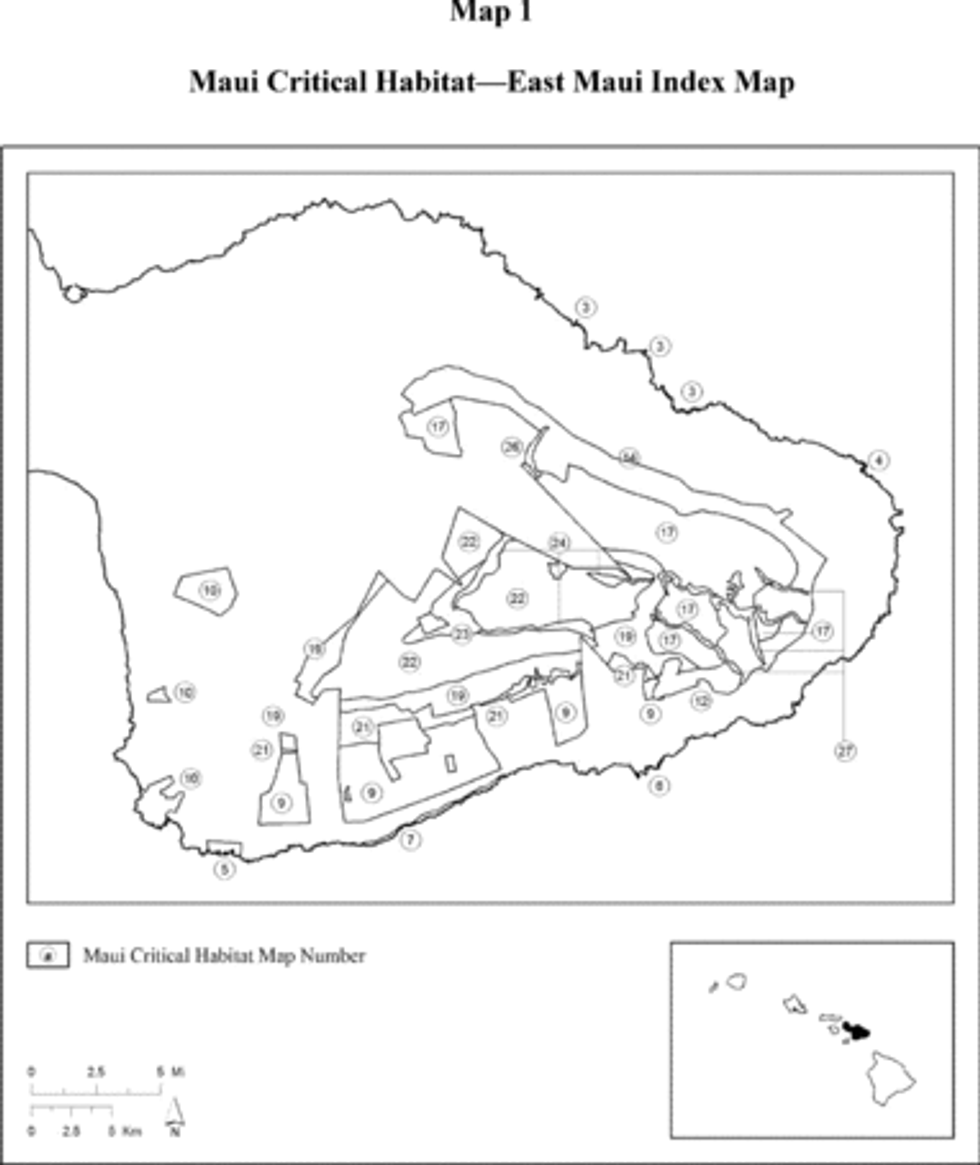
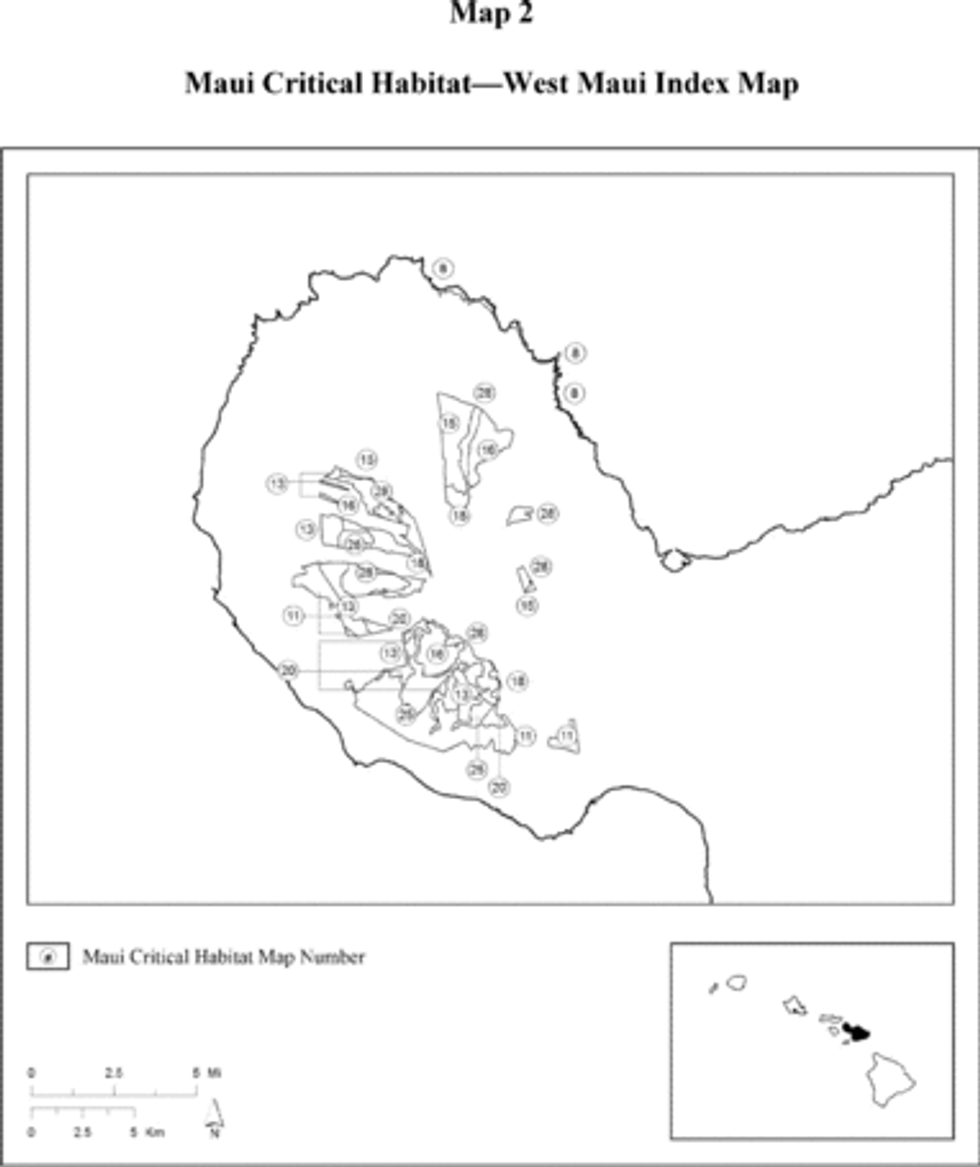
(ii) NOTE: Map 2 - West Maui Index map follow:
(iii) Maui--Coastal--Unit 1 (2 ac, 1 ha), Maui--Coastal--Unit 2 (25 ac, 10 ha), Maui--Coastal--Unit 3 (10 ac, 4 ha), and Maui--Coastal--Unit 4 (74 ac, 30 ha).
(A) These units are critical habitat for Brighamia rockii, Cyperus pennatiformis, Ischaemum byrone, Peucedanum sandwicense, and Vigna o-wahuensis.
(B) Map of Maui--Coastal--Unit 1, Maui--Coastal--Unit 2, Maui--Coastal--Unit 3, and Maui--Coastal--Unit 4 (Map 3) follows:
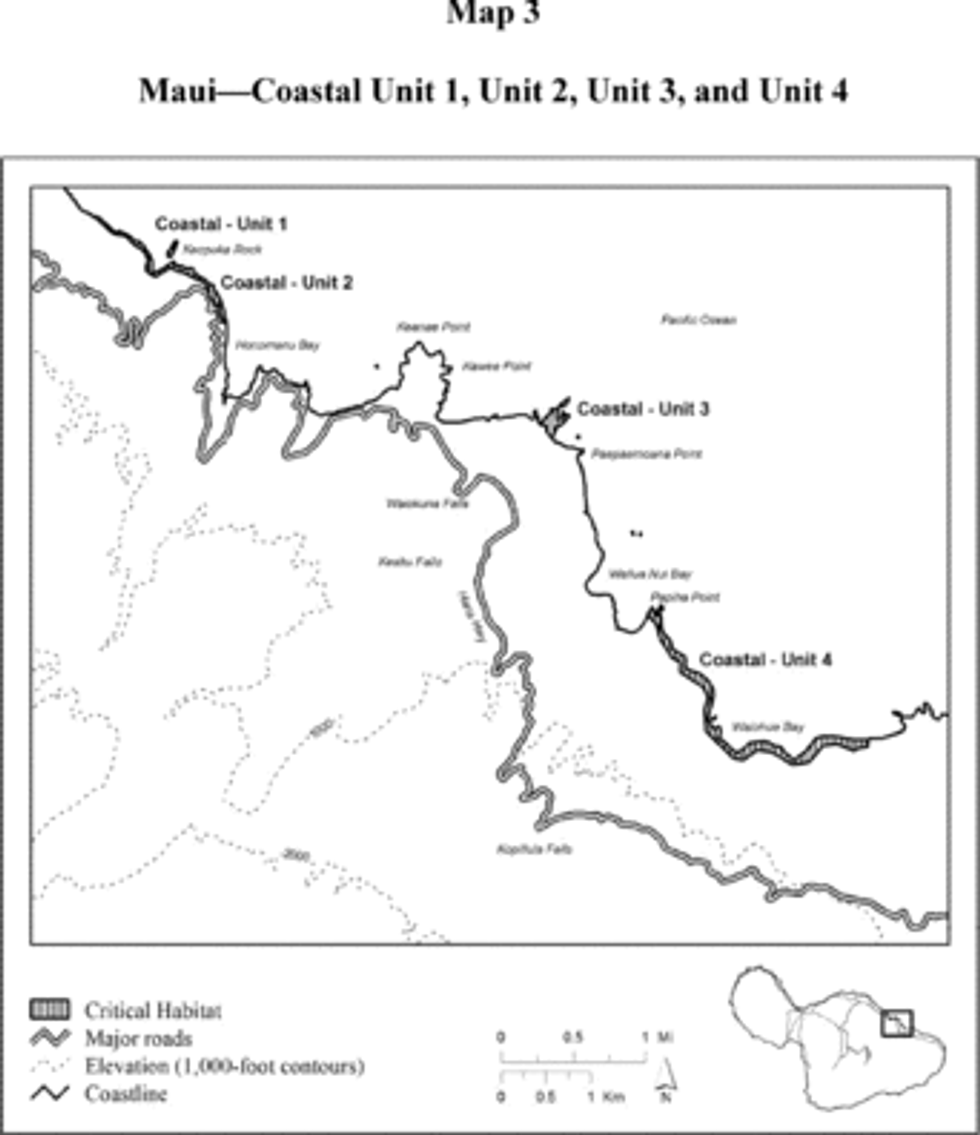
(iv) Maui--Coastal--Unit 5 (26 ac, 11 ha).
(A) This unit is critical habitat for Brighamia rockii, Cyperus pennatiformis, Ischaemum byrone, Peucedanum sandwicense, and Vigna o-wahuensis.
(B) Map of Maui--Coastal--Unit 5 (Map 4) follows:

(v) Maui--Coastal--Unit 6 (356 ac, 144 ha).
(A) This unit is critical habitat for Brighamia rockii, Cyperus pennatiformis, Ischaemum byrone, Peucedanum sandwicense, and Vigna o-wahuensis.
(B) Map of Maui--Coastal--Unit 6 (Map 5) follows:

(vi) Maui--Coastal--Unit 7 (46 ac, 19 ha).
(A) This unit is critical habitat for Brighamia rockii, Cyperus pennatiformis, Ischaemum byrone, Peucedanum sandwicense, and Vigna o-wahuensis.
(B) Map of Maui--Coastal--Unit 7 (Map 6) follows:

(vii) Maui--Coastal--Unit 8 (493 ac, 200 ha).
(A) This unit is critical habitat for Brighamia rockii, Cyperus pennatiformis, Ischaemum byrone, Peucedanum sandwicense, and Vigna o-wahuensis.
(B) Map of Maui--Coastal--Unit 8 (Map 7) follows:
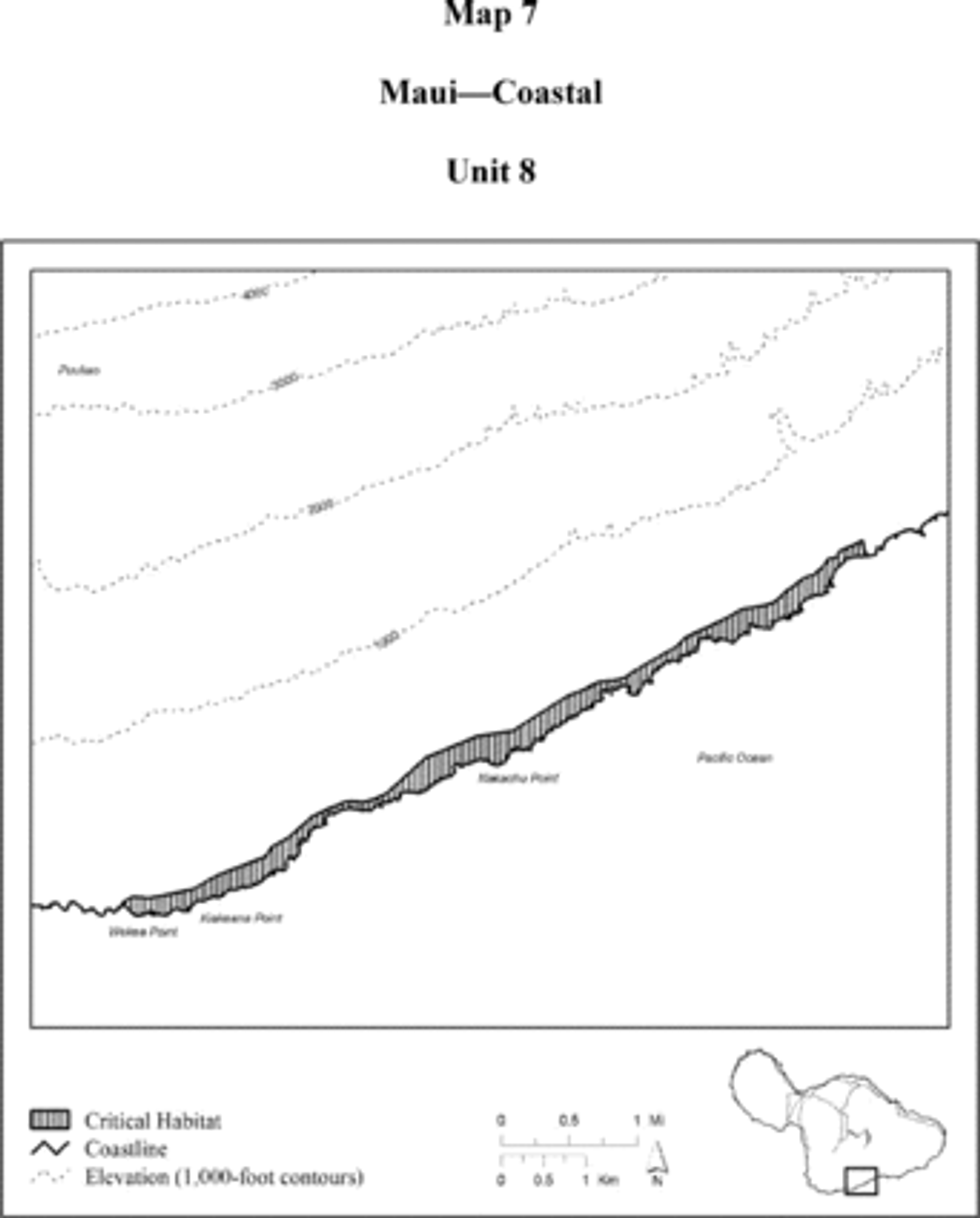
(viii) Maui--Coastal--Unit 9 (170 ac, 69 ha), Maui--Coastal--Unit 10 (173 ac, 70 ha), and Maui--Coastal--Unit 11 (6 ac, 3 ha).
(A) These units are critical habitat for Brighamia rockii, Schenkia sebaeoides, and Sesbania tomentosa.
(B) Map of Maui--Coastal--Unit 9, Maui--Coastal--Unit 10, and Maui--Coastal--Unit 11 (Map 8) follows:
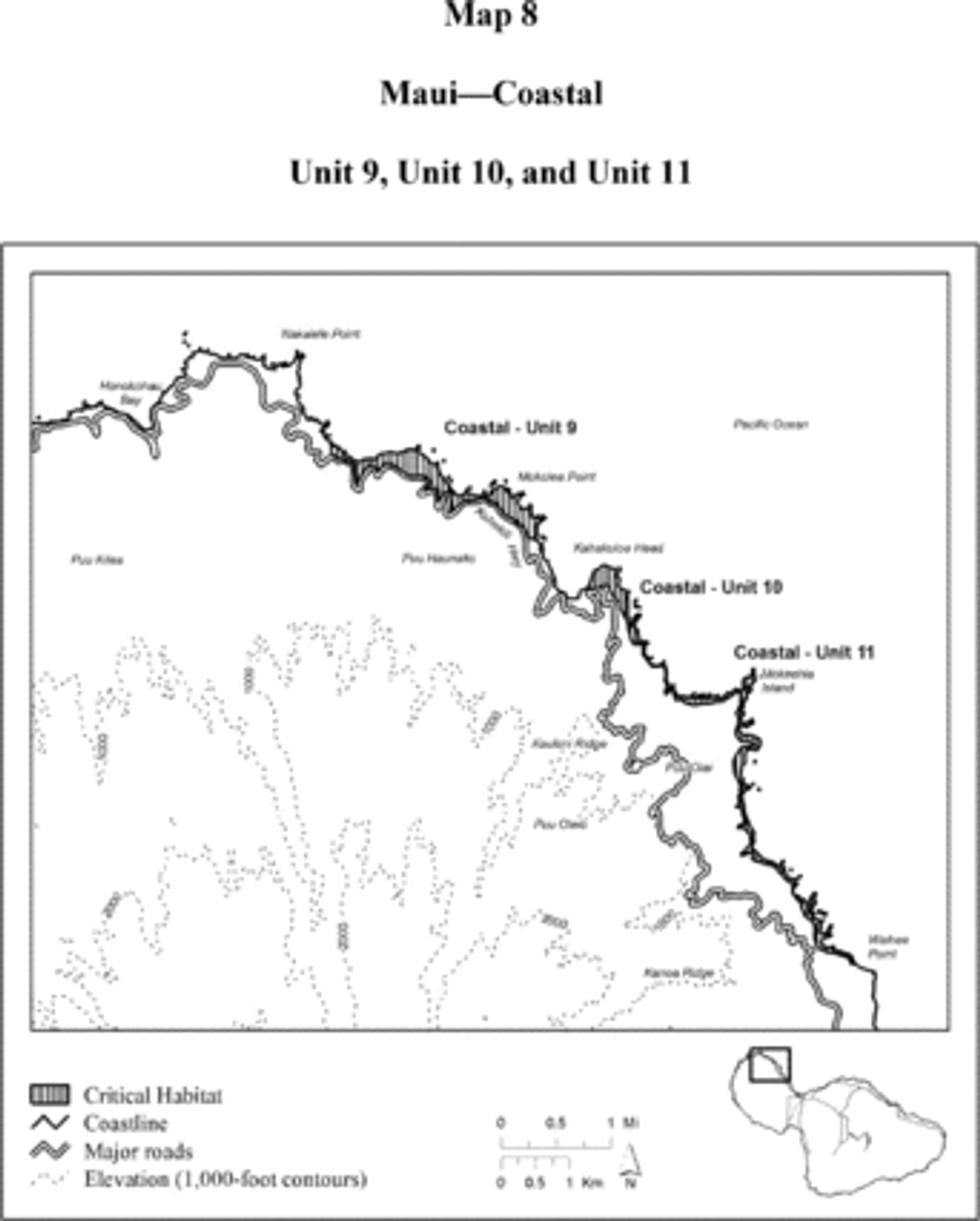
(ix) Maui--Lowland Dry--Unit 1 (13,537 ac, 5,478 ha).
(A) This unit is critical habitat for Alectryon macrococcus, Bidens micrantha ssp. kalealaha, Bonamia menziesii, Canavalia pubescens, Cenchrus agrimonioides, Colubrina oppositifolia, Ctenitis squamigera, Flueggea neowawraea, Hibiscus brackenridgei, Melanthera kamolensis, Melicope adscendens, Melicope mucronulata, Neraudia sericea, Nototrichium humile, Santalum haleakalae var. lanaiense, Sesbania tomentosa, Solanum incompletum, Spermolepis hawaiiensis, and Zanthoxylum hawaiiense.
(B) Map of Maui--Lowland Dry--Unit 1 (Map 9) follows:
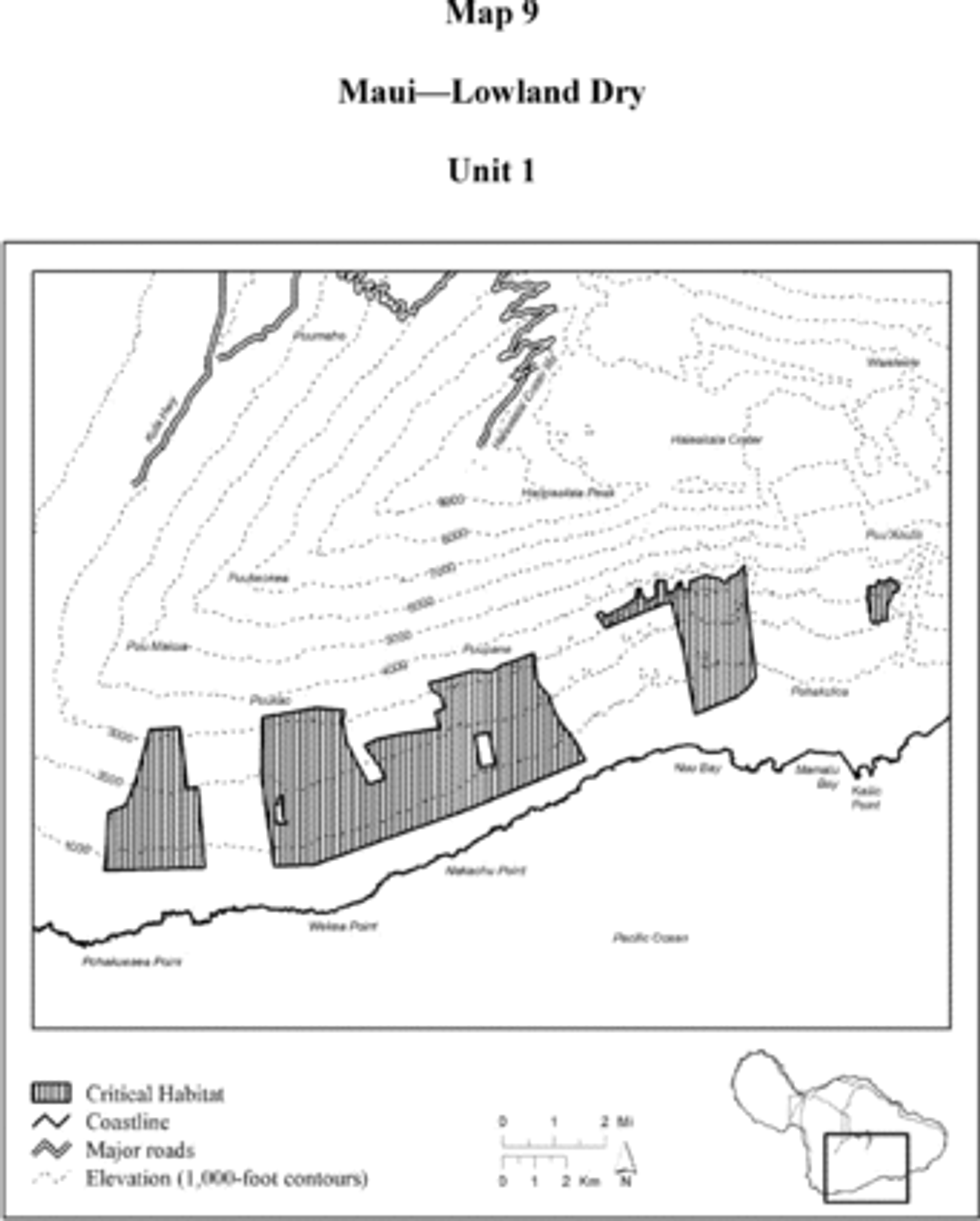
(x) Maui - Lowland Dry - Unit 2 (1,851 ac, 749 ha), Maui - Lowland Dry - Unit 3 (188 ac, 76 ha), and Maui - Lowland Dry - Unit 4 (1,266 ac, 512 ha).
(A) Maui - Lowland Dry - Unit 2 is critical habitat for Alectryon macrococcus, Bidens micrantha ssp. kalealaha, Bonamia menziesii, Canavalia pubescens, Cenchrus agrimonioides, Colubrina oppositifolia, Ctenitis squamigera, Flueggea neowawraea, Hibiscus brackenridgei, Melanthera kamolensis, Melicope mucronulata, Neraudia sericea, Nototrichium humile, Santalum haleakalae var. lanaiense, Sesbania tomentosa, Solanum incompletum, Spermolepis hawaiiensis, and Zanthoxylum hawaiiense.
(B) Maui - Lowland Dry - Unit 3 and Maui - Lowland Dry - Unit 4 are critical habitat for Bidens micrantha ssp. kalealaha, Bonamia menziesii, Canavalia pubescens, Cenchrus agrimonioides, Colubrina oppositifolia, Ctenitis squamigera, Flueggea neowawraea, Hibiscus brackenridgei, Melanthera kamolensis, Melicope mucronulata, Neraudia sericea, Nototrichium humile, Santalum haleakalae var. lanaiense, Sesbania tomentosa, Solanum incompletum, Spermolepis hawaiiensis, and Zanthoxylum hawaiiense.
(C) Map of Maui - Lowland Dry - Unit 2, Maui - Lowland Dry - Unit 3, and Maui - Lowland Dry - Unit 4 (Map 10) follows:
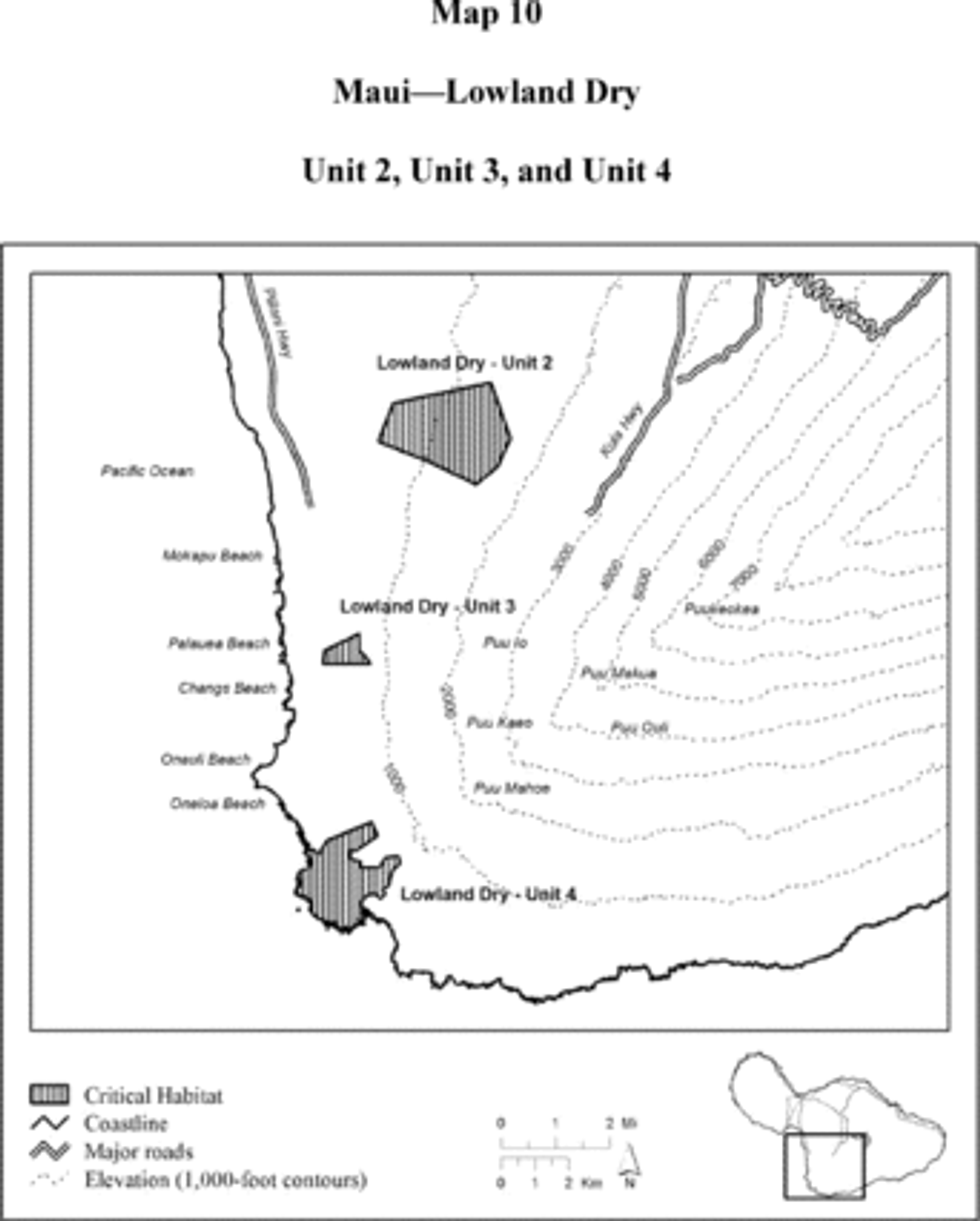
(xi) Maui - Lowland Dry - Unit 5 (3,658 ac, 1,480 ha) and Maui - Lowland Dry - Unit 6 (240 ac, 97 ha).
(A) These units are critical habitat for Asplenium dielerectum, Bidens campylotheca ssp. pentamera, Cenchrus agrimonioides, Ctenitis squamigera, Cyanea obtusa, Gouania hillebrandii, Hesperomannia arbuscula, Hibiscus brackenridgei, Kadua coriacea, Lysimachia lydgatei, Neraudia sericea, Remya mauiensis, Santalum haleakalae var. lanaiense, Schiedea salicaria, Sesbania tomentosa, Spermolepis hawaiiensis, Tetramolopium capillare, and Tetramolopium remyi.
(B) Map of Maui - Lowland Dry - Unit 5 and Maui - Lowland Dry - Unit 6 (Map 11) follows:
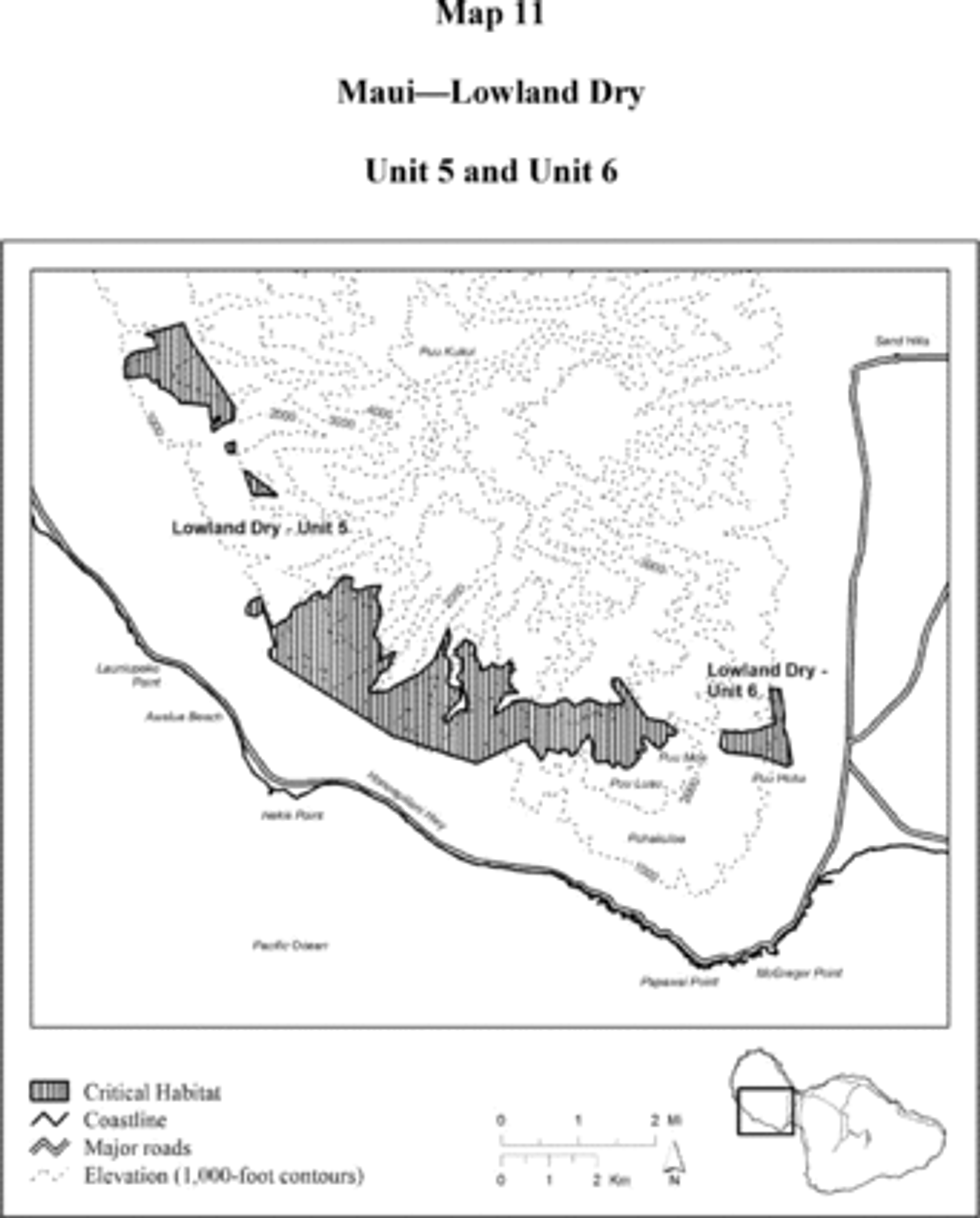
(xii) Maui - Lowland Mesic - Unit 1 (1,882 ac, 762 ha).
(A) This unit is critical habitat for Ctenitis squamigera, Cyanea asplenifolia, Cyanea copelandii ssp. haleakalaensis, Phlegmariurus mannii, and Solanum incompletum.
(B) Map of Maui - Lowland Mesic--Unit 1 (Map 12) follows:
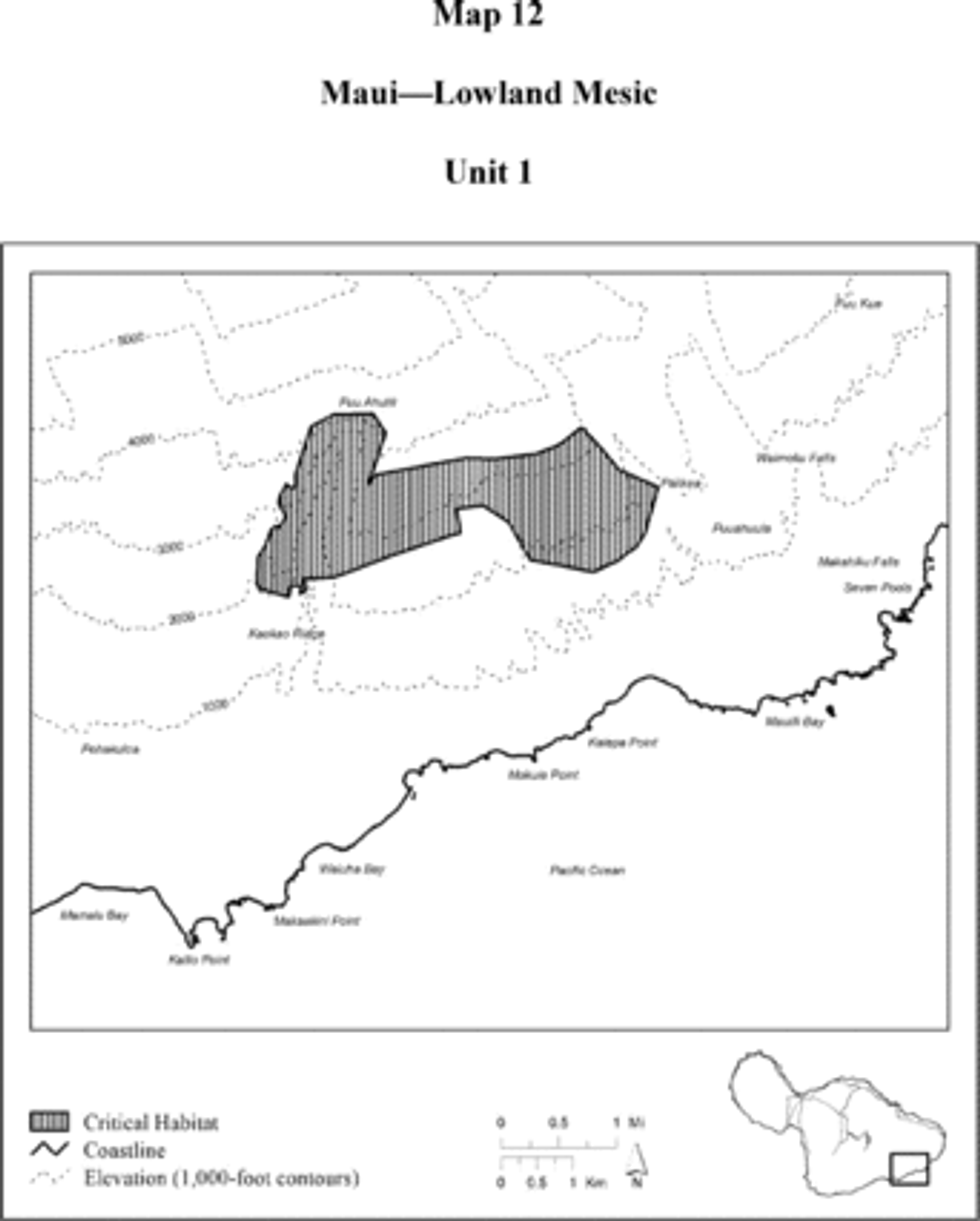
(xiii) Maui--Lowland Mesic--Unit 2 (1,147 ac, 464 ha) and Maui--Lowland Mesic--Unit 3 (477 ac, 193 ha).
(A) These units are critical habitat for Asplenium dielerectum, Bidens campylotheca ssp. pentamera, Colubrina oppositifolia, Ctenitis squamigera, Remya mauiensis, Santalum haleakalae var. lanaiense, and Zanthoxylum hawaiiense.
(B) Map of Maui--Lowland Mesic--Unit 2 and Maui--Lowland Mesic--Unit 3 (Map 13) follows:
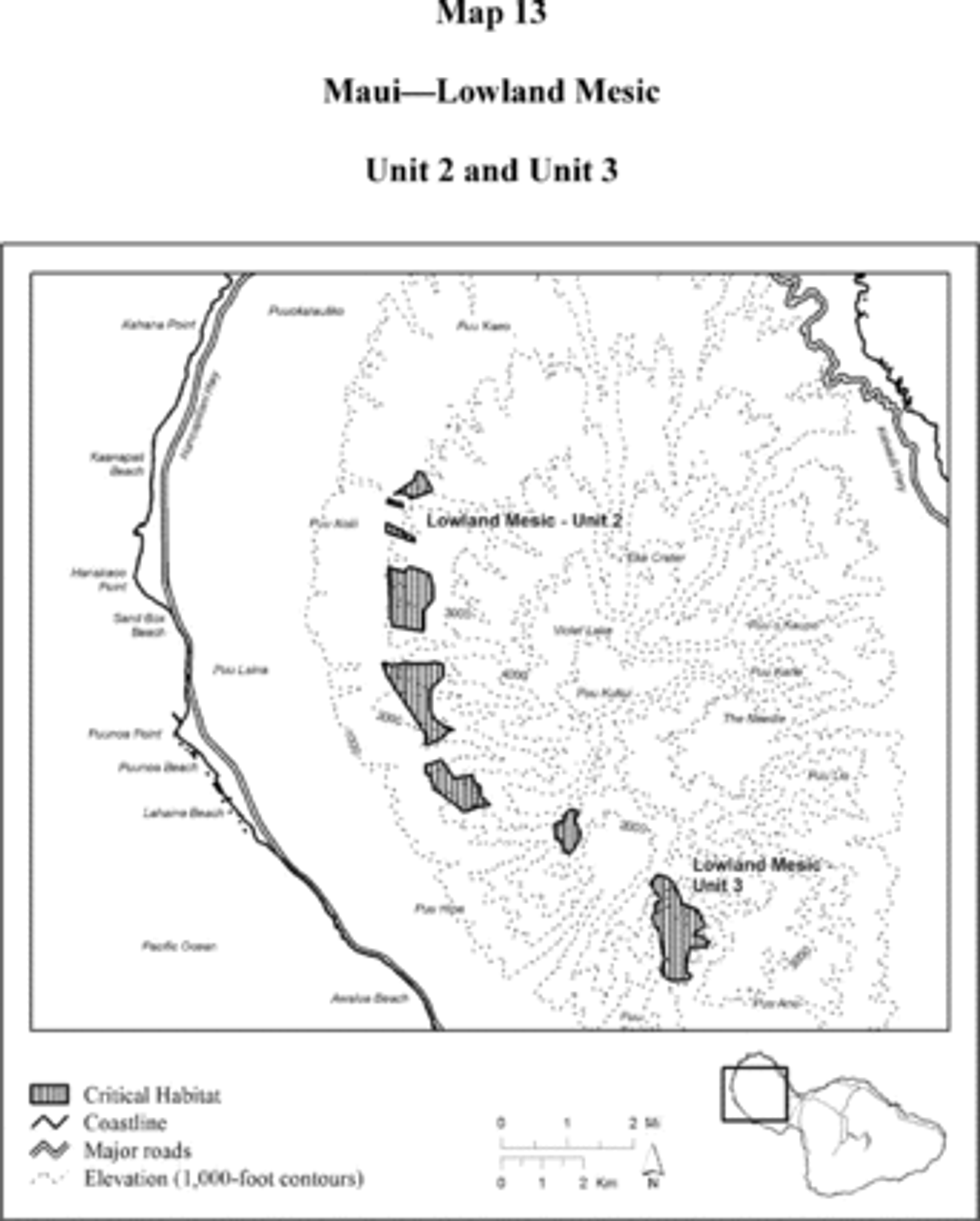
(xiv) Maui--Lowland Wet--Unit 1 (16,079 ac, 6,507 ha).
(A) This unit is critical habitat for Bidens campylotheca ssp. waihoiensis, Clermontia oblongifolia ssp. mauiensis, Clermontia peleana, Clermontia samuelii, Cyanea asplenifolia, Cyanea copelandii ssp. haleakalaensis, Cyanea duvalliorum, Cyanea hamatiflora ssp. hamatiflora, Cyanea kunthiana, Cyanea maritae, Cyanea mceldowneyi, Phlegmariurus mannii, Melicope balloui, Melicope ovalis, Mucuna persericea, Phyllostegia haliakalae, and Wikstroemia villosa.
(B) Map of Maui--Lowland Wet--Unit 1 (Map 14) follows:
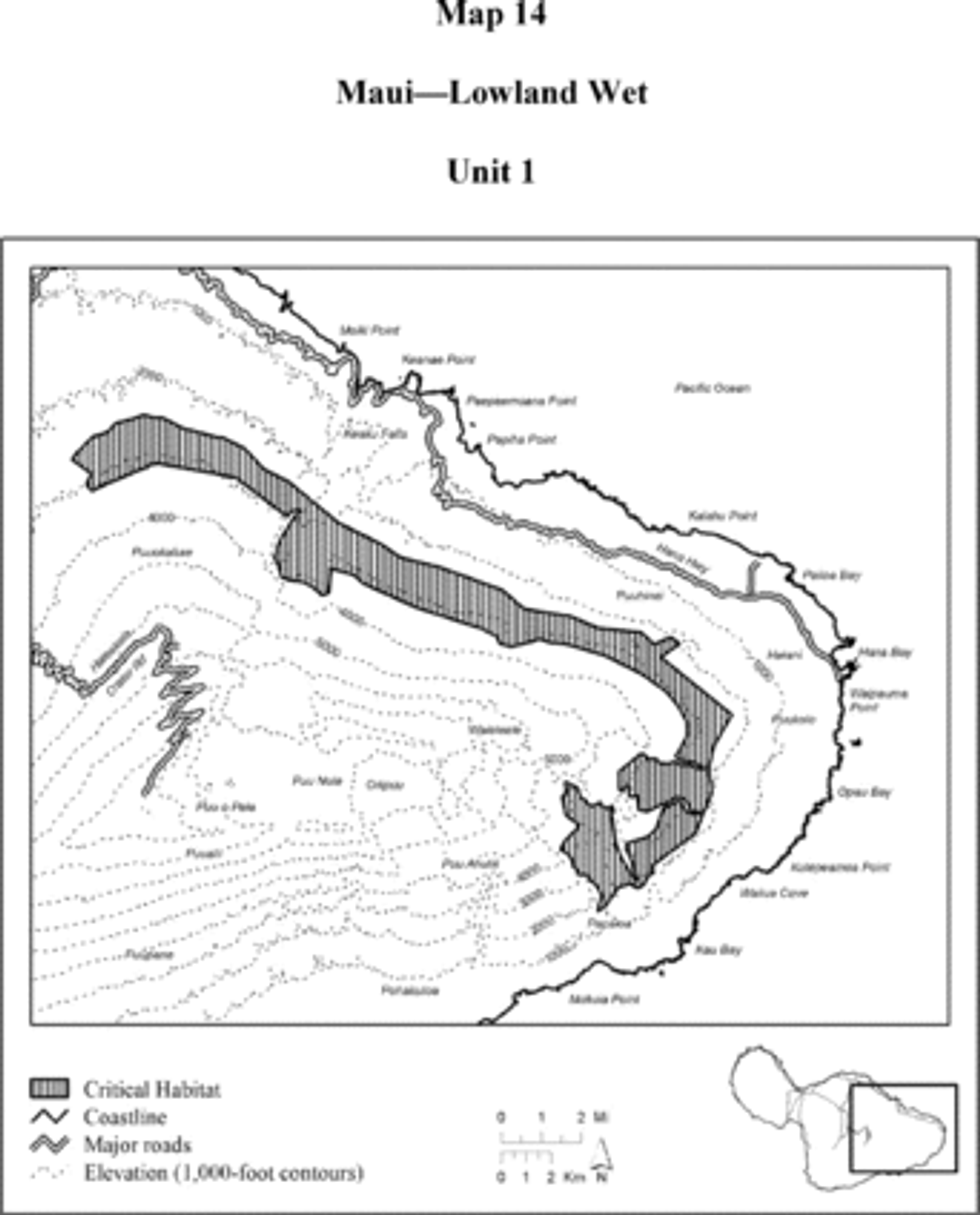
(xv) Maui--Lowland Wet--Unit 2 (65 ac, 26 ha), Maui--Lowland Wet--Unit 3 (1,247 ac, 505 ha), Maui--Lowland Wet--Unit 4 (864 ac, 350 ha), and Maui--Lowland Wet--Unit 6 (136 ac, 55 ha).
(A) This unit is critical habitat for Alectryon macrococcus, Asplenium dielerectum, Bidens conjuncta, Bidens micrantha ssp. kalealaha, Clermontia oblongifolia ssp. mauiensis, Ctenitis squamigera, Cyanea asplenifolia, Cyanea glabra, Cyanea kunthiana, Cyanea lobata, Cyanea magnicalyx, Cyrtandra filipes, Cyrtandra munroi, Diplazium molokaiense, Hesperomannia arborescens, Hesperomannia arbuscula, Phlegmariurus mannii, Isodendrion pyrifolium, Kadua laxiflora, Peucedanum sandwicense, Phyllostegia bracteata, Pteris lidgatei, Remya mauiensis, Santalum haleakalae var. lanaiense, and Wikstroemia villosa.
(B) Map of Maui--Lowland Wet--Unit 2, Maui--Lowland Wet--Unit 3, Maui---Lowland Wet--Unit 4, and Maui--Lowland Wet--Unit 6 (Map 15) follows:
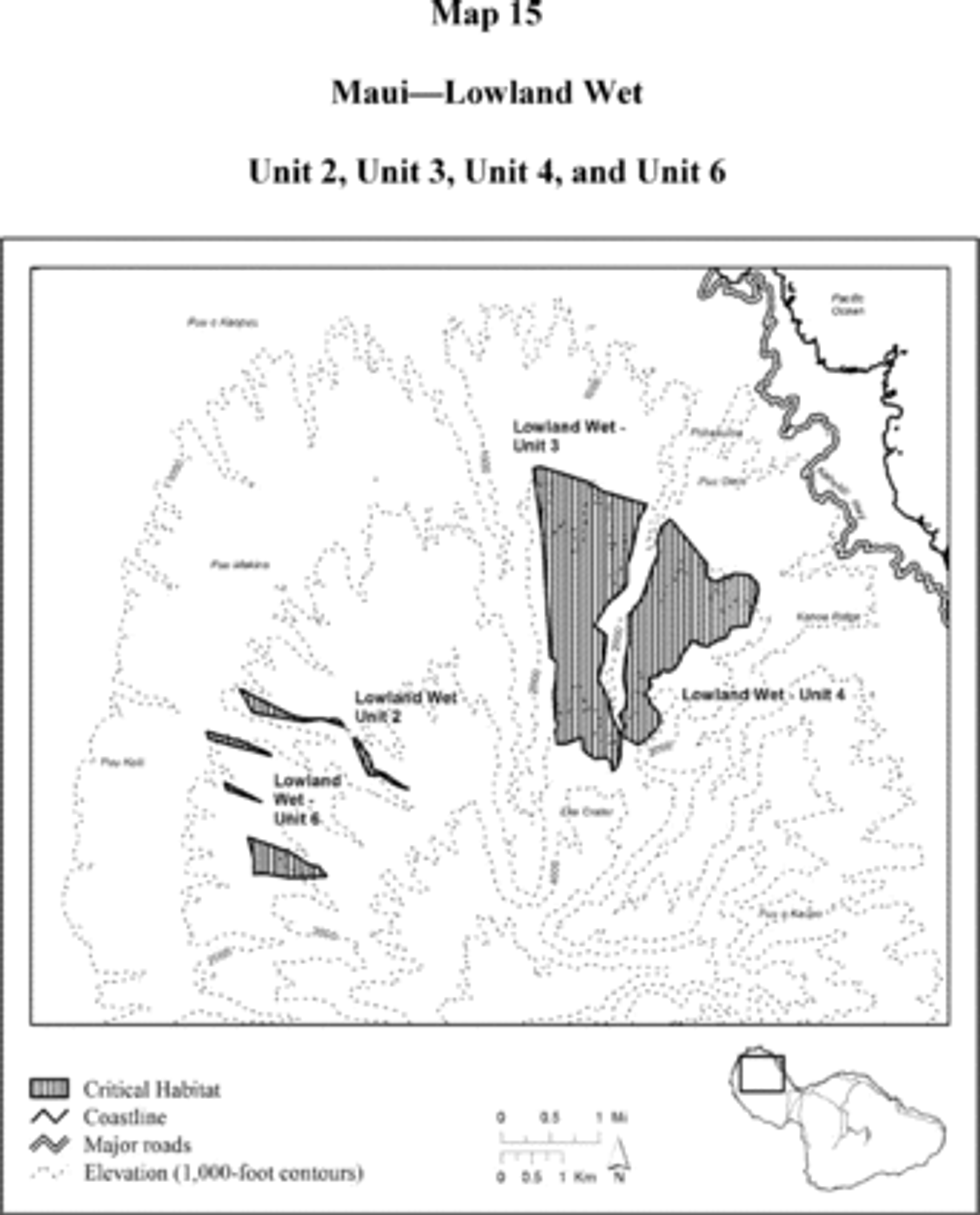
(xvi) Maui--Lowland Wet--Unit 5 (30 ac, 12 ha), Maui--Lowland Wet--Unit 7 (898 ac, 364 ha), and Maui--Lowland Wet--Unit 8 (230 ac, 93 ha).
(A) These units are critical habitat for Alectryon macrococcus, Asplenium dielerectum, Bidens conjuncta, Bidens micrantha ssp. kalealaha, Clermontia oblongifolia ssp. mauiensis, Ctenitis squamigera, Cyanea asplenifolia, Cyanea glabra, Cyanea kunthiana, Cyanea lobata, Cyanea magnicalyx, Cyrtandra filipes, Cyrtandra munroi, Diplazium molokaiense, Hesperomannia arborescens, Hesperomannia arbuscula, Phlegmariurus manniii, Isodendrion pyrifolium, Kadua laxiflora, Peucedanum sandwicense, Phyllostegia bracteata, Pteris lidgatei, Remya mauiensis, Santalum haleakalae var. lanaiense, and Wikstroemia villosa.
(B) Map of Maui--Lowland Wet--Unit 5, Maui--Lowland Wet--Unit 7, and Maui--Lowland Wet--Unit 8 (Map 16) follows:
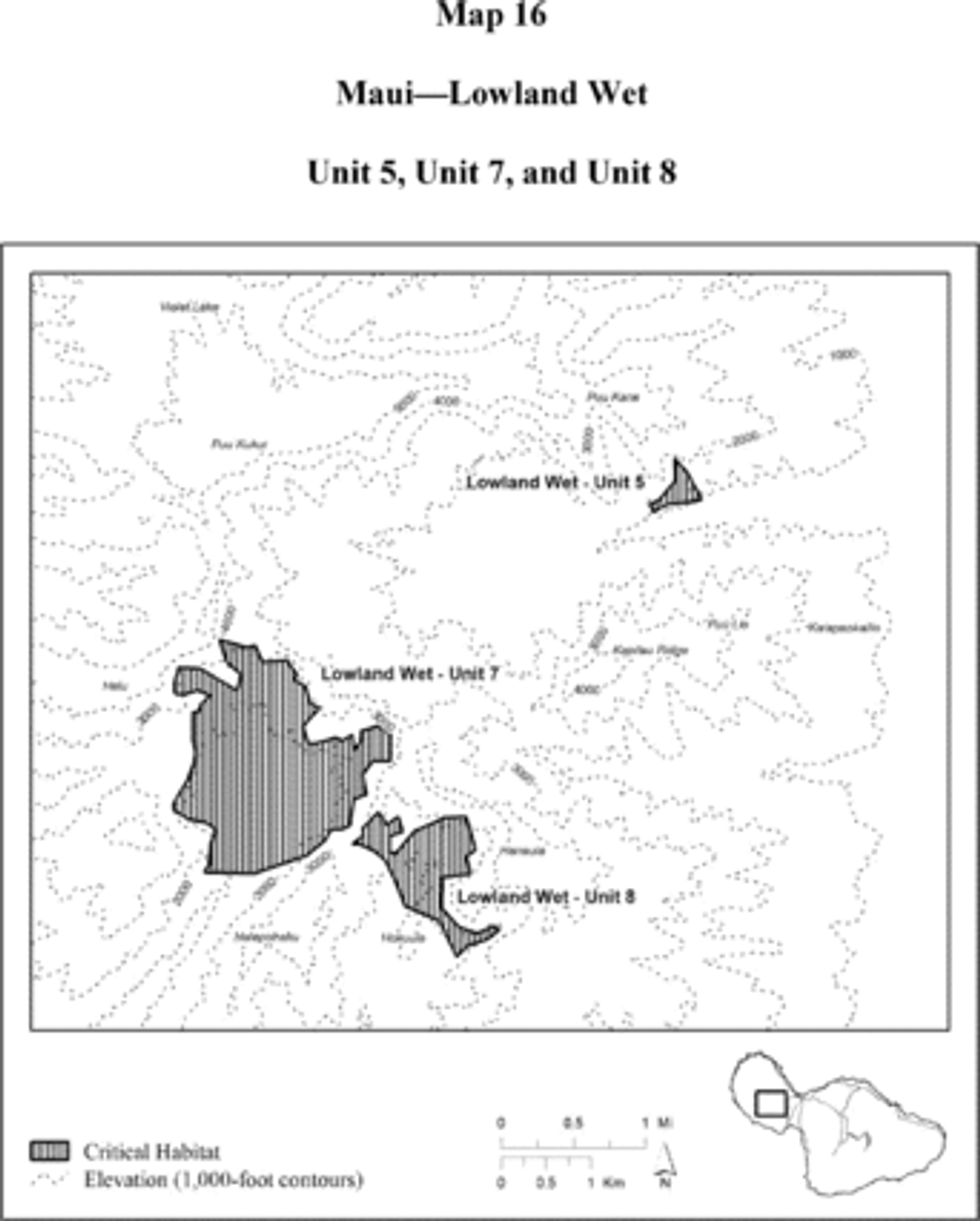
(xvii) Maui-Montane Wet-Unit 1 (2,110 ac, 854 ha), Maui-Montane Wet-Unit 2 (14,583 ac, 5,901 ha), Maui-Montane Wet-Unit 3 (2,228 ac, 902 ha), Maui-Montane Wet-Unit 4 (1,833 ac, 742 ha), and Maui-Montane Wet-Unit 5 (387 ac, 156 ha).
(A) This unit is critical habitat for Adenophorus periens, Asplenium peruvianum var. insulare, Bidens campylotheca ssp. pentamera, Bidens campylotheca ssp. waihoiensis, Clermontia oblongifolia ssp. mauiensis, Clermontia samuelii, Cyanea copelandii ssp. haleakalaensis, Cyanea duvalliorum, Cyanea glabra, Cyanea hamatiflora ssp. hamatiflora, Cyanea horrida, Cyanea kunthiana, Cyanea maritae, Cyanea mceldowneyi, Cyrtandra ferripilosa, Diplazium molokaiense, Geranium hanaense, Geranium multiflorum, Phlegmariurus manniii, Melicope balloui, Melicope ovalis, Peperomia subpetiolata, Phyllostegia bracteata, Phyllostegia haliakalae, Phyllostegia mannii, Phyllostegia pilosa, Platanthera holochila, Schiedea jacobii, and Wikstroemia villosa.
(B) Map of Maui--Montane Wet--Unit 1, Maui--Montane Wet--Unit 2, Maui--Montane Wet--Unit 3, Maui--Montane Wet--Unit 4, and Maui--Montane Wet--Unit 5 (Map 17) follows:
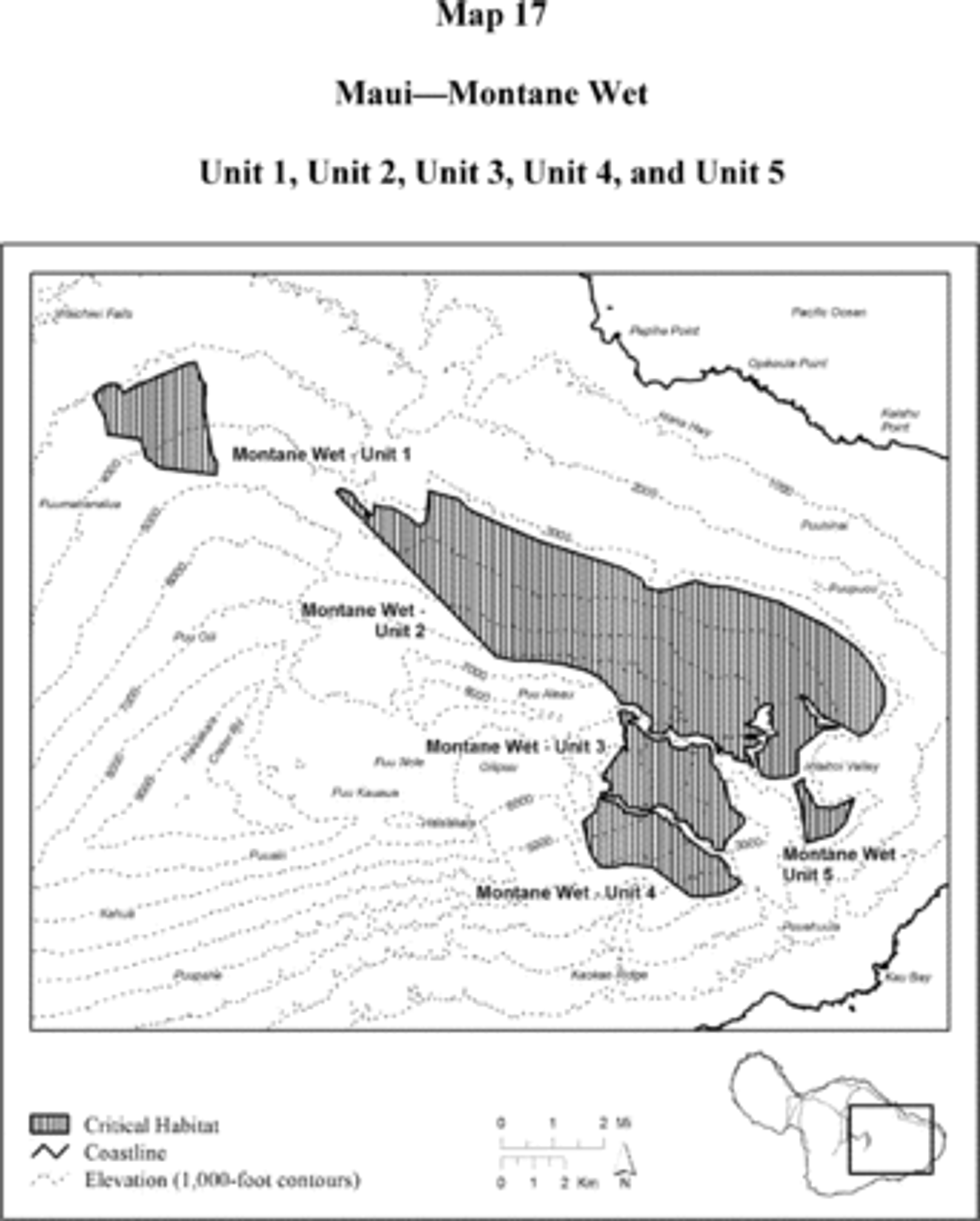
(xviii) Maui--Montane Wet--Unit 6 (1,399 ac, 566 ha), and Maui--Montane Wet--Unit 7 (80 ac, 32 ha).
(A) These units are critical habitat for Acaena exigua, Bidens conjuncta, Calamagrostis hillebrandii, Cyanea kunthiana, Cyrtandra oxybapha, Geranium hillebrandii, Phlegmariurus manniii, Myrsine vaccinioides, Phyllostegia bracteata, Platanthera holochila, and Sanicula purpurea.
(B) Map of Maui--Montane Wet--Unit 6 and Maui--Montane Wet--Unit 7 (Map 18) follows:
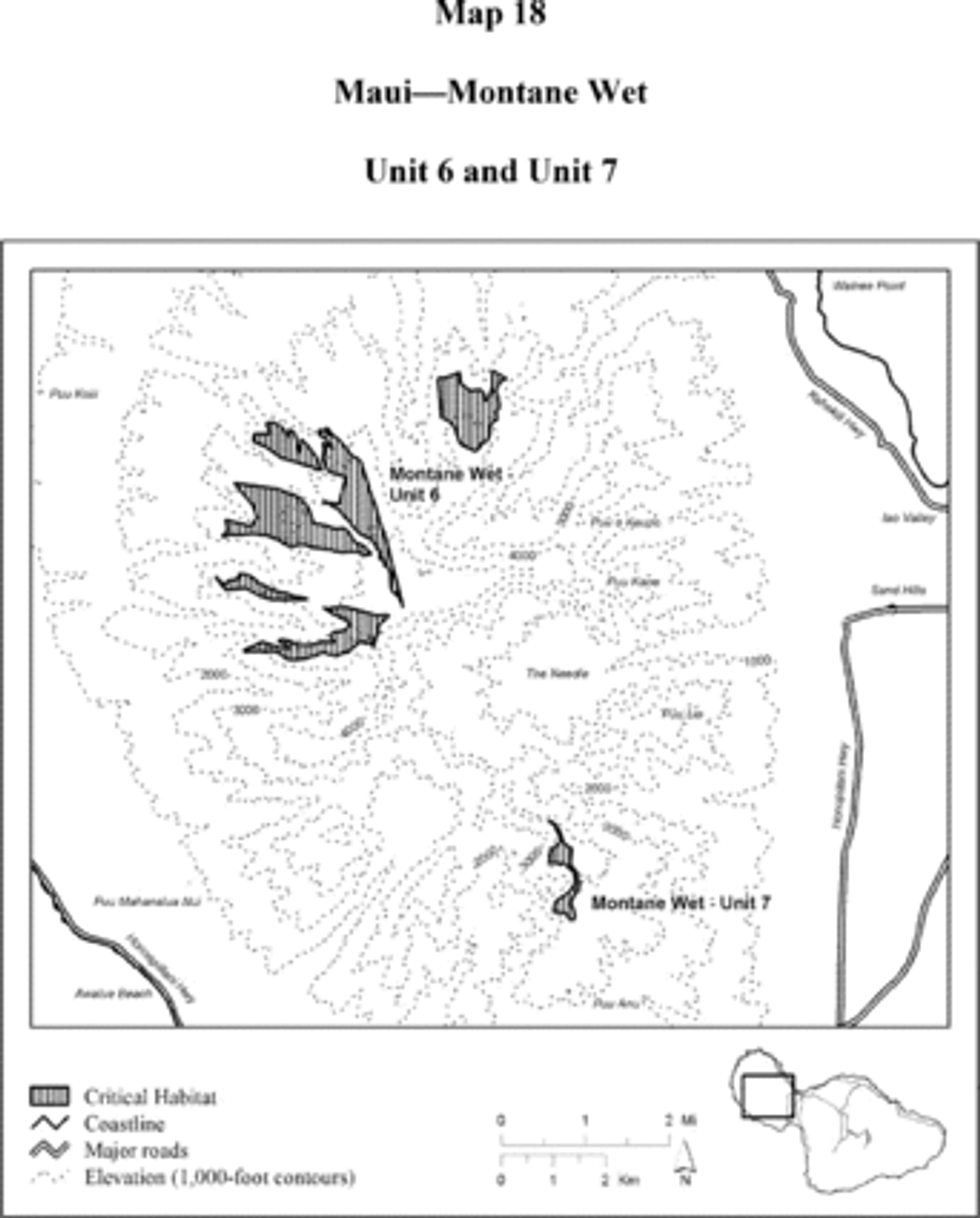
(xix) Maui--Montane Mesic--Unit 1 (10,972 ac, 4,440 ha).
(A) This unit is critical habitat for Alectryon macrococcus, Argyroxiphium sandwicense ssp. macrocephalum, Asplenium dielerectum, Asplenium peruvianum var. insulare, Bidens campylotheca ssp. pentamera, Bidens micrantha ssp. kalealaha, Clermontia lindseyana, Cyanea glabra, Cyanea hamatiflora ssp. hamatiflora, Cyanea horrida, Cyanea kunthiana, Cyanea mceldowneyi, Cyanea obtusa, Cyrtandra ferripilosa, Cyrtandra oxybapha, Diplazium molokaiense, Geranium arboreum, Geranium multiflorum, Phlegmariurus manniiii Melicope adscendens, Neraudia sericea, Phyllostegia bracteata, Phyllostegia mannii, Santalum haleakalae var. lanaiense, Wikstroemia villosa, and Zanthoxylum hawaiiense.
(B) Map of Maui--Montane Mesic--Unit 1 (Map 19) follows:
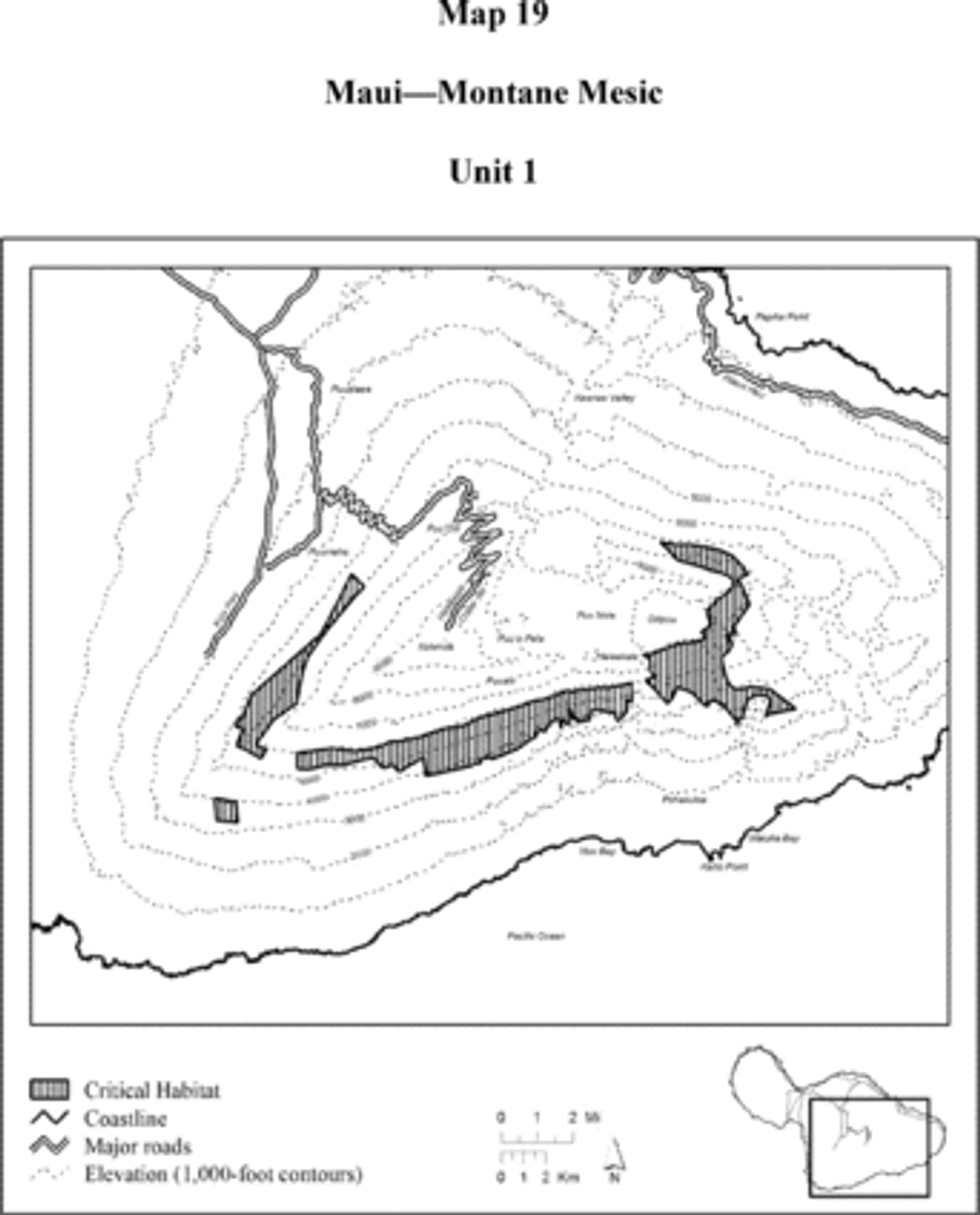
(xx) Maui - Montane Mesic - Unit 2 (124 ac, 50 ha), Maui - Montane Mesic - Unit 3 (174 ac; 70 ha), Maui - Montane Mesic - Unit 4 (72 ac, 29 ha), and Maui - Montane Mesic - Unit 5 (170 ac, 69 ha).
(A) These units are critical habitat for Ctenitis squamigera, Cyanea magnicalyx, Diplazium molokaiense, Geranium hillebrandii, Phlegmariurus manniii, Lysimachia lydgatei, Remya mauiensis, Santalum haleakalae var. lanaiense, Stenogyne kauaulaensis, and Zanthoxylum hawaiiense.
(B) Map of Maui--Montane Mesic--Unit 2, Maui--Montane Mesic--Unit 3, Maui--Montane Mesic--Unit 4, and Maui--Montane Mesic--Unit 5 (Map 20) follows:
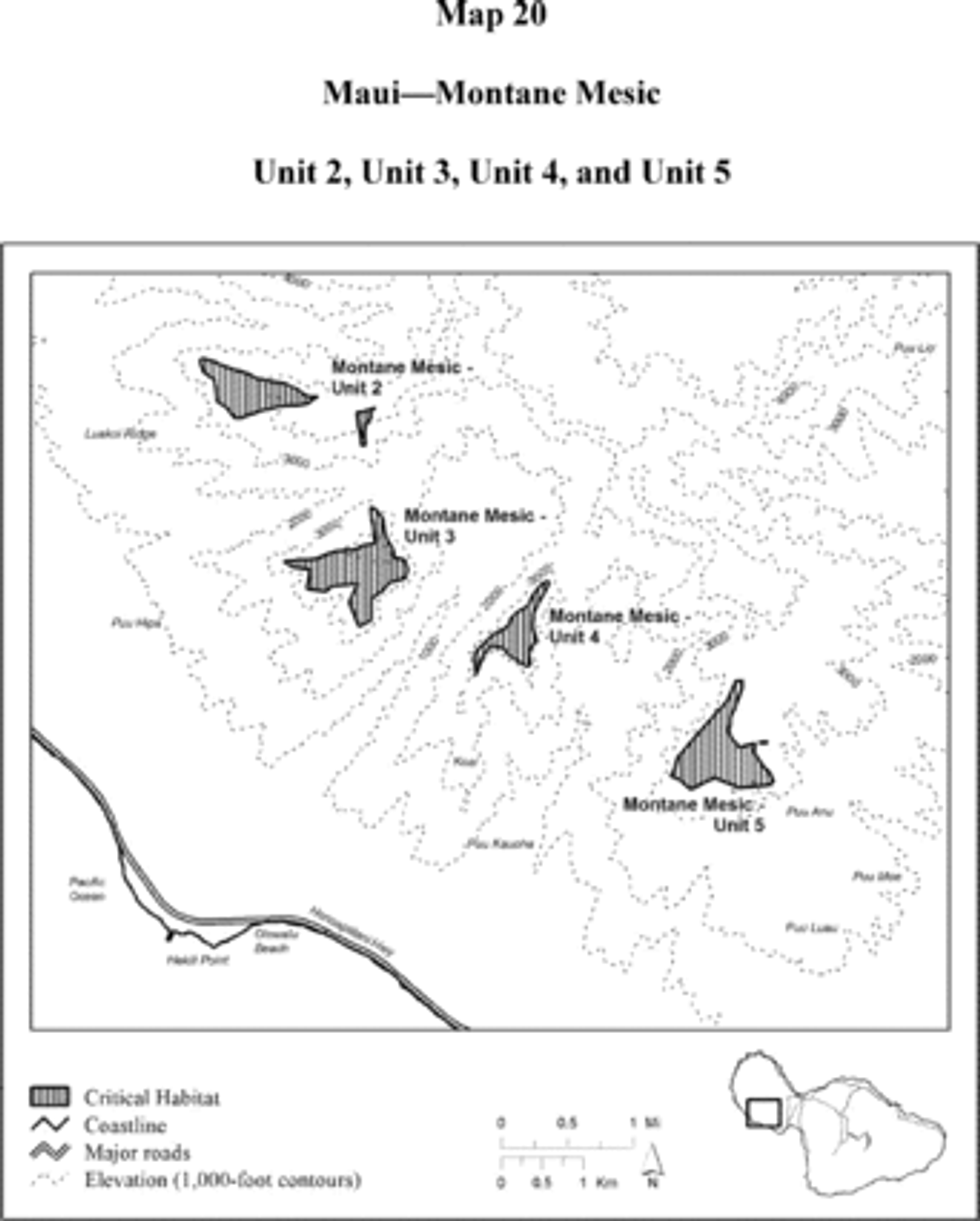
(xxi) Maui - Montane Dry--Unit 1 (3,524 ac, 1,426 ha).
(A) This unit is critical habitat for Alectryon macrococcus, Geranium arboreum, Melicope knudsenii, Melicope mucronulata, Santalum haleakalae var. lanaiense, and Zanthoxylum hawaiiense.
(B) Map of Maui--Montane Dry--Unit 1 (Map 21) follows:
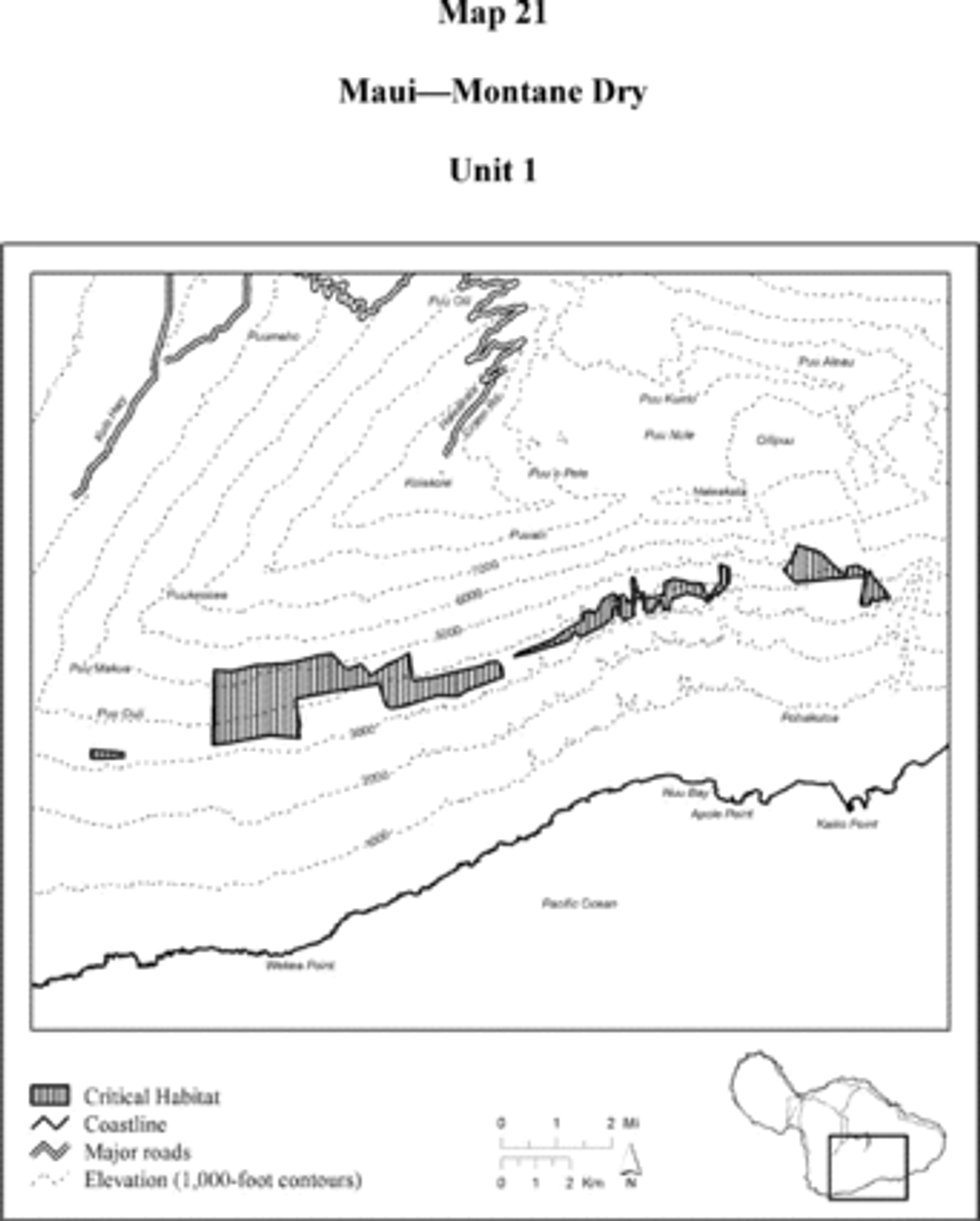
(xxii) Maui--Subalpine--Unit 1 (15,975 ac, 6,465 ha) and Maui--Subalpine--Unit 2 (9,886 ac, 4,001 ha).
(A) These units are critical habitat for Argyroxiphium sandwicense ssp. macrocephalum, Asplenium peruvianum var. insulare, Bidens micrantha ssp. kalealaha, Geranium arboreum, Geranium multiflorum, Phyllostegia bracteata, Schiedea haleakalensis, and Zanthoxylum hawaiiense.
(B) Map of Maui--Subalpine--Unit 1 and Maui--Subalpine--Unit 2 (Map 22) follows:
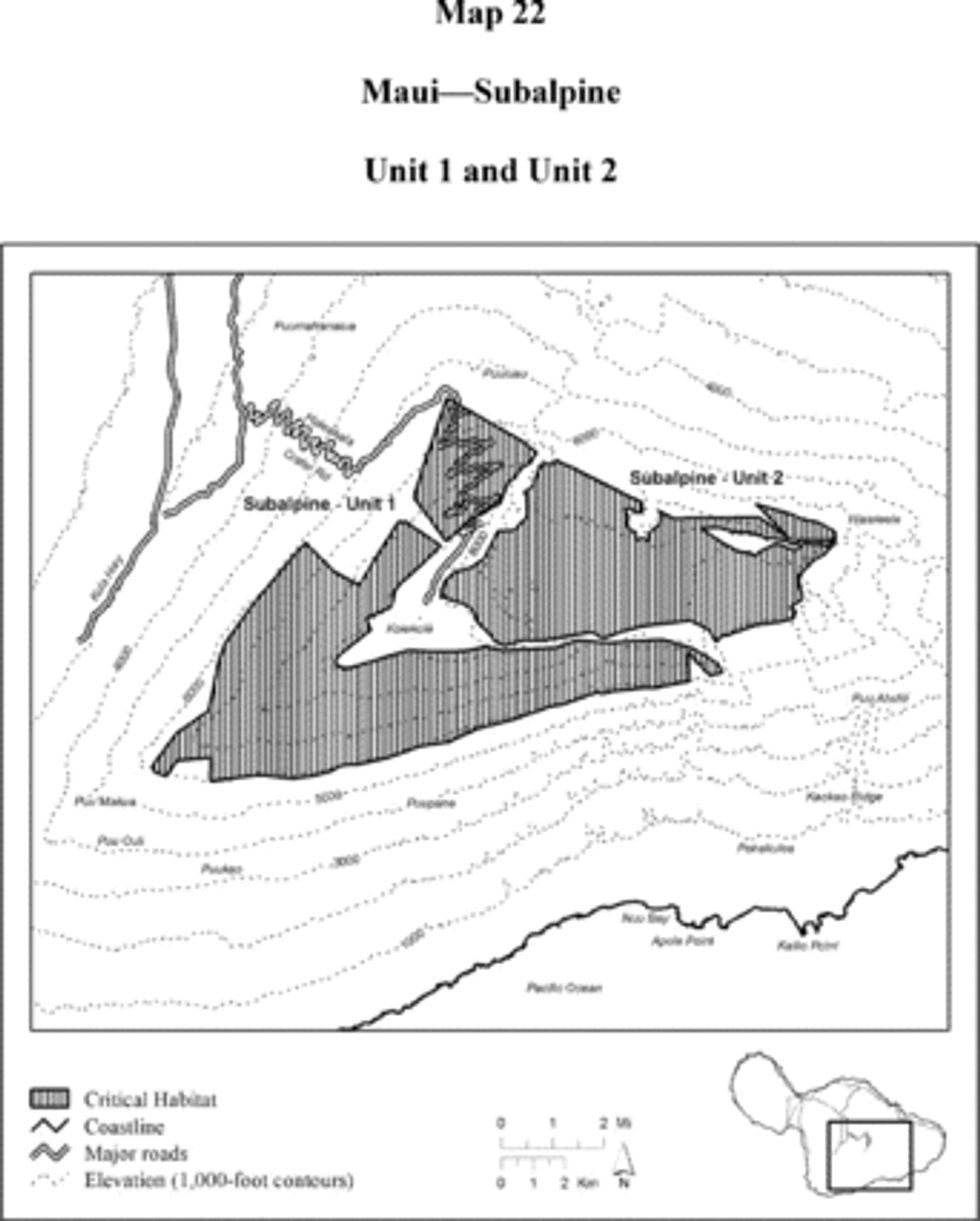
(xxiii) Maui--Alpine--Unit 1 (1,797 ac, 727 ha).
(A) This unit is critical habitat for Argyroxiphium sandwicense ssp. macrocephalum.
(B) Map of Maui--Alpine--Unit 1 (Map 23) follows:
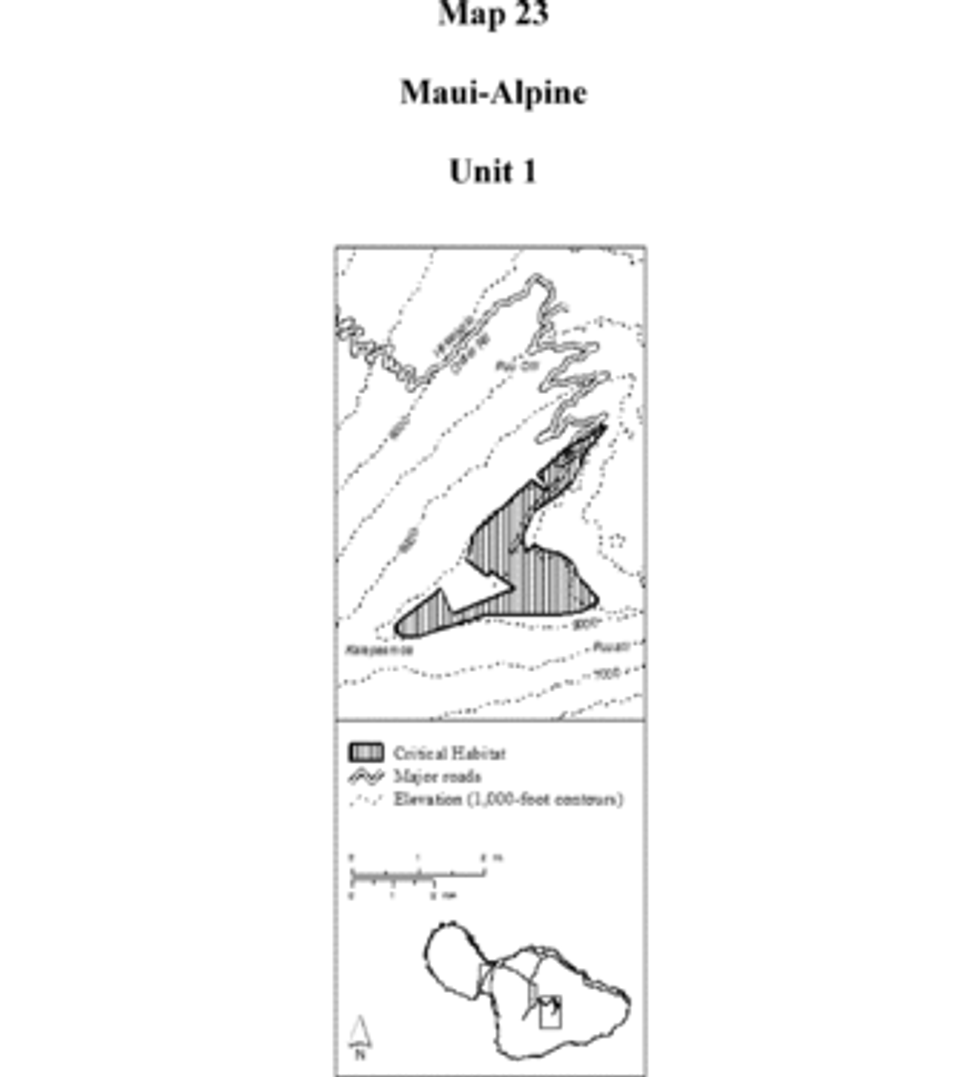
(xxiv) Maui - Dry Cliff--Unit 1 (755 ac, 305 ha), Maui--Dry Cliff - Unit 2 (688 ac, 279 ha), Maui - Dry Cliff--Unit 3 (200 ac, 81 ha), and Maui - ;Dry Cliff - Unit 4 (315 ac, 127 ha).
(A) These units are critical habitat for Argyroxiphium sandwicense ssp. macrocephalum, Bidens campylotheca ssp. pentamera, Bidens micrantha ssp. kalealaha, Diplazium molokaiense, Geranium multiflorum, Plantago princeps, and Schiedea haleakalensis.
(B) Map of Maui--Dry Cliff--Unit 1, Maui--Dry Cliff--Unit 2, Maui--Dry Cliff--Unit 3, and Maui--Dry Cliff--Unit 4 (Map 24) follows:
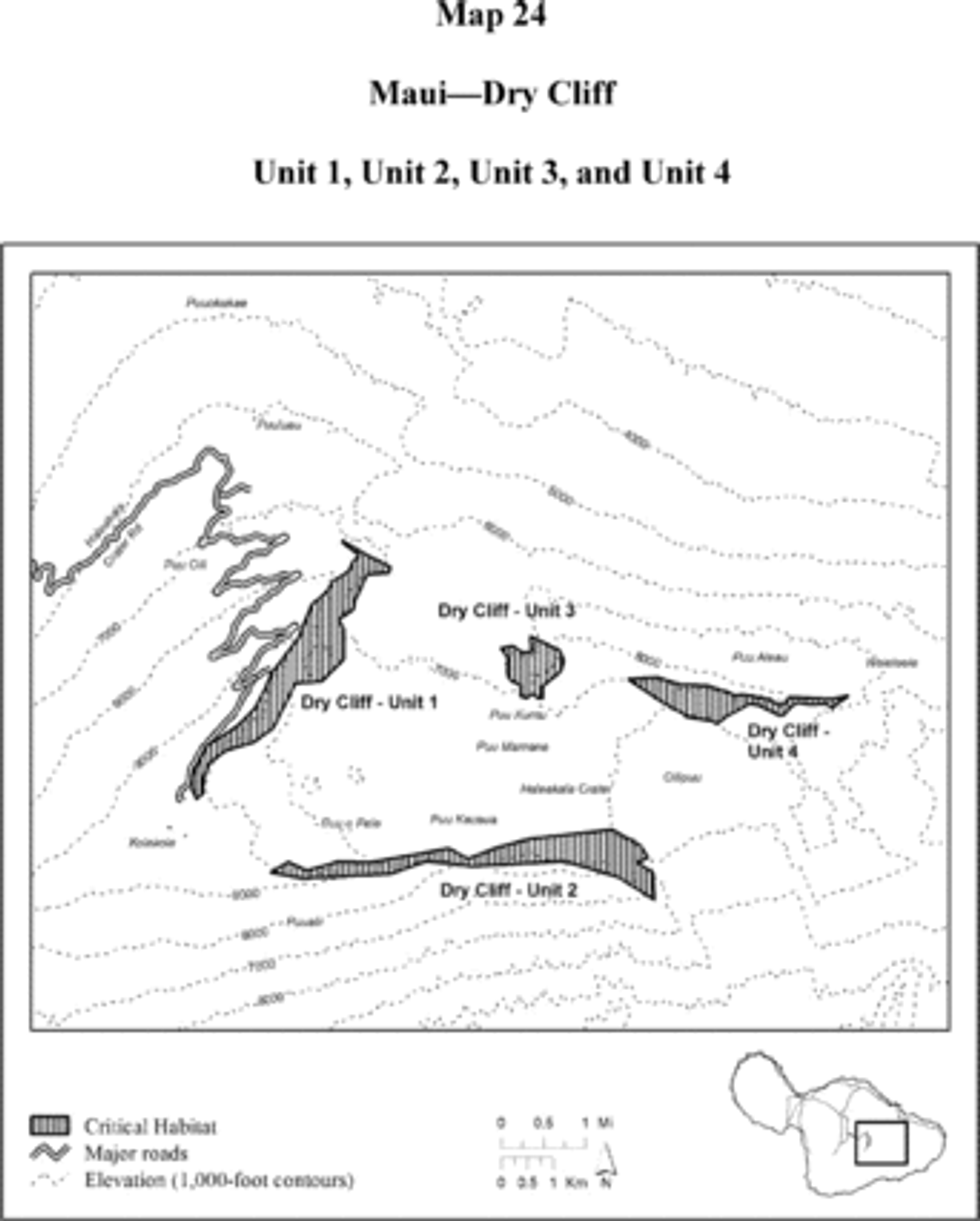
(xxv) Maui--Dry Cliff--Unit 5 (1,298 ac, 525 ha) and Maui--Dry Cliff--Unit 6 (279 ac, 113 ha).
(A) These units are critical habitat for Bonamia menziesii, Diplazium molokaiense, Hesperomannia arbuscula, Isodendrion pyrifolium, Kadua laxiflora, Neraudia sericea, and Tetramolopium capillare.
(B) Map of Maui--Dry Cliff--Unit 5 and Maui--Dry Cliff--Unit 6 (Map 25) follows:
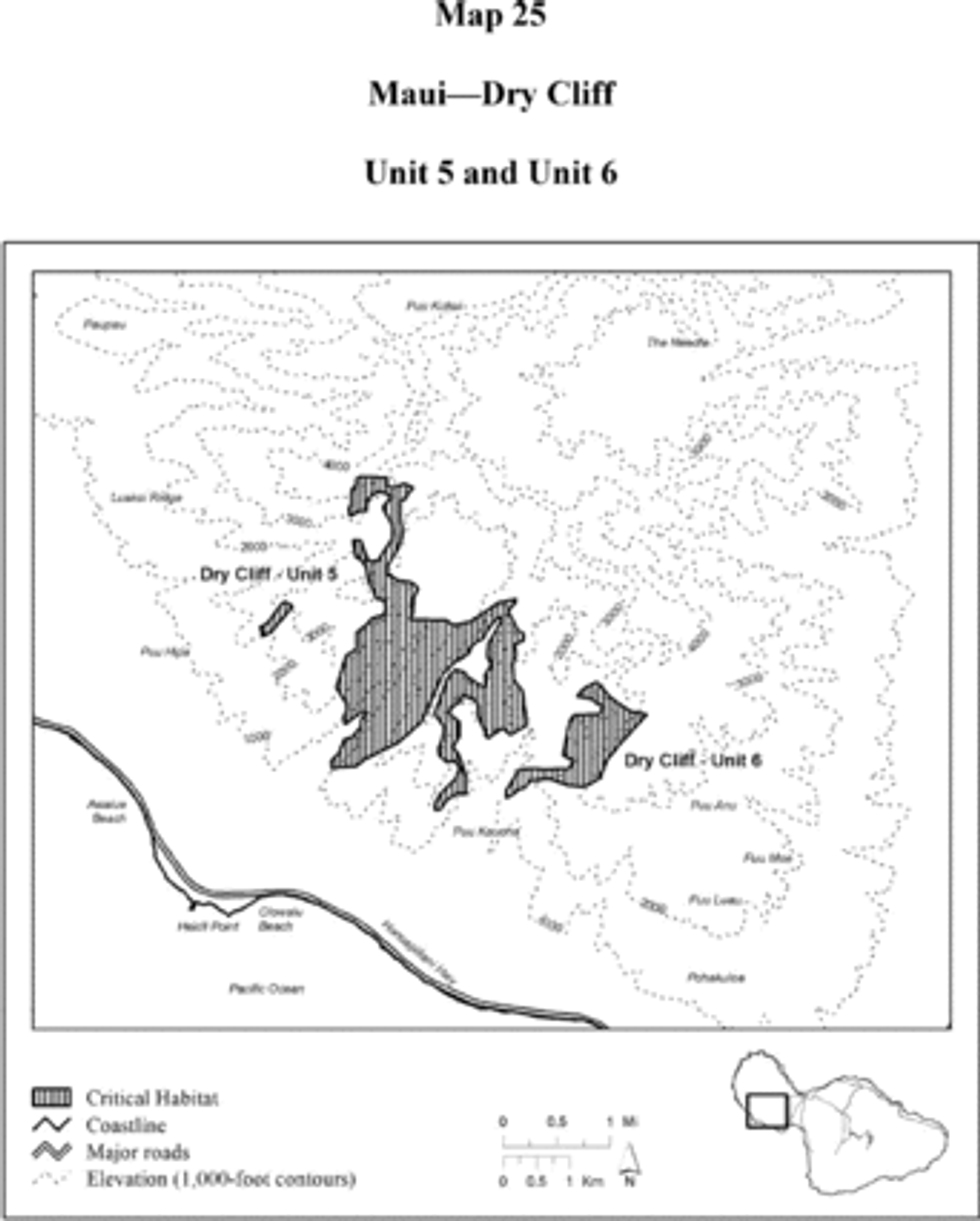
(xxvi) Maui--Wet Cliff--Unit 1 (290 ac, 117 ha).
(A) This unit is critical habitat for Bidens campylotheca ssp. pentamera, Bidens campylotheca ssp. waihoiensis, Cyanea copelandii ssp. haleakalaensis, Cyanea horrida, Melicope ovalis, Phyllostegia bracteata, Phyllostegia haliakalae, and Plantago princeps.
(B) Map of Maui--Wet Cliff--Unit 1 (Map 26) follows:
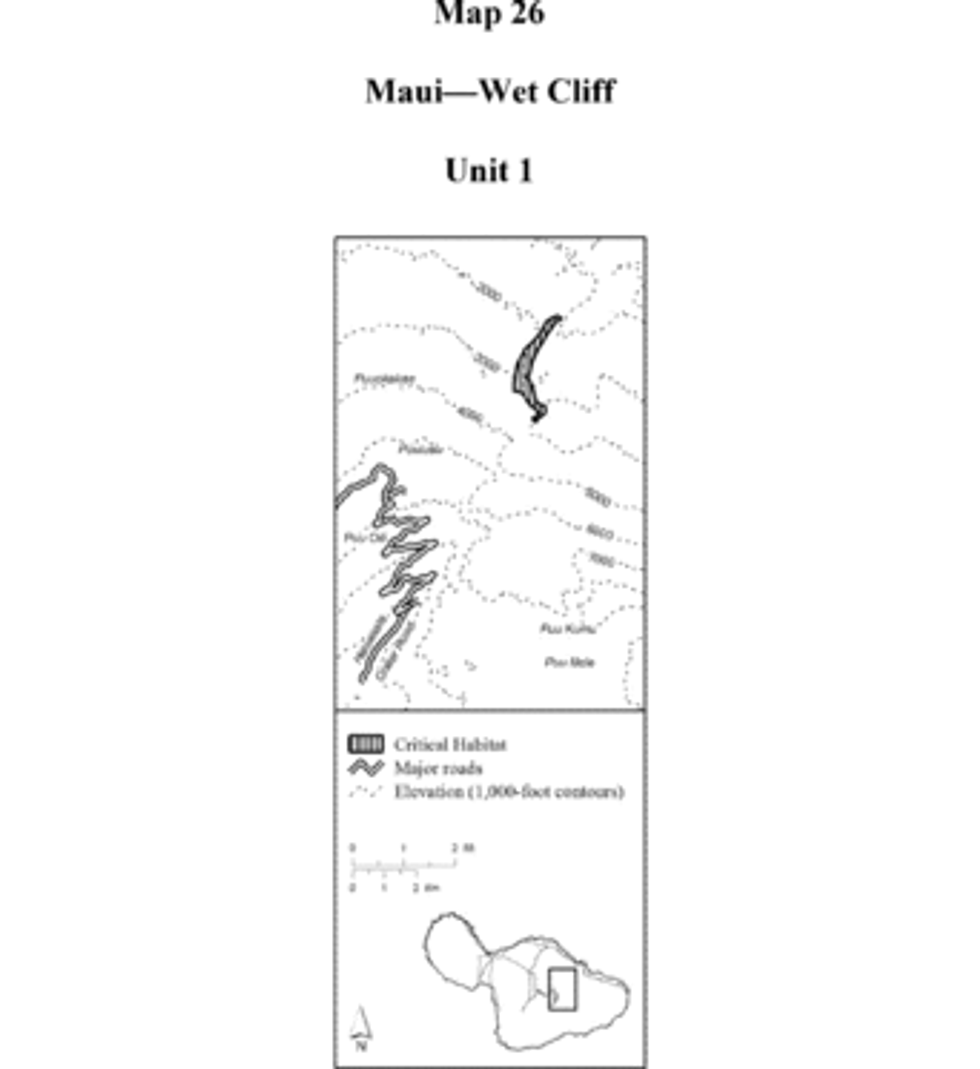
(xxvii) Maui--Wet Cliff--Unit 2 (1,407 ac, 569 ha), Maui--Wet Cliff--Unit 3 (438 ac, 177 ha), and Maui--Wet Cliff--Unit 4 (184 ac, 75 ha).
(A) These units are critical habitat for Bidens campylotheca ssp. pentamera, Bidens campylotheca ssp. waihoiensis, Cyanea copelandii ssp. haleakalaensis, Cyanea horrida, Melicope ovalis, Phyllostegia bracteata, Phyllostegia haliakalae, and Plantago princeps.
(D) Map of Maui--Wet Cliff--Unit 2, Maui--Wet Cliff--Unit 3, and Maui--Wet Cliff--Unit 4 (Map 27) follows:
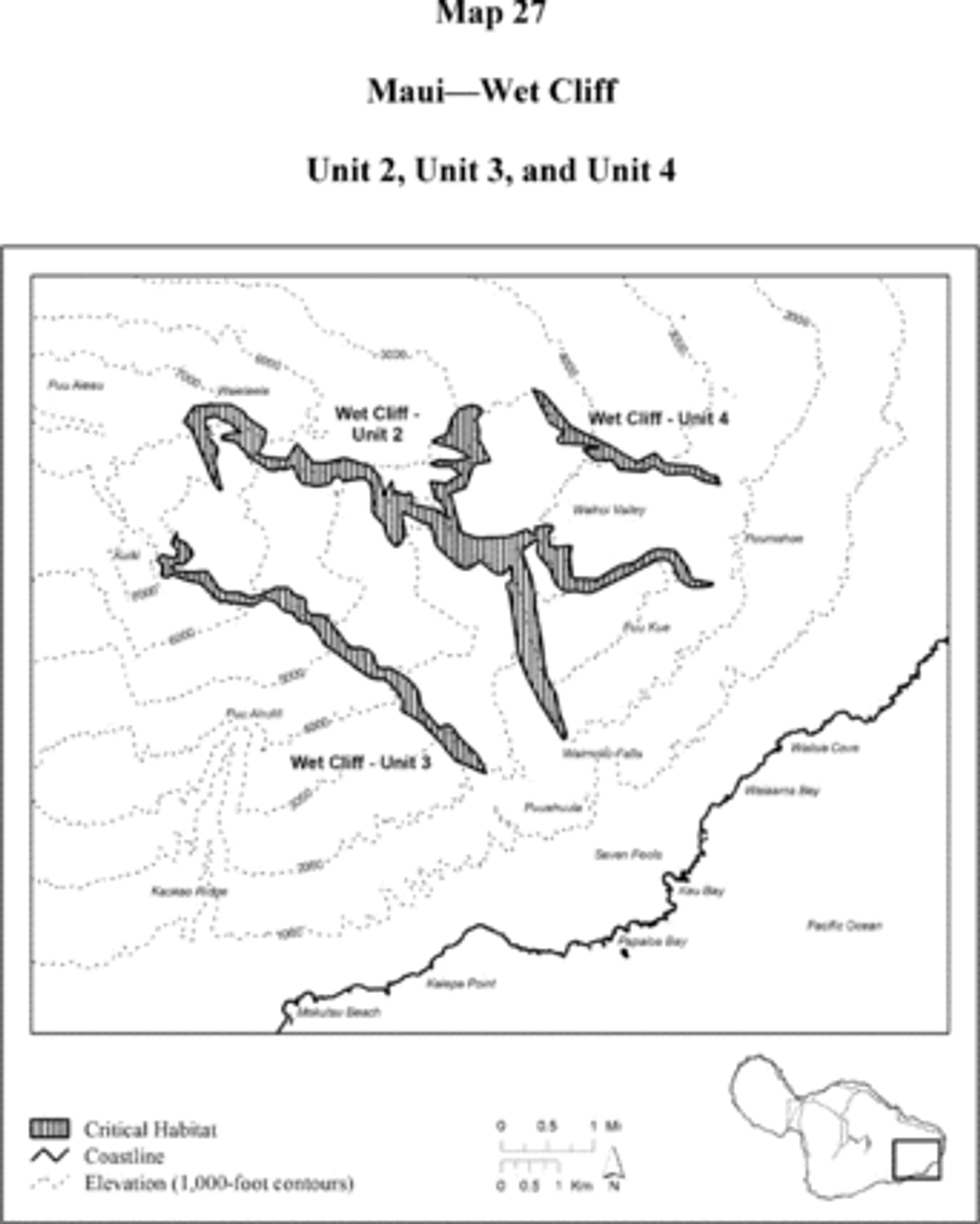
(xxviii) Maui--Wet Cliff--Unit 6 (2,111 ac, 854 ha), Maui--Wet Cliff--Unit 7 (557 ac, 225 ha), and Maui--Wet Cliff--Unit 8 (337 ac, 137 ha).
(A) These units are critical habitat for Alectryon macrococcus, Bidens campylotheca ssp. pentamera, Bidens conjuncta, Bonamia menziesii, Ctenitis squamigera, Cyanea glabra, Cyanea lobata, Cyanea magnicalyx, Cyrtandra filipes, Cyrtandra munroi, Dubautia plantaginea ssp. humilis, Gouania vitifolia, Hesperomannia arborescens, Hesperomannia arbuscula, Isodendrion pyrifolium, Kadua laxiflora, Lysimachia lydgatei, Plantago princeps, Platanthera holochila, Pteris lidgatei, Remya mauiensis, Santalum haleakalae var. lanaiense, and Tetramolopium capillare.
(B) Maui--Wet Cliff--Unit 6, Maui--Wet Cliff--Unit 7, and Maui--Wet Cliff--Unit 8 (Map 28) follows:

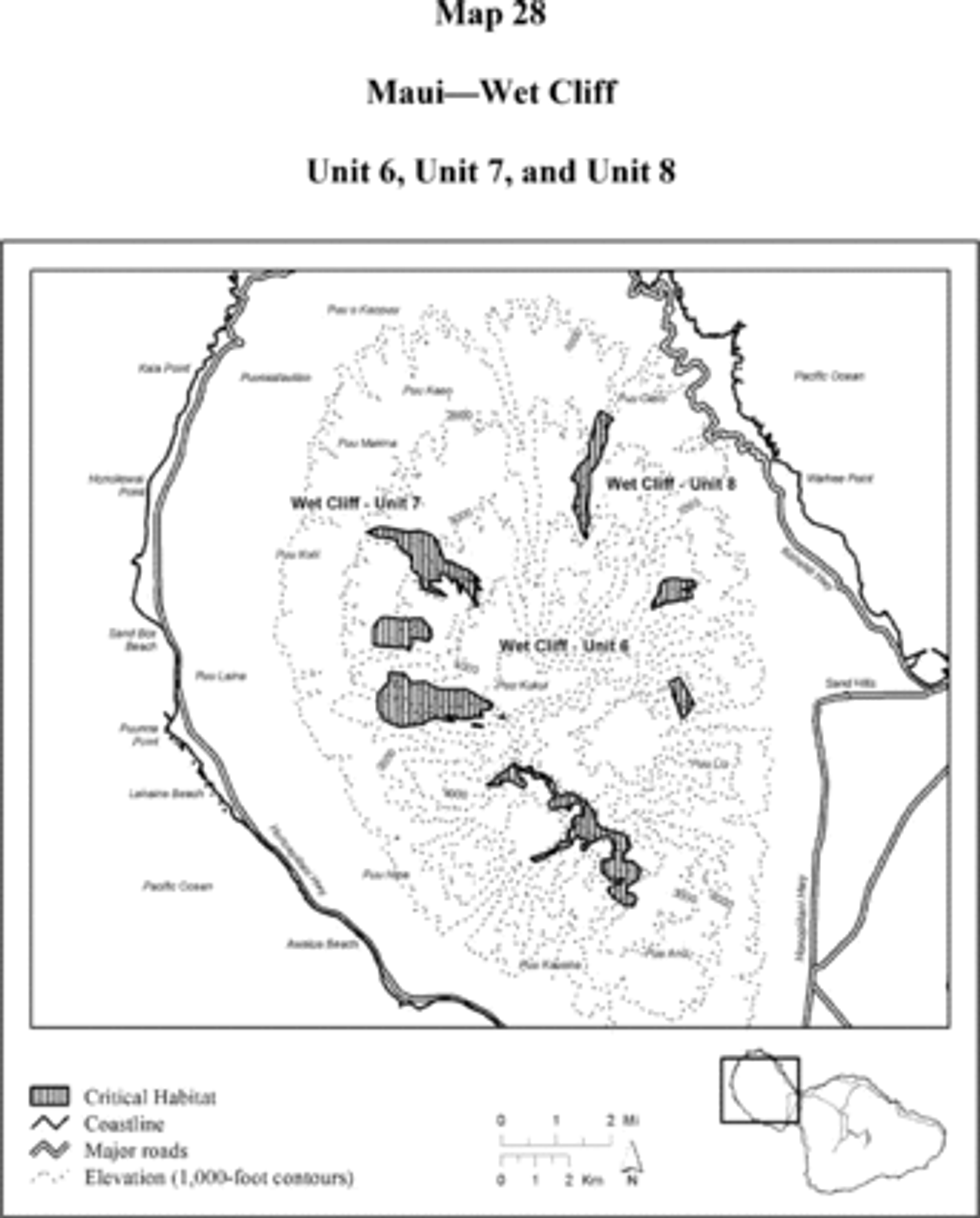
(xxix) OCCUPANCY OF SPECIES BY DESIGNATED CRITICAL HABITAT UNITS FOR MAUI
| Unit name | Species occupied | Species unoccupied |
|---|---|---|
| Maui - Coastal - Unit 1 | Brighamia rockii. | |
| Cyperus pennatiformis. | ||
| Ischaemum byrone. | ||
| Peucedanum sandwicense | ||
| Vigna o-wahuensis. | ||
| Maui - Coastal - Unit 2 | Brighamia rockii. | |
| Cyperus pennatiformis. | ||
| Ischaemum byrone. | ||
| Peucedanum sandwicense. | ||
| Vigna o-wahuensis. | ||
| Maui - Coastal - Unit 3 | Brighamia rockii. | |
| Cyperus pennatiformis. | ||
| Ischaemum byrone | ||
| Peucedanum sandwicense. | ||
| Vigna o-wahuensis. | ||
| Maui - Coastal - Unit 4 | Brighamia rockii. | |
| Cyperus pennatiformis | ||
| Ischaemum byrone. | ||
| Peucedanum sandwicense. | ||
| Vigna o-wahuensis. | ||
| Maui - Coastal - Unit 5 | Brighamia rockii. | |
| Cyperus pennatiformis. | ||
| Ischaemum byrone | ||
| Peucedanum sandwicense. | ||
| Vigna o-wahuensis. | ||
| Maui - Coastal - Unit 6 | Brighamia rockii. | |
| Cyperus pennatiformis. | ||
| Ischaemum byrone. | ||
| Peucedanum sandwicense. | ||
| Vigna o-wahuensis | ||
| Maui - Coastal - Unit 7 | Brighamia rockii. | |
| Cyperus pennatiformis. | ||
| Ischaemum byrone. | ||
| Peucedanum sandwicense. | ||
| Vigna o-wahuensis. | ||
| Maui - Coastal - Unit 8 | Brighamia rockii. | |
| Cyperus pennatiformis. | ||
| Ischaemum byrone. | ||
| Peucedanum sandwicense. | ||
| Vigna o-wahuensis. | ||
| Maui - Coastal - Unit 9 | Brighamia rockii. | |
| Schenkia sebaeoides | ||
| Sesbania tomentosa | ||
| Maui - Coastal - Unit 10 | Brighamia rockii. | |
| Schenkia sebaeoides | ||
| Sesbania tomentosa. | ||
| Maui - Coastal - Unit 11 | Brighamia rockii. | |
| Schenkia sebaeoides. | ||
| Sesbania tomentosa. | ||
| Maui - Lowland Dry - Unit 1 | Alectryon macrococcus. | |
| Bidens micrantha ssp. kalealaha. | ||
| Bonamia menziesii | ||
| Canavalia pubescens. | ||
| Cenchrus agrimonioides | ||
| Colubrina oppositifolia. | ||
| Ctenitis squamigera. | ||
| Flueggea neowawraea | ||
| Hibiscus brackenridgei. | ||
| Melanthera kamolensis. | ||
| Melicope adscendens | ||
| Melicope mucronulata. | ||
| Neraudia sericea. | ||
| Nototrichium humile. | ||
| Santalum haleakalae var. lanaiense | ||
| Sesbania tomentosa. | ||
| Solanum incompletum. | ||
| Spermolepis hawaiiensis | ||
| Zanthoxylum hawaiiense. | ||
| Maui - Lowland Dry - Unit 2 | Alectryon macrococcus. | |
| Bidens micrantha ssp. kalealaha. | ||
| Bonamia menziesii | ||
| Canavalia pubescens | ||
| Cenchrus agrimonioides. | ||
| Colubrina oppositifolia. | ||
| Ctenitis squamigera. | ||
| Flueggea neowawraea. | ||
| Hibiscus brackenridgei | ||
| Melanthera kamolensis. | ||
| Melicope mucronulata. | ||
| Neraudia sericea. | ||
| Nototrichium humile. | ||
| Santalum haleakalae var. lanaiense. | ||
| Sesbania tomentosa. | ||
| Solanum incompletum. | ||
| Spermolepis hawaiiensis. | ||
| Zanthoxylum hawaiiense. | ||
| Maui - Lowland Dry - Unit 3 | Bidens micrantha ssp. kalealaha. | |
| Bonamia menziesii. | ||
| Canavalia pubescens | ||
| Cenchrus agrimonioides. | ||
| Colubrina oppositifolia. | ||
| Ctenitis squamigera. | ||
| Flueggea neowawraea. | ||
| Hibiscus brackenridgei. | ||
| Melanthera kamolensis. | ||
| Melicope mucronulata. | ||
| Neraudia sericea. | ||
| Nototrichium humile. | ||
| Santalum haleakalae var. lanaiense. | ||
| Sesbania tomentosa. | ||
| Solanum incompletum. | ||
| Spermolepis hawaiiensis. | ||
| Zanthoxylum hawaiiense. | ||
| Maui - Lowland Dry - Unit 4 | Bidens micrantha ssp. kalealaha. | |
| Bonamia menziesii. | ||
| Canavalia pubescens. | ||
| Cenchrus agrimonioides. | ||
| Colubrina oppositifolia. | ||
| Ctenitis squamigera. | ||
| Flueggea neowawraea. | ||
| Hibiscus brackenridgei. | ||
| Melanthera kamolensis. | ||
| Melicope mucronulata. | ||
| Neraudia sericea. | ||
| Nototrichium humile. | ||
| Santalum haleakalae var. lanaiense. | ||
| Sesbania tomentosa. | ||
| Solanum incompletum. | ||
| Spermolepis hawaiiensis. | ||
| Zanthoxylum hawaiiense. | ||
| Maui - Lowland Dry - Unit 5 | Asplenium dielerectum | |
| Bidens campylotheca ssp. pentamera | ||
| Cenchrus agrimonioides | ||
| Ctenitis squamigera. | ||
| Cyanea obtusa. | ||
| Gouania hillebrandii | ||
| Hesperomannia arbuscula. | ||
| Hibiscus brackenridgei. | ||
| Kadua coriacea | ||
| Lysimachia lydgatei. | ||
| Neraudia sericea. | ||
| Remya mauiensis | ||
| Santalum haleakalae var. lanaiense | ||
| Schiedea salicaria. | ||
| Sesbania tomentosa. | ||
| Spermolepis hawaiiensis | ||
| Tetramolopium capillare | ||
| Tetramolopium remyi. | ||
| Maui - Lowland Dry - Unit 6 | Asplenium dielerectum. | |
| Bidens campylotheca ssp. pentamera. | ||
| Cenchrus agrimonioides. | ||
| Ctenitis squamigera. | ||
| Cyanea obtusa. | ||
| Gouania hillebrandii. | ||
| Hesperomannia arbuscula. | ||
| Hibiscus brackenridgei | ||
| Kadua coriacea. | ||
| Lysimachia lydgatei. | ||
| Neraudia sericea. | ||
| Remya mauiensis. | ||
| Santalum haleakalae var. lanaiense. | ||
| Schiedea salicaria | ||
| Sesbania tomentosa. | ||
| Spermolepis hawaiiensis. | ||
| Tetramolopium capillare. | ||
| Tetramolopium remyi. | ||
| Maui-Lowland Mesic-Unit 1 | Ctenitis squamigera. | |
| Cyanea asplenifolia | ||
| Cyanea copelandii ssp. haleakalaensis | ||
| Phlegmariurus mannii | ||
| Solanum incompletum. | ||
| Maui - Lowland Mesic - Unit 2 | Asplenium dielerectum. | |
| Bidens campylotheca ssp. pentamera. | ||
| Colubrina oppositifolia. | ||
| Ctenitis squamigera | ||
| Remya mauiensis | ||
| Santalum haleakalae var. lanaiense | ||
| Zanthoxylum hawaiiense | ||
| Maui - Lowland Mesic - Unit 3 | Asplenium dielerectum. | |
| Bidens campylotheca ssp. pentamera. | ||
| Colubrina oppositifolia. | ||
| Ctenitis squamigera. | ||
| Remya mauiensis. | ||
| Santalum haleakalae var. lanaiense. | ||
| Zanthoxylum hawaiiense. | ||
| Maui-Lowland Wet-Unit 1 | Bidens campylotheca ssp. waihoiensis | |
| Clermontia oblongifolia ssp. mauiensis. | ||
| Clermontia peleana. | ||
| Clermontia samuelii | ||
| Cyanea asplenifolia | ||
| Cyanea copelandii ssp. haleakalaensis | ||
| Cyanea duvalliorum | ||
| Cyanea hamatiflora ssp. hamatiflora | ||
| Cyanea kunthiana | ||
| Cyanea maritae | ||
| Cyanea mceldowneyi | ||
| Melicope balloui | ||
| Melicope ovalis | ||
| Mucuna persericea. | ||
| Phlegmariurus mannii | ||
| Phyllostegia haliakalae. | ||
| Wikstroemia villosa. | ||
| Maui-Lowland Wet-Unit 2 | Alectryon macrococcus. | |
| Asplenium dielerectum. | ||
| Bidens conjuncta. | ||
| Bidens micrantha ssp. kalealaha. | ||
| Clermontia oblongifolia ssp. mauiensis. | ||
| Ctenitis squamigera. | ||
| Cyanea asplenifolia. | ||
| Cyanea glabra. | ||
| Cyanea kunthiana. | ||
| Cyanea lobata. | ||
| Cyanea magnicalyx. | ||
| Cyrtandra filipes. | ||
| Cyrtandra munroi. | ||
| Diplazium molokaiense. | ||
| Hesperomannia arborescens. | ||
| Hesperomannia arbuscula. | ||
| Isodendrion pyrifolium. | ||
| Kadua laxiflora. | ||
| Peucedanum sandwicense. | ||
| Phlegmariurus mannii. | ||
| Phyllostegia bracteata. | ||
| Pteris lidgatei. | ||
| Remya mauiensis. | ||
| Santalum haleakalae var. lanaiense | ||
| Wikstroemia villosa. | ||
| Maui-Lowland Wet-Unit 3 | Alectryon macrococcus. | |
| Asplenium dielerectum. | ||
| Bidens conjuncta | ||
| Bidens micrantha ssp. kalealaha. | ||
| Clermontia oblongifolia ssp. mauiensis. | ||
| Ctenitis squamigera. | ||
| Cyanea asplenifolia | ||
| Cyanea glabra. | ||
| Cyanea kunthiana. | ||
| Cyanea lobata. | ||
| Cyanea magnicalyx. | ||
| Cyrtandra filipes. | ||
| Cyrtandra munroi. | ||
| Diplazium molokaiense. | ||
| Hesperomannia arborescens. | ||
| Hesperomannia arbuscula. | ||
| Isodendrion pyrifolium. | ||
| Kadua laxiflora. | ||
| Peucedanum sandwicense. | ||
| Phlegmariurus mannii. | ||
| Phyllostegia bracteata. | ||
| Pteris lidgatei | ||
| Remya mauiensis. | ||
| Santalum haleakalae var. lanaiense. | ||
| Wikstroemia villosa. | ||
| Maui-Lowland Wet-Unit 4 | Alectryon macrococcus. | |
| Asplenium dielerectum. | ||
| Bidens conjuncta. | ||
| Bidens micrantha ssp. kalealaha. | ||
| Clermontia oblongifolia ssp. mauiensis. | ||
| Ctenitis squamigera. | ||
| Cyanea asplenifolia | ||
| Cyanea glabra. | ||
| Cyanea kunthiana. | ||
| Cyanea lobata. | ||
| Cyanea magnicalyx. | ||
| Cyrtandra filipes. | ||
| Cyrtandra munroi. | ||
| Diplazium molokaiense. | ||
| Hesperomannia arborescens. | ||
| Hesperomannia arbuscula. | ||
| Isodendrion pyrifolium. | ||
| Kadua laxiflora. | ||
| Peucedanum sandwicense. | ||
| Phlegmariurus mannii. | ||
| Phyllostegia bracteata. | ||
| Pteris lidgatei. | ||
| Remya mauiensis. | ||
| Santalum haleakalae var. lanaiense. | ||
| Wikstroemia villosa. | ||
| Maui-Lowland Wet-Unit 5 | Alectryon macrococcus. | |
| Asplenium dielerectum. | ||
| Bidens conjuncta. | ||
| Bidens micrantha ssp. kalealaha. | ||
| Clermontia oblongifolia ssp. mauiensis. | ||
| Ctenitis squamigera. | ||
| Cyanea asplenifolia. | ||
| Cyanea glabra. | ||
| Cyanea kunthiana. | ||
| Cyanea lobata. | ||
| Cyanea magnicalyx. | ||
| Cyrtandra filipes. | ||
| Cyrtandra munroi. | ||
| Diplazium molokaiense. | ||
| Hesperomannia arborescens. | ||
| Hesperomannia arbuscula. | ||
| Isodendrion pyrifolium. | ||
| Kadua laxiflora. | ||
| Peucedanum sandwicense. | ||
| Phlegmariurus mannii. | ||
| Phyllostegia bracteata. | ||
| Pteris lidgatei. | ||
| Remya mauiensis. | ||
| Santalum haleakalae var. lanaiense. | ||
| Wikstroemia villosa. | ||
| Maui-Lowland Wet-Unit 6 | Alectryon macrococcus. | |
| Asplenium dielerectum. | ||
| Bidens conjuncta. | ||
| Bidens micrantha ssp. kalealaha. | ||
| Clermontia oblongifolia ssp. mauiensis. | ||
| Ctenitis squamigera. | ||
| Cyanea asplenifolia. | ||
| Cyanea glabra. | ||
| Cyanea kunthiana. | ||
| Cyanea lobata. | ||
| Cyanea magnicalyx. | ||
| Cyrtandra filipes. | ||
| Cyrtandra munroi. | ||
| Diplazium molokaiense. | ||
| Hesperomannia arborescens. | ||
| Hesperomannia arbuscula. | ||
| Isodendrion pyrifolium. | ||
| Kadua laxiflora. | ||
| Peucedanum sandwicense. | ||
| Phlegmariurus mannii. | ||
| Phyllostegia bracteata. | ||
| Pteris lidgatei. | ||
| Remya mauiensis. | ||
| Santalum haleakalae var. lanaiense | ||
| Wikstroemia villosa. | ||
| Maui-Lowland Wet-Unit 7 | Alectryon macrococcus | |
| Asplenium dielerectum. | ||
| Bidens conjuncta. | ||
| Bidens micrantha ssp. kalealaha. | ||
| Clermontia oblongifolia ssp. mauiensis. | ||
| Ctenitis squamigera. | ||
| Cyanea asplenifolia. | ||
| Cyanea glabra. | ||
| Cyanea kunthiana. | ||
| Cyanea lobata. | ||
| Cyanea magnicalyx. | ||
| Cyrtandra filipes. | ||
| Cyrtandra munroi. | ||
| Diplazium molokaiense. | ||
| Hesperomannia arborescens. | ||
| Hesperomannia arbuscula. | ||
| Isodendrion pyrifolium. | ||
| Kadua laxiflora. | ||
| Peucedanum sandwicense. | ||
| Phlegmariurus mannii. | ||
| Phyllostegia bracteata. | ||
| Pteris lidgatei. | ||
| Remya mauiensis. | ||
| Santalum haleakalae var. lanaiense. | ||
| Wikstroemia villosa. | ||
| Maui-Lowland Wet-Unit 8 | Alectryon macrococcus. | |
| Asplenium dielerectum. | ||
| Bidens conjuncta. | ||
| Bidens micrantha ssp. kalealaha. | ||
| Clermontia oblongifolia ssp. mauiensis. | ||
| Ctenitis squamigera. | ||
| Cyanea asplenifolia. | ||
| Cyanea glabra. | ||
| Cyanea kunthiana. | ||
| Cyanea lobata. | ||
| Cyanea magnicalyx. | ||
| Cyrtandra filipes. | ||
| Cyrtandra munroi. | ||
| Diplazium molokaiense. | ||
| Hesperomannia arborescens. | ||
| Hesperomannia arbuscula. | ||
| Isodendrion pyrifolium. | ||
| Kadua laxiflora. | ||
| Peucedanum sandwicense. | ||
| Phlegmariurus mannii. | ||
| Phyllostegia bracteata. | ||
| Pteris lidgatei. | ||
| Remya mauiensis. | ||
| Santalum haleakalae var. lanaiense. | ||
| Wikstroemia villosa. | ||
| Maui-Montane Wet-Unit 1 | Adenophorus periens. | |
| Asplenium peruvianum var. insulare. | ||
| Bidens campylotheca ssp. pentamera. | ||
| Bidens campylotheca ssp. waihoiensis. | ||
| Clermontia oblongifolia ssp. mauiensis. | ||
| Clermontia samuelii. | ||
| Cyanea copelandii ssp. haleakalaensis. | ||
| Cyanea duvalliorum | ||
| Cyanea glabra. | ||
| Cyanea hamatiflora ssp. hamatiflora. | ||
| Cyanea horrida. | ||
| Cyanea kunthiana. | ||
| Cyanea maritae | ||
| Cyanea mceldowneyi | ||
| Cyrtandra ferripilosa. | ||
| Diplazium molokaiense. | ||
| Geranium hanaense. | ||
| Geranium multiflorum. | ||
| Melicope balloui | ||
| Melicope ovalis. | ||
| Peperomia subpetiolata. | ||
| Phlegmariurus mannii | ||
| Phyllostegia bracteata. | ||
| Phyllostegia haliakalae. | ||
| Phyllostegia mannii. | ||
| Phyllostegia pilosa | ||
| Platanthera holochila. | ||
| Schiedea jacobii. | ||
| Wikstroemia villosa. | ||
| Maui-Montane Wet-Unit 2 | Adenophorus periens. | |
| Asplenium peruvianum var. insulare. | ||
| Bidens campylotheca ssp. pentamera | ||
| Bidens campylotheca ssp. waihoiensis. | ||
| Clermontia oblongifolia ssp. mauiensis. | ||
| Clermontia samuelii | ||
| Cyanea copelandii ssp. haleakalaensis | ||
| Cyanea duvalliorum | ||
| Cyanea glabra. | ||
| Cyanea hamatiflora ssp. hamatiflora | ||
| Cyanea horrida | ||
| Cyanea kunthiana | ||
| Cyanea maritae. | ||
| Cyanea mceldowneyi | ||
| Cyrtandra ferripilosa. | ||
| Diplazium molokaiense. | ||
| Geranium hanaense | ||
| Geranium multiflorum | ||
| Melicope balloui. | ||
| Melicope ovalis. | ||
| Peperomia subpetiolata. | ||
| Phlegmariurus mannii. | ||
| Phyllostegia bracteata. | ||
| Phyllostegia haliakalae. | ||
| Phyllostegia mannii. | ||
| Phyllostegia pilosa. | ||
| Platanthera holochila. | ||
| Schiedea jacobii. | ||
| Wikstroemia villosa | ||
| Maui-Montane Wet-Unit 3 | Adenophorus periens. | |
| Asplenium peruvianum var. insulare. | ||
| Bidens campylotheca ssp. pentamera | ||
| Bidens campylotheca ssp. waihoiensis | ||
| Clermontia oblongifolia ssp. mauiensis. | ||
| Clermontia samuelii. | ||
| Cyanea copelandii ssp. haleakalaensis | ||
| Cyanea duvalliorum. | ||
| Cyanea glabra. | ||
| Cyanea hamatiflora ssp. hamatiflora | ||
| Cyanea horrida. | ||
| Cyanea kunthiana. | ||
| Cyanea maritae | ||
| Cyanea mceldowneyi. | ||
| Cyrtandra ferripilosa. | ||
| Diplazium molokaiense. | ||
| Geranium hanaense. | ||
| Geranium multiflorum. | ||
| Melicope balloui. | ||
| Melicope ovalis | ||
| Peperomia subpetiolata. | ||
| Phlegmariurus mannii. | ||
| Phyllostegia bracteata. | ||
| Phyllostegia haliakalae. | ||
| Phyllostegia mannii. | ||
| Phyllostegia pilosa. | ||
| Platanthera holochila. | ||
| Schiedea jacobii. | ||
| Wikstroemia villosa. | ||
| Maui-Montane Wet-Unit 4 | Adenophorus periens. | |
| Asplenium peruvianum var. insulare. | ||
| Bidens campylotheca ssp. pentamera. | ||
| Bidens campylotheca ssp. waihoiensis. | ||
| Clermontia oblongifolia ssp. mauiensis. | ||
| Clermontia samuelii | ||
| Cyanea copelandii ssp. haleakalaensis | ||
| Cyanea duvalliorum. | ||
| Cyanea glabra. | ||
| Cyanea hamatiflora ssp. hamatiflora | ||
| Cyanea horrida | ||
| Cyanea kunthiana | ||
| Cyanea maritae | ||
| Cyanea mceldowneyi. | ||
| Cyrtandra ferripilosa | ||
| Diplazium molokaiense. | ||
| Geranium hanaense. | ||
| Geranium multiflorum. | ||
| Melicope balloui. | ||
| Melicope ovalis. | ||
| Peperomia subpetiolata. | ||
| Phlegmariurus mannii | ||
| Phyllostegia bracteata. | ||
| Phyllostegia haliakalae. | ||
| Phyllostegia mannii. | ||
| Phyllostegia pilosa. | ||
| Platanthera holochila. | ||
| Schiedea jacobii. | ||
| Wikstroemia villosa. | ||
| Maui-Montane Wet-Unit 5 | Adenophorus periens. | |
| Asplenium peruvianum var. insulare. | ||
| Bidens campylotheca ssp. pentamera | ||
| Bidens campylotheca ssp. waihoiensis. | ||
| Clermontia oblongifolia ssp. mauiensis. | ||
| Clermontia samuelii. | ||
| Cyanea copelandii ssp. haleakalaensis. | ||
| Cyanea duvalliorum. | ||
| Cyanea glabra. | ||
| Cyanea hamatiflora ssp. hamatiflora. | ||
| Cyanea horrida. | ||
| Cyanea kunthiana. | ||
| Cyanea maritae. | ||
| Cyanea mceldowneyi. | ||
| Cyrtandra ferripilosa. | ||
| Diplazium molokaiense. | ||
| Geranium hanaense. | ||
| Geranium multiflorum. | ||
| Melicope balloui. | ||
| Melicope ovalis. | ||
| Peperomia subpetiolata. | ||
| Phlegmariurus mannii. | ||
| Phyllostegia bracteata. | ||
| Phyllostegia haliakalae. | ||
| Phyllostegia mannii. | ||
| Phyllostegia pilosa. | ||
| Platanthera holochila. | ||
| Schiedea jacobii. | ||
| Wikstroemia villosa. | ||
| Maui-Montane Wet-Unit 6 | Acaena exigua. | |
| Bidens conjuncta | ||
| Calamagrostis hillebrandii | ||
| Cyanea kunthiana | ||
| Cyrtandra oxybapha. | ||
| Geranium hillebrandii | ||
| Myrsine vaccinioides | ||
| Phlegmariurus mannii. | ||
| Phyllostegia bracteata. | ||
| Platanthera holochila. | ||
| Sanicula purpurea | ||
| Maui-Montane Wet-Unit 7 | Acaena exigua. | |
| Bidens conjuncta. | ||
| Calamagrostis hillebrandii. | ||
| Cyanea kunthiana. | ||
| Cyrtandra oxybapha | ||
| Geranium hillebrandii. | ||
| Myrsine vaccinioides. | ||
| Phlegmariurus mannii. | ||
| Phyllostegia bracteata. | ||
| Platanthera holochila | ||
| Sanicula purpurea. | ||
| Maui-Montane Mesic-Unit 1 | Alectryon macrococcus. | |
| Argyroxiphium sandwicense ssp. macrocephalum | ||
| Asplenium dielerectum | ||
| Asplenium peruvianum var. insulare | ||
| Bidens campylotheca ssp. pentamera. | ||
| Bidens micrantha ssp. kalealaha. | ||
| Clermontia lindseyana | ||
| Cyanea glabra. | ||
| Cyanea hamatiflora ssp. hamatiflora. | ||
| Cyanea horrida | ||
| Cyanea kunthiana. | ||
| Cyanea mceldowneyi. | ||
| Cyanea obtusa | ||
| Cyrtandra ferripilosa | ||
| Cyrtandra oxybapha | ||
| Diplazium molokaiense | ||
| Geranium arboreum | ||
| Geranium multiflorum | ||
| Melicope adscendens | ||
| Neraudia sericea | ||
| Phlegmariurus mannii | ||
| Phyllostegia bracteata. | ||
| Phyllostegia mannii. | ||
| Santalum haleakalae var. lanaiense. | ||
| Wikstroemia villosa. | ||
| Zanthoxylum hawaiiense. | ||
| Maui-Montane Mesic-Unit 2 | Ctenitis squamigera | |
| Cyanea magnicalyx | ||
| Diplazium molokaiense | ||
| Geranium hillebrandii | ||
| Lysimachia lydgatei | ||
| Phlegmariurus mannii. | ||
| Remya mauiensis | ||
| Santalum haleakalae var. lanaiense | ||
| Stenogyne kauaulaensis. | ||
| Zanthoxylum hawaiiense. | ||
| Maui-Montane Mesic-Unit 3 | Ctenitis squamigera. | |
| Cyanea magnicalyx. | ||
| Diplazium molokaiense. | ||
| Geranium hillebrandii | ||
| Lysimachia lydgatei. | ||
| Phlegmariurus mannii. | ||
| Remya mauiensis. | ||
| Santalum haleakalae var. lanaiense. | ||
| Stenogyne kauaulaensis. | ||
| Zanthoxylum hawaiiense. | ||
| Maui-Montane Mesic-Unit 4 | Ctenitis squamigera. | |
| Cyanea magnicalyx. | ||
| Diplazium molokaiense. | ||
| Geranium hillebrandii. | ||
| Lysimachia lydgatei. | ||
| Phlegmariurus mannii. | ||
| Remya mauiensis. | ||
| Santalum haleakalae var. lanaiense. | ||
| Stenogyne kauaulaensis. | ||
| Zanthoxylum hawaiiense. | ||
| Maui-Montane Mesic-Unit 5 | Ctenitis squamigera. | |
| Cyanea magnicalyx. | ||
| Diplazium molokaiense. | ||
| Geranium hillebrandii. | ||
| Lysimachia lydgatei. | ||
| Phlegmariurus mannii. | ||
| Remya mauiensis | ||
| Santalum haleakalae var. lanaiense | ||
| Stenogyne kauaulaensis. | ||
| Zanthoxylum hawaiiense. | ||
| Maui - Montane Dry - Unit 1 | Alectryon macrococcus. | |
| Geranium arboreum. | ||
| Melicope knudsenii. | ||
| Melicope mucronulata. | ||
| Santalum haleakalae var. lanaiense. | ||
| Zanthoxylum hawaiiense. | ||
| Maui - Subalpine - Unit 1 | Argyroxiphium sandwicense ssp. macrocephalum. | |
| Asplenium peruvianum var. insulare. | ||
| Bidens micrantha ssp. kalealaha | ||
| Geranium arboreum | ||
| Geranium multiflorum. | ||
| Phyllostegia bracteata. | ||
| Schiedea haleakalensis. | ||
| Zanthoxylum hawaiiense. | ||
| Maui - Subalpine - Unit 2 | Argyroxiphium sandwicense ssp. macrocephalum | |
| Asplenium peruvianum var. insulare. | ||
| Bidens micrantha ssp. kalealaha. | ||
| Geranium arboreum. | ||
| Geranium multiflorum | ||
| Phyllostegia bracteata. | ||
| Schiedea haleakalensis | ||
| Zanthoxylum hawaiiense. | ||
| Maui - Alpine - Unit 1 | Argyroxiphium sandwicense ssp. macrocephalum | |
| Maui - Dry Cliff - Unit 1 | Argyroxiphium sandwicense ssp. macrocephalum. | |
| Bidens campylotheca ssp. pentamera. | ||
| Bidens micrantha ssp. kalealaha. | ||
| Diplazium molokaiense. | ||
| Geranium multiflorum. | ||
| Plantago princeps. | ||
| Schiedea haleakalensis. | ||
| Maui - Dry Cliff - Unit 2 | Argyroxiphium sandwicense ssp. macrocephalum | |
| Bidens campylotheca ssp. pentamera. | ||
| Bidens micrantha ssp. kalealaha. | ||
| Diplazium molokaiense. | ||
| Geranium multiflorum | ||
| Plantago princeps | ||
| Schiedea haleakalensis | ||
| Maui - Dry Cliff - Unit 3 | Argyroxiphium sandwicense ssp. macrocephalum. | |
| Bidens campylotheca ssp. pentamera. | ||
| Bidens micrantha ssp. kalealaha. | ||
| Diplazium molokaiense. | ||
| Geranium multiflorum. | ||
| Plantago princeps. | ||
| Schiedea haleakalensis. | ||
| Maui - Dry Cliff - Unit 4 | Argyroxiphium sandwicense ssp. macrocephalum. | |
| Bidens campylotheca ssp. pentamera. | ||
| Bidens micrantha ssp. kalealaha. | ||
| Diplazium molokaiense. | ||
| Geranium multiflorum. | ||
| Plantago princeps. | ||
| Schiedea haleakalensis. | ||
| Maui - Dry Cliff - Unit 5 | Bonamia menziesii. | |
| Diplazium molokaiense. | ||
| Hesperomannia arbuscula. | ||
| Isodendrion pyrifolium. | ||
| Kadua laxiflora. | ||
| Neraudia sericea. | ||
| Tetramolopium capillare | ||
| Maui - Dry Cliff - Unit 6 | Bonamia menziesii. | |
| Diplazium molokaiense. | ||
| Hesperomannia arbuscula. | ||
| Isodendrion pyrifolium. | ||
| Kadua laxiflora. | ||
| Neraudia sericea. | ||
| Tetramolopium capillare. | ||
| Maui - Wet Cliff - Unit 1 | Bidens campylotheca ssp. pentamera. | |
| Bidens campylotheca ssp. waihoiensis. | ||
| Cyanea copelandii ssp. haleakalaensis. | ||
| Cyanea horrida. | ||
| Melicope ovalis. | ||
| Phyllostegia bracteata. | ||
| Phyllostegia haliakalae. | ||
| Plantago princeps. | ||
| Maui - Wet Cliff - Unit 2 | Bidens campylotheca ssp. pentamera. | |
| Bidens campylotheca ssp. waihoiensis | ||
| Cyanea copelandii ssp. haleakalaensis | ||
| Cyanea horrida. | ||
| Melicope ovalis | ||
| Phyllostegia bracteata | ||
| Phyllostegia haliakalae. | ||
| Plantago princeps | ||
| Maui - Wet Cliff - Unit 3 | Bidens campylotheca ssp. pentamera. | |
| Bidens campylotheca ssp. waihoiensis. | ||
| Cyanea copelandii ssp. haleakalaensis. | ||
| Cyanea horrida. | ||
| Melicope ovalis. | ||
| Phyllostegia bracteata. | ||
| Phyllostegia haliakalae. | ||
| Plantago princeps. | ||
| Maui - Wet Cliff - Unit 4 | Bidens campylotheca ssp. pentamera | |
| Bidens campylotheca ssp. waihoiensis | ||
| Cyanea copelandii ssp. haleakalaensis. | ||
| Cyanea horrida. | ||
| Melicope ovalis. | ||
| Phyllostegia bracteata. | ||
| Phyllostegia haliakalae. | ||
| Plantago princeps. | ||
| Maui - Wet Cliff - Unit 6 | Alectryon macrococcus | |
| Bidens campylotheca ssp. pentamera. | ||
| Bidens conjuncta. | ||
| Bonamia menziesii. | ||
| Ctenitis squamigera | ||
| Cyanea glabra. | ||
| Cyanea lobata. | ||
| Cyanea magnicalyx. | ||
| Cyrtandra filipes. | ||
| Cyrtandra munroi | ||
| Dubautia plantaginea ssp. humilis. | ||
| Gouania vitifolia. | ||
| Hesperomannia arborescens. | ||
| Hesperomannia arbuscula. | ||
| Isodendrion pyrifolium. | ||
| Kadua laxiflora. | ||
| Lysimachia lydgatei. | ||
| Plantago princeps. | ||
| Platanthera holochila. | ||
| Pteris lidgatei. | ||
| Remya mauiensis | ||
| Santalum haleakalae var. lanaiense | ||
| Tetramolopium capillare. | ||
| Maui - Wet Cliff - Unit 7 | Alectryon macrococcus. | |
| Bidens campylotheca ssp. pentamera. | ||
| Bidens conjuncta. | ||
| Bonamia menziesii. | ||
| Ctenitis squamigera. | ||
| Cyanea glabra. | ||
| Cyanea lobata. | ||
| Cyanea magnicalyx. | ||
| Cyrtandra filipes | ||
| Cyrtandra munroi | ||
| Dubautia plantaginea ssp. humilis. | ||
| Gouania vitifolia. | ||
| Hesperomannia arborescens. | ||
| Hesperomannia arbuscula. | ||
| Isodendrion pyrifolium. | ||
| Kadua laxiflora. | ||
| Lysimachia lydgatei. | ||
| Plantago princeps. | ||
| Platanthera holochila. | ||
| Pteris lidgatei. | ||
| Remya mauiensis. | ||
| Santalum haleakalae var. lanaiense. | ||
| Tetramolopium capillare. | ||
| Maui - Wet Cliff - Unit 8 | Alectryon macrococcus. | |
| Bidens campylotheca ssp. pentamera. | ||
| Bidens conjuncta. | ||
| Bonamia menziesii. | ||
| Ctenitis squamigera. | ||
| Cyanea glabra. | ||
| Cyanea lobata. | ||
| Cyanea magnicalyx. | ||
| Cyrtandra filipes. | ||
| Cyrtandra munroi. | ||
| Dubautia plantaginea ssp. humilis. | ||
| Gouania vitifolia. | ||
| Hesperomannia arborescens. | ||
| Hesperomannia arbuscula. | ||
| Isodendrion pyrifolium. | ||
| Kadua laxiflora. | ||
| Lysimachia lydgatei. | ||
| Plantago princeps. | ||
| Platanthera holochila. | ||
| Pteris lidgatei. | ||
| Remya mauiensis. | ||
| Santalum haleakalae var. lanaiense. | ||
| Tetramolopium capillare. |
(2) Kahoolawe. Critical habitat units are described below. Coordinates are in UTM Zone 4 with units in meters using North American Datum of 1983 (NAD83). The following maps shows the locations of the critical habitat units designated on the island of Kahoolawe. Existing manmade features and structures, such as buildings, roads, railroads, airports, runways, other paved areas, lawns, and other urban landscaped areas, do not contain one or more of the physical and biological features. Federal actions limited to those areas, therefore, would not trigger a consultation under section 7 of the Act unless they may affect the species or physical or biological features in adjacent critical habitat.
(i) NOTE: Map 29, Kahoolawe Index Map, follows:
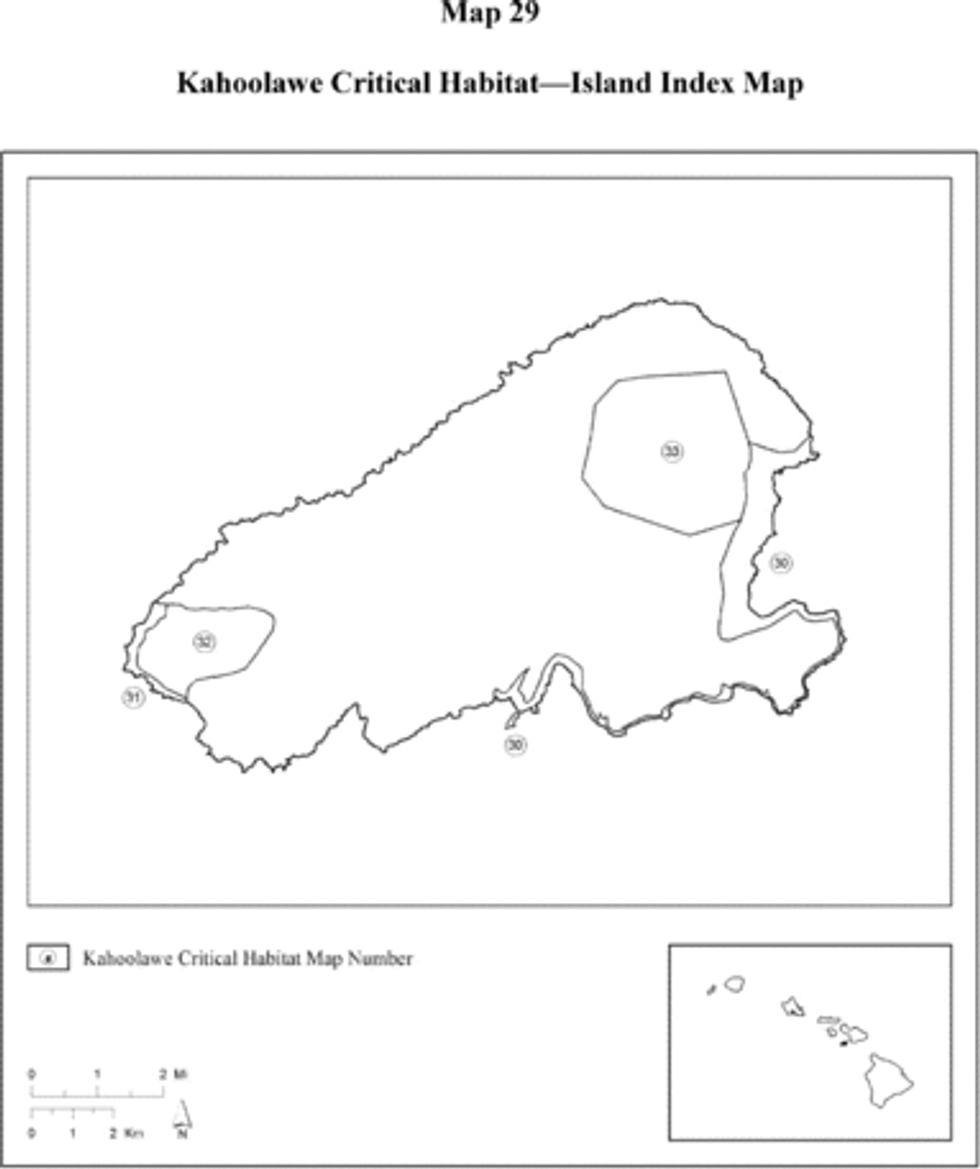
(ii) Kahoolawe--Coastal--Unit 1 (1,516 ac, 613 ha) and Kahoolawe--Coastal--Unit 2 (12 ac, 5 ha).
(A) These units are critical habitat for Kanaloa kahoolawensis, Sesbania tomentosa, and Vigna o-wahuensis.
(B) Map of Kahoolawe--Coastal--Unit 1 and Kahoolawe--Coastal--Unit 2 (Map 30) follows:
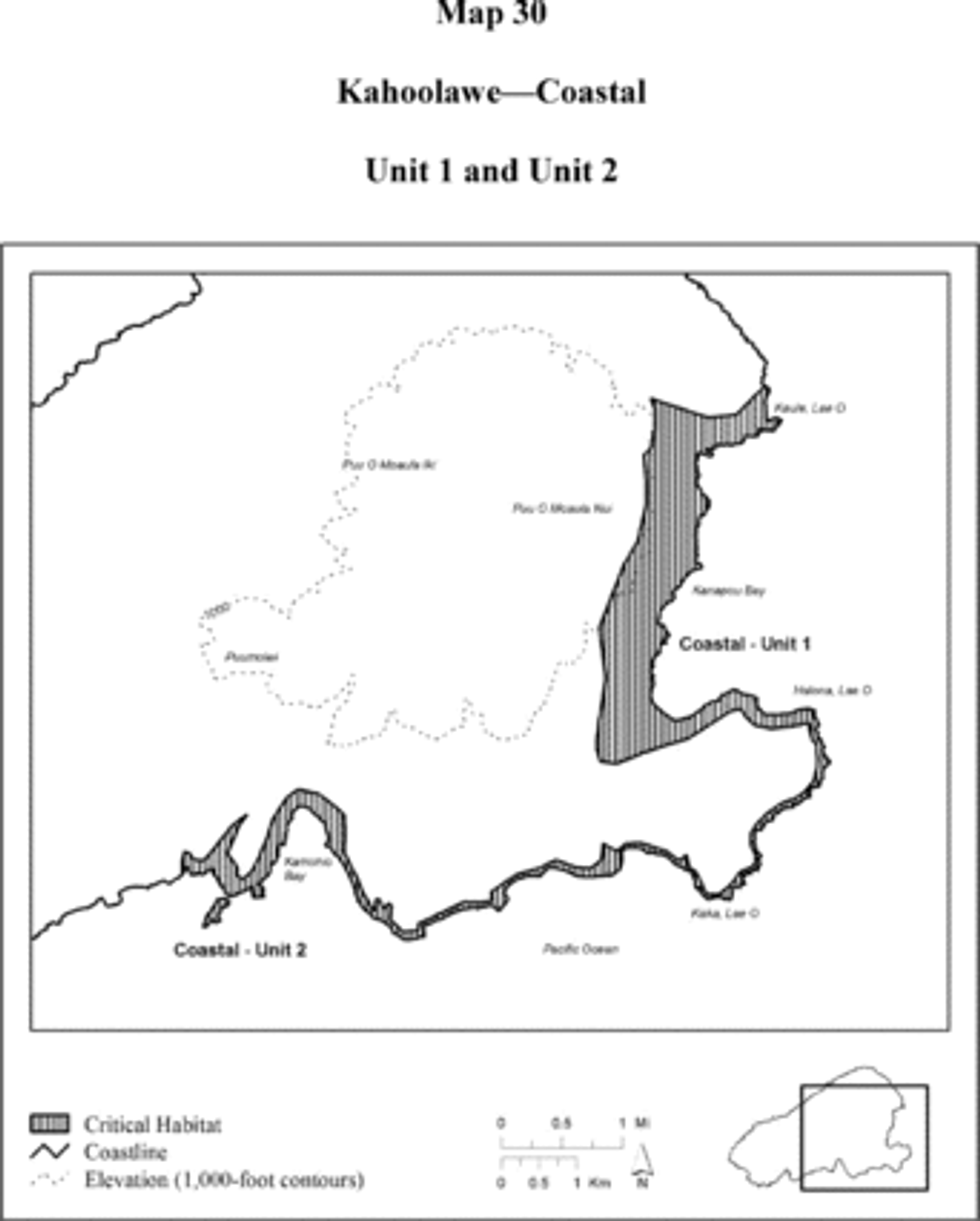
(iii) Kahoolawe--Coastal--Unit 3 (189 ac, 76 ha).
(A) This unit is critical habitat for Kanaloa kahoolawensis, Sesbania tomentosa, and Vigna o-wahuensis.
(B) Map of Kahoolawe--Coastal--Unit 3 (Map 31) follows:

(iv) Kahoolawe--Lowland Dry--Unit 1 (1,220 ac, 494 ha).
(A) This unit is critical habitat for Gouania hillebrandii, Hibiscus brackenridgei, Kanaloa kahoolawensis, Neraudia sericea, Sesbania tomentosa, and Vigna o-wahuensis.
(B) Map of Kahoolawe--Lowland Dry--Unit 1 (Map 32) follows:
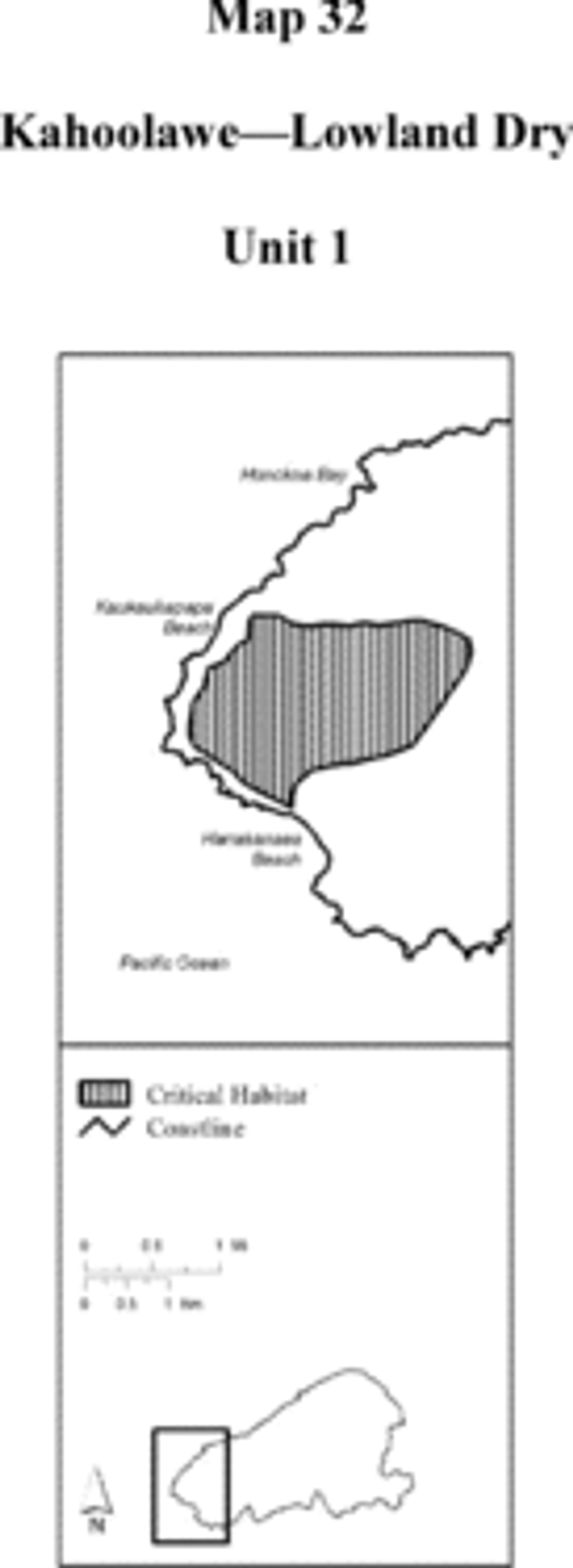
(v) Kahoolawe--Lowland Dry--Unit 2 (3,205 ac, 1,297 ha).
(A) This unit is critical habitat for Gouania hillebrandii, Hibiscus brackenridgei, Kanaloa kahoolawensis, Neraudia sericea, Sesbania tomentosa, and Vigna o-wahuensis.
(B) Map of Kahoolawe--Lowland Dry--Unit 2 (Map 33) follows:
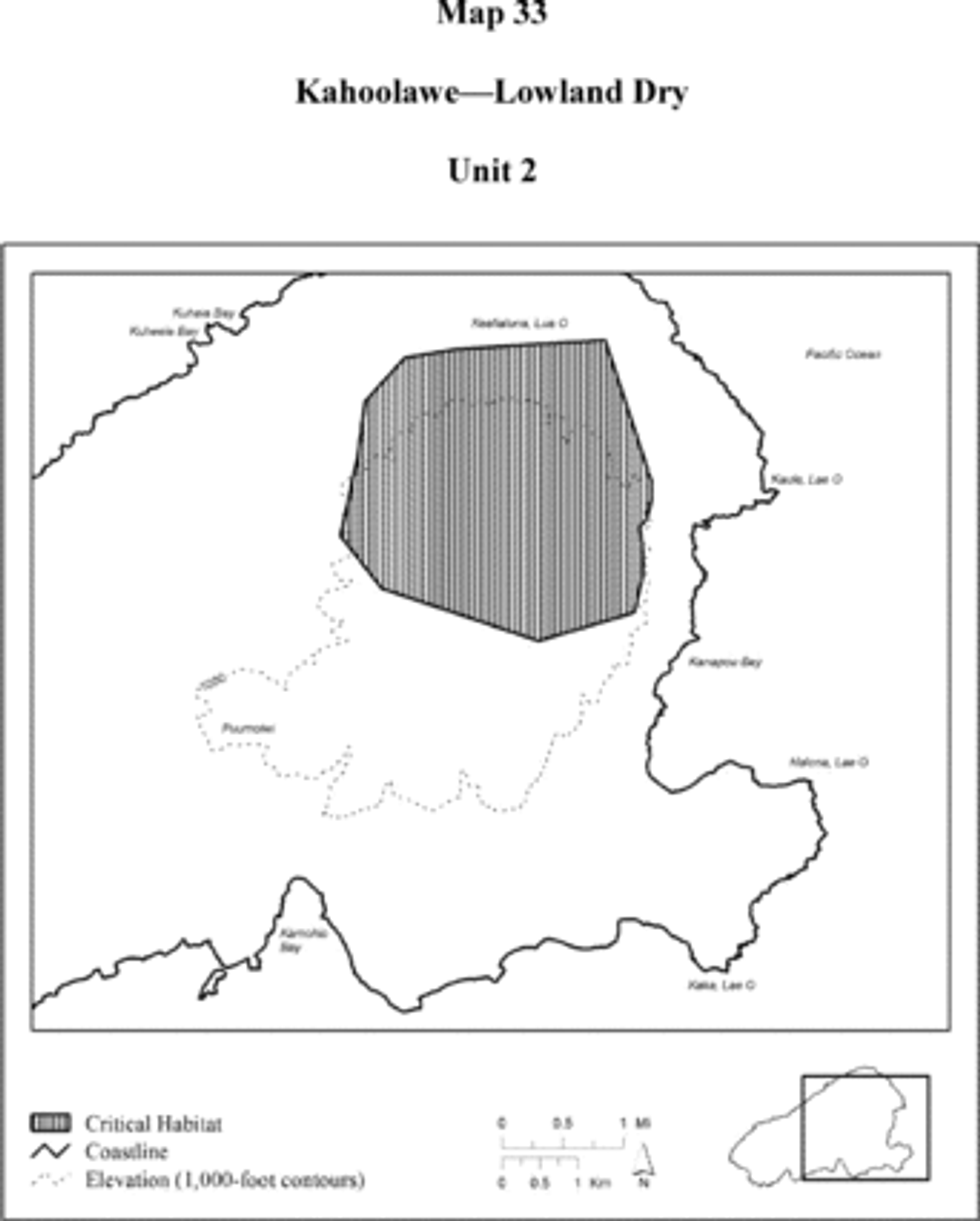
| Unit name | Species occupied | Species unoccupied |
|---|---|---|
| Kahoolawe - Coastal - Unit 1 | Kanaloa kahoolawensis | |
| Sesbania tomentosa. | ||
| Vigna o-wahuensis. | ||
| Kahoolawe - Coastal - Unit 2 | Kanaloa kahoolawensis. | |
| Sesbania tomentosa | ||
| Vigna o-wahuensis. | ||
| Kahoolawe - Coastal - Unit 3 | Kanaloa kahoolawensis. | |
| Sesbania tomentosa. | ||
| Vigna o-wahuensis. | ||
| Kahoolawe - Lowland Dry - Unit 1 | Gouania hillebrandii. | |
| Hibiscus brackenridgei. | ||
| Kanaloa kahoolawensis. | ||
| Neraudia sericea. | ||
| Sesbania tomentosa. | ||
| Vigna o-wahuensis. | ||
| Kahoolawe - Lowland Dry - Unit 2 | Gouania hillebrandii. | |
| Hibiscus brackenridgei. | ||
| Kanaloa kahoolawensis. | ||
| Neraudia sericea. | ||
| Sesbania tomentosa. | ||
| Vigna o-wahuensis. |
(f) Plants on Maui and Kahoolawe; Constituent elements - (1) Flowering plants.
Family Amaranthaceae
Nototrichium humile (KULUI)
Maui - Lowland Dry - Unit 1, Maui - Lowland Dry - Unit 2, Maui - Lowland Dry - Unit 3, and Maui - Lowland Dry - Unit 4, identified in the legal descriptions in paragraph (e)(1) of this section, constitute critical habitat for Nototrichium humile on Maui. In units Maui - Lowland Dry - Unit 1, Maui - Lowland Dry - Unit 2, Maui - Lowland Dry - Unit 3, and Maui - Lowland Dry - Unit 4, the physical and biological features of critical habitat are:
(i) Elevation: Less than 3,300 ft (1,000 m).
(ii) Annual precipitation: Less than 50 in (130 cm).
(iii) Substrate: Weathered silty loams to stony clay, rocky ledges, little-weathered lava.
(iv) Canopy: Diospyros, Myoporum, Pleomele, Santalum.
(v) Subcanopy: Chamaesyce, Dodonaea, Leptecophylla, Osteomeles, Psydrax, Scaevola, Wikstroemia.
(vi) Understory: Alyxia, Artemisia, Bidens, Chenopodium, Nephrolepis, Peperomia, Sicyos.
Family Apiaceae
Peucedanum sandwicense (MAKOU)
Maui - Coastal - Unit 1, Maui - Coastal - Unit 2, Maui - Coastal - Unit 3, Maui - Coastal - Unit 4, Maui - Coastal - Unit 5, Maui - Coastal - Unit 6, Maui - Coastal - Unit 7, Maui - Coastal - Unit 8, Maui - Lowland Wet - Unit 2, Maui - Lowland Wet - Unit 3, Maui - Lowland Wet - Unit 4, Maui - Lowland Wet - Unit 5, Maui - Lowland Wet - Unit 6, Maui - Lowland Wet - Unit 7, and Maui - Lowland Wet - Unit 8, identified in the legal descriptions in paragraph (e)(1) of this section, constitute critical habitat for Peucedanum sandwicense on Maui.
(i) In units Maui - Coastal - Unit 1, Maui - Coastal - Unit 2, Maui - Coastal - Unit 3, Maui - Coastal - Unit 4, Maui - Coastal - Unit 5, Maui - Coastal - Unit 6, Maui - Coastal - Unit 7, and Maui - Coastal - Unit 8, the physical and biological features of critical habitat are:
(A) Elevation: Less than 980 ft (300 m).
(B) Annual precipitation: Less than 20 in (50 cm).
(C) Substrate: Well-drained, calcareous, talus slopes; dunes; weathered clay soils; ephemeral pools; mudflats.
(D) Canopy: Hibiscus, Myoporum, Santalum, Scaevola.
(E) Subcanopy: Gossypium, Sida, Vitex.
(F) Understory: Eragrostis, Jacquemontia, Lyceum, Nama, Sesuvium, Sporobolus, Vigna.
(ii) In units Maui - Lowland Wet - Unit 2, Maui - Lowland Wet - Unit 3, Maui - Lowland Wet - Unit 4, Maui - Lowland Wet - Unit 5, Maui - Lowland Wet - Unit 6, Maui - Lowland Wet - Unit 7, and Maui - Lowland Wet - Unit 8, the physical and biological features of critical habitat are:
(A) Elevation: Less than 3,300 ft (1,000 m).
(B) Annual precipitation: Greater than 75 in (190 cm).
(C) Substrate: Clays; ashbeds; deep, well-drained soils; lowland bogs.
(D) Canopy: Antidesma, Metrosideros, Myrsine, Pisonia, Psychotria.
(E) Subcanopy: Cibotium, Claoxylon, Kadua, Melicope.
(F) Understory: Alyxia, Cyrtandra, Dicranopteris, Diplazium, Machaerina, Microlepia.
Sanicula purpurea (NCN)
Maui - Montane Wet - Unit 6 and Maui - Montane Wet - Unit 7, identified in the legal descriptions in paragraph (e)(1) of this section, constitute critical habitat for Sanicula purpurea on Maui. In units Maui - Montane Wet - Unit 6 and Maui - Montane Wet - Unit 7, the physical and biological features of critical habitat are:
(i) Elevation: 3,300 to 6,500 ft (1,000 to 2,000 m).
(ii) Annual precipitation: Greater than 75 in (190 cm).
(iii) Substrate: Well-developed soils, montane bogs.
(iv) Canopy: Acacia, Charpentiera, Cheirodendron, Metrosideros.
(v) Subcanopy: Broussaisia, Cibotium, Eurya, Ilex, Myrsine.
(vi) Understory: Ferns, Carex, Coprosma, Leptecophylla, Oreobolus, Rhynchospora, Vaccinium.
Spermolepis hawaiiensis (NCN)
Maui - Lowland Dry - Unit 1, Maui - Lowland Dry - Unit 2, Maui - Lowland Dry - Unit 3, Maui - Lowland Dry - Unit 4, Maui - Lowland Dry - Unit 5, and Maui - Lowland Dry - Unit 6, identified in the legal descriptions in paragraph (e)(1) of this section, constitute critical habitat for Spermolepis hawaiiensis on Maui. In units Maui - Lowland Dry - Unit 1, Maui - Lowland Dry - Unit 2, Maui - Lowland Dry - Unit 3, Maui - Lowland Dry - Unit 4, Maui - Lowland Dry - Unit 5, and Maui - Lowland Dry - Unit 6, the physical and biological features of critical habitat are:
(i) Elevation: Less than 3,300 ft (1,000 m).
(ii) Annual precipitation: Less than 50 in (130 cm).
(iii) Substrate: Weathered silty loams to stony clay, rocky ledges, little-weathered lava.
(iv) Canopy: Diospyros, Myoporum, Pleomele, Santalum.
(v) Subcanopy: Chamaesyce, Dodonaea, Leptecophylla, Osteomeles, Psydrax, Scaevola, Wikstroemia.
(vi) Understory: Alyxia, Artemisia, Bidens, Chenopodium, Nephrolepis, Peperomia, Sicyos.
Family Asteraceae
Argyroxiphium sandwicense ssp. macrocephalum (AHINAHINA)
Maui - Montane Mesic - Unit 1, Maui - Subalpine - Unit 1, Maui - Subalpine - Unit 2, Maui - Alpine - Unit 1, Maui - Dry Cliff - Unit 1, Maui - Dry Cliff - Unit 2, Maui - Dry Cliff - Unit 3, and Maui - Dry Cliff - Unit 4, identified in the legal descriptions in paragraph (e)(1) of this section, constitute critical habitat for Argyroxiphium sandwicense ssp. macrocephalum on Maui.
(i) In unit Maui - Montane Mesic - Unit 1, the physical and biological features of critical habitat are:
(A) Elevation: 3,300 to 6,500 ft (1,000 to 2,000 m).
(B) Annual precipitation: 50 to 75 in (130 to 190 cm).
(C) Substrate: Deep ash deposits, thin silty loams.
(D) Canopy: Acacia, Ilex, Metrosideros, Myrsine, Nestegis, Nothocestrum, Pisonia, Pittosporum, Psychotria, Sophora, Zanthoxylum.
(E) Subcanopy: Alyxia, Charpentiera, Coprosma, Dodonaea, Kadua, Labordia, Leptecophylla, Phyllostegia, Vaccinium.
(F) Understory: Ferns, Carex, Peperomia.
(ii) In units Maui - Subalpine - Unit 1 and Maui - Subalpine - Unit 2, the physical and biological features of critical habitat are:
(A) Elevation: 6,500 to 9,800 ft (2,000 to 3,000 m).
(B) Annual precipitation: 15 to 40 in (38 to 100 cm).
(C) Substrate: Dry ash; sandy loam; rocky, undeveloped soils; weathered lava.
(D) Canopy: Chamaesyce, Chenopodium, Metrosideros, Myoporum, Santalum, Sophora.
(E) Subcanopy: Coprosma, Dodonaea, Dubautia, Geranium, Leptecophylla, Vaccinium, Wikstroemia.
(F) Understory: Ferns, Bidens, Carex, Deschampsia, Eragrostis, Gahnia, Luzula, Panicum, Pseudognaphalium, Sicyos, Tetramolopium.
(iii) In unit Maui - Alpine-Unit 1, the physical and biological features of critical habitat are:
(A) Elevation: Greater than 9,800 ft (3,000 m).
(B) Annual precipitation: 30 to 50 in (75 to 125 cm).
(C) Substrate: Barren gravel, debris, cinders.
(D) Canopy: None.
(E) Subcanopy: Argyroxiphium, Dubautia, Silene, Tetramolopium.
(F) Understory: None.
(iv) In units Maui - Dry Cliff - Unit 1, Maui - Dry Cliff - Unit 2, Maui - Dry Cliff - Unit 3, and Maui - Dry Cliff - Unit 4, the physical and biological features of critical habitat are:
(A) Elevation: Unrestricted.
(B) Annual precipitation: Less than 75 in (190 cm).
(C) Substrate: Greater than 65 degree slope, rocky talus.
(D) Canopy: None.
(E) Subcanopy: Antidesma, Chamaesyce, Diospyros, Dodonaea.
(F) Understory: Bidens, Eragrostis, Melanthera, Schiedea.
Bidens campylotheca ssp. pentamera (KOOKOOLAU)
Maui - Lowland Dry - Unit 5, Maui - Lowland Dry - Unit 6, Maui - Lowland Mesic - Unit 2, Maui - Lowland Mesic - Unit 3, Maui - Montane Wet - Unit 1, Maui - Montane Wet - Unit 2, Maui - Montane Wet - Unit 3, Maui - Montane Wet - Unit 4, Maui - Montane Wet - Unit 5, Maui - Montane Mesic - Unit 1, Maui - Dry Cliff - Unit 1, Maui - Dry Cliff - Unit 2, Maui - Dry Cliff - Unit 3, Maui - Dry Cliff - Unit 4, Maui - Wet Cliff - Unit 1, Maui - Wet Cliff - Unit 2, Maui - Wet Cliff - Unit 3, Maui - Wet Cliff - Unit 4, Maui - Wet Cliff - Unit 6, Maui - Wet Cliff - Unit 7, and Maui - Wet Cliff - Unit 8, identified in the legal descriptions in paragraph (e)(1) of this section, constitute critical habitat for Bidens campylotheca ssp. pentamera on Maui.
(i) In units Maui - Lowland Dry - Unit 5 and Maui - Lowland Dry - Unit 6, the physical and biological features of critical habitat are:
(A) Elevation: Less than 3,300 ft (1,000 m).
(B) Annual precipitation: Less than 50 in (130 cm).
(C) Substrate: Weathered silty loams to stony clay, rocky ledges, little-weathered lava.
(D) Canopy: Diospyros, Myoporum, Pleomele, Santalum.
(E) Subcanopy: Chamaesyce, Dodonaea, Leptecophylla, Osteomeles, Psydrax, Scaevola, Wikstroemia.
(F) Understory: Alyxia, Artemisia, Bidens, Chenopodium, Nephrolepis, Peperomia, Sicyos.
(ii) In units Maui - Lowland Mesic - Unit 2 and Maui - Lowland Mesic - Unit 3, the physical and biological features of critical habitat are:
(A) Elevation: Less than 3,300 ft (1,000 m).
(B) Annual precipitation: 50 to 75 in (130 to 190 cm).
(C) Substrate: Shallow soils, little to no herbaceous layer.
(D) Canopy: Acacia, Diospyros, Metrosideros, Myrsine, Pouteria, Santalum.
(E) Subcanopy: Dodonaea, Freycinetia, Leptecophylla, Melanthera, Osteomeles, Pleomele, Psydrax.
(F) Understory: Carex, Dicranopteris, Diplazium, Elaphoglossum, Peperomia.
(iii) In units Maui - Montane Wet - Unit 1, Maui - Montane Wet - Unit 2, Maui - Montane Wet - Unit 3, Maui - Montane Wet - Unit 4, and Maui - Montane Wet - Unit 5, the physical and biological features of critical habitat are:
(A) Elevation: 3,300 to 6,500 ft (1,000 to 2,000 m).
(B) Annual precipitation: Greater than 75 in (190 cm).
(C) Substrate: Well-developed soils, montane bogs.
(D) Canopy: Acacia, Charpentiera, Cheirodendron, Metrosideros.
(E) Subcanopy: Broussaisia, Cibotium, Eurya, Ilex, Myrsine.
(F) Understory: Ferns, Carex, Coprosma, Leptecophylla, Oreobolus, Rhynchospora, Vaccinium.
(iv) In unit Maui - Montane Mesic - Unit 1, the physical and biological features of critical habitat are:
(A) Elevation: 3,300 to 6,500 ft (1,000 to 2,000 m).
(B) Annual precipitation: 50 to 75 in (130 to 190 cm).
(C) Substrate: Deep ash deposits, thin silty loams.
(D) Canopy: Acacia, Ilex, Metrosideros, Myrsine, Nestegis, Nothocestrum, Pisonia, Pittosporum, Psychotria, Sophora, Zanthoxylum.
(E) Subcanopy: Alyxia, Charpentiera, Coprosma, Dodonaea, Kadua, Labordia, Leptecophylla, Phyllostegia, Vaccinium.
(F) Understory: Ferns, Carex, Peperomia.
(v) In units Maui - Dry Cliff - Unit 1, Maui - Dry Cliff - Unit 2, Maui - Dry Cliff - Unit 3, and Maui - Dry Cliff - Unit 4, the physical and biological features of critical habitat are:
(A) Elevation: Unrestricted.
(B) Annual precipitation: Less than 75 in (190 cm).
(C) Substrate: Greater than 65 degree slope, rocky talus.
(D) Canopy: None.
(E) Subcanopy: Antidesma, Chamaesyce, Diospyros, Dodonaea.
(F) Understory: Bidens, Eragrostis, Melanthera, Schiedea.
(vi) In units Maui - Wet Cliff - Unit 1, Maui - Wet Cliff - Unit 2, Maui - Wet Cliff - Unit 3, Maui - Wet Cliff - Unit 4, Maui - Wet Cliff - Unit 6, Maui-Wet Cliff - Unit 7, and Maui - Wet Cliff-Unit 8, the physical and biological features of critical habitat are:
(A) Elevation: Unrestricted.
(B) Annual precipitation: Greater than 75 in (190 cm).
(C) Substrate: Greater than 65 degree slope, shallow soils, weathered lava.
(D) Canopy: None.
(E) Subcanopy: Broussaisia, Cheirodendron, Leptecophylla, Metrosideros.
(F) Understory: Bryophytes, ferns, Coprosma, Dubautia, Kadua, Peperomia.
Bidens campylotheca ssp. waihoiensis (KOOKOOLAU)
Maui-Lowland Wet - Unit 1, Maui - Montane Wet - Unit 1, Maui - Montane Wet - Unit 2, Maui - Montane Wet - Unit 3, Maui - Montane Wet - Unit 4, Maui - Montane Wet - Unit 5, Maui - Wet Cliff - Unit 1, Maui - Wet Cliff - Unit 2, Maui - Wet Cliff - Unit 3, and Maui - Wet Cliff - Unit 4, identified in the legal descriptions in paragraph (e)(1) of this section, constitute critical habitat for Bidens campylotheca ssp. waihoiensis on Maui.
(i) In unit Maui - Lowland Wet - Unit 1, the physical and biological features of critical habitat are:
(A) Elevation: Less than 3,300 ft (1,000 m).
(B) Annual precipitation: Greater than 75 in (190 cm).
(C) Substrate: Clays; ashbeds; deep, well-drained soils; lowland bogs.
(D) Canopy: Antidesma, Metrosideros, Myrsine, Pisonia, Psychotria.
(E) Subcanopy: Cibotium, Claoxylon, Kadua, Melicope.
(F) Understory: Alyxia, Cyrtandra, Dicranopteris, Diplazium, Machaerina, Microlepia.
(ii) In units Maui - Montane Wet - Unit 1, Maui - Montane Wet - Unit 2, Maui - Montane Wet - Unit 3, Maui - Montane Wet - Unit 4, and Maui - Montane Wet - Unit 5, and the physical and biological features of critical habitat are:
(A) Elevation: 3,300 to 6,500 ft (1,000 to 2,000 m).
(B) Annual precipitation: Greater than 75 in (190 cm).
(C) Substrate: Well-developed soils, montane bogs.
(D) Canopy: Acacia, Charpentiera, Cheirodendron, Metrosideros.
(E) Subcanopy: Broussaisia, Cibotium, Eurya, Ilex, Myrsine.
(F) Understory: Ferns, Carex, Coprosma, Leptecophylla, Oreobolus, Rhynchospora, Vaccinium.
(iii) In units Maui - Wet Cliff - Unit 1, Maui - Wet Cliff - Unit 2, Maui - Wet Cliff - Unit 3, and Maui - Wet Cliff - Unit 4, the physical and biological features of critical habitat are:
(A) Elevation: Unrestricted.
(B) Annual precipitation: Greater than 75 in (190 cm).
(C) Substrate: Greater than 65 degree slope, shallow soils, weathered lava.
(D) Canopy: None.
(E) Subcanopy: Broussaisia, Cheirodendron, Leptecophylla, Metrosideros.
(F) Understory: Bryophytes, ferns, Coprosma, Dubautia, Kadua, Peperomia.
Bidens conjuncta (KOOKOOLAU)
Maui - Lowland Wet - Unit 2, Maui - Lowland Wet - Unit 3, Maui - Lowland Wet - Unit 4, Maui - Lowland Wet - Unit 5, Maui - Lowland Wet - Unit 6, Maui - Lowland Wet - Unit 7, Maui - Lowland Wet - Unit 8, Maui - Montane Wet - Unit 6, Maui - Montane Wet - Unit 7, Maui - Wet Cliff - Unit 6, Maui - Wet Cliff - Unit 7, and Maui - Wet Cliff - Unit 8, identified in the legal descriptions in paragraph (e)(1) of this section, constitute critical habitat for Bidens conjuncta on Maui.
(i) In units Maui - Lowland Wet - Unit 2, Maui - Lowland Wet - Unit 3, Maui - Lowland Wet - Unit 4, Maui - Lowland Wet - Unit 5, Maui - Lowland Wet - Unit 6, Maui - Lowland Wet - Unit 7, and Maui - Lowland Wet - Unit 8, the physical and biological features of critical habitat are:
(A) Elevation: Less than 3,300 ft (1,000 m).
(B) Annual precipitation: Greater than 75 in (190 cm).
(C) Substrate: Clays; ashbeds; deep, well-drained soils; lowland bogs.
(D) Canopy: Antidesma, Metrosideros, Myrsine, Pisonia, Psychotria.
(E) Subcanopy: Cibotium, Claoxylon, Kadua, Melicope.
(F) Understory: Alyxia, Cyrtandra, Dicranopteris, Diplazium, Machaerina, Microlepia.
(ii) In units Maui - Montane Wet - Unit 6 and Maui - Montane Wet - Unit 7, the physical and biological features of critical habitat are:
(A) Elevation: 3,300 to 6,500 ft (1,000 to 2,000 m).
(B) Annual precipitation: Greater than 75 in (190 cm).
(C) Substrate: Well-developed soils, montane bogs.
(D) Canopy: Acacia, Charpentiera, Cheirodendron, Metrosideros.
(E) Subcanopy: Broussaisia, Cibotium, Eurya, Ilex, Myrsine.
(F) Understory: Ferns, Carex, Coprosma, Leptecophylla, Oreobolus, Rhynchospora, Vaccinium.
(iii) In units Maui - Wet Cliff - Unit 6, Maui - Wet Cliff - Unit 7, and Maui - Wet Cliff - Unit 8, the physical and biological features of critical habitat are:
(A) Elevation: Unrestricted.
(B) Annual precipitation: Greater than 75 in (190 cm).
(C) Substrate: Greater than 65 degree slope, shallow soils, weathered lava.
(D) Canopy: None.
(E) Subcanopy: Broussaisia, Cheirodendron, Leptecophylla, Metrosideros.
(F) Understory: Bryophytes, ferns, Coprosma, Dubautia, Kadua, Peperomia.
Bidens micrantha ssp. kalealaha (KOOKOOLAU)
Maui - Lowland Dry - Unit 1, Maui - Lowland Dry - Unit 2, Maui - Lowland Dry - Unit 3, Maui - Lowland Dry - Unit 4, Maui - Lowland Wet - Unit 2, Maui - Lowland Wet - Unit 3, Maui - Lowland Wet - Unit 4, Maui - Lowland Wet - Unit 5, Maui - Lowland Wet - Unit 6, Maui - Lowland Wet - Unit 7, Maui - Lowland Wet - Unit 8, Maui - Montane Mesic - Unit 1, Maui - Subalpine - Unit 1, Maui - Subalpine - Unit 2, Maui - Dry Cliff - Unit 1, Maui - Dry Cliff - Unit 2, Maui - Dry Cliff - Unit 3, and Maui - Dry Cliff - Unit 4, identified in the legal descriptions in paragraph (e)(1) of this section, constitute critical habitat for Bidens micrantha ssp. kalealaha on Maui.
(i) In units Maui - Lowland Dry - Unit 1, Maui - Lowland Dry - Unit 2, Maui - Lowland Dry - Unit 3, and Maui - Lowland Dry - Unit 4, the physical and biological features of critical habitat are:
(A) Elevation: Less than 3,300 ft (1,000 m).
(B) Annual precipitation: Less than 50 in (130 cm).
(C) Substrate: Weathered silty loams to stony clay, rocky ledges, little-weathered lava.
(D) Canopy: Diospyros, Myoporum, Pleomele, Santalum.
(E) Subcanopy: Chamaesyce, Dodonaea, Leptecophylla, Osteomeles, Psydrax, Scaevola, Wikstroemia.
(F) Understory: Alyxia, Artemisia, Bidens, Chenopodium, Nephrolepis, Peperomia, Sicyos.
(ii) In units Maui - Lowland Wet - Unit 2, Maui - Lowland Wet - Unit 3, Maui - Lowland Wet - Unit 4, Maui - Lowland Wet - Unit 5, Maui - Lowland Wet - Unit 6, Maui - Lowland Wet - Unit 7, and Maui - Lowland Wet - Unit 8, the physical and biological features of critical habitat are:
(A) Elevation: Less than 3,300 ft (1,000 m).
(B) Annual precipitation: Greater than 75 in (190 cm).
(C) Substrate: Clays; ashbeds; deep, well-drained soils; lowland bogs.
(D) Canopy: Antidesma, Metrosideros, Myrsine, Pisonia, Psychotria.
(E) Subcanopy: Cibotium, Claoxylon, Kadua, Melicope.
(F) Understory: Alyxia, Cyrtandra, Dicranopteris, Diplazium, Machaerina, Microlepia.
(iii) In unit Maui - Montane Mesic - Unit 1, the physical and biological features of critical habitat are:
(A) Elevation: 3,300 to 6,500 ft (1,000 to 2,000 m).
(B) Annual precipitation: 50 to 75 in (130 to 190 cm).
(C) Substrate: Deep ash deposits, thin silty loams.
(D) Canopy: Acacia, Ilex, Metrosideros, Myrsine, Nestegis, Nothocestrum, Pisonia, Pittosporum, Psychotria, Sophora, Zanthoxylum.
(E) Subcanopy: Alyxia, Charpentiera, Coprosma, Dodonaea, Kadua, Labordia, Leptecophylla, Phyllostegia, Vaccinium.
(F) Understory: Ferns, Carex, Peperomia.
(iv) In units Maui - Subalpine - Unit 1 and Maui - Subalpine - Unit 2, the physical and biological features of critical habitat are:
(A) Elevation: 6,500 to 9,800 ft (2,000 to 3,000 m).
(B) Annual precipitation: 15 to 40 in (38 to 100 cm).
(C) Substrate: Dry ash; sandy loam; rocky, undeveloped soils; weathered lava.
(D) Canopy: Chamaesyce, Chenopodium, Metrosideros, Myoporum, Santalum, Sophora.
(E) Subcanopy: Coprosma, Dodonaea, Dubautia, Geranium, Leptecophylla, Vaccinium, Wikstroemia.
(F) Understory: Ferns, Bidens, Carex, Deschampsia, Eragrostis, Gahnia, Luzula, Panicum, Pseudognaphalium, Sicyos, Tetramolopium.
(v) In units Maui - Dry Cliff - Unit 1, Maui - Dry Cliff - Unit 2, Maui - Dry Cliff - Unit 3, and Maui - Dry Cliff - Unit 4, the physical and biological features of critical habitat are:
(A) Elevation: Unrestricted.
(B) Annual precipitation: Less than 75 in (190 cm).
(C) Substrate: Greater than 65 degree slope, rocky talus.
(D) Canopy: None.
(E) Subcanopy: Antidesma, Chamaesyce, Diospyros, Dodonaea.
(F) Understory: Bidens, Eragrostis, Melanthera, Schiedea.
Dubautia plantaginea ssp. humilis (NAENAE)
Maui - Wet Cliff-Unit 6, Maui - Wet Cliff - Unit 7, and Maui - Wet Cliff - Unit 8, identified in the legal descriptions in paragraph (e)(1) of this section, constitute critical habitat for Dubautia plantaginea ssp. humilis on Maui. In units Maui - Wet Cliff - Unit 6, Maui - Wet Cliff - Unit 7, and Maui - Wet Cliff - Unit 8, the physical and biological features of critical habitat are:
(i) Elevation: Unrestricted.
(ii) Annual precipitation: Greater than 75 in (190 cm).
(iii) Substrate: Greater than 65 degree slope, shallow soils, weathered lava.
(iv) Canopy: None.
(v) Subcanopy: Broussaisia, Cheirodendron, Leptecophylla, Metrosideros.
(vi) Understory: Bryophytes, ferns, Coprosma, Dubautia, Kadua, Peperomia.
Hesperomannia arborescens (NCN)
Maui - Lowland Wet - Unit 2, Maui - Lowland Wet - Unit 3, Maui - Lowland Wet - Unit 4, Maui - Lowland Wet - Unit 5, Maui - Lowland Wet - Unit 6, Maui - Lowland Wet - Unit 7, Maui - Lowland Wet - Unit 8, Maui - Wet Cliff - Unit 6, Maui - Wet Cliff - Unit 7, and Maui - Wet Cliff - Unit 8, identified in the legal descriptions in paragraph (e)(1) of this section, constitute critical habitat for Hesperomannia arborescens on Maui.
(i) In units Maui - Lowland Wet - Unit 2, Maui - Lowland Wet - Unit 3, Maui - Lowland Wet - Unit 4, Maui - Lowland Wet - Unit 5, Maui - Lowland Wet - Unit 6, Maui - Lowland Wet - Unit 7, and Maui - Lowland Wet - Unit 8, the physical and biological features of critical habitat are:
(A) Elevation: Less than 3,300 ft (1,000 m).
(B) Annual precipitation: Greater than 75 in (190 cm).
(C) Substrate: Clays; ashbeds; deep, well-drained soils; lowland bogs.
(D) Canopy: Antidesma, Metrosideros, Myrsine, Pisonia, Psychotria.
(E) Subcanopy: Cibotium, Claoxylon, Kadua, Melicope.
(F) Understory: Alyxia, Cyrtandra, Dicranopteris, Diplazium, Machaerina, Microlepia.
(ii) In units Maui - Wet Cliff - Unit 6, Maui - Wet Cliff - Unit 7, and Maui - Wet Cliff - Unit 8, the physical and biological features of critical habitat are:
(A) Elevation: Unrestricted.
(B) Annual precipitation: Greater than 75 in (190 cm).
(C) Substrate: Greater than 65 degree slope, shallow soils, weathered lava.
(D) Canopy: None.
(E) Subcanopy: Broussaisia, Cheirodendron, Leptecophylla, Metrosideros.
(F) Understory: Bryophytes, ferns, Coprosma, Dubautia, Kadua, Peperomia.
Hesperomannia arbuscula (NCN)
Maui - Lowland Dry - Unit 5, Maui - Lowland Dry - Unit 6, Maui - Lowland Wet - Unit 2, Maui - Lowland Wet - Unit 3, Maui - Lowland Wet - Unit 4, Maui - Lowland Wet - Unit 5, Maui - Lowland Wet - Unit 6, Maui - Lowland Wet - Unit 7, Maui - Lowland Wet - Unit 8, Maui - Dry Cliff - Unit 5, Maui - Dry Cliff - Unit 6, Maui - Wet Cliff - Unit 6, Maui - Wet Cliff - Unit 7, and Maui - Wet Cliff - Unit 8, identified in the legal descriptions in paragraph (e)(1) of this section, constitute critical habitat for Hesperomannia arbuscula on Maui.
(i) In units Maui - Lowland Dry - Unit 5 and Maui - Lowland Dry - Unit 6, the physical and biological features of critical habitat are:
(A) Elevation: Less than 3,300 ft (1,000 m).
(B) Annual precipitation: Less than 50 in (130 cm).
(C) Substrate: Weathered silty loams to stony clay, rocky ledges, little-weathered lava.
(D) Canopy: Diospyros, Myoporum, Pleomele, Santalum.
(E) Subcanopy: Chamaesyce, Dodonaea, Leptecophylla, Osteomeles, Psydrax, Scaevola, Wikstroemia.
(F) Understory: Alyxia, Artemisia, Bidens, Chenopodium, Nephrolepis, Peperomia, Sicyos.
(ii) In units Maui - Lowland Wet - Unit 2, Maui - Lowland Wet - Unit 3, Maui - Lowland Wet - Unit 4, Maui - Lowland Wet - Unit 5, Maui - Lowland Wet - Unit 6, Maui - Lowland Wet - Unit 7, and Maui - Lowland Wet - Unit 8, the physical and biological features of critical habitat are:
(A) Elevation: Less than 3,300 ft (1,000 m).
(B) Annual precipitation: Greater than 75 in (190 cm).
(C) Substrate: Clays; ashbeds; deep, well-drained soils; lowland bogs.
(D) Canopy: Antidesma, Metrosideros, Myrsine, Pisonia, Psychotria.
(E) Subcanopy: Cibotium, Claoxylon, Kadua, Melicope.
(F) Understory: Alyxia, Cyrtandra, Dicranopteris, Diplazium, Machaerina, Microlepia.
(iii) In units Maui - Dry Cliff - Unit 5 and Maui - Dry Cliff - Unit 6, the physical and biological features of critical habitat are:
(A) Elevation: Unrestricted.
(B) Annual precipitation: Less than 75 in (190 cm).
(C) Substrate: Greater than 65 degree slope, rocky talus.
(D) Canopy: None.
(E) Subcanopy: Antidesma, Chamaesyce, Diospyros, Dodonaea.
(F) Understory: Bidens, Eragrostis, Melanthera, Schiedea.
(iv) In units Maui - Wet Cliff - Unit 6, Maui - Wet Cliff - Unit 7, and Maui - Wet Cliff - Unit 8, the physical and biological features of critical habitat are:
(A) Elevation: Unrestricted.
(B) Annual precipitation: Greater than 75 in (190 cm).
(C) Substrate: Greater than 65 degree slope, shallow soils, weathered lava.
(D) Canopy: None.
(E) Subcanopy: Broussaisia, Cheirodendron, Leptecophylla, Metrosideros.
(F) Understory: Bryophytes, ferns, Coprosma, Dubautia, Kadua, Peperomia.
Melanthera kamolensis (NEHE)
Maui - Lowland Dry - Unit 1, Maui - Lowland Dry - Unit 2, Maui - Lowland Dry - Unit 3, and Maui - Lowland Dry - Unit 4, identified in the legal descriptions in paragraph (e)(1) of this section, constitute critical habitat for Melanthera kamolensis on Maui. In units Maui - Lowland Dry - Unit 1, Maui - Lowland Dry - Unit 2, Maui - Lowland Dry - Unit 3, and Maui - Lowland Dry - Unit 4, the physical and biological features of critical habitat are:
(i) Elevation: Less than 3,300 ft (1,000 m).
(ii) Annual precipitation: Less than 50 in (130 cm).
(iii) Substrate: Weathered silty loams to stony clay, rocky ledges, little-weathered lava.
(iv) Canopy: Diospyros, Myoporum, Pleomele, Santalum.
(v) Subcanopy: Chamaesyce, Dodonaea, Leptecophylla, Osteomeles, Psydrax, Scaevola, Wikstroemia.
(vi) Understory: Alyxia, Artemisia, Bidens, Chenopodium, Nephrolepis, Peperomia, Sicyos.
Remya mauiensis (MAUI REMYA)
Maui - Lowland Dry - Unit 5, Maui - Lowland Dry - Unit 6, Maui - Lowland Mesic - Unit 2, Maui - Lowland Mesic - Unit 3, Maui - Lowland Wet - Unit 2, Maui - Lowland Wet - Unit 3, Maui - Lowland Wet - Unit 4, Maui - Lowland Wet - Unit 5, Maui - Lowland Wet - Unit 6, Maui - Lowland Wet - Unit 7, Maui - Lowland Wet - Unit 8, Maui - Montane Mesic - Unit 2, Maui - Montane Mesic - Unit 3, Maui - Montane Mesic - Unit 4, Maui - Montane Mesic - Unit 5, Maui - Wet Cliff - Unit 6, Maui - Wet Cliff - Unit 7, and Maui - Wet Cliff - Unit 8, identified in the legal descriptions in paragraph (e)(1) of this section, constitute critical habitat for Remya mauiensis on Maui.
(i) In units Maui - Lowland Dry - Unit 5 and Maui - Lowland Dry - Unit 6, the physical and biological features of critical habitat are:
(A) Elevation: Less than 3,300 ft (1,000 m).
(B) Annual precipitation: Less than 50 in (130 cm).
(C) Substrate: Weathered silty loams to stony clay, rocky ledges, little-weathered lava.
(D) Canopy: Diospyros, Myoporum, Pleomele, Santalum.
(E) Subcanopy: Chamaesyce, Dodonaea, Leptecophylla, Osteomeles, Psydrax, Scaevola, Wikstroemia.
(F) Understory: Alyxia, Artemisia, Bidens, Chenopodium, Nephrolepis, Peperomia, Sicyos.
(ii) In units Maui - Lowland Mesic - Unit 2 and Maui - Lowland Mesic - Unit 3, the physical and biological features of critical habitat are:
(A) Elevation: Less than 3,300 ft (1,000 m).
(B) Annual precipitation: 50 to 75 in (130 to 190 cm).
(C) Substrate: Shallow soils, little to no herbaceous layer.
(D) Canopy: Acacia, Diospyros, Metrosideros, Myrsine, Pouteria, Santalum.
(E) Subcanopy: Dodonaea, Freycinetia, Leptecophylla, Melanthera, Osteomeles, Pleomele, Psydrax.
(F) Understory: Carex, Dicranopteris, Diplazium, Elaphoglossum, Peperomia.
(iii) In units Maui - Lowland Wet - Unit 2, Maui - Lowland Wet - Unit 3, Maui - Lowland Wet - Unit 4, Maui - Lowland Wet - Unit 5, Maui - Lowland Wet - Unit 6, Maui - Lowland Wet - Unit 7, and Maui - Lowland Wet - Unit 8, the physical and biological features of critical habitat are:
(A) Elevation: Less than 3,300 ft (1,000 m).
(B) Annual precipitation: Greater than 75 in (190 cm).
(C) Substrate: Clays; ashbeds; deep, well-drained soils; lowland bogs.
(D) Canopy: Antidesma, Metrosideros, Myrsine, Pisonia, Psychotria.
(E) Subcanopy: Cibotium, Claoxylon, Kadua, Melicope.
(F) Understory: Alyxia, Cyrtandra, Dicranopteris, Diplazium, Machaerina, Microlepia.
(iv) In units Maui - Montane Mesic - Unit 2, Maui - Montane Mesic - Unit 3, Maui - Montane Mesic - Unit 4, and Maui-Montane Mesic - Unit 5, the physical and biological features of critical habitat are:
(A) Elevation: 3,300 to 6,500 ft (1,000 to 2,000 m).
(B) Annual precipitation: 50 to 75 in (130 to 190 cm).
(C) Substrate: Deep ash deposits, thin silty loams.
(D) Canopy: Acacia, Ilex, Metrosideros, Myrsine, Nestegis, Nothocestrum, Pisonia, Pittosporum, Psychotria, Sophora, Zanthoxylum.
(E) Subcanopy: Alyxia, Charpentiera, Coprosma, Dodonaea, Kadua, Labordia, Leptecophylla, Phyllostegia, Vaccinium.
(F) Understory: Ferns, Carex, Peperomia.
(v) In units Maui - Wet Cliff - Unit 6, Maui - Wet Cliff - Unit 7, and Maui - Wet Cliff - Unit 8, the physical and biological features of critical habitat are:
(A) Elevation: Unrestricted.
(B) Annual precipitation: Greater than 75 in (190 cm).
(C) Substrate: Greater than 65 degree slope, shallow soils, weathered lava.
(D) Canopy: None.
(E) Subcanopy: Broussaisia, Cheirodendron, Leptecophylla, Metrosideros.
(F) Understory: Bryophytes, ferns, Coprosma, Dubautia, Kadua, Peperomia.
Tetramolopium capillare (PAMAKANI)
Maui - Lowland Dry - Unit 5, Maui - Lowland Dry - Unit 6, Maui - Dry Cliff - Unit 5, Maui - Dry Cliff - Unit 6, Maui - Wet Cliff - Unit 6, Maui - Wet Cliff - Unit 7, and Maui - Wet Cliff - Unit 8, identified in the legal descriptions in paragraph (e)(1) of this section, constitute critical habitat for Tetramolopium capillare on Maui.
(i) In units Maui - Lowland Dry - Unit 5 and Maui - Lowland Dry - Unit 6, the physical and biological features of critical habitat are:
(A) Elevation: Less than 3,300 ft (1,000 m).
(B) Annual precipitation: Less than 50 in (130 cm).
(C) Substrate: Weathered silty loams to stony clay, rocky ledges, little-weathered lava.
(D) Canopy: Diospyros, Myoporum, Pleomele, Santalum.
(E) Subcanopy: Chamaesyce, Dodonaea, Leptecophylla, Osteomeles, Psydrax, Scaevola, Wikstroemia.
(F) Understory: Alyxia, Artemisia, Bidens, Chenopodium, Nephrolepis, Peperomia, Sicyos.
(ii) In units Maui - Dry Cliff - Unit 5 and Maui - Dry Cliff - Unit 6, the physical and biological features of critical habitat are:
(A) Elevation: Unrestricted.
(B) Annual precipitation: Less than 75 in (190 cm).
(C) Substrate: Greater than 65 degree slope, rocky talus.
(D) Canopy: None.
(E) Subcanopy: Antidesma, Chamaesyce, Diospyros, Dodonaea.
(F) Understory: Bidens, Eragrostis, Melanthera, Schiedea.
(iii) In units Maui - Wet Cliff - Unit 6, Maui - Wet Cliff - Unit 7, and Maui - Wet Cliff - Unit 8, the physical and biological features of critical habitat are:
(A) Elevation: Unrestricted.
(B) Annual precipitation: Greater than 75 in (190 cm).
(C) Substrate: Greater than 65 degree slope, shallow soils, weathered lava.
(D) Canopy: None.
(E) Subcanopy: Broussaisia, Cheirodendron, Leptecophylla, Metrosideros.
(F) Understory: Bryophytes, ferns, Coprosma, Dubautia, Kadua, Peperomia.
Tetramolopium remyi (NCN)
Maui - Lowland Dry - Unit 5 and Maui - Lowland Dry - Unit 6, identified in the legal descriptions in paragraph (e)(1) of this section, constitute critical habitat for Tetramolopium remyi on Maui. In units Maui - Lowland Dry - Unit 5 and Maui - Lowland Dry - Unit 6, the physical and biological features of critical habitat are:
(i) Elevation: Less than 3,300 ft (1,000 m).
(ii) Annual precipitation: Less than 50 in (130 cm).
(iii) Substrate: Weathered silty loams to stony clay, rocky ledges, little-weathered lava.
(iv) Canopy: Diospyros, Myoporum, Pleomele, Santalum.
(v) Subcanopy: Chamaesyce, Dodonaea, Leptecophylla, Osteomeles, Psydrax, Scaevola, Wikstroemia.
(vi) Understory: Alyxia, Artemisia, Bidens, Chenopodium, Nephrolepis, Peperomia, Sicyos.
Family Campanulaceae:
Brighamia rockii (PUA ALA)
Maui - Coastal - Unit 1, Maui - Coastal - Unit 2, Maui - Coastal - Unit 3, Maui - Coastal - Unit 4, Maui - Coastal - Unit 5, Maui - Coastal - Unit 6, Maui - Coastal - Unit 7, Maui - Coastal - Unit 8, Maui - Coastal - Unit 9, Maui - Coastal - Unit 10, and Maui - Coastal - Unit 11, identified in the legal descriptions in paragraph (e)(1) of this section, constitute critical habitat for Brighamia rockii on Maui. In units Maui - Coastal - Unit 1, Maui - Coastal - Unit 2, Maui - Coastal - Unit 3, Maui - Coastal - Unit 4, Maui - Coastal - Unit 5, Maui - Coastal - Unit 6, Maui - Coastal - Unit 7, Maui - Coastal - Unit 8, Maui - Coastal - Unit 9, Maui - Coastal - Unit 10, and Maui - Coastal - Unit 11, the physical and biological features of critical habitat are:
(i) Elevation: Less than 980 ft (300 m).
(ii) Annual precipitation: Less than 20 in (50 cm).
(iii) Substrate: Well-drained, calcareous, talus slopes; dunes; weathered clay soils; ephemeral pools; mudflats.
(iv) Canopy: Hibiscus, Myoporum, Santalum, Scaevola.
(v) Subcanopy: Gossypium, Sida, Vitex.
(vi) Understory: Eragrostis, Jacquemontia, Lyceum, Nama, Sesuvium, Sporobolus, Vigna.
Clermontia lindseyana (OHA WAI)
Maui - Montane Mesic - Unit 1, identified in the legal descriptions in paragraph (e)(1) of this section, constitutes critical habitat for Clermontia lindseyana on Maui. In unit Maui - Montane Mesic - Unit 1, the physical and biological features of critical habitat are:
(i) Elevation: 3,300 to 6,500 ft (1,000 to 2,000 m).
(ii) Annual precipitation: 50 to 75 in (130 to 190 cm).
(ii) Substrate: Deep ash deposits, thin silty loams.
(iv) Canopy: Acacia, Ilex, Metrosideros, Myrsine, Nestegis, Nothocestrum, Pisonia, Pittosporum, Psychotria, Sophora, Zanthoxylum.
(v) Subcanopy: Alyxia, Charpentiera, Coprosma, Dodonaea, Kadua, Labordia, Leptecophylla, Phyllostegia, Vaccinium.
(vi) Understory: Ferns, Carex, Peperomia.
Clermontia oblongifolia ssp. mauiensis (OHA WAI)
Maui - Lowland Wet - Unit 1, Maui - Lowland Wet - Unit 2, Maui - Lowland Wet - Unit 3, Maui - Lowland Wet - Unit 4, Maui - Lowland Wet - Unit 5, Maui - Lowland Wet - Unit 6, Maui - Lowland Wet - Unit 7, Maui - Lowland Wet - Unit 8, Maui - Montane Wet - Unit 1, Maui - Montane Wet - Unit 2, Maui - Montane Wet - Unit 3, Maui - Montane Wet - Unit 4, and Maui - Montane Wet - Unit 5, identified in the legal descriptions in paragraph (e)(1) of this section, constitute critical habitat for Clermontia oblongifolia ssp. mauiensis on Maui.
(i) In units Maui - Lowland Wet-Unit 1, Maui - Lowland Wet - Unit 2, Maui - Lowland Wet - Unit 3, Maui - Lowland Wet - Unit 4, Maui - Lowland Wet - Unit 5, Maui - Lowland Wet - Unit 6, Maui - Lowland Wet - Unit 7, and Maui - Lowland Wet - Unit 8, the physical and biological features of critical habitat are:
(A) Elevation: Less than 3,300 ft (1,000 m).
(B) Annual precipitation: Greater than 75 in (190 cm).
(C) Substrate: Clays; ashbeds; deep, well-drained soils; lowland bogs.
(D) Canopy: Antidesma, Metrosideros, Myrsine, Pisonia, Psychotria.
(E) Subcanopy: Cibotium, Claoxylon, Kadua, Melicope.
(F) Understory: Alyxia, Cyrtandra, Dicranopteris, Diplazium, Machaerina, Microlepia.
(ii) In units Maui - Montane Wet - Unit 1, Maui - Montane Wet - Unit 2, Maui-Montane Wet - Unit 3, Maui - Montane Wet - Unit 4, and Maui - Montane Wet - Unit 5, the physical and biological features of critical habitat are:
(A) Elevation: 3,300 to 6,500 ft (1,000 to 2,000 m).
(B) Annual precipitation: Greater than 75 in (190 cm).
(C) Substrate: Well-developed soils, montane bogs.
(D) Canopy: Acacia, Charpentiera, Cheirodendron, Metrosideros.
(E) Subcanopy: Broussaisia, Cibotium, Eurya, Ilex, Myrsine.
(F) Understory: Ferns, Carex, Coprosma, Leptecophylla, Oreobolus, Rhynchospora, Vaccinium.
Clermontia peleana (OHA WAI)
Maui - Lowland Wet - Unit 1, identified in the legal descriptions in paragraph (e)(1) of this section, constitutes critical habitat for Clermontia peleana on Maui. In unit Maui - Lowland Wet - Unit 1, the physical and biological features of critical habitat are:
(i) Elevation: Less than 3,300 ft (1,000 m).
(ii) Annual precipitation: Greater than 75 in (190 cm).
(iii) Substrate: Clays; ashbeds; deep, well-drained soils; lowland bogs.
(iv) Canopy: Antidesma, Metrosideros, Myrsine, Pisonia, Psychotria.
(v) Subcanopy: Cibotium, Claoxylon, Kadua, Melicope.
(vi) Understory: Alyxia, Cyrtandra, Dicranopteris, Diplazium, Machaerina, Microlepia.
Clermontia samuelii (OHA WAI)
Maui - Lowland Wet - Unit 1, Maui - Montane Wet - Unit 1, Maui - Montane Wet - Unit 2, Maui - Montane Wet - Unit 3, Maui - Montane Wet - Unit 4, and Maui - Montane Wet - Unit 5, identified in the legal descriptions in paragraph (e)(1) of this section, constitute critical habitat for Clermontia samuelii on Maui.
(i) In unit Maui - Lowland Wet - Unit 1, the physical and biological features of critical habitat are:
(A) Elevation: Less than 3,300 ft (1,000 m).
(B) Annual precipitation: Greater than 75 in (190 cm).
(C) Substrate: Clays; ashbeds; deep, well-drained soils; lowland bogs.
(D) Canopy: Antidesma, Metrosideros, Myrsine, Pisonia, Psychotria.
(E) Subcanopy: Cibotium, Claoxylon, Kadua, Melicope.
(F) Understory: Alyxia, Cyrtandra, Dicranopteris, Diplazium, Machaerina, Microlepia.
(ii) In units Maui - Montane Wet - Unit 1, Maui - Montane Wet - Unit 2, Maui - Montane Wet - Unit 3, Maui - Montane Wet - Unit 4, and Maui - Montane Wet - Unit 5, the physical and biological features of critical habitat are:
(A) Elevation: 3,300 to 6,500 ft (1,000 to 2,000 m).
(B) Annual precipitation: Greater than 75 in (190 cm).
(C) Substrate: Well-developed soils, montane bogs.
(D) Canopy: Acacia, Charpentiera, Cheirodendron, Metrosideros.
(E) Subcanopy: Broussaisia, Cibotium, Eurya, Ilex, Myrsine.
(F) Understory: Ferns, Carex, Coprosma, Leptecophylla, Oreobolus, Rhynchospora, Vaccinium.
Cyanea asplenifolia (HAHA)
Maui - Lowland Mesic - Unit 1, Maui - Lowland Wet - Unit 1, Maui - Lowland Wet - Unit 2, Maui - Lowland Wet - Unit 3, Maui - Lowland Wet - Unit 4, Maui - Lowland Wet - Unit 5, Maui - Lowland Wet - Unit 6, Maui - Lowland Wet - Unit 7, and Maui - Lowland Wet - Unit 8, identified in the legal descriptions in paragraph (e)(1) of this section, constitute critical habitat for Cyanea asplenifolia on Maui.
(i) In unit Maui - Lowland Mesic - Unit 1, the physical and biological features of critical habitat are:
(A) Elevation: Less than 3,300 ft (1,000 m).
(B) Annual precipitation: 50 to 75 in (130 to 190 cm).
(C) Substrate: Shallow soils, little to no herbaceous layer.
(D) Canopy: Acacia, Diospyros, Metrosideros, Myrsine, Pouteria, Santalum.
(E) Subcanopy: Dodonaea, Freycinetia, Leptecophylla, Melanthera, Osteomeles, Pleomele, Psydrax.
(F) Understory: Carex, Dicranopteris, Diplazium, Elaphoglossum, Peperomia.
(ii) In units Maui - Lowland Wet - Unit 1, Maui - Lowland Wet - Unit 2, Maui - Lowland Wet - Unit 3, Maui - Lowland Wet - Unit 4, Maui - Lowland Wet - Unit 5, Maui - Lowland Wet - Unit 6, Maui - Lowland Wet - Unit 7, and Maui - Lowland Wet - Unit 8, the physical and biological features of critical habitat are:
(A) Elevation: Less than 3,300 ft (1,000 m).
(B) Annual precipitation: Greater than 75 in (190 cm).
(C) Substrate: Clays; ashbeds; deep, well-drained soils; lowland bogs.
(D) Canopy: Antidesma, Metrosideros, Myrsine, Pisonia, Psychotria.
(E) Subcanopy: Cibotium, Claoxylon, Kadua, Melicope.
(F) Understory: Alyxia, Cyrtandra, Dicranopteris, Diplazium, Machaerina, Microlepia.
Cyanea copelandii ssp. haleakalaensis (HAHA)
Maui - Lowland Mesic - Unit 1, Maui - Lowland Wet - Unit 1, Maui - Montane Wet - Unit 1, Maui - Montane Wet - Unit 2, Maui - Montane Wet - Unit 3, Maui - Montane Wet - Unit 4, Maui - Montane Wet - Unit 5, Maui - Wet Cliff - Unit 1, Maui - Wet Cliff - Unit 2, Maui - Wet Cliff - Unit 3, and Maui - Wet Cliff - Unit 4, identified in the legal descriptions in paragraph (e)(1) of this section, constitute critical habitat for Cyanea copelandii ssp. haleakalaensis on Maui.
(i) In unit Maui - Lowland Mesic - Unit 1, the physical and biological features of critical habitat are:
(A) Elevation: Less than 3,300 ft (1,000 m).
(B) Annual precipitation: 50 to 75 in (130 to 190 cm).
(C) Substrate: Shallow soils, little to no herbaceous layer.
(D) Canopy: Acacia, Diospyros, Metrosideros, Myrsine, Pouteria, Santalum.
(E) Subcanopy: Dodonaea, Freycinetia, Leptecophylla, Melanthera, Osteomeles, Pleomele, Psydrax.
(F) Understory: Carex, Dicranopteris, Diplazium, Elaphoglossum, Peperomia.
(ii) In unit Maui - Lowland Wet - Unit 1, the physical and biological features of critical habitat are:
(A) Elevation: Less than 3,300 ft (1,000 m).
(B) Annual precipitation: Greater than 75 in (190 cm).
(C) Substrate: Clays; ashbeds; deep, well-drained soils; lowland bogs.
(D) Canopy: Antidesma, Metrosideros, Myrsine, Pisonia, Psychotria.
(E) Subcanopy: Cibotium, Claoxylon, Kadua, Melicope.
(F) Understory: Alyxia, Cyrtandra, Dicranopteris, Diplazium, Machaerina, Microlepia.
(iii) In units Maui - Montane Wet - Unit 1, Maui - Montane Wet - Unit 2, Maui - Montane Wet - Unit 3, Maui - Montane Wet - Unit 4, and Maui - Montane Wet - Unit 5, the physical and biological features of critical habitat are:
(A) Elevation: 3,300 to 6,500 ft (1,000 to 2,000 m).
(B) Annual precipitation: Greater than 75 in (190 cm).
(C) Substrate: Well-developed soils, montane bogs.
(D) Canopy: Acacia, Charpentiera, Cheirodendron, Metrosideros.
(E) Subcanopy: Broussaisia, Cibotium, Eurya, Ilex, Myrsine.
(F) Understory: Ferns, Carex, Coprosma, Leptecophylla, Oreobolus, Rhynchospora, Vaccinium.
(iv) In units Maui - Wet Cliff - Unit 1, Maui - Wet Cliff - Unit 2, Maui - Wet Cliff - Unit 3, and Maui - Wet Cliff - Unit 4, the physical and biological features of critical habitat are:
(A) Elevation: Unrestricted.
(B) Annual precipitation: Greater than 75 in (190 cm).
(C) Substrate: Greater than 65 degree slope, shallow soils, weathered lava.
(D) Canopy: None.
(E) Subcanopy: Broussaisia, Cheirodendron, Leptecophylla, Metrosideros.
(F) Understory: Bryophytes, ferns, Coprosma, Dubautia, Kadua, Peperomia.
Cyanea duvalliorum (HAHA)
Maui - Lowland Wet - Unit 1, Maui - Montane Wet - Unit 1, Maui - Montane Wet - Unit 2, Maui - Montane Wet - Unit 3, Maui - Montane Wet - Unit 4, and Maui - Montane Wet - Unit 5, identified in the legal descriptions in paragraph (e)(1) of this section, constitute critical habitat for Cyanea duvalliorum on Maui.
(i) In unit Maui - Lowland Wet - Unit 1, the physical and biological features of critical habitat are:
(A) Elevation: Less than 3,300 ft (1,000 m).
(B) Annual precipitation: Greater than 75 in (190 cm).
(C) Substrate: Clays; ashbeds; deep, well-drained soils; lowland bogs.
(D) Canopy: Antidesma, Metrosideros, Myrsine, Pisonia, Psychotria.
(E) Subcanopy: Cibotium, Claoxylon, Kadua, Melicope.
(F) Understory: Alyxia, Cyrtandra, Dicranopteris, Diplazium, Machaerina, Microlepia.
(ii) In units Maui - Montane Wet - Unit 1, Maui - Montane Wet - Unit 2, Maui - Montane Wet - Unit 3, Maui - Montane Wet - Unit 4, and Maui - Montane Wet - Unit 5, the physical and biological features of critical habitat are:
(A) Elevation: 3,300 to 6,500 ft (1,000 to 2,000 m).
(B) Annual precipitation: Greater than 75 in (190 cm).
(C) Substrate: Well-developed soils, montane bogs.
(D) Canopy: Acacia, Charpentiera, Cheirodendron, Metrosideros.
(E) Subcanopy: Broussaisia, Cibotium, Eurya, Ilex, Myrsine.
(F) Understory: Ferns, Carex, Coprosma, Leptecophylla, Oreobolus, Rhynchospora, Vaccinium.
Cyanea glabra (HAHA)
Maui - Lowland Wet - Unit 2, Maui - Lowland Wet - Unit 3, Maui - Lowland Wet - Unit 4, Maui - Lowland Wet - Unit 5, Maui - Lowland Wet - Unit 6, Maui - Lowland Wet - Unit 7, Maui - Lowland Wet - Unit 8, Maui - Montane Wet - Unit 1, Maui - Montane Wet - Unit 2, Maui - Montane Wet - Unit 3, Maui - Montane Wet - Unit 4, Maui - Montane Wet - Unit 5, Maui - Montane Mesic - Unit 1, Maui - Wet Cliff - Unit 6, Maui - Wet Cliff - Unit 7, and Maui - Wet Cliff - Unit 8, identified in the legal descriptions in paragraph (e)(1) of this section, constitute critical habitat for Cyanea glabra on Maui.
(i) In units Maui - Lowland Wet - Unit 2, Maui - Lowland Wet - Unit 3, Maui - Lowland Wet - Unit 4, Maui - Lowland Wet - Unit 5, Maui - Lowland Wet - Unit 6, Maui - Lowland Wet - Unit 7, and Maui - Lowland Wet - Unit 8, the physical and biological features of critical habitat are:
(A) Elevation: Less than 3,300 ft (1,000 m).
(B) Annual precipitation: Greater than 75 in (190 cm).
(C) Substrate: Clays; ashbeds; deep, well-drained soils; lowland bogs.
(D) Canopy: Antidesma, Metrosideros, Myrsine, Pisonia, Psychotria.
(E) Subcanopy: Cibotium, Claoxylon, Kadua, Melicope.
(F) Understory: Alyxia, Cyrtandra, Dicranopteris, Diplazium, Machaerina, Microlepia.
(ii) In units Maui - Montane Wet - Unit 1, Maui - Montane Wet - Unit 2, Maui - Montane Wet - Unit 3, Maui - Montane Wet - Unit 4, and Maui - Montane Wet - Unit 5, the physical and biological features of critical habitat are:
(A) Elevation: 3,300 to 6,500 ft (1,000 to 2,000 m).
(B) Annual precipitation: Greater than 75 in (190 cm).
(C) Substrate: Well-developed soils, montane bogs.
(D) Canopy: Acacia, Charpentiera, Cheirodendron, Metrosideros.
(E) Subcanopy: Broussaisia, Cibotium, Eurya, Ilex, Myrsine.
(F) Understory: Ferns, Carex, Coprosma, Leptecophylla, Oreobolus, Rhynchospora, Vaccinium.
(iii) In unit Maui - Montane Mesic - Unit 1, the physical and biological features of critical habitat are:
(A) Elevation: 3,300 to 6,500 ft (1,000 to 2,000 m).
(B) Annual precipitation: 50 to 75 in (130 to 190 cm).
(C) Substrate: Deep ash deposits, thin silty loams.
(D) Canopy: Acacia, Ilex, Metrosideros, Myrsine, Nestegis, Nothocestrum, Pisonia, Pittosporum, Psychotria, Sophora, Zanthoxylum.
(E) Subcanopy: Alyxia, Charpentiera, Coprosma, Dodonaea, Kadua, Labordia, Leptecophylla, Phyllostegia, Vaccinium.
(F) Understory: Ferns, Carex, Peperomia.
(iv) In units Maui - Wet Cliff - Unit 6, Maui - Wet Cliff - Unit 7, and Maui - Wet Cliff - Unit 8, the physical and biological features of critical habitat are:
(A) Elevation: Unrestricted.
(B) Annual precipitation: Greater than 75 in (190 cm).
(C) Substrate: Greater than 65 degree slope, shallow soils, weathered lava.
(D) Canopy: None.
(E) Subcanopy: Broussaisia, Cheirodendron, Leptecophylla, Metrosideros.
(F) Understory: Bryophytes, ferns, Coprosma, Dubautia, Kadua, Peperomia.
Cyanea hamatiflora ssp. hamatiflora (HAHA)
Maui - Lowland Wet - Unit 1, Maui - Montane Wet - Unit 1, Maui - Montane Wet - Unit 2, Maui - Montane Wet - Unit 3, Maui - Montane Wet - Unit 4, Maui - Montane Wet - Unit 5, and Maui - Montane Mesic - Unit 1, identified in the legal descriptions in paragraph (e)(1) of this section, constitute critical habitat for Cyanea hamatiflora ssp. hamatiflora on Maui.
(i) In unit Maui - Lowland Wet - Unit 1, the physical and biological features of critical habitat are:
(A) Elevation: Less than 3,300 ft (1,000 m).
(B) Annual precipitation: Greater than 75 in (190 cm).
(C) Substrate: Clays; ashbeds; deep, well-drained soils; lowland bogs.
(D) Canopy: Antidesma, Metrosideros, Myrsine, Pisonia, Psychotria.
(E) Subcanopy: Cibotium, Claoxylon, Kadua, Melicope.
(F) Understory: Alyxia, Cyrtandra, Dicranopteris, Diplazium, Machaerina, Microlepia.
(ii) In units Maui - Montane Wet - Unit 1, Maui - Montane Wet - Unit 2, Maui - Montane Wet - Unit 3, Maui - Montane Wet - Unit 4, and Maui - Montane Wet - Unit 5, the physical and biological features of critical habitat are:
(A) Elevation: 3,300 to 6,500 ft (1,000 to 2,000 m).
(B) Annual precipitation: Greater than 75 in (190 cm).
(C) Substrate: Well-developed soils, montane bogs.
(D) Canopy: Acacia, Charpentiera, Cheirodendron, Metrosideros.
(E) Subcanopy: Broussaisia, Cibotium, Eurya, Ilex, Myrsine.
(F) Understory: Ferns, Carex, Coprosma, Leptecophylla, Oreobolus, Rhynchospora, Vaccinium.
(iii) In unit Maui - Montane Mesic - Unit 1, the physical and biological features of critical habitat are:
(A) Elevation: 3,300 to 6,500 ft (1,000 to 2,000 m).
(B) Annual precipitation: 50 to 75 in (130 to 190 cm).
(C) Substrate: Deep ash deposits, thin silty loams.
(D) Canopy: Acacia, Ilex, Metrosideros, Myrsine, Nestegis, Nothocestrum, Pisonia, Pittosporum, Psychotria, Sophora, Zanthoxylum.
(E) Subcanopy: Alyxia, Charpentiera, Coprosma, Dodonaea, Kadua, Labordia, Leptecophylla, Phyllostegia, Vaccinium.
(F) Understory: Ferns, Carex, Peperomia.
Cyanea horrida (HAHA NUI)
Maui - Montane Wet - Unit 1, Maui - Montane Wet - Unit 2, Maui - Montane Wet - Unit 3, Maui - Montane Wet - Unit 4, Maui - Montane Wet - Unit 5, Maui - Montane Mesic - Unit 1, Maui - Wet Cliff - Unit 1, Maui - Wet Cliff - Unit 2, Maui - Wet Cliff - Unit 3, and Maui - Wet Cliff - Unit 4, identified in the legal descriptions in paragraph (e)(1) of this section, constitute critical habitat for Cyanea horrida on Maui.
(i) In units Maui - Montane Wet - Unit 1, Maui - Montane Wet - Unit 2, Maui - Montane Wet - Unit 3, Maui - Montane Wet - Unit 4, and Maui - Montane Wet - Unit 5, the physical and biological features of critical habitat are:
(A) Elevation: 3,300 to 6,500 ft (1,000 to 2,000 m).
(B) Annual precipitation: Greater than 75 in (190 cm).
(C) Substrate: Well-developed soils, montane bogs.
(D) Canopy: Acacia, Charpentiera, Cheirodendron, Metrosideros.
(E) Subcanopy: Broussaisia, Cibotium, Eurya, Ilex, Myrsine.
(F) Understory: Ferns, Carex, Coprosma, Leptecophylla, Oreobolus, Rhynchospora, Vaccinium.
(ii) In unit Maui - Montane Mesic - Unit 1, the physical and biological features of critical habitat are:
(A) Elevation: 3,300 to 6,500 ft (1,000 to 2,000 m).
(B) Annual precipitation: 50 to 75 in (130 to 190 cm).
(C) Substrate: Deep ash deposits, thin silty loams.
(D) Canopy: Acacia, Ilex, Metrosideros, Myrsine, Nestegis, Nothocestrum, Pisonia, Pittosporum, Psychotria, Sophora, Zanthoxylum.
(E) Subcanopy: Alyxia, Charpentiera, Coprosma, Dodonaea, Kadua, Labordia, Leptecophylla, Phyllostegia, Vaccinium.
(F) Understory: Ferns, Carex, Peperomia.
(iii) In units Maui - Wet Cliff - Unit 1, Maui - Wet Cliff - Unit 2, Maui - Wet Cliff - Unit 3, and Maui - Wet Cliff - Unit 4, the physical and biological features of critical habitat are:
(A) Elevation: Unrestricted.
(B) Annual precipitation: Greater than 75 in (190 cm).
(C) Substrate: Greater than 65 degree slope, shallow soils, weathered lava.
(D) Canopy: None.
(E) Subcanopy: Broussaisia, Cheirodendron, Leptecophylla, Metrosideros.
(F) Understory: Bryophytes, ferns, Coprosma, Dubautia, Kadua, Peperomia.
Cyanea kunthiana (HAHA)
Maui - Lowland Wet - Unit 1, Maui - Lowland Wet - Unit 2, Maui - Lowland Wet - Unit 3, Maui - Lowland Wet - Unit 4, Maui - Lowland Wet - Unit 5, Maui - Lowland Wet - Unit 6, Maui - Lowland Wet - Unit 7, Maui - Lowland Wet - Unit 8, Maui - Montane Wet - Unit 1, Maui - Montane Wet - Unit 2, Maui - Montane Wet - Unit 3, Maui - Montane Wet - Unit 4, Maui - Montane Wet - Unit 5, Maui - Montane Wet - Unit 6, Maui - Montane Wet - Unit 7, and Maui - Montane Mesic - Unit 1, identified in the legal descriptions in paragraph (e)(1) of this section, constitute critical habitat for Cyanea kunthiana on Maui.
(i) In units Maui - Lowland Wet - Unit 1, Maui - Lowland Wet - Unit 2, Maui - Lowland Wet - Unit 3, Maui - Lowland Wet - Unit 4, Maui - Lowland Wet - Unit 5, Maui - Lowland Wet - Unit 6, Maui - Lowland Wet - Unit 7, and Maui - Lowland Wet - Unit 8, the physical and biological features of critical habitat are:
(A) Elevation: Less than 3,300 ft (1,000 m).
(B) Annual precipitation: Greater than 75 in (190 cm).
(C) Substrate: Clays; ashbeds; deep, well-drained soils; lowland bogs.
(D) Canopy: Antidesma, Metrosideros, Myrsine, Pisonia, Psychotria.
(E) Subcanopy: Cibotium, Claoxylon, Kadua, Melicope.
(F) Understory: Alyxia, Cyrtandra, Dicranopteris, Diplazium, Machaerina, Microlepia.
(ii) In units Maui - Montane Wet - Unit 1, Maui - Montane Wet - Unit 2, Maui - Montane Wet - Unit 3, Maui - Montane Wet - Unit 4, Maui - Montane Wet - Unit 5, Maui - Montane Wet - Unit 6, and Maui - Montane Wet - Unit 7, the physical and biological features of critical habitat are:
(A) Elevation: 3,300 to 6,500 ft (1,000 to 2,000 m).
(B) Annual precipitation: Greater than 75 in (190 cm).
(C) Substrate: Well-developed soils, montane bogs.
(D) Canopy: Acacia, Charpentiera, Cheirodendron, Metrosideros.
(E) Subcanopy: Broussaisia, Cibotium, Eurya, Ilex, Myrsine.
(F) Understory: Ferns, Carex, Coprosma, Leptecophylla, Oreobolus, Rhynchospora, Vaccinium.
(iii) In unit Maui - Montane Mesic - Unit 1, the physical and biological features of critical habitat are:
(A) Elevation: 3,300 to 6,500 ft (1,000 to 2,000 m).
(B) Annual precipitation: 50 to 75 in (130 to 190 cm).
(C) Substrate: Deep ash deposits, thin silty loams.
(D) Canopy: Acacia, Ilex, Metrosideros, Myrsine, Nestegis, Nothocestrum, Pisonia, Pittosporum, Psychotria, Sophora, Zanthoxylum.
(E) Subcanopy: Alyxia, Charpentiera, Coprosma, Dodonaea, Kadua, Labordia, Leptecophylla, Phyllostegia, Vaccinium.
(F) Understory: Ferns, Carex, Peperomia.
Cyanea lobata (HAHA)
Maui - Lowland Wet - Unit 2, Maui - Lowland Wet - Unit 3, Maui - Lowland Wet - Unit 4, Maui - Lowland Wet - Unit 5, Maui - Lowland Wet - Unit 6, Maui - Lowland Wet - Unit 7, Maui - Lowland Wet - Unit 8, Maui - Wet Cliff - Unit 6, Maui - Wet Cliff - Unit 7, and Maui - Wet Cliff - Unit 8, identified in the legal descriptions in paragraph (e)(1) of this section, constitute critical habitat for Cyanea lobata on Maui.
(i) In units Maui - Lowland Wet - Unit 2, Maui - Lowland Wet - Unit 3, Maui - Lowland Wet - Unit 4, Maui - Lowland Wet - Unit 5, Maui - Lowland Wet - Unit 6, Maui - Lowland Wet - Unit 7, and Maui - Lowland Wet - Unit 8, the physical and biological features of critical habitat are:
(A) Elevation: Less than 3,300 ft (1,000 m).
(B) Annual precipitation: Greater than 75 in (190 cm).
(C) Substrate: Clays; ashbeds; deep, well-drained soils; lowland bogs.
(D) Canopy: Antidesma, Metrosideros, Myrsine, Pisonia, Psychotria.
(E) Subcanopy: Cibotium, Claoxylon, Kadua, Melicope.
(F) Understory: Alyxia, Cyrtandra, Dicranopteris, Diplazium, Machaerina, Microlepia.
(ii) In units Maui - Wet Cliff - Unit 6, Maui - Wet Cliff - Unit 7, and Maui - Wet Cliff - Unit 8, the physical and biological features of critical habitat are:
(A) Elevation: Unrestricted.
(B) Annual precipitation: Greater than 75 in (190 cm).
(C) Substrate: Greater than 65 degree slope, shallow soils, weathered lava.
(D) Canopy: None.
(E) Subcanopy: Broussaisia, Cheirodendron, Leptecophylla, Metrosideros.
(F) Understory: Bryophytes, ferns, Coprosma, Dubautia, Kadua, Peperomia.
Cyanea magnicalyx (HAHA)
Maui - Lowland Wet - Unit 2, Maui - Lowland Wet - Unit 3, Maui - Lowland Wet - Unit 4, Maui - Lowland Wet - Unit 5, Maui - Lowland Wet - Unit 6, Maui - Lowland Wet - Unit 7, Maui - Lowland Wet - Unit 8, Maui - Montane Mesic - Unit 2, Maui - Montane Mesic - Unit 3, Maui - Montane Mesic - Unit 4, Maui - Montane Mesic - Unit 5, Maui - Wet Cliff - Unit 6, Maui - Wet Cliff - Unit 7, and Maui - Wet Cliff - Unit 8, identified in the legal descriptions in paragraph (e)(1) of this section, constitute critical habitat for Cyanea magnicalyx on Maui.
(i) In units Maui - Lowland Wet - Unit 2, Maui - Lowland Wet - Unit 3, Maui - Lowland Wet - Unit 4, Maui - Lowland Wet - Unit 5, Maui - Lowland Wet - Unit 6, Maui - Lowland Wet - Unit 7, and Maui - Lowland Wet - Unit 8, the physical and biological features of critical habitat are:
(A) Elevation: Less than 3,300 ft (1,000 m).
(B) Annual precipitation: Greater than 75 in (190 cm).
(C) Substrate: Clays; ashbeds; deep, well-drained soils; lowland bogs.
(D) Canopy: Antidesma, Metrosideros, Myrsine, Pisonia, Psychotria.
(E) Subcanopy: Cibotium, Claoxylon, Kadua, Melicope.
(F) Understory: Alyxia, Cyrtandra, Dicranopteris, Diplazium, Machaerina, Microlepia.
(ii) In units Maui--Montane Mesic--Unit 2, Maui--Montane Mesic--Unit 3, Maui--Montane Mesic--Unit 4, and Maui--Montane Mesic--Unit 5, the physical and biological features of critical habitat are:
(A) Elevation: 3,300 to 6,500 ft (1,000 to 2,000 m).
(B) Annual precipitation: 50 to 75 in (130 to 190 cm).
(C) Substrate: Deep ash deposits, thin silty loams.
(D) Canopy: Acacia, Ilex, Metrosideros, Myrsine, Nestegis, Nothocestrum, Pisonia, Pittosporum, Psychotria, Sophora, Zanthoxylum.
(E) Subcanopy: Alyxia, Charpentiera, Coprosma, Dodonaea, Kadua, Labordia, Leptecophylla, Phyllostegia, Vaccinium.
(F) Understory: Ferns, Carex, Peperomia.
(iii) In units Maui--Wet Cliff--Unit 6, Maui--Wet Cliff--Unit 7, and Maui--Wet Cliff--Unit 8, the physical and biological features of critical habitat are:
(A) Elevation: Unrestricted.
(B) Annual precipitation: Greater than 75 in (190 cm).
(C) Substrate: Greater than 65 degree slope, shallow soils, weathered lava.
(D) Canopy: None.
(E) Subcanopy: Broussaisia, Cheirodendron, Leptecophylla, Metrosideros.
(F) Understory: Bryophytes, ferns, Coprosma, Dubautia, Kadua, Peperomia.
Cyanea maritae (HAHA)
Maui--Lowland Wet--Unit 1, Maui--Montane Wet--Unit 1, Maui--Montane Wet--Unit 2, Maui--Montane Wet--Unit 3, Maui--Montane Wet--Unit 4, and Maui--Montane Wet--Unit 5, identified in the legal descriptions in paragraph (e)(1) of this section, constitute critical habitat for Cyanea maritae on Maui.
(i) In unit Maui--Lowland Wet--Unit 1, the physical and biological features of critical habitat are:
(A) Elevation: Less than 3,300 ft (1,000 m).
(B) Annual precipitation: Greater than 75 in (190 cm).
(C) Substrate: Clays; ashbeds; deep, well-drained soils; lowland bogs.
(D) Canopy: Antidesma, Metrosideros, Myrsine, Pisonia, Psychotria.
(E) Subcanopy: Cibotium, Claoxylon, Kadua, Melicope.
(F) Understory: Alyxia, Cyrtandra, Dicranopteris, Diplazium, Machaerina, Microlepia.
(ii) In units Maui--Montane Wet--Unit 1, Maui--Montane Wet--Unit 2, Maui--Montane Wet--Unit 3, Maui--Montane Wet--Unit 4, and Maui--Montane Wet--Unit 5, the physical and biological features of critical habitat are:
(A) Elevation: 3,300 to 6,500 ft (1,000 to 2,000 m).
(B) Annual precipitation: Greater than 75 in (190 cm).
(C) Substrate: Well-developed soils, montane bogs.
(D) Canopy: Acacia, Charpentiera, Cheirodendron, Metrosideros.
(E) Subcanopy: Broussaisia, Cibotium, Eurya, Ilex, Myrsine.
(F) Understory: Ferns, Carex, Coprosma, Leptecophylla, Oreobolus, Rhynchospora, Vaccinium.
Cyanea mceldowneyi (HAHA)
Maui--Lowland Wet--Unit 1, Maui - Montane Wet--Unit 1, Maui--Montane Wet--Unit 2, Maui--Montane Wet--Unit 3, Maui--Montane Wet--Unit 4, Maui--Montane Wet--Unit 5, and Maui--Montane Mesic--Unit 1, identified in the legal descriptions in paragraph (e)(1) of this section, constitute critical habitat for Cyanea mceldowneyi on Maui.
(i) In unit Maui--Lowland Wet--Unit 1, the physical and biological features of critical habitat are:
(A) Elevation: Less than 3,300 ft (1,000 m).
(B) Annual precipitation: Greater than 75 in (190 cm).
(C) Substrate: Clays; ashbeds; deep, well-drained soils; lowland bogs.
(D) Canopy: Antidesma, Metrosideros, Myrsine, Pisonia, Psychotria.
(E) Subcanopy: Cibotium, Claoxylon, Kadua, Melicope.
(F) Understory: Alyxia, Cyrtandra, Dicranopteris, Diplazium, Machaerina, Microlepia.
(ii) In units Maui--Montane Wet--Unit 1, Maui--Montane Wet--Unit 2, Maui--Montane Wet--Unit 3, Maui--Montane Wet--Unit 4, and Maui--Montane Wet--Unit 5, the physical and biological features of critical habitat are:
(A) Elevation: 3,300 to 6,500 ft (1,000 to 2,000 m).
(B) Annual precipitation: Greater than 75 in (190 cm).
(C) Substrate: Well-developed soils, montane bogs.
(D) Canopy: Acacia, Charpentiera, Cheirodendron, Metrosideros.
(E) Subcanopy: Broussaisia, Cibotium, Eurya, Ilex, Myrsine.
(F) Understory: Ferns, Carex, Coprosma, Leptecophylla, Oreobolus, Rhynchospora, Vaccinium.
(iii) In unit Maui--Montane Mesic--Unit 1, the physical and biological features of critical habitat are:
(A) Elevation: 3,300 to 6,500 ft (1,000 to 2,000 m).
(B) Annual precipitation: 50 to 75 in (130 to 190 cm).
(C) Substrate: Deep ash deposits, thin silty loams.
(D) Canopy: Acacia, Ilex, Metrosideros, Myrsine, Nestegis, Nothocestrum, Pisonia, Pittosporum, Psychotria, Sophora, Zanthoxylum.
(E) Subcanopy: Alyxia, Charpentiera, Coprosma, Dodonaea, Kadua, Labordia, Leptecophylla, Phyllostegia, Vaccinium.
(F) Understory: Ferns, Carex, Peperomia.
Cyanea obtusa (HAHA)
Maui--Lowland Dry--Unit 5, Maui--Lowland Dry--Unit 6, and Maui--Montane Mesic--Unit 1, identified in the legal descriptions in paragraph (e)(1) of this section, constitute critical habitat for Cyanea obtusa on Maui.
(i) In units Maui--Lowland Dry--Unit 5 and Maui--Lowland Dry--Unit 6, the physical and biological features of critical habitat are:
(A) Elevation: Less than 3,300 ft (1,000 m).
(B) Annual precipitation: Less than 50 in (130 cm).
(C) Substrate: Weathered silty loams to stony clay, rocky ledges, little-weathered lava.
(D) Canopy: Diospyros, Myoporum, Pleomele, Santalum.
(E) Subcanopy: Chamaesyce, Dodonaea, Leptecophylla, Osteomeles, Psydrax, Scaevola, Wikstroemia.
(F) Understory: Alyxia, Artemisia, Bidens, Chenopodium, Nephrolepis, Peperomia, Sicyos.
(ii) In unit Maui--Montane Mesic--Unit 1, the physical and biological features of critical habitat are:
(A) Elevation: 3,300 to 6,500 ft (1,000 to 2,000 m).
(B) Annual precipitation: 50 to 75 in (130 to 190 cm).
(C) Substrate: Deep ash deposits, thin silty loams.
(D) Canopy: Acacia, Ilex, Metrosideros, Myrsine, Nestegis, Nothocestrum, Pisonia, Pittosporum, Psychotria, Sophora, Zanthoxylum.
(E) Subcanopy: Alyxia, Charpentiera, Coprosma, Dodonaea, Kadua, Labordia, Leptecophylla, Phyllostegia, Vaccinium.
(F) Understory: Ferns, Carex, Peperomia.
Family Caryophyllaceae
Schiedea haleakalensis (NCN)
Maui--Subalpine--Unit 1, Maui--Subalpine--Unit 2, Maui--Dry Cliff--Unit 1, Maui--Dry Cliff--Unit 2, Maui--Dry Cliff--Unit 3, and Maui--Dry Cliff--Unit 4, identified in the legal descriptions in paragraph (e)(1) of this section, constitute critical habitat for Schiedea haleakalensis on Maui.
(i) In units Maui--Subalpine--Unit 1 and Maui--Subalpine--Unit 2, the physical and biological features of critical habitat are:
(A) Elevation: 6,500 to 9,800 ft (2,000 to 3,000 m).
(B) Annual precipitation: 15 to 40 in (38 to 100 cm).
(C) Substrate: Dry ash; sandy loam; rocky, undeveloped soils; weathered lava.
(D) Canopy: Chamaesyce, Chenopodium, Metrosideros, Myoporum, Santalum, Sophora.
(E) Subcanopy: Coprosma, Dodonaea, Dubautia, Geranium, Leptecophylla, Vaccinium, Wikstroemia.
(F) Understory: Ferns, Bidens, Carex, Deschampsia, Eragrostis, Gahnia, Luzula, Panicum, Pseudognaphalium, Sicyos, Tetramolopium.
(ii) In units Maui--Dry Cliff--Unit 1, Maui--Dry Cliff--Unit 2, Maui--Dry Cliff--Unit 3, and Maui--Dry Cliff--Unit 4, the physical and biological features of critical habitat are:
(A) Elevation: Unrestricted.
(B) Annual precipitation: Less than 75 in (190 cm).
(C) Substrate: Greater than 65 degree slope, rocky talus.
(D) Canopy: None.
(E) Subcanopy: Antidesma, Chamaesyce, Diospyros, Dodonaea.
(F) Understory: Bidens, Eragrostis, Melanthera, Schiedea.
Schiedea jacobii (NCN)
Maui--Montane Wet--Unit 1, Maui--Montane Wet--Unit 2, Maui--Montane Wet--Unit 3, Maui--Montane Wet--Unit 4, and Maui--Montane Wet--Unit 5, identified in the legal descriptions in paragraph (e)(1) of this section, constitute critical habitat for Schiedea jacobii on Maui. In units Maui--Montane Wet--Unit 1, Maui--Montane Wet--Unit 2, Maui--Montane Wet--Unit 3, Maui--Montane Wet--Unit 4, and Maui--Montane Wet--Unit 5, the physical and biological features of critical habitat are:
(i) Elevation: 3,300 to 6,500 ft (1,000 to 2,000 m).
(ii) Annual precipitation: Greater than 75 in (190 cm).
(iii) Substrate: Well-developed soils, montane bogs.
(iv) Canopy: Acacia, Charpentiera, Cheirodendron, Metrosideros.
(v) Subcanopy: Broussaisia, Cibotium, Eurya, Ilex, Myrsine.
(vi) Understory: Ferns, Carex, Coprosma, Leptecophylla, Oreobolus, Rhynchospora, Vaccinium.
Schiedea salicaria (NCN)
Maui--Lowland Dry--Unit 5 and Maui--Lowland Dry--Unit 6, identified in the legal descriptions in paragraph (e)(1) of this section, constitute critical habitat for Schiedea salicaria on Maui. In units Maui--Lowland Dry--Unit 5 and Maui--Lowland Dry--Unit 6, the physical and biological features of critical habitat are:
(i) Elevation: Less than 3,300 ft (1,000 m).
(ii) Annual precipitation: Less than 50 in (130 cm).
(iii) Substrate: Weathered silty loams to stony clay, rocky ledges, little-weathered lava.
(iv) Canopy: Diospyros, Myoporum, Pleomele, Santalum.
(v) Subcanopy: Chamaesyce, Dodonaea, Leptecophylla, Osteomeles, Psydrax, Scaevola, Wikstroemia.
(vi) Understory: Alyxia, Artemisia, Bidens, Chenopodium, Nephrolepis, Peperomia, Sicyos.
Family Convolvulaceae
Bonamia menziesii (NCN)
Maui--Lowland Dry--Unit 1, Maui--Lowland Dry--Unit 2, Maui--Lowland Dry--Unit 3, Maui--Lowland Dry--Unit 4, Maui--Dry Cliff--Unit 5, Maui--Dry Cliff--Unit 6, Maui--Wet Cliff--Unit 6, Maui--Wet Cliff--Unit 7, and Maui--Wet Cliff--Unit 8, identified in the legal descriptions in paragraph (e)(1) of this section, constitute critical habitat for Bonamia menziesii on Maui.
(i) In units Maui--Lowland Dry--Unit 1, Maui--Lowland Dry--Unit 2, Maui--Lowland Dry--Unit 3, and Maui--Lowland Dry--Unit 4, the physical and biological features of critical habitat are:
(A) Elevation: Less than 3,300 ft (1,000 m).
(B) Annual precipitation: Less than 50 in (130 cm).
(C) Substrate: Weathered silty loams to stony clay, rocky ledges, little-weathered lava.
(D) Canopy: Diospyros, Myoporum, Pleomele, Santalum.
(E) Subcanopy: Chamaesyce, Dodonaea, Leptecophylla, Osteomeles, Psydrax, Scaevola, Wikstroemia.
(F) Understory: Alyxia, Artemisia, Bidens, Chenopodium, Nephrolepis, Peperomia, Sicyos.
(ii) In units Maui--Dry Cliff--Unit 5 and Maui--Dry Cliff--Unit 6, the physical and biological features of critical habitat are:
(A) Elevation: Unrestricted.
(B) Annual precipitation: Less than 75 in (190 cm).
(C) Substrate: Greater than 65 degree slope, rocky talus.
(D) Canopy: None.
(E) Subcanopy: Antidesma, Chamaesyce, Diospyros, Dodonaea.
(F) Understory: Bidens, Eragrostis, Melanthera, Schiedea.
(iii) In units Maui--Wet Cliff--Unit 6, Maui--Wet Cliff--Unit 7, and Maui--Wet Cliff--Unit 8, the physical and biological features of critical habitat are:
(A) Elevation: Unrestricted.
(B) Annual precipitation: Greater than 75 in (190 cm).
(C) Substrate: Greater than 65 degree slope, shallow soils, weathered lava.
(D) Canopy: None.
(E) Subcanopy: Broussaisia, Cheirodendron, Leptecophylla, Metrosideros.
(F) Understory: Bryophytes, ferns, Coprosma, Dubautia, Kadua, Peperomia.
Family Cyperaceae
Cyperus pennatiformis (NCN)
Maui--Coastal--Unit 1, Maui--Coastal--Unit 2, Maui--Coastal--Unit 3, Maui--Coastal--Unit 4, Maui--Coastal--Unit 5, Maui--Coastal--Unit 6, Maui--Coastal--Unit 7, and Maui--Coastal--Unit 8, identified in the legal descriptions in paragraph (e)(1) of this section, constitute critical habitat for Cyperus pennatiformis on Maui. In units Maui--Coastal--Unit 1, Maui--Coastal--Unit 2, Maui--Coastal--Unit 3, Maui--Coastal--Unit 4, Maui--Coastal--Unit 5, Maui--Coastal--Unit 6, Maui--Coastal--Unit 7, and Maui--Coastal--Unit 8, the physical and biological features of critical habitat are:
(i) Elevation: Less than 980 ft (300 m).
(ii) Annual precipitation: Less than 20 in (50 cm).
(iii) Substrate: Well-drained, calcareous, talus slopes; dunes; weathered clay soils; ephemeral pools; mudflats.
(iv) Canopy: Hibiscus, Myoporum, Santalum, Scaevola.
(v) Subcanopy: Gossypium, Sida, Vitex.
(vi) Understory: Eragrostis, Jacquemontia, Lyceum, Nama, Sesuvium, Sporobolus, Vigna.
Family Euphorbiaceae
Flueggea neowawraea (MEHAMEHAME)
Maui--Lowland Dry--Unit 1, Maui--Lowland Dry--Unit 2, Maui--Lowland Dry--Unit 3, and Maui--Lowland Dry - Unit 4, identified in the legal descriptions in paragraph (e)(1) of this section, constitute critical habitat for Flueggea neowawraea on Maui. In units Maui--Lowland Dry--Unit 1, Maui--Lowland Dry--Unit 2, Maui--Lowland Dry--Unit 3, and Maui--Lowland Dry - Unit 4, the physical and biological features of critical habitat are:
(i) Elevation: Less than 3,300 ft (1,000 m).
(ii) Annual precipitation: Less than 50 in (130 cm).
(iii) Substrate: Weathered silty loams to stony clay, rocky ledges, little-weathered lava.
(iv) Canopy: Diospyros, Myoporum, Pleomele, Santalum..
(v) Subcanopy: Chamaesyce, Dodonaea, Leptecophylla, Osteomeles, Psydrax, Scaevola, Wikstroemia.
(vi) Understory: Alyxia, Artemisia, Bidens, Chenopodium, Nephrolepis, Peperomia, Sicyos.
Family Fabaceae
Canavalia pubescens (AWIKIWIKI)
Maui--Lowland Dry--Unit 1, Maui--Lowland Dry--Unit 2, Maui--Lowland Dry--Unit 3, and Maui--Lowland Dry - Unit 4, identified in the legal descriptions in paragraph (e)(1) of this section, constitute critical habitat for Canavalia pubescens on Maui. In units Maui--Lowland Dry--Unit 1, Maui--Lowland Dry--Unit 2, Maui--Lowland Dry--Unit 3, and Maui--Lowland Dry - Unit 4, the physical and biological features of critical habitat are:
(i) Elevation: Less than 3,300 ft (1,000 m).
(ii) Annual precipitation: Less than 50 in (130 cm).
(iii) Substrate: Weathered silty loams to stony clay, rocky ledges, little-weathered lava.
(iv) Canopy: Diospyros, Myoporum, Pleomele, Santalum..
(v) Subcanopy: Chamaesyce, Dodonaea, Leptecophylla, Osteomeles, Psydrax, Scaevola, Wikstroemia.
(vi) Understory: Alyxia, Artemisia, Bidens, Chenopodium, Nephrolepis, Peperomia, Sicyos.
Kanaloa kahoolawensis (KOHE MALAMA MALAMA O KANALOA)
Kahoolawe--Coastal--Unit 1, Kahoolawe--Coastal--Unit 2, Kahoolawe--Coastal--Unit 3, Kahoolawe--Lowland Dry--Unit 1, and Kahoolawe--Lowland Dry--Unit 2, identified in the legal descriptions in paragraph (e)(2) of this section, constitute critical habitat for Kanaloa kahoolawensis on Kahoolawe.
(i) In units Kahoolawe--Coastal--Unit 1, Kahoolawe--Coastal--Unit 2, and Kahoolawe--Coastal--Unit 3, the physical and biological features of critical habitat are:
(A) Elevation: Less than 980 ft (300 m).
(B) Annual precipitation: Less than 20 in (50 cm).
(C) Substrate: Well-drained, calcareous, talus slopes; dunes; weathered clay soils; ephemeral pools; mudflats.
(D) Canopy: Hibiscus, Myoporum, Santalum, Scaevola.
(E) Subcanopy: Gossypium, Sida, Vitex.
(F) Understory: Eragrostis, Jacquemontia, Lyceum, Nama, Sesuvium, Sporobolus, Vigna.
(ii) In units Kahoolawe--Lowland Dry--Unit 1 and Kahoolawe--Lowland Dry--Unit 2, the physical and biological features of critical habitat are:
(A) Elevation: Less than 3,300 ft (1,000 m).
(B) Annual precipitation: Less than 50 in (130 cm).
(C) Substrate: Weathered silty loams to stony clay, rocky ledges, little-weathered lava.
(D) Canopy: Diospyros, Myoporum, Pleomele, Santalum.
(E) Subcanopy: Chamaesyce, Dodonaea, Leptecophylla, Osteomeles, Psydrax, Scaevola, Wikstroemia.
(F) Understory: Alyxia, Artemisia, Bidens, Chenopodium, Nephrolepis, Peperomia, Sicyos.
Mucuna persericea (SEA BEAN)
Maui--Lowland Wet--Unit 1, identified in the legal descriptions in paragraph (e)(1) of this section, constitutes critical habitat for Mucuna persericea�; on Maui. In unit Maui--Lowland Wet--Unit 1, the physical and biological features of critical habitat are:
(i) Elevation: Less than 3,300 ft (1,000 m).
(ii) Annual precipitation: Greater than 75 in (190 cm).
(iii) Substrate: Clays; ashbeds; deep, well-drained soils; lowland bogs.
(iv) Canopy: Antidesma, Metrosideros, Myrsine, Pisonia, Psychotria.
(v) Subcanopy: Cibotium, Claoxylon, Kadua, Melicope.
(vi) Understory: Alyxia, Cyrtandra, Dicranopteris, Diplazium, Machaerina, Microlepia.
Sesbania tomentosa (OHAI)
Maui--Coastal--Unit 9, Maui--Coastal--Unit 10, Maui--Coastal--Unit 11, Kahoolawe--Coastal--Unit 1, Kahoolawe--Coastal--Unit 2, Kahoolawe-Coastal--Unit 3, Maui--Lowland Dry--Unit 1, Maui--Lowland Dry--Unit 2, Maui--Lowland Dry--Unit 3, Maui--Lowland Dry--Unit 4, Maui--Lowland Dry--Unit 5, Maui--Lowland Dry-Unit 6, Kahoolawe--Lowland Dry-Unit 1, and Kahoolawe-Lowland Dry--Unit 2, identified in the legal descriptions in paragraphs (e)(1) and (e)(2) of this section, constitute critical habitat for Sesbania tomentosa on Maui and Kahoolawe.
(i) In units Maui--Coastal--Unit 9, Maui--Coastal-Unit 10, Maui--Coastal--Unit 11, Kahoolawe--Coastal--Unit 1, Kahoolawe--Coastal--Unit 2, and Kahoolawe--Coastal--Unit 3, the physical and biological features of critical habitat are:
(A) Elevation: Less than 980 ft (300 m).
(B) Annual precipitation: Less than 20 in (50 cm).
(C) Substrate: Well-drained, calcareous, talus slopes; dunes; weathered clay soils; ephemeral pools; mudflats.
(D) Canopy: Hibiscus, Myoporum, Santalum, Scaevola.
(E) Subcanopy: Gossypium, Sida, Vitex.
(F) Understory: Eragrostis, Jacquemontia, Lyceum, Nama, Sesuvium, Sporobolus, Vigna.
(ii) In units Maui--Lowland Dry--Unit 1, Maui--Lowland Dry--Unit 2, Maui--Lowland Dry--Unit 3, Maui--Lowland Dry--Unit 4, Maui--Lowland Dry--Unit 5, Maui--Lowland Dry--Unit 6, Kahoolawe--Lowland Dry--Unit 1, and Kahoolawe--Lowland Dry--Unit 2, the physical and biological features of critical habitat are:
(A) Elevation: Less than 3,300 ft (1,000 m).
(B) Annual precipitation: Less than 50 in (130 cm).
(C) Substrate: Weathered silty loams to stony clay, rocky ledges, little-weathered lava.
(D) Canopy: Diospyros, Myoporum, Pleomele, Santalum.
(E) Subcanopy: Chamaesyce, Dodonaea, Leptecophylla, Osteomeles, Psydrax, Scaevola, Wikstroemia.
(F) Understory: Alyxia, Artemisia, Bidens, Chenopodium, Nephrolepis, Peperomia, Sicyos.
Vigna o-wahuensis (NCN)
Maui--Coastal--Unit 1, Maui--Coastal--Unit 2, Maui--Coastal--Unit 3, Maui--Coastal--Unit 4, Maui--Coastal--Unit 5, Maui--Coastal--Unit 6, Maui--Coastal--Unit 7, Maui--Coastal--Unit 8, Kahoolawe--Coastal--Unit 1, Kahoolawe--Coastal--Unit 2, Kahoolawe--Coastal--Unit 3, Kahoolawe--Lowland Dry--Unit 1, and Kahoolawe--Lowland Dry--Unit 2, identified in the legal descriptions in paragraphs (e)(1) and (e)(2) of this section, constitute critical habitat for Vigna o-wahuensis on Maui and Kahoolawe.
(i) In units Maui--Coastal--Unit 1, Maui--Coastal--Unit 2, Maui--Coastal--Unit 3, Maui--Coastal--Unit 4, Maui--Coastal--Unit 5, Maui--Coastal--Unit 6, Maui--Coastal--Unit 7, Maui--Coastal--Unit 8, Kahoolawe-Coastal-Unit 1, Kahoolawe-Coastal-Unit 2, and Kahoolawe-Coastal-Unit 3, the physical and biological features of critical habitat are:
(A) Elevation: Less than 980 ft (300 m).
(B) Annual precipitation: Less than 20 in (50 cm).
(C) Substrate: Well-drained, calcareous, talus slopes; dunes; weathered clay soils; ephemeral pools; mudflats.
(D) Canopy: Hibiscus, Myoporum, Santalum, Scaevola.
(E) Subcanopy: Gossypium, Sida, Vitex.
(F) Understory: Eragrostis, Jacquemontia, Lyceum, Nama, Sesuvium, Sporobolus, Vigna.
(ii) In units Kahoolawe--Lowland Dry--Unit 1 and Kahoolawe--Lowland Dry--Unit 2, the physical and biological features of critical habitat are:
(A) Elevation: Less than 3,300 ft (1,000 m).
(B) Annual precipitation: Less than 50 in (130 cm).
(C) Substrate: Weathered silty loams to stony clay, rocky ledges, little-weathered lava.
(D) Canopy: Diospyros, Myoporum, Pleomele, Santalum..
(E) Subcanopy: Chamaesyce, Dodonaea, Leptecophylla, Osteomeles, Psydrax, Scaevola, Wikstroemia.
(F) Understory: Alyxia, Artemisia, Bidens, Chenopodium, Nephrolepis, Peperomia, Sicyos.
Family Gentianaceae
Schenkia sebaeoides (AWIWI)
Maui--Coastal--Unit 9, Maui--Coastal--Unit 10, and Maui--Coastal--Unit 11, identified in the legal descriptions in paragraph (e)(1) of this section, constitute critical habitat for Schenkia sebaeoides on Maui. In units Maui--Coastal--Unit 9, Maui--Coastal--Unit 10, and Maui-Coastal--Unit--11, the physical and biological features of critical habitat are:
(i) Elevation: Less than 980 ft (300 m).
(ii) Annual precipitation: Less than 20 in (50 cm).
(iii) Substrate: Well-drained, calcareous, talus slopes; dunes; weathered clay soils; ephemeral pools; mudflats.
(iv) Canopy: Hibiscus, Myoporum, Santalum, Scaevola.
(v) Subcanopy: Gossypium, Sida, Vitex.
(vi) Understory: Eragrostis, Jacquemontia, Lyceum, Nama, Sesuvium, Sporobolus, Vigna.
Family Geraniaceae
Geranium arboreum (HAWAIIAN RED-FLOWERED GERANIUM)
Maui--Montane Mesic--Unit 1, Maui--Montane Dry--Unit 1, Maui--Subalpine--Unit 1, and Maui--Subalpine--Unit 2, identified in the legal descriptions in paragraph (e)(1) of this section, constitute critical habitat for Geranium arboreum on Maui.
(i) In unit Maui--Montane Mesic--Unit 1, the physical and biological features of critical habitat are:
(A) Elevation: 3,300 to 6,500 ft (1,000 to 2,000 m).
(B) Annual precipitation: 50 to 75 in (130 to 190 cm).
(C) Substrate: Deep ash deposits, thin silty loams.
(D) Canopy: Acacia, Ilex, Metrosideros, Myrsine, Nestegis, Nothocestrum, Pisonia, Pittosporum, Psychotria, Sophora, Zanthoxylum.
(E) Subcanopy: Alyxia, Charpentiera, Coprosma, Dodonaea, Kadua, Labordia, Leptecophylla, Phyllostegia, Vaccinium.
(F) Understory: Ferns, Carex, Peperomia.
(ii) In unit Maui--Montane Dry--Unit 1, the physical and biological features of critical habitat are:
(A) Elevation: 3,300 to 6,500 ft (1,000 to 2,000 m).
(B) Annual precipitation: Less than 50 in (130 cm).
(C) Substrate: Dry cinder or ash soils, loamy volcanic sands, blocky lava, rock outcroppings.
(D) Canopy: Acacia, Metrosideros, Myoporum, Santalum, Sophora.
(E) Subcanopy: Chamaesyce, Coprosma, Dodonaea, Dubautia, Leptecophylla, Osteomeles, Wikstroemia.
(F) Understory: Bidens, Eragrostis, Melanthera, Vaccinium.
(iii) In units Maui--Subalpine--Unit 1 and Maui--Subalpine--Unit 2, the physical and biological features of critical habitat are:
(A) Elevation: 6,500 to 9,800 ft (2,000 to 3,000 m).
(B) Annual precipitation: 15 to 40 in (38 to 100 cm).
(C) Substrate: Dry ash; sandy loam; rocky, undeveloped soils; weathered lava.
(D) Canopy: Chamaesyce, Chenopodium, Metrosideros, Myoporum, Santalum, Sophora.
(E) Subcanopy: Coprosma, Dodonaea, Dubautia, Geranium, Leptecophylla, Vaccinium, Wikstroemia.
(F) Understory: Ferns, Bidens, Carex, Deschampsia, Eragrostis, Gahnia, Luzula, Panicum, Pseudognaphalium, Sicyos, Tetramolopium.
Geranium hanaense (NOHOANU)
Maui--Montane Wet--Unit 1, Maui - Montane Wet--Unit 2, Maui--Montane Wet--Unit 3, Maui--Montane Wet--Unit 4, and Maui--Montane Wet - Unit 5, identified in the legal descriptions in paragraph (e)(1) of this section, constitute critical habitat for Geranium hanaense on Maui. In units Maui--Montane Wet--Unit 1, Maui--Montane Wet--Unit 2, Maui--Montane Wet--Unit 3, Maui--Montane Wet--Unit 4, and Maui--Montane Wet--Unit 5, the physical and biological features of critical habitat are:
(i) Elevation: 3,300 to 6,500 ft (1,000 to 2,000 m).
(ii) Annual precipitation: Greater than 75 in (190 cm).
(iii) Substrate: Well-developed soils, montane bogs.
(iv) Canopy: Acacia, Charpentiera, Cheirodendron, Metrosideros.
(v) Subcanopy: Broussaisia, Cibotium, Eurya, Ilex, Myrsine.
(vi) Understory: Ferns, Carex, Coprosma, Leptecophylla, Oreobolus, Rhynchospora, Vaccinium.
Geranium hillebrandii (NOHOANU)
Maui--Montane Wet--Unit 6, Maui - Montane Wet--Unit 7, Maui--Montane Mesic--Unit 2, Maui--Montane Mesic--Unit 3, Maui--Montane Mesic--Unit 4, and Maui--Montane Mesic--Unit 5, identified in the legal descriptions in paragraph (e)(1) of this section, constitute critical habitat for Geranium hillebrandii on Maui.
(i) In units Maui--Montane Wet--Unit 6 and Maui--Montane Wet--Unit 7, the physical and biological features of critical habitat are:
(A) Elevation: 3,300 to 6,500 ft (1,000 to 2,000 m).
(B) Annual precipitation: Greater than 75 in (190 cm).
(C) Substrate: Well-developed soils, montane bogs.
(D) Canopy: Acacia, Charpentiera, Cheirodendron, Metrosideros.
(E) Subcanopy: Broussaisia, Cibotium, Eurya, Ilex, Myrsine.
(F) Understory: Ferns, Carex, Coprosma, Leptecophylla, Oreobolus, Rhynchospora, Vaccinium.
(ii) In units Maui--Montane Mesic--Unit 2, Maui--Montane Mesic--Unit 3, Maui--Montane Mesic--Unit 4, and Maui--Montane Mesic--Unit 5, the physical and biological features of critical habitat are:
(A) Elevation: 3,300 to 6,500 ft (1,000 to 2,000 m).
(B) Annual precipitation: 50 to 75 in (130 to 190 cm).
(C) Substrate: Deep ash deposits, thin silty loams.
(D) Canopy: Acacia, Ilex, Metrosideros, Myrsine, Nestegis, Nothocestrum, Pisonia, Pittosporum, Psychotria, Sophora, Zanthoxylum.
(E) Subcanopy: Alyxia, Charpentiera, Coprosma, Dodonaea, Kadua, Labordia, Leptecophylla, Phyllostegia, Vaccinium.
(F) Understory: Ferns, Carex, Peperomia.
Geranium multiflorum (NOHOANU)
Maui--Montane Wet - Unit 1, Maui - Montane Wet--Unit 2, Maui--Montane Wet--Unit 3, Maui--Montane Wet--Unit 4, Maui--Montane Wet--Unit 5, Maui--Montane Mesic--Unit 1, Maui--Subalpine--Unit 1, Maui--Subalpine--Unit 2, Maui--Dry Cliff--Unit 1, Maui--Dry Cliff--Unit 2, Maui--Dry Cliff - Unit 3, and Maui--Dry Cliff--Unit 4, identified in the legal descriptions in paragraph (e)(1) of this section, constitute critical habitat for Geranium multiflorum on Maui.
(i) In units Maui - Montane Wet--Unit 1, Maui--Montane Wet--Unit 2, Maui--Montane Wet--Unit 3, Maui--Montane Wet--Unit 4, and Maui--Montane Wet--Unit 5, the physical and biological features of critical habitat are:
(A) Elevation: 3,300 to 6,500 ft (1,000 to 2,000 m).
(B) Annual precipitation: Greater than 75 in (190 cm).
(C) Substrate: Well-developed soils, montane bogs.
(D) Canopy: Acacia, Charpentiera, Cheirodendron, Metrosideros.
(E) Subcanopy: Broussaisia, Cibotium, Eurya, Ilex, Myrsine.
(F) Understory: Ferns, Carex, Coprosma, Leptecophylla, Oreobolus, Rhynchospora, Vaccinium.
(ii) In unit Maui--Montane Mesic--Unit 1, the physical and biological features of critical habitat are:
(A) Elevation: 3,300 to 6,500 ft (1,000 to 2,000 m).
(B) Annual precipitation: 50 to 75 in (130 to 190 cm).
(C) Substrate: Deep ash deposits, thin silty loams.
(D) Canopy: Acacia, Ilex, Metrosideros, Myrsine, Nestegis, Nothocestrum, Pisonia, Pittosporum, Psychotria, Sophora, Zanthoxylum.
(E) Subcanopy: Alyxia, Charpentiera, Coprosma, Dodonaea, Kadua, Labordia, Leptecophylla, Phyllostegia, Vaccinium.
(F) Understory: Ferns, Carex, Peperomia.
(iii) In units Maui--Subalpine--Unit 1 and Maui--Subalpine--Unit 2, the physical and biological features of critical habitat are:
(A) Elevation: 6,500 to 9,800 ft (2,000 to 3,000 m).
(B) Annual precipitation: 15 to 40 in (38 to 100 cm).
(C) Substrate: Dry ash; sandy loam; rocky, undeveloped soils; weathered lava.
(D) Canopy: Chamaesyce, Chenopodium, Metrosideros, Myoporum, Santalum, Sophora.
(E) Subcanopy: Coprosma, Dodonaea, Dubautia, Geranium, Leptecophylla, Vaccinium, Wikstroemia.
(F) Understory: Ferns, Bidens, Carex, Deschampsia, Eragrostis, Gahnia, Luzula, Panicum, Pseudognaphalium, Sicyos, Tetramolopium.
(iv) In units Maui--Dry Cliff--Unit 1, Maui--Dry Cliff--Unit 2, Maui--Dry Cliff--Unit 3, and Maui--Dry Cliff--Unit 4, the physical and biological features of critical habitat are:
(A) Elevation: Unrestricted.
(B) Annual precipitation: Less than 75 in (190 cm).
(C) Substrate: Greater than 65 degree slope, rocky talus.
(D) Canopy: None.
(E) Subcanopy: Antidesma, Chamaesyce, Diospyros, Dodonaea.
(F) Understory: Bidens, Eragrostis, Melanthera, Schiedea.
Family Gesneriaceae
Cyrtandra ferripilosa (HAIWALE)
Maui--Montane Wet--Unit 1, Maui - Montane Wet--Unit 2, Maui--Montane Wet--Unit 3, Maui--Montane Wet--Unit 4, Maui--Montane Wet--Unit 5, and Maui--Montane Mesic--Unit 1, identified in the legal descriptions in paragraph (e)(1) of this section, constitute critical habitat for Cyrtandra ferripilosa on Maui.
(i) In units Maui--Montane Wet--Unit 1, Maui--Montane Wet--Unit 2, Maui--Montane Wet--Unit 3, Maui--Montane Wet--Unit 4, and Maui--Montane Wet--Unit 5, the physical and biological features of critical habitat are:
(A) Elevation: 3,300 to 6,500 ft (1,000 to 2,000 m).
(B) Annual precipitation: Greater than 75 in (190 cm).
(C) Substrate: Well-developed soils, montane bogs.
(D) Canopy: Acacia, Charpentiera, Cheirodendron, Metrosideros.
(E) Subcanopy: Broussaisia, Cibotium, Eurya, Ilex, Myrsine.
(F) Understory: Ferns, Carex, Coprosma, Leptecophylla, Oreobolus, Rhynchospora, Vaccinium.
(ii) In unit Maui--Montane Mesic--Unit 1, the physical and biological features of critical habitat are:
(A) Elevation: 3,300 to 6,500 ft (1,000 to 2,000 m).
(B) Annual precipitation: 50 to 75 in (130 to 190 cm).
(C) Substrate: Deep ash deposits, thin silty loams.
(D) Canopy: Acacia, Ilex, Metrosideros, Myrsine, Nestegis, Nothocestrum, Pisonia, Pittosporum, Psychotria, Sophora, Zanthoxylum.
(E) Subcanopy: Alyxia, Charpentiera, Coprosma, Dodonaea, Kadua, Labordia, Leptecophylla Vaccinium.
(F) Understory: Ferns, Carex, Peperomia.
Cyrtandra filipes (HAIWALE)
Maui--Lowland Wet--Unit 2, Maui - Lowland Wet--Unit 3, Maui--Lowland Wet--Unit 4, Maui--Lowland Wet--Unit 5, Maui--Lowland Wet--Unit 6, Maui--Lowland Wet--Unit 7, Maui--Lowland Wet--Unit 8, Maui--Wet Cliff--Unit 6, Maui--Wet Cliff--Unit 7, and Maui--Wet Cliff--Unit 8, identified in the legal descriptions in paragraph (e)(1) of this section, constitute critical habitat for Cyrtandra filipes on Maui.
(i) In units Maui--Lowland Wet--Unit 2, Maui--Lowland Wet--Unit 3, Maui--Lowland Wet--Unit 4, Maui--Lowland Wet--Unit 5, Maui--Lowland Wet--Unit 6, Maui--Lowland Wet--Unit 7, and Maui--Lowland Wet--Unit 8, the physical and biological features of critical habitat are:
(A) Elevation: Less than 3,300 ft (1,000 m).
(B) Annual precipitation: Greater than 75 in (190 cm).
(C) Substrate: Clays; ashbeds; deep, well-drained soils; lowland bogs.
(D) Canopy: Antidesma, Metrosideros, Myrsine, Pisonia, Psychotria.
(E) Subcanopy: Cibotium, Claoxylon, Kadua, Melicope.
(F) Understory: Alyxia, Cyrtandra, Dicranopteris, Diplazium, Machaerina, Microlepia.
(ii) In units Maui--Wet Cliff--Unit 6, Maui--Wet Cliff--Unit 7, and Maui--Wet Cliff--Unit 8, the physical and biological features of critical habitat are:
(A) Elevation: Unrestricted.
(B) Annual precipitation: Greater than 75 in (190 cm).
(C) Substrate: Greater than 65 degree slope, shallow soils, weathered lava.
(D) Canopy: None.
(E) Subcanopy: Broussaisia, Cheirodendron, Leptecophylla, Metrosideros.
(F) Understory: Bryophytes, ferns, Coprosma, Dubautia, Kadua, Peperomia.
Cyrtandra munroi (HAIWALE)
Maui--Lowland Wet--Unit 2, Maui - Lowland Wet--Unit 3, Maui--Lowland Wet--Unit 4, Maui--Lowland Wet--Unit 5, Maui--Lowland Wet--Unit 6, Maui--Lowland Wet--Unit 7, Maui--Lowland Wet--Unit 8, Maui--Wet Cliff--Unit 6, Maui--Wet Cliff--Unit 7, and Maui--Wet Cliff--Unit 8, identified in the legal descriptions in paragraph (e)(1) of this section, constitute critical habitat for Cyrtandra munroi on Maui.
(i) In units Maui--Lowland Wet--Unit 2, Maui--Lowland Wet--Unit 3, Maui--Lowland Wet--Unit 4, Maui--Lowland Wet--Unit 5, Maui--Lowland Wet--Unit 6, Maui--Lowland Wet--Unit 7, and Maui--Lowland Wet--Unit 8, the physical and biological features of critical habitat are:
(A) Elevation: Less than 3,300 ft (1,000 m).
(B) Annual precipitation: Greater than 75 in (190 cm).
(C) Substrate: Clays; ashbeds; deep, well-drained soils; lowland bogs.
(D) Canopy: Antidesma, Metrosideros, Myrsine, Pisonia, Psychotria.
(E) Subcanopy: Cibotium, Claoxylon, Kadua, Melicope.
(F) Understory: Alyxia, Cyrtandra, Dicranopteris, Diplazium, Machaerina, Microlepia.
(ii) In units Maui--Wet Cliff--Unit 6, Maui--Wet Cliff--Unit 7, and Maui--Wet Cliff--Unit 8, the physical and biological features of critical habitat are:
(A) Elevation: Unrestricted.
(B) Annual precipitation: Greater than 75 in (190 cm).
(C) Substrate: Greater than 65 degree slope, shallow soils, weathered lava.
(D) Canopy: None.
(E) Subcanopy: Broussaisia, Cheirodendron, Leptecophylla, Metrosideros.
(F) Understory: Bryophytes, ferns, Coprosma, Dubautia, Kadua, Peperomia.
Cyrtandra oxybapha (HAIWALE)
Maui--Montane Wet--Unit 6, Maui - Montane Wet--Unit 7, and Maui--Montane Mesic--Unit 1, identified in the legal descriptions in paragraph (e)(1) of this section, constitute critical habitat for Cyrtandra oxybapha on Maui.
(i) In units Maui--Montane Wet--Unit 6 and Maui--Montane Wet--Unit 7, the physical and biological features of critical habitat are:
(A) Elevation: 3,300 to 6,500 ft (1,000 to 2,000 m).
(B) Annual precipitation: Greater than 75 in (190 cm).
(C) Substrate: Well-developed soils, montane bogs.
(D) Canopy: Acacia, Charpentiera, Cheirodendron, Metrosideros.
(E) Subcanopy: Broussaisia, Cibotium, Eurya, Ilex, Myrsine.
(F) Understory: Ferns, Carex, Coprosma, Leptecophylla, Oreobolus, Rhynchospora, Vaccinium.
(ii) In unit Maui--Montane Mesic--Unit 1, the physical and biological features of critical habitat are:
(A) Elevation: 3,300 to 6,500 ft (1,000 to 2,000 m).
(B) Annual precipitation: 50 to 75 in (130 to 190 cm).
(C) Substrate: Deep ash deposits, thin silty loams.
(D) Canopy: Acacia, Ilex, Metrosideros, Myrsine, Nestegis, Nothocestrum, Pisonia, Pittosporum, Psychotria, Sophora, Zanthoxylum.
(E) Subcanopy: Alyxia, Charpentiera, Coprosma, Dodonaea, Kadua, Labordia, Leptecophylla, Phyllostegia, Vaccinium.
(F) Understory: Ferns, Carex, Peperomia.
Family Lamiaceae
Phyllostegia bracteata (NCN)
Maui--Lowland Wet--Unit 2, Maui - Lowland Wet--Unit 3, Maui--Lowland Wet--Unit 4, Maui--Lowland Wet--Unit 5, Maui--Lowland Wet--Unit 6, Maui--Lowland Wet--Unit 7, Maui--Lowland Wet--Unit 8, Maui--Montane Wet--Unit 1, Maui--Montane Wet--Unit 2, Maui--Montane Wet--Unit 3, Maui--Montane Wet--Unit 4, Maui--Montane Wet--Unit 5, Maui--Montane Wet--Unit 6, Maui--Montane Wet---Unit 7, Maui--Montane Mesic - Unit 1, Maui--Subalpine--Unit 1, Maui--Subalpine--Unit 2, Maui--Wet Cliff--Unit 1, Maui--Wet Cliff--Unit 2, Maui--Wet Cliff--Unit 3, and Maui--Wet Cliff--Unit 4, identified in the legal descriptions in paragraph (e)(1) of this section, constitute critical habitat for Phyllostegia bracteata on Maui.
(i) In units Maui--Lowland Wet--Unit 2, Maui--Lowland Wet--Unit 3, Maui--Lowland Wet--Unit 4, Maui--Lowland Wet--Unit 5, Maui--Lowland Wet--Unit 6, Maui--Lowland Wet--Unit 7, and Maui--Lowland Wet--Unit 8, the physical and biological features of critical habitat are:
(A) Elevation: Less than 3,300 ft (1,000 m).
(B) Annual precipitation: Greater than 75 in (190 cm).
(C) Substrate: Clays; ashbeds; deep, well-drained soils; lowland bogs.
(D) Canopy: Antidesma, Metrosideros, Myrsine, Pisonia, Psychotria.
(E) Subcanopy: Cibotium, Claoxylon, Kadua, Melicope.
(F) Understory: Alyxia, Cyrtandra, Dicranopteris, Diplazium, Machaerina, Microlepia.
(ii) In units Maui--Montane Wet--Unit 1, Maui--Montane Wet--Unit 2, Maui--Montane Wet--Unit 3, Maui--Montane Wet--Unit 4, Maui--Montane Wet--Unit 5, Maui--Montane Wet--Unit 6, and Maui--Montane Wet--Unit 7, the physical and biological features of critical habitat are:
(A) Elevation: 3,300 to 6,500 ft (1,000 to 2,000 m).
(B) Annual precipitation: Greater than 75 in (190 cm).
(C) Substrate: Well-developed soils, montane bogs.
(D) Canopy: Acacia, Charpentiera, Cheirodendron, Metrosideros.
(E) Subcanopy: Broussaisia, Cibotium, Eurya, Ilex, Myrsine.
(F) Understory: Ferns, Carex, Coprosma, Leptecophylla, Oreobolus, Rhynchospora, Vaccinium.
(iii) In unit Maui--Montane Mesic--Unit 1, the physical and biological features of critical habitat are:
(A) Elevation: 3,300 to 6,500 ft (1,000 to 2,000 m).
(B) Annual precipitation: 50 to 75 in (130 to 190 cm).
(C) Substrate: Deep ash deposits, thin silty loams.
(D) Canopy: Acacia, Ilex, Metrosideros, Myrsine, Nestegis, Nothocestrum, Pisonia, Pittosporum, Psychotria, Sophora, Zanthoxylum.
(E) Subcanopy: Alyxia, Charpentiera, Coprosma, Dodonaea, Kadua, Labordia, Leptecophylla, Phyllostegia, Vaccinium.
(F) Understory: Ferns, Carex, Peperomia.
(iv) In units Maui--Subalpine--Unit 1 and Maui--Subalpine--Unit 2, the physical and biological features of critical habitat are:
(A) Elevation: 6,500 to 9,800 ft (2,000 to 3,000 m).
(B) Annual precipitation: 15 to 40 in (38 to 100 cm).
(C) Substrate: Dry ash; sandy loam; rocky, undeveloped soils; weathered lava.
(D) Canopy: Chamaesyce, Chenopodium, Metrosideros, Myoporum, Santalum, Sophora.
(E) Subcanopy: Coprosma, Dodonaea, Dubautia, Geranium, Leptecophylla, Vaccinium, Wikstroemia.
(F) Understory: Ferns, Bidens, Carex, Deschampsia, Eragrostis, Gahnia, Luzula, Panicum, Pseudognaphalium, Sicyos, Tetramolopium.
(v) In units Maui--Wet Cliff--Unit 1, Maui--Wet Cliff--Unit 2, Maui--Wet Cliff--Unit 3, and Maui--Wet Cliff--Unit 4, the physical and biological features of critical habitat are:
(A) Elevation: Unrestricted.
(B) Annual precipitation: Greater than 75 in (190 cm).
(C) Substrate: Greater than 65 degree slope, shallow soils, weathered lava.
(D) Canopy: None.
(E) Subcanopy: Broussaisia, Cheirodendron, Leptecophylla, Metrosideros.
(F) Understory: Bryophytes, ferns, Coprosma, Dubautia, Kadua, Peperomia.
Phyllostegia haliakalae (NCN)
Maui--Lowland Wet--Unit 1, Maui - Montane Wet--Unit 1, Maui--Montane Wet--Unit 2, Maui--Montane Wet--Unit 3, Maui--Montane Wet--Unit 4, Maui--Montane Wet--Unit 5, Maui--Wet Cliff--Unit 1, Maui--Wet Cliff--Unit 2, Maui--Wet Cliff--Unit 3, and Maui--Wet Cliff--Unit 4, identified in the legal descriptions in paragraph (e)(1) of this section, constitute critical habitat for Phyllostegia haliakalae on Maui.
(i) In unit Maui--Lowland Wet--Unit 1, the physical and biological features of critical habitat are:
(A) Elevation: Less than 3,300 ft (1,000 m).
(B) Annual precipitation: Greater than 75 in (190 cm).
(C) Substrate: Clays; ashbeds; deep, well-drained soils; lowland bogs.
(D) Canopy: Antidesma, Metrosideros, Myrsine, Pisonia, Psychotria.
(E) Subcanopy: Cibotium, Claoxylon, Kadua, Melicope.
(F) Understory: Alyxia, Cyrtandra, Dicranopteris, Diplazium, Machaerina, Microlepia.
(ii) In units Maui--Montane Wet--Unit 1, Maui--Montane Wet--Unit 2, Maui--Montane Wet--Unit 3, Maui--Montane Wet--Unit 4, and Maui--Montane Wet--Unit 5, the physical and biological features of critical habitat are:
(A) Elevation: 3,300 to 6,500 ft (1,000 to 2,000 m).
(B) Annual precipitation: Greater than 75 in (190 cm).
(C) Substrate: Well-developed soils, montane bogs.
(D) Canopy: Acacia, Charpentiera, Cheirodendron, Metrosideros.
(E) Subcanopy: Broussaisia, Cibotium, Eurya, Ilex, Myrsine.
(F) Understory: Ferns, Carex, Coprosma, Leptecophylla, Oreobolus, Rhynchospora, Vaccinium.
(iii) In units Maui--Wet Cliff--Unit 1, Maui--Wet Cliff--Unit 2, Maui--Wet Cliff--Unit 3, and Maui--Wet Cliff--Unit 4, the physical and biological features of critical habitat are:
(A) Elevation: Unrestricted.
(B) Annual precipitation: Greater than 75 in (190 cm).
(C) Substrate: Greater than 65 degree slope, shallow soils, weathered lava.
(D) Canopy: None.
(E) Subcanopy: Broussaisia, Cheirodendron, Leptecophylla, Metrosideros.
(F) Understory: Bryophytes, ferns, Coprosma, Dubautia, Kadua, Peperomia.
Phyllostegia mannii (NCN)
Maui--Montane Wet--Unit 1, Maui - Montane Wet--Unit 2, Maui--Montane Wet--Unit 3, Maui--Montane Wet--Unit 4, Maui--Montane Wet--Unit 5, and Maui--Montane Mesic--Unit 1, identified in the legal descriptions in paragraph (e)(1) of this section, constitute critical habitat for Phyllostegia mannii on Maui.
(i) In units Maui--Montane Wet--Unit 1, Maui--Montane Wet--Unit 2, Maui--Montane Wet--Unit 3, Maui--Montane Wet--Unit 4, and Maui--Montane Wet--Unit 5, the physical and biological features of critical habitat are:
(A) Elevation: 3,300 to 6,500 ft (1,000 to 2,000 m).
(B) Annual precipitation: Greater than 75 in (190 cm).
(C) Substrate: Well-developed soils, montane bogs.
(D) Canopy: Acacia, Charpentiera, Cheirodendron, Metrosideros.
(E) Subcanopy: Broussaisia, Cibotium, Eurya, Ilex, Myrsine.
(F) Understory: Ferns, Carex, Coprosma, Leptecophylla, Oreobolus, Rhynchospora, Vaccinium.
(ii) In unit Maui--Montane Mesic--Unit 1, the physical and biological features of critical habitat are:
(A) Elevation: 3,300 to 6,500 ft (1,000 to 2,000 m).
(B) Annual precipitation: 50 to 75 in (130 to 190 cm).
(C) Substrate: Deep ash deposits, thin silty loams.
(D) Canopy: Acacia, Ilex, Metrosideros, Myrsine, Nestegis, Nothocestrum, Pisonia, Pittosporum, Psychotria, Sophora, Zanthoxylum.
(E) Subcanopy: Alyxia, Charpentiera, Coprosma, Dodonaea, Kadua, Labordia, Leptecophylla, Phyllostegia, Vaccinium.
(F) Understory: Ferns, Carex, Peperomia.
Phyllostegia pilosa (NCN)
Maui--Montane Wet--Unit 1, Maui - Montane Wet--Unit 2, Maui--Montane Wet--Unit 3, Maui--Montane Wet--Unit 4, and Maui--Montane Wet - Unit 5, identified in the legal descriptions in paragraph (e)(1) of this section, constitute critical habitat for Phyllostegia pilosa on Maui. In units Maui--Montane Wet--Unit 1, Maui--Montane Wet--Unit 2, Maui--Montane Wet--Unit 3, Maui--Montane Wet--Unit 4, and Maui--Montane Wet--Unit 5, the physical and biological features of critical habitat are:
(i) Elevation: 3,300 to 6,500 ft (1,000 to 2,000 m).
(ii) Annual precipitation: Greater than 75 in (190 cm).
(iii) Substrate: Well-developed soils, montane bogs.
(iv) Canopy: Acacia, Charpentiera, Cheirodendron, Metrosideros.
(v) Subcanopy: Broussaisia, Cibotium, Eurya, Ilex, Myrsine.
(vi) Understory: Ferns, Carex, Coprosma, Leptecophylla, Oreobolus, Rhynchospora, Vaccinium.
Stenogyne kauaulaensis (NCN)
Maui--Montane Mesic--Unit 2, Maui - Montane Mesic--Unit 3, Maui--Montane Mesic--Unit 4, and Maui--Montane Mesic--Unit 5, identified in the legal descriptions in paragraph (e)(1) of this section, constitute critical habitat for Stenogyne kauaulaensis on Maui. In unit Maui--Montane Mesic--Unit 2, Maui--Montane Mesic--Unit 3, Maui - Montane Mesic--Unit 4, and Maui--Montane Mesic--Unit 5, the physical and biological features of critical habitat are:
(i) Elevation: 3,300 to 6,500 ft (1,000 to 2,000 m).
(ii) Annual precipitation: 50 to 75 in (130 to 190 cm).
(iii) Substrate: Deep ash deposits, thin silty loams.
(iv) Canopy: Acacia, Ilex, Metrosideros, Myrsine, Nestegis, Nothocestrum, Pisonia, Pittosporum, Psychotria, Sophora, Zanthoxylum.
(v) Subcanopy: Alyxia, Charpentiera, Coprosma, Dodonaea, Kadua, Labordia, Leptecophylla, Phyllostegia, Vaccinium.
(vi) Understory: Ferns, Carex, Peperomia.
Family Malvaceae:
Hibiscus brackenridgei (MAO HAU HELE)
Maui - Lowland Dry - Unit 1, Maui - Lowland Dry - Unit 2, Maui - Lowland Dry - Unit 3, Maui - Lowland Dry - Unit 4, Maui - Lowland Dry - Unit 5, Maui - Lowland Dry - Unit 6, Kahoolawe - Lowland Dry - Unit 1, and Kahoolawe - Lowland Dry - Unit 2, identified in the legal descriptions in paragraphs (e)(1) and (e)(2) of this section, constitute critical habitat for Hibiscus brackenridgei on Maui and Kahoolawe. In units Maui - Lowland Dry - Unit 1, Maui - Lowland Dry - Unit 2, Maui - Lowland Dry - Unit 3, Maui - Lowland Dry - Unit 4, Maui - Lowland Dry - Unit 5, Maui - Lowland Dry - Unit 6, Kahoolawe - Lowland Dry - Unit 1, and Kahoolawe - Lowland Dry - Unit 2, the physical and biological features of critical habitat are:
(i) Elevation: Less than 3,300 ft (1,000 m).
(ii) Annual precipitation: Less than 50 in (130 cm).
(iii) Substrate: Weathered silty loams to stony clay, rocky ledges, little-weathered lava.
(iv) Canopy: Diospyros, Myoporum, Pleomele, Santalum.
(v) Subcanopy: Chamaesyce, Dodonaea, Leptecophylla, Osteomeles, Psydrax, Scaevola, Wikstroemia.
(vi) Understory: Alyxia, Artemisia, Bidens, Chenopodium, Nephrolepis, Peperomia, Sicyos.
Family Myrsinaceae
Myrsine vaccinioides (KOLEA)
Maui - Montane Wet - Unit 6 and Maui - Montane Wet - Unit 7, identified in the legal descriptions in paragraph (e)(1) of this section, constitute critical habitat for Myrsine vaccinioides on Maui. In units Maui - Montane Wet - Unit 6 and Maui - Montane Wet - Unit 7, the physical and biological features of critical habitat are:
(i) Elevation: 3,300 to 6,500 ft (1,000 to 2,000 m).
(ii) Annual precipitation: Greater than 75 in (190 cm).
(iii) Substrate: Well-developed soils, montane bogs.
(iv) Canopy: Acacia, Charpentiera, Cheirodendron, Metrosideros.
(v) Subcanopy: Broussaisia, Cibotium, Eurya, Ilex, Myrsine.
(vi) Understory: Ferns, Carex, Coprosma, Leptecophylla, Oreobolus, Rhynchospora, Vaccinium.
Family Orchidaceae
Platanthera holochila (NCN)
Maui - Montane Wet - Unit 1, Maui - Montane Wet - Unit 2, Maui - Montane Wet - Unit 3, Maui - Montane Wet - Unit 4, Maui - Montane Wet - Unit 5, Maui - Montane Wet - Unit 6, Maui - Montane Wet - Unit 7, Maui - Wet Cliff - Unit 6, Maui - Wet Cliff - Unit 7, and Maui - Wet Cliff - Unit 8, identified in the legal descriptions in paragraph (e)(1) of this section, constitute critical habitat for Platanthera holochila on Maui.
(i) In units Maui - Montane Wet - Unit 1, Maui - Montane Wet - Unit 2, Maui - Montane Wet - Unit 3, Maui - Montane Wet - Unit 4, Maui - Montane Wet - Unit 5, Maui - Montane Wet - Unit 6, and Maui - Montane Wet - Unit 7, the physical and biological features of critical habitat are:
(A) Elevation: 3,300 to 6,500 ft (1,000 to 2,000 m).
(B) Annual precipitation: Greater than 75 in (190 cm).
(C) Substrate: Well-developed soils, montane bogs.
(D) Canopy: Acacia, Charpentiera, Cheirodendron, Metrosideros.
(E) Subcanopy: Broussaisia, Cibotium, Eurya, Ilex, Myrsine.
(F) Understory: Ferns, Carex, Coprosma, Leptecophylla, Oreobolus, Rhynchospora, Vaccinium.
(ii) In units Maui - Wet Cliff - Unit 6, Maui - Wet Cliff - Unit 7, and Maui - Wet Cliff - Unit 8, the physical and biological features of critical habitat are:
(A) Elevation: Unrestricted.
(B) Annual precipitation: Greater than 75 in (190 cm).
(C) Substrate: Greater than 65 degree slope, shallow soils, weathered lava.
(D) Canopy: None.
(E) Subcanopy: Broussaisia, Cheirodendron, Leptecophylla, Metrosideros.
(F) Understory: Bryophytes, ferns, Coprosma, Dubautia, Kadua, Peperomia.
Family Piperaceae
Peperomia subpetiolata (ALAALA WAI NUI)
Maui - Montane Wet - Unit 1, Maui - Montane Wet - Unit 2, Maui - Montane Wet - Unit 3, Maui - Montane Wet - Unit 4, and Maui - Montane Wet - Unit 5, identified in the legal descriptions in paragraph (e)(1) of this section, constitute critical habitat for Peperomia subpetiolata on Maui. In units Maui - Montane Wet - Unit 1, Maui - Montane Wet - Unit 2, Maui - Montane Wet - Unit 3, Maui - Montane Wet - Unit 4, and Maui - Montane Wet - Unit 5, the physical and biological features of critical habitat are:
(i) Elevation: 3,300 to 6,500 ft (1,000 to 2,000 m).
(ii) Annual precipitation: Greater than 75 in (190 cm).
(iii) Substrate: Well-developed soils, montane bogs.
(iv) Canopy: Acacia, Charpentiera, Cheirodendron, Metrosideros.
(v) Subcanopy: Broussaisia, Cibotium, Eurya, Ilex, Myrsine.
(vi) Understory: Ferns, Carex, Coprosma, Leptecophylla, Oreobolus, Rhynchospora, Vaccinium.
Family Plantaginaceae
Plantago princeps (LAUKAHI KUAHIWI)
Maui - Dry Cliff - Unit 1, Maui - Dry Cliff - Unit 2, Maui - Dry Cliff - Unit 3, Maui - Dry Cliff - Unit 4, Maui - Wet Cliff - Unit 1, Maui - Wet Cliff - Unit 2, Maui - Wet Cliff - Unit 3, Maui - Wet Cliff - Unit 4, Maui - Wet Cliff - Unit 6, Maui - Wet Cliff - Unit 7, and Maui - Wet Cliff - Unit 8, identified in the legal descriptions in paragraph (e)(1) of this section, constitute critical habitat for Plantago princeps on Maui.
(i) In units Maui - Dry Cliff - Unit 1, Maui - Dry Cliff - Unit 2, Maui - Dry Cliff - Unit 3, and Maui - Dry Cliff - Unit 4, the physical and biological features of critical habitat are:
(A) Elevation: Unrestricted.
(B) Annual precipitation: Less than 75 in (190 cm).
(C) Substrate: Greater than 65 degree slope, rocky talus.
(D) Canopy: None.
(E) Subcanopy: Antidesma, Chamaesyce, Diospyros, Dodonaea.
(F) Understory: Bidens, Eragrostis, Melanthera, Schiedea.
(ii) In units Maui - Wet Cliff - Unit 1, Maui - Wet Cliff - Unit 2, Maui - Wet Cliff - Unit 3, Maui - Wet Cliff - Unit 4, Maui - Wet Cliff - Unit 6, Maui - Wet Cliff - Unit 7, and Maui - Wet Cliff - Unit 8, the physical and biological features of critical habitat are:
(A) Elevation: Unrestricted.
(B) Annual precipitation: Greater than 75 in (190 cm).
(C) Substrate: Greater than 65 degree slope, shallow soils, weathered lava.
(D) Canopy: None.
(E) Subcanopy: Broussaisia, Cheirodendron, Leptecophylla, Metrosideros.
(F) Understory: Bryophytes, ferns, Coprosma, Dubautia, Kadua, Peperomia.
Family Poaceae
Calamagrostis hillebrandii (NCN)
Maui - Montane Wet - Unit 6 and Maui - Montane Wet - Unit 7, identified in the legal descriptions in paragraph (e)(1) of this section, constitute critical habitat for Calamagrostis hillebrandii on Maui. In units Maui - Montane Wet - Unit 6 and Maui - Montane Wet - Unit 7, the physical and biological features of critical habitat are:
(i) Elevation: 3,300 to 6,500 ft (1,000 to 2,000 m).
(ii) Annual precipitation: Greater than 75 in (190 cm).
(iii) Substrate: Well-developed soils, montane bogs.
(iv) Canopy: Acacia, Charpentiera, Cheirodendron, Metrosideros.
(v) Subcanopy: Broussaisia, Cibotium, Eurya, Ilex, Myrsine.
(vi) Understory: Ferns, Carex, Coprosma, Leptecophylla, Oreobolus, Rhynchospora, Vaccinium.
Cenchrus agrimonioides (KAMANOMANO (= SANDBUR, AGRIMONY))
Maui - Lowland Dry - Unit 1, Maui - Lowland Dry - Unit 2, Maui - Lowland Dry - Unit 3, Maui - Lowland Dry - Unit 4, Maui - Lowland Dry - Unit 5, and Maui - Lowland Dry - Unit 6, identified in the legal descriptions in paragraph (e)(1) of this section, constitute critical habitat for Cenchrus agrimonioides on Maui. In units Maui - Lowland Dry - Unit 1, Maui - Lowland Dry - Unit 2, Maui - Lowland Dry - Unit 3, Maui - Lowland Dry - Unit 4, Maui - Lowland Dry - Unit 5, and Maui - Lowland Dry - Unit 6, the physical and biological features of critical habitat are:
(i) Elevation: Less than 3,300 ft (1,000 m).
(ii) Annual precipitation: Less than 50 in (130 cm).
(iii) Substrate: Weathered silty loams to stony clay, rocky ledges, little-weathered lava.
(iv) Canopy: Diospyros, Myoporum, Pleomele, Santalum.
(v) Subcanopy: Chamaesyce, Dodonaea, Leptecophylla, Osteomeles, Psydrax, Scaevola, Wikstroemia.
(vi) Understory: Alyxia, Artemisia, Bidens, Chenopodium, Nephrolepis, Peperomia, Sicyos.
Ischaemum byrone (HILO ISCHAEMUM)
Maui - Coastal - Unit 1, Maui - Coastal - Unit 2, Maui - Coastal - Unit 3, Maui - Coastal - Unit 4, Maui - Coastal - Unit 5, Maui - Coastal - Unit 6, Maui - Coastal - Unit 7, and Maui - Coastal - Unit 8, identified in the legal descriptions in paragraph (e)(1) of this section, constitute critical habitat for Ischaemum byrone on Maui. In units Maui - Coastal - Unit 1, Maui - Coastal - Unit 2, Maui - Coastal - Unit 3, Maui - Coastal - Unit 4, Maui - Coastal - Unit 5, Maui - Coastal - Unit 6, Maui - Coastal - Unit 7, and Maui - Coastal - Unit 8, the physical and biological features of critical habitat are:
(i) Elevation: Less than 980 ft (300 m).
(ii) Annual precipitation: Less than 20 in (50 cm).
(iii) Substrate: Well-drained, calcareous, talus slopes; dunes; weathered clay soils; ephemeral pools; mudflats.
(iv) Canopy: Hibiscus, Myoporum, Santalum, Scaevola.
(v) Subcanopy: Gossypium, Sida, Vitex.
(vi) Understory: Eragrostis, Jacquemontia, Lyceum, Nama, Sesuvium, Sporobolus, Vigna.
Family Primulaceae
Lysimachia lydgatei (NCN)
Maui - Lowland Dry - Unit 5, Maui - Lowland Dry - Unit 6, Maui - Montane Mesic - Unit 2, Maui - Montane Mesic - Unit 3, Maui - Montane Mesic - Unit 4, Maui - Montane Mesic - Unit 5, Maui - Wet Cliff - Unit 6, Maui - Wet Cliff - Unit 7, and Maui - Wet Cliff - Unit 8, identified in the legal descriptions in paragraph (e)(1) of this section, constitute critical habitat for Lysimachia lydgatei on Maui.
(i) In units Maui - Lowland Dry - Unit 5 and Maui - Lowland Dry - Unit 6, the physical and biological features of critical habitat are:
(A) Elevation: Less than 3,300 ft (1,000 m).
(B) Annual precipitation: Less than 50 in (130 cm).
(C) Substrate: Weathered silty loams to stony clay, rocky ledges, little-weathered lava.
(D) Canopy: Diospyros, Myoporum, Pleomele, Santalum.
(E) Subcanopy: Chamaesyce, Dodonaea, Leptecophylla, Osteomeles, Psydrax, Scaevola, Wikstroemia.
(F) Understory: Alyxia, Artemisia, Bidens, Chenopodium, Nephrolepis, Peperomia, Sicyos.
(ii) In units Maui - Montane Mesic - Unit 2, Maui - Montane Mesic - Unit 3, Maui - Montane Mesic - Unit 4, and Maui - Montane Mesic - Unit 5, the physical and biological features of critical habitat are:
(A) Elevation: 3,300 to 6,500 ft (1,000 to 2,000 m).
(B) Annual precipitation: 50 to 75 in (130 to 190 cm).
(C) Substrate: Deep ash deposits, thin silty loams.
(D) Canopy: Acacia, Ilex, Metrosideros, Myrsine, Nestegis, Nothocestrum, Pisonia, Pittosporum, Psychotria, Sophora, Zanthoxylum.
(E) Subcanopy: Alyxia, Charpentiera, Coprosma, Dodonaea, Kadua, Labordia, Leptecophylla, Phyllostegia, Vaccinium.
(F) Understory: Ferns, Carex, Peperomia.
(iii) In units Maui - Wet Cliff - Unit 6, Maui - Wet Cliff-Unit 7, and Maui-Wet Cliff - Unit 8, the physical and biological features of critical habitat are:
(A) Elevation: Unrestricted.
(B) Annual precipitation: Greater than 75 in (190 cm).
(C) Substrate: Greater than 65 degree slope, shallow soils, weathered lava.
(D) Canopy: None.
(E) Subcanopy: Broussaisia, Cheirodendron, Leptecophylla, Metrosideros.
(F) Understory: Bryophytes, ferns, Coprosma, Dubautia, Kadua, Peperomia.
Family Rhamnaceae
Colubrina oppositifolia (KAUILA)
Maui - Lowland Dry - Unit 1, Maui - Lowland Dry - Unit 2, Maui - Lowland Dry - Unit 3, Maui - Lowland Dry - Unit 4, Maui - Lowland Mesic - Unit 2, and Maui - Lowland Mesic - Unit 3, identified in the legal descriptions in paragraph (e)(1) of this section, constitute critical habitat for Colubrina oppositifolia on Maui.
(i) In units Maui - Lowland Dry - Unit 1, Maui - Lowland Dry - Unit 2, Maui - Lowland Dry - Unit 3, and Maui - Lowland Dry - Unit 4, the physical and biological features of critical habitat are:
(A) Elevation: Less than 3,300 ft (1,000 m).
(B) Annual precipitation: Less than 50 in (130 cm).
(C) Substrate: Weathered silty loams to stony clay, rocky ledges, little-weathered lava.
(D) Canopy: Diospyros, Myoporum, Pleomele, Santalum.
(E) Subcanopy: Chamaesyce, Dodonaea, Leptecophylla, Osteomeles, Psydrax, Scaevola, Wikstroemia.
(F) Understory: Alyxia, Artemisia, Bidens, Chenopodium, Nephrolepis, Peperomia, Sicyos.
(ii) In units Maui - Lowland Mesic - Unit 2 and Maui - Lowland Mesic - Unit 3, the physical and biological features of critical habitat are:
(A) Elevation: Less than 3,300 ft (1,000 m).
(B) Annual precipitation: 50 to 75 in (130 to 190 cm).
(C) Substrate: Shallow soils, little to no herbaceous layer.
(D) Canopy: Acacia, Diospyros, Metrosideros, Myrsine, Pouteria, Santalum.
(E) Subcanopy: Dodonaea, Freycinetia, Leptecophylla, Melanthera, Osteomeles, Pleomele, Psydrax.
(F) Understory: Carex, Dicranopteris, Diplazium, Elaphoglossum, Peperomia.
Gouania hillebrandii (NCN)
Maui - Lowland Dry - Unit 5, Maui - Lowland Dry - Unit 6, Kahoolawe - Lowland Dry - Unit 1, and Kahoolawe - Lowland Dry - Unit 2, identified in the legal descriptions in paragraphs (e)(1) and (e)(2) of this section, constitute critical habitat for Gouania hillebrandii on Maui and Kahoolawe. In units Maui - Lowland Dry - Unit 5, Maui - Lowland Dry - Unit 6, Kahoolawe - Lowland Dry - Unit 1, and Kahoolawe - Lowland Dry - Unit 2, the physical and biological features of critical habitat are:
(i) Elevation: Less than 3,300 ft (1,000 m).
(ii) Annual precipitation: Less than 50 in (130 cm).
(iii) Substrate: Weathered silty loams to stony clay, rocky ledges, little-weathered lava.
(iv) Canopy: Diospyros, Myoporum, Pleomele, Santalum.
(v) Subcanopy: Chamaesyce, Dodonaea, Leptecophylla, Osteomeles, Psydrax, Scaevola, Wikstroemia.
(vi) Understory: Alyxia, Artemisia, Bidens, Chenopodium, Nephrolepis, Peperomia, Sicyos.
Gouania vitifolia (NCN)
Maui - Wet Cliff - Unit 6, Maui - Wet Cliff - Unit 7, and Maui - Wet Cliff - Unit 8, identified in the legal descriptions in paragraph (e)(1) of this section, constitute critical habitat for Gouania vitifolia on Maui. In units Maui - Wet Cliff - Unit 6, Maui - Wet Cliff - Unit 7, and Maui - Wet Cliff - Unit 8, the physical and biological features of critical habitat are:
(i) Elevation: Unrestricted.
(ii) Annual precipitation: Greater than 75 in (190 cm).
(iii) Substrate: Greater than 65 degree slope, shallow soils, weathered lava.
(iv) Canopy: None.
(v) Subcanopy: Broussaisia, Cheirodendron, Leptecophylla, Metrosideros.
(vi) Understory: Bryophytes, ferns, Coprosma, Dubautia, Kadua, Peperomia.
Family Rosaceae
Acaena exigua (LILIWAI)
Maui - Montane Wet - Unit 6 and Maui - Montane Wet - Unit 7, identified in the legal descriptions in paragraph (e)(1) of this section, constitute critical habitat for Acaena exigua on Maui. In units Maui - Montane Wet - Unit 6 and Maui - Montane Wet - Unit 7, the physical and biological features of critical habitat are:
(i) Elevation: 3,300 to 6,500 ft (1,000 to 2,000 m).
(ii) Annual precipitation: Greater than 75 in (190 cm).
(iii) Substrate: Well-developed soils, montane bogs.
(iv) Canopy: Acacia, Charpentiera, Cheirodendron, Metrosideros.
(v) Subcanopy: Broussaisia, Cibotium, Eurya, Ilex, Myrsine.
(vi) Understory: Ferns, Carex, Coprosma, Leptecophylla, Oreobolus, Rhynchospora, Vaccinium.
Family Rubiaceae
Kadua coriacea (KIOELE)
Maui - Lowland Dry - Unit 5 and Maui - Lowland Dry - Unit 6, identified in the legal descriptions in paragraph (e)(1) of this section, constitute critical habitat for Kadua coriacea on Maui. In units Maui - Lowland Dry - Unit 5 and Maui - Lowland Dry - Unit 6, the physical and biological features of critical habitat are:
(i) Elevation: Less than 3,300 ft (1,000 m).
(ii) Annual precipitation: Less than 50 in (130 cm).
(iii) Substrate: Weathered silty loams to stony clay, rocky ledges, little-weathered lava.
(iv) Canopy: Diospyros, Myoporum, Pleomele, Santalum..
(v) Subcanopy: Chamaesyce, Dodonaea, Leptecophylla, Osteomeles, Psydrax, Scaevola, Wikstroemia.
(vi) Understory: Alyxia, Artemisia, Bidens, Chenopodium, Nephrolepis, Peperomia, Sicyos.
Kadua laxiflora (PILO)
Maui - Lowland Wet - Unit 2, Maui - Lowland Wet - Unit 3, Maui - Lowland Wet - Unit 4, Maui - Lowland Wet - Unit 5, Maui - Lowland Wet - Unit 6, Maui - Lowland Wet - Unit 7, Maui - Lowland Wet - Unit 8, Maui - Dry Cliff - Unit 5, Maui - Dry Cliff - Unit 6, Maui - Wet Cliff - Unit 6, Maui - Wet Cliff - Unit 7, and Maui - Wet Cliff - Unit 8, identified in the legal descriptions in paragraph (e)(1) of this section, constitute critical habitat for Kadua laxiflora on Maui.
(i) In units Maui - Lowland Wet - Unit 2, Maui - Lowland Wet - Unit 3, Maui - Lowland Wet - Unit 4, Maui - Lowland Wet - Unit 5, Maui - Lowland Wet - Unit 6, Maui - Lowland Wet - Unit 7, and Maui - Lowland Wet - Unit 8, the physical and biological features of critical habitat are:
(A) Elevation: Less than 3,300 ft (1,000 m).
(B) Annual precipitation: Greater than 75 in (190 cm).
(C) Substrate: Clays; ashbeds; deep, well-drained soils; lowland bogs.
(D) Canopy: Antidesma, Metrosideros, Myrsine, Pisonia, Psychotria.
(E) Subcanopy: Cibotium, Claoxylon, Kadua, Melicope.
(F) Understory: Alyxia, Cyrtandra, Dicranopteris, Diplazium, Machaerina, Microlepia.
(ii) In units Maui - Dry Cliff - Unit 5 and Maui - Dry Cliff - Unit 6, the physical and biological features of critical habitat are:
(A) Elevation: Unrestricted.
(B) Annual precipitation: Less than 75 in (190 cm).
(C) Substrate: Greater than 65 degree slope, rocky talus.
(D) Canopy: None.
(E) Subcanopy: Antidesma, Chamaesyce, Diospyros, Dodonaea.
(F) Understory: Bidens, Eragrostis, Melanthera, Schiedea.
(iii) In units Maui - Wet Cliff - Unit 6, Maui - Wet Cliff - Unit 7, and Maui - Wet Cliff - Unit 8, the physical and biological features of critical habitat are:
(A) Elevation: Unrestricted.
(B) Annual precipitation: Greater than 75 in (190 cm).
(C) Substrate: Greater than 65 degree slope, shallow soils, weathered lava.
(D) Canopy: None.
(E) Subcanopy: Broussaisia, Cheirodendron, Leptecophylla, Metrosideros.
(F) Understory: Bryophytes, ferns, Coprosma, Dubautia, Kadua, Peperomia.
Family Rutaceae
Melicope adscendens (ALANI)
Maui - Lowland Dry - Unit 1 and Maui - Montane Mesic - Unit 1, identified in the legal descriptions in paragraph (e)(1) of this section, constitute critical habitat for Melicope adscendens on Maui.
(i) In unit Maui - Lowland Dry - Unit 1, the physical and biological features of critical habitat are:
(A) Elevation: Less than 3,300 ft (1,000 m), but greater than 3,200 ft (914 m).
(B) Annual precipitation: Less than 50 in (130 cm).
(C) Substrate: Weathered silty loams to stony clay, rocky ledges, little-weathered lava.
(D) Canopy: Diospyros, Myoporum, Pleomele, Santalum.
(E) Subcanopy: Chamaesyce, Dodonaea, Leptecophylla, Osteomeles, Psydrax, Scaevola, Wikstroemia.
(F) Understory: Alyxia, Artemisia, Bidens, Chenopodium, Nephrolepis, Peperomia, Sicyos.
(ii) In unit Maui - Montane Mesic - Unit 1, the physical and biological features of critical habitat are:
(A) Elevation: 3,300 to 6,500 ft (1,000 to 2,000 m).
(B) Annual precipitation: 50 to 75 in (130 to 190 cm).
(C) Substrate: Deep ash deposits, thin silty loams.
(D) Canopy: Acacia, Ilex, Metrosideros, Myrsine, Nestegis, Nothocestrum, Pisonia, Pittosporum, Psychotria, Sophora, Zanthoxylum.
(E) Subcanopy: Alyxia, Charpentiera, Coprosma, Dodonaea, Kadua, Labordia, Leptecophylla, Phyllostegia, Vaccinium.
(F) Understory: Ferns, Carex, Peperomia.
Melicope balloui (ALANI)
Maui - Lowland Wet - Unit 1, Maui - Montane Wet - Unit 1, Maui - Montane Wet - Unit 2, Maui - Montane Wet - Unit 3, Maui - Montane Wet - Unit 4, and Maui - Montane Wet - Unit 5, identified in the legal descriptions in paragraph (e)(1) of this section, constitute critical habitat for Melicope balloui on Maui.
(i) In unit Maui - Lowland Wet - Unit 1, the physical and biological features of critical habitat are:
(A) Elevation: Less than 3,300 ft (1,000 m).
(B) Annual precipitation: Greater than 75 in (190 cm).
(C) Substrate: Clays; ashbeds; deep, well-drained soils; lowland bogs.
(D) Canopy: Antidesma, Metrosideros, Myrsine, Pisonia, Psychotria.
(E) Subcanopy: Cibotium, Claoxylon, Kadua, Melicope.
(F) Understory: Alyxia, Cyrtandra, Dicranopteris, Diplazium, Machaerina, Microlepia.
(ii) In units Maui - Montane Wet - Unit 1, Maui - Montane Wet - Unit 2, Maui - Montane Wet - Unit 3, Maui - Montane Wet - Unit 4, and Maui - Montane Wet - Unit 5, the physical and biological features of critical habitat are:
(A) Elevation: 3,300 to 6,500 ft (1,000 to 2,000 m).
(B) Annual precipitation: Greater than 75 in (190 cm).
(C) Substrate: Well-developed soils, montane bogs.
(D) Canopy: Acacia, Charpentiera, Cheirodendron, Metrosideros.
(E) Subcanopy: Broussaisia, Cibotium, Eurya, Ilex, Myrsine.
(F) Understory: Ferns, Carex, Coprosma, Leptecophylla, Oreobolus, Rhynchospora, Vaccinium.
Melicope knudsenii (ALANI)
Maui - Montane Dry - Unit 1, identified in the legal descriptions in paragraph (e)(1) of this section, constitutes critical habitat for Melicope knudsenii on Maui. In unit Maui - Montane Dry - Unit 1, the physical and biological features of critical habitat are:
(i) Elevation: 3,300 to 6,500 ft (1,000 to 2,000 m).
(ii) Annual precipitation: Less than 50 in (130 cm).
(ii) Substrate: Dry cinder or ash soils, loamy volcanic sands, blocky lava, rock outcroppings.
(iv) Canopy: Acacia, Metrosideros, Myoporum, Santalum, Sophora.
(v) Subcanopy: Chamaesyce, Coprosma, Dodonaea, Dubautia, Leptecophylla, Osteomeles, Wikstroemia.
(vi) Understory: Bidens, Eragrostis, Melanthera, Vaccinium.
Melicope mucronulata (ALANI)
Maui - Lowland Dry - Unit 1, Maui - Lowland Dry - Unit 2, Maui - Lowland Dry - Unit 3, Maui - Lowland Dry - Unit 4, and Maui - Montane Dry - Unit 1, identified in the legal descriptions in paragraph (e)(1) of this section, constitute critical habitat for Melicope mucronulata on Maui.
(i) In units Maui - Lowland Dry - Unit 1, Maui - Lowland Dry - Unit 2, Maui - Lowland Dry - Unit 3, and Maui - Lowland Dry - Unit 4, the physical and biological features of critical habitat are:
(A) Elevation: Less than 3,300 ft (1,000 m).
(B) Annual precipitation: Less than 50 in (130 cm).
(C) Substrate: Weathered silty loams to stony clay, rocky ledges, little-weathered lava.
(D) Canopy: Diospyros, Myoporum, Pleomele, Santalum..
(E) Subcanopy: Chamaesyce, Dodonaea, Leptecophylla, Osteomeles, Psydrax, Scaevola, Wikstroemia.
(F) Understory: Alyxia, Artemisia, Bidens, Chenopodium, Nephrolepis, Peperomia, Sicyos.
(ii) In unit Maui - Montane Dry - Unit 1, the physical and biological features of critical habitat are:
(A) Elevation: 3,300 to 6,500 ft (1,000 to 2,000 m).
(B) Annual precipitation: Less than 50 in (130 cm).
(C) Substrate: Dry cinder or ash soils, loamy volcanic sands, blocky lava, rock outcroppings.
(D) Canopy: Acacia, Metrosideros, Myoporum, Santalum, Sophora.
(E) Subcanopy: Chamaesyce, Coprosma, Dodonaea, Dubautia, Leptecophylla, Osteomeles, Wikstroemia.
(F) Understory: Bidens, Eragrostis, Melanthera, Vaccinium.
Melicope ovalis (ALANI)
Maui - Lowland Wet - Unit 1, Maui - Montane Wet - Unit 1, Maui - Montane Wet - Unit 2, Maui - Montane Wet - Unit 3, Maui - Montane Wet - Unit 4, Maui - Montane Wet - Unit 5, Maui - Wet Cliff - Unit 1, Maui - Wet Cliff - Unit 2, Maui - Wet Cliff - Unit 3, and Maui - Wet Cliff - Unit 4, identified in the legal descriptions in paragraph (e)(1) of this section, constitute critical habitat for Melicope ovalis on Maui.
(i) In unit Maui - Lowland Wet - Unit 1, the physical and biological features of critical habitat are:
(A) Elevation: Less than 3,300 ft (1,000 m).
(B) Annual precipitation: Greater than 75 in (190 cm).
(C) Substrate: Clays; ashbeds; deep, well-drained soils; lowland bogs.
(D) Canopy: Antidesma, Metrosideros, Myrsine, Pisonia, Psychotria.
(E) Subcanopy: Cibotium, Claoxylon, Kadua, Melicope.
(F) Understory: Alyxia, Cyrtandra, Dicranopteris, Diplazium, Machaerina, Microlepia.
(ii) In units Maui - Montane Wet - Unit 1, Maui - Montane Wet - Unit 2, Maui - Montane Wet - Unit 3, Maui - Montane Wet - Unit 4, and Maui - Montane Wet - Unit 5, the physical and biological features of critical habitat are:
(A) Elevation: 3,300 to 6,500 ft (1,000 to 2,000 m).
(B) Annual precipitation: Greater than 75 in (190 cm).
(C) Substrate: Well-developed soils, montane bogs.
(D) Canopy: Acacia, Charpentiera, Cheirodendron, Metrosideros.
(E) Subcanopy: Broussaisia, Cibotium, Eurya, Ilex, Myrsine.
(F) Understory: Ferns, Carex, Coprosma, Leptecophylla, Oreobolus, Rhynchospora, Vaccinium.
(iii) In units Maui - Wet Cliff - Unit 1, Maui - Wet Cliff - Unit 2, Maui - Wet Cliff - Unit 3, and Maui - Wet Cliff - Unit 4, the physical and biological features of critical habitat are:
(A) Elevation: Unrestricted.
(B) Annual precipitation: Greater than 75 in (190 cm).
(C) Substrate: Greater than 65 degree slope, shallow soils, weathered lava.
(D) Canopy: None.
(E) Subcanopy: Broussaisia, Cheirodendron, Leptecophylla, Metrosideros.
(F) Understory: Bryophytes, ferns, Coprosma, Dubautia, Kadua, Peperomia.
Zanthoxylum hawaiiense (AE)
Maui - Lowland Dry - Unit 1, Maui - Lowland Dry - Unit 2, Maui - Lowland Dry - Unit 3, Maui - Lowland Dry - Unit 4, Maui - Lowland Mesic - Unit 2, Maui - Lowland Mesic - Unit 3, Maui - Montane Mesic - Unit 1, Maui - Montane Mesic - Unit 2, Maui - Montane Mesic - Unit 3, Maui - Montane Mesic - Unit 4, Maui - Montane Mesic - Unit 5, Maui - Montane Dry - Unit 1, Maui - Subalpine - Unit 1, and Maui - Subalpine - Unit 2, identified in the legal descriptions in paragraph (e)(1) of this section, constitute critical habitat for Zanthoxylum hawaiiense on Maui.
(i) In units Maui - Lowland Dry - Unit 1, Maui - Lowland Dry - Unit 2, Maui - Lowland Dry - Unit 3, and Maui - Lowland Dry - Unit 4, the physical and biological features of critical habitat are:
(A) Elevation: Less than 3,300 ft (1,000 m).
(B) Annual precipitation: Less than 50 in (130 cm).
(C) Substrate: Weathered silty loams to stony clay, rocky ledges, little-weathered lava.
(D) Canopy: Diospyros, Myoporum, Pleomele, Santalum.
(E) Subcanopy: Chamaesyce, Dodonaea, Leptecophylla, Osteomeles, Psydrax, Scaevola, Wikstroemia.
(F) Understory: Alyxia, Artemisia, Bidens, Chenopodium, Nephrolepis, Peperomia, Sicyos.
(ii) In units Maui - Lowland Mesic - Unit 2 and Maui - Lowland Mesic - Unit 3, the physical and biological features of critical habitat are:
(A) Elevation: Less than 3,300 ft (1,000 m).
(B) Annual precipitation: 50 to 75 in (130 to 190 cm).
(C) Substrate: Shallow soils, little to no herbaceous layer.
(D) Canopy: Acacia, Diospyros, Metrosideros, Myrsine, Pouteria, Santalum.
(E) Subcanopy: Dodonaea, Freycinetia, Leptecophylla, Melanthera, Osteomeles, Pleomele, Psydrax.
(F) Understory: Carex, Dicranopteris, Diplazium, Elaphoglossum, Peperomia.
(iii) In units Maui - Montane Mesic - Unit 1, Maui - Montane Mesic - Unit 2, Maui - Montane Mesic - Unit 3, Maui - Montane Mesic - Unit 4, and Maui - Montane Mesic - Unit 5, the physical and biological features of critical habitat are:
(A) Elevation: 3,300 to 6,500 ft (1,000 to 2,000 m).
(B) Annual precipitation: 50 to 75 in (130 to 190 cm).
(C) Substrate: Deep ash deposits, thin silty loams.
(D) Canopy: Acacia, Ilex, Metrosideros, Myrsine, Nestegis, Nothocestrum, Pisonia, Pittosporum, Psychotria, Sophora, Zanthoxylum.
(E) Subcanopy: Alyxia, Charpentiera, Coprosma, Dodonaea, Kadua, Labordia, Leptecophylla, Phyllostegia, Vaccinium.
(F) Understory: Ferns, Carex, Peperomia.
(iv) In unit Maui - Montane Dry - Unit 1, the physical and biological features of critical habitat are:
(A) Elevation: 3,300 to 6,500 ft (1,000 to 2,000 m).
(B) Annual precipitation: Less than 50 in (130 cm).
(C) Substrate: Dry cinder or ash soils, loamy volcanic sands, blocky lava, rock outcroppings.
(D) Canopy: Acacia, Metrosideros, Myoporum, Santalum, Sophora.
(E) Subcanopy: Chamaesyce, Coprosma, Dodonaea, Dubautia, Leptecophylla, Osteomeles, Wikstroemia.
(F) Understory: Bidens, Eragrostis, Melanthera, Vaccinium.
(v) In units Maui - Subalpine - Unit 1 and Maui - Subalpine - Unit 2, the physical and biological features of critical habitat are:
(A) Elevation: 6,500 to 9,800 ft (2,000 to 3,000 m).
(B) Annual precipitation: 15 to 40 in (38 to 100 cm).
(C) Substrate: Dry ash; sandy loam; rocky, undeveloped soils; weathered lava.
(D) Canopy: Chamaesyce, Chenopodium, Metrosideros, Myoporum, Santalum, Sophora.
(E) Subcanopy: Coprosma, Dodonaea, Dubautia, Geranium, Leptecophylla, Vaccinium, Wikstroemia.
(F) Understory: Ferns, Bidens, Carex, Deschampsia, Eragrostis, Gahnia, Luzula, Panicum, Pseudognaphalium, Sicyos, Tetramolopium.
Family Santalaceae
Santalum haleakalae var. lanaiense (LANAI SANDALWOOD, ILIAHI)
Maui - Lowland Dry - Unit 1, Maui - Lowland Dry - Unit 2, Maui - Lowland Dry - Unit 3, Maui - Lowland Dry - Unit 4, Maui - Lowland Dry - Unit 5, Maui - Lowland Dry - Unit 6, Maui - Lowland Mesic - Unit 2, Maui - Lowland Mesic - Unit 3, Maui - Lowland Wet - Unit 2, Maui - Lowland Wet - Unit 3, Maui - Lowland Wet - Unit 4, Maui - Lowland Wet - Unit 5, Maui - Lowland Wet - Unit 6, Maui - Lowland Wet - Unit 7, Maui - Lowland Wet - Unit 8, Maui - Montane Mesic - Unit 1, Maui - Montane Mesic - Unit 2, Maui - Montane Mesic - Unit 3, Maui - Montane Mesic - Unit 4, Maui - Montane Mesic - Unit 5, Maui - Montane Dry - Unit 1, Maui - Wet Cliff - Unit 6, Maui - Wet Cliff - Unit 7, and Maui - Wet Cliff - Unit 8, identified in the legal descriptions in paragraph (e)(1) of this section, constitute critical habitat for Santalum haleakalae var. lanaiense on Maui.
(i) In units Maui - Lowland Dry - Unit 1, Maui - Lowland Dry - Unit 2, Maui - Lowland Dry - Unit 3, Maui - Lowland Dry - Unit 4, Maui - Lowland Dry - Unit 5, and Maui - Lowland Dry - Unit 6, the physical and biological features of critical habitat are:
(A) Elevation: Less than 3,300 ft (1,000 m).
(B) Annual precipitation: Less than 50 in (130 cm).
(C) Substrate: Weathered silty loams to stony clay, rocky ledges, little-weathered lava.
(D) Canopy: Diospyros, Myoporum, Pleomele, Santalum
(E) Subcanopy: Chamaesyce, Dodonaea, Leptecophylla, Osteomeles, Psydrax, Scaevola, Wikstroemia.
(F) Understory: Alyxia, Artemisia, Bidens, Chenopodium, Nephrolepis, Peperomia, Sicyos.
(ii) In units Maui - Lowland Mesic - Unit 2 and Maui - Lowland Mesic - Unit 3, the physical and biological features of critical habitat are:
(A) Elevation: Less than 3,300 ft (1,000 m).
(B) Annual precipitation: 50 to 75 in (130 to 190 cm).
(C) Substrate: Shallow soils, little to no herbaceous layer.
(D) Canopy: Acacia, Diospyros, Metrosideros, Myrsine, Pouteria, Santalum.
(E) Subcanopy: Dodonaea, Freycinetia, Leptecophylla, Melanthera, Osteomeles, Pleomele, Psydrax.
(F) Understory: Carex, Dicranopteris, Diplazium, Elaphoglossum, Peperomia.
(iii) In units Maui - Lowland Wet - Unit 2, Maui - Lowland Wet - Unit 3, Maui - Lowland Wet - Unit 4, Maui - Lowland Wet - Unit 5, Maui - Lowland Wet - Unit 6, Maui - Lowland Wet - Unit 7, and Maui - Lowland Wet - Unit 8, the physical and biological features of critical habitat are:
(A) Elevation: Less than 3,300 ft (1,000 m).
(B) Annual precipitation: Greater than 75 in (190 cm).
(C) Substrate: Clays; ashbeds; deep, well-drained soils; lowland bogs.
(D) Canopy: Antidesma, Metrosideros, Myrsine, Pisonia, Psychotria.
(E) Subcanopy: Cibotium, Claoxylon, Kadua, Melicope.
(F) Understory: Alyxia, Cyrtandra, Dicranopteris, Diplazium, Machaerina, Microlepia.
(iv) In units Maui - Montane Mesic - Unit 1, Maui - Montane Mesic - Unit 2, Maui - Montane Mesic - Unit 3, Maui - Montane Mesic - Unit 4, and Maui - Montane Mesic - Unit 5, the physical and biological features of critical habitat are:
(A) Elevation: 3,300 to 6,500 ft (1,000 to 2,000 m).
(B) Annual precipitation: 50 to 75 in (130 to 190 cm).
(C) Substrate: Deep ash deposits, thin silty loams.
(D) Canopy: Acacia, Ilex, Metrosideros, Myrsine, Nestegis, Nothocestrum, Pisonia, Pittosporum, Psychotria, Sophora, Zanthoxylum.
(E) Subcanopy: Alyxia, Charpentiera, Coprosma, Dodonaea, Kadua, Labordia, Leptecophylla, Phyllostegia, Vaccinium.
(F) Understory: Ferns, Carex, Peperomia.
(v) In unit Maui - Montane Dry - Unit 1, the physical and biological features of critical habitat are:
(A) Elevation: 3,300 to 6,500 ft (1,000 to 2,000 m).
(B) Annual precipitation: Less than 50 in (130 cm).
(C) Substrate: Dry cinder or ash soils, loamy volcanic sands, blocky lava, rock outcroppings.
(D) Canopy: Acacia, Metrosideros, Myoporum, Santalum, Sophora.
(E) Subcanopy: Chamaesyce, Coprosma, Dodonaea, Dubautia, Leptecophylla, Osteomeles, Wikstroemia.
(F) Understory: Bidens, Eragrostis, Melanthera, Vaccinium.
(vi) In units Maui - Wet Cliff - Unit 6, Maui - Wet Cliff - Unit 7, and Maui - Wet Cliff - Unit 8, the physical and biological features of critical habitat are:
(A) Elevation: Unrestricted.
(B) Annual precipitation: Greater than 75 in (190 cm).
(C) Substrate: Greater than 65 degree slope, shallow soils, weathered lava.
(D) Canopy: None.
(E) Subcanopy: Broussaisia, Cheirodendron, Leptecophylla, Metrosideros.
(F) Understory: Bryophytes, ferns, Coprosma, Dubautia, Kadua, Peperomia.
Family Sapindaceae
Alectryon macrococcus (MAHOE)
Maui - Lowland Dry - Unit 1, Maui - Lowland Dry - Unit 2, Maui - Lowland Mesic - Unit 1, Maui - Lowland Wet - Unit 2, Maui - Lowland Wet - Unit 3, Maui - Lowland Wet - Unit 4, Maui - Lowland Wet - Unit 5, Maui - Lowland Wet - Unit 6, Maui - Lowland Wet - Unit 7, Maui - Lowland Wet - Unit 8, Maui - Montane Mesic - Unit 1, Maui - Montane Dry - Unit 1, Maui - Wet Cliff - Unit 6, Maui - Wet Cliff - Unit 7, and Maui - Wet Cliff - Unit 8, identified in the legal descriptions in paragraph (e)(1) of this section, constitute critical habitat for Alectryon macrococcus on Maui.
(i) In units Maui - Lowland Dry - Unit 1 and Maui - Lowland Dry - Unit 2, the physical and biological features of critical habitat are:
(A) Elevation: Less than 3,300 ft (1,000 m).
(B) Annual precipitation: Less than 50 in (130 cm).
(C) Substrate: Weathered silty loams to stony clay, rocky ledges, little-weathered lava.
(D) Canopy: Diospyros, Myoporum, Pleomele, Santalum.
(E) Subcanopy: Chamaesyce, Dodonaea, Leptecophylla, Osteomeles, Psydrax, Scaevola, Wikstroemia.
(F) Understory: Alyxia, Artemisia, Bidens, Chenopodium, Nephrolepis, Peperomia, Sicyos.
(ii) In unit Maui - Lowland Mesic - Unit 1, the physical and biological features of critical habitat are:
(A) Elevation: Less than 3,300 ft (1,000 m).
(B) Annual precipitation: 50 to 75 in (130 to 190 cm).
(C) Substrate: Shallow soils, little to no herbaceous layer.
(D) Canopy: Acacia, Diospyros, Metrosideros, Myrsine, Pouteria, Santalum.
(E) Subcanopy: Dodonaea, Freycinetia, Leptecophylla, Melanthera, Osteomeles, Pleomele, Psydrax.
(iii) In units Maui - Lowland Wet - Unit 2, Maui - Lowland Wet - Unit 3, Maui - Lowland Wet - Unit 4, Maui - Lowland Wet - Unit 5, Maui - Lowland Wet - Unit 6, Maui - Lowland Wet - Unit 7, and Maui - Lowland Wet - Unit 8, the physical and biological features of critical habitat are:
(A) Elevation: Less than 3,300 ft (1,000 m).
(B) Annual precipitation: Greater than 75 in (190 cm).
(C) Substrate: Clays; ashbeds; deep, well-drained soils; lowland bogs.
(D) Canopy: Antidesma, Metrosideros, Myrsine, Pisonia, Psychotria.
(E) Subcanopy: Cibotium, Claoxylon, Kadua, Melicope.
(F) Understory: Alyxia, Cyrtandra, Dicranopteris, Diplazium, Machaerina, Microlepia.
(iv) In unit Maui - Montane Mesic - Unit 1, the physical and biological features of critical habitat are:
(A) Elevation: 3,300 to 6,500 ft (1,000 to 2,000 m).
(B) Annual precipitation: 50 to 75 in (130 to 190 cm).
(C) Substrate: Deep ash deposits, thin silty loams.
(D) Canopy: Acacia, Ilex, Metrosideros, Myrsine, Nestegis, Nothocestrum, Pisonia, Pittosporum, Psychotria, Sophora, Zanthoxylum.
(E) Subcanopy: Alyxia, Charpentiera, Coprosma, Dodonaea, Kadua, Labordia, Leptecophylla, Phyllostegia, Vaccinium.
(F) Understory: Ferns, Carex, Peperomia.
(v) In unit Maui - Montane Dry - Unit 1, the physical and biological features of critical habitat are:
(A) Elevation: 3,300 to 6,500 ft (1,000 to 2,000 m).
(B) Annual precipitation: Less than 50 in (130 cm).
(C) Substrate: Dry cinder or ash soils, loamy volcanic sands, blocky lava, rock outcroppings.
(D) Canopy: Acacia, Metrosideros, Myoporum, Santalum, Sophora.
(E) Subcanopy: Chamaesyce, Coprosma, Dodonaea, Dubautia, Leptecophylla, Osteomeles, Wikstroemia.
(F) Understory: Bidens, Eragrostis, Melanthera, Vaccinium.
(vi) In units Maui - Wet Cliff - Unit 6, Maui - Wet Cliff - Unit 7, and Maui - Wet Cliff - Unit 8, the physical and biological features of critical habitat are:
(A) Elevation: Unrestricted.
(B) Annual precipitation: Greater than 75 in (190 cm).
(C) Substrate: Greater than 65 degree slope, shallow soils, weathered lava.
(D) Canopy: None.
(E) Subcanopy: Broussaisia, Cheirodendron, Leptecophylla, Metrosideros.
(F) Understory: Bryophytes, ferns, Coprosma, Dubautia, Kadua, Peperomia.
Family Solanaceae
Solanum incompletum (POPOLO KU MAI)
Maui - Lowland Dry - Unit 1, Maui - Lowland Dry - Unit 2, Maui - Lowland Dry - Unit 3, Maui - Lowland Dry - Unit 4, and Maui - Lowland Mesic - Unit 1, identified in the legal descriptions in paragraph (e)(1) of this section, constitute critical habitat for Solanum incompletum on Maui.
(i) In units Maui - Lowland Dry - Unit 1, Maui - Lowland Dry - Unit 2, Maui - Lowland Dry - Unit 3, and Maui - Lowland Dry - Unit 4, the physical and biological features of critical habitat are:
(A) Elevation: Less than 3,300 ft (1,000 m).
(B) Annual precipitation: Less than 50 in (130 cm).
(C) Substrate: Weathered silty loams to stony clay, rocky ledges, little-weathered lava.
(D) Canopy: Diospyros, Myoporum, Pleomele, Santalum.
(E) Subcanopy: Chamaesyce, Dodonaea, Leptecophylla, Osteomeles, Psydrax, Scaevola, Wikstroemia.
(F) Understory: Alyxia, Artemisia, Bidens, Chenopodium, Nephrolepis, Peperomia, Sicyos.
(ii) In unit Maui--Lowland Mesic--Unit 1, the physical and biological features of critical habitat are:
(A) Elevation: Less than 3,300 ft (1,000 m).
(B) Annual precipitation: 50 to 75 in (130 to 190 cm).
(C) Substrate: Shallow soils, little to no herbaceous layer.
(D) Canopy: Acacia, Diospyros, Metrosideros, Myrsine, Pouteria, Santalum.
(E) Subcanopy: Dodonaea, Freycinetia, Leptecophylla, Melanthera, Osteomeles, Pleomele, Psydrax.
(F) Understory: Carex, Dicranopteris, Diplazium, Elaphoglossum, Peperomia.
Family Thymelaeaceae
Wikstroemia villosa (AKIA)
Maui - Lowland Wet - Unit 1, Maui - Lowland Wet - Unit 2, Maui - Lowland Wet - Unit 3, Maui - Lowland Wet - Unit 4, Maui - Lowland Wet - Unit 5, Maui - Lowland Wet - Unit 6, Maui - Lowland Wet - Unit 7, Maui - Lowland Wet - Unit 8, Maui - Montane Wet - Unit 1, Maui - Montane Wet - Unit 2, Maui - Montane Wet - Unit 3, Maui - Montane Wet - Unit 4, Maui - Montane Wet - Unit 5, and Maui - Montane Mesic - Unit 1, identified in the legal descriptions in paragraph (e)(1) of this section, constitute critical habitat for Wikstroemia villosa on Maui.
(i) In units Maui - Lowland Wet - Unit 1, Maui - Lowland Wet - Unit 2, Maui - Lowland Wet - Unit 3, Maui - Lowland Wet - Unit 4, Maui - Lowland Wet - Unit 5, Maui - Lowland Wet - Unit 6, Maui - Lowland Wet - Unit 7, and Maui - Lowland Wet - Unit 8, the physical and biological features of critical habitat are:
(A) Elevation: Less than 3,300 ft (1,000 m).
(B) Annual precipitation: Greater than 75 in (190 cm).
(C) Substrate: Clays; ashbeds; deep, well-drained soils; lowland bogs.
(D) Canopy: Antidesma, Metrosideros, Myrsine, Pisonia, Psychotria.
(E) Subcanopy: Cibotium, Claoxylon, Kadua, Melicope.
(F) Understory: Alyxia, Cyrtandra, Dicranopteris, Diplazium, Machaerina, Microlepia.
(ii) In units Maui - Montane Wet - Unit 1, Maui - Montane Wet - Unit 2, Maui - Montane Wet - Unit 3, Maui - Montane Wet - Unit 4, and Maui - Montane Wet - Unit 5, the physical and biological features of critical habitat are:
(A) Elevation: 3,300 to 6,500 ft (1,000 to 2,000 m).
(B) Annual precipitation: Greater than 75 in (190 cm).
(C) Substrate: Well-developed soils, montane bogs.
(D) Canopy: Acacia, Charpentiera, Cheirodendron, Metrosideros.
(E) Subcanopy: Broussaisia, Cibotium, Eurya, Ilex, Myrsine.
(F) Understory: Ferns, Carex, Coprosma, Leptecophylla, Oreobolus, Rhynchospora, Vaccinium.
(iii) In unit Maui - Montane Mesic - Unit 1, the physical and biological features of critical habitat are:
(A) Elevation: 3,300 to 6,500 ft (1,000 to 2,000 m).
(B) Annual precipitation: 50 to 75 in (130 to 190 cm).
(C) Substrate: Deep ash deposits, thin silty loams.
(D) Canopy: Acacia, Ilex, Metrosideros, Myrsine, Nestegis, Nothocestrum, Pisonia, Pittosporum, Psychotria, Sophora, Zanthoxylum.
(E) Subcanopy: Alyxia, Charpentiera, Coprosma, Dodonaea, Kadua, Labordia, Leptecophylla, Phyllostegia, Vaccinium.
(F) Understory: Ferns, Carex, Peperomia.
Family Urticaceae
Neraudia sericea (NCN)
Maui - Lowland Dry - Unit 1, Maui - Lowland Dry - Unit 2, Maui - Lowland Dry - Unit 3, Maui - Lowland Dry - Unit 4, Maui - Lowland Dry - Unit 5, Maui - Lowland Dry - Unit 6, Kahoolawe - Lowland Dry - Unit 1, Kahoolawe - Lowland Dry - Unit 2, Maui - Montane Mesic - Unit 1, Maui - Dry Cliff - Unit 5, and Maui - Dry Cliff - Unit 6, identified in the legal descriptions in paragraphs (e)(1) and (e)(2) of this section, constitute critical habitat for Neraudia sericea on Maui and Kahoolawe.
(i) In units Maui - Lowland Dry - Unit 1, Maui - Lowland Dry - Unit 2, Maui - Lowland Dry - Unit 3, Maui - Lowland Dry - Unit 4, Maui - Lowland Dry - Unit 5, Maui - Lowland Dry - Unit 6, Kahoolawe - Lowland Dry - Unit 1, and Kahoolawe - Lowland Dry - Unit 2, the physical and biological features of critical habitat are:
(A) Elevation: Less than 3,300 ft (1,000 m).
(B) Annual precipitation: Less than 50 in (130 cm).
(C) Substrate: Weathered silty loams to stony clay, rocky ledges, little-weathered lava.
(D) Canopy: Diospyros, Myoporum, Pleomele, Santalum.
(E) Subcanopy: Chamaesyce, Dodonaea, Leptecophylla, Osteomeles, Psydrax, Scaevola, Wikstroemia.
(F) Understory: Alyxia, Artemisia, Bidens, Chenopodium, Nephrolepis, Peperomia, Sicyos.
(ii) In unit Maui - Montane Mesic - Unit 1, the physical and biological features of critical habitat are:
(A) Elevation: 3,300 to 6,500 ft (1,000 to 2,000 m).
(B) Annual precipitation: 50 to 75 in (130 to 190 cm).
(C) Substrate: Deep ash deposits, thin silty loams.
(D) Canopy: Acacia, Ilex, Metrosideros, Myrsine, Nestegis, Nothocestrum, Pisonia, Pittosporum, Psychotria, Sophora, Zanthoxylum.
(E) Subcanopy: Alyxia, Charpentiera, Coprosma, Dodonaea, Kadua, Labordia, Leptecophylla, Phyllostegia, Vaccinium.
(F) Understory: Ferns, Carex, Peperomia.
(iii) In units Maui--Dry Cliff--Unit 5 and Maui--Dry Cliff--Unit 6, the physical and biological features of critical habitat are:
(A) Elevation: Unrestricted.
(B) Annual precipitation: Less than 75 in (190 cm).
(C) Substrate: Greater than 65 degree slope, rocky talus.
(D) Canopy: None.
(E) Subcanopy: Antidesma, Chamaesyce, Diospyros, Dodonaea.
(F) Understory: Bidens, Eragrostis, Melanthera, Schiedea.
Family Violaceae
Isodendrion pyrifolium (WAHINE NOHO KULA)
Maui - Lowland Wet - Unit 2, Maui - Lowland Wet - Unit 3, Maui - Lowland Wet - Unit 4, Maui - Lowland Wet - Unit 5, Maui - Lowland Wet - Unit 6, Maui - Lowland Wet - Unit 7, Maui - Lowland Wet - Unit 8, Maui - Dry Cliff - Unit 5, Maui - Dry Cliff - Unit 6, Maui - Wet Cliff - Unit 6, Maui - Wet Cliff - Unit 7, and Maui - Wet Cliff - Unit 8, identified in the legal descriptions in paragraph (e)(1) of this section, constitute critical habitat for Isodendrion pyrifolium on Maui.
(i) In units Maui - Lowland Wet - Unit 2, Maui - Lowland Wet - Unit 3, Maui - Lowland Wet - Unit 4, Maui - Lowland Wet - Unit 5, Maui - Lowland Wet - Unit 6, Maui - Lowland Wet - Unit 7, and Maui - Lowland Wet - Unit 8, the physical and biological features of critical habitat are:
(A) Elevation: Less than 3,300 ft (1,000 m).
(B) Annual precipitation: Greater than 75 in (190 cm).
(C) Substrate: Clays; ashbeds; deep, well-drained soils; lowland bogs.
(D) Canopy: Antidesma, Metrosideros, Myrsine, Pisonia, Psychotria.
(E) Subcanopy: Cibotium, Claoxylon, Kadua, Melicope.
(F) Understory: Alyxia, Cyrtandra, Dicranopteris, Diplazium, Machaerina, Microlepia.
(ii) In units Maui - Dry Cliff - Unit 5 and Maui - Dry Cliff - Unit 6, the physical and biological features of critical habitat are:
(A) Elevation: Unrestricted.
(B) Annual precipitation: Less than 75 in (190 cm).
(C) Substrate: Greater than 65 degree slope, rocky talus.
(D) Canopy: None.
(E) Subcanopy: Antidesma, Chamaesyce, Diospyros, Dodonaea.
(F) Understory: Bidens, Eragrostis, Melanthera, Schiedea.
(iii) In units Maui - Wet Cliff - Unit 6, Maui - Wet Cliff - Unit 7, and Maui - Wet Cliff - Unit 8, the physical and biological features of critical habitat are:
(A) Elevation: Unrestricted.
(B) Annual precipitation: Greater than 75 in (190 cm).
(C) Substrate: Greater than 65 degree slope, shallow soils, weathered lava.
(D) Canopy: None.
(E) Subcanopy: Broussaisia, Cheirodendron, Leptecophylla, Metrosideros.
(F) Understory: Bryophytes, ferns, Coprosma, Dubautia, Kadua, Peperomia.
(2) Ferns and allies.
Family Adiantaceae
Pteris lidgatei (NCN)
Maui - Lowland Wet - Unit 2, Maui - Lowland Wet - Unit 3, Maui - Lowland Wet - Unit 4, Maui - Lowland Wet - Unit 5, Maui - Lowland Wet - Unit 6, Maui - Lowland Wet - Unit 7, Maui - Lowland Wet - Unit 8, Maui - Wet Cliff - Unit 6, Maui - Wet Cliff - Unit 7, and Maui - Wet Cliff - Unit 8, identified in the legal descriptions in paragraph (e)(1) of this section, constitute critical habitat for Pteris lidgatei on Maui.
(i) In units Maui - Lowland Wet - Unit 2, Maui - Lowland Wet - Unit 3, Maui - Lowland Wet - Unit 4, Maui - Lowland Wet - Unit 5, Maui - Lowland Wet - Unit 6, Maui - Lowland Wet - Unit 7, and Maui - Lowland Wet - Unit 8, the physical and biological features of critical habitat are:
(A) Elevation: Less than 3,300 ft (1,000 m).
(B) Annual precipitation: Greater than 75 in (190 cm).
(C) Substrate: Clays; ashbeds; deep, well-drained soils; lowland bogs.
(D) Canopy: Antidesma, Metrosideros, Myrsine, Pisonia, Psychotria.
(E) Subcanopy: Cibotium, Claoxylon, Kadua, Melicope.
(F) Understory: Alyxia, Cyrtandra, Dicranopteris, Diplazium, Machaerina, Microlepia.
(ii) In units Maui - Wet Cliff - Unit 6, Maui - Wet Cliff - Unit 7, and Maui - Wet Cliff - Unit 8, the physical and biological features of critical habitat are:
(A) Elevation: Unrestricted.
(B) Annual precipitation: Greater than 75 in (190 cm).
(C) Substrate: Greater than 65 degree slope, shallow soils, weathered lava.
(D) Canopy: None.
(E) Subcanopy: Broussaisia, Cheirodendron, Leptecophylla, Metrosideros.
(F) Understory: Bryophytes, ferns, Coprosma, Dubautia, Kadua, Peperomia.
Family Aspleniaceae
Asplenium dielerectum (NCN)
Maui - Lowland Dry - Unit 5, Maui - Lowland Dry - Unit 6, Maui - Lowland Mesic - Unit 2, Maui - Lowland Mesic - Unit 3, Maui - Lowland Wet - Unit 2, Maui - Lowland Wet - Unit 3, Maui - Lowland Wet - Unit 4, Maui - Lowland Wet - Unit 5, Maui - Lowland Wet - Unit 6, Maui - Lowland Wet - Unit 7, Maui - Lowland Wet - Unit 8, and Maui - Montane Mesic - Unit 1, identified in the legal descriptions in paragraph (e)(1) of this section, constitute critical habitat for Asplenium dielerectum on Maui.
(i) In units Maui - Lowland Dry - Unit 5 and Maui - Lowland Dry - Unit 6, the physical and biological features of critical habitat are:
(A) Elevation: Less than 3,300 ft (1,000 m).
(B) Annual precipitation: Less than 50 in (130 cm).
(C) Substrate: Weathered silty loams to stony clay, rocky ledges, little-weathered lava.
(D) Canopy: Diospyros, Myoporum, Pleomele, Santalum.
(E) Subcanopy: Chamaesyce, Dodonaea, Leptecophylla, Osteomeles, Psydrax, Scaevola, Wikstroemia.
(F) Understory: Alyxia, Artemisia, Bidens, Chenopodium, Nephrolepis, Peperomia, Sicyos.
(ii) In units Maui--Lowland Mesic--Unit 2 and Maui--Lowland Mesic--Unit 3, the physical and biological features of critical habitat are:
(A) Elevation: Less than 3,300 ft (1,000 m).
(B) Annual precipitation: 50 to 75 in (130 to 190 cm).
(C) Substrate: Shallow soils, little to no herbaceous layer.
(D) Canopy: Acacia, Diospyros, Metrosideros, Myrsine, Pouteria, Santalum.
(E) Subcanopy: Dodonaea, Freycinetia, Leptecophylla, Melanthera, Osteomeles, Pleomele, Psydrax.
(F) Understory: Carex, Dicranopteris, Diplazium, Elaphoglossum, Peperomia.
(iii) In units Maui - Lowland Wet - Unit 2, Maui - Lowland Wet - Unit 3, Maui - Lowland Wet - Unit 4, Maui - Lowland Wet - Unit 5, Maui - Lowland Wet - Unit 6, Maui - Lowland Wet - Unit 7, and Maui - Lowland Wet - Unit 8, the physical and biological features of critical habitat are:
(A) Elevation: Less than 3,300 ft (1,000 m).
(B) Annual precipitation: Greater than 75 in (190 cm).
(C) Substrate: Clays; ashbeds; deep, well-drained soils; lowland bogs.
(D) Canopy: Antidesma, Metrosideros, Myrsine, Pisonia, Psychotria.
(E) Subcanopy: Cibotium, Claoxylon, Kadua, Melicope.
(F) Understory: Alyxia, Cyrtandra, Dicranopteris, Diplazium, Machaerina, Microlepia.
(iv) In unit Maui - Montane Mesic - Unit 1, the physical and biological features of critical habitat are:
(A) Elevation: 3,300 to 6,500 ft (1,000 to 2,000 m).
(B) Annual precipitation: 50 to 75 in (130 to 190 cm).
(C) Substrate: Deep ash deposits, thin silty loams.
(D) Canopy: Acacia, Ilex, Metrosideros, Myrsine, Nestegis, Nothocestrum, Pisonia, Pittosporum, Psychotria, Sophora, Zanthoxylum.
(E) Subcanopy: Alyxia, Charpentiera, Coprosma, Dodonaea, Kadua, Labordia, Leptecophylla, Phyllostegia, Vaccinium.
(F) Understory: Ferns, Carex, Peperomia.
Asplenium peruvianum var. insulare (NCN)
Maui - Montane Wet - Unit 1, Maui - Montane Wet - Unit 2, Maui - Montane Wet - Unit 3, Maui - Montane Wet - Unit 4, Maui - Montane Wet - Unit 5, Maui - Montane Mesic - Unit 1, Maui - Subalpine - Unit 1, and Maui - Subalpine - Unit 2, identified in the legal descriptions in paragraph (e)(1) of this section, constitute critical habitat for Asplenium peruvianum var. insulare on Maui.
(i) In units Maui - Montane Wet - Unit 1, Maui - Montane Wet - Unit 2, Maui - Montane Wet - Unit 3, Maui - Montane Wet - Unit 4, and Maui - Montane Wet - Unit 5, the physical and biological features of critical habitat are:
(A) Elevation: 3,300 to 6,500 ft (1,000 to 2,000 m).
(B) Annual precipitation: Greater than 75 in (190 cm).
(C) Substrate: Well-developed soils, montane bogs.
(D) Canopy: Acacia, Charpentiera, Cheirodendron, Metrosideros.
(E) Subcanopy: Broussaisia, Cibotium, Eurya, Ilex, Myrsine.
(F) Understory: Ferns, Carex, Coprosma, Leptecophylla, Oreobolus, Rhynchospora, Vaccinium.
(ii) In unit Maui - Montane Mesic - Unit 1, the physical and biological features of critical habitat are:
(A) Elevation: 3,300 to 6,500 ft (1,000 to 2,000 m).
(B) Annual precipitation: 50 to 75 in (130 to 190 cm).
(C) Substrate: Deep ash deposits, thin silty loams.
(D) Canopy: Acacia, Ilex, Metrosideros, Myrsine, Nestegis, Nothocestrum, Pisonia, Pittosporum, Psychotria, Sophora, Zanthoxylum.
(E) Subcanopy: Alyxia, Charpentiera, Coprosma, Dodonaea, Kadua, Labordia, Leptecophylla, Phyllostegia, Vaccinium.
(F) Understory: Ferns, Carex, Peperomia.
(iii) In units Maui - Subalpine - Unit 1 and Maui - Subalpine - Unit 2, the physical and biological features of critical habitat are:
(A) Elevation: 6,500 to 9,800 ft (2,000 to 3,000 m).
(B) Annual precipitation: 15 to 40 in (38 to 100 cm).
(C) Substrate: Dry ash; sandy loam; rocky, undeveloped soils; weathered lava.
(D) Canopy: Chamaesyce, Chenopodium, Metrosideros, Myoporum, Santalum, Sophora.
(E) Subcanopy: Coprosma, Dodonaea, Dubautia, Geranium, Leptecophylla, Vaccinium, Wikstroemia.
(F) Understory: Ferns, Bidens, Carex, Deschampsia, Eragrostis, Gahnia, Luzula, Panicum, Pseudognaphalium, Sicyos, Tetramolopium.
Ctenitis squamigera (PAUOA)
Maui - Lowland Dry - Unit 1, Maui - Lowland Dry - Unit 2, Maui - Lowland Dry - Unit 3, Maui - Lowland Dry - Unit 4, Maui - Lowland Dry - Unit 5, Maui - Lowland Dry - Unit 6, Maui - Lowland Mesic - Unit 1, Maui - Lowland Mesic - Unit 2, Maui - Lowland Mesic - Unit 3, Maui - Lowland Wet - Unit 2, Maui - Lowland Wet - Unit 3, Maui - Lowland Wet - Unit 4, Maui - Lowland Wet - Unit 5, Maui - Lowland Wet - Unit 6, Maui - Lowland Wet - Unit 7, Maui - Lowland Wet - Unit 8, Maui - Montane Mesic - Unit 2, Maui - Montane Mesic - Unit 3, Maui - Montane Mesic - Unit 4, Maui - Montane Mesic - Unit 5, Maui - Wet Cliff - Unit 6, Maui - Wet Cliff - Unit 7, and Maui - Wet Cliff - Unit 8, identified in the legal descriptions in paragraph (e)(1) of this section, constitute critical habitat for Ctenitis squamigera on Maui.
(i) In units Maui - Lowland Dry - Unit 1, Maui - Lowland Dry - Unit 2, Maui - Lowland Dry - Unit 3, Maui - Lowland Dry - Unit 4, Maui - Lowland Dry - Unit 5, and Maui - Lowland Dry - Unit 6, the physical and biological features of critical habitat are:
(A) Elevation: Less than 3,300 ft (1,000 m).
(B) Annual precipitation: Less than 50 in (130 cm).
(C) Substrate: Weathered silty loams to stony clay, rocky ledges, little-weathered lava.
(D) Canopy: Diospyros, Myoporum, Pleomele, Santalum.
(E) Subcanopy: Chamaesyce, Dodonaea, Leptecophylla, Osteomeles, Psydrax, Scaevola, Wikstroemia.
(F) Understory: Alyxia, Artemisia, Bidens, Chenopodium, Nephrolepis, Peperomia, Sicyos.
(ii) In units Maui - Lowland Mesic - Unit 1, Maui - Lowland Mesic - Unit 2, and Maui - Lowland Mesic - Unit 3, the physical and biological features of critical habitat are:
(A) Elevation: Less than 3,300 ft (1,000 m).
(B) Annual precipitation: 50 to 75 in (130 to 190 cm).
(C) Substrate: Shallow soils, little to no herbaceous layer.
(D) Canopy: Acacia, Diospyros, Metrosideros, Myrsine, Pouteria, Santalum.
(E) Subcanopy: Dodonaea, Freycinetia, Leptecophylla, Melanthera, Osteomeles, Pleomele, Psydrax.
(F) Understory: Carex, Dicranopteris, Diplazium, Elaphoglossum, Peperomia.
(iii) In units Maui - Lowland Wet - Unit 2, Maui - Lowland Wet - Unit 3, Maui - Lowland Wet - Unit 4, Maui - Lowland Wet - Unit 5, Maui - Lowland Wet - Unit 6, Maui - Lowland Wet - Unit 7, and Maui - Lowland Wet - Unit 8, the physical and biological features of critical habitat are:
(A) Elevation: Less than 3,300 ft (1,000 m).
(B) Annual precipitation: Greater than 75 in (190 cm).
(C) Substrate: Clays; ashbeds; deep, well-drained soils; lowland bogs.
(D) Canopy: Antidesma, Metrosideros, Myrsine, Pisonia, Psychotria.
(E) Subcanopy: Cibotium, Claoxylon, Kadua, Melicope.
(F) Understory: Alyxia, Cyrtandra, Dicranopteris, Diplazium, Machaerina, Microlepia.
(iv) In units Maui - Montane Mesic - Unit 2, Maui - Montane Mesic - Unit 3, Maui - Montane Mesic - Unit 4, and Maui - Montane Mesic - Unit 5, the physical and biological features of critical habitat are:
(A) Elevation: 3,300 to 6,500 ft (1,000 to 2,000 m).
(B) Annual precipitation: 50 to 75 in (130 to 190 cm).
(C) Substrate: Deep ash deposits, thin silty loams.
(D) Canopy: Acacia, Ilex, Metrosideros, Myrsine, Nestegis, Nothocestrum, Pisonia, Pittosporum, Psychotria, Sophora, Zanthoxylum.
(E) Subcanopy: Alyxia, Charpentiera, Coprosma, Dodonaea, Kadua, Labordia, Leptecophylla, Phyllostegia, Vaccinium.
(F) Understory: Ferns, Carex, Peperomia.
(v) In units Maui - Wet Cliff - Unit 6, Maui - Wet Cliff - Unit 7, and Maui - Wet Cliff - Unit 8, the physical and biological features of critical habitat are:
(A) Elevation: Unrestricted.
(B) Annual precipitation: Greater than 75 in (190 cm).
(C) Substrate: Greater than 65 degree slope, shallow soils, weathered lava.
(D) Canopy: None.
(E) Subcanopy: Broussaisia, Cheirodendron, Leptecophylla, Metrosideros.
(F) Understory: Bryophytes, ferns, Coprosma, Dubautia, Kadua, Peperomia.
Diplazium molokaiense (NCN)
Maui - Lowland Wet - Unit 2, Maui - Lowland Wet - Unit 3, Maui - Lowland Wet - Unit 4, Maui - Lowland Wet - Unit 5, Maui - Lowland Wet - Unit 6, Maui - Lowland Wet - Unit 7, Maui - Lowland Wet - Unit 8, Maui - Montane Wet - Unit 1, Maui - Montane Wet - Unit 2, Maui - Montane Wet - Unit 3, Maui - Montane Wet - Unit 4, Maui - Montane Wet - Unit 5, Maui - Montane Mesic - Unit 1, Maui - Montane Mesic - Unit 2, Maui - Montane Mesic - Unit 3, Maui - Montane Mesic - Unit 4, Maui - Montane Mesic - Unit 5, Maui - Dry Cliff - Unit 1, Maui - Dry Cliff - Unit 2, Maui - Dry Cliff - Unit 3, Maui - Dry Cliff - Unit 4, Maui - Dry Cliff - Unit 5, and Maui - Dry Cliff - Unit 6, identified in the legal descriptions in paragraph (e)(1) of this section, constitute critical habitat for Diplazium molokaiense on Maui.
(i) In units Maui - Lowland Wet - Unit 2, Maui - Lowland Wet - Unit 3, Maui - Lowland Wet - Unit 4, Maui - Lowland Wet - Unit 5, Maui - Lowland Wet - Unit 6, Maui - Lowland Wet - Unit 7, and Maui - Lowland Wet - Unit 8, the physical and biological features of critical habitat are:
(A) Elevation: Less than 3,300 ft (1,000 m).
(B) Annual precipitation: Greater than 75 in (190 cm).
(C) Substrate: Clays; ashbeds; deep, well-drained soils; lowland bogs.
(D) Canopy: Antidesma, Metrosideros, Myrsine, Pisonia, Psychotria.
(E) Subcanopy: Cibotium, Claoxylon, Kadua, Melicope.
(F) Understory: Alyxia, Cyrtandra, Dicranopteris, Diplazium, Machaerina, Microlepia.
(ii) In units Maui - Montane Wet - Unit 1, Maui - Montane Wet - Unit 2, Maui - Montane Wet - Unit 3, Maui - Montane Wet - Unit 4, and Maui - Montane Wet - Unit 5, the physical and biological features of critical habitat are:
(A) Elevation: 3,300 to 6,500 ft (1,000 to 2,000 m).
(B) Annual precipitation: Greater than 75 in (190 cm).
(C) Substrate: Well-developed soils, montane bogs.
(D) Canopy: Acacia, Charpentiera, Cheirodendron, Metrosideros.
(E) Subcanopy: Broussaisia, Cibotium, Eurya, Ilex, Myrsine.
(F) Understory: Ferns, Carex, Coprosma, Leptecophylla, Oreobolus, Rhynchospora, Vaccinium.
(iii) In units Maui - Montane Mesic - Unit 1, Maui - Montane Mesic - Unit 2, Maui - Montane Mesic - Unit 3, Maui - Montane Mesic - Unit 4, and Maui - Montane Mesic - Unit 5, the physical and biological features of critical habitat are:
(A) Elevation: 3,300 to 6,500 ft (1,000 to 2,000 m).
(B) Annual precipitation: 50 to 75 in (130 to 190 cm).
(C) Substrate: Deep ash deposits, thin silty loams.
(D) Canopy: Acacia, Ilex, Metrosideros, Myrsine, Nestegis, Nothocestrum, Pisonia, Pittosporum, Psychotria, Sophora, Zanthoxylum.
(E) Subcanopy: Alyxia, Charpentiera, Coprosma, Dodonaea, Kadua, Labordia, Leptecophylla, Phyllostegia, Vaccinium.
(F) Understory: Ferns, Carex, Peperomia.
(iv) In units Maui - Dry Cliff - Unit 1, Maui - Dry Cliff - Unit 2, Maui - Dry Cliff - Unit 3, Maui - Dry Cliff - Unit 4, Maui - Dry Cliff - Unit 5, and Maui - Dry Cliff - Unit 6, the physical and biological features of critical habitat are:
(A) Elevation: Unrestricted.
(B) Annual precipitation: Less than 75 in (190 cm).
(C) Substrate: Greater than 65 degree slope, rocky talus.
(D) Canopy: None.
(E) Subcanopy: Antidesma, Chamaesyce, Diospyros, Dodonaea.
(F) Understory: Bidens, Eragrostis, Melanthera, Schiedea.
Family Grammitidaceae
Adenophorus periens (PALAI LAAU)
Maui - Montane Wet - Unit 1, Maui - Montane Wet - Unit 2, Maui - Montane Wet - Unit 3, Maui - Montane Wet - Unit 4, and Maui - Montane Wet - Unit 5, identified in the legal descriptions in paragraph (e)(1) of this section, constitute critical habitat for Adenophorus periens on Maui. In units Maui - Montane Wet - Unit 1, Maui - Montane Wet - Unit 2, Maui - Montane Wet - Unit 3, Maui - Montane Wet - Unit 4, and Maui - Montane Wet - Unit 5, the physical and biological features of critical habitat are:
(i) Elevation: 3,300 to 6,500 ft (1,000 to 2,000 m).
(ii) Annual precipitation: Greater than 75 in (190 cm).
(iii) Substrate: Well-developed soils, montane bogs.
(iv) Canopy: Acacia, Charpentiera, Cheirodendron, Metrosideros.
(v) Subcanopy: Broussaisia, Cibotium, Eurya, Ilex, Myrsine.
(vi) Understory: Ferns, Carex, Coprosma, Leptecophylla, Oreobolus, Rhynchospora, Vaccinium.
Family Lycopodiaceae
Phlegmariurus mannii (WAWAEIOLE)
Maui - Lowland Mesic - Unit 1, Maui - Lowland Wet - Unit 1, Maui - Lowland Wet - Unit 2, Maui - Lowland Wet - Unit 3, Maui - Lowland Wet - Unit 4, Maui - Lowland Wet - Unit 5, Maui - Lowland Wet - Unit 6, Maui - Lowland Wet - Unit 7, Maui - Lowland Wet - Unit 8, Maui - Montane Wet - Unit 1, Maui - Montane Wet - Unit 2, Maui - Montane Wet - Unit 3, Maui - Montane Wet - Unit 4, Maui - Montane Wet - Unit 5, Maui - Montane Wet - Unit 6, Maui - Montane Wet - Unit 7, Maui - Montane Mesic - Unit 1, Maui - Montane Mesic - Unit 2, Maui - Montane Mesic - Unit 3, Maui - Montane Mesic - Unit 4, and Maui - Montane Mesic - Unit 5, identified in the legal descriptions in paragraph (e)(1) of this section, constitute critical habitat for Phlegmariurus mannii on Maui.
(i) In unit Maui - Lowland Mesic - Unit 1, the physical and biological features of critical habitat are:
(A) Elevation: Less than 3,300 ft (1,000 m).
(B) Annual precipitation: 50 to 75 in (130 to 190 cm).
(C) Substrate: Shallow soils, little to no herbaceous layer.
(D) Canopy: Acacia, Diospyros, Metrosideros, Myrsine, Pouteria, Santalum.
(E) Subcanopy: Dodonaea, Freycinetia, Leptecophylla, Melanthera, Osteomeles, Pleomele, Psydrax.
(F) Understory: Carex, Dicranopteris, Diplazium, Elaphoglossum, Peperomia.
(ii) In units Maui - Lowland Wet - Unit 1, Maui - Lowland Wet - Unit 2, Maui - Lowland Wet - Unit 3, Maui - Lowland Wet - Unit 4, Maui - Lowland Wet - Unit 5, Maui - Lowland Wet - Unit 6, Maui - Lowland Wet - Unit 7, and Maui - Lowland Wet - Unit 8, the physical and biological features of critical habitat are:
(A) Elevation: Less than 3,300 ft (1,000 m).
(B) Annual precipitation: Greater than 75 in (190 cm).
(C) Substrate: Clays; ashbeds; deep, well-drained soils; lowland bogs.
(D) Canopy: Antidesma, Metrosideros, Myrsine, Pisonia, Psychotria.
(E) Subcanopy: Cibotium, Claoxylon, Kadua, Melicope.
(F) Understory: Alyxia, Cyrtandra, Dicranopteris, Diplazium, Machaerina, Microlepia.
(iii) In units Maui - Montane Wet - Unit 1, Maui - Montane Wet - Unit 2, Maui - Montane Wet - Unit 3, Maui - Montane Wet - Unit 4, Maui - Montane Wet - Unit 5, Maui - Montane Wet - Unit 6, and Maui - Montane Wet - Unit 7, the physical and biological features of critical habitat are:
(A) Elevation: 3,300 to 6,500 ft (1,000 to 2,000 m).
(B) Annual precipitation: Greater than 75 in (190 cm).
(C) Substrate: Well-developed soils, montane bogs.
(D) Canopy: Acacia, Charpentiera, Cheirodendron, Metrosideros.
(E) Subcanopy: Broussaisia, Cibotium, Eurya, Ilex, Myrsine.
(F) Understory: Ferns, Carex, Coprosma, Leptecophylla, Oreobolus, Rhynchospora, Vaccinium.
(iv) In units Maui--Montane Mesic-Unit 1, Maui--Montane Mesic--Unit 2, Maui--Montane Mesic--Unit 3, Maui - Montane Mesic--Unit 4, and Maui--Montane Mesic--Unit 5, the physical and biological features of critical habitat are:
(A) Elevation: 3,300 to 6,500 ft (1,000 to 2,000 m).
(B) Annual precipitation: 50 to 75 in (130 to 190 cm).
(C) Substrate: Deep ash deposits, thin silty loams.
(D) Canopy: Acacia, Ilex, Metrosideros, Myrsine, Nestegis, Nothocestrum, Pisonia, Pittosporum, Psychotria, Sophora, Zanthoxylum.
(E) Subcanopy: Alyxia, Charpentiera, Coprosma, Dodonaea, Kadua, Labordia, Leptecophylla, Phyllostegia, Vaccinium.
(F) Understory: Ferns, Carex, Peperomia.
(g) Maps and critical habitat unit descriptions for the Northwestern Hawaiian Islands. The following paragraphs contain the legal descriptions of the critical habitat units designated for the Northwestern Hawaiian Islands. Existing manmade features within boundaries of the mapped areas, such as water features, telecommunications equipment, arboreta and gardens, and heiau (indigenous places of worship or shrines) and other archaeological sites do not contain one or more of the primary constituent elements described for each species in paragraphs (h) of this section and therefore are not included in the critical habitat designations. Coordinates are in WGS84 datum. See Map 1 for the general locations of the seven critical habitat units designated for the islands of Laysan, Nihoa, and Necker.
(1) Index map - Map 1 - follows:
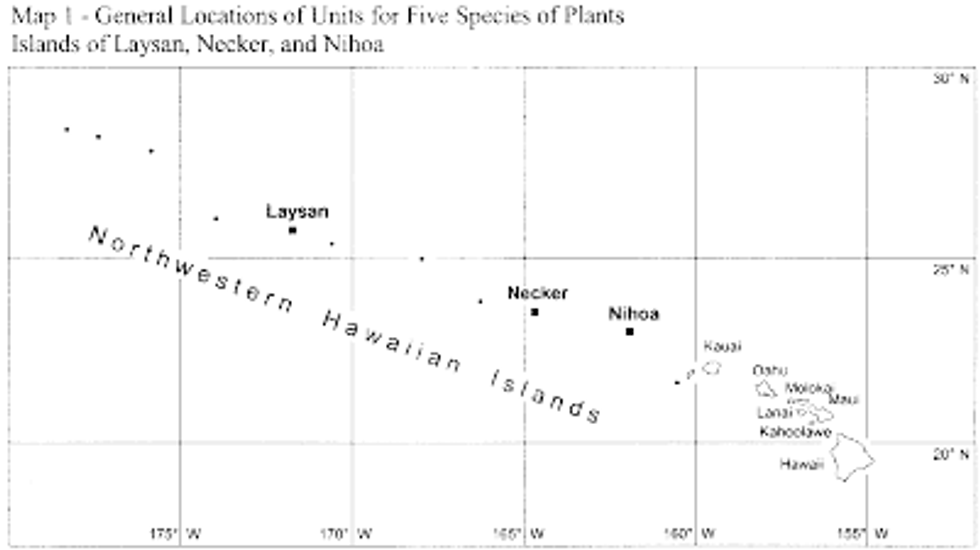
(2) Nihoa 1 - Amaranthus brownii - entire island (approximately 69 ha; 171 ac).
(i) Nihoa Island is located between 23�3? N. and 23�4? N. and between 161�54? W. and 161�56? W.
(ii) Note: Map 2 follows:
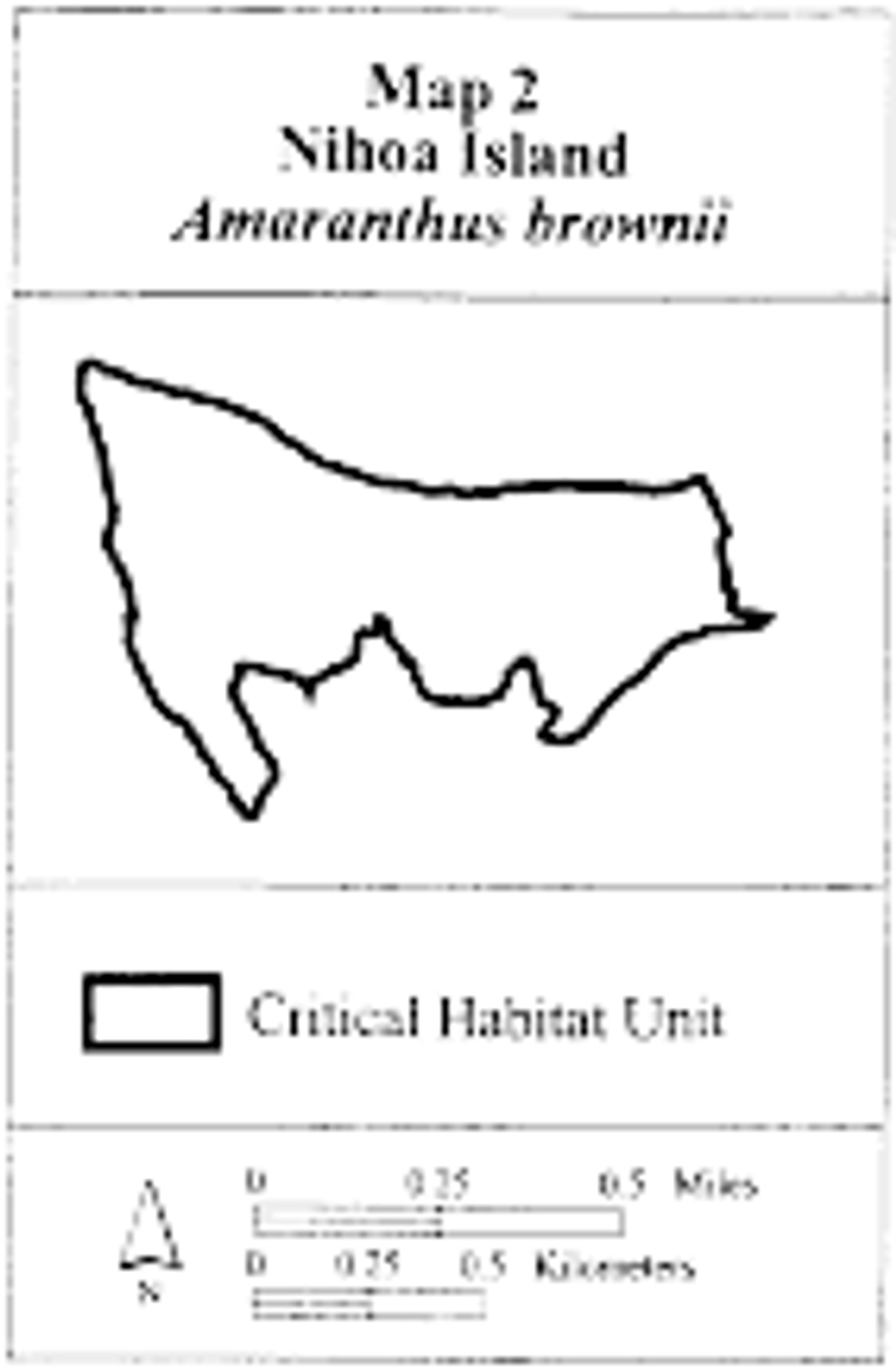
(3) Nihoa 2 - Pritchardia remota - entire island (approximately 69 ha; 171 ac).
(i) Nihoa Island is located between 23�3? N. and 23�4? N. and between 161�54? W. and 161�56? W.
(ii) Note: Map 3 follows:
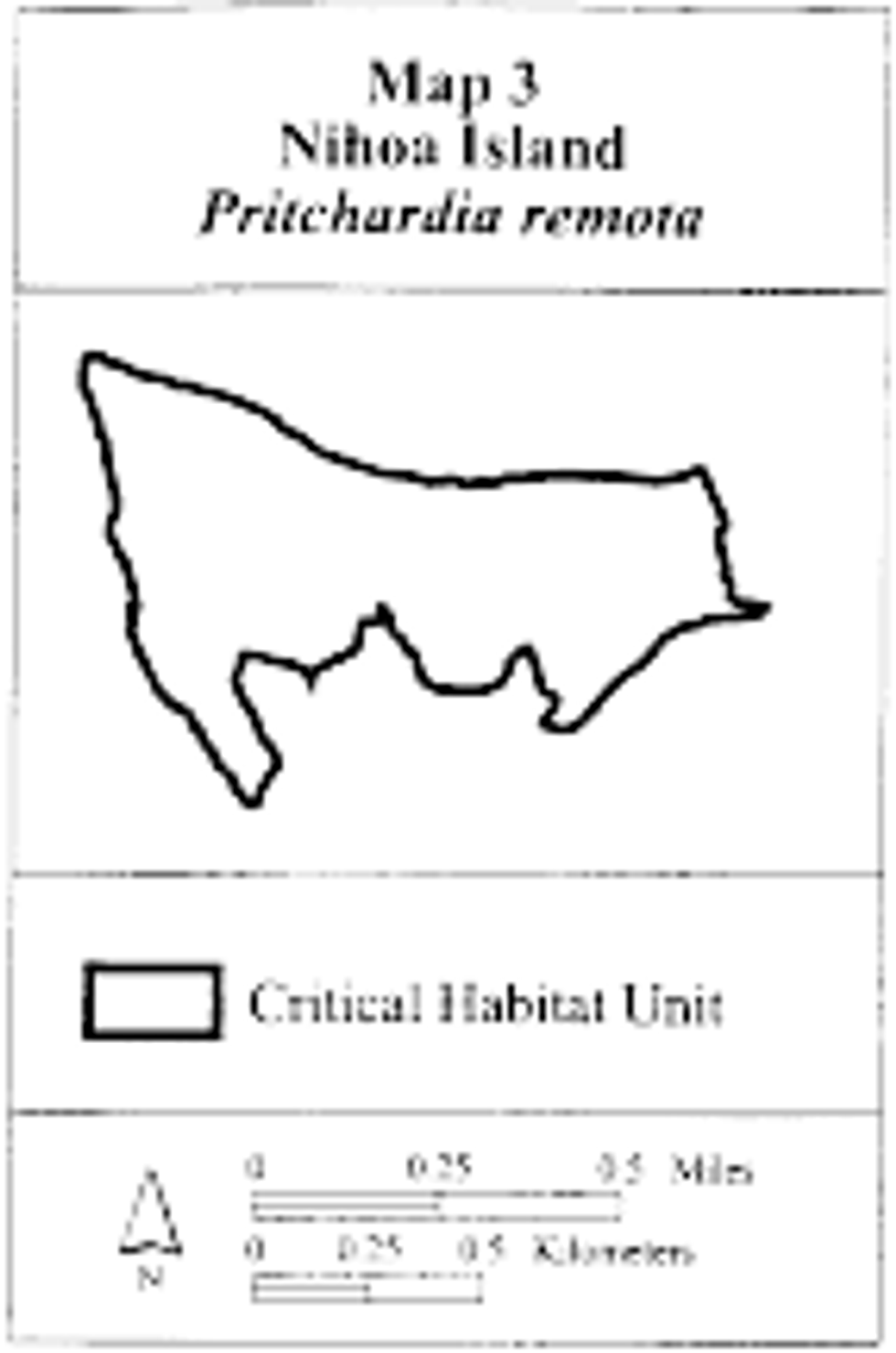
(4) Nihoa 3 - Schiedea verticillata - entire island (approximately 69 ha; 171 ac).
(i) Nihoa Island is located between 23�3? N. and 23�4? N. and between 161�54? W. and 161�56? W.
(ii) Note: Map 4 follows:
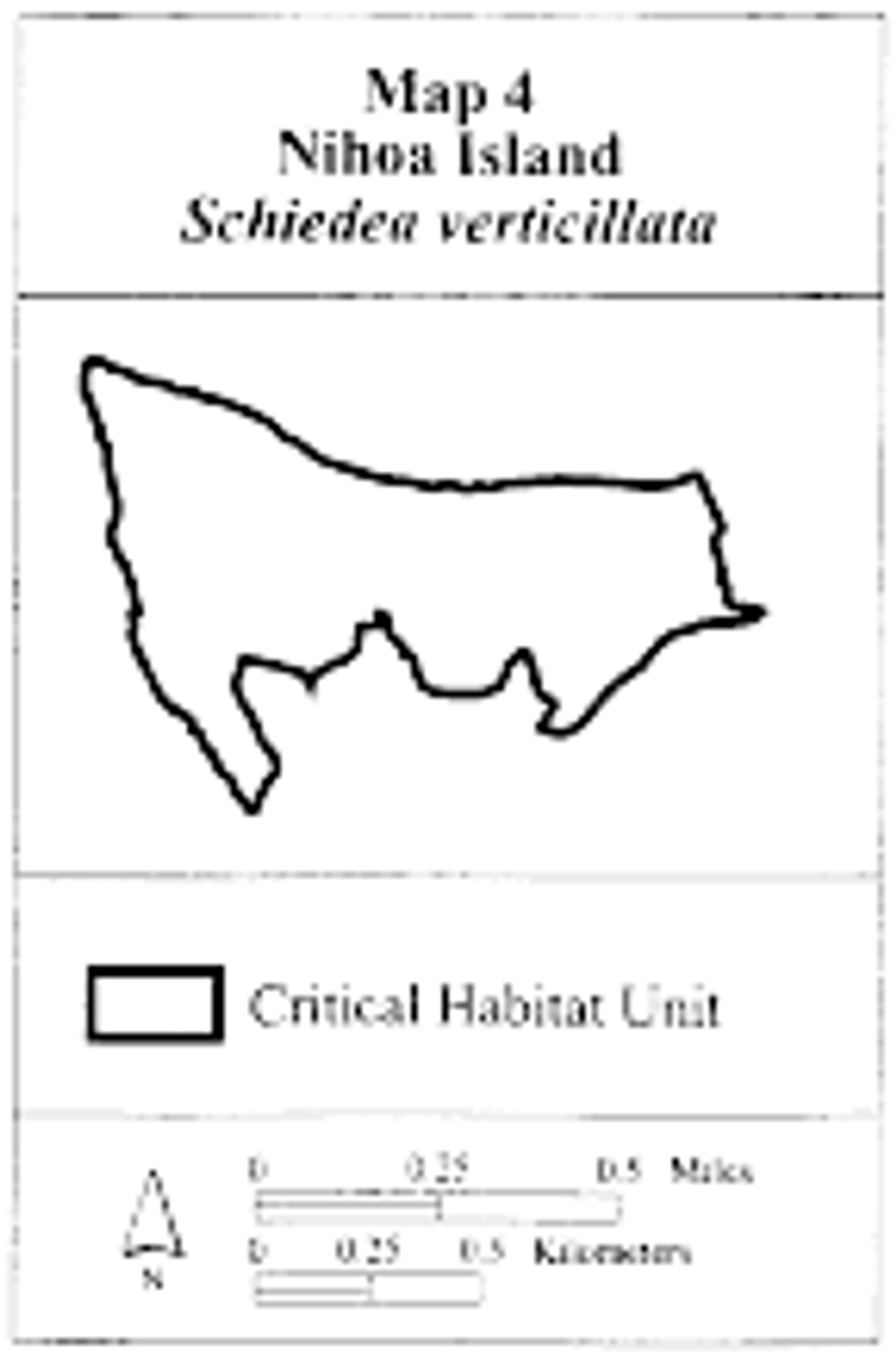
(5) Nihoa 4 - Sesbania tomentosa - entire island (approximately 69 ha; 171 ac).
(i) Nihoa Island is located between 23�3? N. and 23�4? N. and between 161�54? W. and 161�56? W.
(ii) Note: Map 5 follows:
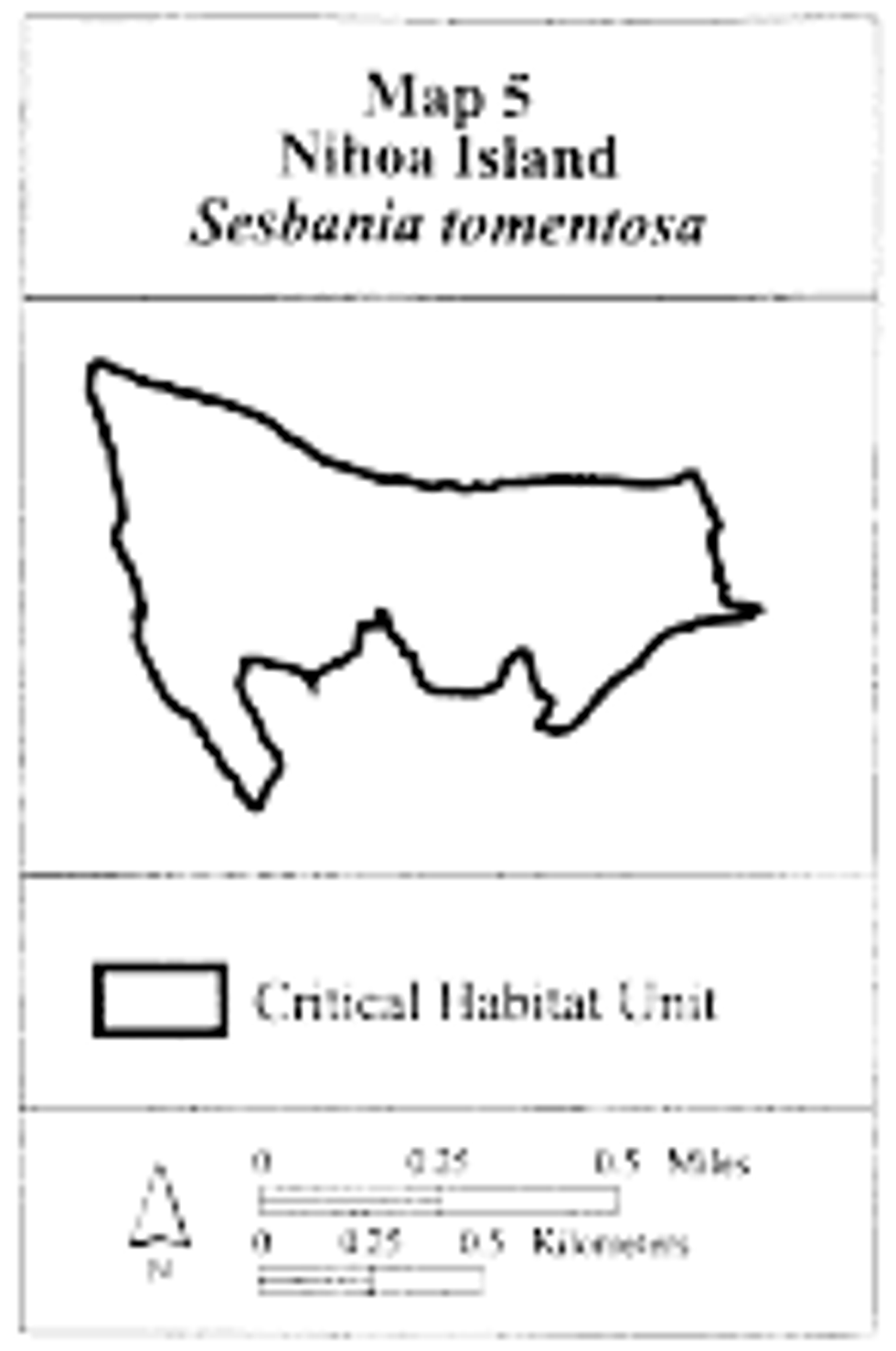
(6) Necker 1 - Sesbania tomentosa - entire island (approximately 18 ha; 46 ac).
(i) Necker Island is located between 23�34? N. and 23�35? N. and between 164�41? W. and 164�43? W.
(ii) Note: Map 6 follows:
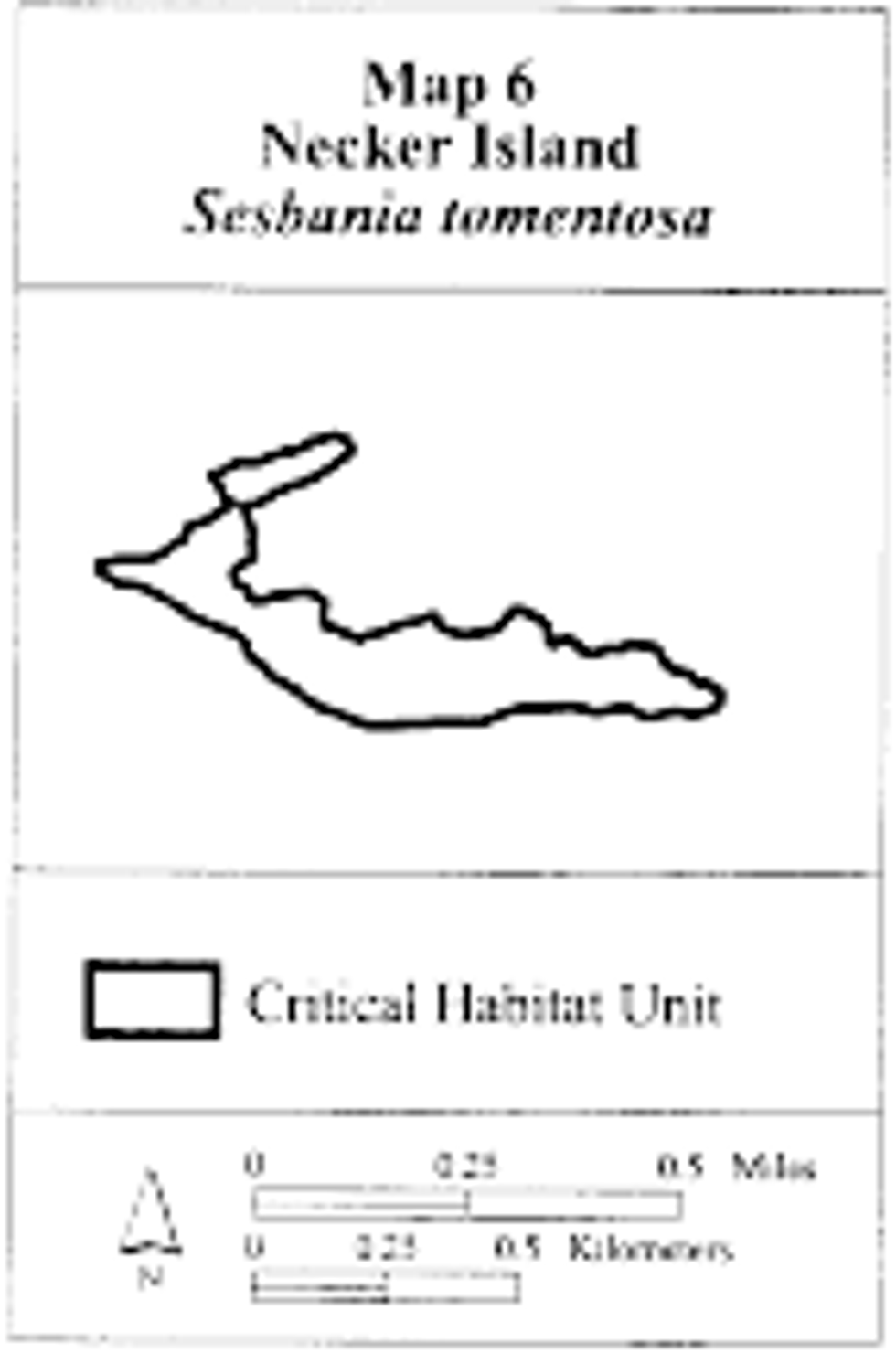
(7) Laysan 1 - Cyperus pennatiformis - entire island (approximately 405 ha; 1,219 ac).
(i) Laysan Island is located between 25�45? N. and 25�47? N. and between 171�43? W. and 171�45? W.
(ii) Note: Map 7 follows:
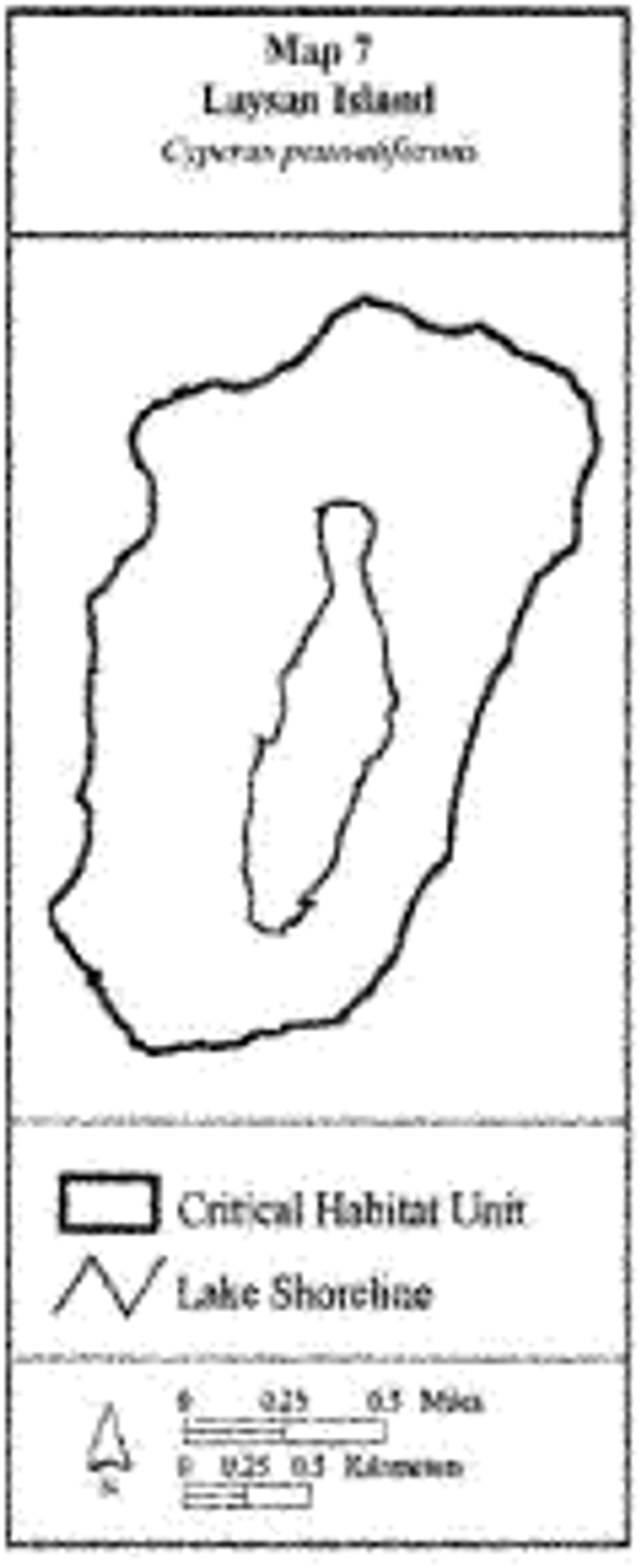
(8) Laysan 2 - Pritchardia remota - entire island (approximately 405 ha; 1,219 ac).
(i) Laysan Island is located between 25�45? N. and 25�47? N. and between 171�43? W. and 171�45? W.
(ii) Note: Map 8 follows:
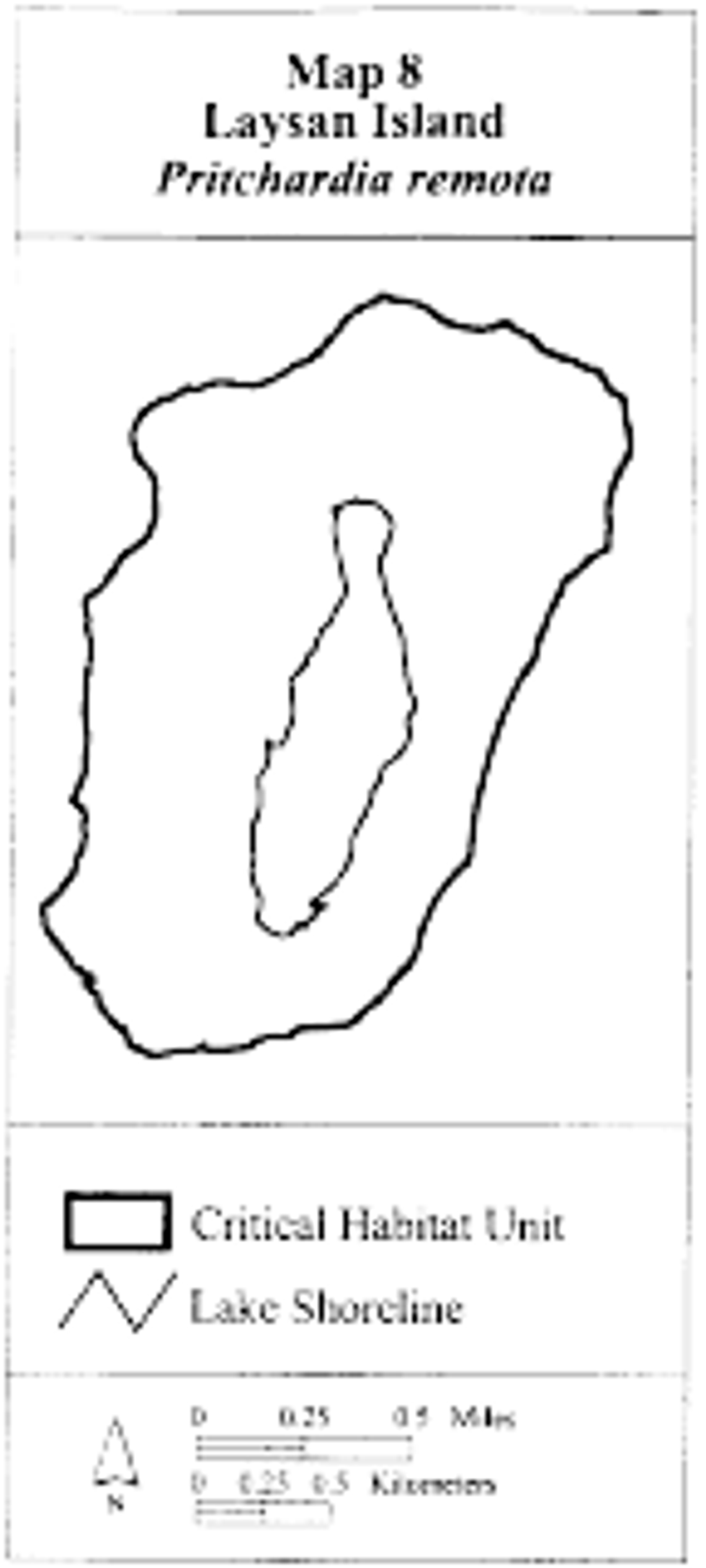
| Island | Species - Occupied | Species - Unoccupied |
|---|---|---|
| Laysan | Cyperus pennatiformis | Pritchardia remota |
| Necker | Sesbania tomentosa. | |
| Nihoa | Pritchardia remota, Schiedea verticillata, Sesbania tomentosa | Amaranthus brownii |
(h) Plants on the Northwestern Hawaiian Islands; Constituent elements.
Family Amaranthaceae: Amaranthus brownii (NCN)
Nihoa 1 - Amaranthus brownii, identified in the legal description in paragraph (g) of this section, constitutes critical habitat for Amaranthus brownii. On Nihoa, the currently known primary constituent elements of critical habitat include, but are not limited to, the habitat components provided by:
(1) Shallow soil in fully exposed locations on rocky outcrops and containing one or more of the following associated native plant species: Chenopodium oahuense, Eragrostis variabilis, Ipomoea indica, Ipomoea pes-caprae ssp. brasiliensis, Panicum torridum, Scaevola sericea, Schiedea verticillata, Sicyos pachycarpus, Sida fallax, or Solanum nelsonii; and (2) Elevations between 30 and 242 m (100 and 800 ft).
Family Arecaceae: Pritchardia remota (loulu)
Nihoa 2 - Pritchardia remota, and Laysan 2 - Pritchardia remota, identified in the legal descriptions in paragraph (g) of this section, consitute critical habitat for Pritchardia remota.
(1) On Nihoa, the currently known primary constituent elements of critical habitat include, but are not limited to, the habitat components provided by:
(i) Pritchardia remota coastal forest community and containing one or more of the following associated native plant species: Chenopodium oahuense, Sesbania tomentosa, Sida fallax, or Solanum nelsonii; and
(ii) Elevations between sea level and 151 m (500 ft).
(2) On Laysan Island, the currently known primary constituent elements of critical habitat include, but are not limited to, the habitat components provided by:
(i) Coastal strand habitat with Chenopodium oahuensee and Solanum nelsonii; and
(ii) Elevations between sea level to 12 m (0 to 40 ft).
Family Caryophyllaceae: Schiedea verticillata (NCN)
Nihoa 3 - Schiedea verticillata, identified in the legal description in paragraph (g) of this section, constitutes critical habitat for Schiedea verticillata. On Nihoa, the currently known primary constituent elements of critical habitat for Schiedea verticillata include, but are not limited to, the habitat components provided by:
(1) Rocky scree, soil pockets, and cracks on coastal cliff faces and in Pritchardia remota coastal mesic forest and containing one or more of the following associated native plant species: Eragrostis variabilis, Rumex albescens, Tribulus cistoides, or lichens; and
(2) Elevations between 30 and 242 m (100 and 800 ft).
Family Cyperaceae: Cyperus pennatiformis (NCN)
Laysan 1 - Cyperus pennatiformis, identified in the legal description in paragraph (g) of this section, constitutes critical habitat for Cyperus pennatiformis. On Laysan Island, the currently known primary constituent elements of critical habitat for Cyperus pennatiformis include, but are not limited to, habitat components provided by:
(1) Coastal sandy substrate containing one or more of the following associated native plant species: Cyperus laevigatus, Eragrostis variabilis, or Ipomoea sp.; and
(2) Elevation of 5 m (16 ft).
Family Fabaceae: Sesbania tomentosa (ohai)
Nihoa 4 - Sesbania tomentosa, and Necker 1 - Sesbania tomentosa, identified in the legal descriptions in paragraph (g) of this section, constitute critical habitat for Sesbania tomentosa. On Nihoa and Necker, the currently known primary constituent elements of critical habitat for Sesbania tomentosa include, but are not limited to, habitat components provided by:
(1) Shallow soil on sandy beaches and dunes in Chenopodium oahuense coastal dry shrubland or mixed coastal dry cliffs and containing one or more of the following associated native plant species: Pritchardia remota, Scaevola sericea, Sida fallax, or Solanum nelsonii; and
(2) Elevations between sea level and 84 m (0 and 276 ft).
Editorial Note:The remainder of � 17.99 appears in 50 Part 17, � 17.99(i)-end of part 17.
[68 FR 9241, Feb. 27, 2003, as amended at 68 FR 13055, Mar. 18, 2003; 68 FR 26038, May 14, 2003; 68 FR 28072, May 22, 2003; 68 FR 36080, June 17, 2003; 68 FR 39704, July 2, 2003; 75 FR 19097, Apr. 13, 2010; 77 FR 57767, Sept. 18, 2012. Redesignated at 85 FR 82388, Dec. 18, 2020; 88 FR 7147, Feb. 2, 2023]
['Species Protection']
['Endangered Species']
UPGRADE TO CONTINUE READING
Load More
J. J. Keller is the trusted source for DOT / Transportation, OSHA / Workplace Safety, Human Resources, Construction Safety and Hazmat / Hazardous Materials regulation compliance products and services. J. J. Keller helps you increase safety awareness, reduce risk, follow best practices, improve safety training, and stay current with changing regulations.
Copyright 2025 J. J. Keller & Associate, Inc. For re-use options please contact copyright@jjkeller.com or call 800-558-5011.
